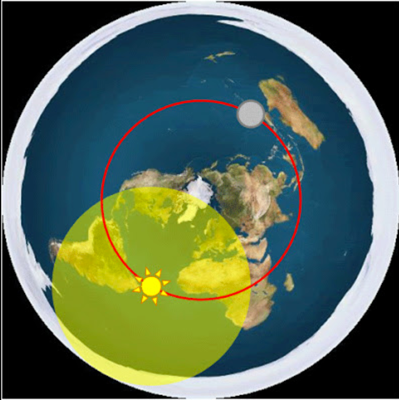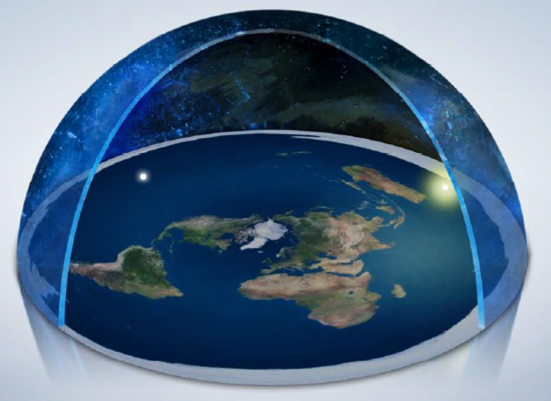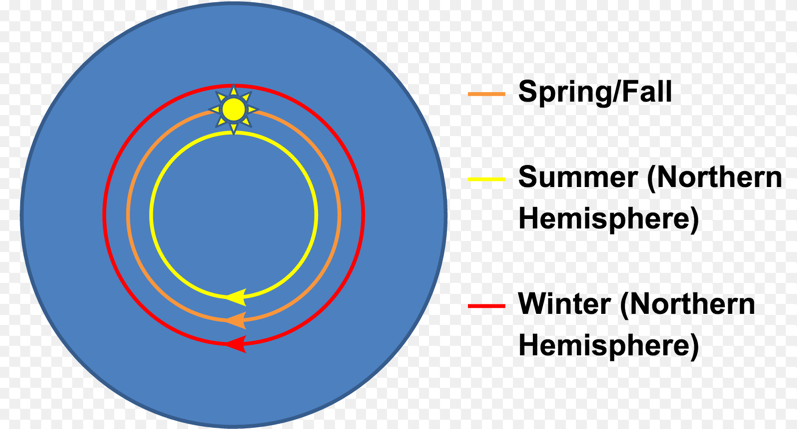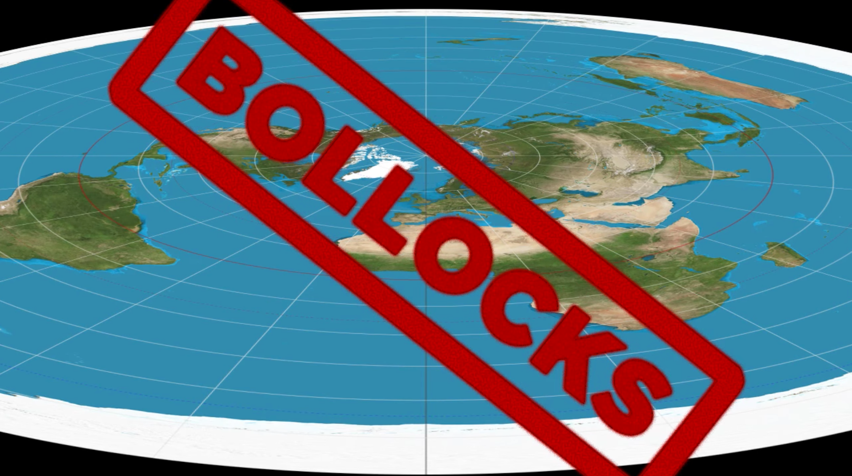If we had to rely solely on spacecraft to learn about the outer planets, we wouldn’t be making great progress. It takes a massive effort to get a spacecraft to the outer Solar System. But thanks to the Hubble Space Telescope, we can keep tabs on the gas giants without leaving Earth’s orbit.
NASA’s Outer Planet Atmospheres Legacy (OPAL) program keeps an eye on the outer planets to monitor changes in their atmospheres. Changes on Jupiter, Saturn, Uranus, and Neptune take place on timescales of years and decades—or longer—so Hubble checks in yearly to see how the gas/ice giants are doing. It gives scientists a long baseline of data. Each year OPAL captures images of the outer planets, and OPAL is slated to continue until either Hubble itself is no longer operational, or until Hubble’s WFC3/UVIS camera is no longer functioning.
Jupiter, Saturn Uranus, and Neptune.
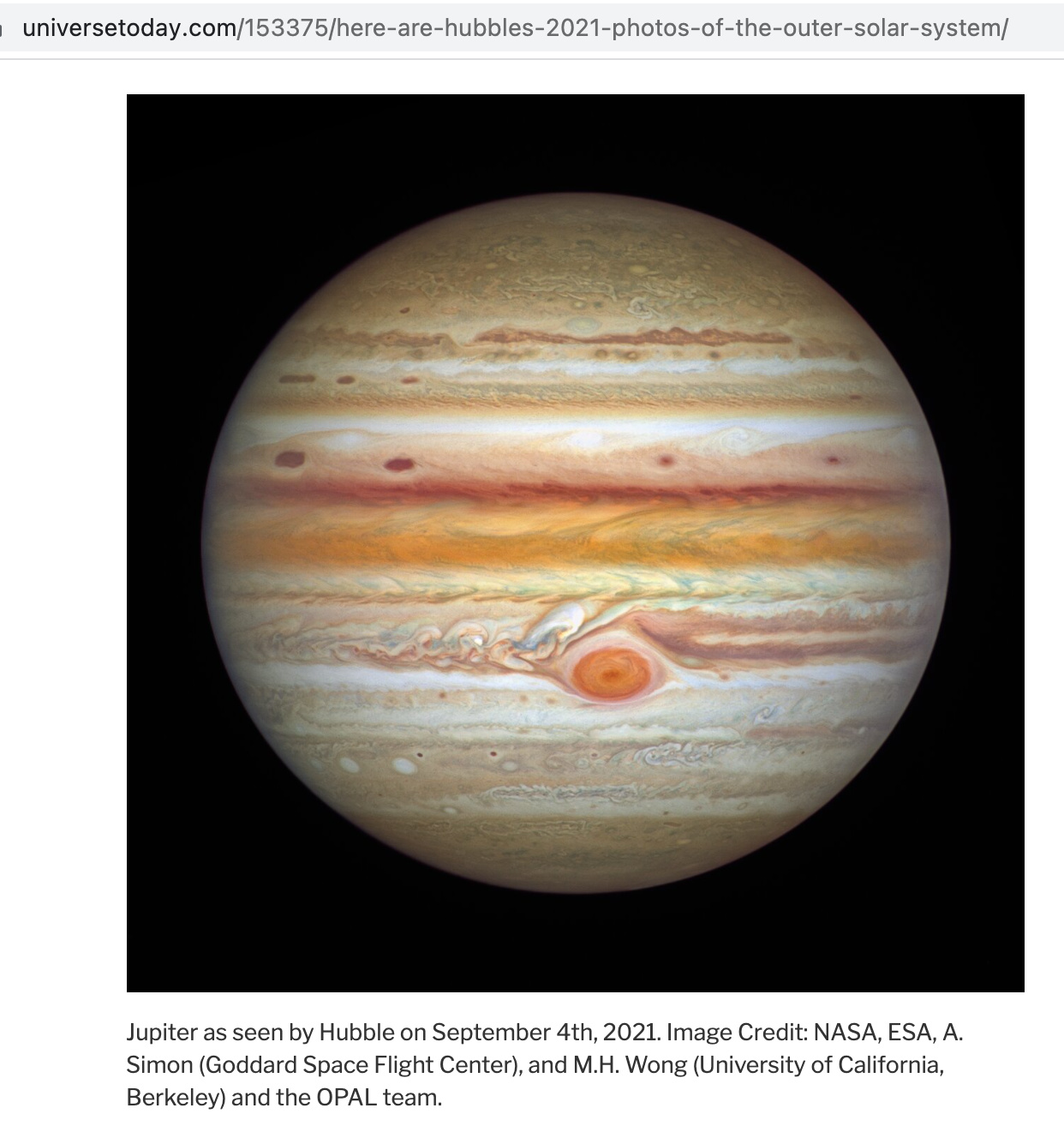
Flat Earth NOT – FlatEarthLunacy articles for reference - R
Dear Readers,
Welcome to the FlatEarthLunacy archives, filled with lots of facts about our true globe Earth and explanations as to what motivates flat Earth folks.
These articles once appeared on our main blog page, but have been moved here to provide more room on the main page.
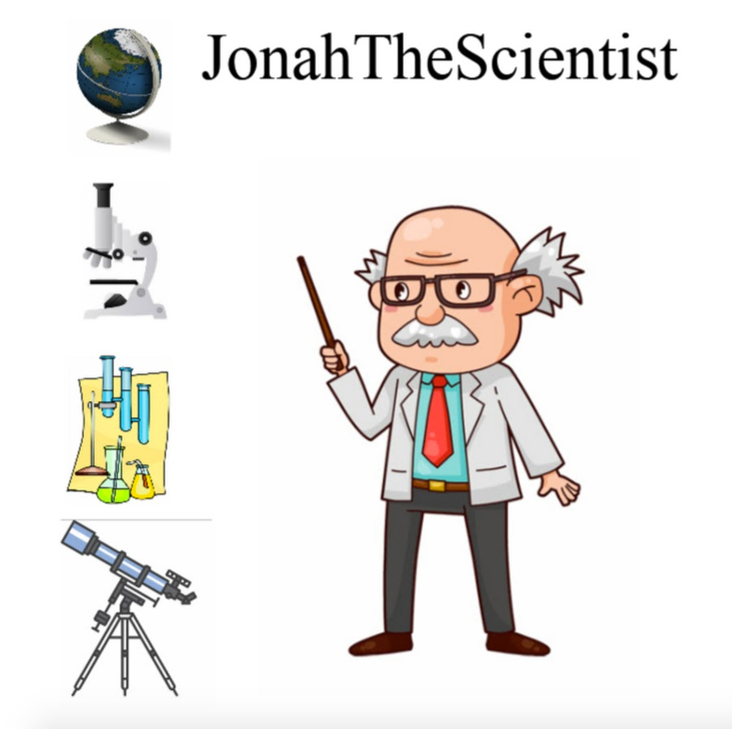
Published on March 9, 2022
Discussion at - https://www.youtube.com/channel/UC7ipUKERU0tzYFxALJBli4A/discussion
Our home page all articles - http://flatearthlunacy.com
kind regards, JonahTheScientist
- - - - - - - - - - - - - - - - - - - - - - - - - - - - - - - - - - - - - - - - - - - - - - - - - - - - - - - - - - - - - - - - - - - - - - - - - - - - - - - -
- - - - - - - - - - - - - - - - - - - - - - - - - - - - - - - - - - - - - - - - - - - -
Posted on January 20, 2022
Using parallax, how Scott Manley and friend (on the Earth) measured the distance to the Moon.
To all flat Earth believers, don't become extinct like the Tyrannosaurus Rex. Instead, transform by doing that EASY experiment YOURSELF.
-
Teaching Nathan a Lesson in Navigation, by Bob the Science Guy
https://www.youtube.com/watch?v=Zex4F1g1Lts
I chased Nathan into his own show today to teach him a lesson in celestial navigation. My challenge was simple- you and your buddies have been running your mouths about sextants and celestial navigation for months- but I suspected they were 'all hat and no cattle' as they say in Texas.
So my challenge was simple. Here is a two star fix from a real ocean voyage. I gave him all the information he needed to find the position of the ship and told him he could call on any or all of his dwindling panel to help him give me a position from the sextant reading. The results were hilarious and humiliating for Nathan and later Quantum Eraser.
We'll go over the show live and I'll work the problem, getting a proper solution within 10 miles of the actual location of the vessel (not bad for only two stars). In the process I expose the ignorance of Nathan, Quantum Eraser and AdamMeakins (who at least tried but was a mere 2750 miles off and used a globe)
Adam Meekins, Brians Logic and others that support the Nathan Oakley show.
At time mark 23:10
Bob says, "this is an excellent image from Scott Manley who did a video a while ago demonstrating how to find the parallax and the distance to the Moon from observers on Earth.
Now here's he way it's done. We've got three objects here. It's jupiter, it's saturn and a bright star. And by simply taking a photograph of those we can measure the angular separation between these two stars, between these two stars, and between these two stars. Simply by counting pixels and looking up on the astronomical tables or Stellarium, what the angular separation of those two stars are, those two objects are. And then we can find out how many arc seconds per pixel for example. And then what we can do is we can actually look at this image right here, let me get out of your way, because this is the key image of this photograph and that's right here (time mark: 24:19).
Notice that that's a moon, and there's a scond moon superimposed on it. So what this image came from was that Scott Manley I guess was up in the San Fransciso area, and he had one of his subscribers take a picture of the moon at exactly the same timehe did and that second scribers was down in Rio De Janeiro.
And then what they did was they took the photographs and they rotated them and scalled them so that these three stars lined up perfectly. And what he did then was he demosntrated the parallax of the moon. So they went from the center of this moon to the center of that moon, counted the number of pixels in that image between those two center points, and then by using that distance, and the known and measured distance between the two observers, Rio De Janeiro and San Fransciso, they were able to use what's called the parallax equation, and they were able to find the distance to the Moon.
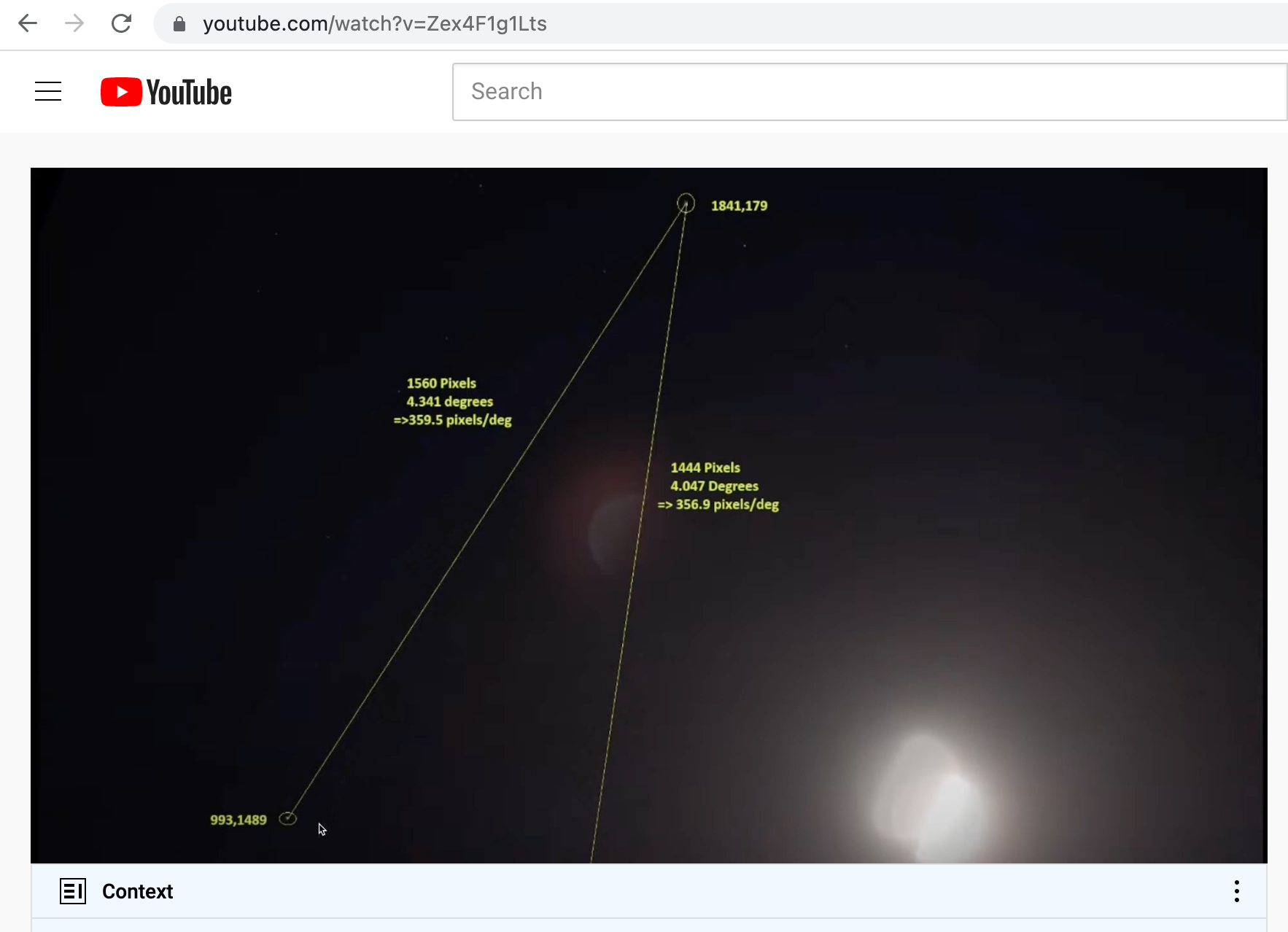
And they did a pretty good job with it. I think they 340,000 kilometers roughly, and I think that the actual distance to the Moon is something ... 348,400 kilometers (time mark: 26:01)..."
Scott Manley at - https://www.youtube.com/c/szyzyg/featured
- - - - - - - - - - - - - - - - - - - - - - - - - - - - - - - - - - - - - - - - - - - -
Posted on January 19, 2022
The Transit of Venus - Great Expedition of 1761 to determine the distance to the Sun.
Contrary to flat Earth denial, the distance to the Sun is well known (93-million miles).
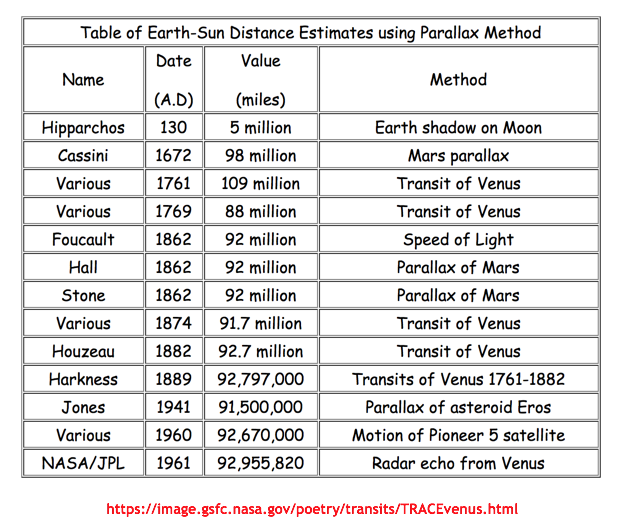
-
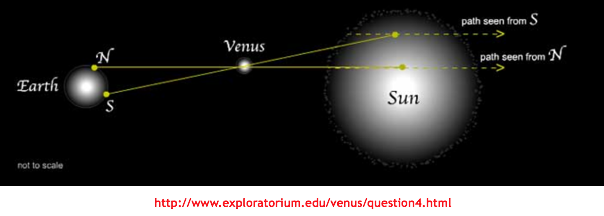
Over the millennia different techniques have been used to measure the Sun’s distance from the Earth (see chart above). In modern times that distance has been measured to greater and greater accuracy.
But the tale of the 1761 transit of Venus attempt, which started international scientific cooperation and was conducted during wartime, proved to be a heroic successful undertaking.
Here is the story as told by Sky & Telescope Magazine…
Transits of Venus in History: 1761
https://www.skyandtelescope.com/astronomy-news/observing-news/transits-of-venus-in-history-1761/
With the scale of the solar system at stake, and knowledge of an upcoming transit in 1761, astronomers did something they wouldn't normally have done: they actually tried to cooperate across borders. European powers such as Great Britain and France held colonies and trading posts all over the world, so astronomers were motivated to organize the first international scientific project in human history: sending expeditions of highly competent astronomers and support personnel to various locations around the world, equipped with telescopes, pendulum clocks, and other quality instrumentation. Astronomers could combine measurements from far-flung locations to determine the a.u.
But then a nasty little war happened to intervene. Known as the Seven Years' War (or the French and Indian War in the U.S.), Britain and her allies engaged in a bitter struggle with France and her allies for worldwide maritime supremacy. The first global war, it raged from 1756 to 1763. The British eventually gained the upper hand (taking possession of Canada in the process), but astronomers were among the losers. With warships roaming the oceans and bombarding coastal cities, transit expeditions became more expensive, complicated, and hazardous,
A case in point was a British expedition to Sumatra (an island in modern-day Indonesia) funded by the Royal Society and led by astronomer Charles Mason and surveyor Jeremiah Dixon (the two who would later become famous for marking the boundary between Pennsylvania and Maryland). Just 24 hours after departing from Portsmouth, their frigate, the HMS Seahorse, was attacked and seriously damaged in a battle with the more heavily armed French frigate L'Grand. Mason and Dixon hunkered down in the bowels of their ship and listened to their fellow crewmen scream in agony as they were cut down by artillery and musket fire. Overall, 11 British sailors died and 37 were wounded. After an hour of fierce combat, the Seahorse was forced to return to port (but not before giving chase to the fleeing L'Grand).
As any sane person can imagine, Mason and Dixon lacked enthusiasm for another trip. But threatened with prosecution and severe punishment if they didn't try again, Mason and Dixon set sail once their ship was repaired. This time they avoided contact with French ships. But as they were sailing southward in the Atlantic, they realized they had no chance of reaching Sumatra in time for the transit. So they showed up unannounced at the Dutch colony of Cape Town in modern-day South Africa. The Dutch were neutral in the war, and the colonial administrators were sympathetic to the scientific nature of the expedition. The team was permitted to disembark and set up their equipment. Mason and Dixon caught the second half of the transit, the only successful observation of the 1761 transit from the Southern Hemisphere.
etc.
(Go to the article to finish reading it)
- - -
(from Archive W post)
1769 - Great Transit of Venus expedition
Transit of Venus Into to Parallax , Bob the Science Guy
https://www.youtube.com/watch?v=2o2otqL3Uc4
- - -
Transit of Venus actual observation, by Bob the Science Guy
https://www.youtube.com/watch?v=5zRGtJC_s-o
This is an actual Transit of Venus observation with calculation of the distance from the earth to the sun. Observation points were New Jersey (Princeton) and Hawaii
- - -
The Rarest Eclipse, Transit of Venus
What is a transit of Venus?
How do we view it?
What will you see?
Why is it important?
Finding the AU: How the Transit of Venus Tells Us Our distance from the Sun.
https://www.exploratorium.edu/venus/question4.html
All about Venus
- - -
Using a transit of Venus to determine the Astronomical Unit: a simple example, by Michael Richmond
http://spiff.rit.edu/classes/phys445/gettys/venus_ex/venus_ex.html
- - -
https://en.wikipedia.org/wiki/Transit_of_Venus
- - -
Update: July 30, 2021
Transit of Venus | Intro to Parallax, by Bob the Science Guy
https://www.youtube.com/watch?v=ZhuHn6cQx30
The Transit of Venus was first measured by an international team in 1761, with a refined measurement in 1769. Here we go over some of the mathematics involved as we begin our discussion of parallax as a means to measure distance in the universe.
Here is the link to the paper. https://vanderbei.princeton.edu/tex/V...
"Chasing Venus" https://www.amazon.com/Chasing-Venus-...
- - -
Update: September 1, 2021
Transit of Venus | Mathematics, by Bob the Science Guy
https://www.youtube.com/watch?v=I7h8EW9ng-4&t=2s
In this episode we have a look at how a Transit of Venus is used to determine the distance of 1 Astronomical Unit- the distance from the earth to the sun. Note: The parallax formula is Distance between Observations/Parallax Angle
- - -
Update: September 1, 2021
Transit of Venus | Actual Observation, by Bob the Science Guy
https://www.youtube.com/watch?v=cXJiepwT-Ro
Here we look at a Transit of Venus Observation from June, 2012 and use it to measure the distance from the Earth to the Sun. We look at the variables and make the calculation, comparing it to the actual distance.
The Transit of Venus: https://vanderbei.princeton.edu/tex/V...
- - - - - - - - - - - - - - - - - - - - - - - - - - - - - - - - - - - - - - - - - - - -
Posted on January 17, 2022
Hunga Tonga explosion: Why Flat Earthers have a problem (GeoStreber)
https://www.youtube.com/watch?v=2clY0Yl8-IQ
These videos and analysis are indisputable evidence of a Globe.
-
Burying flat earth under a thick layer of pumice and ashes, by GeoStreber
https://www.youtube.com/watch?v=NIDBBkNMmTc
How the Hunga Tonga volcano erruption shows that the earth is a sphere.
Just the data on when (what time) the shock waves hit different locations on the Earth, proves the Earth is a Globe.
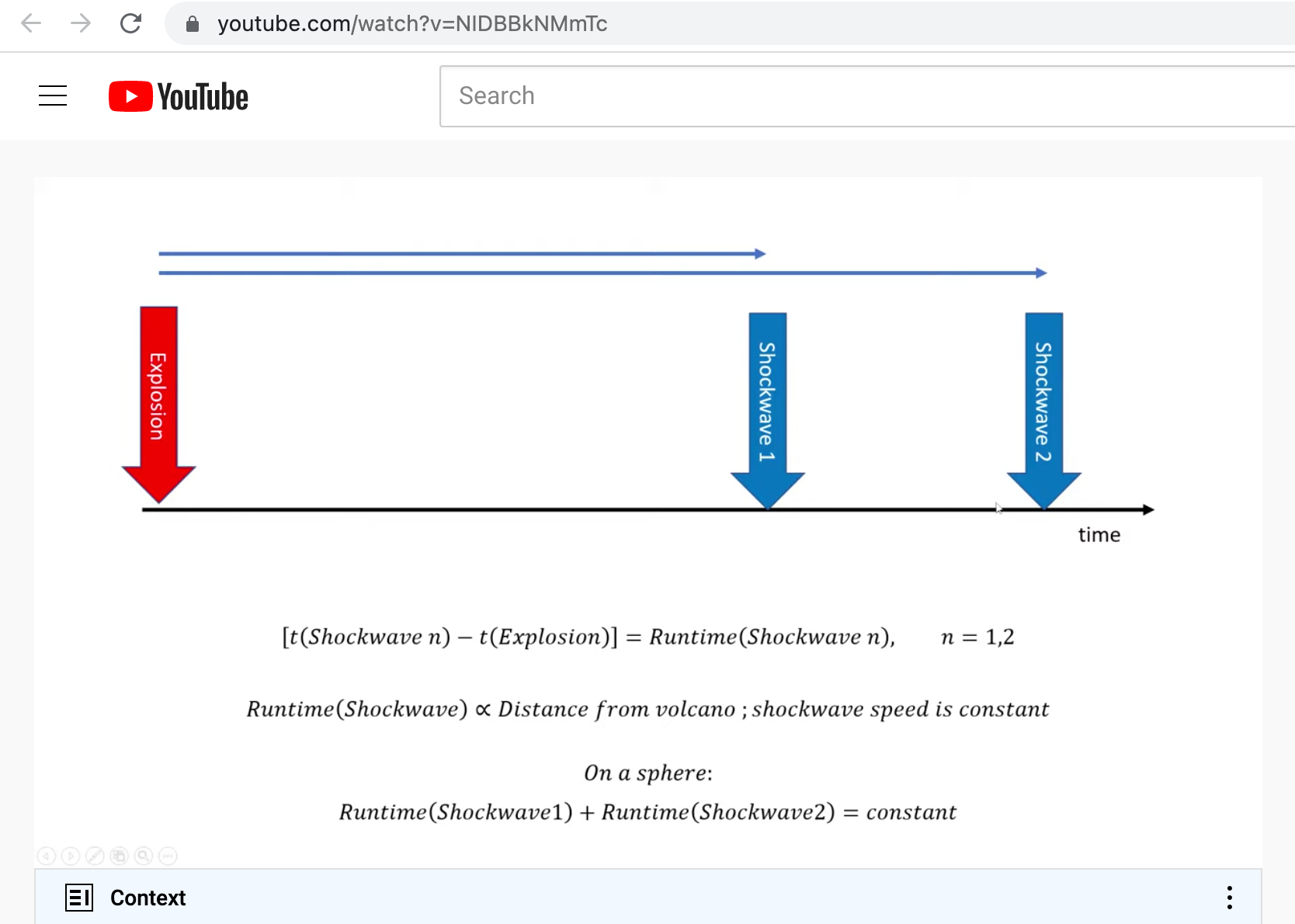
-
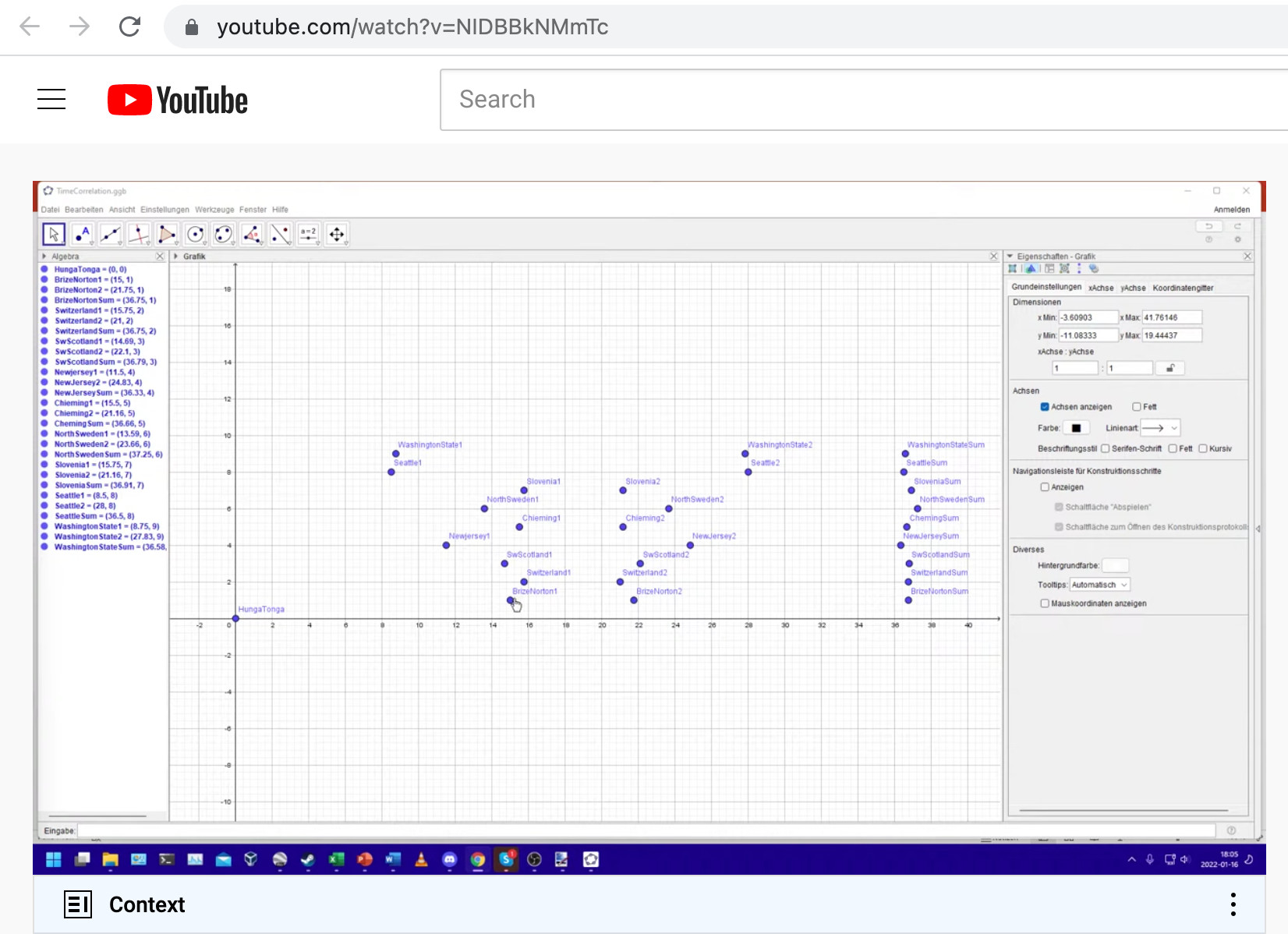
-
Gravitas: A volcano eruption that was felt half way around the world (WION)
https://www.youtube.com/watch?v=0L9noTGcmOE
-
Tonga ERUPTS, by Sean Doran
https://www.youtube.com/watch?v=k5s-c8VS9Bo
On 15th January, 2022 the volcanic island Hunga Tonga–Hunga Haʻapai violently erupted. This footage is derived from data acquired by Himawari-8 satellite on January 15th to 18th and provided by JAXA / JMA / NICT
Music: 'A New Day in a New Sector' by Chris Zabriskie 'Music from Neptune Flux'
Data: Himawari-8 / JAXA / JMA / NICT https://seg-web.nict.go.jp/
Wiki: https://en.wikipedia.org/wiki/2022_Hu...
00:00 Eruption & Dust Cloud, January 15-16
00:23 Wider view of Eruption & Dust Cloud, January 15-16
00:47 Gravitywave / Shockwave visible NW of Australia, January 16
00:52 Tracking Eruption & Dust Cloud, January 15-18
01:52 Global view, January 15-18
-
Describing the devastating eruption in Tonga (sciencedaily.com)
https://www.sciencedaily.com/releases/2022/03/220329142523.htm
On January 15, the volcano Hunga Tonga-Hunga Ha'apai devastated the nation of Tonga. The eruption triggered tsunamis as far afield as the Caribbean and generated atmospheric waves that travelled around the globe several times. Meanwhile, the volcano's plume shot gas and ash through the stratosphere into the lower mesosphere.
(Please read the article at the URL above)
- - - - - - - - - - - - - - - - - - - - - - - - - - - - - - - - - - - - - - - - - - - -
Posted on January 15, 2022
Dark Energy Spectroscopic Instrument (DESI) - Research helping to better understand why the expansion rate of the universe is accelerating
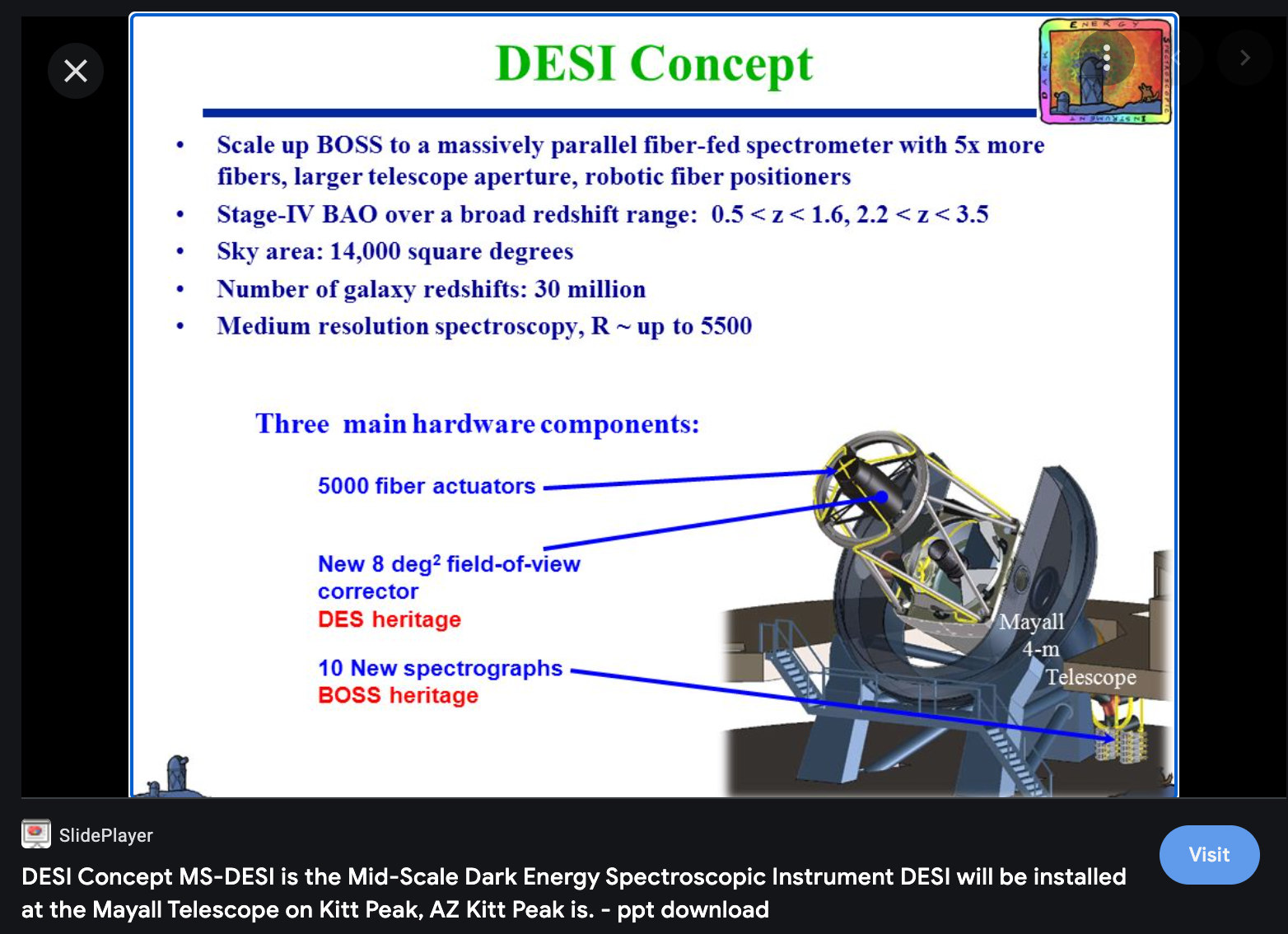
Dark Energy Spectroscopic Instrument creates largest 3D map on the cosmos (phys.org)
https://phys.org/news/2022-01-dark-energy-spectroscopic-instrument-largest.html
The Dark Energy Spectroscopic Instrument (DESI) has capped off the first seven months of its survey run by smashing through all previous records for three-dimensional galaxy surveys, creating the largest and most detailed map of the universe ever. Yet it's only about 10% of the way through its five-year mission. Once completed, that phenomenally detailed 3D map will yield a better understanding of dark energy, and thereby give physicists and astronomers a better understanding of the past—and future—of the universe. Meanwhile, the impressive technical performance and literally cosmic achievements of the survey thus far are helping scientists reveal the secrets of the most powerful sources of light in the universe.
DESI is an international science collaboration managed by the Department of Energy's Lawrence Berkeley National Laboratory (Berkeley Lab) with primary funding for construction and operations from DOE's Office of Science.
DESI scientists are presenting the performance of the instrument, and some early astrophysics results, this week at a Berkeley Lab-hosted webinar called CosmoPalooza, which will also feature updates from other leading cosmology experiments.
"There is a lot of beauty to it," said Berkeley Lab scientist Julien Guy, one of the speakers. "In the distribution of the galaxies in the 3D map, there are huge clusters, filaments, and voids. They're the biggest structures in the universe. But within them, you find an imprint of the very early universe, and the history of its expansion since then."
DESI has come a long way to reach this point. Originally proposed over a decade ago, construction on the instrument started in 2015. It was installed at the Nicholas U. Mayall 4-meter telescope at Kitt Peak National Observatory near Tucson, Arizona. Kitt Peak National Observatory is a program of the National Science Foundation's (NSF) NOIRLab, which the Department of Energy contracts with to operate the Mayall Telescope for the DESI survey. The instrument saw first light in late 2019. Then, during its validation phase, the coronavirus pandemic hit, shutting down the telescope for several months, though some work continued remotely. In December 2020, DESI turned its eyes to the sky again, testing out its hardware and software, and by May 2021 it was ready to start its science survey.
But work on DESI itself didn't end once the survey started. "It's constant work that goes on to make this instrument perform," said physicist Klaus Honscheid of Ohio State University, an Instrument Scientist on the project, who will deliver the first paper of the CosmoPalooza DESI session. Honscheid and his team ensure the instrument runs smoothly and automatically, ideally without any input during a night's observing. "The feedback I get from the night observers is that the shifts are boring, which I take as a compliment," he said.
But that monotonous productivity requires incredibly detailed control over each of the 5,000 cutting-edge robots that position optical fibers on the DESI instrument, ensuring their positions are accurate to within 10 microns. "Ten microns is tiny," said Honscheid. "It's less than the thickness of a human hair. And you have to position each robot to collect the light from galaxies billions of light-years away. Every time I think about this system, I wonder how could we possibly pull that off? The success of DESI as an instrument is something to be very proud of."
-
Dark Energy Spectroscopic Instrument:
https://www.desi.lbl.gov/
https://en.wikipedia.org/wiki/Dark_Energy_Spectroscopic_Instrument
-
Dark Energy Spectroscopic Instrument (DESI) Creates Largest 3D Map of the Cosmos (newscenter.ibl.gov)
https://newscenter.lbl.gov/2022/01/13/dark-energy-spectroscopic-instrument-desi-creates-largest-3d-map-of-the-cosmos/
The Dark Energy Spectroscopic Instrument (DESI) has capped off the first seven months of its survey run by smashing through all previous records for three-dimensional galaxy surveys, creating the largest and most detailed map of the universe ever. Yet it’s only about 10% of the way through its five-year mission. Once completed, that phenomenally detailed 3D map will yield a better understanding of dark energy, and thereby give physicists and astronomers a better understanding of the past – and future – of the universe. Meanwhile, the impressive technical performance and literally cosmic achievements of the survey thus far are helping scientists reveal the secrets of the most powerful sources of light in the universe.
DESI is an international science collaboration managed by the Department of Energy’s Lawrence Berkeley National Laboratory (Berkeley Lab) with primary funding for construction and operations from DOE’s Office of Science.
DESI scientists are presenting the performance of the instrument, and some early astrophysics results, this week at a Berkeley Lab-hosted webinar called CosmoPalooza, which will also feature updates from other leading cosmology experiments.
“There is a lot of beauty to it,” said Berkeley Lab scientist Julien Guy, one of the speakers. “In the distribution of the galaxies in the 3D map, there are huge clusters, filaments, and voids. They’re the biggest structures in the universe. But within them, you find an imprint of the very early universe, and the history of its expansion since then.”
DESI has come a long way to reach this point. Originally proposed over a decade ago, construction on the instrument started in 2015. It was installed at the Nicholas U. Mayall 4-meter telescope at Kitt Peak National Observatory near Tucson, Arizona. Kitt Peak National Observatory is a program of the National Science Foundation’s (NSF) NOIRLab, which the Department of Energy contracts with to operate the Mayall Telescope for the DESI survey. The instrument saw first light in late 2019. Then, during its validation phase, the coronavirus pandemic hit, shutting down the telescope for several months, though some work continued remotely. In December 2020, DESI turned its eyes to the sky again, testing out its hardware and software, and by May 2021 it was ready to start its science survey.
But work on DESI itself didn’t end once the survey started. “It’s constant work that goes on to make this instrument perform,” said physicist Klaus Honscheid of Ohio State University, co-Instrument Scientist on the project, who will deliver the first paper of the CosmoPalooza DESI session. Honscheid and his team ensure the instrument runs smoothly and automatically, ideally without any input during a night’s observing. “The feedback I get from the night observers is that the shifts are boring, which I take as a compliment,” he said.
- - - - - - - - - - - - - - - - - - - - - - - - - - - - - - - - - - - - - - - - - - - -
Posted on January 12, 2022
Flat Earthers are more likely to be PSYCHOPATHS: People who believe conspiracy theories tend to have 'dark' personality traits, study finds (dailymail.co.uk)
https://www.dailymail.co.uk/sciencetech/article-9671735/Conspiracy-theorists-tend-dark-personality-traits.html
- Four undesirable personality traits are linked to believing in conspiracy theories
- Narcissism, Machiavellianism, psychopathy and sadism make up 'Dark Tetrad'
- Study from University of Oregon experts shows how 'mediators' explain this link
Whether you're a flat Earther, a climate change denier or an anti-vaxxer, you might have dark personality traits, a new study suggests.
A psychologist at the University of Oregon has linked the tendency to believe in conspiracy theories with what's known in psychology as Dark Tetrad.
Dark Tetrad comprises four 'dark' personality traits – narcissism, Machiavellianism, psychopathy and sadism.
Dark Tetrad traits may be linked to believing in conspiracy theories, not because of features that are unique to each of the traits, but because of features that are shared among the traits, according to the study.

The study has been conducted by Cameron S Kay, a researcher at the University of Oregon's department of psychology, who used five 'mediators' to explain the link between believing in conspiracy theories and having a dark personality.
'Conspiracy theories may, at first glance, appear relatively benign, but they have been linked to serious real-world consequences,' he said.
'Exposure to and belief in conspiracy theories has been associated with holding antisemitic beliefs, being apprehensive of vaccines, being less motivated to vote and being less inclined to stop climate change.
'To develop interventions to combat these beliefs, it will be crucial to understand, not only the types of people that are drawn to these theories, but also why they are drawn to these theories.'
- - - - - - - - - - - - - - - - - - - - - - - - - - - - - - - - - - - - - - - - - - - -
Posted on January 6, 2022
Astronomers witness a dying star reach its explosive end (phys.org)
https://phys.org/news/2022-01-astronomers-witness-dying-star-explosive.html
For the very first time, astronomers have imaged in real time the dramatic end to a red supergiant's life, watching the massive star's rapid self-destruction and final death throes before it collapsed into a Type II supernova.
Using two Hawaiʻi telescopes—the University of Hawaiʻi Institute for Astronomy Pan-STARRS on Haleakalā, Maui and W. M. Keck Observatory on Maunakea, Hawaiʻi Island—a team of researchers conducting the Young Supernova Experiment (YSE) transient survey observed the red supergiant during its last 130 days leading up to its deadly detonation.
"This is a breakthrough in our understanding of what massive stars do moments before they die," says Wynn Jacobson-Galán, an NSF Graduate Research Fellow at UC Berkeley and lead author of the study. "Direct detection of pre-supernova activity in a red supergiant star has never been observed before in an ordinary Type II supernova. For the first time, we watched a red supergiant star explode!"
The discovery is published in today's issue of The Astrophysical Journal.
Pan-STARRS first detected the doomed massive star in Summer of 2020 via the huge amount of light radiating from the red supergiant. A few months later, in Fall of 2020, a supernova lit the sky.
The team quickly captured the powerful flash and obtained the very first spectrum of the energetic explosion, named supernova 2020tlf, or SN 2020tlf, using Keck Observatory's Low Resolution Imaging Spectrometer (LRIS). The data showed direct evidence of dense circumstellar material surrounding the star at the time of explosion, likely the same exact gas that Pan-STARRS had imaged the red supergiant star violently ejecting earlier in the summer.
ref:
The Astronomical Journal
Final Moments. I. Precursor Emission, Envelope Inflation, and Enhanced Mass Loss Preceding the Luminous Type II Supernova 2020tlf
https://iopscience.iop.org/article/10.3847/1538-4357/ac3f3a
(Please read the articles at the URL's posted above)
- - - - - - - - - - - - - - - - - - - - - - - - - - - - - - - - - - - - - - - - - - - -
Posted on January 5, 2022
Flat Earthers claim that GRAVITY is not really a force, but researchers found that anti-particles ALSO react to gravity.
Matter and antimatter seem to respond equally to gravity (phys.org)
https://phys.org/news/2022-01-antimatter-equally-gravity.html
As part of an experiment to measure—to an extremely precise degree—the charge-to-mass ratios of protons and antiprotons, the RIKEN-led BASE collaboration at CERN, Geneva, Switzerland, has found that, within the uncertainty of the experiment, matter and antimatter respond to gravity in the same way.
Matter and antimatter create some of the most interesting problems in physics today. They are essentially equivalent, except that where a particle has a positive charge its antiparticle has a negative one. In other respects they seem equivalent. However, one of the great mysteries of physics today, known as "baryon asymmetry," is that, despite the fact that they seem equivalent, the universe seems made up entirely of matter, with very little antimatter. Naturally, scientists around the world are trying hard to find something different between the two, which could explain why we exist.
As part of this quest, scientists have explored whether matter and antimatter interact similarly with gravity, or whether antimatter would experience gravity in a different way than matter, which would violate Einstein's weak equivalence principle. Now, the BASE collaboration has shown, within strict boundaries, that antimatter does in fact respond to gravity in the same way as matter.
The finding, published in Nature, actually came from a different experiment, which was examining the charge-to-mass ratios of protons and antiprotons, one of the other important measurements that could determine the key difference between the two.
(Please read the article at the URL posted above)
- - - - - - - - - - - - - - - - - - - - - - - - - - - - - - - - - - - - - - - - - - - -
Posted on January 4, 2022
Rogue Planets - Astronomers Find 70 Planets Without Stars Floating Free in the Milky Way (universetoday.com)
https://www.universetoday.com/153883/astronomers-find-70-planets-without-stars-floating-free-in-the-milky-way/
The field of extrasolar planet studies continues to reveal some truly amazing things about our Universe. After decades of having just a handful of exoplanets available for study, astronomers are now working with a total of 4,884 confirmed exoplanets and another 8,288 awaiting confirmation. This number is expected to increase exponentially in the coming years as next-generation missions like the James Webb Space Telescope (JWST), Euclid, PLATO, and the Nancy Grace Roman Space Telescope (RST) reveal tens of thousands more.
In addition to learning a great deal about the types of exoplanets that are out there and what kind of stars are known to give rise to them, astronomers have also made another startling discovery. There is no shortage of exoplanets in our galaxy that don’t have a parent star. Using telescopes from around the world, a team of astronomers recently discovered 70 additional free-floating planets (FFPs), the largest sample of “Rogue Planets” discovered to date, and nearly doubling the number of FFPs available for study.
The research team responsible for the discovery was led by Nuria Miret-Roig, a postdoctoral researcher with the Laboratoire d’Astrophysique de Bordeaux (LAB) and the University of Vienna. She was joined by multiple researchers from the LAB, the National Institutes of Natural Sciences (NINS) in Kyoto, the Centre National de la Recherche Scientifique (CNRS) in France, and the Centro de Astrobiología (CAB) and Departamento de Inteligencia Artificial (DIA) in Spain. The study that describes their findings was recently published in Nature Astronomy.
(Please read the article at the URL posted above)
- - - - - - - - - - - - - - - - - - - - - - - - - - - - - - - - - - - - - - - - - - - -
Posted on January 3, 2022
10 months of Perseverance: New Mars discoveries (earthsky.org)
https://earthsky.org/space/10-months-of-perseverance-jezero-crater-mars/
As NASA’s Perseverance rover continues to explore Jezero Crater on Mars, mission scientists announced some surprising new discoveries on December 15, 2021. The findings, from the first 10 months of Perseverance’s sojourn in an ancient lakebed, are helping to answer some key questions about the region and whether it could have supported life in the past. The rover has found new evidence for ancient hot magma and abundant water. It has also discovered organic molecules that are still preserved in rocks and dust.
All of these findings provide important clues about the conditions in this region a few billion years ago. Jezero Crater once held a lake, and an ancient river delta is still clearly visible today.
10 months of Perseverance: new science results from Mars
The results were presented on December 15, 2021, at a news briefing during the American Geophysical Union (AGU) fall meeting in New Orleans. You can watch the entire briefing here on YouTube. As outlined in the description:
NASA’s Perseverance Mars rover has spent the 10 months since its landing exploring two very different geologic units on the Jezero Crater floor. After exploring and taking its first two samples from the Crater Floor geologic unit [Crater Floor Fractured Rough], Perseverance entered Séítah geologic unit in October. The rover has spent the last several months analyzing multiple outcrops of Séítah, allowing the science team to begin to understand the relationship between these unique geologic units and their place in the geologic history of Jezero. What scientific discoveries have Perseverance’s on-board investigations made to date, and what explorations are still to come; in Séítah, and down the road at the crater’s intriguing ancient river delta?
These new investigations by the Perseverance rover come from no less than 22 science papers, all peer-reviewed.
(Please read the article at the URL posted above)
- -
22 science papers
https://agu.confex.com/agu/fm21/meetingapp.cgi/Session/126141
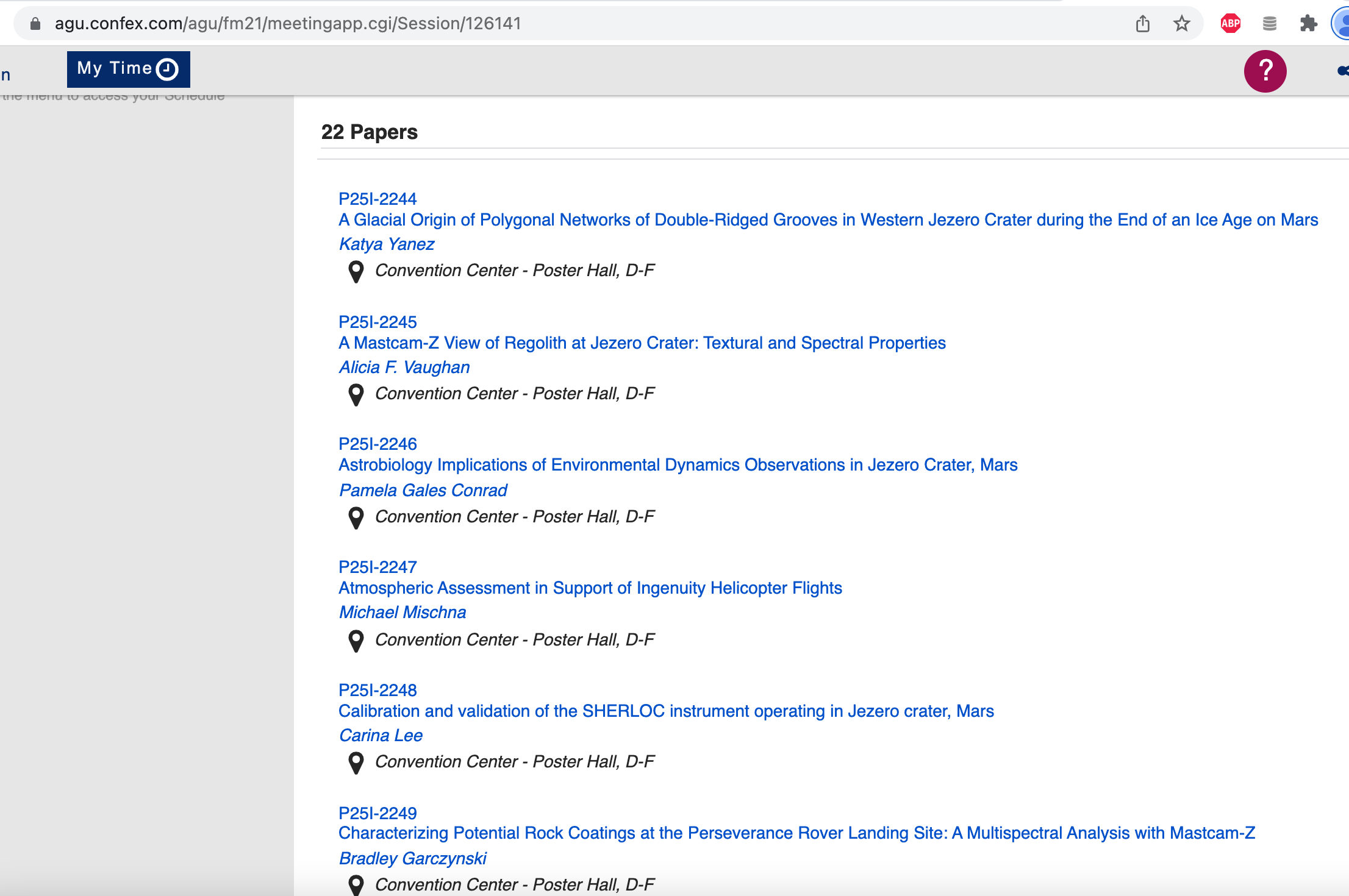
- -
#AGU21 Press conference: Ten months of Perseverance: Jezero science
https://www.youtube.com/watch?v=N0zWp-lR25g
Mars looks AMAZING in 8K! Perseverance Rover sol 353 (Sean Doran)
https://www.youtube.com/watch?v=xbiGCVHLJ28
Images courtesy NASA / JPL-Caltech / ASU / MSSS
Made with 24 images from Perseverance Rover on Sol 353 Image data was denoised, repaired, stitched, graded and rescaled for this film.
- -
New View of Jezero Delta, Mars | Perseverance Rover sol 383 (Sean Doran)
https://www.youtube.com/watch?v=tpeiIxIlub4
Images courtesy NASA / JPL-Caltech / ASU / MSSS
Made with 26 images from Perseverance Rover on Sol 383 Image data was denoised, repaired, stitched, graded and rescaled for this film.
00:00 Standard view
03:07 Zoom view
- - - - - - - - - - - - - - - - - - - - - - - - - - - - - - - - - - - - - - - - - - - -
Posted on January 2, 2022
Let's say the Earth is flat. What does the government gain from misrepresenting it as round?
https://www.quora.com/Lets-say-Earth-is-flat-What-does-the-government-gain-from-misrepresenting-it-as-round
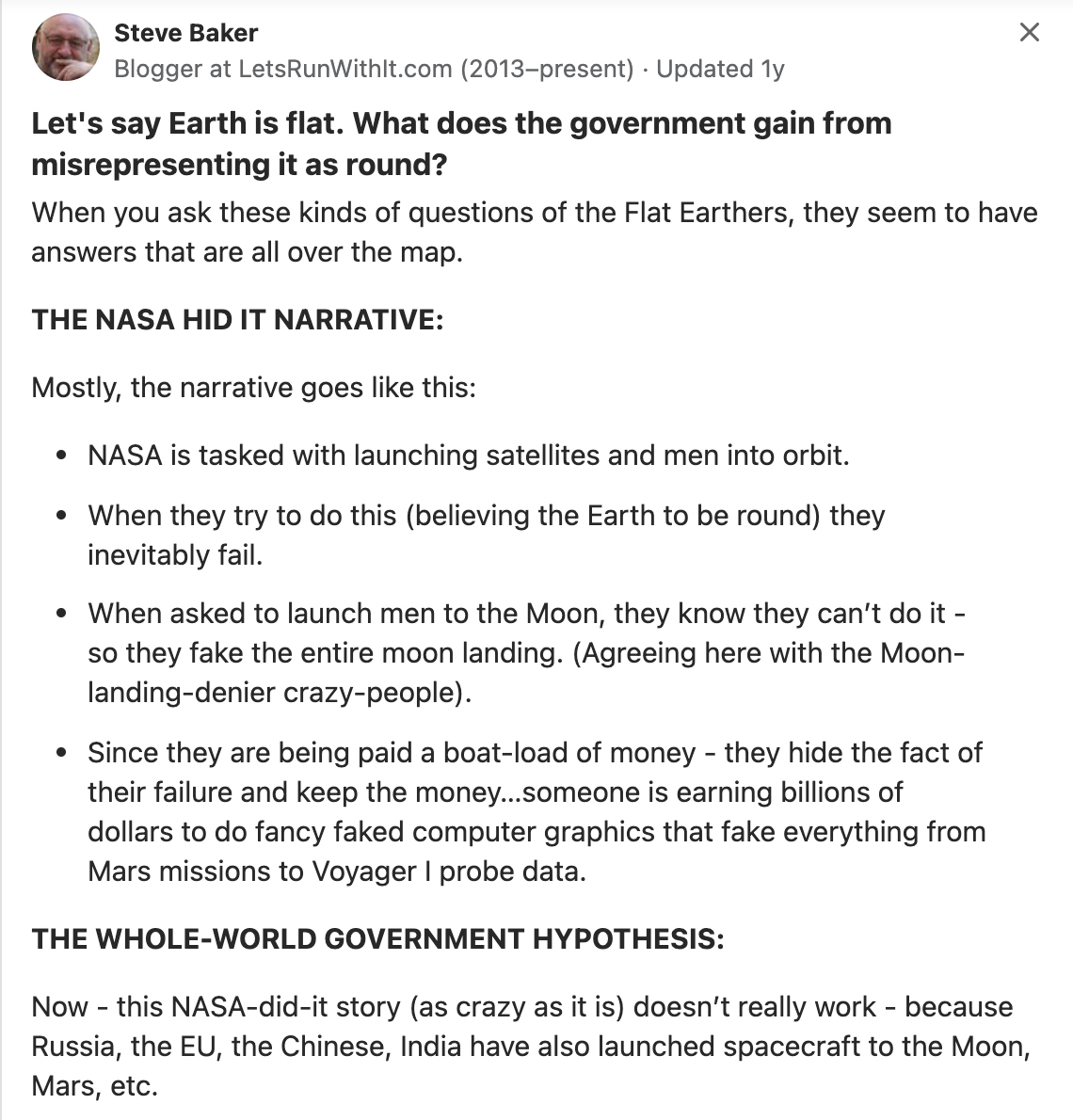
When you ask these kinds of questions of the Flat Earthers, they seem to have answers that are all over the map.
THE NASA HID IT NARRATIVE:
Mostly, the narrative goes like this:
- NASA is tasked with launching satellites and men into orbit.
- When they try to do this (believing the Earth to be round) they inevitably fail.
- When asked to launch men to the Moon, they know they can’t do it - so they fake the entire moon landing. (Agreeing here with the Moon-landing-denier crazy-people).
- Since they are being paid a boat-load of money - they hide the fact of their failure and keep the money…someone is earning billions of dollars to do fancy faked computer graphics that fake everything from Mars missions to Voyager I probe data.
THE WHOLE-WORLD GOVERNMENT HYPOTHESIS:
Now - this NASA-did-it story (as crazy as it is) doesn’t really work - because Russia, the EU, the Chinese, India have also launched spacecraft to the Moon, Mars, etc.
So somehow those other space agencies are also having to be paid off by NASA?
But this gets into crazy-territory very rapidly because now the Flat Earthers claim that the United Nations have vast fleets of ships, aircraft and drones circling the “Ice Wall” around the edge of the habitable Flat Earth who are tasked with keeping people away from trying to visit Antarctica.
So this can’t *just* be a NASA thing. It can’t even just be a US government thing - pretty much ALL governments have to be involved.
For that to work, the Flat Earthers have to get in line with another bunch of crazy-people who believe that there is a secret world-government that runs the entire planet…some of whom claim that Lizard-people are running the world.
One of my all time favorite Flat Earther comments was…
“The United Nations logo has the flat earth map right there inside it! It MUST BE TRUE!!”
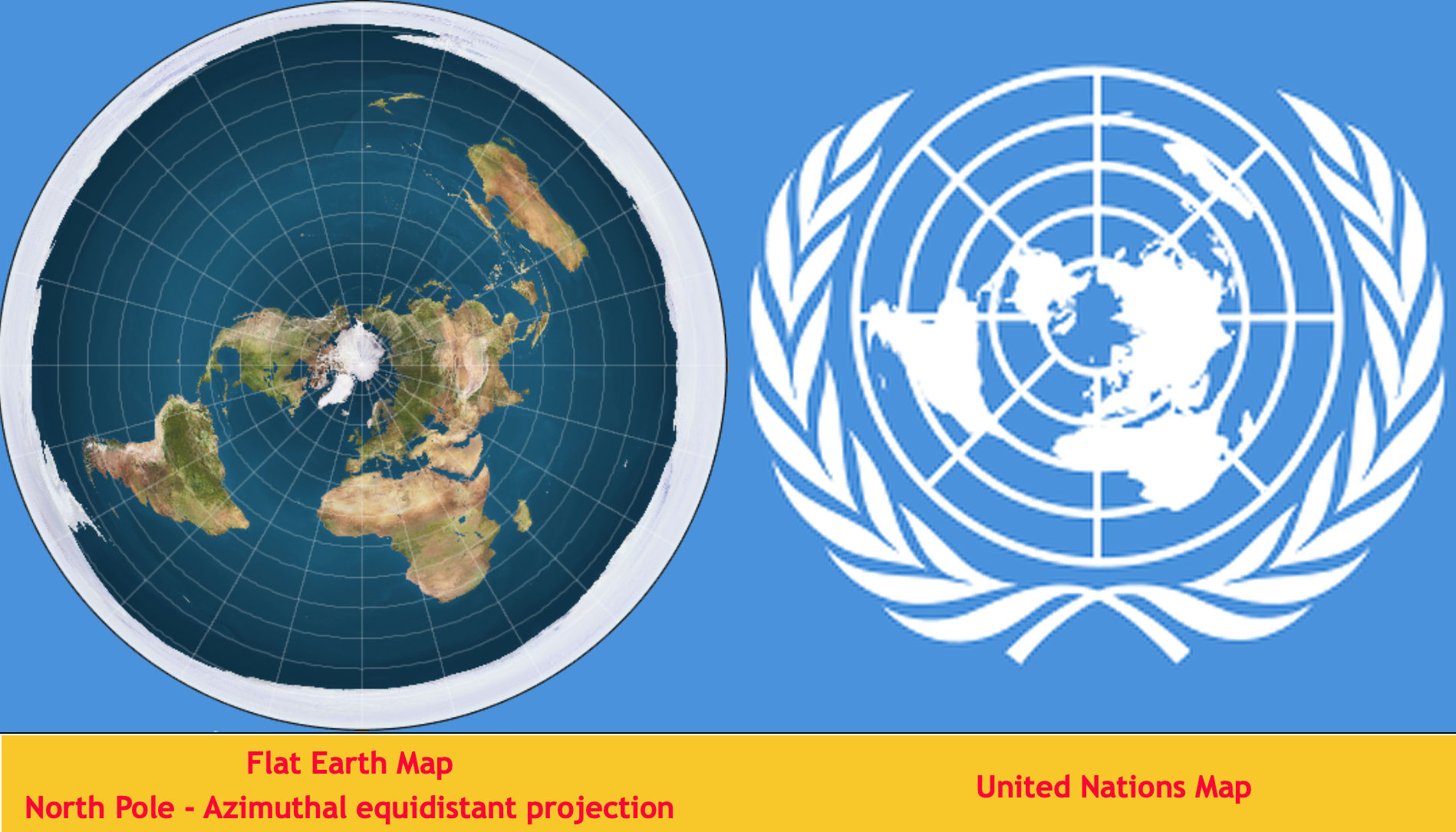
…and indeed, this is precisely what the most common Flat Earth map looks like!
Of course if the UN were actually trying to HIDE the ‘fact’ of the Earth being flat…what do you think would be the VERY LAST THING they’d put in their logo?!!
BIG BUSINESS INVOLVEMENT:
If there are no satellites - then GPS satellites can’t exist - so they claim that a network of huge radio towers around the world provides fake-GPS. That can’t happen without the manufacturers of GPS receivers knowing about it.
So Apple, Google, Microsoft, Lenovo and a hundred other tech companies must be in on the secret.
Now we also have a whole bunch of private companies like SpaceX, Blue Origins, Virgin Galactic, Bigalow - and a bunch of amateur balloon and rocket enthusiasts have all launched space missions - seemingly successfully - and in many cases, profitably.
So now most of big business has to be in on it.
THE NAVIGATION PROBLEM:
Because navigating at sea using stars and compass doesn’t work the same way for a Flat Earth as it does for a Round Earth - you have the problem of how people back in the 1600s through 1900s navigated the oceans of the world?
Their navigators would have had to be taught how to navigate using Flat Earth methods - even though all of the books and maps we have from those centuries are Round Earth based.
It can only be that every ship’s captain and navigator were taught both methods and sworn to utter secrecy.
This means that the Flat Earth conspiracy cannot POSSIBLY have started with NASA. People from around the world would have to have kept this secret for at least 400 years.
Consider the 1600s when piracy on the high seas was a major problem. How did the pirates navigate? They must have used stars and compass - and that means that they would have had to be trained in the secrets of the Flat Earth.
Wouldn’t some of them have blabbed the secrets? How do you keep a lawless pirate, drunk as all hell from telling people the secret?
Chinese sailors covered vast distances long before even that. So the Chinese knew about this (and hid it) more than 500 years ago.
Modern amateur yachtsmen still use compass and stars for navigation when their GPS fails. All of those people would have to be in on the conspiracy.
Because the distances between major cities is often VERY different in the Flat Earth than in the Round Earth, some airline flights in the Southern Hemisphere have to fly at least three times further to reach their destinations.
The fact that airplanes that can actually fly three times further (and three times faster) than we all believe they can is something that the plane manufacturers, the airlines and all of their pilots would have to understand - so they’re in on the conspiracy too.
WHO ELSE IS INVOLVED?
All governments everywhere know about it. All big businesses know about it. Everyone who captains a ship or airplane knows about it. People who fly long distances in the Southern Hemisphere would be able to look out of the window and see that they’re not flying the route that is claimed. People under the flight paths of those airliners would hear the sonic booms as they fly faster than the speed of sound.
HUGE numbers of people now know about it. As this knowledge is needed by such a VAST number of people - why bother to keep it secret anymore?
WHAT ABOUT FLIGHT SIMULATORS (AND WHY DO WE CARE?)
Because the airlines, airplane manufacturers and pilots are definitely all in on the conspiracy - so are companies that make flight simulators.
This may seem like a small matter compared to all of the other things - but it’s a VITAL part of my answer here.
You see I’ve spent the last 35 years of my life designing and writing the software that makes flight simulators work.
We most definitely simulate a ROUND earth. If you take the product I’m making right now, you can use it to simulate spacecraft and even a flight to the Moon using the exact same software we use for airline flight simulators. You can (in principle) go to one of the trade shows we do and watch the demo of that.
So - that means that I, personally must be secretly maintaining a second set of software - one set that we show publicly at trade shows and on our website - which shows a Round Earth - and another set which the airlines and airplane manufacturers use for training their pilots to fly those Mach 3 airliners over the southern hemisphere routes...
- - - - - - - - - - - - - - - - - - - - - - - - - - - - - - - - - - - - - - - - - - - -
Posted on January 1, 2022
How does the Flat Earth Model explain how the moon is upside down when viewed from the Southern Hemisphere?
https://www.quora.com/How-does-the-Flat-Earth-Model-explain-how-the-moon-is-upside-down-when-viewed-from-the-Southern-Hemisphere
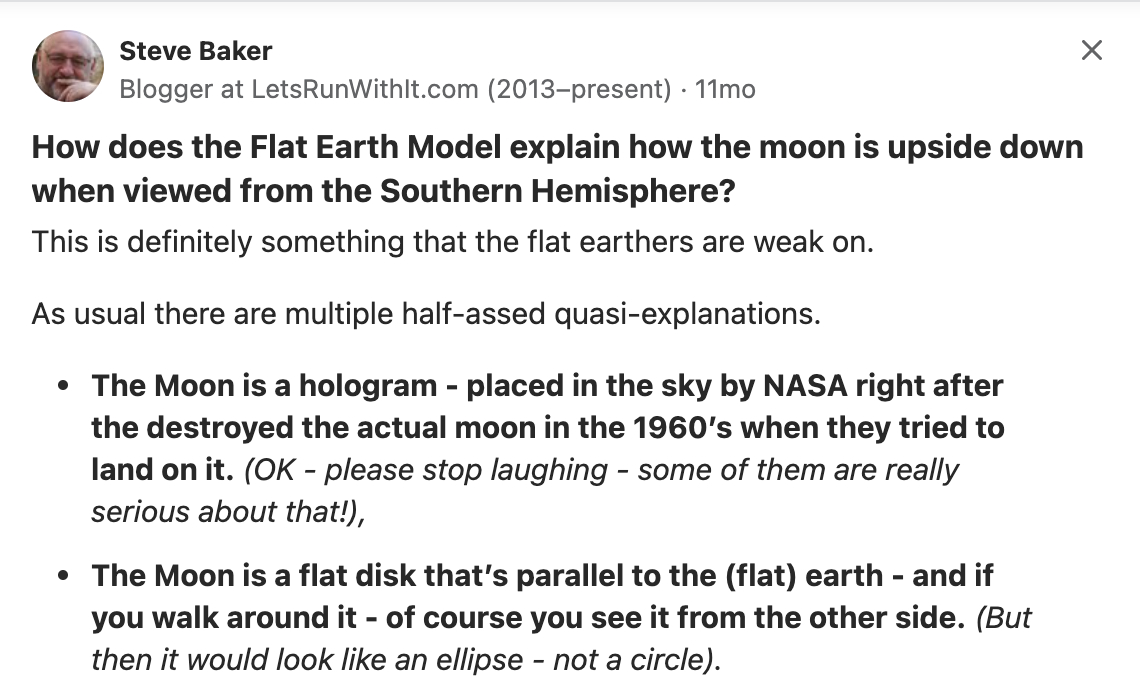
-
This is definitely something that the flat earthers are weak on.
As usual there are multiple half-assed quasi-explanations.
- The Moon is a hologram - placed in the sky by NASA right after the destroyed the actual moon in the 1960’s when they tried to land on it. (OK - please stop laughing - some of them are really serious about that!),
- The Moon is a flat disk that’s parallel to the (flat) earth - and if you walk around it - of course you see it from the other side. (But then it would look like an ellipse - not a circle).
- You’ve never been to the southern hemisphere so how do you KNOW that it’s upside down? All of those photos of it are faked. (Actually I have been to the southern hemisphere - but in any case, you can actually see the rotation just from living in different latitudes in the northern hemisphere).
- Nebulous ideas about refraction in the air, incorrect ideas about how perspective works, electromagnetic attraction of light rays…endless, endless nonsense.
- The phases of the moon (and presumably it’s patterning) are caused by vast numbers of migratory creatures like fireflies that live on the moon and continually change it’s light. (Er…that doesn’t actually explain it).
Someone on Quora recently posted a flat-earth craziness I was previously unaware of - which is that Australia doesn’t exist and all Australians are actors!! You really can’t make this stuff up!
- - - - - - - - - - - - - - - - - - - - - - - - - - - - - - - - - - - - - - - - - - - -
Posted on January 1, 2022
What are some good points made by flat Earthers?
https://www.quora.com/What-are-some-good-points-made-by-flat-Earthers
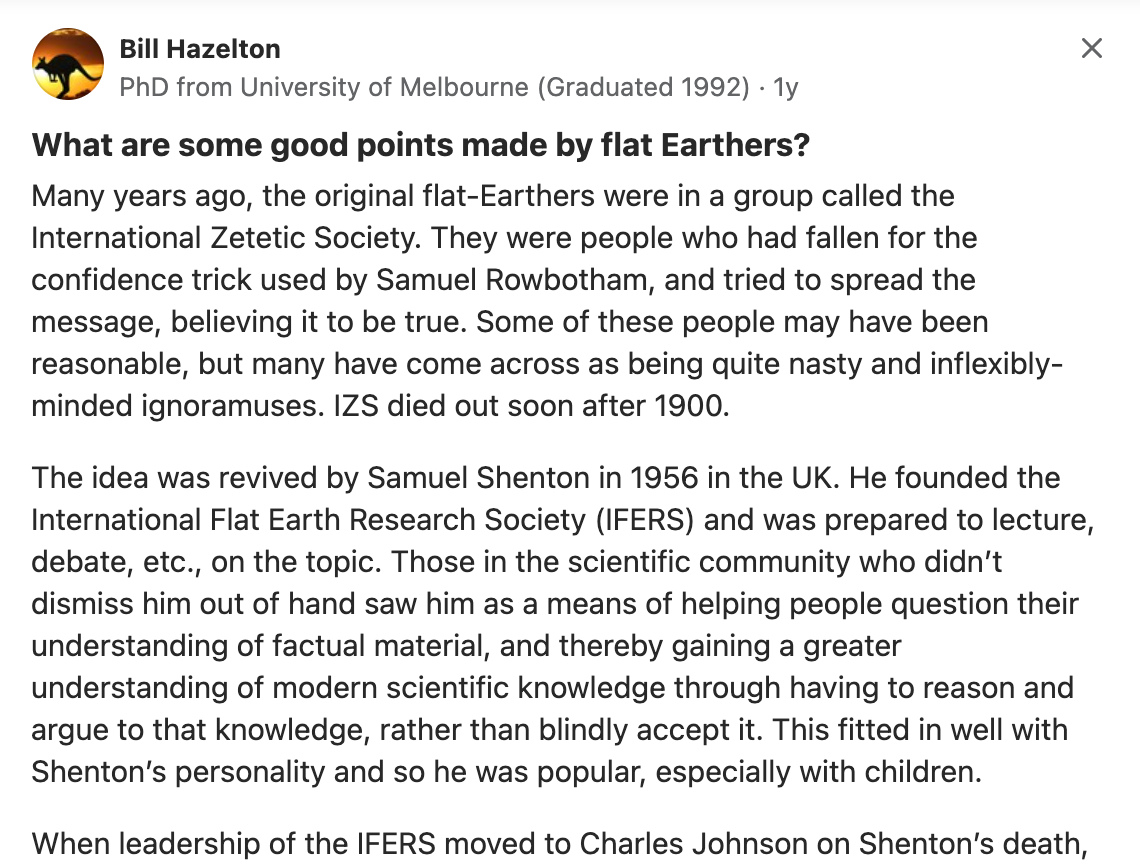
-
What are some good points made by flat Earthers? (January 28, 2020)
Many years ago, the original flat-Earthers were in a group called the International Zetetic Society. They were people who had fallen for the confidence trick used by Samuel Rowbotham, and tried to spread the message, believing it to be true. Some of these people may have been reasonable, but many have come across as being quite nasty and inflexibly-minded ignoramuses. IZS died out soon after 1900.
The idea was revived by Samuel Shenton in 1956 in the UK. He founded the International Flat Earth Research Society (IFERS) and was prepared to lecture, debate, etc., on the topic. Those in the scientific community who didn’t dismiss him out of hand saw him as a means of helping people question their understanding of factual material, and thereby gaining a greater understanding of modern scientific knowledge through having to reason and argue to that knowledge, rather than blindly accept it. This fitted in well with Shenton’s personality and so he was popular, especially with children.
When leadership of the IFERS moved to Charles Johnson on Shenton’s death, he pushed things harder and with a harder edge. But he was still a force for challenging what people thought they knew, and so continued to serve a useful purpose. It should be noted that Shenton and Johnson tried hard to make a rational case for a flat Earth and to debate it with others on an equal footing. In keeping with their civilized approach, they rarely (if ever) stooped to personal insults and abuse.
When Charles Johnson died, the IFERS faded. Around 2009, a Daniel Shenton (no relation) built a website, primarily to keep the older materials together and partly (I suspect) out of amusement and the connection of the name. Over time he started a forum to discuss flat Earth topics and then membership in IFERS. In 2011, the IFERS split over administrative issues and now operates as two branches. Within IFERS (or just FES), the older style of debate continues: reasonable and civilized. But it’s a fairly small group of people who largely keep to themselves and largely avoid proselytizing. They are not a problem to the larger community (despite moronic accusations of ‘controlled opposition’ from the real problem children outside the FES).
Up to this point, flat-Earthers were largely ignored by those in the mainstream of science, especially those in the geodesy and surveying field. There were occasional interactions, but no-one took the IFERS very seriously, in any sense. Several geodesists became members just so they could post the membership certificate on their office walls. So the 1956 to 2013 IFERS/FES efforts were harmless and if anything a small positive through their questioning of knowledge. Sir Patrick Moore, the English astronomer, certainly thought so. To this day they remain a small group of people focused on their beliefs, but largely leaving other people alone, and thus continuing this tradition.
In mid-2014, a weaponized version of Flat Earth Doctrine was launched as a means of attacking the economies of Western democracies. Building on the confidence trick developed by Rowbotham in the 1840s, FED was pushed relentlessly for about 3 years by a small group of trolls. By that time is had become a self-sustaining effort, as enough people were also exploiting the gullibility of those duped into engaging with the material. In this weaponized version, rational argument was not attempted: material was cut and pasted from repositories to attempt to crush opponents who were trying to make rational arguments; any debunking allowed the FED advocate to move straight to abuse and insults, as there was no rational foundation to the FED case, and they needed to push it harder. See also: Bill Hazelton's answer to Why don't flat earthers understand that they are being fooled by who sustains their theory just to sell them flat earth merchandising?
In summary, while the inheritors of the IFERS tradition maintain that ethic, those tangled up with the weaponized FED material are not nice people at all, in the depths of their hearts. They are either pushing the weapons and using them to undermine their own country, or are using them to ‘self-medicate’ for their psychological issues. As such, those helping to disseminate the weaponized FED material have absolutely zero good points themselves, and have zero good points to make. This matches the amount of credible evidence they have to support FED: zero.
- - -
Why don't flat earthers understand that they are being fooled by who sustains their theory just to sell them flat earth merchandising? (December 6, 2020)
https://www.quora.com/Why-dont-flat-earthers-understand-that-they-are-being-fooled-by-who-sustains-their-theory-just-to-sell-them-flat-earth-merchandising/answer/Bill-Hazelton-1?ch=10&share=aecac22d&srid=35tyC
Selling the merchandise is trivial income, as is the income from ads and the like. It keeps a relatively small number of content-creators working. There’s no real ‘big business’ behind flat-Earth.
Flat Earth Doctrine (FED) was developed as a confidence trick in the late 1840s, and it was carefully refined to be progressively more effective. The gullible souls sucked into it don’t have the skills and knowledge to get out, and it’s carefully designed to connect to other belief systems. So it’s hard to get out of a believer’s mindset, as it’s purely an emotional belief.
But the mid-2014 relaunch of FED wasn’t a commercial operation. It was an attack on Western democracies, carefully contrived and worked, and carefully co-ordinated with the related attacks using other kinds of pseudoscience and related BS, e.g. Creationism, climate change denial, anti-vaxx. The name of the game was to create a self-sustaining group of purveyors of FED, so that the economic damage would be largely generated by people within the target economies. With all these things, it appears to have worked well. The various weaponized materials and domains weren’t an original idea, but they were exploited in ways to cause disruption and conflict.
And it has been an outstanding success. As the Primary Target, the US is in internal turmoil. In the 21st century, which is being (and will continue to be) dominated by science and technology (especially biological science) as the primary drivers of advanced economies, the attack on science (especially biology), mathematics, engineering and related fields is unprecedented and will have a real impact on the US economy. This impact will grow over time. After the coming recession, the US will be substantially weakened as an economic power, and will begin the long slide, ably assisted by a whole cadre of unwitting fifth columnists.
That kinda beats out selling a bit of merch on the side.
In mid-2014, a weaponized version of Flat Earth Doctrine was launched as a means of attacking the economies of Western democracies. Building on the confidence trick developed by Rowbotham in the 1840s, FED was pushed relentlessly for about 3 years by a small group of trolls. By that time is had become a self-sustaining effort, as enough people were also exploiting the gullibility of those duped into engaging with the material. In this weaponized version, rational argument was not attempted: material was cut and pasted from repositories to attempt to crush opponents who were trying to make rational arguments; any debunking allowed the FED advocate to move straight to abuse and insults, as there was no rational foundation to the FED case, and they needed to push it harder.
In summary, while the inheritors of the IFERS tradition maintain that ethic, those tangled up with the weaponized FED material are not nice people at all, in the depths of their hearts. They are either pushing the weapons and using them to undermine their own country, or are using them to ‘self-medicate’ for their psychological issues. As such, those helping to disseminate the weaponized FED material have absolutely zero good points themselves, and have zero good points to make. This matches the amount of credible evidence they have to support FED: zero.
- - - - - - - - - - - - - - - - - - - - - - - - - - - - - - - - - - - - - - - - - - - -
Posted on December 31, 2021
International Space Station (ISS) Operations Formerly Extended Through 2030 (spaceref.com)
http://spaceref.com/international-space-station/international-space-station-operations-formally-extended-through-2030.html
Excerpt:
The Biden-Harris Administration has extended International Space Station operations through 2030.
NASA Administrator Bill Nelson announced today the Biden-Harris Administration's commitment to extend International Space Station (ISS) operations through 2030, and to work with our international partners in Europe (ESA, European Space Agency), Japan (JAXA, Japan Aerospace Exploration Agency), Canada (CSA, Canadian Space Agency), and Russia (State Space Corporation Roscosmos) to enable continuation of the groundbreaking research being conducted in this unique orbiting laboratory through the rest of this decade.
"The International Space Station is a beacon of peaceful international scientific collaboration and for more than 20 years has returned enormous scientific, educational, and technological developments to benefit humanity. I'm pleased that the Biden-Harris Administration has committed to continuing station operations through 2030," Nelson said. "The United States' continued participation on the ISS will enhance innovation and competitiveness, as well as advance the research and technology necessary to send the first woman and first person of color to the Moon under NASA's Artemis program and pave the way for sending the first humans to Mars. As more and more nations are active in space, it's more important than ever that the United States continues to lead the world in growing international alliances and modeling rules and norms for the peaceful and responsible use of space."
Over the past two decades, the United States has maintained a continuous human presence in orbit around the Earth to test technologies, conduct scientific research, and develop skills needed to explore farther than ever before. The unique microgravity laboratory has hosted more than 3,000 research investigations from over 4,200 researchers across the world and is returning enormous scientific, educational, and technological developments to benefit people on Earth. Nearly 110 countries and areas have participated in activities aboard the station, including more than 1,500,000 students per year in STEM activities.
Instruments aboard the ISS, used in concert with free-flying instruments in other orbits, help us measure the stresses of drought and the health of forests to enable improved understanding of the interaction of carbon and climate at different time scales. Operating these and other climate-related instruments through the end of the decade will greatly increase our understanding of the climate cycle.
Extending operations through 2030 will continue another productive decade of research advancement and enable a seamless transition of capabilities in low-Earth orbit to one or more commercially owned and operated destinations in the late 2020s. The decision to extend operations and NASA's recent awards to develop commercial space stations together ensure uninterrupted, continuous human presence and capabilities; both are critical facets of NASA's International Space Station transition plan.
Please follow SpaceRef on Twitter and Like us on Facebook.
(Please read the article at the URL posted above)
- -
The International Space Station Wraps Up a Busy 2021 (nasaspaceflight.com)
https://www.nasaspaceflight.com/2021/12/international-space-station-2021/
Russian Orbital Segment Expansion
U.S. Orbital Segment Expansion
Russian ASAT Test
Tourism Flights
Visiting vehicles of 2021:
In 2021, a total of seven crewed missions arrived and/or departed the Station. This included Soyuz MS-17, Crew-1, Soyuz MS-18, Crew-2, Soyuz MS-19, Crew-3, and Soyuz MS-20.
In the spring, the Crew-1 and Crew-2 missions had a direct handover – where both crews are on the Station together for a short time – while in the fall delays led to an indirect handover between both Crew-2 and Crew-3 missions on the ISS. During the departure of the Crew-2 mission, Crew Dragon Endeavour conducted a fly-around of the ISS, providing new photos of the orbiting outpost.
Also in the spring, Soyuz MS-18 launched to the ISS for a direct handover with the Soyuz MS-17 crew, who later departed the Station in April. Soyuz MS-18 undocked in the fall with two spaceflight participants and one cosmonaut.
(Soyuz MS-18 launch marks 60 years of human space flight)
Both Pyotr Dubrov, and Mark Vande Hei have had their stays on the ISS extended, as they launched on Soyuz MS-18 in April of 2020 and will land on Soyuz MS-19. Upon landing they will have been in space for almost a year.
Below is a table of all visiting vehicles that were part of the ISS this year.
| Spacecraft | Launch | Docking | Undocking |
| Progress MS-15 | July 23, 2020 | July 23, 2020 | Feb. 9, 2021 |
| Soyuz MS-17 | Oct. 14, 2020 | Oct. 14, 2020 | Apr. 17, 2021 |
| Dragon Resilience (Crew-1) | Nov. 16, 2020 | Nov. 17, 2020 | May 2, 2021 |
| CRS-21 | Dec. 6, 2020 | Dec. 7, 2020 | Jan. 12, 2021 |
| Progress MS-16 | Feb. 15, 2021 | Feb. 17, 2021 | July 26, 2021 |
| NG-15 | Feb. 20, 2021 | Feb. 22, 2021 | June 29, 2021 |
| Soyuz MS-18 | Apr. 9, 2021 | Apr. 9, 2021 | Oct. 17, 2021 |
| Dragon Endeavour
(Crew-2) |
Apr. 23, 2021 | Apr. 24, 2021 | Nov. 8, 2021 |
| CRS-21 | June 3, 2021 | June 5, 2021 | July 8, 2021 |
| Progress MS-17 | June 29, 2021 | July 2, 2021 | Nov. 25, 2021 |
| NG-16 | Aug. 10, 2021 | Aug. 12, 2021 | Nov. 20, 2021 |
| CRS-23 | Aug. 29, 2021 | Aug. 30, 2021 | Sept. 30, 2021 |
| Soyuz MS-19 | Oct. 5, 2021 | Oct. 5, 2021 | March 2022 – On Orbit |
| Progress MS-18 | Oct. 28, 2021 | Oct. 30, 2021 | On Orbit |
| Dragon Endurance
(Crew-3) |
Nov. 11, 2021 | Nov. 11, 2021 | Apr. 2022 – On Orbit |
| Progress M-UM | Nov. 24, 2021 | Nov. 26, 2021 | Dec. 22, 2021 |
| Soyuz MS-20 | Dec. 8, 2021 | Dec. 8, 2021 | Dec. 19, 2021 |
| CRS-24 | Dec. 21, 2021 | Dec. 22, 2021 | On Orbit |
(Please read the article at the URL posted above)
- - - - - - - - - - - - - - - - - - - - - - - - - - - - - - - - - - - - - - - - - - - -
Posted on December 25, 2021
James Webb telescope has left Earth today on an enterprising mission.
The telescope is named after James E. Webb, who was the administrator of NASA from 1961 to 1968 and played an integral role in the Apollo program. Development began in 1996 for a launch. After reaching its orbit, Webb undergoes science and calibration testing. Then, regular science operations and images will begin to arrive, approximately six months after launch.
The James Webb Space Telescope was launched TODAY on an Ariane 5 rocket. The launch vehicle is part of the European contribution to the mission. The Ariane 5 is one of the world's most reliable launch vehicles capable of delivering Webb to its destination in space. The European Space Agency (ESA) has agreed to provide an Ariane 5 launcher and associated launch services to NASA for Webb. The Ariane 5's record for successful consecutive launches is 80.
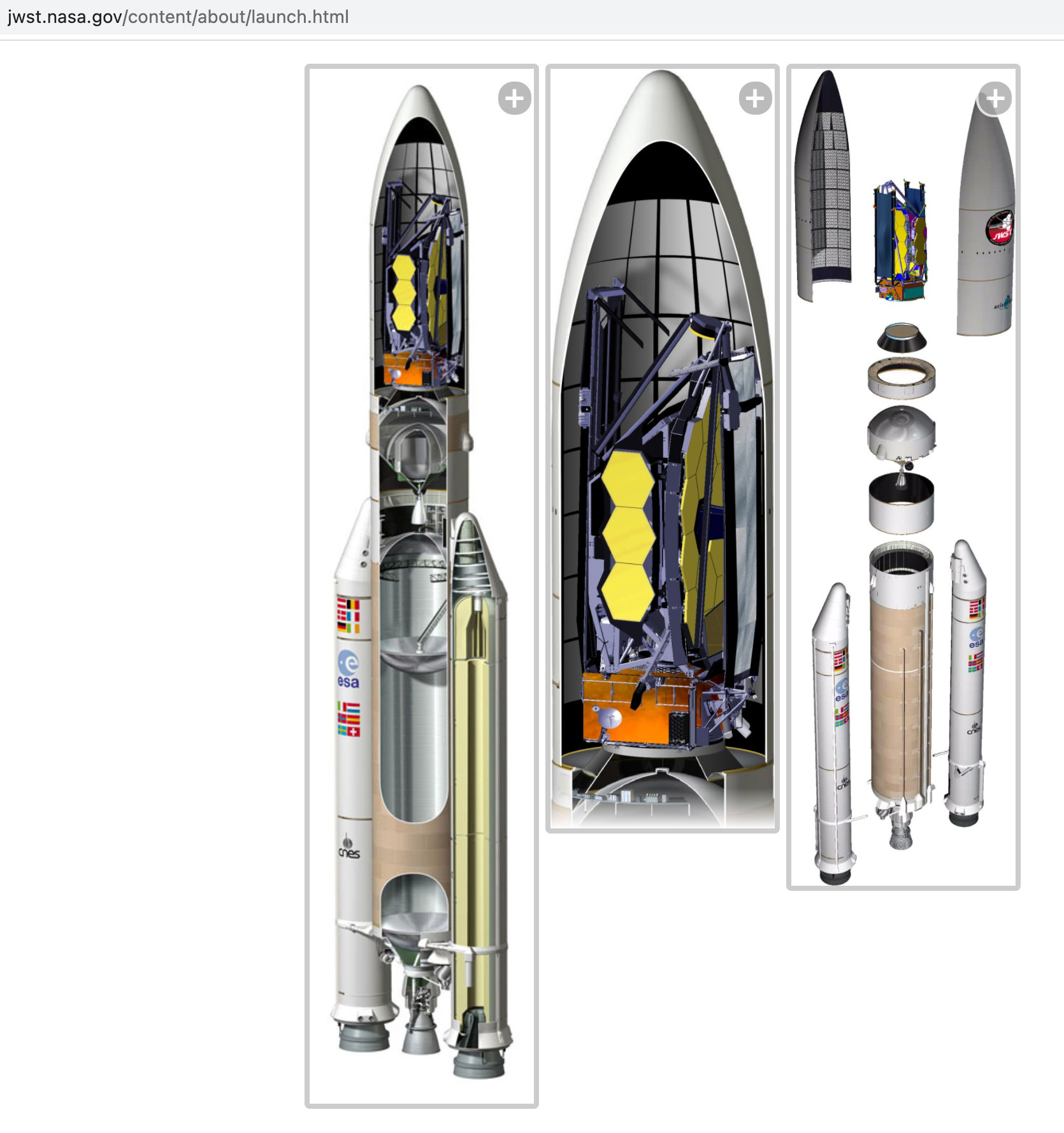
- - -
https://www.youtube.com/watch?v=IVvX-P6O5WU&t=4s
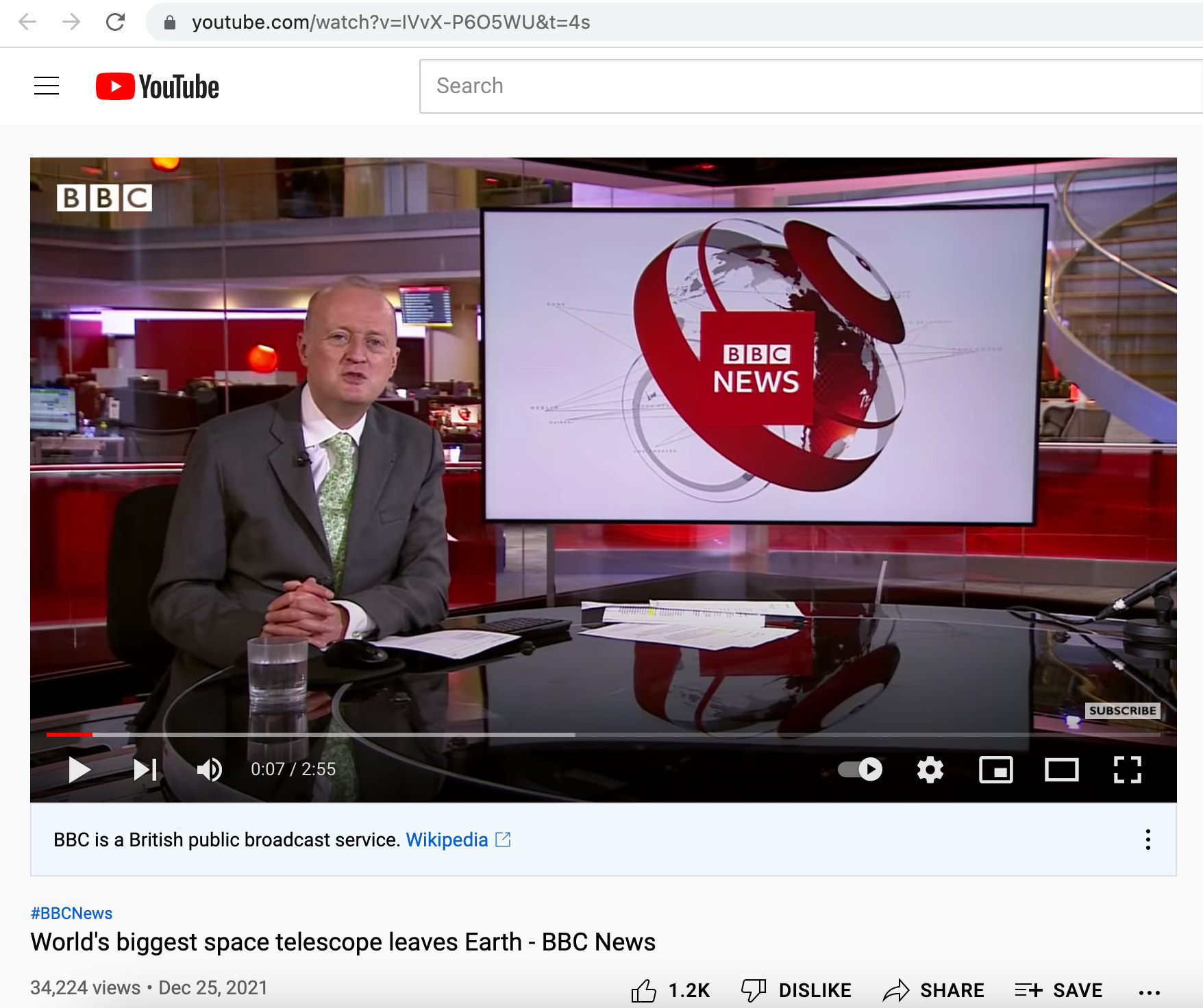
- - -
James Webb Telescope lifts off on historic mission (bbc.com)
https://www.bbc.com/news/science-environment-59782057
Excerpt:
The $10bn James Webb telescope has left Earth on its mission to show the first stars to light up the Universe.
The observatory was lifted skyward by an Ariane rocket from the Kourou spaceport in French Guiana.
Its flight to orbit lasted just under half an hour, with a signal confirming a successful outcome picked up by a ground antenna at Malindi in Kenya.
Webb, named after one of the architects of the Apollo Moon landings, is the successor to the Hubble telescope.
Engineers working with the US, European and Canadian space agencies have built the new observatory to be 100 times more powerful, however.
"Lift off from a tropical rainforest to the edge of time itself, James Webb begins a voyage back to the birth of the Universe," said American space agency (Nasa) TV commentator Rob Navias at the moment the rocket left the Earth.
Lift-off was eagerly awaited but accompanied also by a good deal of anxiety. Thousands of people worldwide have worked on the project over the past 30 years, and even though the Ariane is a very dependable vehicle - there are no guarantees when it comes to rockets.
(Please read the article as posted in the URL above)
- - -
Launch of NASA's James Webb Space Telescope on Ariane 5 Rocket (Space Videos)
https://www.youtube.com/watch?v=GBJdszEMXTQ
Launch on an Arianespace Ariane 5 rocket took place on Christmas Day, December 25th at 07:20 Eastern, 12:20 UTC.
- - -
Now, for James Webb Telescope '30 days of terror' (earthsky.org)
https://earthsky.org/space/james-webb-space-telescope-30-days-of-terror/
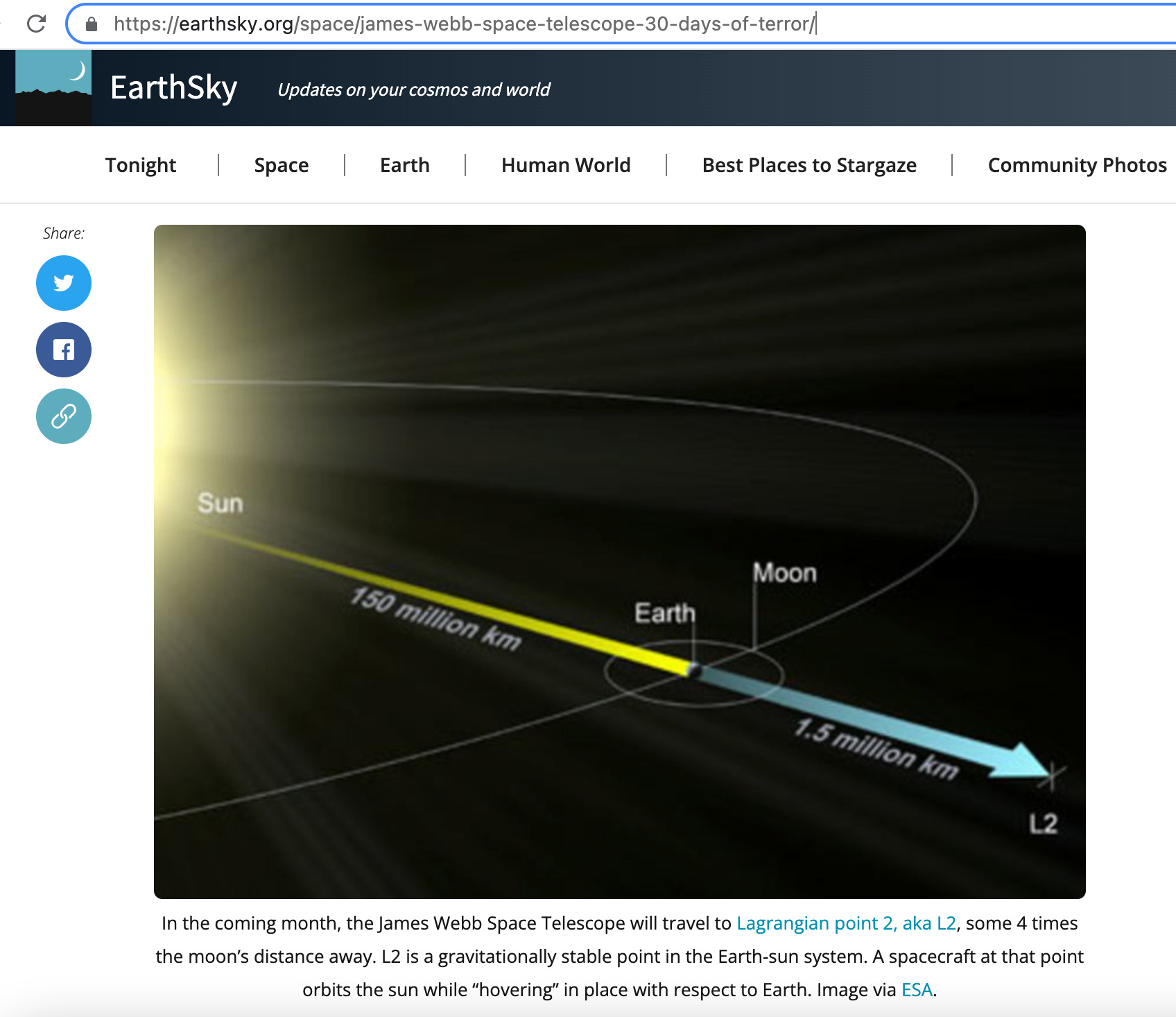
Excerpt:
30 days of terror for the Webb
The James Webb Space Telescope is on its way to L2, following a successful launch on December 25, 2021. Astronomers following plans for the launch agree: it was a relief to see the $9.7-billion space telescope go up at last. After all, this telescope – the most complicated ever built – has been under development for decades. And the hopes and dreams of astronomers are pinned upon it. But the launch was just the beginning. Unlike the Hubble Space Telescope and thousands of other satellites, the Webb won’t orbit Earth. Webb is now journeying to Lagrangian point 2, aka L2, which is almost 1 million miles (1.5 million km) behind Earth as viewed from the sun … or about four times the moon’s distance. It’ll take the Webb about a month to reach L2. And, during its journey, the massive telescope isn’t remaining snug in its packaging. It’ll be slowly unfolding into its final configuration, with hundreds of moving pieces that have to operate exactly as designed. Clearly, something might go wrong. And that’s why many are jokingly calling the month after launch 30 days of terror for the Webb.
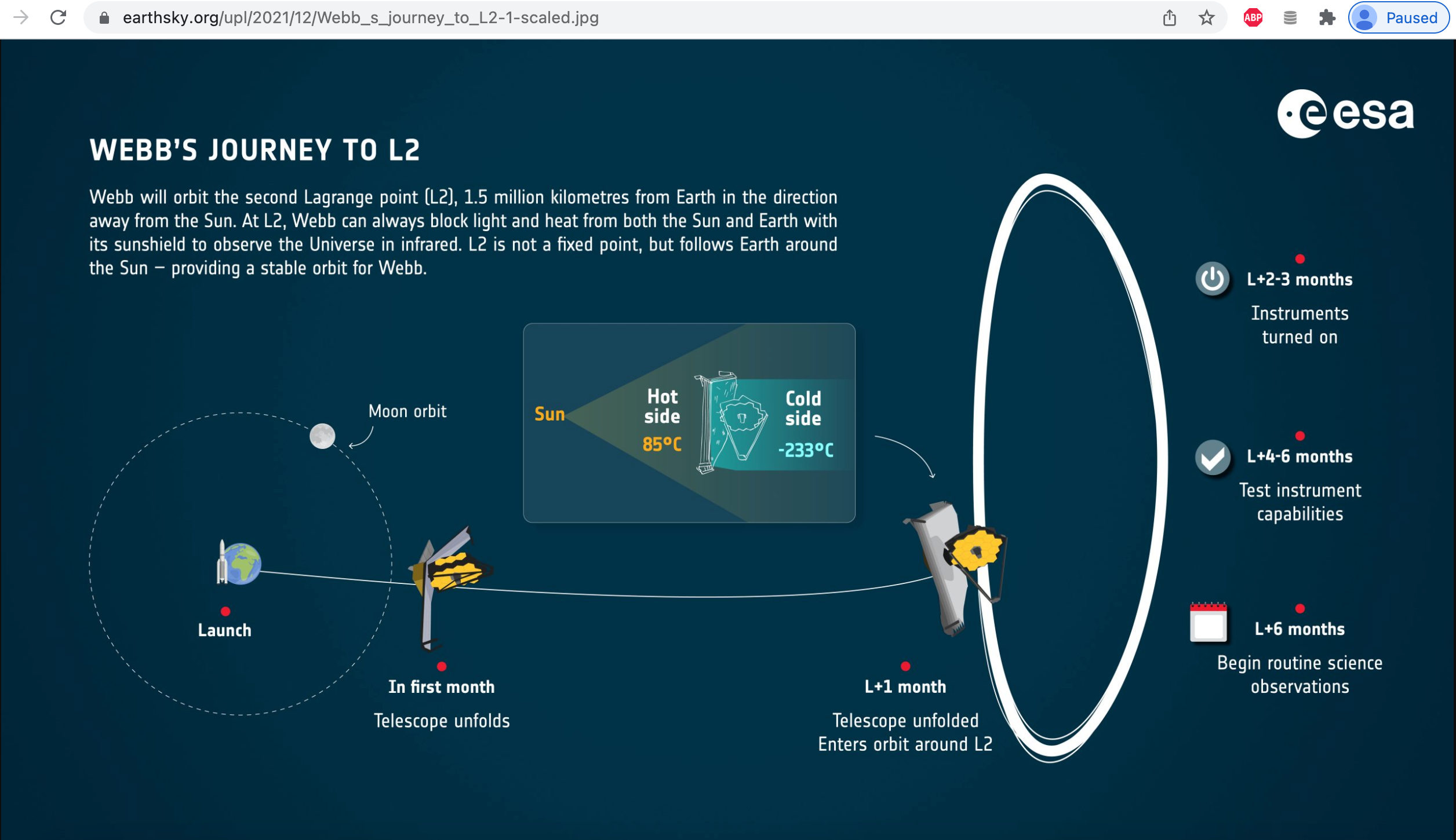
(Please read the article as posted in the URL above)
- - -
James Webb Space Telescope 26 December, 2021 Update - First Mid-Course Correction Burn Completed (spaceref.com)
http://spaceref.com/missions-and-programs/nasa/james-webb-space-telescope-26-december-2021-update---first-mid-course-correction-burn-completed.html
At 7:50 pm EST, December 25, 2021, Webb's first mid-course correction burn began.
It lasted 65 minutes and is now complete. This burn is one of two milestones that are time critical -- the first was the solar array deployment, which happened shortly after launch.
This burn adjusts Webb's trajectory toward the second Lagrange point, commonly known as L2. After launch, Webb needs to make its own mid-course thrust correction maneuvers to get to its orbit. This is by design: Webb received an intentional slight under-burn from the Ariane-5 that launched it into space, because it's not possible to correct for overthrust. If Webb gets too much thrust, it can't turn around to move back toward Earth because that would directly expose its telescope optics and structure to the Sun, overheating them and aborting the science mission before it can even begin.
Therefore, we ease up to the correct velocity in three stages, being careful never to deliver too much thrust -- there will be three mid-course correction maneuvers in total.
After this burn, no key milestones are time critical, so the order, location, timing, and duration of deployments may change.
You can track where Webb is in the process and read about upcoming deployments. NASA has a detailed plan to deploy the Webb Space Telescope over a roughly two-week period.The deployment process is not an automatic hands-off sequence; it is human-controlled. The team monitors Webb in real-time and may pause the nominal deployment at any time. This means that the deployments may not occur exactly in the order or at the times originally planned.
(Please read the article as posted in the URL above)
- - -
LIVE Tracking - Where is Webb? (webb.nasa.gov)
https://webb.nasa.gov/content/webbLaunch/whereIsWebb.html
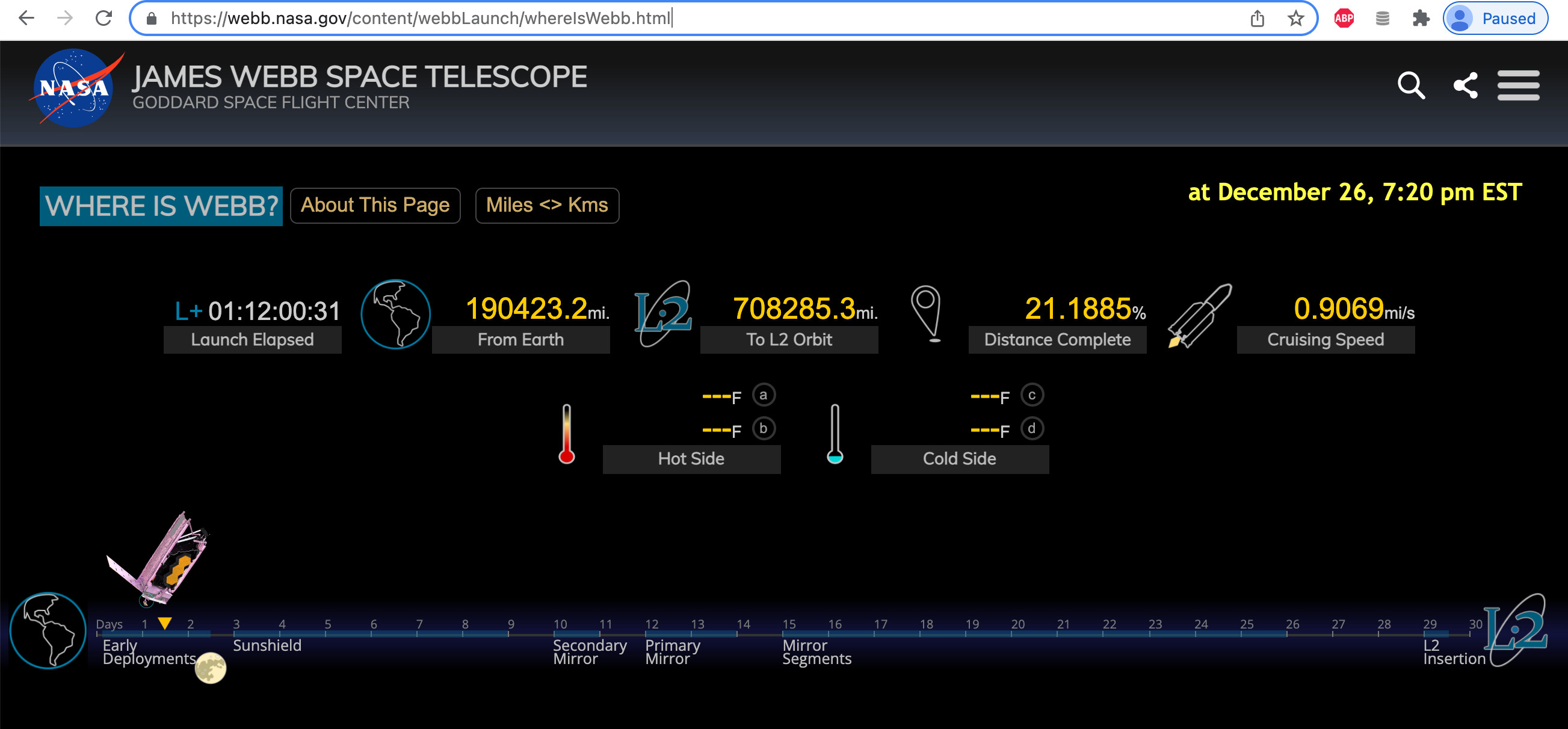
-
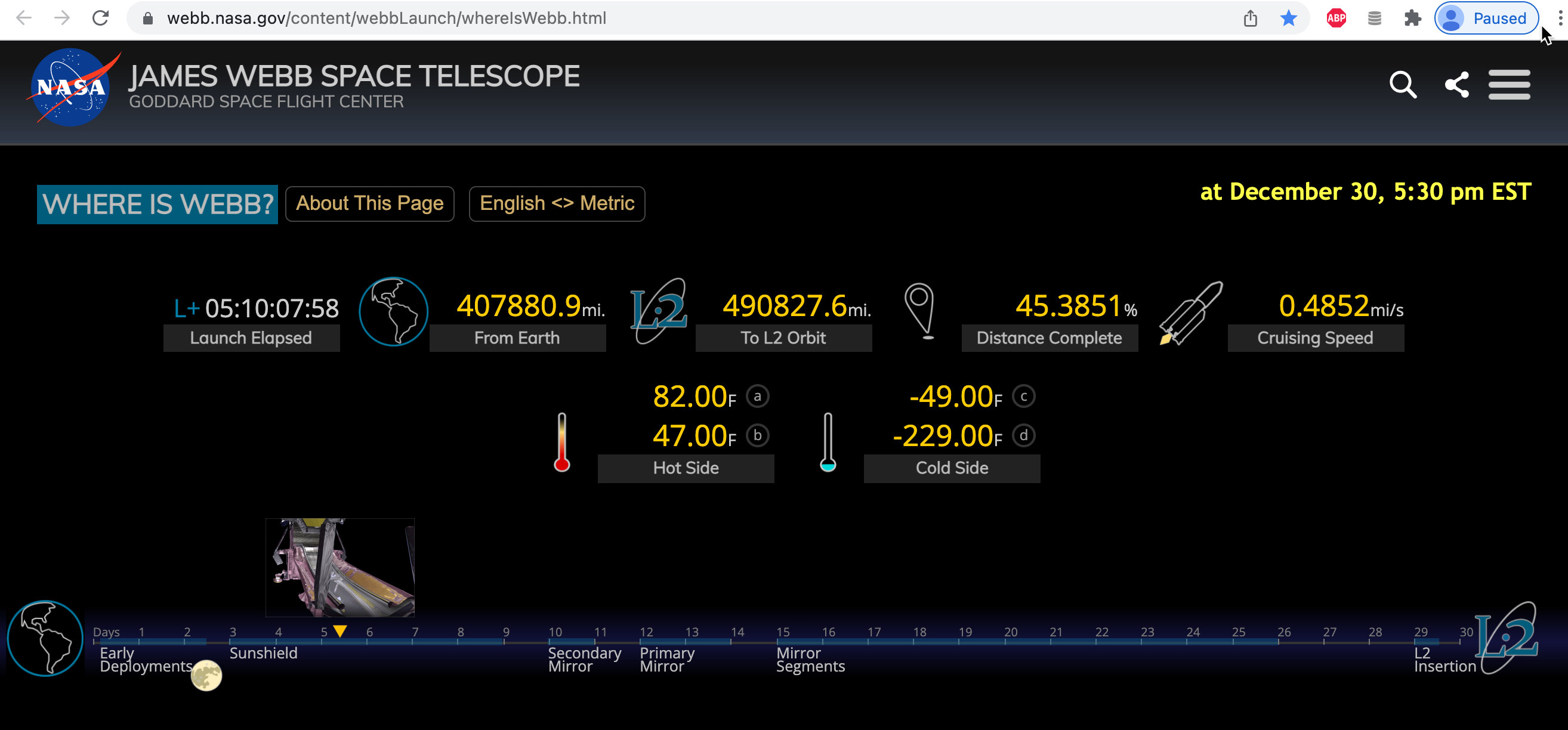
- - -
Update: January 4, 2022
Second and third layers of Webb telescope sun shield fully tighened (phys.org)
https://phys.org/news/2022-01-layers-webb-telescope-sunshield-fully.html
The Webb team has completed tensioning for the first three layers of the observatory's kite-shaped sunshield, 47 feet across and 70 feet long.
The first layer—pulled fully taut into its final configuration—was completed mid-afternoon.
The team began the second layer at 4:09 pm EST today, and the process took 74 minutes. The third layer began at 5:48 pm EST, and the process took 71 minutes. In all, the tensioning process from the first steps this morning until the third layer achieved tension took just over five and a half hours.
These three layers are the ones closest to the Sun. Tensioning of the final two layers is planned for tomorrow.
"The membrane tensioning phase of sunshield deployment is especially challenging because there are complex interactions between the structures, the tensioning mechanisms, the cables and the membranes," said James Cooper, NASA's Webb sunshield manager, based at Goddard Space Flight Center. "This was the hardest part to test on the ground, so it feels awesome to have everything go so well today. The Northrop and NASA team is doing great work, and we look forward to tensioning the remaining layers."
Once fully deployed, the sunshield will protect the telescope from the Sun's radiation. It will reach a maximum of approximately 383K, approximately 230 degrees F, while keeping the instruments cold at a minimum of approximately 36K or around -394 degrees F.
The James Webb Space Telescope is the world's largest, most powerful, and most complex space science telescope ever built. Webb will solve mysteries in our solar system, look beyond to distant worlds around other stars, and probe the mysterious structures and origins of our universe and our place in it. Webb is an international program led by NASA with its partners, ESA (European Space Agency) and the Canadian Space Agency.
(Please read the article posted at the URL above)
- - -
Update: January 8, 2021
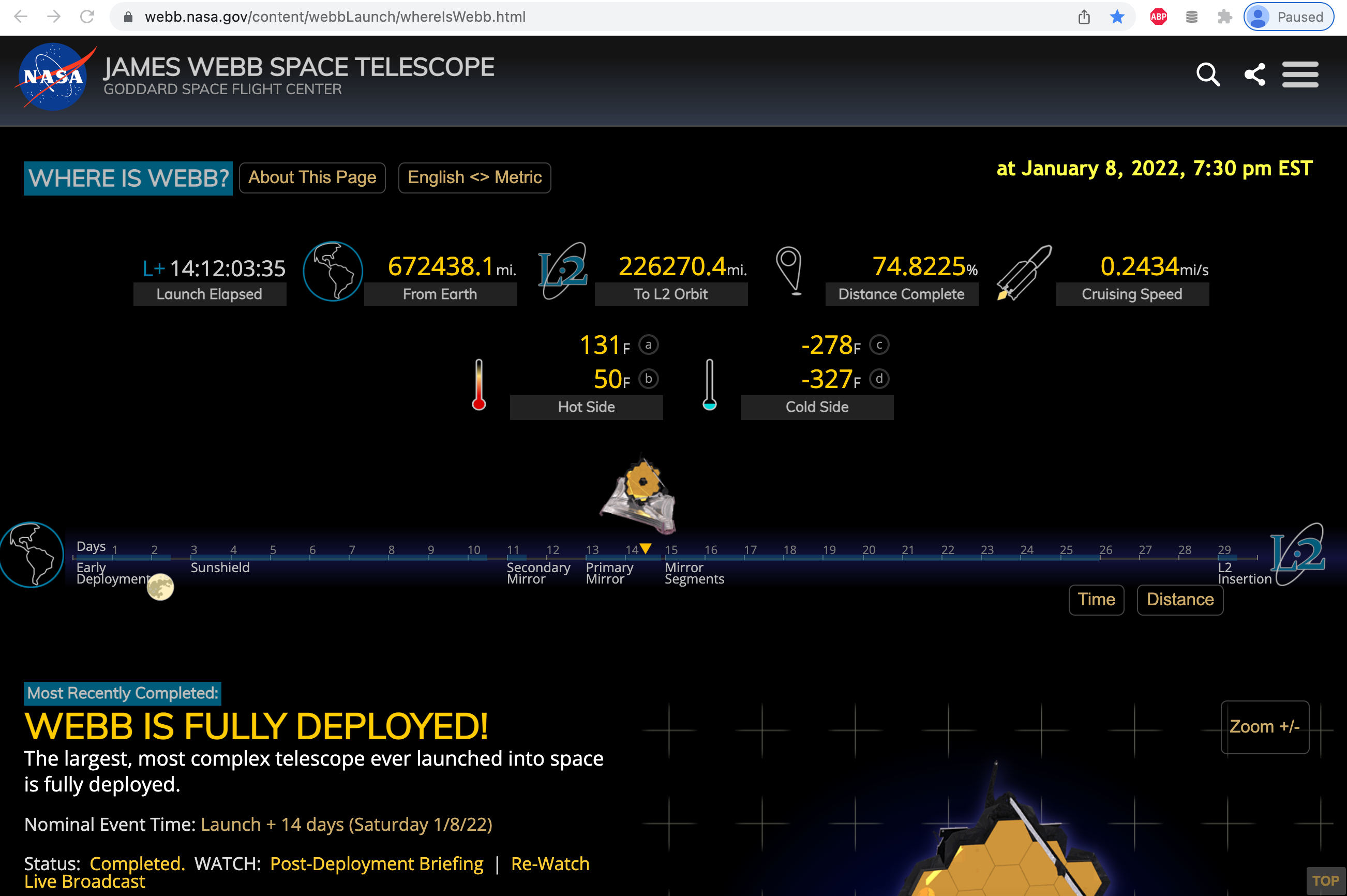
- - -
Update: January 17, 2022
Horizontal scale is by distance to L2
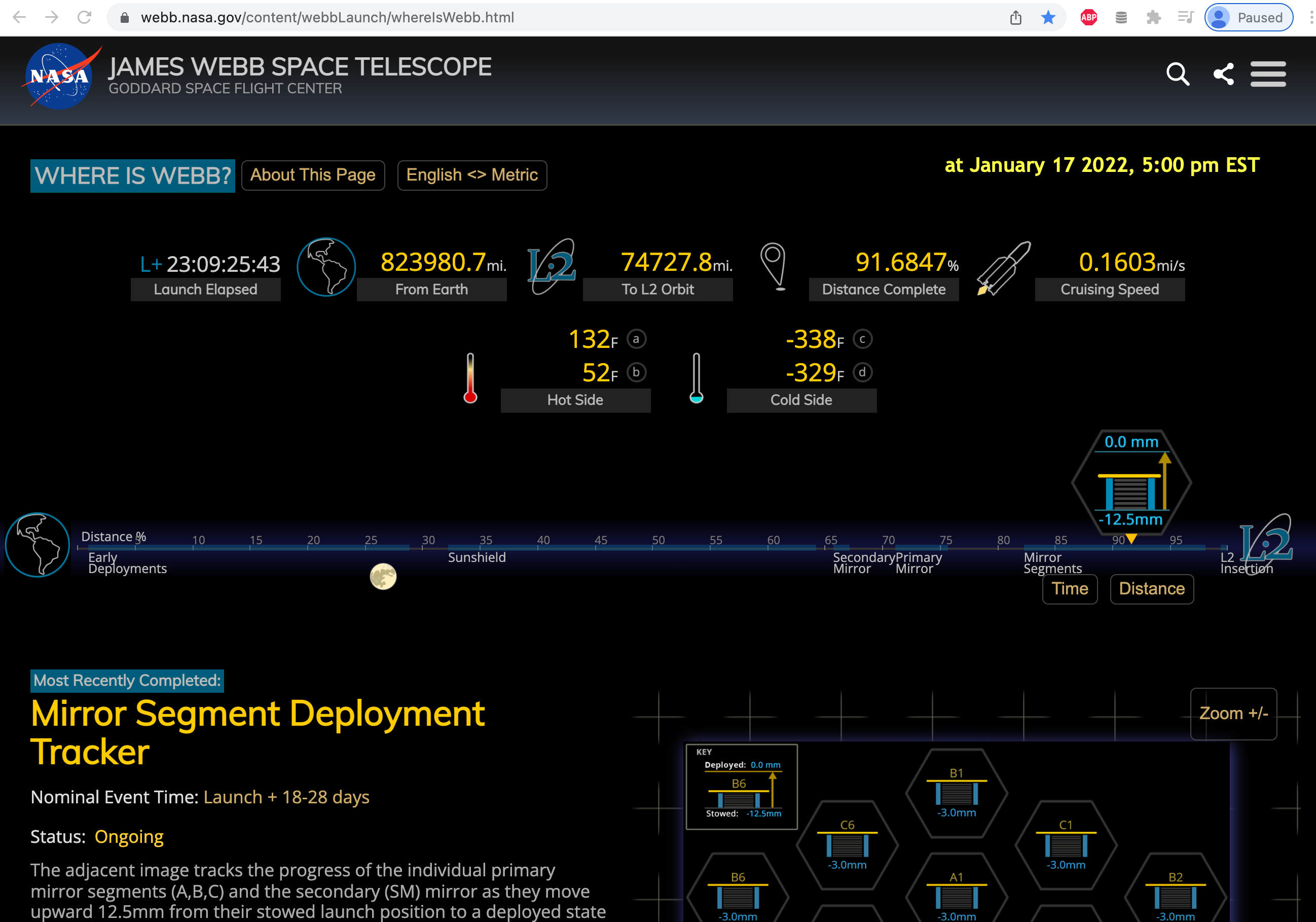
Mirror, Mirror...On It's Way! (blogs.nasa.gov)
https://blogs.nasa.gov/webb/2022/01/13/mirror-mirroron-its-way/
Social Media Short: James Webb Space Telescope Laser-Focused Sight (JWST)
https://www.youtube.com/watch?v=_2zQiWeXTg4
Engineers determine how much each segment must be moved through a process called wavefront sensing and control.
(Please read the article and watch the video at the URL's posted above)
-
On the way...
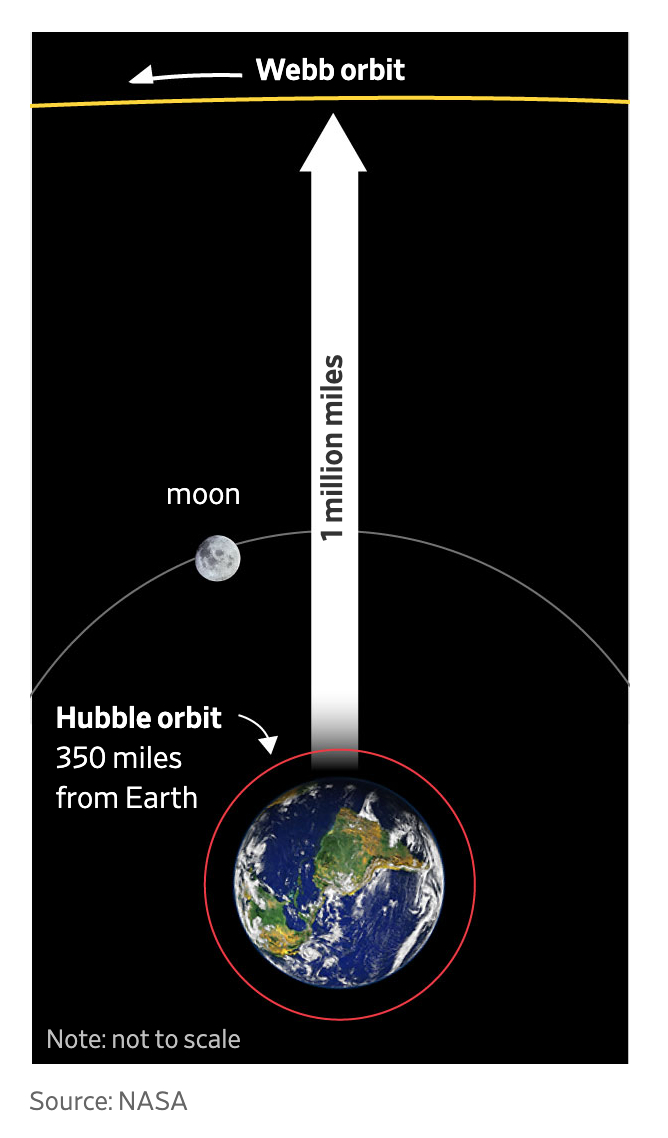
- - -
Update: January 24, 2022
Webb arrives in orbit of L2, teams look ahead to five months of commining (nasaspaceflight.com)
https://www.nasaspaceflight.com/2022/01/jwst-arrives-at-l2/
Excerpt:
The joint NASA/ESA/CSA James Webb Space Telescope (JWST) has successfully inserted itself into its orbit at the Earth-Sun Lagrange Point 2 (L2), doing so at 2:05 pm EST (19:05 UTC) on January 24, 2022. The insertion into L2 orbit signifies the end of the observatory’s immensely complex deployment process and the beginning of the telescope’s commissioning activities.
The orbit insertion maneuver began at 2pm EST (19:00 UTC), lasted for five minutes, and added 1.6 meters per second velocity to Webb to send it into its proper orbit.
Before the insertion, which occurred at T+29 days from launch, JWST had to perform a series of complex deployments to get into its final configuration for deep space observations. The entire deployment sequence consisted of 344 unfolds, which saw the observatory unfurl from its launch position. Of those unfolds, 307 (87%) were single-point failure areas — meaning if any of those 307 unfolds had failed, the entire mission would be lost.
But every single one of those 344 highly complex unfolds worked. Additionally, the completion of JWST’s L2 insertion burn marked the end of the telescope’s mid-course correction burns — all three of which were completed successfully.
JWST’s journey to L2 began on December 25, 2021, when the observatory launched atop an Arianespace Ariane 5 rocket from pad ELA-3 at the Guiana Space Centre in Kourou, French Guiana. JWST separated from the Ariane 5 upper stage at T+27 minutes on a trajectory to L2.
The trajectory Ariane 5 placed James Webb on was accurate enough to minimize the amount of fuel the observatory needed for its trip to L2, allowing JWST to have enough fuel for around 20 years — 10 years more than originally expected — of scientific operations.
(Please read the entire article posted at the URL above)
- - -
Update: February 8, 2022
Webb's Camera Captures Its First Photons of Starlight (sci-news.com)
http://www.sci-news.com/astronomy/webbs-first-photons-starlight-10531.html
On February 3, 2022, astronomers saw the first photons of starlight that traveled through the NASA/ESA/CSA James Webb Space Telescope and were detected by its Near Infrared Camera (NIRCam) instrument. The detection marks the first of many steps to capture images that are at first unfocused and use them to slowly fine-tune the Webb telescope. This is the beginning of the three-month process of aligning the telescope, but so far the initial results match expectations and simulations.
(Please read the entire article posted at the URL above)
- - -
Update: March 16, 2022
New image from Webb, another milestone achieved (earthsky.org)
https://earthsky.org/space/new-image-from-webb-march-16-2022/
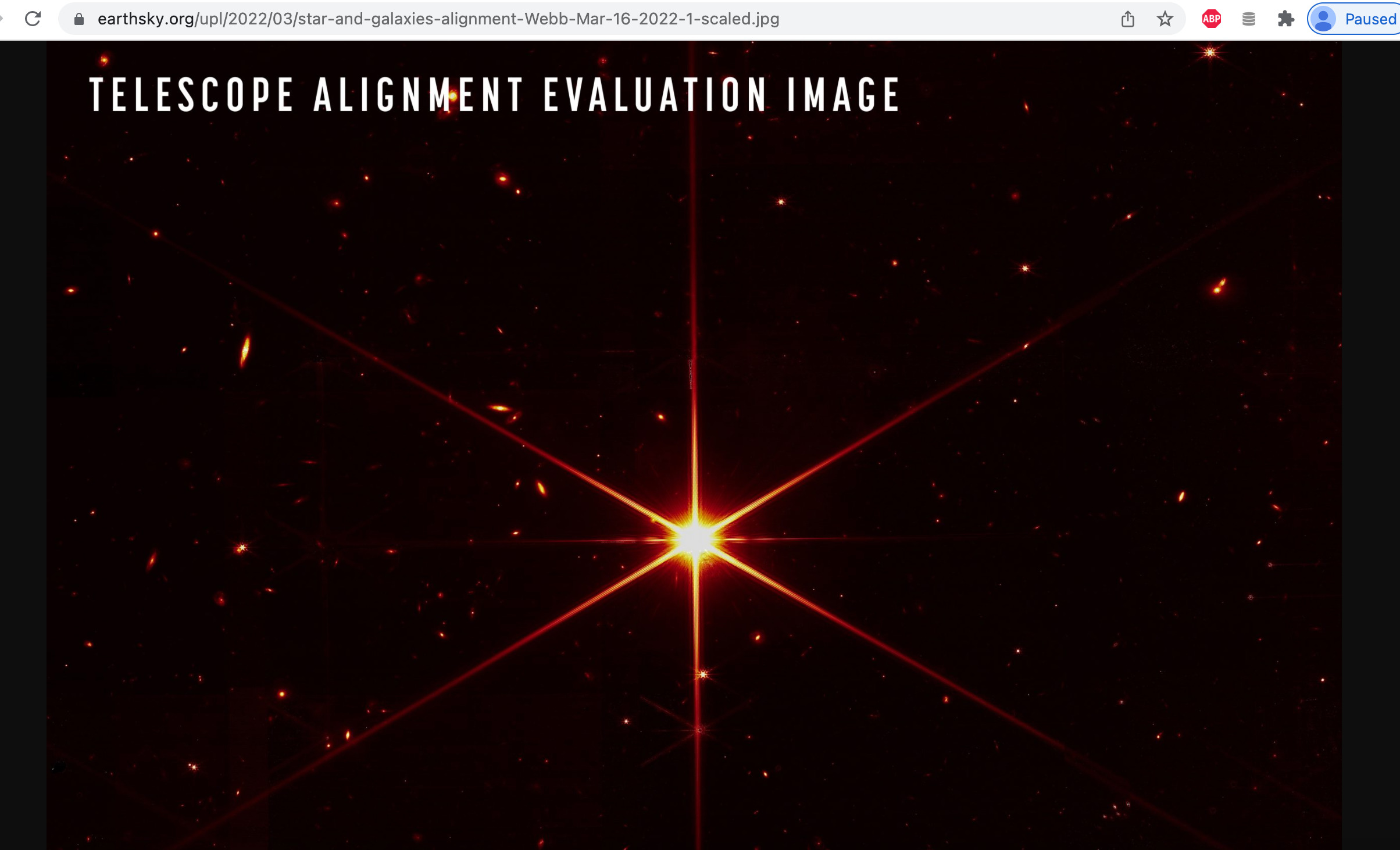

New image from Webb
NASA announced on March 16, 2022, that they’ve achieved a critical milestone with the Webb telescope. Notably, they’ve completed the mirror alignment steps and are happy to report that:
… Webb’s optical performance will be able to meet or exceed the science goals the observatory was built to achieve.
With this in mind, they celebrated by releasing a photo today that shows a star with bright diffraction spikes and numerous background galaxies. Conversely, Webb still won’t be ready for science operations for some months. However, the scientists are thrilled with its performance so far and excited for what they’ll soon discover.
Another milestone achieved
Now, the Webb telescope has also completed the fine phasing stage of alignment. More specifically, this means the team has now fully aligned Webb’s primary imager, the Near-Infrared Camera (NIRCAM), to its mirrors.
Ritva Keski-Kuha of NASA Goddard said:
We have fully aligned and focused the telescope on a star, and the performance is beating specifications. We are excited about what this means for science.
Now, the team still needs to align other instruments on the telescope, and they expect to complete all optical alignments by early May. Next, they will work on science instrument preparations. Full-resolution imagery should come this summer...
(Please read the entire article at the URL posted above)
- - - - - - - - - - - - - - - - - - - - - - - - - - - - - - - - - - - - - - - - - - - -
Posted on December 21, 2021
Pluto terrain mystery possibly solved
Now We Know Why Pluto has These Strange Features on its Surface (universetoday.com)
https://www.universetoday.com/153776/now-we-know-why-pluto-has-these-strange-features-on-its-surface/
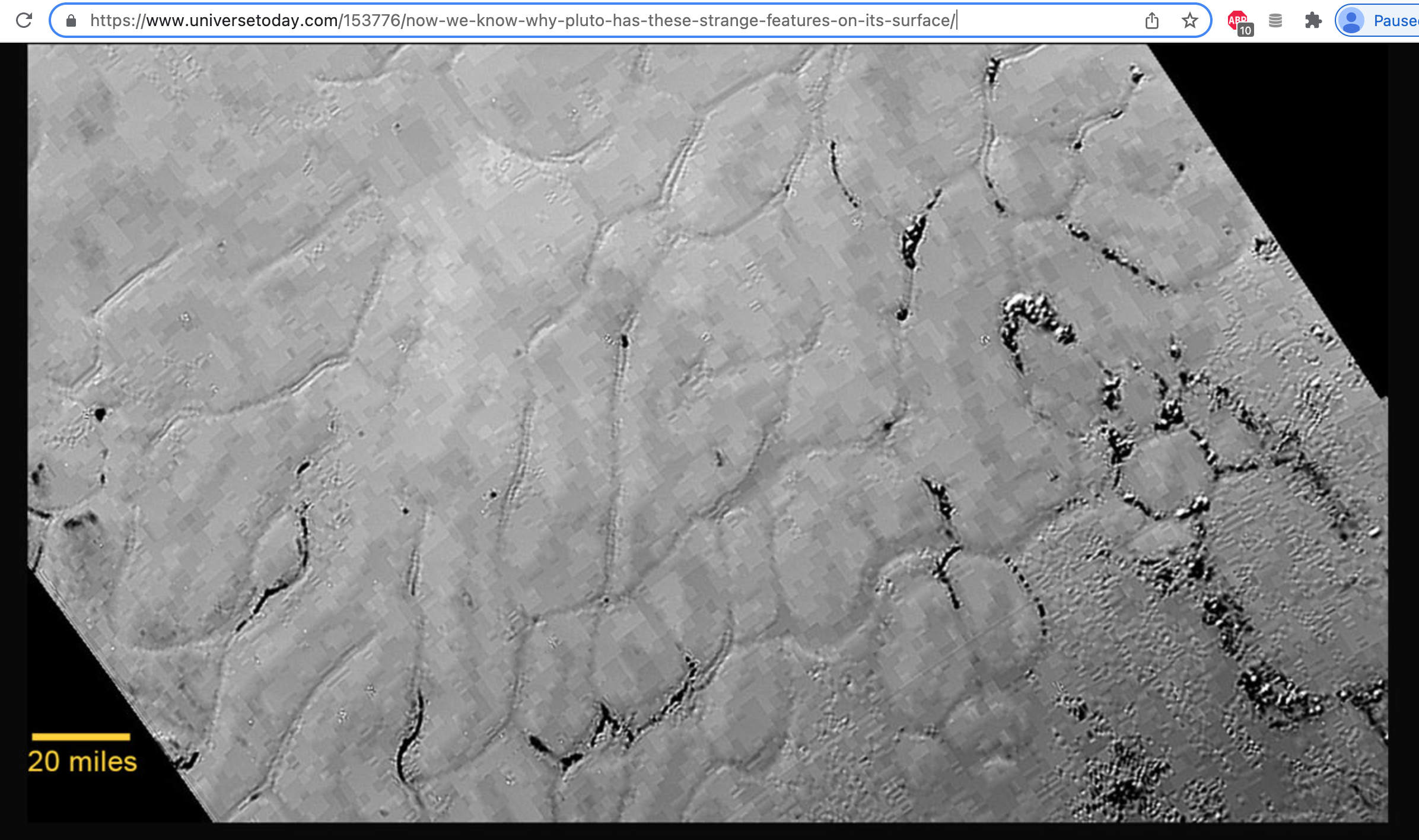
Excerpt:
After New Horizons made its close flyby of Pluto in July of 2015, scientists were astounded at the incredible closeup views of Pluto’s surface. One of the most intriguing and mysterious features was a bright plain inside the prominent heart-shaped feature on Pluto, called “Tombaugh Regio” (Tombaugh Region) named after Clyde Tombaugh, who discovered Pluto in 1930.
The region is composed of a broken surface of irregularly-shaped segments that appear to be geologically young because no impact craters are part of the terrain.
“This terrain is not easy to explain,” said Jeff Moore, leader of the New Horizons Geology, Geophysics and Imaging Team (GGI), back in 2015. “The discovery of vast, craterless, very young plains on Pluto exceeds all pre-flyby expectations. There are a few ancient impact craters on Pluto. But other areas like “Tombaugh Regio” show no craters. The landform change processes are occurring into current geologic times.”
Now, a new study of this fascinating landscape reveals with more certainty how the unusual features were formed. A team led by Adrien Morison from the University of Exeter in the UK used sophisticated modelling techniques to show that these ice polygons are formed by the sublimation of nitrogen ice. This is a phenomenon where the solid ice turns directly from the solid to the gas phase due to the extremely negligible atmospheric pressure.
(Please read the article posted at the URL above)
- - - - - - - - - - - - - - - - - - - - - - - - - - - - - - - - - - - - - - - - - - - -
Posted on December 21, 2021
The Latest on NASA's Perseverance Mars Mission
What NASA's Perseverance Rover Has Learned After 10 Months on Mars (wsj.com)
https://www.wsj.com/video/series/in-depth-features/what-nasas-perseverance-rover-has-learned-after-10-months-on-mars/D263A2A7-69B0-40B2-A385-0D15BFC66350
Listen to the wind blowing on Mars...
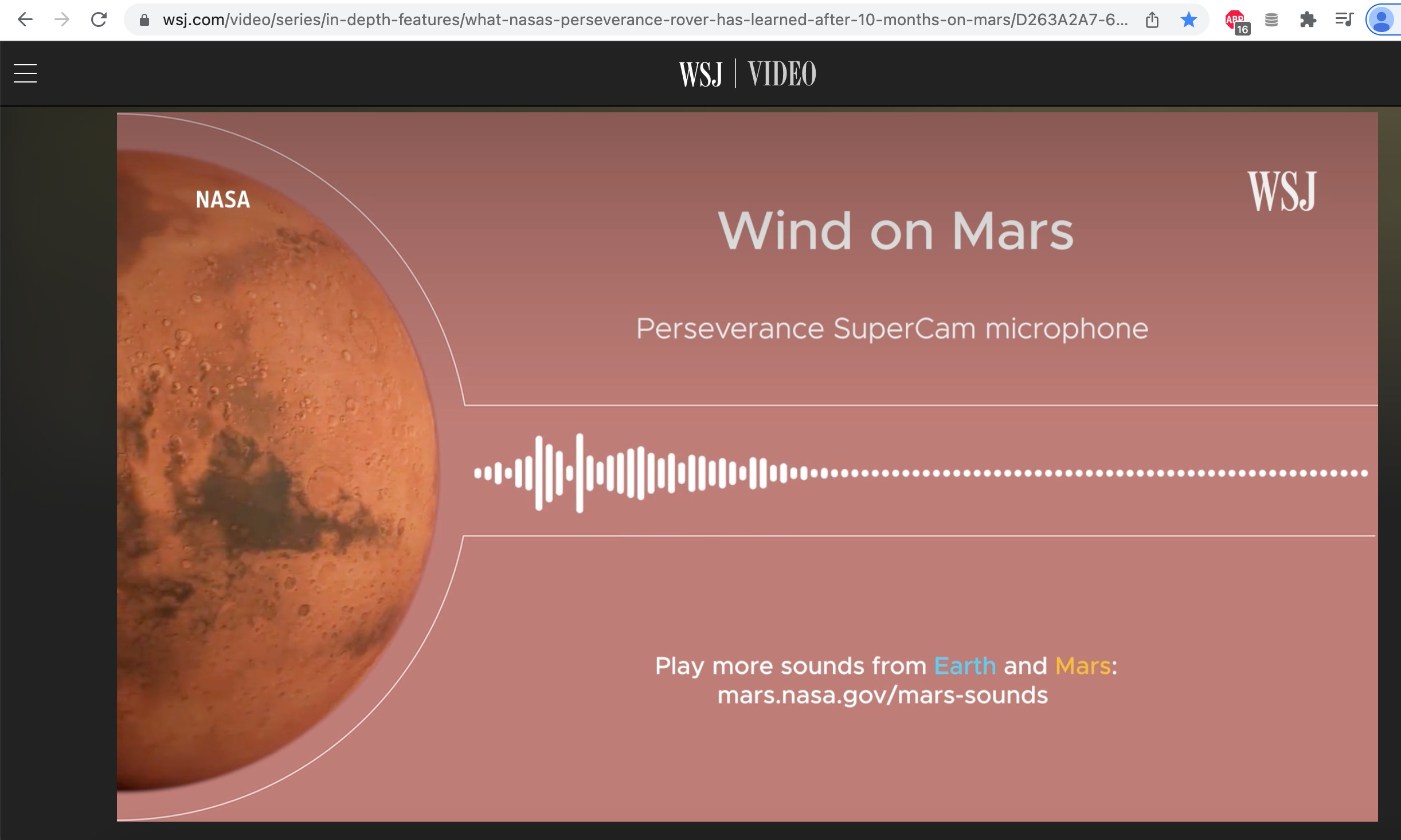
- - -
MOXIE made oxygen from the Martian atmosphere’s carbon dioxide...
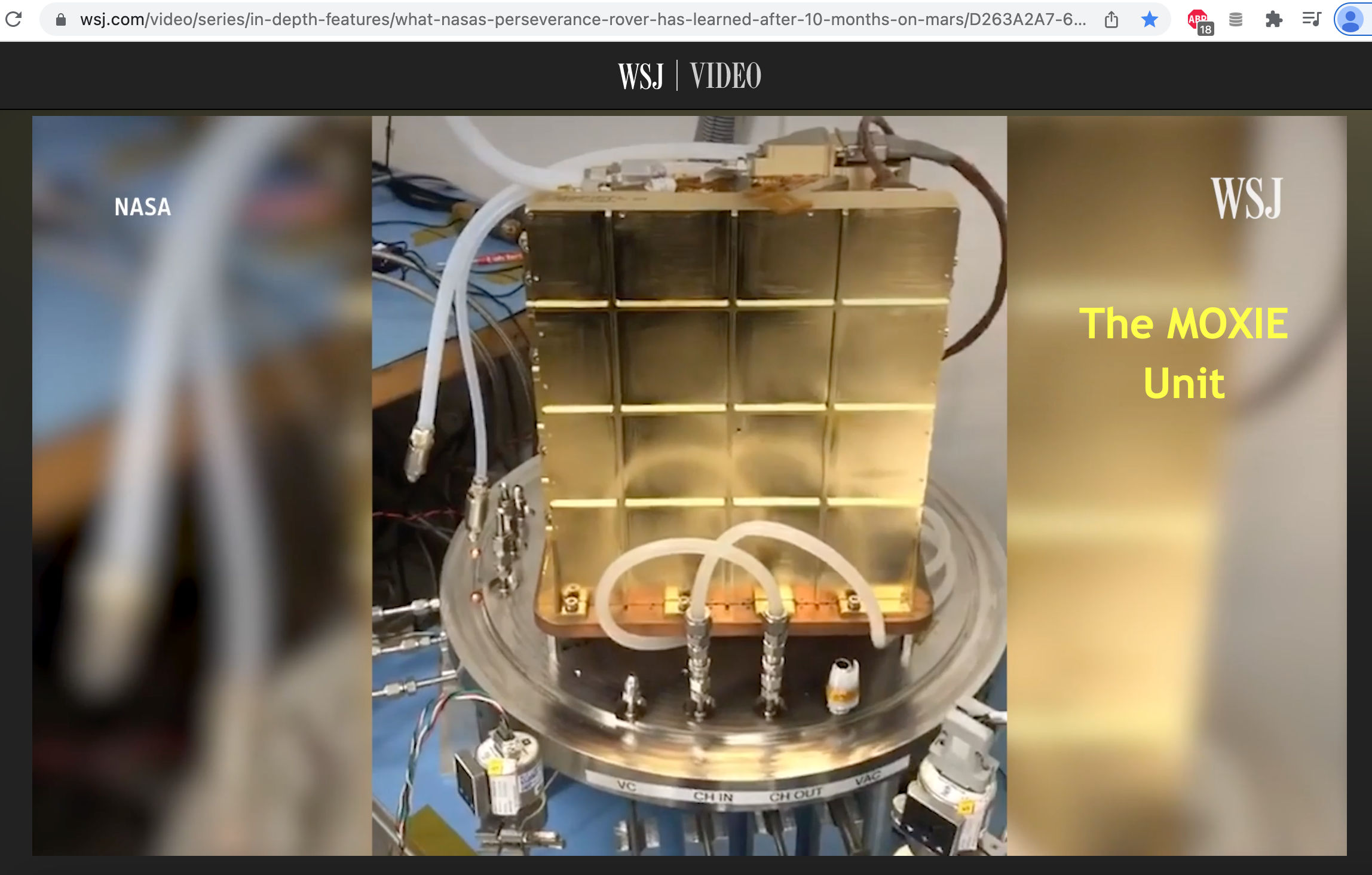
NASA'S MOXIE produced oxygen on Mars #shorts
https://www.youtube.com/shorts/A6EENlAOCAM
- - -
Ingenuity has now flown 18 times...
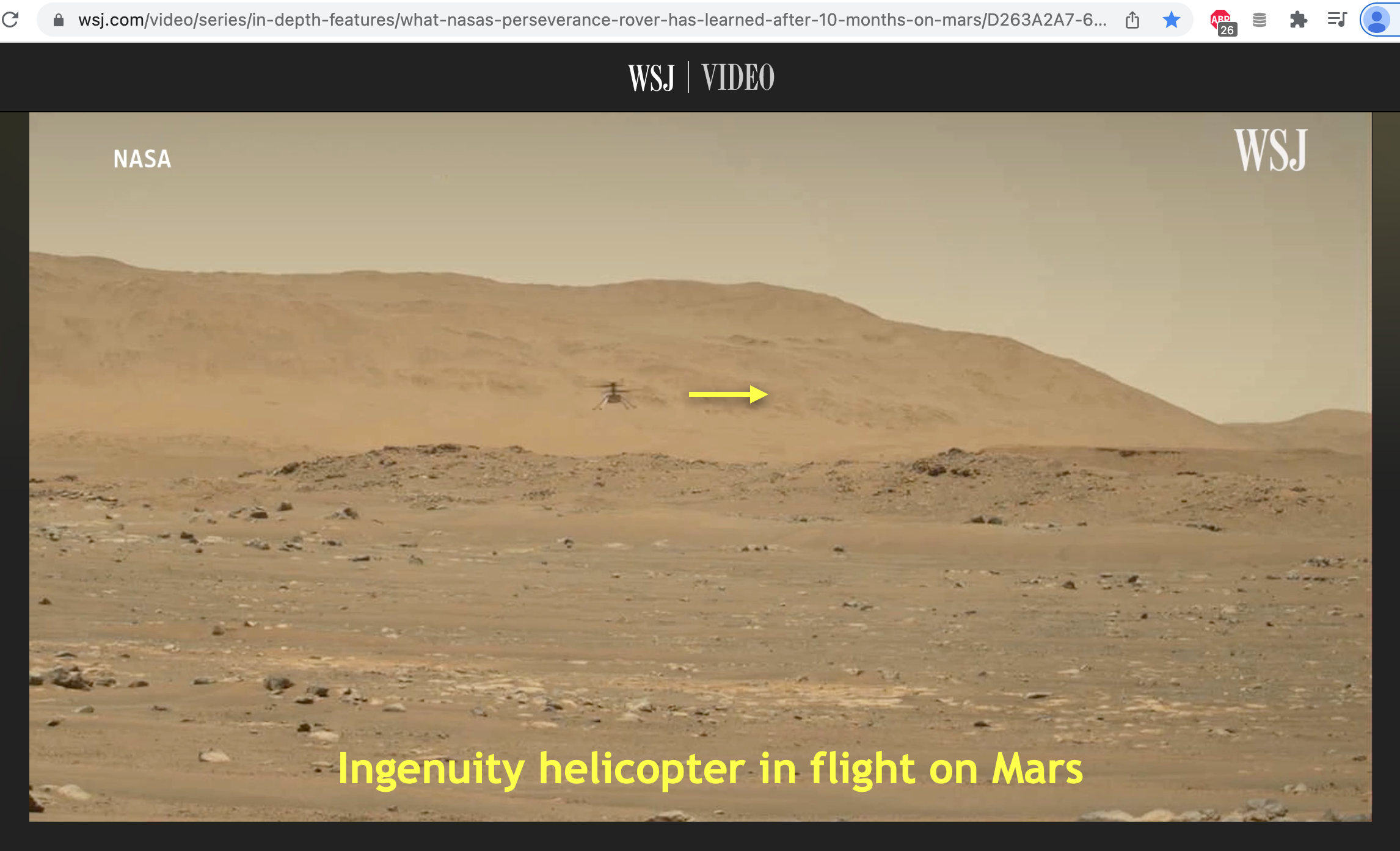
- - -
Investigating an ancient river bed on Mars for possible signs of past life. Core samples to be returned to the Earth in the 2030's.
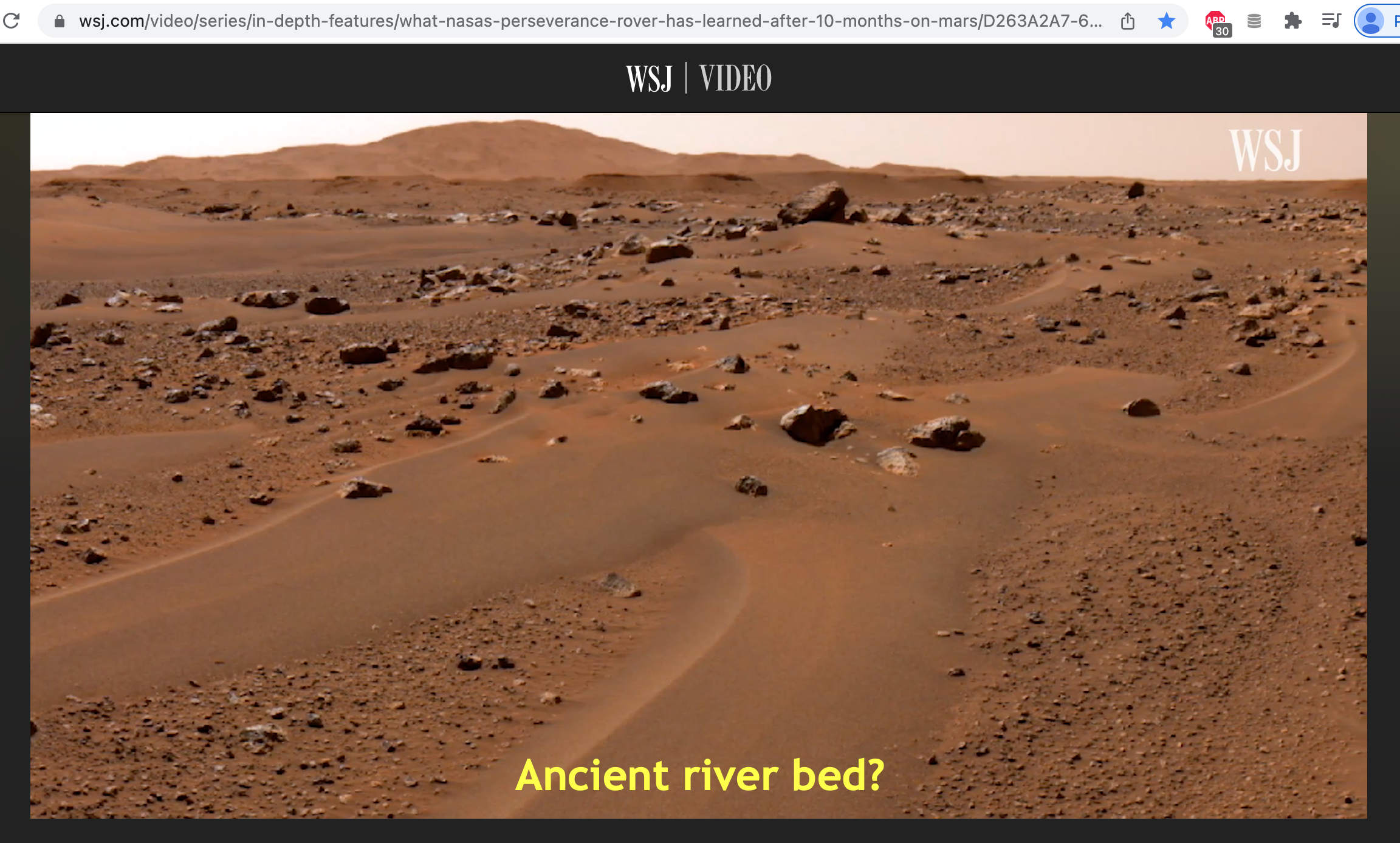
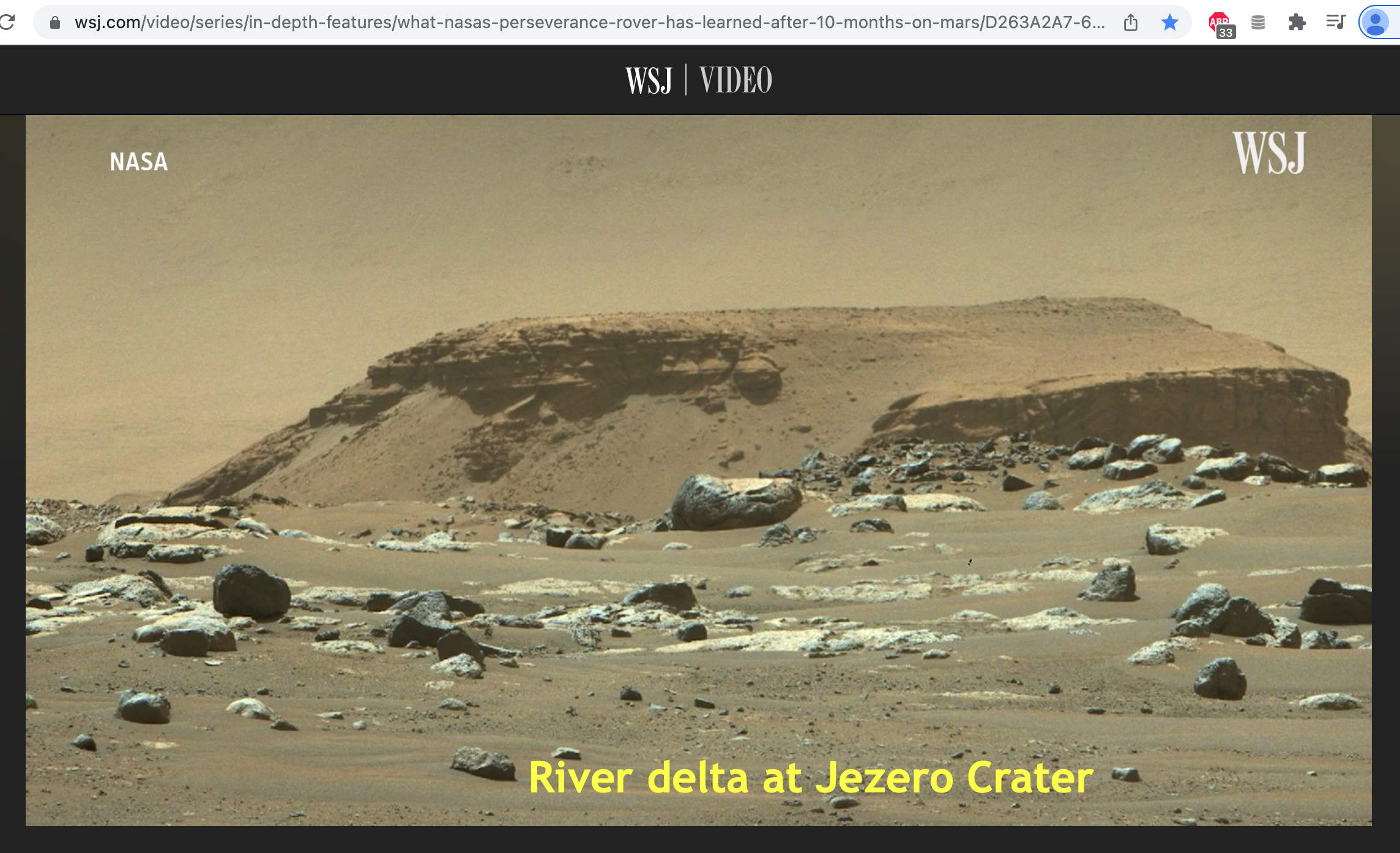
(Please watch the video in full at the URL listed above)
- -
P25I-2247 - Atmospheric Assessment in Support of Ingenuity Helicopter Flights
https://agu.confex.com/agu/fm21/meetingapp.cgi/Paper/859399
Abstract
(Please read the article at the URL posted above)
- - - - - - - - - - - - - - - - - - - - - - - - - - - - - - - - - - - - - - - - - - - -
Posted on December 17, 2021
For flat Earth activists that also support the 5G conspiracy
‘Anti-5G’ necklaces are radioactive and dangerous, Dutch nuclear experts say (theguardian.com)
https://www.theguardian.com/technology/2021/dec/17/anti-5g-necklaces-radioactive-dutch-nuclear-experts-quantum-pendants

Excerpt:
Owners of “quantum pendants” and other “negative ion” jewellery have been advised to store them away, as they have been found to continuously emit ionising radiation.
The product alert was issued by the Dutch authority for nuclear safety and radiation protection (ANVS) in relation to 10 products.
“Exposure to ionising radiation can cause adverse health effects,” the safety agency said. “Due to the potential health risk they pose, these consumer products containing radioactive materials are therefore prohibited by law. Ionising radiation can damage tissue and DNA and can cause, for example, a red skin. Only low levels of radiation have been measured on these specific products.
“However, someone who wears a product of this kind for a prolonged period (a year, 24 hours a day) could expose themselves to a level of radiation that exceeds the stringent limit for skin exposure that applies in the Netherlands. To avoid any risk, the ANVS calls on owners of such items not to wear them from now on.”
As governments across the world have started to establish the infrastructure for fast 5G internet, a range of groups have emerged voicing fears over the health effects of mobile telephony.
The concerns vary from questioning the level of research that has been done into the impact of radio frequencies and close proximity to masts, to allegations that 5G is the cause of anything from headaches to immunodeficiencies.
The World Health Organization has said that 5G is safe and that there is nothing fundamentally different about the physical characteristics of the radio signals produced by 5G compared with those produced by 3G and 4G.
Despite this, an industry suggesting that certain types of jewellery, including one product mentioned in the Dutch alert that claims to “utilise pure minerals and volcanic ash that are extracted from the Earth,” has burgeoned.
Last year, 15 EU member states called on the European Commission to address a spate of conspiracy theories that had led to arson attacks against telecommunications masts.
(Please read the article at the URL posted above)
- - - - - - - - - - - - - - - - - - - - - - - - - - - - - - - - - - - - - - - - - - - - -
Posted on December 17, 2021
Physics World 2021 Breakthrough of the Year
Quantum entanglement of two macroscopic objects is the Physics World 2021 Breakthrough of the Year (physicsworld.com)
https://physicsworld.com/a/quantum-entanglement-of-two-macroscopic-objects-is-the-physics-world-2021-breakthrough-of-the-year/
The Physics World 2021 Breakthrough of the Year goes to two independent teams for entangling two macroscopic vibrating drumheads, thereby advancing our understanding of the divide between quantum and classical systems. The winners are Mika Sillanpää and colleagues at Aalto University, Finland and the University of New South Wales, Australia, together with a team led by John Teufel and Shlomi Kotler of the US National Institute of Standards and Technology (NIST).
Nine other achievements are highly commended in our Top 10 Breakthroughs of 2021.
Quantum technology has made great strides over the past two decades and physicists are now able to construct and manipulate systems that were once in the realm of thought experiments. One particularly fascinating avenue of inquiry is the fuzzy border between quantum and classical physics. In the past, a clear delineation could be made in terms of size: tiny objects such as photons and electrons inhabit the quantum world whereas large objects such as billiard balls obey classical physics.
Over the past decade, physicists have been pushing the limits of what is quantum using drum-like mechanical resonators measuring around 10 microns across. Unlike electrons or photons, these drumheads are macroscopic objects that are manufactured using standard micromachining techniques and appear as solid as billiard balls in electron microscope images (see figure). Yet despite the resonators’ tangible nature, researchers have been able to observe their quantum properties, for example, by putting a device into its quantum ground state as Teufel and colleagues did in 2017.
This year, teams led by Teufel and Kotler and independently by Sillanpää went a step further, becoming the first to quantum-mechanically entangle two such drumheads. The two groups generated their entanglement in different ways. While the Aalto/Canberra team used a specially chosen resonant frequency to eliminate noise in the system that could have disturbed the entangled state, the NIST group’s entanglement resembled a two-qubit gate in which the form of the entangled state depends on the initial states of the drumheads.
Both teams overcame significant experimental challenges, and their considerable efforts could open the door for entangled resonators to be used as quantum sensors or as nodes in quantum networks. As a result, this work deserves its place as the first quantum-related Breakthrough of the Year since 2015.
(Please read the article at the URL posted above)
- - - - - - - - - - - - - - - - - - - - - - - - - - - - - - - - - - - - - - - - - - - - -
Posted on December 16, 2021
Parker Solar Probe - An update on its closest approach to the Sun yet.
NASA's Parker Solar Probe Touches The Sun For The First Time (NASA Goddard)
https://www.youtube.com/watch?v=LkaLfbuB_6E
For the first time in history, a spacecraft has touched the Sun. NASA’s Parker Solar Probe has now flown through the Sun’s upper atmosphere – the corona – and sampled particles and magnetic fields there.
The new milestone marks one major step for Parker Solar Probe and one giant leap for solar science. Just as landing on the Moon allowed scientists to understand how it was formed, touching the very stuff the Sun is made of will help scientists uncover critical information about our closest star and its influence on the solar system.
More information: https://www.nasa.gov/feature/goddard/...
Credit: NASA's Goddard Space Flight Center
Scientists:
Nour Raouafi (Johns Hopkins University/APL)
Justin Kasper (University of Michigan)
Stuart Bale (University of California, Berkeley)
Kelly Korreck (Johns Hopkins University/APL)
Adam Szabo (NASA/GSFC)
Producer: Joy Ng (KBRwyle)
Writer: Mara Johnson-Groh (Wyle Information Systems)
Data Visualizer: Tom Bridgman (GST)
Animators:
Jonathan North (KBRwyle)
Ben Smith (Johns Hopkins APL)
(Please watch the video at the URL posted above)
- - -
Solar Orbiter publishes a wealth of science results from its cruise phase (phys.org)
https://phys.org/news/2021-12-solar-orbiter-publishes-wealth-science.html
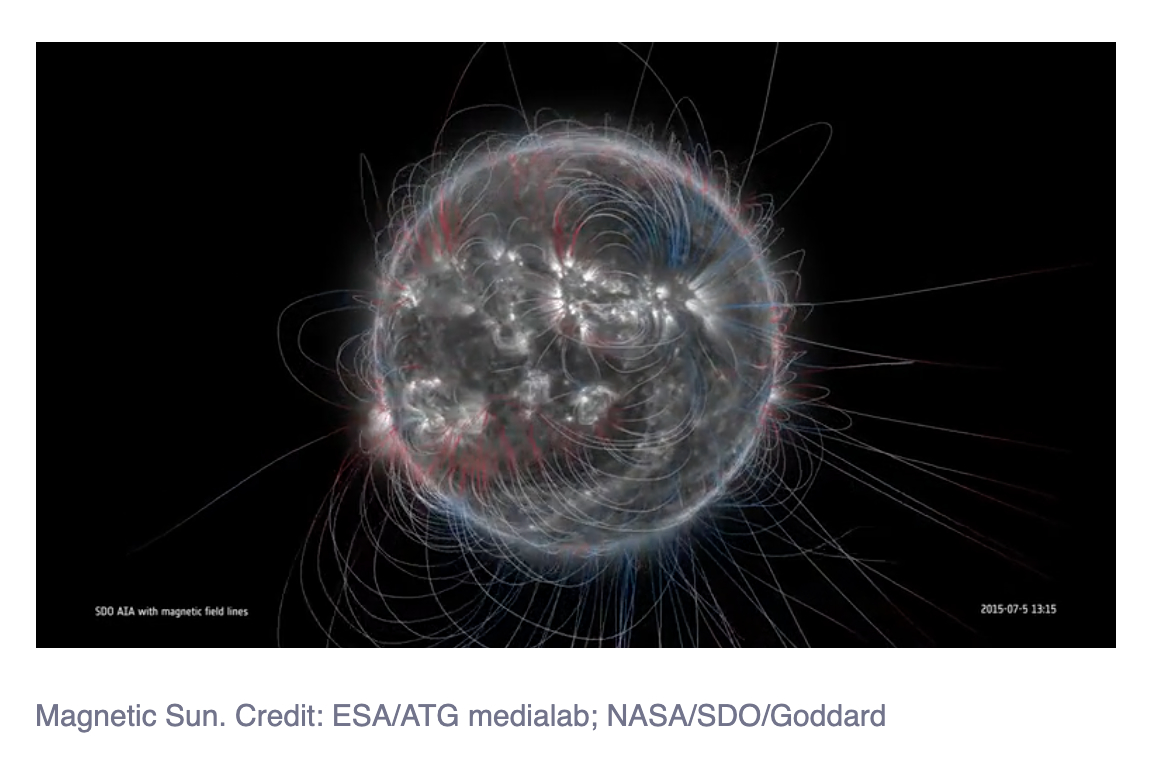
Excerpt:
For a mission yet to have entered its main science phase, Solar Orbiter has already generated a lot of great science. Today sees the publication of a wealth of results from the mission's cruise phase.
Forensic observations of the solar surface, measurements of a giant outburst of energetic particles, and an encounter with a comet's tail are just some of the highlights out of the more than fifty papers comprising a special issue of Astronomy and Astrophysics and presented today at the annual AGU meeting.
"The results published today demonstrate the variety of solar science that the mission is making possible, and signals the wealth of data that is now flowing back to Earth," says Yannis Zouganelis, ESA Deputy Project Scientist for Solar Orbiter.
Solar Orbiter's cruise phase began on 15 June 2020, and lasted until 27 November 2021. During that time, the spacecraft acquired scientific data with its in-situ instruments, which are designed to measure the environment around the spacecraft. It also used its remote sensing equipment to look at the sun in order to characterize and calibrate those instruments. Some of these data turned out to be of such good quality that they enabled the first scientific studies to be undertaken ahead of the main science phase, which began in late November 2021.
(Please read the article at the URL posted above)
- - -
Parker Solar Probe Enters Magnetized Atmosphere of the Sun (sci-news.com)
http://www.sci-news.com/physics/parker-solar-probe-magnetized-atmosphere-sun-10371.html
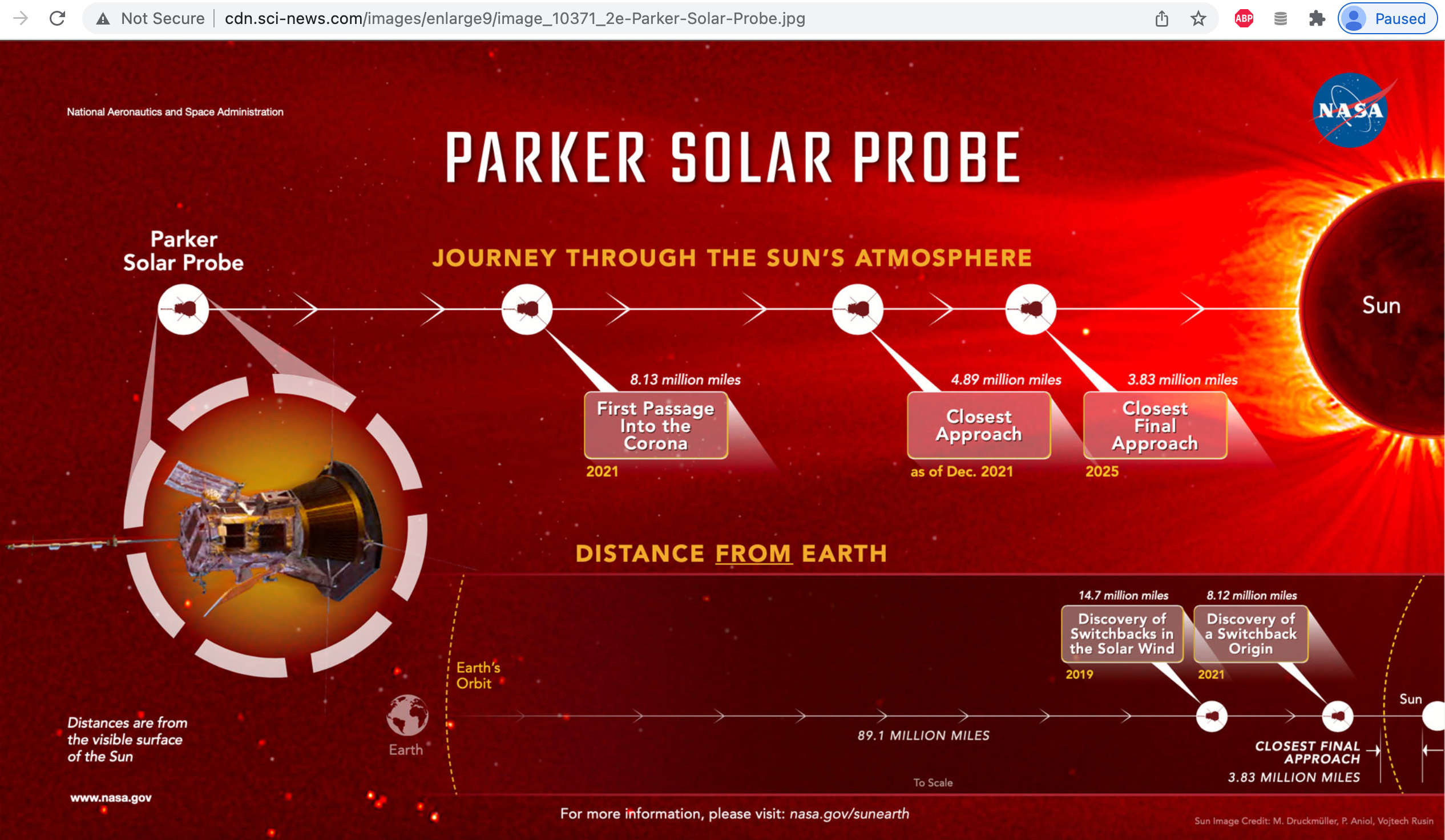
Excerpt:
The high temperatures and strong magnetic fields of the Sun’s upper atmosphere — the corona — form streams of the solar wind that expand through the Solar System into interstellar space. On April 28, 2021, NASA’s Parker Solar Probe entered this region about 13 million km (8 million miles) above the solar photosphere.
Parker Solar Probe launched in 2018 to explore the mysteries of the Sun by traveling closer to it than any spacecraft before. Three years after launch and decades after first conception, the probe has finally arrived.
Unlike Earth, the Sun doesn’t have a solid surface. But it does have a superheated atmosphere, made of solar material bound to the Sun by gravity and magnetic forces.
As rising heat and pressure push that material away from the Sun, it reaches a point where gravity and magnetic fields are too weak to contain it.
That point, known as the Alfvén critical surface, marks the end of the solar atmosphere and beginning of the solar wind.
Solar material with the energy to make it across that boundary becomes the solar wind, which drags the magnetic field of the Sun with it as it races across the Solar System, to Earth and beyond.
Importantly, beyond the Alfvén critical surface, the solar wind moves so fast that waves within the wind cannot ever travel fast enough to make it back to the Sun — severing their connection.
Until now, solar astronomers were unsure exactly where the Alfvén critical surface lay.
Based on remote images of the corona, estimates had put it somewhere between 10 to 20 solar radii from the surface of the Sun — 6.9 to 13 million km (4.3-8.6 million miles).
Parker’s spiral trajectory brings it slowly closer to the Sun and during the last few passes, the spacecraft was consistently below 20 solar radii (91% of Earth’s distance from the Sun), putting it in the position to cross the boundary — if the estimates were correct.
On April 28, 2021, during its eighth flyby of the Sun, Parker Solar Probe encountered the specific magnetic and particle conditions at 18.8 solar radii above the solar surface that told scientists it had crossed the Alfvén critical surface for the first time and finally entered the solar atmosphere.
(Please read the article at the URL posted above)
- - -
Update: May 3, 2022
We continue to update our prior posts as more information becomes available.
Prior post - Parker Solar Probe - An update on its closest approach to the Sun yet.
Parker Solar Probe continues its record breaking trek, the first to touch the Sun.
New ground breaking discoveries announced.
The Parker Solar Probe is the first spacecraft to fly into the low solar corona. It will assess the structure and dynamics of the Sun's coronal plasma and magnetic field, the energy flow that heats the solar corona and impels the solar wind, and the mechanisms that accelerate energetic particles.
On December 14, 2021, NASA officials revealed that the Parker Solar Probe had successfully pierced through the Sun's outer atmosphere — the corona — and "touched" the star. The historical feat was achieved on April 28, 2021, during the spacecraft's eighth flyby, when it was about 8.1 million miles away from the star.
Parker Solar Probe discovered that this boundary – the Alfvén critical surface – isn't smooth and round. The edge has wrinkles. The spacecraft passed through spikes and valleys as it dove in and out of the boundary.
The probe is designed to reflect much of the incoming light away, but even so, exposed surfaces will get as hot as 1500 °C
The Protective Shield Properties: The thermal Protection System (TPS) is 8 feet (2.4 meters) in diameter and 4.5 inches (115 millimeters) thick to protect Parker Solar Probe from the intense heat generated by the Sun.
-
Amazing achievements from the Parker Solar Probe (phys.org)
https://phys.org/news/2022-05-amazing-parker-solar-probe.html
In 2018, NASA launched the Parker Solar Probe on an unprecedented mission to study the sun up close. The mission was defined with three key scientific goals:
- To trace the flow of energy that heats the sun's outer atmosphere.
- To shed light on the sources of the solar wind, the constant flow of solar material escaping from the sun.
- To explore how solar energetic particles—which can make the 93-million mile (150 million kilometer) journey to Earth in under an hour—are transported and accelerated.
Now four years after launch, the mission has made inroads towards achieving these key goals and more. As Parker Solar Probe continues its mission, it continues to break records and capture first-of-its-kind measurements of the sun.
Mission Overview - https://www.youtube.com/watch?v=i_z19KPvV1w
Tribute to Eugene Parker - https://www.youtube.com/watch?v=Qh63UBJsXrU
Why won't it melt? - https://www.youtube.com/watch?v=TN6rZF5dSRg
Parker touches the Sun for the first time - https://www.youtube.com/watch?v=LkaLfbuB_6E&t=1s
Parker Solar Probe - It's made game-changing discoveries.
Parker Solar Probe carries four instrument suites, and each is now credited with several groundbreaking discoveries. A small sample of them is described below.
The Solar Wind Electrons Alphas and Protons investigation (SWEAP): Surveying where sun becomes solar wind
When Parker Solar Probe entered the solar atmosphere, it made the first-ever crossing of what's known as the Alfvén critical surface—the boundary where solar material anchored to the sun first escapes and becomes the solar wind.
Until this crossing, no one knew what that boundary would look like. During its first pass close enough to cross the boundary, Parker Solar Probe passed into and out of the corona several times. This revealed key information about the boundary's shape, revealing that the Alfvén critical surface wasn't shaped like a smooth ball. Rather, it has spikes and valleys that wrinkle the surface.
The SWEAP instrument established that the wrinkles were due to coronal streamers—giant plumes of solar material rising through the sun's atmosphere. Streamers have long been observed by sun-watching spacecraft near Earth, but never before measured directly. The results are reshaping what we know about the sun's atmosphere and how it transforms into the solar wind.
(Please read the article posted at the URL above)
- - -
More info at flatearthlunacy:
For flat Earth advocates that insist that the Sun is local and space is a myth, here are the celestial coordinates - to see the Parker Solar Probe in the New York City (NY, USA) daytime sky today (April 15, 2020)
- - - - - - - - - - - - - - - - - - - - - - - - - - - - - - - - - - - - - - - - - - - - -
Posted on December 13, 2021
TESS - Transiting Exoplanet Survey Satellite (continuing the work of Kepler Space Telescope)
TESS Finds a Planet with an Eight-Hour year
https://www.dlr.de/content/en/articles/news/2021/04/20211202_an-eight-hour-year
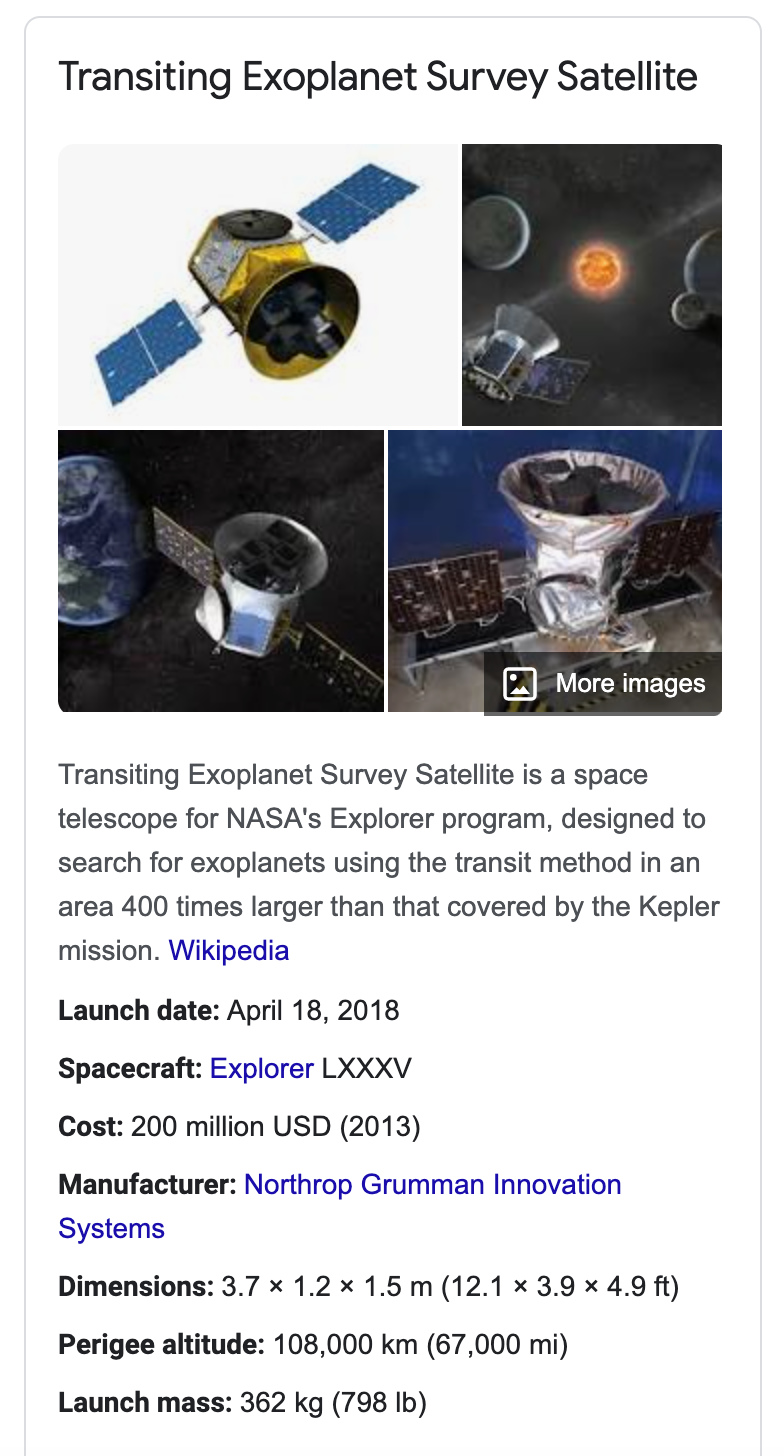
Excerpt:
- An international team of scientists led by the DLR Institute of Planetary Research is characterising the newly discovered extrasolar planet GJ 367 b.
- The results were published in the scientific journal Science on 2 December 2021.
- GJ 367 b is one of the lightest of the 5000 exoplanets known today and orbits its parent star in just under eight hours.
- Focus: Space, extrasolar planets, planetary research
As far as extrasolar planets go, 'GJ 367 b' is a featherweight. With half the mass of Earth, the newly discovered planet is one of the lightest among the nearly 5000 exoplanets known today. It takes the extrasolar planet approximately eight hours to orbit its parent star. With a diameter of just over 9000 kilometres, GJ 367 b is slightly larger than Mars. The planetary system is located just under 31 light years from Earth and is thus ideal for further investigation. The discovery demonstrates that it is possible to precisely determine the properties of even the smallest, least massive exoplanets. Such studies provide a key to understanding how terrestrial planets form and evolve.
An international group of 78 researchers led by Kristine W. F. Lam and Szilárd Csizmadia from the German Aerospace Center (Deutsches Zentrum für Luft- und Ruamfahrt; DLR) Institute of Planetary Research report on the results of their studies in the scientific journal Science. With an orbital period of only one-third of an Earth day, GJ 367 b is a fast mover. "From the precise determination of its radius and mass, GJ 367b is classified as a rocky planet," reports Kristine Lam. "It seems to have similarities to Mercury. This places it among the sub-Earth sized terrestrial planets and brings research one step forward in the search for a 'second Earth'."
(Please read the article at the URL posted above)
- -
The Telescope and Science (cfa.harvard.edu)
https://www.cfa.harvard.edu/facilities-technology/telescopes-instruments/transiting-exoplanet-survey-satellite-tess
Excerpt:
The Telescope and the Science
With many more exoplanets discovered every year, astronomers think planets may be more numerous than stars. TESS tests that hypothesis by scanning the whole sky for planets orbiting nearby bright stars. While Kepler focused on a single region of the sky, the TESS catalog includes both younger and hotter stars than those in the Kepler sample, along with many of the low-mass red stars known as M dwarfs. The worlds in the TESS sample are close enough to Earth that they may provide possible atmospheric data in follow-up observations.
TESS surveys the entire sky using four cameras, which together collect light from stars in successive swaths 24 degrees wide by 90 degrees long. These cameras work in two modes, capturing 2-minute exposures of the 200,000 brightest stars in the sky and 30-minute exposures of every visible star. That huge amount of data requires a great deal of advanced statistical techniques, as well as the automated analysis known as machine learning to aid astronomers.
(Please read the article at the URL posted above)
- -
Latest TESS Stories
https://www.nasa.gov/content/latest-tess-stories
- -
Characteristics of the TESS space telescope
https://heasarc.gsfc.nasa.gov/docs/tess/the-tess-space-telescope.html
Excerpt:
The TESS observatory consists of the spacecraft and the payload. The TESS payload has a single instrument, a camera suite composed of 4 wide field-of-view optical cameras and their associated hoods, mount, sun shield, and Data Handling Unit (DHU). The payload is coupled to the spacecraft, an NGIS LEOStar-2/750 satellite bus. The spacecraft provides power (via two deployable solar arrays), attitude control, data storage, and communications/transmission.
TESS cameras
TESS is equipped with four identical refractive cameras with a combined field-of-view (FOV) of 24x96 degrees (known as an observing sector). An overview of the FOV coverage and observing strategy for the mission can be found in the Operations page. Each camera consists of a CCD detector assembly, a lens assembly, and a lens hood.
Lens assembly
The lens assembly is a custom design housing seven lenses mounted into two separate aluminum barrels that are fastened together. The lens assembly has a 10.5 cm diameter entrance pupil and a focal ratio f/1.4. All optical elements have antireflection coatings and one element has a long-pass filter coating to enforce a short-wavelength cutoff at 600 nm in the TESS bandpass. Each camera forms a 24x24 un-vignetted image on the detector in its focal plane. The lens assemblies were designed for consistent image spot size across the field-of-view (FOV) and to produce under-sampled images similar to Kepler. Operating at nominal focus and a flight temperature of -75 degrees C, the 50% ensquared-energy half-width is 15 micron averaged over the FOV. This corresponds to 1 detector pixel or 21 arcseconds (approx. 0.35 arcmin) on sky. Along with an internal stray light baffle, each lens assembly aperture is equipped with a hood to reduce scattered light from the Earth and Moon.
(Please read the article at the URL posted above)
- - - - - - - - - - - - - - - - - - - - - - - - - - - - - - - - - - - - - - - - - - - - -
Posted on December 13, 2021
Kepler Space Telescope
Hundreds of new exoplanets from Kepler data (earthsky.org)
https://earthsky.org/space/new-exoplanets-kepler-data/
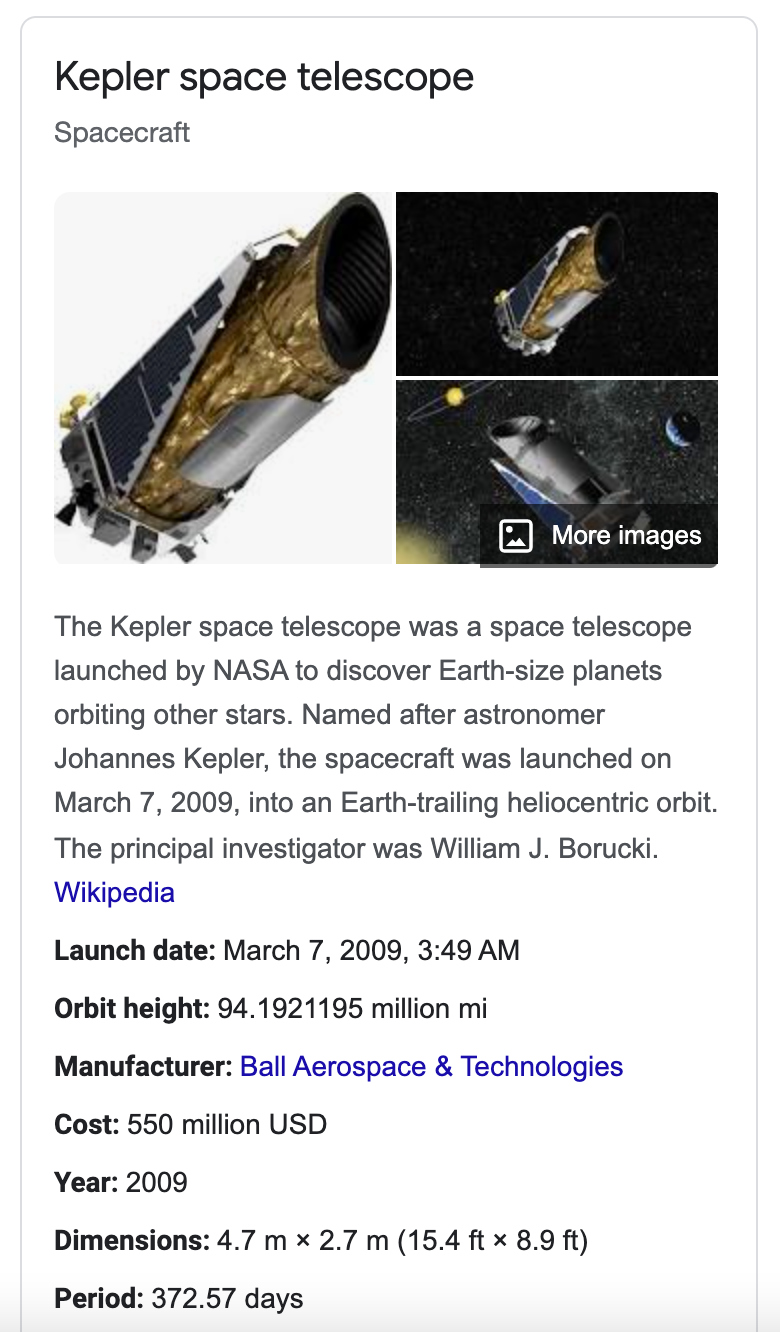
Excerpt:
The number of known exoplanets made a big jump up in November 2021, when astronomers announced a whopping 301 newly confirmed planets and an additional 366 new planet candidates. NASA’s Kepler planet-hunter – a space observatory – gathered the data. Kepler launched and began operations in 2009. It ran out of fuel and was retired in late 2018. But astronomers are still mining the mission’s data, making new discoveries of distant worlds.
NASA scientists submitted the first of two peer-reviewed papers to the Astrophysical Journal on November 17, 2021. It is availablevailable as a preprint on arXiv. A team of scientists from UCLA submitted the second peer-reviewed paper, which The Astronomical Journal published on November 23, 2021. It is also available as a preprint on arXiv.
Kepler data yields hundreds of new exoplanets
Overall, the Kepler mission was immensely successful. As of December 6, 2021, astronomers recognize 4,888 confirmed exoplanets. It’s not an exaggeration to say that Kepler single-handedly discovered most of the exoplanets we know about today.
Those exoworlds – orbiting distant stars – range from Earth-sized and super-Earth-sized to ones larger than Jupiter. Some orbit their stars much closer than Mercury does our sun, and others are sub-Neptunes, midway in size between Earth and Neptune. No such planets exist in our own solar system.
The NASA research team used a machine learning process called ExoMiner to find 301 new validated planets. Meanwhile, astronomers at UCLA found 366 new planetary candidates using their own new algorithm.
ExoMiner uncovers new exoplanets
First, ExoMiner. ExoMiner is a deep neural network that leverages NASA’s supercomputer called Pleiades. Scientists designed it to better distinguish between real planets and false positives. That is to say, it uses previous positive and false detections to learn how to better tell the difference between the two.
(Please read the article at the URL posted above)
- - - - - - - - - - - - - - - - - - - - - - - - - - - - - - - - - - - - - - - - - - - - -
Posted on December 12, 2021
Five Themes of Basic Astronomy
http://people.tamu.edu/~kevinkrisciunas/introduction.pdf
I. We are a part of the universe and thus can learn about our origins by studying the universe.
II. The universe is comprehensible through scientific principles that anyone can understand.
III. Science is not a body of facts but rather a process through which we seek to understand the world around us.
Science is a progress report - one that changes constantly as new techniques and instruments allow us to probe the universe more deeply.
IV. A course in astronomy is the beginning of a lifelong learning experience.
V. Astronomy affects each of us personally with the new perspectives it offers.
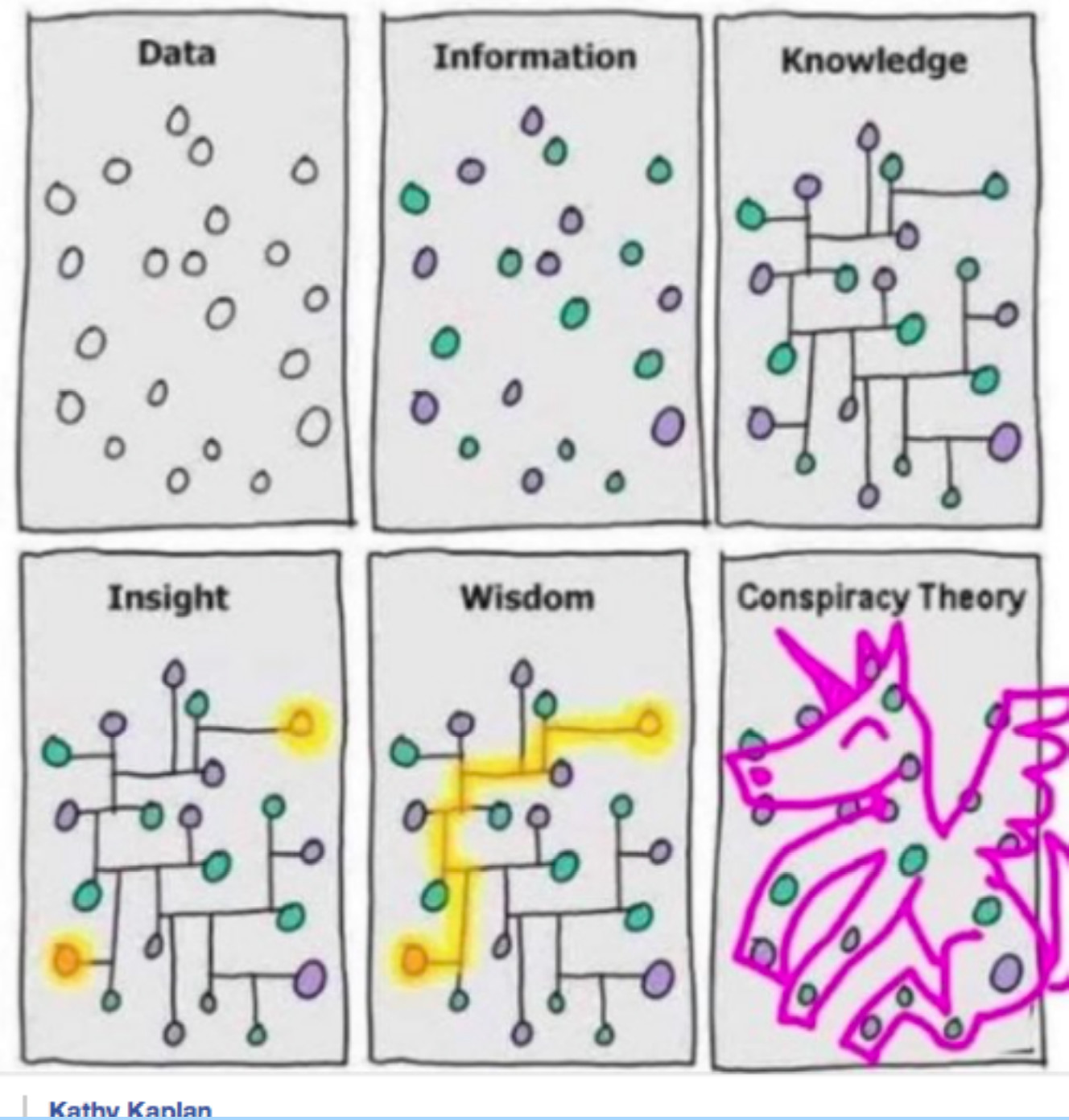
(Please read the article at the URL posted above)
- - - - - - - - - - - - - - - - - - - - - - - - - - - - - - - - - - - - - - - - - - - - -
Posted on December 11, 2021
Blue Origin Launches 6 New Astronauts Into Space, NS-19 Launch (spaceref.com)
http://spaceref.com/commercial-space/blue-origin-launches-6-new-astronauts-into-space.html
Blue Origin owner is Jeff Bezos.
The third crewed flight of a Blue Origin New Shepard launch system was conducted today. The "RSS First Step" left Earth just after 10:00 am ET for a quick flight above the Karman Line followed by a perfect landing of the booster and space capsule at the Texas launch site.
On board were Dylan Taylor, Voyager Space; Michael Strahan, ABC; investor Evan Dick; Lane Ventures founder Lane Bess and his son Cameron Bess; and Laura Shepard Churchley, daughter of the first US astronaut Alan Shepard.
According to a statement: "We had a great flight today. This was our sixth flight in what has been a great year for the New Shepard program. We flew 14 astronauts to space, flew a NASA payload flight that tested lunar landing sensors and completed our certification test flights," said Bob Smith, CEO Blue Origin. "I want to thank our payload customers, our astronauts and, of course, Team Blue for these many important accomplishments. I am so proud to be part of this dedicated and hard-working team that ensures that each and every flight of New Shepard is safe and reliable. And it's fun to say that this is just the beginning."
Several tweets by @BlueOrigin provided updates on the flight itself: "The booster reached an apogee of 347,231 ft AGL / 350,878 ft MSL (106 km AGL / 107 km MSL). The crew capsule reached an apogee of 347,580 ft above ground level (AGL) / 351,227 ft mean sea level (MSL) (106 km AGL / 107 km MSL)."
Max height = 351,227 feet.
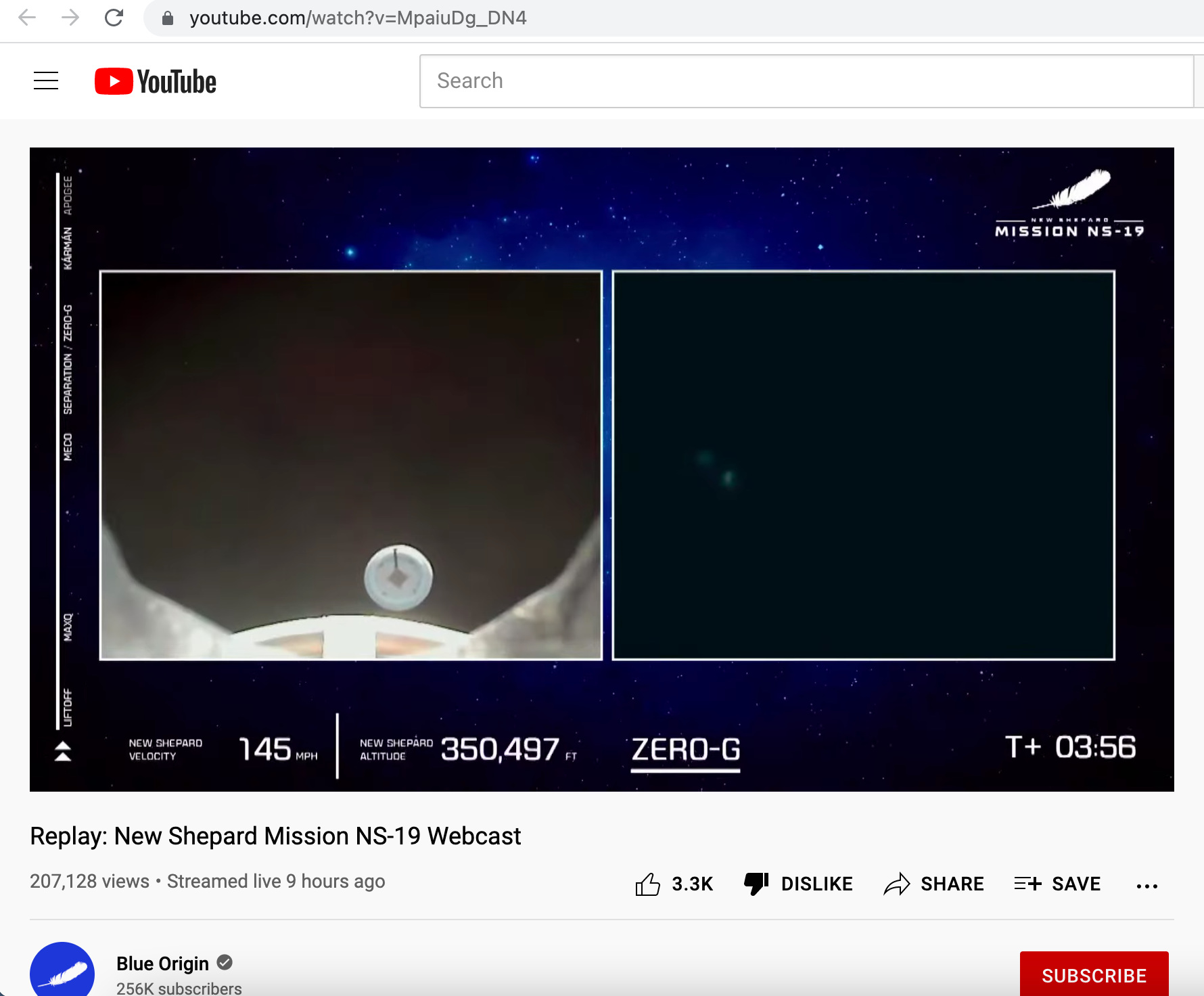
(Please read the article at the URL posted above)
- -
Alan Shepard: Bezos company sends first US astronaut's daughter to edge of space (bbc.com)
https://www.bbc.com/news/world-us-canada-59623264
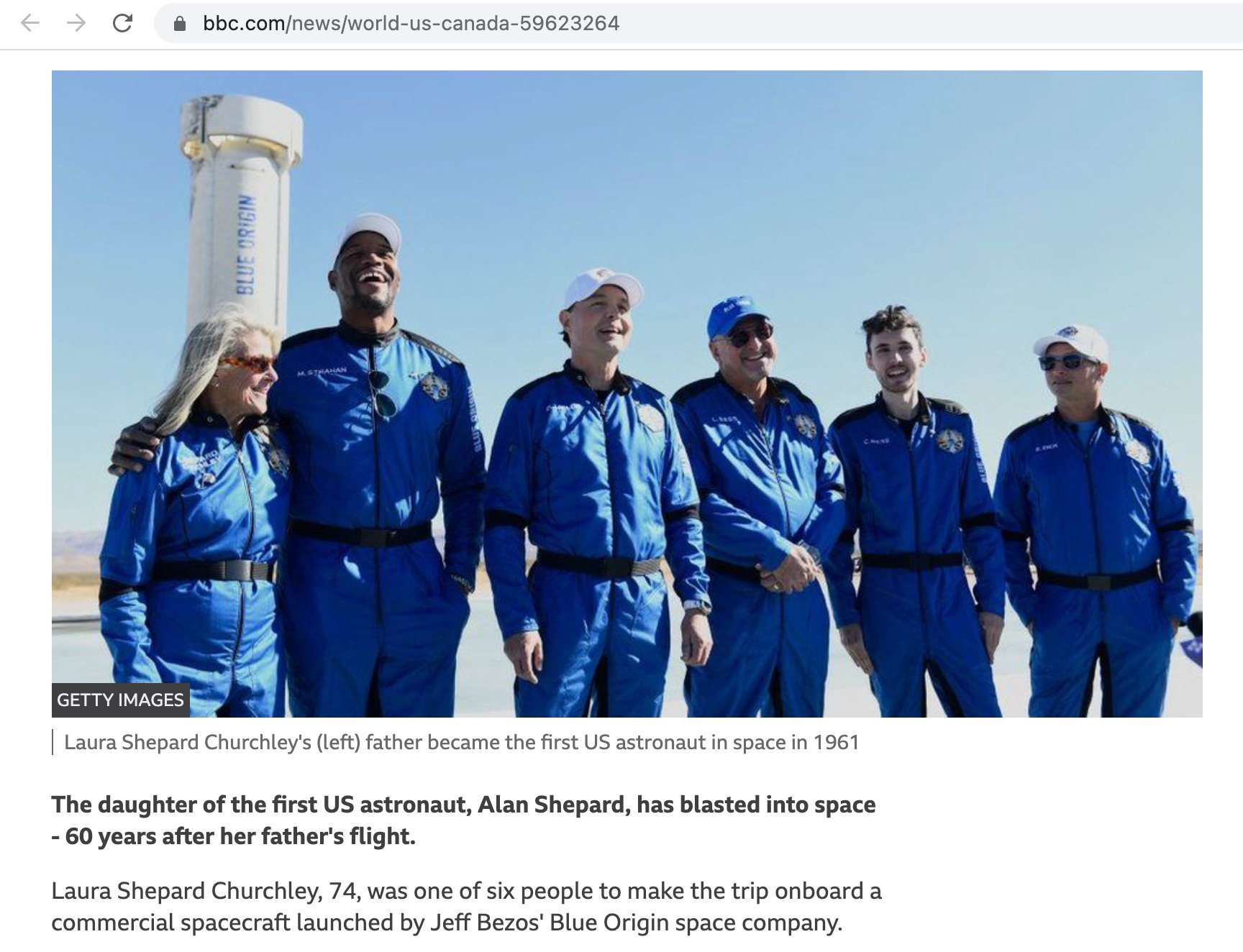
Laura Shepard Churchley...
The passengers were briefly able to experience zero gravity on the sub-orbital flight.
The flight was the third launched by Blue Origin in 2021 as it seeks to capture the space tourism market.
Ms Shepard Churchley's father, who died in 1998, became the first American in space after his Mercury flight took off from Florida's Cape Canaveral on 5 May 1961.
Former NFL star and Good Morning America anchor Michael Strahan was also on Saturday's flight as well as four other paying customers.
It marked the first time that Blue Origin had filled all six seats on its New Shepard rocket, which is named after the eponymous astronaut.
Having been delayed for two days by fierce winds, the flight finally blasted off from the company's launch facility near the rural town of Van Horn, Texas.
The flight followed a similar path to previous rockets launched by the company, before landing in the Texas desert where the tourists were greeted by Mr Bezos.
Lasting for just over 10 minutes and reaching an altitude of around 62 miles (100km), it was five minutes and 116 miles shorter than Alan Shepard's inaugural flight.
His daughter brought along a small piece of his capsule, as well as some mementos from his later trip to the lunar surface aboard Apollo 14 in 1971.
"I thought about Daddy coming down and thought, gosh he didn't even get to enjoy any of what I'm getting to enjoy," Ms Shepard Churchley said. "He was working. He had to do it himself. I went up for the ride!".
(Please read the article at the URL posted above)
- - - - - - - - - - - - - - - - - - - - - - - - - - - - - - - - - - - - - - - - - - - - -
Posted on December 9, 2021
Space debris is a rising problem for the entire human race.
Today there is an estimated 36,500 plus pieces of orbital scrap bigger than 10-cm.
United Nations Office for Outer Space Affairs (1967)
Treaty on Principles Governing the Activities of States in the Exploration and Use of Outer Space, including the Moon and Other Celestial Bodies
https://www.unoosa.org/oosa/en/ourwork/spacelaw/treaties/introouterspacetreaty.html

The Outer Space Treaty was considered by the Legal Subcommittee in 1966 and agreement was reached in the General Assembly in the same year ( resolution 2222 (XXI)). The Treaty was largely based on the Declaration of Legal Principles Governing the Activities of States in the Exploration and Use of Outer Space, which had been adopted by the General Assembly in its resolution 1962 (XVIII) in 1963, but added a few new provisions. The Treaty was opened for signature by the three depository Governments (the Russian Federation, the United Kingdom and the United States of America) in January 1967, and it entered into force in October 1967. The Outer Space Treaty provides the basic framework on international space law, including the following principles:
- the exploration and use of outer space shall be carried out for the benefit and in the interests of all countries and shall be the province of all mankind;
- outer space shall be free for exploration and use by all States;
- outer space is not subject to national appropriation by claim of sovereignty, by means of use or occupation, or by any other means;
- States shall not place nuclear weapons or other weapons of mass destruction in orbit or on celestial bodies or station them in outer space in any other manner;
- the Moon and other celestial bodies shall be used exclusively for peaceful purposes;
- astronauts shall be regarded as the envoys of mankind;
- States shall be responsible for national space activities whether carried out by governmental or non-governmental entities;
- States shall be liable for damage caused by their space objects; and
- States shall avoid harmful contamination of space and celestial bodies.
the complete text:
https://www.unoosa.org/pdf/publications/STSPACE11E.pdf
(Please read the articles at the URL's posted above)
- - - - - - - - - - - - - - - - - - - - - - - - - - - - - - - - - - - - - - - - - - - - -
Posted on December 8, 2021
Rocket Lab USA, a private enterprise, has already launched 109 satellites into Earth Orbit
https://www.rocketlabusa.com/
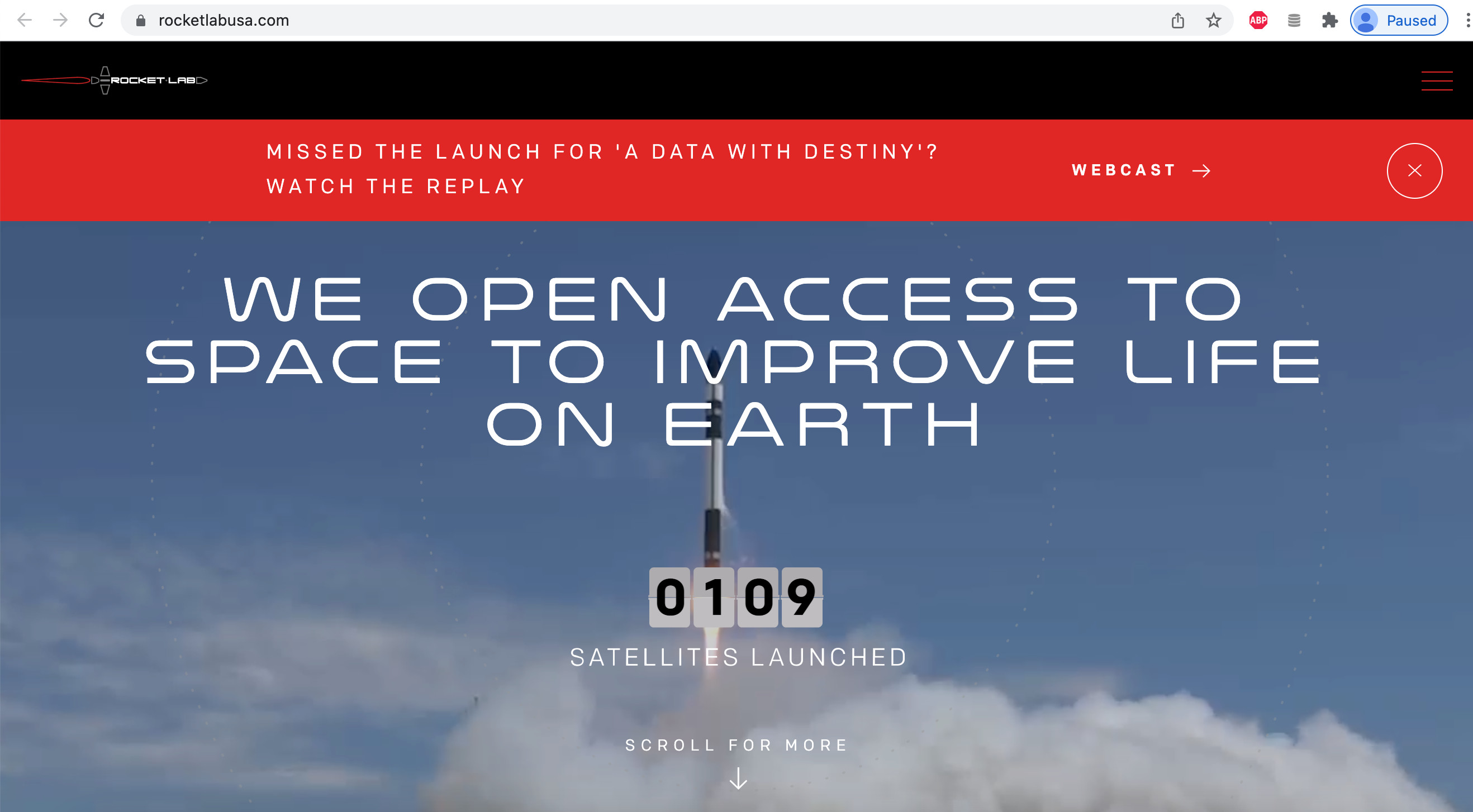
Rocket Lab launches another pair of BlackSky satellites
https://www.nasaspaceflight.com/2021/12/rocket-lab-preparing-to-launch-another-pair-of-blacksky-satellites/
Rocket Lab has conducted its final orbital launch of the year, “A Data With Destiny.” Liftoff of the Electron rocket occurred at the beginning of the launch window that opened at 7:02 PM EST on December 8, 2021 (00:02 UTC on December 9) from Rocket Lab’s Launch Complex 1 on the Māhia Peninsula in New Zealand.
This mission is the company’s fastest turnaround between launches, scheduled just less than 3 weeks after the launch of the “Love at First Insight” mission, which occurred in mid-November. The payload for the mission was two Earth observation satellites for the geospatial intelligence company, BlackSky.
“A Data With Destiny” is the third in a series of dedicated launches conducted by Rocket Lab for BlackSky and Spaceflight Inc — which is providing integration and mission management services — as a part of a multi-launch agreement between the companies to rapidly expand BlackSky’s LEO constellation. Currently, the contract is signed for four such dedicated launches, with an option to add two more in the future.
The Electron rocket placed the two satellites into a 430-kilometer orbit, inclined 42 degrees to the equator. The Gen-2 Earth-imaging satellites are high-resolution, multi-spectral satellites for the company’s Earth observation constellation.
On YouTube - https://www.youtube.com/watch?v=PmCl2Hs8enc
(Please read this full article at the URL posted above)
- - - - - - - - - - - - - - - - - - - - - - - - - - - - - - - - - - - - - - - - - - - - -
Posted on December 8, 2021
Soyuz MS-20 space tourism flight docks with ISS (International Space Station)
https://www.nasaspaceflight.com/2021/12/soyuz-ms-20-tourist-launch/
Roscosmos and Space Adventures has launched and docked the Soyuz MS-20 space tourism mission to the International Space Station for a 12-day stay. The crew of three—including two Japanese space tourists—are flying onboard the Soyuz spacecraft, with liftoff at 7:38 UTC (2:38 a.m. EST) Wednesday, December 8, 2021, from Site 31/6 at Baikonur Cosmodrome in Kazakhstan. It successfully docked six hours later.
Soyuz MS-20 crew
Onboard the Soyuz is Yusaku Maezawa, a Japanese billionaire known for starting online businesses Start Today and Zozo. In addition to his Soyuz mission, he has a circumlunar flight aboard SpaceX’s Starship—called “dearMoon”—booked for no earlier than 2023. Maezawa purchased both available seats on this flight of Soyuz.
He will be joined by Yozo Hirano—a media producer from Zozo—who will document the MS-20 mission. This flight will mark the first time two Japanese astronauts fly together, as well as the first flight of any Japanese space tourist.
The mission is commanded by experienced Russian cosmonaut Alexander Misurkin, on what is his third spaceflight. During the mission, he will stand ready to pilot the Soyuz in case the automated guidance software fails.
Maezawa and Hirano become the eighth and the ninth private citizens to fly on a mission scheduled by Space Adventures—a Virginia-based space tourism company. It will also end a decade-long pause in Russia’s tourism program, as the agency has not accepted tourists since Canada’s Cirque du Soleil co-founder Guy Laliberte in 2009.
(Please read this full article at the URL posted above)
- - -
Japan’s Yusaku Maezawa returns to Earth after 12-day space flight (aljazeera.com)
https://www.aljazeera.com/news/2021/12/20/japans-yusaku-maezawa-returns-to-earth-after-12-day-space-flight
On board the ISS, the Japanese billionaire entertained his social media followers by showing how to brush teeth and make tea in zero gravity.
Japanese billionaire Yusaku Maezawa has returned to Earth after a 12-day journey into space, ending a practice run for his planned trip around the moon with founder Elon Musk’s SpaceX in 2023.
The 46-year-old fashion tycoon and his assistant, Yozo Hirano, parachuted onto Kazakhstan’s steppe at 03:13 GMT on Monday, along with Russian cosmonaut Alexander Misurkin.
(Please read this full article at the URL posted above)
- - - - - - - - - - - - - - - - - - - - - - - - - - - - - - - - - - - - - - - - - - - - -
Posted on December 1, 2021
It's amazing what crazy theories some people come up with. This is what results from lack of - intelligence and education.
https://www.quora.com/Why-do-flat-Earthers-think-planes-use-compressed-air-for-propulsion

-
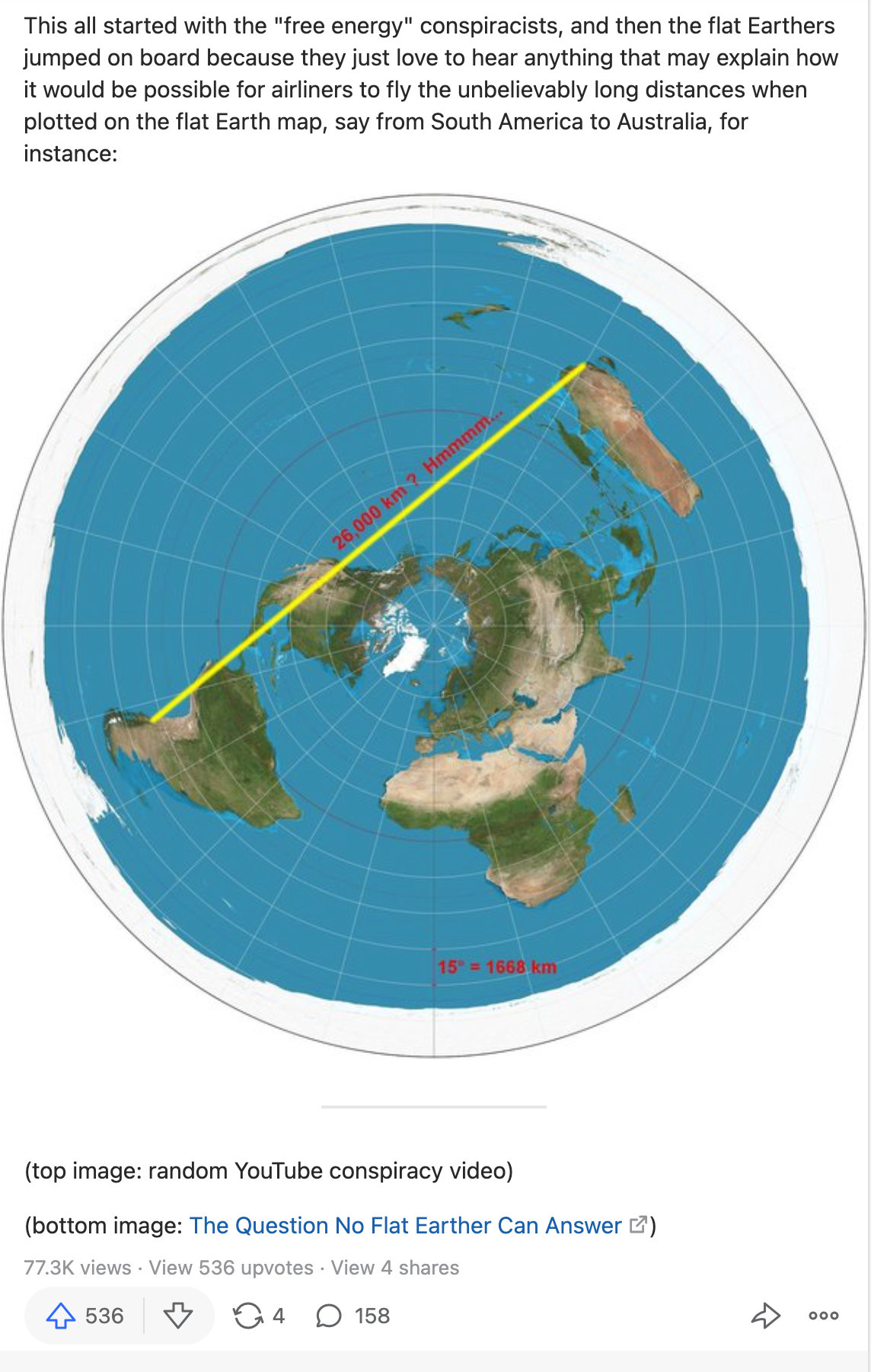
- - - - - - - - - - - - - - - - - - - - - - - - - - - - - - - - - - - - - - - - - - - - -
Posted on November 30, 2021
NASA Goddard Space Flight Center. Space research and exploration that touches lives.
https://www.flickr.com/photos/gsfc/page2

NASA Goddard Space Flight Center (GSFC), located in a Maryland suburb outside of Washington DC, is home to the Nation's largest organization of combined scientists and engineers dedicated and sharing their knowledge of the Earth, Sun, Solar System, and Universe.
Goddard manages communications between mission control and orbiting astronauts aboard the International Space Station. Goddard scientists stare into the sun, grind up meteorites for signs of life's building blocks, look into the farthest reaches of space, and untangle the mysteries of our own changing world.
Goddard Space Flight Center is NASA's first, and oldest, space center. It is named after Dr. Robert H. Goddard, the father of modern rocketry. Throughout its history, the center has managed, developed, and operated many notable missions, including the Cosmic Background Explorer, the Hubble Space Telescope, the Tracking and Data Relay Satellite System (TDRSS), the Lunar Reconnaissance Orbiter, and the Solar Dynamics Observatory.
Goddard Space Flight Center
https://www.nasa.gov/goddard
NASA's Goddard Space Flight Center (phys.org)
https://phys.org/partners/nasa-s-goddard-space-flight-center/
NASA's Goddard Space Flight Center (GSFC) was founded in 1959 at Greenbelt, Maryland. It launched its first weather satellite SIROS in 1960. GSFC at Greenbelt has 1121 acres for its 50 facilities. The Wallops Island facility is 6188 acres with 84 major buildings. GSPC at Greenbelt is most noted for its Diffraction Grafting Evaluation Facility, Earth Observing and System Data and Information System, Flight Dynamic Facility, High Capacity Centrifuge, Hubble Space Telescope Control Center and an Integrated Mission Design Center. GSFC welcomes inquires from the media and the public. Image use requests are made via -e-mail. Requests for information need to have the specific purpose of the inquiry in the subject line, otherwise, blank subject inquiries will be answered last.
Address
Mail Code 130, Greenbelt, Maryland 20771 USA
Wikipedia
http://en.wikipedia.org/wiki/Goddard_Space_Flight_Center
- -
Some beautiful stuff to see...
NASA's Webb Telescope Wrapped in a Mobile Clean Room
Landfall of Hurricane Michael from Space [Video]
SDO: Our Sun - AIA Full-Disk View of Launching Filament
Panning over M66 [HD Video]
Lunar Hole In One! A house-sized boulder (10 m diameter) rolled down-hill
Hubble’s Galaxies With Knots, Bursts
Robotic Refueling Mission 3 (RRM3)
Parker Solar Probe’s Launch Vehicle Rises at Space Launch Complex 37
The Moon's Aristarchus Plateau
Operation IceBridge View of Larsen C while flying over Antarctica
Hubble’s Barred and Booming Spiral Galaxy
New Gravity Map Suggests Mars Has a Porous Crust
NASA’s Hubble Sees Martian Moon Orbiting the Red Planet
Swedish Delegation Visits NASA Goddard
Hubble Finds a Lenticular Galaxy Standing Out in the Crowd
- - - - - - - - - - - - - - - - - - - - - - - - - - - - - - - - - - - - - - - - - - - - -
Posted on November 29, 2021
Arthur Eddington and Frank Watson Dyson observed "Gravitational Lensing" for the first time in 1919 during a solar eclipse.
So flat Earthers, this observational evidence cannot be denied (unless you are a walking comatose being).
According to Einstein's theory, light traveling past a massive object like the sun should bend due to the object's immense gravity. With the sun's light blotted, Eddington measured the positions of distant stars made visible in the background. ... In a new book called Proving Einstein Right (Public Affairs, 2019).
The observations were of the total solar eclipse of 29 May 1919 and were carried out by two expeditions, one to the West African island of Príncipe, and the other to the Brazilian town of Sobral. The aim of the expeditions was to measure the gravitational deflection of starlight passing near the Sun.
According to Einstein's theory, light traveling past a massive object like the sun should bend due to the object's immense gravity. With the sun's light blotted, Eddington measured the positions of distant stars made visible in the background. ... For Eddington as well as Einstein, the expedition was a triumph.
A Gravitational Lens Shows the Same Galaxy Three Times (universetoday.com)
https://www.universetoday.com/153470/a-gravitational-lens-shows-the-same-galaxy-three-times/
Images from the Hubble Space Telescope are often mind-bending in both their beauty and wealth of scientific wonder. And sometimes, Hubble captures light-bending images too.
Hubble’s Wide Field Camera 3 (WFC3) snapped a photo of a galaxy where the light has been bent by gravitational lensing, so that the galaxy show up not just once, but three times. But the multiple views aren’t exact replicas of each other — they appear as different shapes.
Take a look at the clumps of light in the bottom right corner of the image. The galaxy, with a license-plate-like name of SGAS 0033+02, appears once as a curved arc and twice more as small round dots around the bright star.
Why does it look this way? Gravitational lenses occur when a massive object, such as a galaxy, is aligned directly between Earth and another massive object even farther away. Einstein predicted that gravity could bend light, and this image is a wonderful example of how gravity from foreground objects causes a deflection of light from background objects...
(Please read this full article at the URL posted above)
-
What is Gravitational Lensing?
https://www.youtube.com/watch?v=H1bZcdE9zP0&t=91s
By Fraser Cain
Gravity's a funny thing. Not only does it tug away at you, me, planets, moons and stars, but it can even bend light itself. And once you're bending light, well, you've got yourself a telescope.
-
https://www.esa.int/ESA_Multimedia/Images/2021/11/One_galaxy_three_times
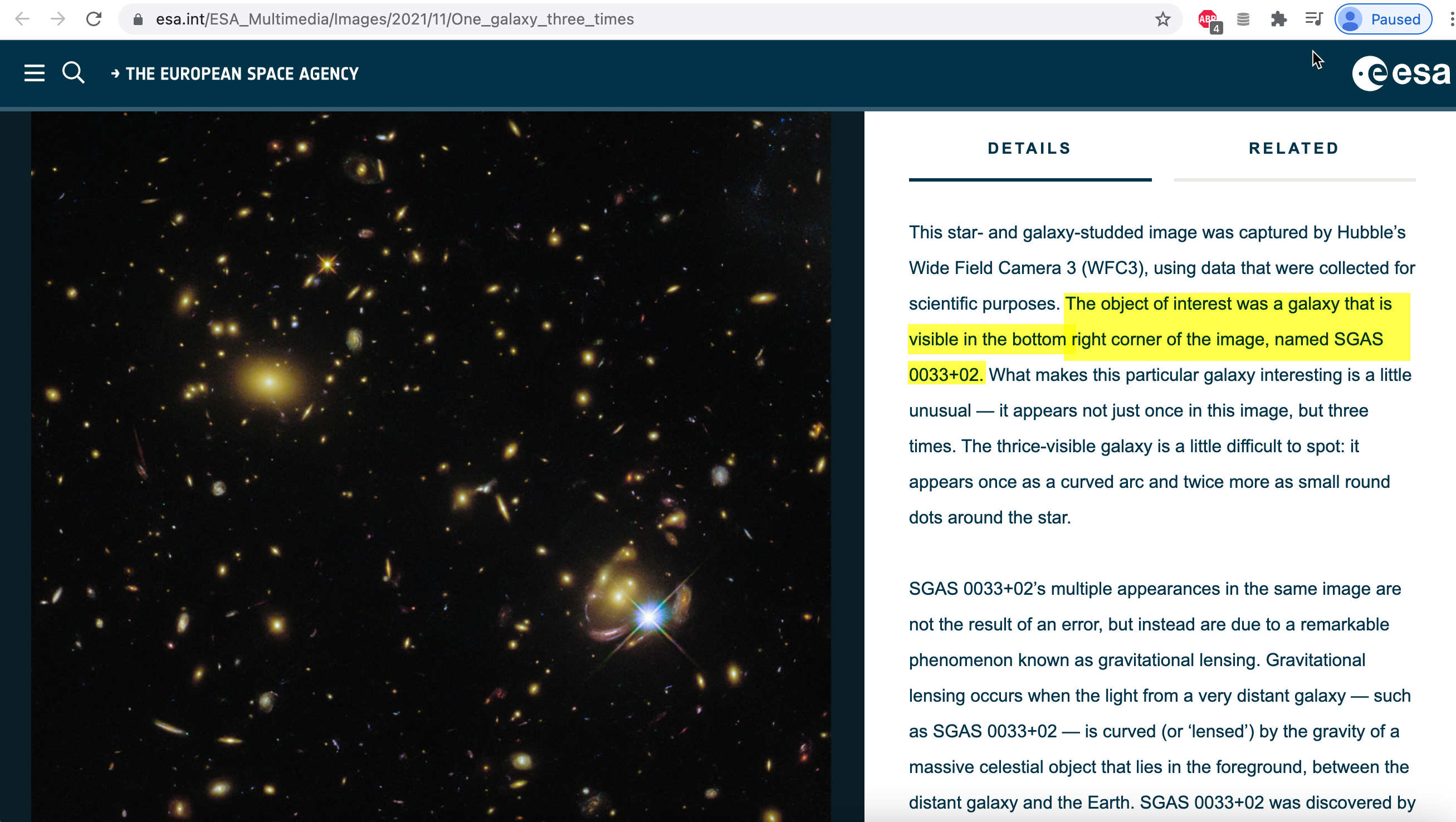
- - - - - - - - - - - - - - - - - - - - - - - - - - - - - - - - - - - - - - - - - - - - -
Posted on November 25, 2021
RIP - Antonio Subirats prominent flat Earther
Antonio Subirats RIP 1971/2021, by Music Realm
https://www.youtube.com/watch?v=7K6eVMMAVJo
Our condolences to his family and friends
The cause of death has not yet been determined.
-
ref: our articles on his flat Earth conspiracy theories:
Antonio Subirats - flat Earth advocate FAIL
https://flatearthlunacy.com/index.php/2-uncategorised/1055-antonio-subirats-flat-earth-advocate-fail
- - - - - - - - - - - - - - - - - - - - - - - - - - - - - - - - - - - - - - - - - - - - -
Posted on November 24, 2021
SpaceX Starlink satellites can function as GPS
SpaceX Satellite Signals Used Like GPS to Pinpoint Location on Earth (spaceref.com)
http://spaceref.com/news/viewpr.html?pid=58830
Excerpt:
Engineering researchers have developed a method to use signals broadcast by Starlink internet service satellites to accurately locate a position here on Earth, much like GPS does. It is the first time the Starlink system has been harnessed by researchers outside SpaceX for navigation.
The Starlink satellites, sent into orbit by Elon Musk's SpaceX, are designed to provide broadband internet connections in remote locations around the world. The researchers used signals from six Starlink satellites to pinpoint a location on Earth within 8 meters of accuracy.
Their findings, shared in September at the Institute of Navigation GNSS 2021 annual meeting in St. Louis, may provide a promising alternative to GPS. Their results will be published in the upcoming issue of the journal IEEE Transactions on Aerospace and Electronic Systems.
The researchers did not need assistance from SpaceX to use the satellite signals, and they emphasized that they had no access to the actual data being sent through the satellites – only to information related to the satellite's location and movement.
(Please read this full article at the URL posted above)
- - - - - - - - - - - - - - - - - - - - - - - - - - - - - - - - - - - - - - - - - - - - -
Posted on November 24, 2021
Here are Hubble’s 2021 Photos of the Outer Solar System (universetoday.com)
https://www.universetoday.com/153375/here-are-hubbles-2021-photos-of-the-outer-solar-system/
Here are Hubble’s 2021 Photos of the Outer Solar System
- -
Saturn
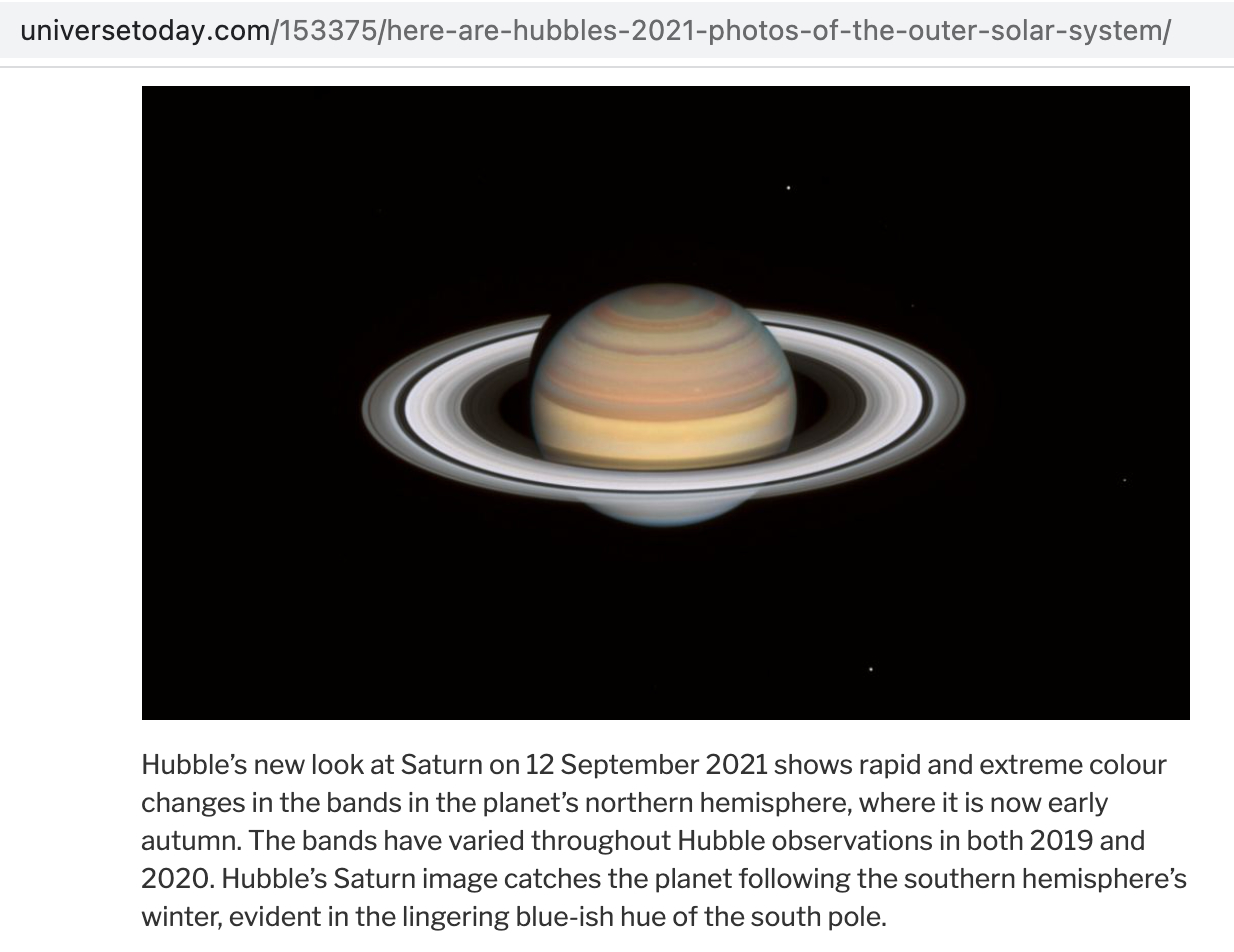
- -
Uranus
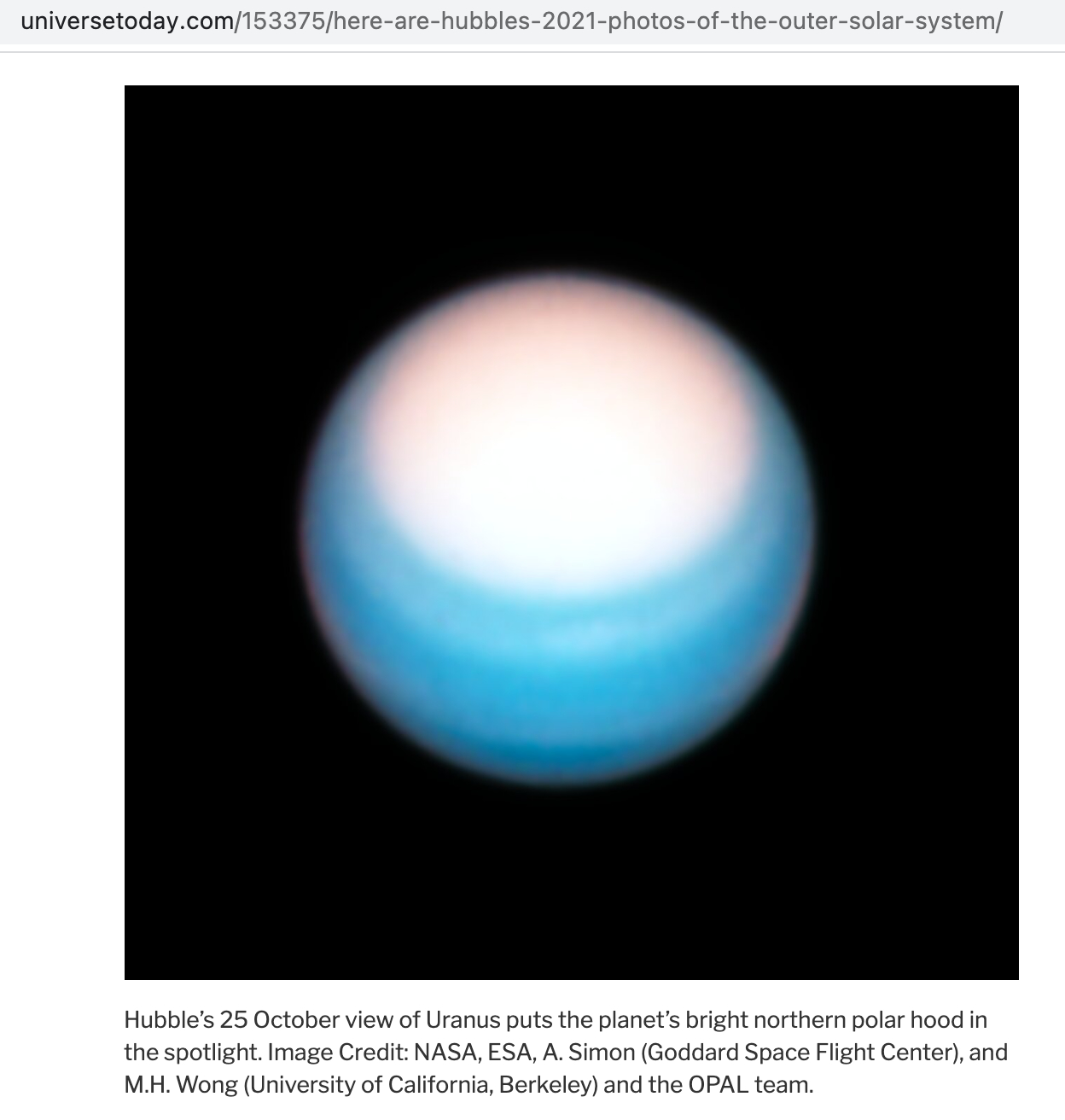
-
Why is Uranus On Its Side? | The Planets | Earth Lab, by BBC Earth Lab
https://www.youtube.com/watch?v=q7HMd2FyFqk
Venus and Uranus are the only planets to spin the opposite way to the rest of the planets.
Best of Earth Lab: http://bit.ly/EarthLabOriginalsttp://bit.ly/EarthLabOriginals
Best of BBC Earth: http://bit.ly/TheBestOfBBCEarthVideos
The Planets (2019) This stunningly ambitious series brings to life the most memorable events in the history of the solar system, by using ground-breaking visual effects to tell the thrilling story of all eight planets. Transporting you to the surface of these dynamic worlds to witness the moments of high drama that shaped each one, The Planets reveals how the latest science allows us to unlock their past lives. It pieces together clues of magnificent lost waterfalls on Mars, the mass planetary migrations as they jostled for position early in their history, and even the distant fate of Saturn as one of its moons awakens to form a beautiful water world.
- -
Neptune.
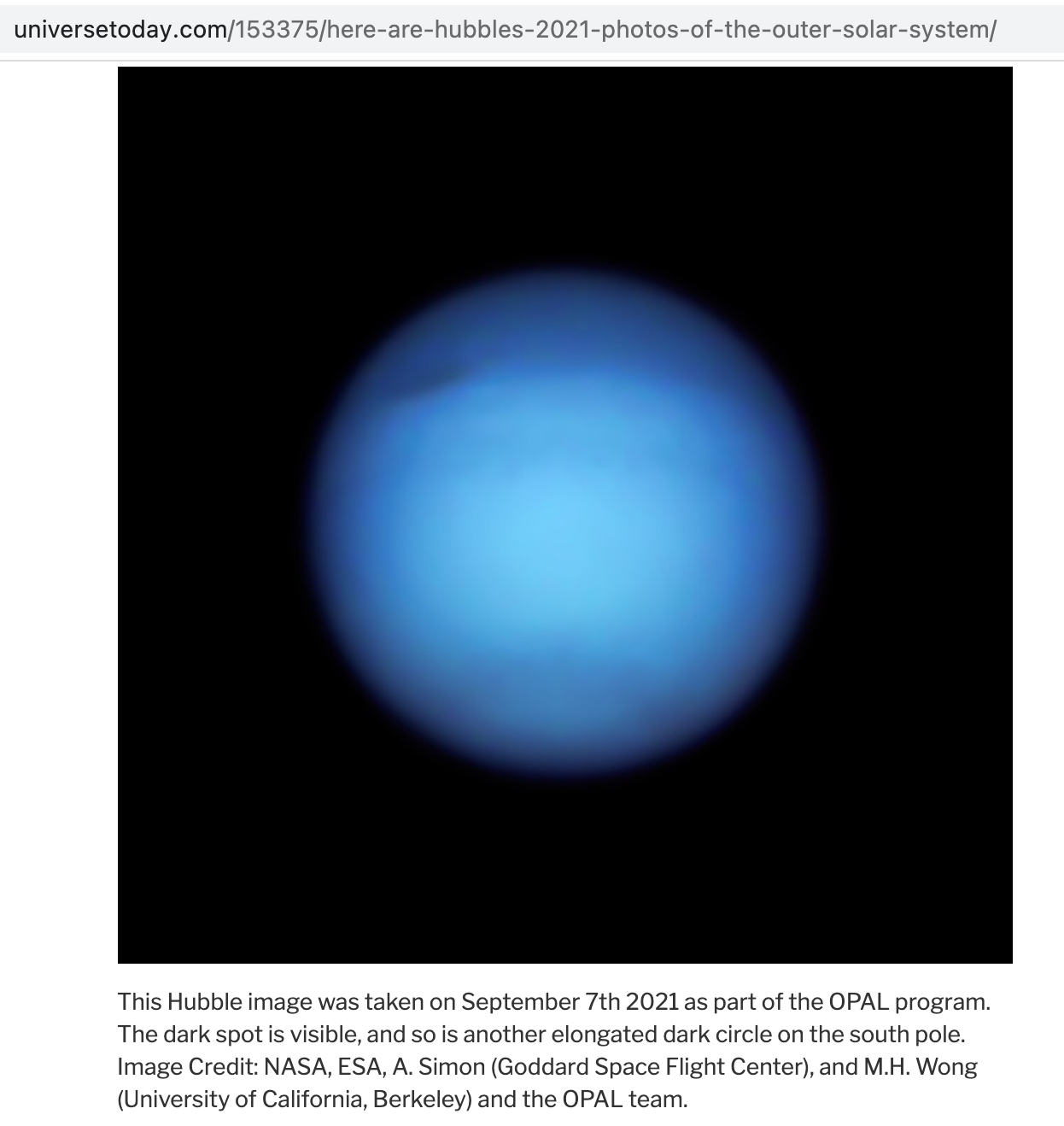
(Please read this full article at the URL posted above)
- - -
Update: April 24, 2022
Happy Birthday, Hubble (skyandtelescope.org)
https://skyandtelescope.org/astronomy-news/happy-birthday-hubble-3/
The Hubble Space Telescope turns 32 on April 24th, and the team behind the telescope is marking the occasion with the release of a galactic family picture.
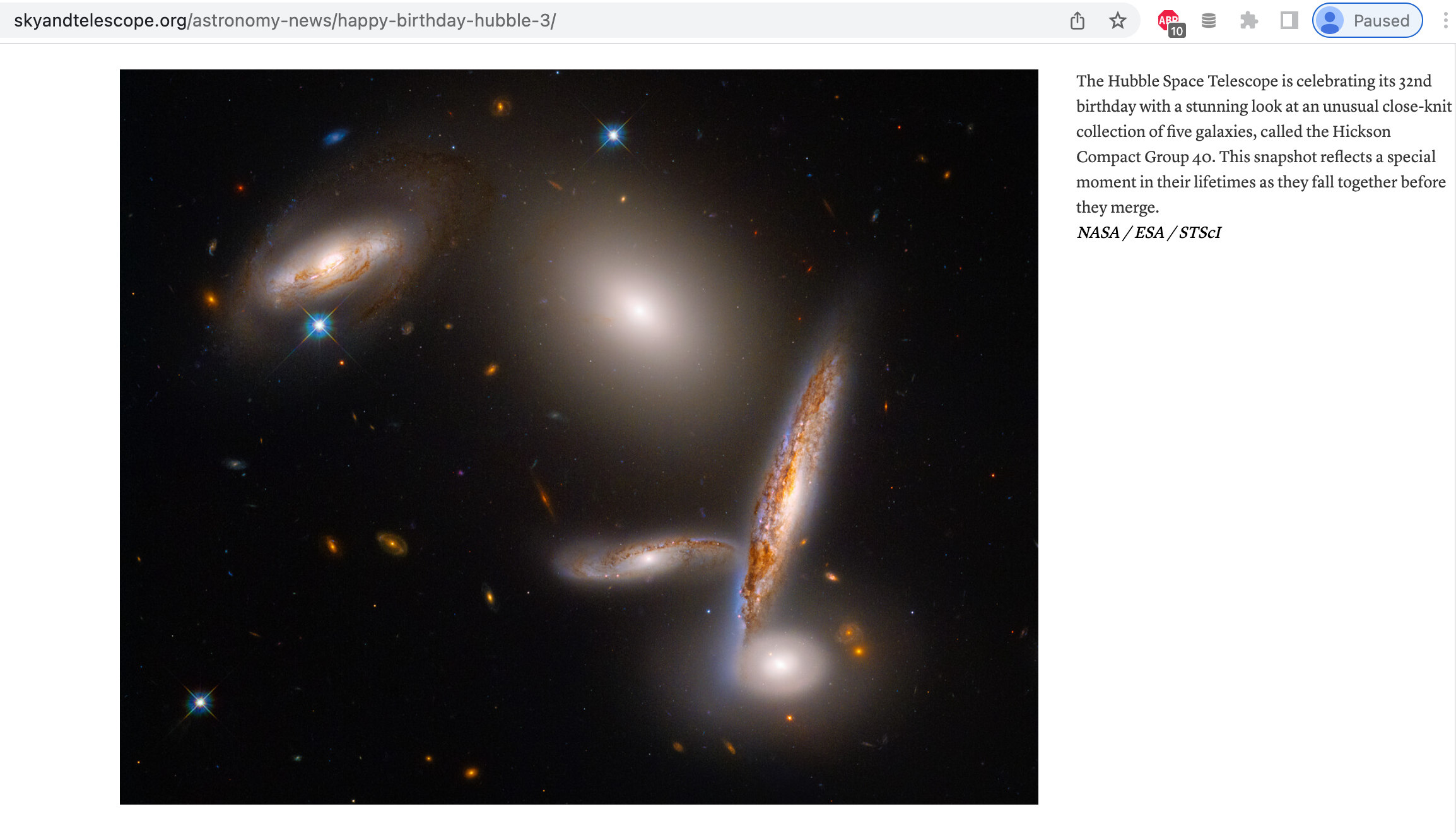
Three spiral galaxies, an elliptical, and a lenticular feature in this Hubble Space Telescope image, all packed into a volume less than 200,000 light-years across, or twice the diameter of the Milky Way’s disk. Their light traveled 300 million light-years before it reached Hubble’s cameras.
At first glance, the five stunning galaxies of Hickson Compact Group 40 look disconnected, placed next to each other in space by chance superposition. But a closer look reveals connections between them, bridges made of gas and stars.
The galaxies make up one of the most crowded compact galaxy groups known, and it’s getting more crowded still. They’re falling inexorably toward each other — in about 1 billion years, there’ll be nothing to see here except for a giant elliptical fuzzball of stars.
Such compact groups might have been more common earlier in the universe’s timeline. Galactic interactions fueled the supermassive black holes that lurk in most galaxy centers and, indeed, most of the galaxies here show evidence of such a central black hole.
The image, taken late last year, was released recently in celebration of the Hubble Space Telescope’s 32nd year of operations. Hubble has far outlived its expected lifetime, having captured 1.5 million images of about 50,000 celestial objects along the way so far. HCG 40 is one more under its belt.
(Please read the article posted at the URL above)
-
Visit the main NASA Hubble site here ...
https://hubblesite.org/
https://hubblesite.org/resource-gallery/images
- - -
- - - - - - - - - - - - - - - - - - - - - - - - - - - - - - - - - - - - - - - - - - - - -
Posted on November 15, 2021
Flat Earthers, why such a long duration (nearly 3½ hours) lunar eclipse this time? How does your version of the Moon slow down for this event. Please explain using your FE model. Show your calcs.
FE ADDITIONAL FAIL - Katu & Rahu (shadow planets never found) do not block the Moon to cause lunar eclipses, as demonstrated by the Moon darkening (but not disappearing) during a Penumbral phrase.
North American observers can watch the Moon turn a reddish hue as it flirts with Earth’s shadow on the night of November 18–19 in the longest partial eclipse of the century. (skyandtelescope.org)
https://skyandtelescope.org/press-releases/north-america-favored-for-this-weeks-deep-partial-lunar-eclipse/
WHAT TO LOOK FOR
The partial eclipse is predicted to last longer than usual, nearly 3½ hours. In fact, not only will it be the longest partial lunar eclipse this century, it’s also the longest partial lunar eclipse between February 18, 1440, and February 8, 2669. It happens 1.7 days before the Moon reaches its apogee, or the farthest point from Earth, in its orbit. This means that the Moon’s orbital motion will be slower, thereby increasing the duration of the event.
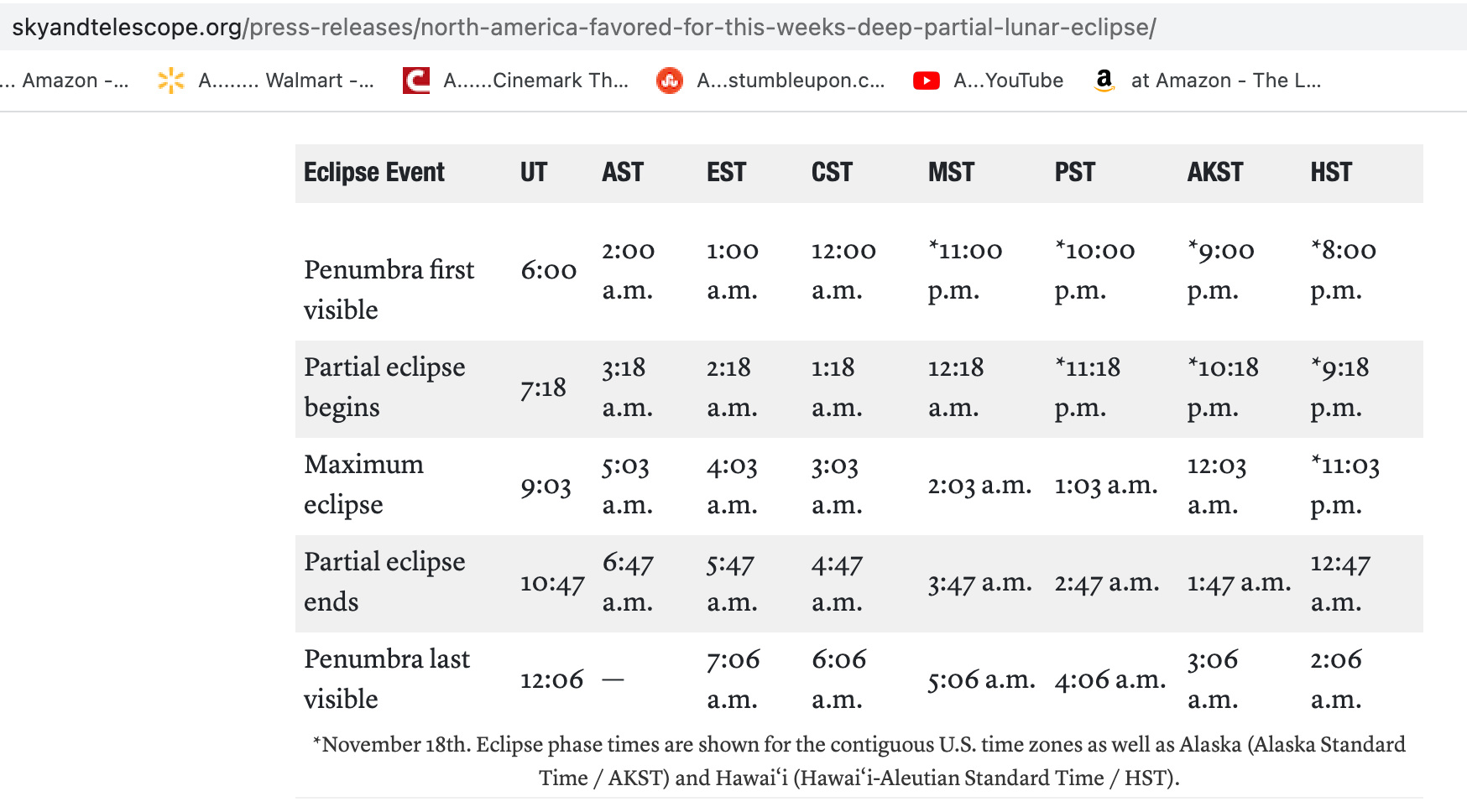
-
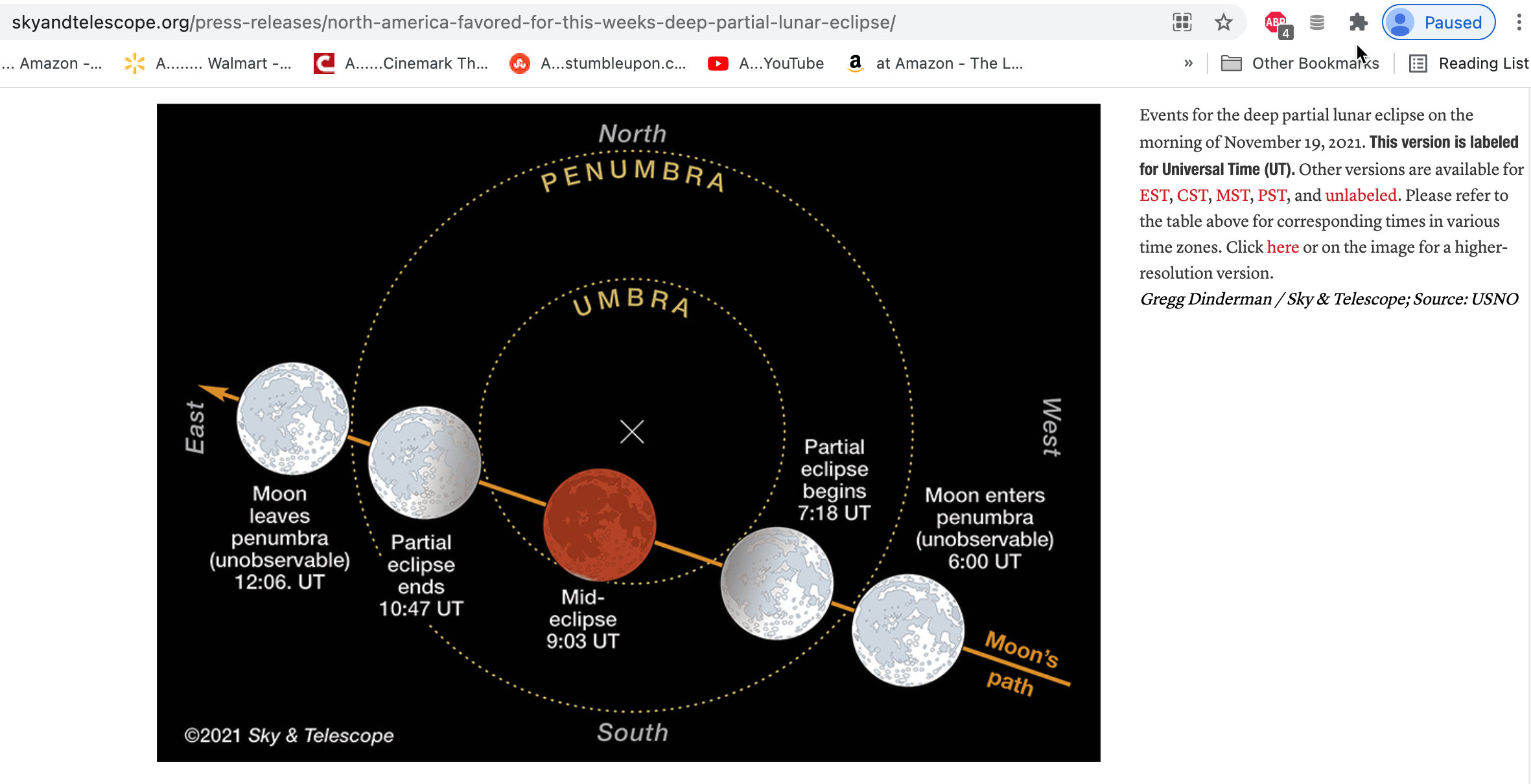
(Please read this full article at the URL posted above)
-
Lunar eclipse photos November 18-19, 2021 (earthsky.org)
https://earthsky.org/todays-image/lunar-eclipse-photos-nov-18-19-2021/
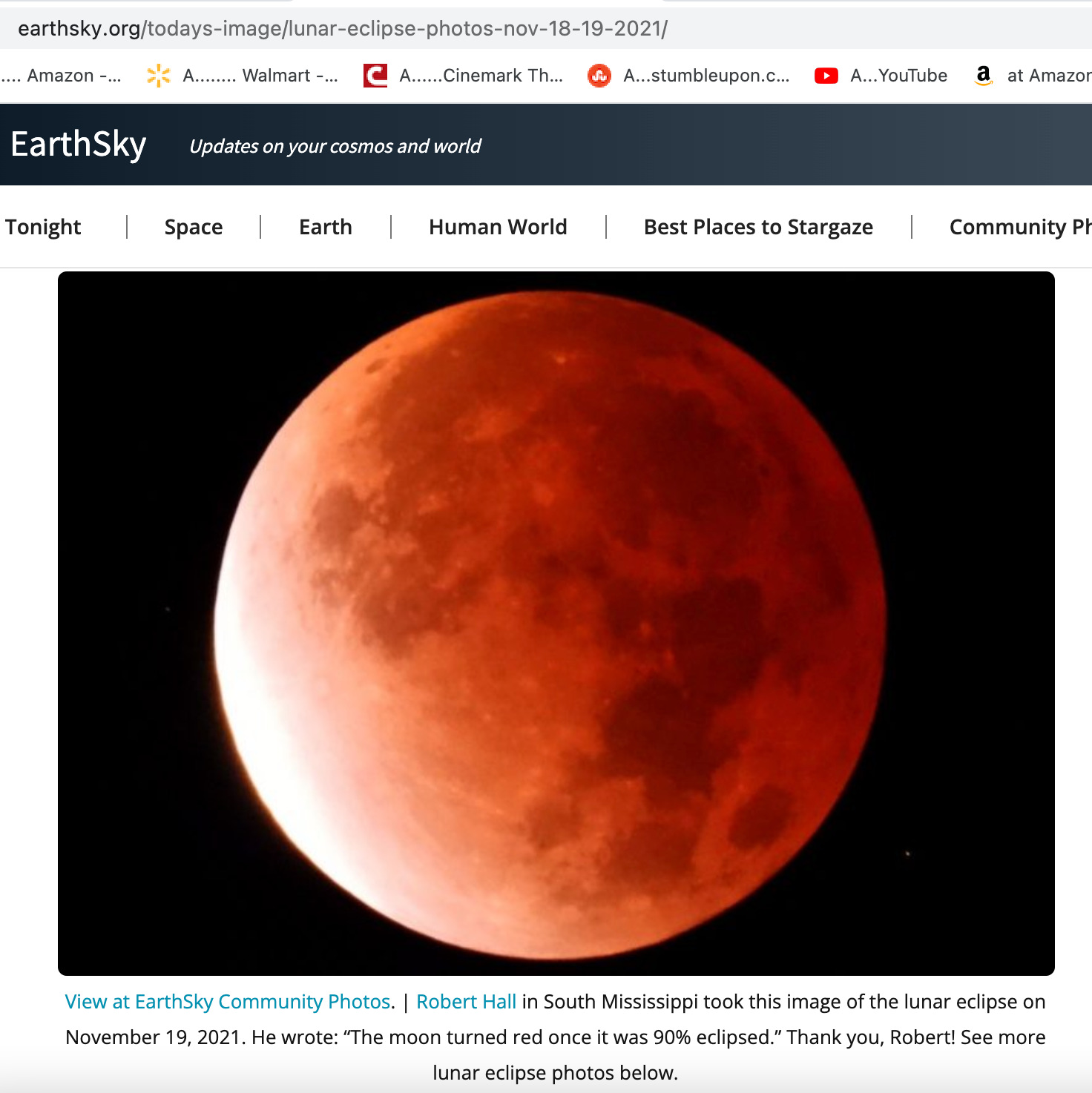
(Please read this full article at the URL posted above)
- - - - - - - - - - - - - - - - - - - - - - - - - - - - - - - - - - - - - - - - - - - - -
Posted on November 10, 2021
Variable Stars: Flat Earthers have no explanation or even want to address, why many stars in the sky ("just lights") change in brightness. Many such stars follow a timed repeating cycle of dimming and brightening.
Citizen scientists find 10,000 new variable stars (phys.org)
https://phys.org/news/2021-11-citizen-scientists-variable-stars.html
Excerpt:
Volunteer citizen scientists parsing data from a network of telescopes around the world this year identified 10,000 new variable stars in the Milky Way, according to a recent paper.
The volunteers have been examining data from the All-Sky Automated Survey for Supernovae since January. The survey, known as ASAS-SN, is run by researchers at The Ohio State University.
In a paper posted to the arXiv pre-print server, the researchers detailed what the citizen science project, called Citizen ASAS-SN, has accomplished so far: More than 3,100 volunteers have made about 839,000 classifications of more than 100,000 light curves—data that tells astronomers about objects in the sky. A variable star is a star whose brightness changes over time—the light we see coming from such a star is not constant.
The volunteer scientists attempted to broadly classify the stars as eclipsing binaries, where one star passes in front of another, pulsating stars and rotating stars. Volunteer scientists could also classify the data as "junk," meaning it was something other than a star. For example, low-Earth orbiting satellites can interfere with the light from stars in telescopes; the data from a satellite would be classified as junk. And volunteer scientists could mark the data as "unknown" if the light curves did not fit into one of the other classes of variable stars...
(Please read this full article at the URL posted above)
- - - - - - - - - - - - - - - - - - - - - - - - - - - - - - - - - - - - - - - - - - - - -
Posted on November 10, 2021
Dean Odle: Flat Earther and Senior Pastor at Fire & Grace Church, is running for Governor of Alabama in the May 24, 2022, Republican state primary.
Campaign 2022: Dean Odle Brings Gubernatorial Campaign to Alabama State House (alabamanews.net)
https://www.alabamanews.net/2021/05/18/campaign-2022-dean-odle-brings-gubernatorial-campaign-to-alabama-state-house/
Dean Odel for Governor
https://twitter.com/PastorDean67?ref_src=twsrc%5Egoogle%7Ctwcamp%5Eserp%7Ctwgr%5Eauthor
-
Some of our articles about the flat Earth beliefs of Dean Odle-
Flat Earth International Conference November 2017, North Carolina USA - How the Truth Movement has gone astray
Pastor Dean Odle at the 2017 conference
https://fe2017.com/
-
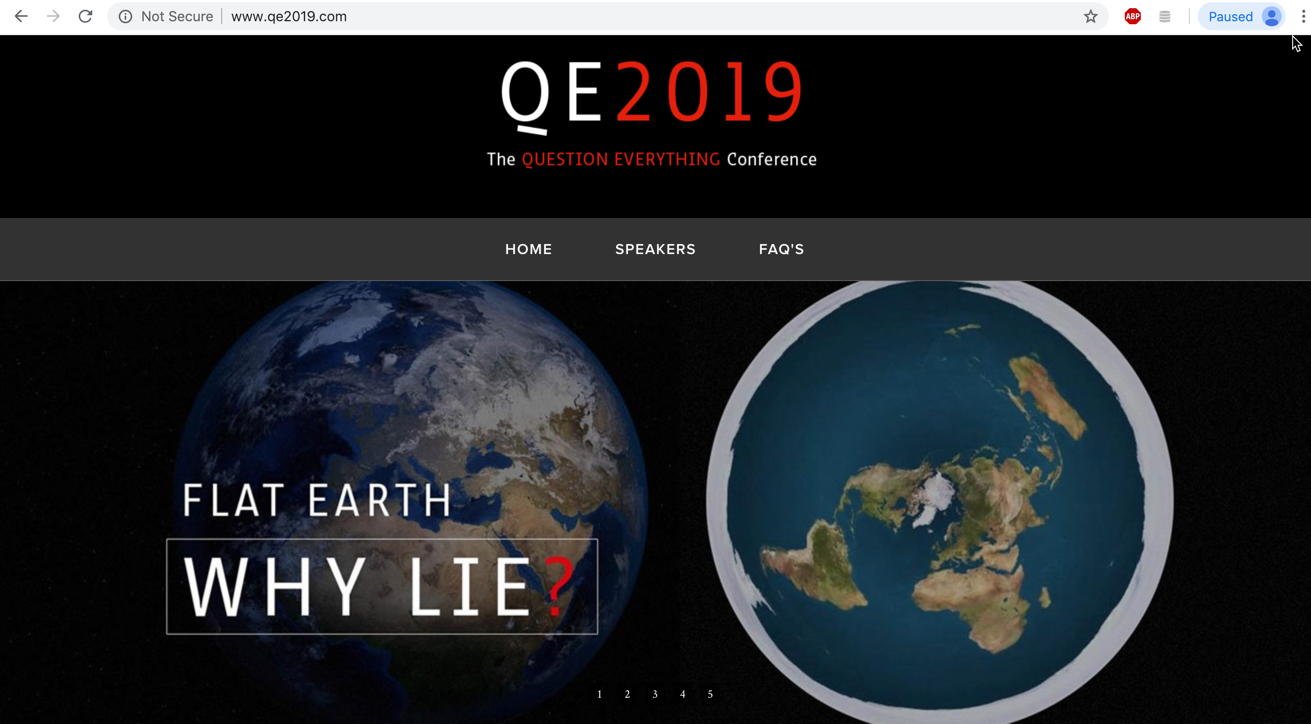
by Joe Garcia (February 22 & 23, 2019, Yorba Linda, California - USA)Speakers list: Robbie Davidson, Matt Long, Mark Sargent, Pastor Dean Odle, Nathan Roberts, Christina Hildebrand, Al Morentin, Emily Pittsford, Chad Taylor, Jared Chrestman, Daniel Noel, Paul on The Plane, and Jeremiah Dirt.Topics to be discussed at the convention:
- Scientism Exposed - Can we trust "the science" being taught today.
- Is the CIA, Army, Air Force, Navy, NASA, and Russia telling us the truth about the shape of the earth?
- Can we trust BigPharma?
- Is CBD safe and helpful for my family and pets?
- Are vaccines safe?
- Is there more to the official 9/11 story? Have we been misled?
- Did we really go to the moon in 1969 to 1972? Is it even possible?
- Can we believe the Bible? Is there actual evidence for the faith of so many?
- Are we born that way? Tackling the homosexual question.
- Spiritual warfare. Is there battle for our mind?
- Is the earth really flat?
-
Alabama gubernatorial candidate Dean Odle believe the earth is flat (yellowhammernews.com), by Dale Jackson
https://yellowhammernews.com/alabama-gubernatorial-candidate-dean-odle-believes-the-earth-is-flat/
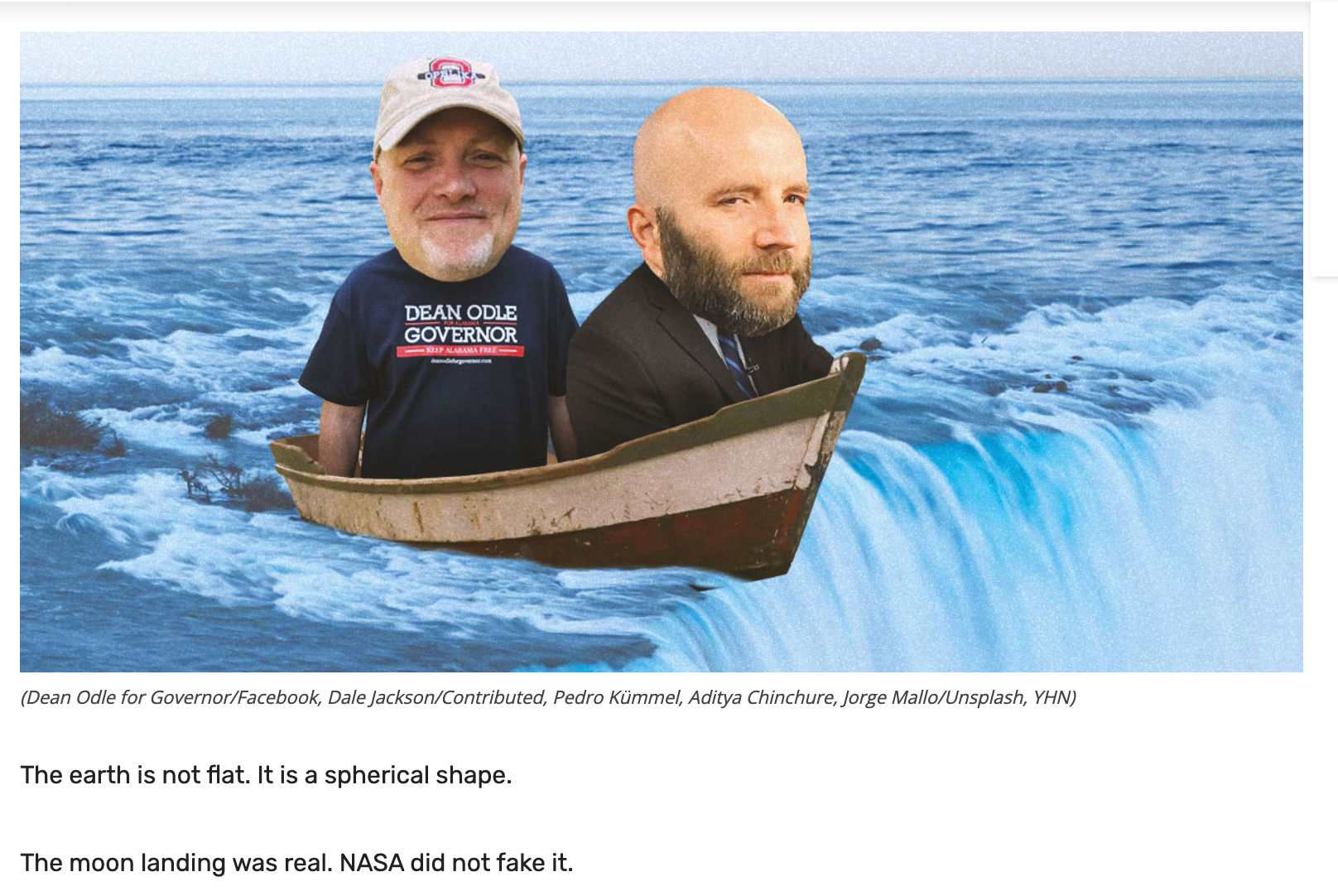
Excerpt:
The earth is not flat. It is a spherical shape.
The moon landing was real. NASA did not fake it.
QAnon is not real. There is not a person that knows of the arrests of a group of secret criminals that will lead to the re-installation of Donald Trump as president.
Pizzagate is not real. There was not a child pedophile ring being run out of a Washington, D.C. pizza parlor.
All of these things are crazy but, surprisingly, Alabama gubernatorial candidate Dean Odle believes all these conspiracies.
If he were to be governor of Alabama, or even a legit candidate, the media would have a field day.
Dean Odle won’t even actually attempt to answer questions about those conspiracies. Instead, he declares himself unquestionable and attempted to accuse others of being religious bigots.
Odle, a pastor, tried to deflect his belief in some of these insane things as being Biblical and therefore beyond reproach.
During a Monday interview with WVNN’s “The Dale Jackson Show,” which started with a rundown of his positions on COVID-19 protocols and restrictions Alabama went through over the last few months, Odle was not pleased to be asked about his more controversial and probably false views.
Moon landing: “Yeah, I don’t believe in the moon landing. No, not at all.”
QAnon: “I’m not doing this…You’re just making this a theological debate.”
New World Order: “Absolutely, Republicans and Democrats and the world economic forum.”
NASA on faking the moon landing and hiding the flat earth: “Why are they doing that? That’s what your question is? The world is full of deceivers and money — money and deception.”
It is not too much to ask that a political candidate believe the earth is round.
In response to this disastrous interview, Odle claimed he was being attacked for his religious beliefs on his campaign website.
His response includes, “I have been viciously attacked and mocked in the Alabama press for my religious beliefs. Most recently, by a so-called ‘conservative’ radio host. (It seems the Right-wing in Alabama has their own version of cancel culture).”
Governor Kay Ivey needs an opponent, but this guy ain’t it.
-
Go to - https://yellowhammernews.com/alabama-gubernatorial-candidate-dean-odle-believes-the-earth-is-flat/
and listen to Dale Jackson's interview with Dean Odel about flat Earth.
(Please read this full article at the URL posted above)
-
Alabama pastor running for governor says hydroxychloroquine could have saved COVID-19 victims (al.com)
https://www.al.com/news/2021/06/alabama-pastor-running-for-governor-says-hydroxychloroquine-could-have-saved-covid-19-victims.html
Excerpt:
A 53-year-old pastor from east Alabama is running for governor partly because of what he calls the mishandling of the COVID-19 pandemic by Gov. Kay Ivey.
Dean Odle, who lives near Opelika and leads a church and online ministry school, said the governor and State Health Officer Dr. Scott Harris should have advocated for the use of a hydroxychloroquine regimen that he says could have saved many of the 11,000 Alabamians who have died from the coronavirus.
The FDA found last year that hydroxychloroquine was not effective in treating COVID-19 and posed risks of heart problems. The National Institutes of Health said last year there were conflicting reports on the effectiveness of hydroxychloroquine but do not include the drug in their recommended treatments for the virus.
Odle cites opinions from doctors who said hydroxychloroquine was effective at preventing serious illness early in the onset of symptoms and said he believes the pharmaceutical industry was more interested in making money through vaccine development than in effective treatments. He said politicians and the media failed to bring enough attention to the potential of treatment options.
“They wanted a vaccine. They didn’t want there to be safe, cheap effective treatments,” Odle said in a phone interview with AL.com. “And really, the politicizing of this and the big pharma agenda for a vaccine for big money really cost us in America, over 500,000 lives. A lot of those could have been saved. And over 11,000 Alabamians...
(Please read this full article at the URL posted above)
-
REF: Our other postings about Dean Odle -
Pastor Dean Odle - flat Earth advocate FAIL , preaches fire and brimstone at the Flat Earth International Conference 2017
- - - - - - - - - - - - - - - - - - - - - - - - - - - - - - - - - - - - - - - - - - - - -
Posted on November 9, 2021
Flat Earthers claim that gravity is fake. How incredulous (i.e., you can't or won't believe something).
Third Gravitational - Wave Catalog Released (skyandtelescope.org)
https://skyandtelescope.org/astronomy-blogs/black-hole-files/third-gravitational-wave-catalog-released/
The latest results from LIGO, Virgo, and KAGRA bring several key revelations, including that black holes tend to come with certain masses.
Earlier this week, the vast international team associated with three gravitational-wave projects unveiled the results from their latest observing run. The collaboration had already published two key detections from that run, the first-ever smashups of black holes with neutron stars. But this long-awaited third catalog adds significantly to researchers’ full tally, raising the total number of gravitational-wave events to 90.
The catalog includes compact objects caught colliding during the second half of the collaboration’s third observing run (called O3b), which ran from November 2019 until March 2020. This run included both Europe’s Virgo and the U.S.-based LIGO detectors; the Japanese KAGRA project joined the fun for the campaign’s last two weeks.
All four detectors use lasers bounced off mirrors to measure infinitesimal changes in distance as spacetime scrunches and stretches when a gravitational ripple passes through. The observatories turn up thousands of potential events, which scientists weed through with complex computer algorithms...
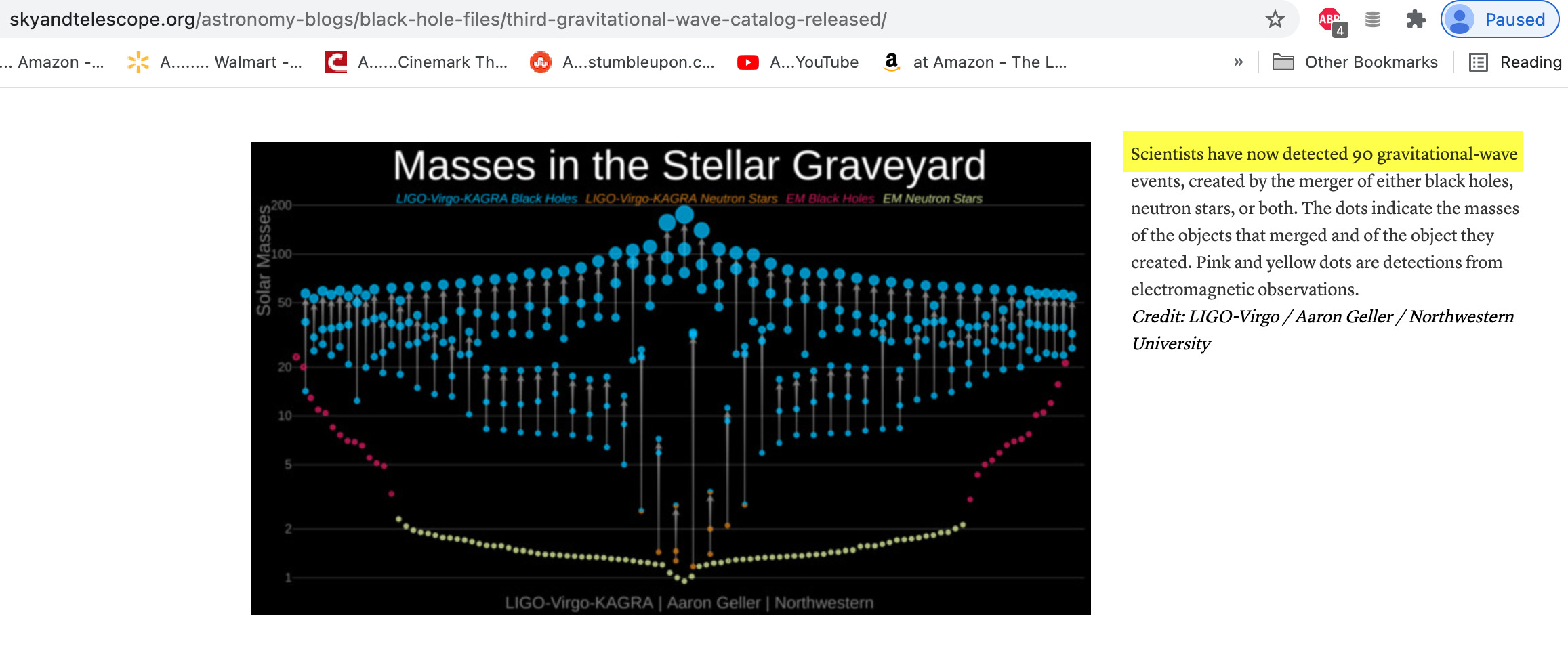
References:
The LIGO Scientific Collaboration, the Virgo Collaboration, and the KAGRA Scientific Collaboration. “GWTC-3: Compact Binary Coalescences Observed by LIGO and Virgo During the Second Part of the Third Observing Run.”
The LIGO Scientific Collaboration, the Virgo Collaboration, and the KAGRA Scientific Collaboration. “The population of merging compact binaries inferred using gravitational waves through GWTC-3.”
You can also find reader-friendly summaries of these research papers on LIGO’s outreach page, in multiple languages.
(Please read this full article at the URL posted above)
- - - - - - - - - - - - - - - - - - - - - - - - - - - - - - - - - - - - - - - - - - - - -
Posted on November 8, 2021
Venus and the Moon in our Autumn sky.
And the P1000 proves our Heliocentric reality.
https://earthsky.org/tonight/moon-and-venus-november-6-7-and-8-2021/
https://earthsky.org/todays-image/moon-and-planet-photos-november-2021/
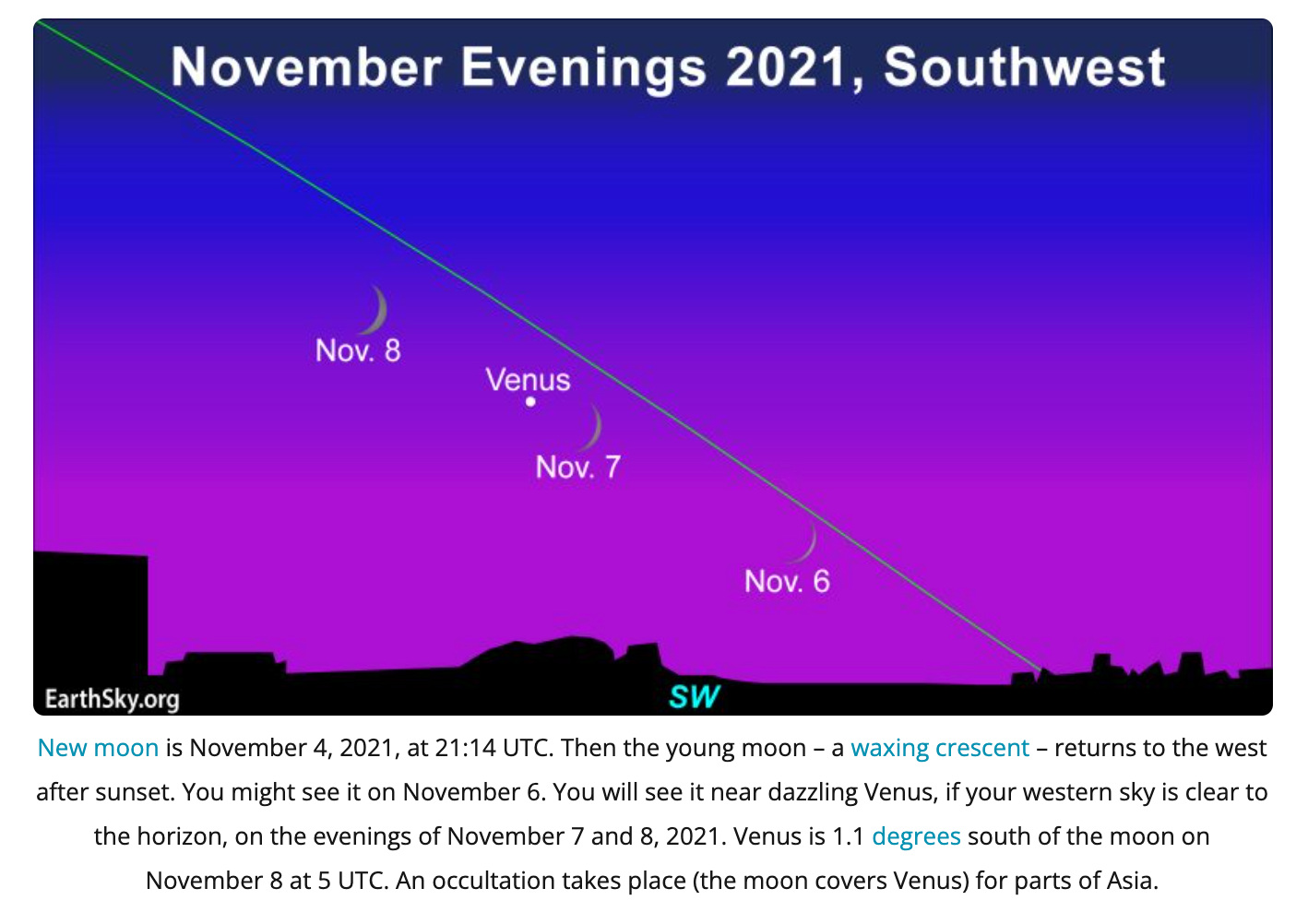
-
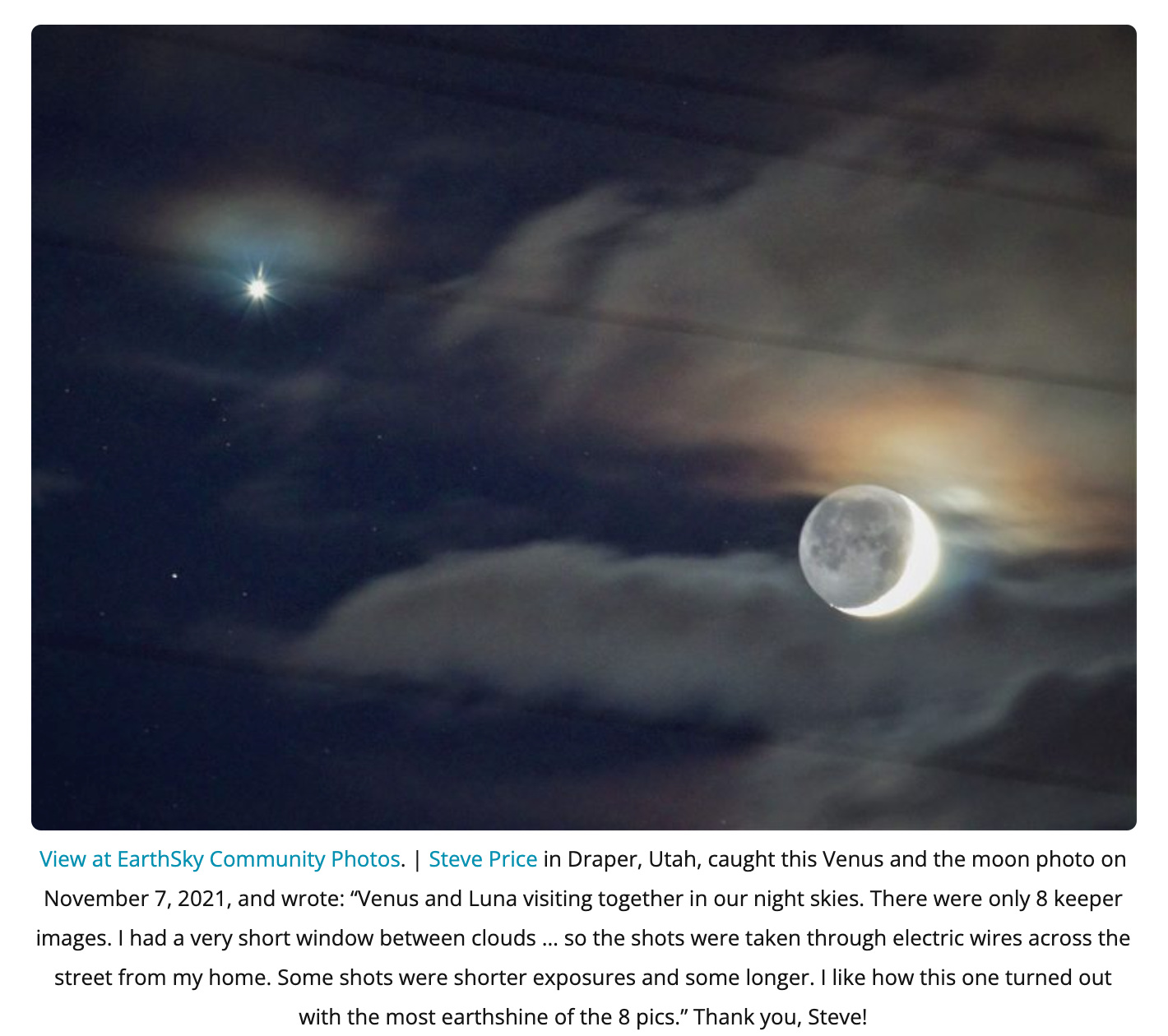
-
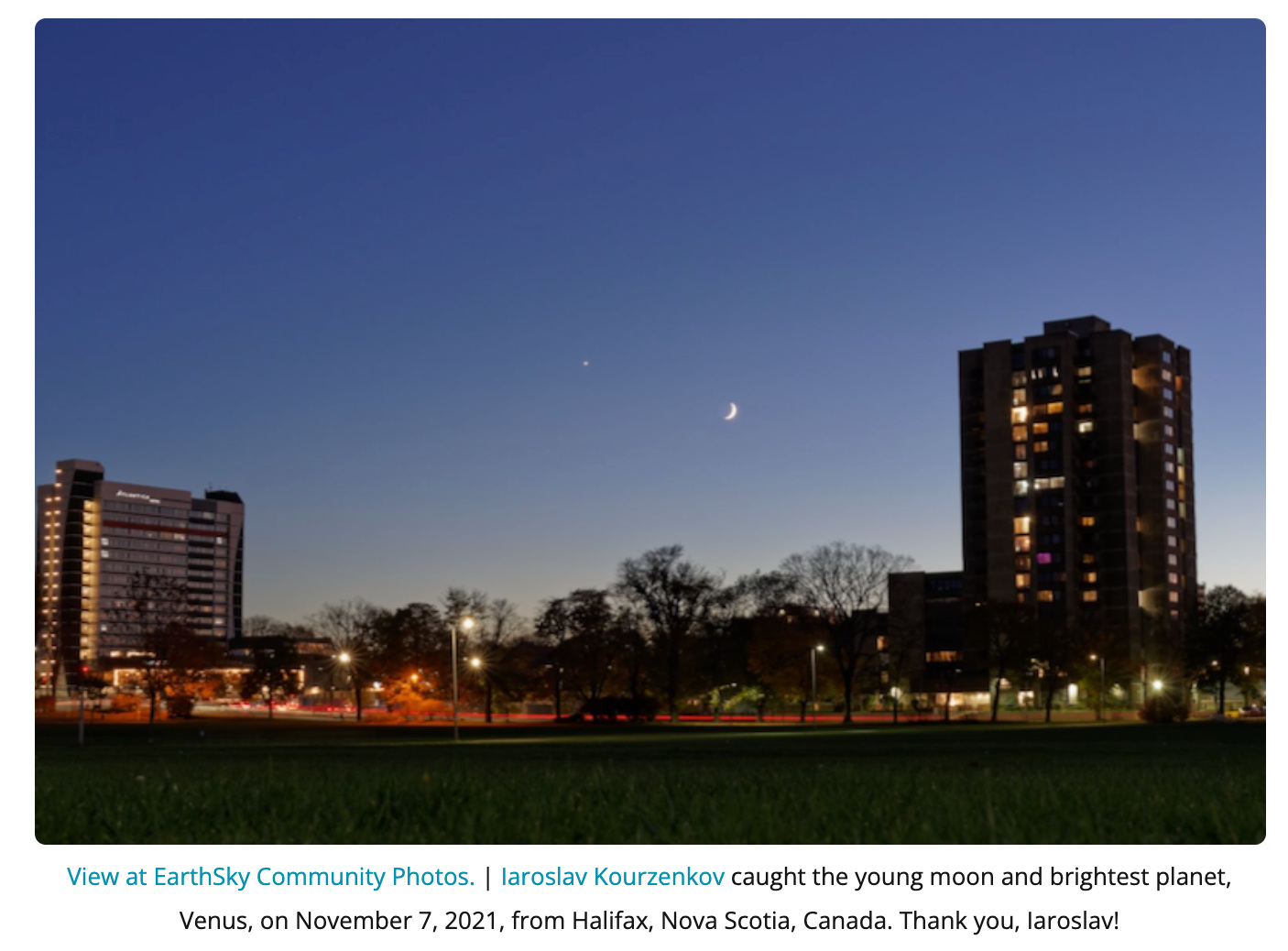
-
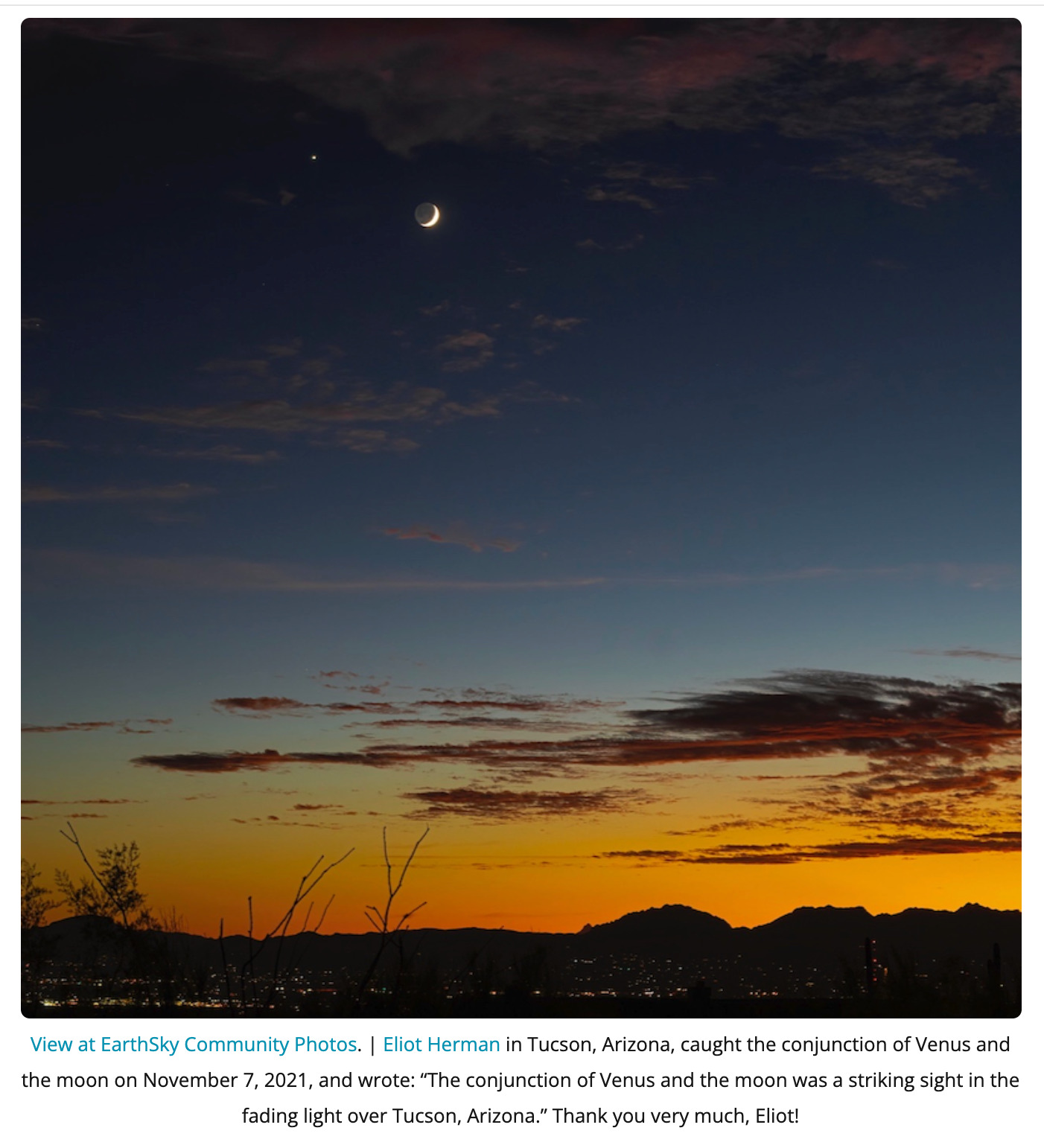
(Please read this full article at the URL posted above)
- -
Moon and Venus 8 November 2021 - Nikon P1000, by dazzathecameraman
https://www.youtube.com/watch?v=uyOmJc7i41c
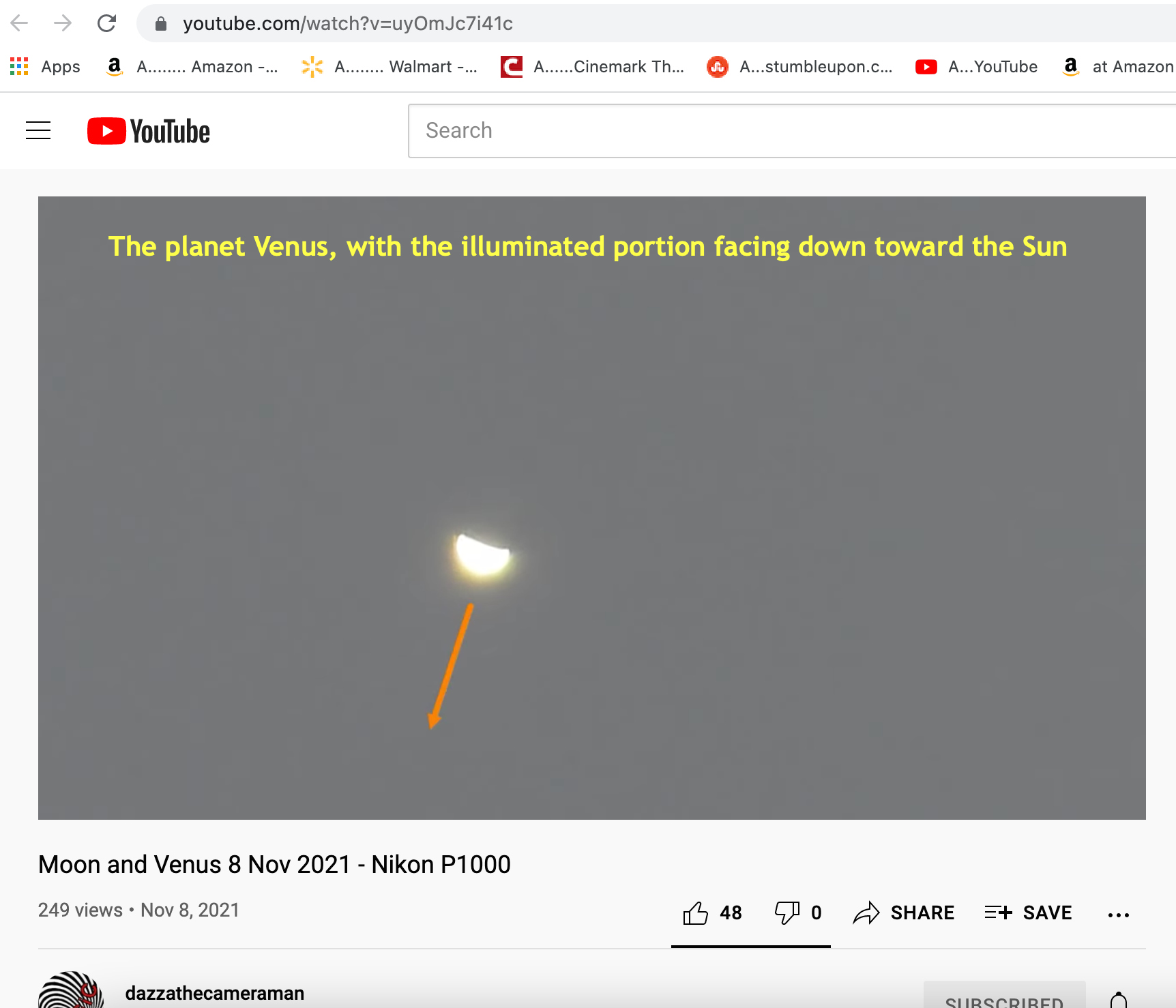
-
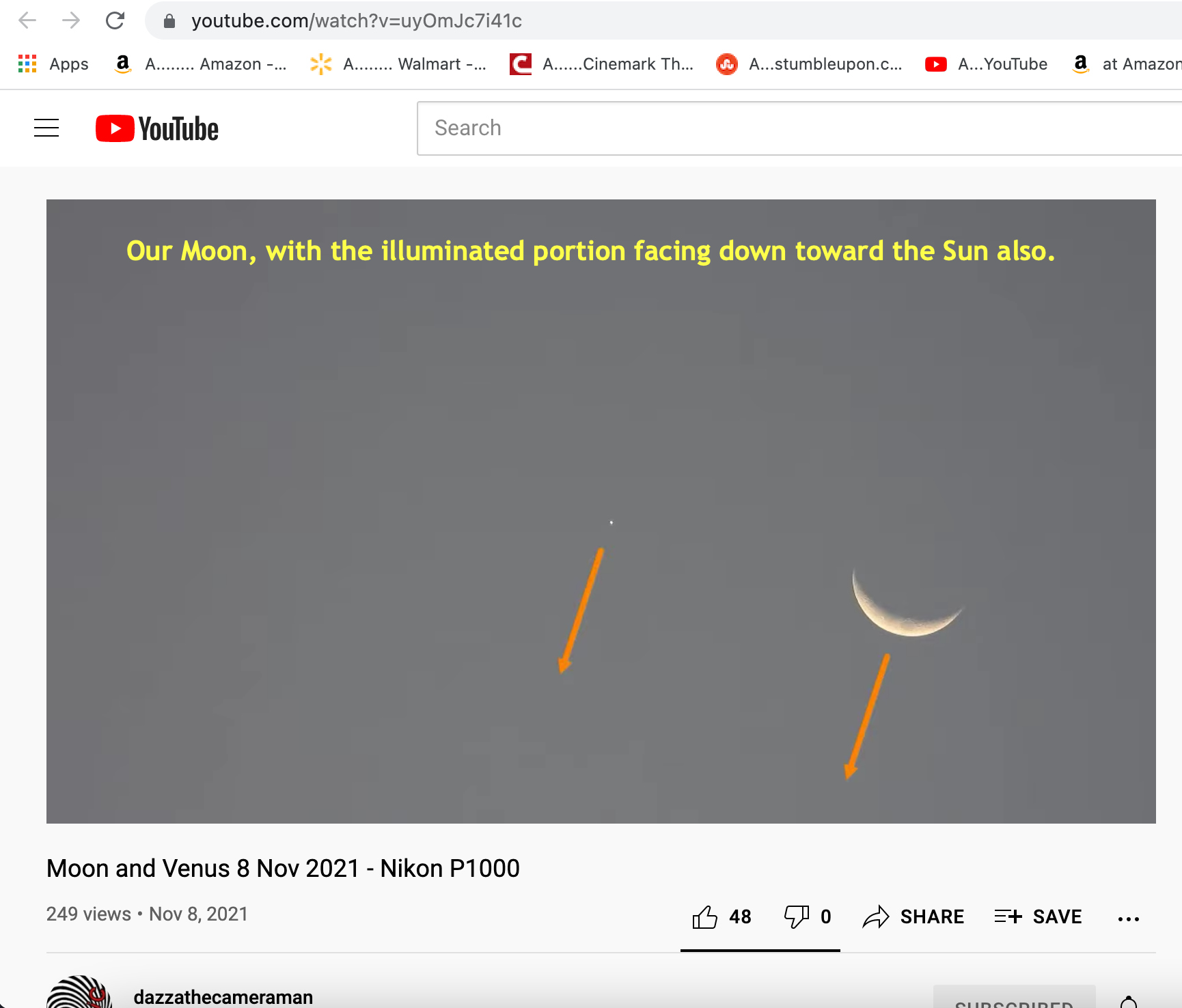
- - - - - - - - - - - - - - - - - - - - - - - - - - - - - - - - - - - - - - - - - - - - -
Posted on November 8, 2021
FREE ENERGY and PERPETUAL MOTION:
During the recent flat Earth resurgence many of them claimed those technologies were being hidden and suppressed from the general public by governments and the powerful energy producers.
Well, after FLAT EARTHERS tried but could not produce that themselves, they conveniently stopped posting about it.
You can't get more energy out of a system then you put in - 1st Law of Thermodynamics.
-
Why don't perpetual motion machines ever work? - Netta Schramm
https://www.youtube.com/watch?v=A-QgGXbDyR0
View full lesson: http://ed.ted.com/lessons/why-don-t-p...
Perpetual motion machines — devices that can do work indefinitely without any external energy source — have captured many inventors’ imaginations because they could totally transform our relationship with energy. There’s just one problem: they don’t work. Why not? Netta Schramm describes the pitfalls of perpetual motion machines.
Lesson by Netta Schramm, animation by TED-Ed.
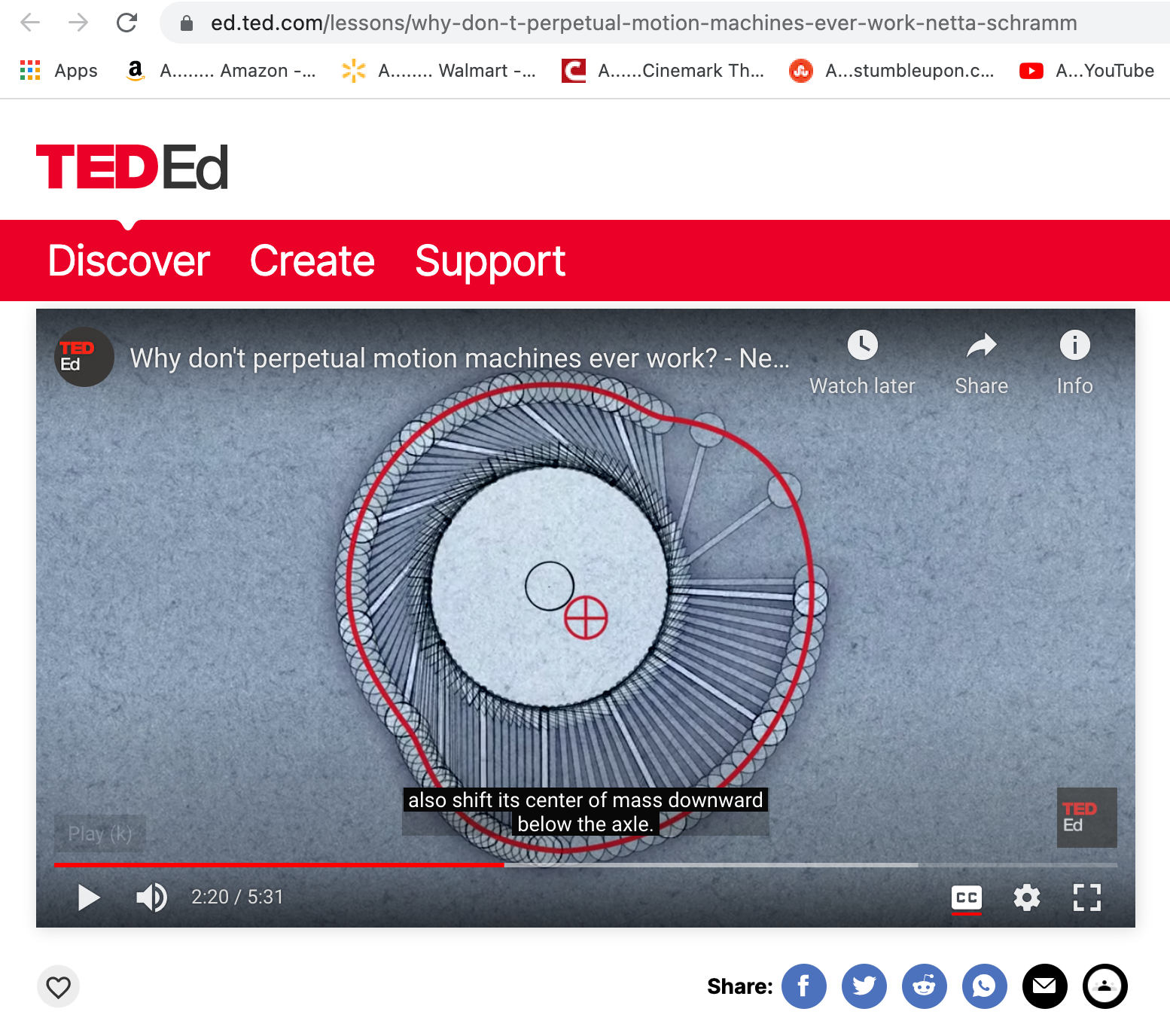
- - - - - - - - - - - - - - - - - - - - - - - - - - - - - - - - - - - - - - - - - - - - -
Posted on November 6, 2021
International Space Station (ISS) Tour: moving from module to module, floating, with no hanging wires or harnesses or physical supports in sight. SPACE IS REAL flatties.
Space Station tour with your guide Thomas Pesquet | 4K [in French with English subtitles available], by European Space Agency.
https://www.youtube.com/watch?v=XTTLeuCWIAA
Join ESA astronaut Thomas Pesquet on a tour of the International Space Station. On his second space mission Alpha, Thomas flew to space from Florida, USA, as part of Crew-2 in the @SpaceX Crew Dragon Endeavour together with @NASA astronauts Megan McArthur, Shane Kimbrough and @JAXA | 宇宙航空研究開発機構 astronaut Aki Hoshide
In this guided tour, a first shot in 4K, Thomas takes you through the modules of the International Space Station including the Dragon. Recorded in October 2021 the Space Station had just seen the departure of Soyuz MS-18 and the relocation of a Progress supply spacecraft. On board where also NASA astronaut Mark VandeHei and Russian cosmonauts Anton Shkaplerov and Pyotr Dubrov.
Over 200 investigations are planned during Thomas’ time in space, with 40 European ones and 12 new experiments led by the French space agency @CNES.
Follow Thomas: http://bit.ly/ThomasPesquetBlog
(Please read this full article at the URL posted above)
- - - - - - - - - - - - - - - - - - - - - - - - - - - - - - - - - - - - - - - - - - - - -
Posted on November 5, 2021
Mak Parhar (Flat Earth Focker) COVID denier, anti-masker & anti-vaxxer = DEAD from COVID-19*
Faced charges of breaking the quarantine act. Took the province to court over its COVID policies.
Conclusion: science denial was deadly for Mak Parhar.
FLAT EARTH R.I.P MAK PARHAR - #RIPFLATEARTHFOCKER 🙏🙏🙏, by TROLLS VS TROLLS
https://www.youtube.com/watch?v=T1sZzFnLWB8

*Coroner has yet to release the official cause of death (Nov 5, 2021).
"Parhar recently reported feeling fatigue, chills and other symptoms before taking Ivermectin."
- -
"The BC Coroners Service is investigating his death, but a spokesperson for the service said they are in the early stages and did not have details about what happened.
Parhar livestreamed a video to Twitch on October 22 where he shared that he was feeling quite sick with an undisclosed illness. His symptoms included a sore throat, cough, excess phlegm, body aches, and chills.
“It’s definitely not CONVID [sic], because CONVID doesn’t exist,” he said.
Instead, Parhar wondered if his illness could be due to an “accumulation of toxins” from exercising less and being in a “negative state of mind.”
He shared another video via Facebook Live on November 3, the day before his death, where he seemed more energetic but mentioned he’d been sick for three weeks.
His cause of death is not known...."
- -
Outspoken B.C. COVID-denier Mak Parhar dies, coroner investigating (globalnews.ca)
https://globalnews.ca/news/8351684/bc-covid-denier-mak-parhar-dies-coroner-investigating/
Mak Parhar, the New Westminster man who gained online notoriety for his belief the earth is flat and outspoken denial that COVID-19 exists, has died.
New Westminster police confirmed they were called to help paramedics at a home in the Sapperton neighbourhood Thursday morning, but arrived to find Parkhar deceased.
The cause of death has not been determined and will be investigated by the BC Coroners Service.
READ MORE: Trial begins for B.C. man accused of breaking quarantine to go to Flat Earth conference
In a recent livestreamed video, Parhar reported feeling ill with a variety of symptoms, including fatigue, chills and a cough, which he said was “not CONVID (sic) because CONVID (sic) doesn’t exist.”
READ MORE: Lawsuit filed by COVID-19 denier and anti-masker against B.C. government dismissed
(Please read this full article at the URL posted above)
- - -
Update: November 16, 2021
A Senseless Death | Flat Earth Focker, by Bob the Science Guy
https://www.youtube.com/watch?v=2aLA3F1mC00
It is often said science denial is harmless. It is not. Rob Skiba and Flat Earth Focker recently died of vaccine preventable diseases because they simply didn't believe science and the reality of the pandemic.
- - - -
ref:
Our flat earth debunk articles:
Flat Earth Focker (Mak Parhar) - flat earth advocate FAIL
https://flatearthlunacy.com/index.php/2-uncategorised/779-flat-earth-focker-mak
- - - - - - - - - - - - - - - - - - - - - - - - - - - - - - - - - - - - - - - - - - - - -
Posted on November 4, 2021
More building blocks of our Universe reality discovered. CERN Physicists Observe Triple J-psi Meson Production (sci-news.com)
http://www.sci-news.com/physics/triple-j-psi-meson-production-10237.html
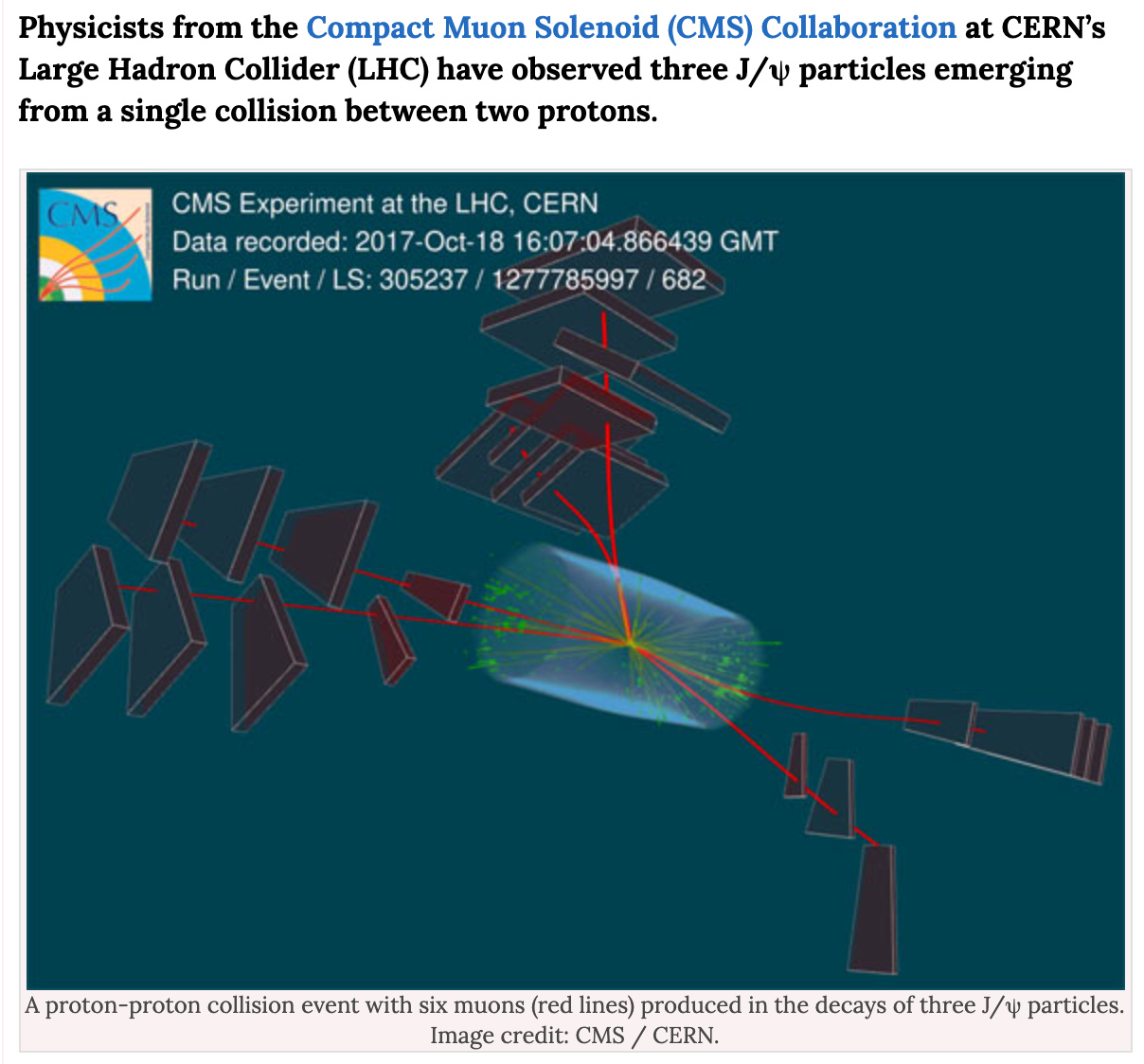
Excerpt:
The J/ψ meson (J/psi meson or psion) is a flavor-neutral meson about three times more massive than a proton.
This particle consists of a charm and an anti-charm pair held together tightly via the strong force.
It was discovered in two experiments unexpectedly in 1974, in the so-called ‘November Revolution’ of particle physics. This, in turn, led to the discovery of the charm quark, a heavier cousin of the up quark.
It fetched the pioneers of the experiments — Burton Richter and Samuel Ting — the Physics Nobel prize in 1976, and, importantly, opened a new window in the field of high-energy physics.
ATLAS, CMS and LHCb experiments have previously seen one or two J/ψ particles coming out of a single particle collision, but never before have they seen the simultaneous production of three J/ψ particles — until the new CMS analysis.
The rarity of this process is reflected in the number of events found, which is a meager 5, out of almost 100 billion proton-proton interactions that occurred during the Run-2 operation of the LHC spanning 2015-2018.
The new result, published on the CERN CDS information server, has a statistical significance of more than five standard deviations — the threshold used to claim the observation of a particle or process in particle physics.
“This result provides a novel independent approach to study the evolution of the transverse density of quarks and gluons inside the proton by exploiting, for the first time, the production of three J/ψ particles,” said CMS physicist Dr. Stefanos Leontsinis and his colleagues.
(Please read this full article at the URL posted above)
- - - - - - - - - - - - - - - - - - - - - - - - - - - - - - - - - - - - - - - - - - - - -
Posted on November 3, 2021
Greek Astronomy | The Moon and the Sun, by Bob the Science Guy
Aristarchus of Samos, Eratosthenes, etc..
https://www.youtube.com/watch?v=BYwBlEq7T8M
"How the ancient Greeks determined the size and distance to the Sun, the Moon, and the size of the Earth."
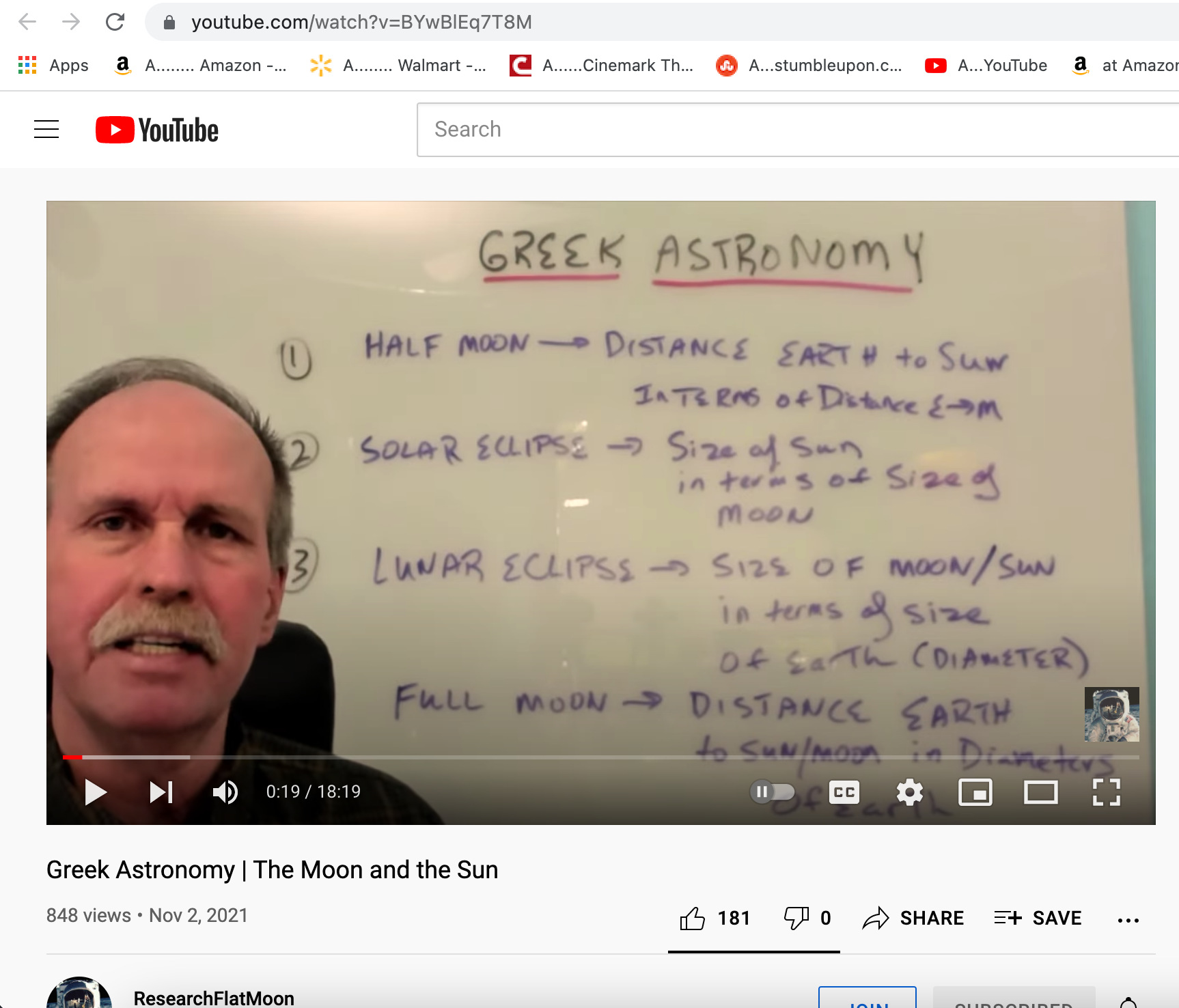
-
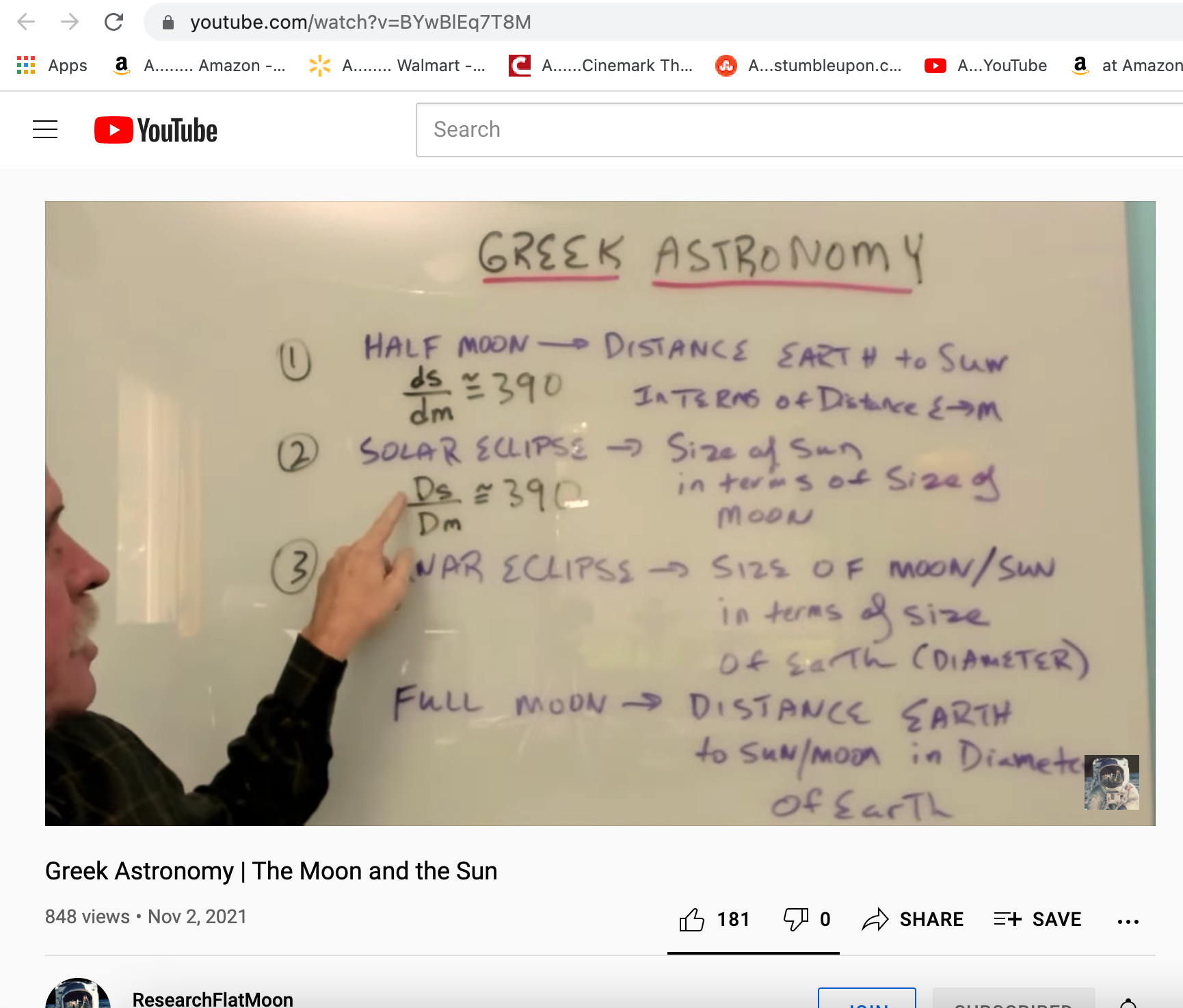
- -
Greek Astronomy | Putting it all Together, by Bob the Science Guy
https://www.youtube.com/watch?v=OU3hTLQOtNA
In this episode we use the angular size of the full moon to determine the distance to the moon and sun in terms of the diameter of the earth. Then we determine the diameter of the eartand calculate the distance to the moon and sun and their sizes.
- -
The Greeks to the Renaissance, by Bob the Science Guy
https://www.youtube.com/watch?v=uimQeBkgzPg
In this episode we look at early science and astronomy as we began our exploration of the world around us.
- -
BlueMarbleScience Live, by BlueMarbleScience
https://www.youtube.com/watch?v=D_QEcNcI2GI
Eratosthenes on an 8" Globe
- -
Greek Astronomy | The Moon and the Sun, by Bob the Science Guy
https://www.youtube.com/watch?v=99PjF6HxD2A
2300 years ago Aristarchus of Samos used basic geometry to work out the relationships between the distances and sizes of the Sun and Moon, using solar and lunar eclipses. In our next episode we will look at the full moon and use it to relate the size of the moon to the size of the earth.
- -
Greek Astronomy | Putting it all Together, by Bob the Science Guy
https://www.youtube.com/watch?v=yprjO0_3nvo
In our first episode we looked at the relationship between the Sun and the Moon, in this episode we relate those relationships to the size of the the earth, then look to Eratosthenes to put numbers to the ratios.
- -
Discovering Time Part 1, by Bob the Science Guy
https://www.youtube.com/watch?v=Qln9Xbq_fGI
Our basis of time keeping comes from the rotation of the earth and the movement of the sun. In part one of our series, we look at the equation of time, longitude and our orbit around the sun.
- - - - - - - - - - - - - - - - - - - - - - - - - - - - - - - - - - - - - - - - - - - - -
Posted on October 28, 2021
Terran Orbital: Private satellite builder and launch services company now set to go mainstream financial - with Stock Market Initial Public Offering.
https://www.terranorbital.com/

Full story here:
Satellite Maker Terran Orbital Strikes $1.58 Billion SPAC Deal, by Ben Dummett (The Wall Street Journal)
https://www.wsj.com/articles/satellite-maker-terran-orbital-strikes-1-58-billion-spac-deal-11635451260?mod=lead_feature_below_a_pos1
- - - - - - - - - - - - - - - - - - - - - - - - - - - - - - - - - - - - - - - - - - - - -
Posted on October 27, 2021
Keep up with the latest news on Asteroid Bennu...
Asteroid Bennu’s boulder mystery solved, by Paul Scott Anderson (earthsky.org)
https://earthsky.org/space/asteroid-bennus-boulder-mystery-solved-regolith-osiris-rex/
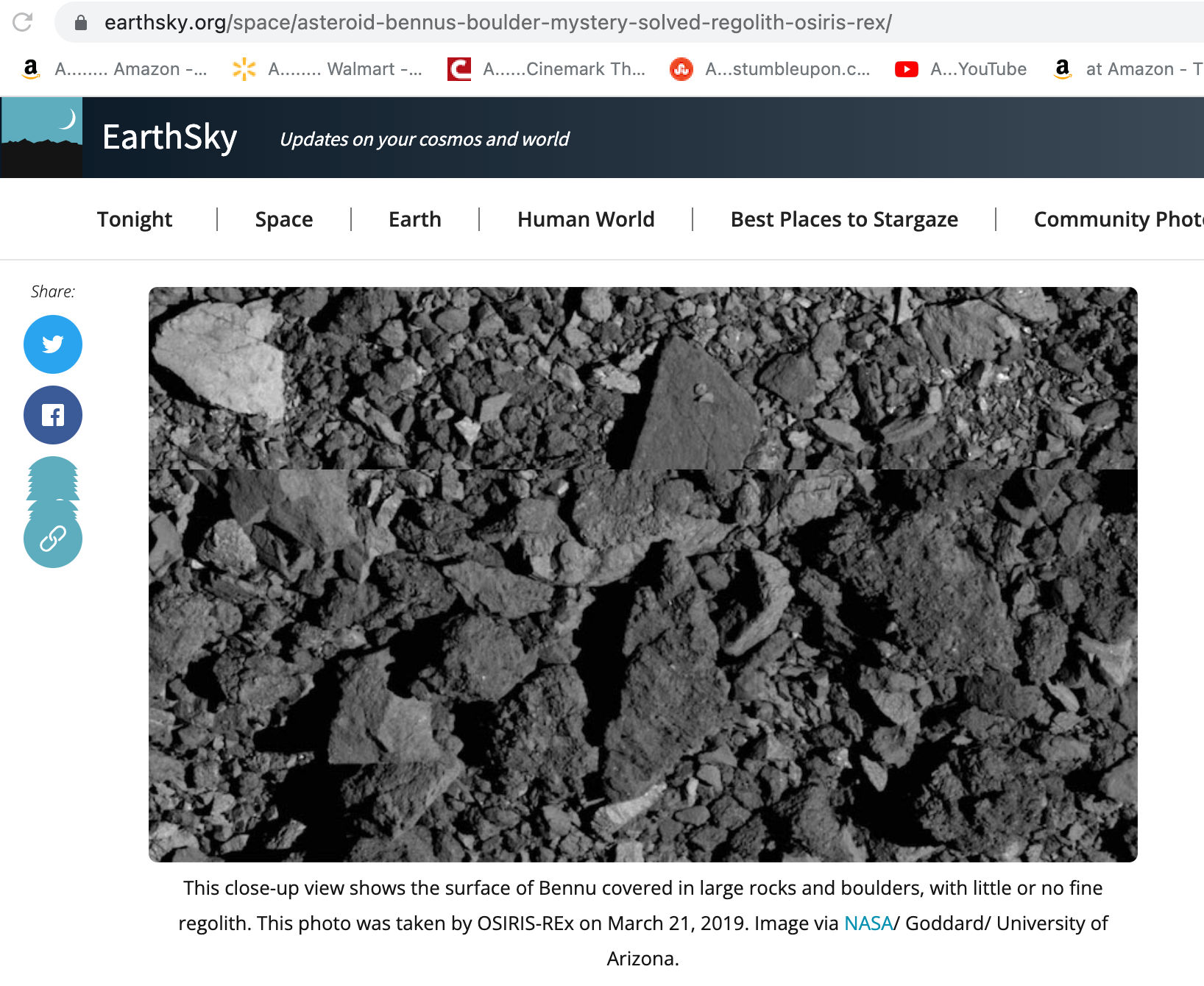
Excerpt:
Why does near-Earth asteroid Bennu have so many boulders on its surface? Prior to late 2018, when NASA’s visiting spacecraft OSIRIS-REx visited Bennu, scientists expected the asteroid to have a surface entirely or partly coated in a fine regolith of sand and pebbles. In fact, the REx in OSIRIS-REx stands for Regolith Explorer. But OSIRIS-REx found Bennu’s surface strewn with boulders and large rocks. This month (October 21, 2021), scientists announced they might now have an answer to asteroid Bennu’s boulder mystery.
The new study, published in the peer-reviewed journal Nature on October 6, 2021, comes from the University of Arizona. The study suggests that porous rocks are responsible for the lack of fine regolith on Bunnu’s surface.
Asteroid Bennu’s boulder mystery: rocks but no sand
Scientists had thought Bennu would be covered in fine regolith. Close-up images from a spacecraft showed it nearly completely covered in large boulders. How could that be? As co-author and OSIRIS-REx Principal Investigator Dante Lauretta explained in a NASA statement:
… Mapping and characterizing the surface of the asteroid was a main goal. The spacecraft collected very high-resolution data for Bennu’s entire surface, which was down to 3 millimeters [1/10 inch] per pixel at some locations. Beyond scientific interest, the lack of fine regolith became a challenge for the mission itself, because the spacecraft was designed to collect such material...
(Please read this full article at the URL posted above)
Tour of Asteroid Bennu
https://www.youtube.com/watch?v=QunVAWABQSc
- -
ref: All of our articles on Bennu here -
https://flatearthlunacy.com/index.php/2-uncategorised/1424-flat-earth-not-flatearthlunacy-articles-for-reference-s#S47
- - - - - - - - - - - - - - - - - - - - - - - - - - - - - - - - - - - - - - - - - - - - -
Posted on October 27, 2021
Recommended Book -
How to Talk to a Science Denier: Conversations with Flat Earthers, Climate Deniers, and Others Who Defy Reason, by Lee McIntyre
https://www.amazon.com/How-Talk-Science-Denier-Conversations/dp/0262046105
It's time to escape your self-constructed world of pretend (science denial) and join reality...

-

How to Talk to a Science Denier - with Lee McIntyre, by The Royal Institution
https://www.youtube.com/watch?v=D1VG2ohQSy0
Many people reject scientific expertise and prefer ideology to facts. Lee McIntyre argues that anyone can and should fight back against science deniers.
Watch the Q&A: https://youtu.be/2jTiXCLzMv4
Lee's book "How to Talk to a Science Denier" is out now: https://geni.us/leemcintyre
“Climate change is a hoax—and so is coronavirus.” “Vaccines are bad for you.” Many people may believe such statements, but how can scientists and informed citizens convince these 'science deniers' that their beliefs are mistaken?
Join Lee McIntyre as he draws on his own experience, including a visit to a Flat Earth convention as well as academic research, to explain the common themes of science denialism.
Lee McIntyre is a Research Fellow at the Center for Philosophy and History of Science at Boston University and an Instructor in Ethics at Harvard Extension School. He holds a B.A. from Wesleyan University and a Ph.D. in Philosophy from the University of Michigan (Ann Arbor). He has taught philosophy at Colgate University (where he won the Fraternity and Sorority Faculty Award for Excellence in Teaching Philosophy), Boston University, Tufts Experimental College, Simmons College, and Harvard Extension School (where he received the Dean’s Letter of Commendation for Distinguished Teaching). Formerly Executive Director of the Institute for Quantitative Social Science at Harvard University, he has also served as a policy advisor to the Executive Dean of the Faculty of Arts and Sciences at Harvard and as Associate Editor in the Research Department of the Federal Reserve Bank of Boston.
This talk was recorded on 24 August 2021.
Excerpt:
Technique rebuttal – based on the idea that all science denial is the same, whether you’re a flat earther or a climate denier or COVID denier, any of them. They all reason in the same way. Obviously there are different content in their beliefs but the strategy that they go through is precisely the same.
The five tropes:
Science deniers always cherry pick evidence, believe in conspiracy theories, rely on fake experts and denigrate real experts, engage in illogical reasoning, and insists that science has to be perfect.
(Please watch the video at the URL posted above).
- - -
Talking to a Science Denier | Faulty Reasoning, by Bob the Science Guy
https://www.youtube.com/watch?v=PZANcuS7vmM
The 4th Common Characteristic of all Science Deniers is faulting scientific reasoning. This goes toward the two kinds of rebuttal, topic rebuttal and technique rebuttal. Science Deniers HAVE been instructed in the correct information, due in part to faulty reasoning, they a/ don't accept the evidence and b/ cannot properly integrate information they already possess. In this video we see 10thman demonstrate poor scientific reasoning, egged on by Nathan Oakley. Bob dissects him.
- - -
Talking to a Science Denier | Fake Experts, by Bob the Science Guy
https://www.youtube.com/watch?v=7LX3CMIw3WE
Taking a lesson from the marketing of cigarettes, Science Deniers attempt to counter actual science by presenting 'fake experts' to promote their narrative as 'alternative facts'.
- - -
Talking to a Science Denier | Certainty of Science, by Bob the Science Guy
https://www.youtube.com/watch?v=EsXFvDkezZQ
In this episode, we look at the certainty of science as one of the 5 tropes or characteristics of science denial. Dr. McIntyre looks at the unreasonable expectations of proof demanded by those that never did science themselves.
- - -
Science Denial | The Common Script, by Bob the Science Guy
https://www.youtube.com/watch?v=fFuf6BxEiLE
Much like the 'Hero's Journey' is a common script outline (see Star Wars), the 'Tobacco Strategy' is used my many science deniers to promote their causes. When you see the elements of the script, you will be able to pick them out in science denial arguments.
Deny the Evidence
Claim Bias
Put forth your own experts/evidence
Say all the evidence isn't available
Create Doubt in the Science
Demand Strict Proof with no alternatives
Give people an excuse to lie to themselves
'A Frank Statement to Smokers'
https://en.wikipedia.org/wiki/A_Frank...
Note that the physician ad was from the 1930's but makes the point.
Link to summary video by Dr. McIntyre- https://youtu.be/D1VG2ohQSy0
Dr. McIntyre's Book- https://mitpress.mit.edu/books/how-ta...
- - -
The Conspiratorial Mindset and Evidence, by Bob the Science Guy
https://www.youtube.com/watch?v=WSsqPrdOmmU
Why is the flat earth still a thing? Because they will not and cannot accept actual evidence and facts that disagree with their conspiratorial narrative. Here are a number of examples from Bob the Science Guy.
- - -
Talking to Science Deniers | Cherry Picking, by Bob the Science Guy
https://www.youtube.com/watch?v=BK5pwyfSj40
Bob says...
Dr. McIntyre came to the conclusion that the flat earth is indeed a danger. He found four reasons for this:
1. Flat earth is anti-education. It foments distrust in science and technology. It reinforces conspiratorial thinking in matters that actually do have very significant impact on our society, such as the anti-vax movement. And finally, it is a stated goal of many flat earther’s, to infiltrate education, and not just in the United States, but in the United Kingdom and elsewhere in the world. And flat earthers and children are very concerning. We’ve got self-admitted flat earthers claiming to have gone on to the internet pretending to be children, to talk flat earth to other children. We’ve also seen them go to elementary schools and try and hand out flat earth literature. This actually resulted in law enforcement taking action against that flat earther.
But that was just identifying the problem. Now we’re going to go to the next stage and that is to look at the techniques used by science denial conspiracy theorists to try and counter evidence of the world around them.
So let’s que up the music, and learn about the five tropes of science denial.
The five tropes:
Science deniers always cherry pick evidence, believe in conspiracy theories, rely on fake experts and denigrate real experts, engage in illogical reasoning, and insists that science has to be perfect.
- - -
Talking to Science Denier The Dinner, by Bob the Science Guy
https://www.youtube.com/watch?v=9Qamd2K8czo
In the second of a multipart series, we examine the work of Dr. Lee McIntyre, a researcher into the philosophy of science, who has been studying the Science Denial Community. His book "How to Talk to a Science Denier" is available for download on Kindle and is a fascinating read. Part 2: Dr. McIntyre has dinner and a one on one discussion with one of the presenters from FEIC 2018
- - -
How We Know the Earth Is Round | FLERFPRATT 1, by Martymer 81
https://www.youtube.com/watch?v=ybiiw8piigY
Welcome to FLERFRPRATT: Flat Earth Points Refuted A Thousand Times. In this series, I debunk the tired old claims of Flat-Earthers, in the hopes that people will learn some science by watching the train wreck. In this part, I address the claim that there is no evidence in support of the spherical Earth, in other words, "show me the cuvature!"
- - -
Islam and the SHAPE of the EARTH, by Bob the Science Guy
https://www.youtube.com/watch?v=M91o1hu_U_U
Islamic Astronomers have been determining the size and shape of the earth for over 1000 years. This was a critical skill for Muslims, who are required to pray in the direction of Mecca five times a day. It is essential to be able to determine this direction, the Qibla, to properly practice their religion. They developed ingenious ways to find the great circle distance and bearing.
- - - - - - - - - - - - - - - - - - - - - - - - - - - - - - - - - - - - - - - - - - - - -
Posted on October 26, 2021
Galileo (satellite navigation) for Europe
https://en.wikipedia.org/wiki/Galileo_(satellite_navigation)
Galileo is a global navigation satellite system (GNSS) that went live in 2016, created by the European Union through the European Space Agency (ESA), operated by the European Union Agency for the Space Programme (EUSPA), headquartered in Prague, Czech Republic, with two ground operations centres in Fucino, Italy, and Oberpfaffenhofen, Germany. The €10 billion project is named after the Italian astronomer Galileo Galilei. One of the aims of Galileo is to provide an independent high-precision positioning system so European nations do not have to rely on the US GPS, or the Russian GLONASS systems, which could be disabled or degraded by their operators at any time. The use of basic (lower-precision) Galileo services is free and open to everyone. The higher-precision capabilities will be available for free. Galileo is intended to provide horizontal and vertical position measurements within 1-metre precision, and better positioning services at higher latitudes than other positioning systems. Galileo is also to provide a new global search and rescue (SAR) function as part of the MEOSAR system.
Galileo: the first ten years (European Space Agency, ESA)
https://www.youtube.com/watch?v=HK_7PPFaa88
Europe’s own satellite navigation system, Galileo, has become the world’s most precise, delivering metre-level accuracy, available anywhere on Earth. It is also saving lives, relaying distress calls for search and rescue. Today there are 26 Galileo satellites in orbit 23 222 km over our heads; the first of them were launched on 21 October 2011, with nine more launches in the following years. The satellites in space are supported by a globe-spanning ground segment. The system as a whole is set to grow, with the first of 12 ‘Batch 3’ about to join the current satellites in orbit and new ‘Galileo Second Generation’ satellites in development.
The world's most precise satellite navigation system.
Processing metre-level accuracy, available anywhere on Earth.
And saving lives, relaying distress calls for search and rescue.
Europe's own satellite navigation system.
26 satellites, 23,222 km over our heads.
10 launches starting 10 years ago.
The satellites in space join a globe-spanning ground segment keeping the Galileo time at the heart of the system accurate to a few billionth's of a second.
- - - - - - - - - - - - - - - - - - - - - - - - - - - - - - - - - - - - - - - - - - - - -
Posted on October 24, 2021
Recreating the Cavendish experiment, by BlueMarbleScience
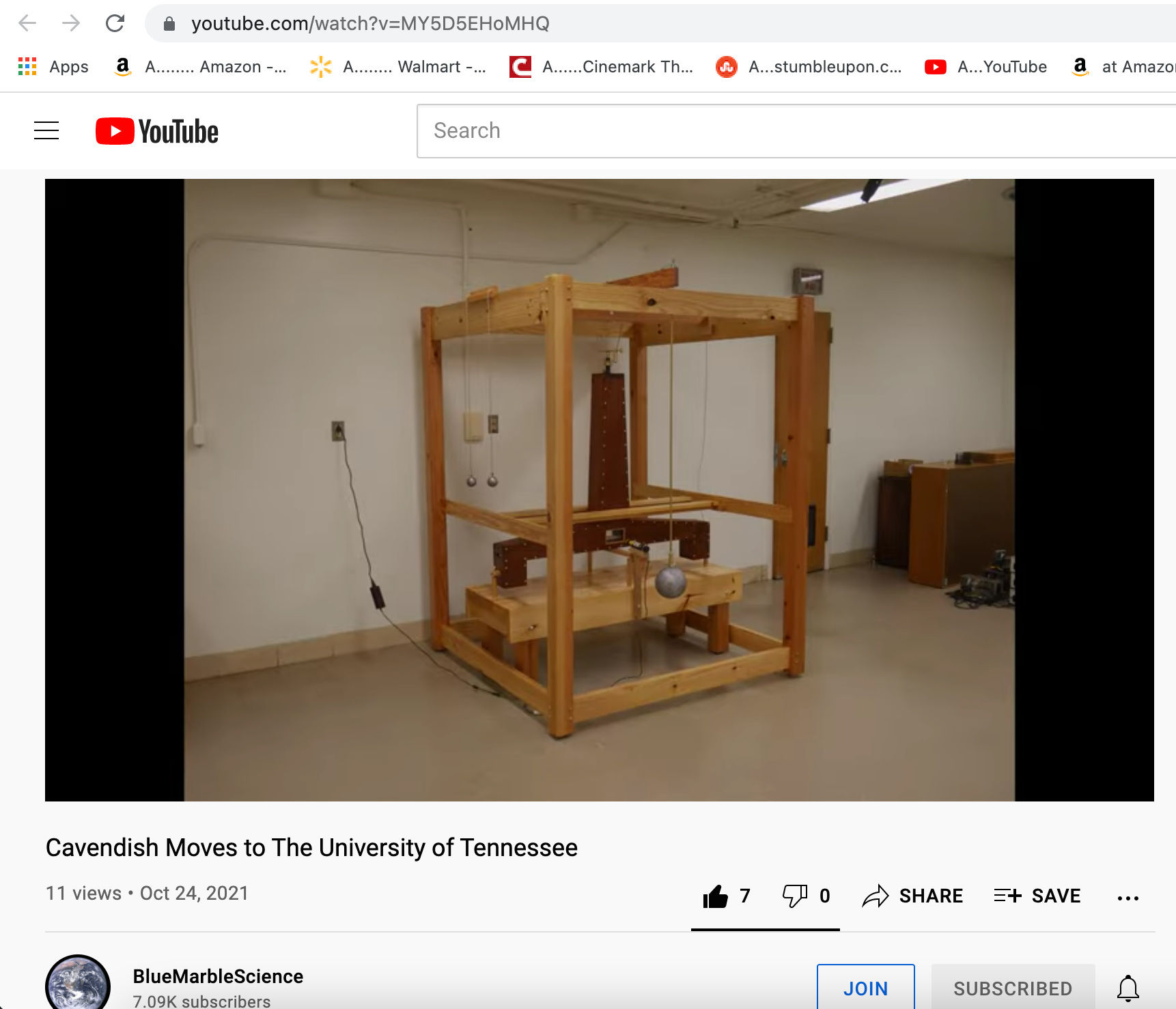
Cavendish Animation: https://www.youtube.com/watch?v=vWlCm...
This animation depicts a modern version of the Cavendish experiment, where a twist of a wire measured by a deflecting beam of light helps determine the force of gravitational attraction between masses.
The Cavendish Calculations
In this video, we go through the methodology used by Henry Cavendish to measure the density of the earth. Warning - math ahead! Link to the original Cavendish paper: https://royalsocietypublishing.org/do...
The Cavendish Experiment – Introduction, by BlueMarbleScience
https://www.youtube.com/watch?v=PUo-cvIhTQg
Cavendish Episode 1, by BlueMarbleScience
https://www.youtube.com/watch?v=lO6kmywkMbU
Cavendish Episode 2, by BlueMarbleScience
https://www.youtube.com/watch?v=LX7jCZcQk14
Cavendish Episode 3, by BlueMarbleScience
https://www.youtube.com/watch?v=wScflszTzs4
Construction Episode 1 (Edited Version)
https://www.youtube.com/watch?v=yNtbkk44eM8
Cavendish Episode 3, by BlueMarbleScience
https://www.youtube.com/watch?v=wScflszTzs4&t=56s
Cavendish Episode 4, by BlueMarbleScience
https://www.youtube.com/watch?v=Z4fZzol97JE
Cavendish Episode 5, by BlueMarbleScience
https://www.youtube.com/watch?v=qJzva8WfnLU
Cavendish Episode 6, by BlueMarbleScience
https://www.youtube.com/watch?v=8UOxsL6kSuI
Cavendish – Calculating the Universal Gravitational Constant “G”
https://www.youtube.com/watch?v=W2uPNg1BUSI
BlueMarbleScience Live
https://www.youtube.com/watch?v=hrymt19OulE
330g small masses with 0.007" torsion wire and copper foil static shielding and brass hanger rods installed. Measurements of "G" 2/25/21
Cavendish Testing – Part 1
https://www.youtube.com/watch?v=xAL1o5WajQg
Welcome to Part 1 of the testing phase of the experiment. A fourteen test series has yielded a value for "G" within 1% of the accepted value. Not too bad, even if I do say so!
Cavendish Testing – Part 2
https://www.youtube.com/watch?v=eeW_cXyqm7A
BlueMarbleScience Live – Final Observations with the BeCu Wire!
https://www.youtube.com/watch?v=4qBzgqk5fwc
Cavendish Moves to The University of Tennessee, by BlueMarbleScience
https://www.youtube.com/watch?v=MY5D5EHoMHQ
-
Flat Earth is Scared … of Gravity
https://www.youtube.com/watch?v=7Gqj7gPswAk
-
The Cavendish Experiment Repearted, by Blue Marble Science
115 pages detailing the orginal Cavendish work and results, along with the repeat by Blue Marble Science
https://drive.google.com/file/d/1Il4cfKVZNdTiEw8DgIH4dUPHNgTwu_aP/view
- - - - - - - - - - - - - - - - - - - - - - - - - - - - - - - - - - - - - - - - - - - - -
Posted on October 21, 2021
What did this F16 pilot say again?
From Wolfie6020
https://www.youtube.com/watch?v=vkr4KZg8IpI
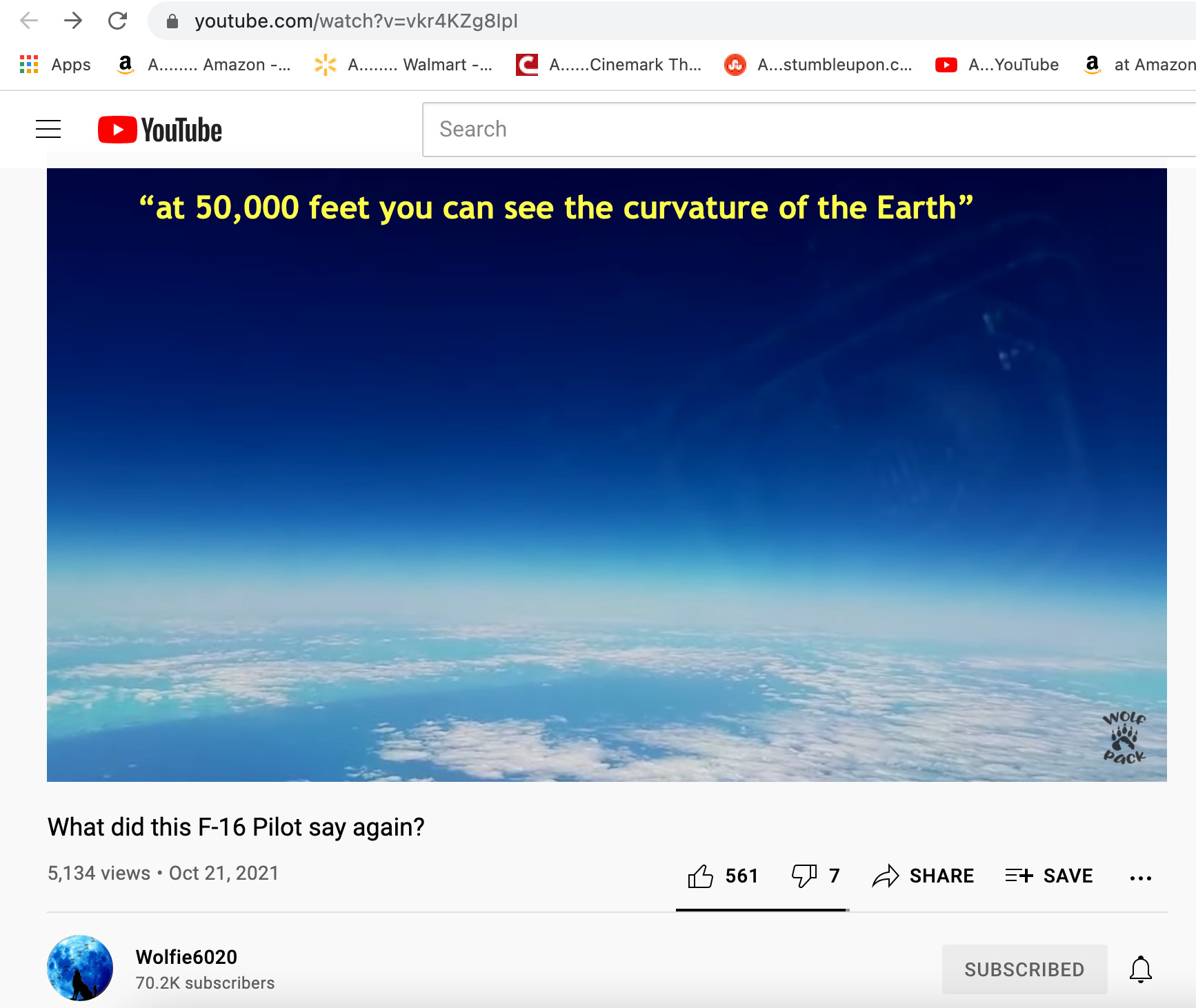
- - - - - - - - - - - - - - - - - - - - - - - - - - - - - - - - - - - - - - - - - - - - -
Posted on October 18, 2021
Spacecraft Lucy is off to visit the asteroid belt.
Lucy's Journey (NASA Goddard)
https://www.youtube.com/watch?v=5ZMcdg1WyXs
Meet Lucy as she prepares for the first ever journey to the Trojan asteroids, a population of primitive small bodies orbiting in tandem with Jupiter.
Video credit: NASA's Goddard Space Flight Center
- - - - - - - - - - - - - - - - - - - - - - - - - - - - - - - - - - - - - - - - - - - - -
Posted on October 17, 2021
Star Trek Captain James T. Kirk (William Shatner) travels to space on the Blue Origin
William Shatner and Blue Origin’s Audrey Powers to fly on New Shepard’s 18th mission
https://www.blueorigin.com/news/shatner-powers-announced-ns18

William Shatner
William Shatner’s career as an actor, director, producer, writer, recording artist, and horseman has spanned 60 years. He originated the role of “Captain James T. Kirk” in 1966 for the television series Star Trek. The series spawned a feature film franchise where he returned as Captain Kirk in seven of the Star Trek movies, one of which he directed. He has long wanted to travel to space and will become the oldest person to have flown to space.
William is currently the host and executive producer of The UnXplained on The History Channel. From the producers of Ancient Aliens and The Curse of Oak Island, the one-hour, non-fiction series explores the world’s most fascinating, strange and inexplicable mysteries.
“I’ve heard about space for a long time now. I’m taking the opportunity to see it for myself. What a miracle,” said William Shatner.
Audrey Powers
Audrey Powers joined Blue Origin in 2013 and oversees all New Shepard flight operations, vehicle maintenance, and launch, landing, and ground support infrastructure. In collaboration with New Shepard’s Safety & Mission Assurance team, Test & Flight Operations, Chief Engineers, and external partners, she played a lead role in the multi-year process to certify New Shepard for human flight. Prior to leading New Shepard’s Mission and Flight Operations team, she served as Deputy General Counsel and Vice President of Legal & Compliance for Blue Origin, overseeing a wide variety of legal, regulatory and policy matters.
Audrey worked as an engineer for almost a decade before becoming a lawyer. As a guidance and controls engineer, she was a flight controller for NASA with 2,000 hours of console time in Mission Control for the International Space Station Program. In addition to serving as executive sponsor of Blue Origin’s New Mercury gender diversity business resource group, she is a pilot and serves as the Chair of the Board of Directors of the Commercial Spaceflight Federation.
“I’m so proud and humbled to fly on behalf of Team Blue, and I’m excited to continue writing Blue’s human spaceflight history,” said Audrey Powers. “I was part of the amazing effort we assembled for New Shepard’s Human Flight Certification Review, a years-long initiative completed in July 2021. As an engineer and lawyer with more than two decades of experience in the aerospace industry, I have great confidence in our New Shepard team and the vehicle we’ve developed.”
(Please read the article in full posted at the URL above. Visit (blueorigin.com)
- - -
William Shatner Completes his Trip to Space With Blue Origin, by Matt Williams (universetoday.com)
https://www.universetoday.com/152959/william-shatner-completes-his-trip-to-space-with-blue-origin/
After traveling to the edge of space this week, William Shatner and the crew of the NS-18 mission made it back to Earth safe and sound. This was the second time Blue Origin’s New Shepard launch vehicle flew to space with a crew aboard, and as with the inaugural flight, Blue Origin founder Jeff Bezos decided to enlist some star power! Who better than the man known to millions of fans as James Tiberius Kirk, Captain of the starship Enterprise?
At 90 years of age, the veteran actor of television, film, and stage is the oldest person to fly to space. The previous record was held by 82-year old veteran aviator Wally Funk, who went to space as part of the first crewed flight of the New Shepard on July 20th. Along with his fellow crewmembers, Shatner’s experienced what it’s like to go to space for the first time from the company’s Launch Site One facility in West Texas.
On Wednesday, Oct. 13th, the flight took place at 09:49 AM local time (10:49 AM EST; 07:49 AM PST) and saw the RSS First Step space capsule ascend beyond the Kármán Line – the official boundary of space, 100 km (62 mi) in altitude. And of course, the entire experience was caught on film, particularly the five minutes where the crew of four were weightless and looked out at Earth’s horizon from space...
Meet the NS-18 Crew - https://www.youtube.com/watch?v=fNlc8s-Z4A4
Still reliving all of the emotions and wonder of our second human flight yesterday. - https://twitter.com/blueorigin/status/1448751792456704017
(Please read the article and watch the videos at the posted URL above.)
- - - - - - - - - - - - - - - - - - - - - - - - - - - - - - - - - - - - - - - - - - - - -
Posted on October 14, 2021
Jeran Campanella (aka Jeranism): As an absolute failure unable to find the flat Earth edge (only curvature found), he is now hawking for cryptocurrency.
These folks are not CFP® professionals ("certified financial planners").
CERTIFIED FINANCIAL PLANNER™ certification is the standard of excellence in financial planning. CFP® professionals meet rigorous education, training and ethical standards, and are committed to serving their clients' best interests.

Jeran Campanella - ex drug store manager turned flat Earther.
jeranism (Jeran Campanella) - flat Earth advocate FAIL
Captain Caprice -
Morgan -
Nathan Stolpman - Lift the Veil (Nathan Stolpman)
-
Times are now rough for Jeran (jeranism.com/support/). Maybe this is the way for the unskilled to make money (rather than get a real job)? ...
"Hello! Thanks for visiting my support page. I can’t thank you enough for considering supporting my efforts, nor can I express my extreme gratitude to those who have already supported.
With YouTube now demonetizing, delisting and hiding flat earth and conspiracy related content, I’ve never needed your support more than I do now. I used to be an Amazon Affiliate but last year, Amazon removed my account with no warnings, just an email saying they were ending the relationship and terminating my account. Shortly after that, I was banned by PayPal as well, so I can no longer accept donations or use any of their banking features. This was also done with no reason other than them stating that they no longer wished to do business with me. Most recently dLive “Home of the cucks” has demonetized my channel and no longer allows me to accept donations on their platform.
So, as time goes on, the ways of supporting me are reducing. However, there are still ways you can donate or support if you choose to, especially with the rise of cryptocurrencies. The donation methods are for those people who enjoy my work, recognize my honesty, appreciate it and wish to help fund my continued journey. The best way to support my channel, this website and the work I continue to do is to become a Patron here. You will instantly receive access to this entire website and all the content on it as well as be able to message me through the Patreon app or website. If looking for just a simple monthly donation or a one-time donation, doing so with your credit card is also available by clicking here.
I enjoy making videos and providing live streams to an appreciative and growing audience but it doesn’t pay the bills. YouTube continues to issue strikes and demonetize videos that go against the mainstream narrative. As you know, that includes almost all of what I do. Asking questions that others are afraid to ask. Patreon allows me to reach out to you, the individual viewer to ask for support. That support will allow me to continue providing you with the content you enjoy. I thank you for whatever support you can give."
- - - - - - - - - - - - - - - - - - - - - - - - - - - - - - - - - - - - - - - - - - - - -
Posted on October 13, 2021
Other than flat-out denial, how do Flat Earthers explain the presence of meteors and asteroids?
I don't think I have ever heard a flat urf explanation for asteroids.
From Debunking Flat Earth…
It's rarely addressed but I have seen several flerfs claim shooting stars are angels or pieces of the firmament falling to Earth. This includes metal rich meteorites and more famously, The Blue Stone Hoax.
This bright blue rock was claimed to be a piece of the firmament; extremely “oxygen" rich with other unusual properties not explainable by science. The owner of the blue rock would not let an actual specialist or university examine the rock. And when he finally did, it was found to be obviously painted plaster.
Silly flerfs still occasionally promote the photos of the blue rock to this day with the claim and to no one's surprise, that the “actual truth" is a government cover up.
From Karl Sangree…
I have heard everything from fallen angels to military weapons testing.
Most flat earthers do not believe in meteorites because they do not believe in space, the place meteors come from. The alleged dome that covers the flat Earth would prevent any objects from striking the Earth. With that in mind, flat earthers have to come up with an alternative explanation, and some are real doozies.
FEs that translate the Bible literally tend to think meteorites are angles that god cast down from heaven. Secular FEs and conspiracy nuts tend to explain meteorites as secret high altitude military high-energy weapons.
-
Astronomers Capture Images of 42 Large Main-Belt Asteroids (sci-news.com)
http://www.sci-news.com/astronomy/large-main-belt-asteroids-10163.html
Using the Spectro-Polarimetric High-contrast Exoplanet REsearch (SPHERE) instrument mounted on ESO’s Very Large Telescope (VLT), astronomers have conducted a high-angular-resolution imaging survey of 42 large asteroids in the main asteroid belt, located between Mars and Jupiter. Their results appear in the journal Astronomy & Astrophysics.
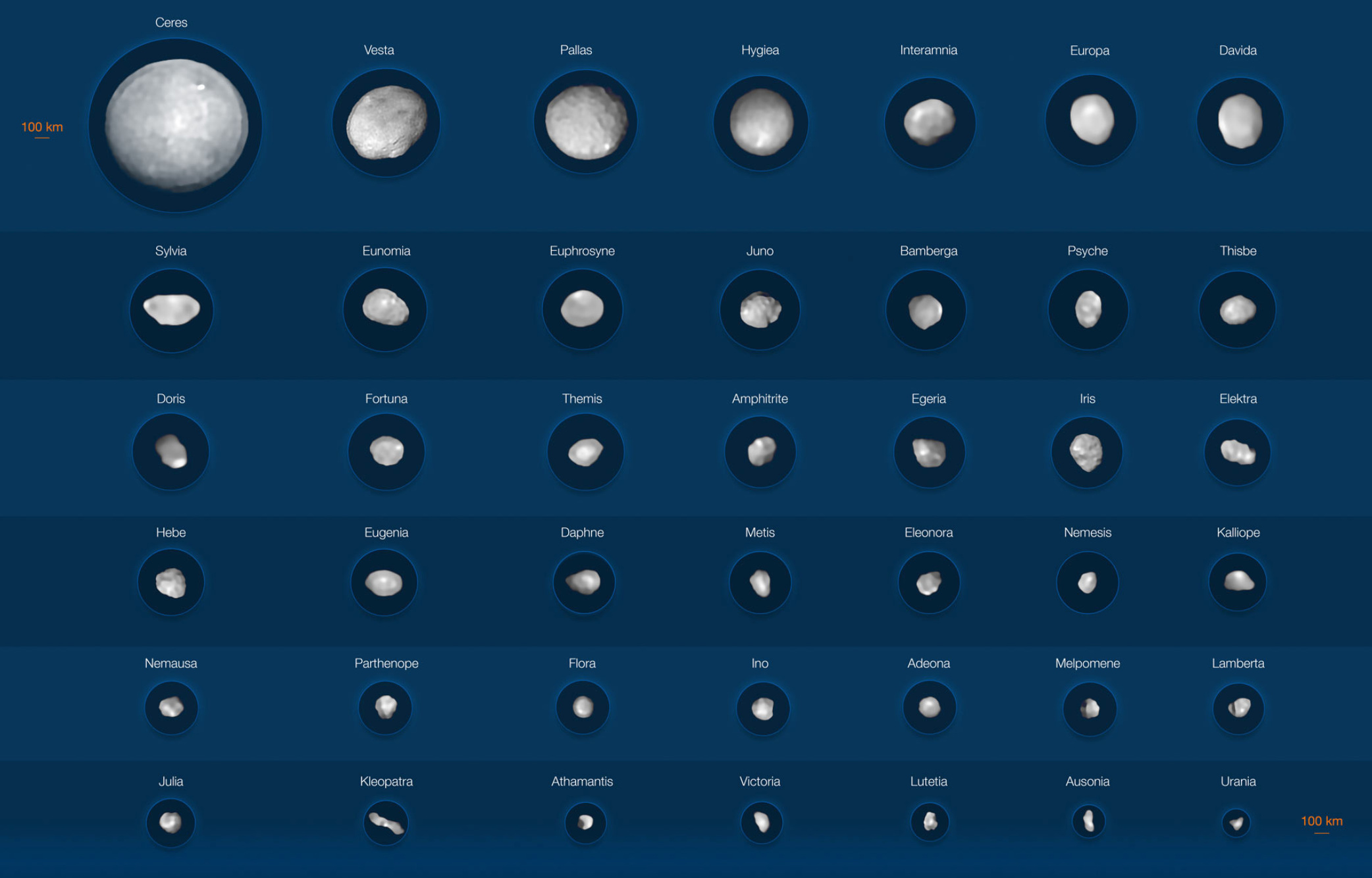

“Only three large main belt asteroids, Ceres, Vesta and Lutetia, have been imaged with a high level of detail so far, as they were visited by NASA’s Dawn and ESO’s Rosetta space missions, respectively,” said Dr. Pierre Vernazza, an astronomer at the Laboratoire d’Astrophysique de Marseille.
“Our ESO observations have provided sharp images for many more targets, 42 in total.”
Most of the 42 objects are larger than 100 km (62 miles) in size; in particular, the astronomers imaged nearly all of the belt asteroids larger than 200 km (124 miles), 20 out of 23 asteroids.
The two biggest objects they probed were Ceres and Vesta, which are around 940 km (584 miles) and 520 km (323 miles) in diameter, whereas the two smallest asteroids are Urania and Ausonia, each only about 90 km (56 miles).
By reconstructing the objects’ shapes, the team realized that the observed asteroids are mainly divided into two families.
Some are almost perfectly spherical, such as Hygiea and Ceres, while others have a more peculiar, ‘elongated’ shape, their undisputed queen being the ‘dog-bone’ asteroid Kleopatra.
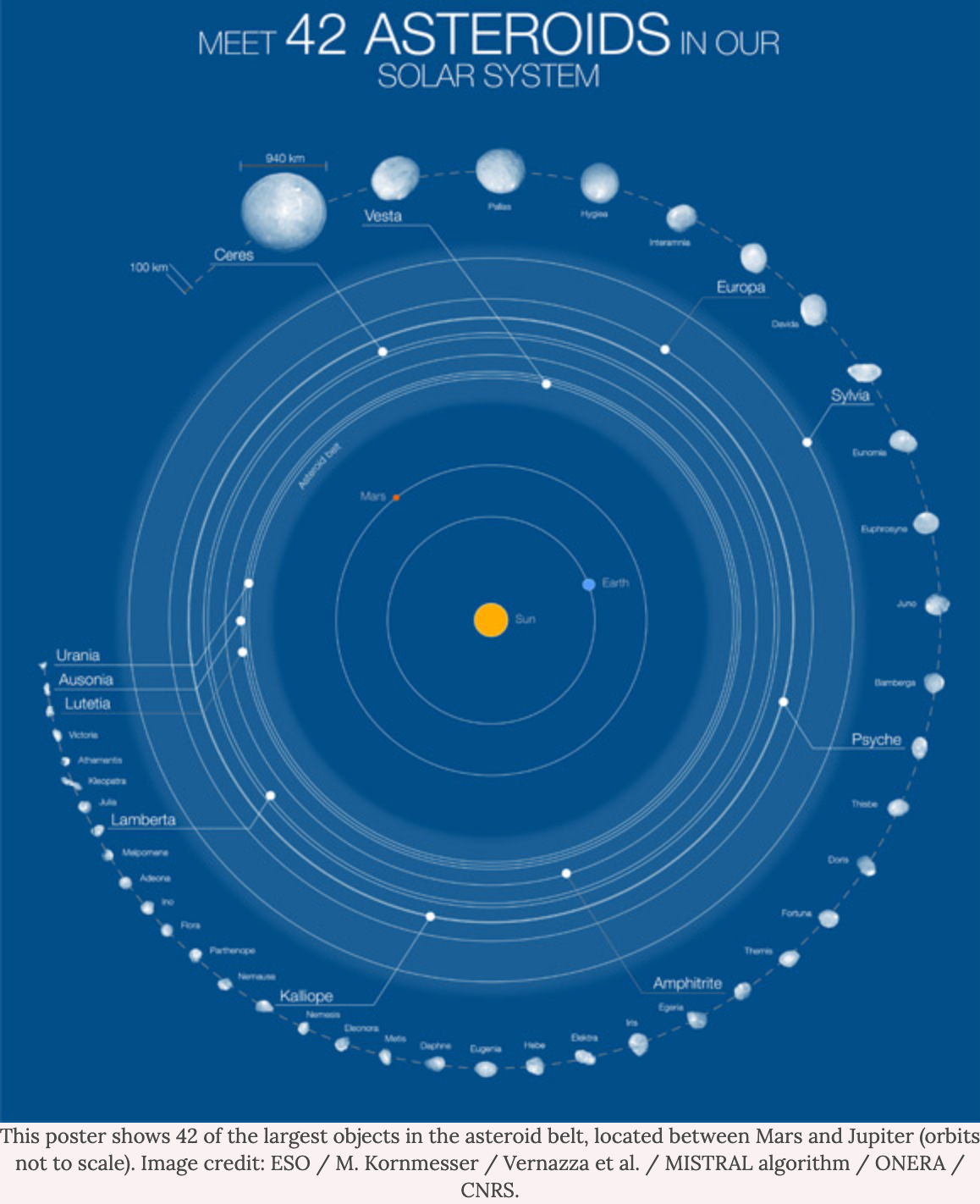
(Please read the entire article as referenced in the URL above)
-
What happens when a meteor hits the upper atmosphere?, by Jorge Salazar (phys.org)
https://phys.org/news/2021-10-meteor-atmosphere.html
In the heavens above, it's raining dirt.
Every second, millions of pieces of dirt that are smaller than a grain of sand strike Earth's upper atmosphere. At about 100 kilometers altitude, bits of dust, mainly debris from asteroid collisions, zing through the sky vaporizing as they go 10 to 100 times the speed of a bullet. The bigger ones can make streaks in the sky, meteors that take our breath away.
Scientists are using supercomputers to help understand how tiny meteors, invisible to the naked eye, liberate electrons that can be detected by radar and can characterize the speed, direction and rate of meteor deceleration with high precision, allowing its origin to be determined. Because this falling space dust helps seed rain-making clouds, this basic research on meteors will help scientists more fully understand the chemistry of Earth's atmosphere. What's more, meteor composition helps astronomers characterize the space environment of our solar system.
Meteors play an important role in upper atmospheric science, not just for the Earth but for other planets as well. They allow scientists to be able to diagnose what's in the air using pulsed laser remote sensing lidar, which bounces off meteor dust to reveal the temperature, density, and the winds of the upper atmosphere.
Scientists also track with radar the plasma generated by meteors, determining how fast winds are moving in the upper atmosphere by how fast the plasma is pushed around. It's a region that's impossible to study with satellites, as the atmospheric drag at these altitudes will cause the spacecraft to re-enter the atmosphere.
The meteor research was published in June 2021 in the Journal of Geophysical Research: Space Physics of the American Geophysical Society...
(Please read the entire article as referenced in the URL above)
- - - - - - - - - - - - - - - - - - - - - - - - - - - - - - - - - - - - - - - - - - - - -
Posted on October 12, 2021
Flat Earth with David Weiss
https://rumble.com/vlvv92-episode-51-flat-earth-with-david-weiss.html
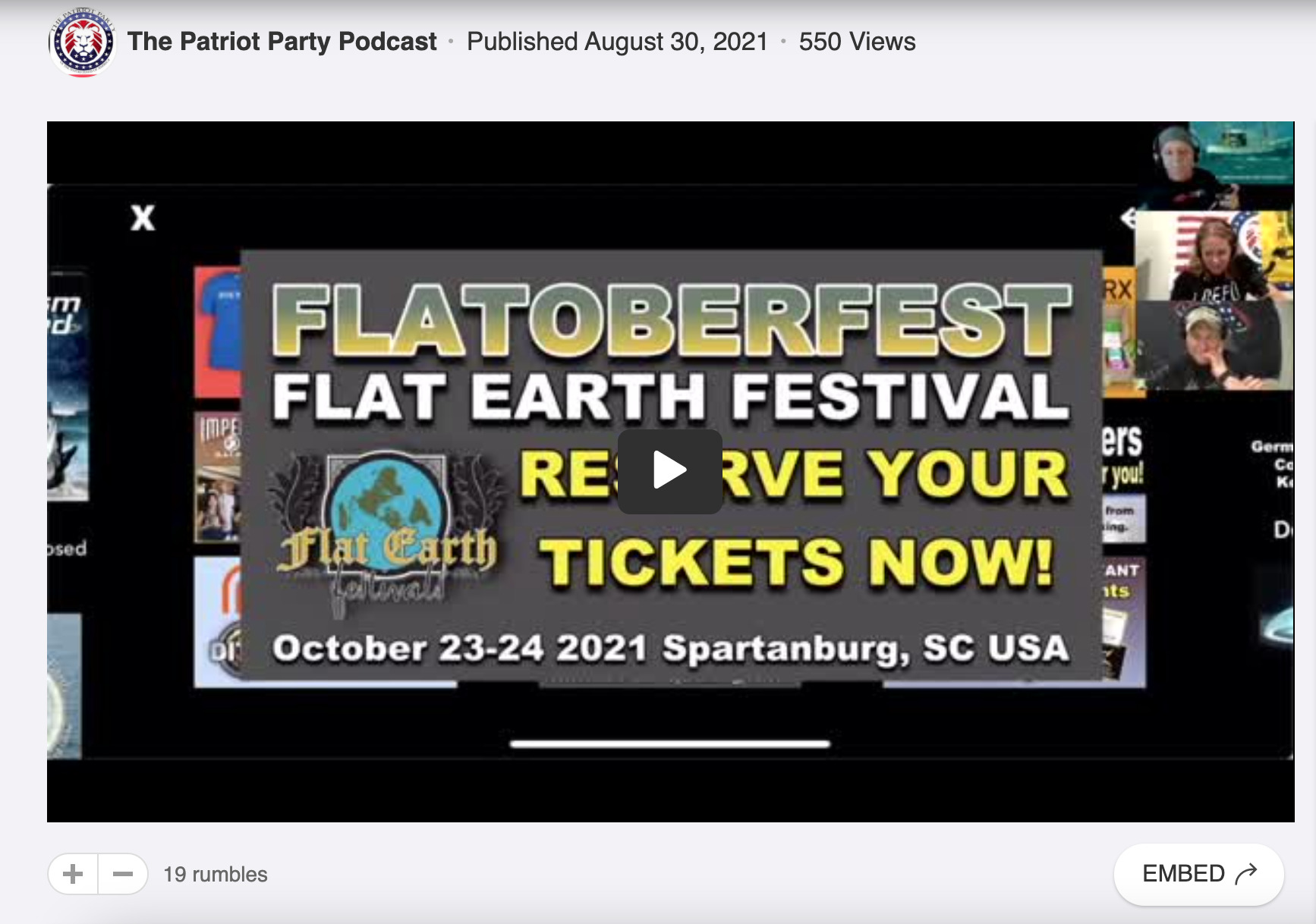
But be careful where the rabbit takes you...
David Weiss (DITRH) on Covid 1984, Facemasks, The Plandemic and a little FE
https://www.listennotes.com/podcasts/be-good-broadcast/david-weiss-ditrh-on-covid-iCYgKQna4wk/
At time mark 9:12, David says...
"You know, I was going to say we're in this situation because people will believe anything. You don’t know where your feet are planted. You think you’re spinning lost in space. You can be convinced that a non-symptomatic virus is going to jump from you, anyone closer that 5 feet 11 inches away, they’re going to get sick. You’ll believe anything. But if you have your feet planted, you know who you are, or what you are. Here’s the funny thing, there’s millions of flat earthers now, none of them have fallen for the COVID HOAX..."
-
More about that rabbit...
Delusions come in many forms, but they all have one thing in common: The people affected by them can’t be convinced that something they believe isn’t true. Those unshakeable beliefs are different from person to person and affect different parts of their lives.
ref: DITRH (David Weiss) - flat earth advocate FAIL
- - - - - - - - - - - - - - - - - - - - - - - - - - - - - - - - - - - - - - - - - - - - -
Posted on October 11, 2021
We hope that Rob Skiba feels better, overcomes COVID, and returns to good health ASAP.
Rob Skiba, 52, Dallas, TX, Author, Evangelical Flat-earther, Anti-vaxxer, on ventilator with COVID (sorryantivaxxer.com)
https://www.sorryantivaxxer.com/post/rob-skiba-52-dallas-tx-author-evangelical-flat-earther-anti-vaxxer-on-ventilator-with-covid#viewer-9tur1

-

-

-

- - -
Update: October 14, 2021:
Rob Skiba Obituary Dallas, TX, Author Rob Skiba Covid-19 Death (deaddeath.com)
https://deaddeath.com/death/rob-skiba-obituary-dallas-tx-author-rob-skiba-covid-19-death/
ref: Rob Skiba - flat Earth advocate FAIL
- - - - - - - - - - - - - - - - - - - - - - - - - - - - - - - - - - - - - - - - - - - - -
Posted on October 8, 2021
The interstellar cosmic ray mystery...
Did you know that space satellites and vehicles must shield their computers from cosmic rays?
Timing the decay of cosmic ray particles through the earth's atmosphere provided one of the best proofs of Einstein's theory.
Can cosmic rays affect computers?
Cosmic rays have created headaches in classical computing for decades. When these energetic particles fly in from space and strike a silicon computer chip, one or more bits in the chip may change state, or flip, in ways that programmers never intended.
Are cosmic rays harmful or helpful?
Sometimes, cosmic radiation does reach us, but without creating any harm, just like other low levels of radiation we are regularly exposed to. On average, people are exposed to around 3.5 millisieverts of radiation per year.
What are the effects of cosmic rays on Earth?
High-energy radiation from space, known as galactic cosmic rays, can affect Earth's climate by increasing cloud cover and causing an “umbrella effect”, according to scientists.
What damage can cosmic rays cause?
Therefore, cosmic rays would mimic the effect of aging, inducing a persistent state of sterile inflammation damaging DNA, proteins, and lipids the consequences of which are aging-related disease such as cardiovascular diseases, neurocognitive impairment, and increase of cancer occurrence.
Do cosmic rays have radiation?
Cosmic radiation is an ionizing radiation, as are radiation sources such as X-rays and that from radioactive materials. ... The amount of cosmic radiation that reaches the earth from the sun and outer space varies: its energy is effectively absorbed by the atmosphere and is also affected by the earth's magnetic field.
Can cosmic rays enter Earth?
Cosmic rays constantly rain down on Earth, and while the high-energy "primary" rays collide with atoms in the Earth's upper atmosphere and rarely make it through to the ground, "secondary" particles are ejected from this collision and do reach us on the ground.
Can you see cosmic rays on Earth?
Smashing into our atmosphere. When the particles in cosmic rays collide with the atoms in at the top of the atmosphere, they burst, tearing apart atoms in a violent collision. ... In this chamber, you can see the cosmic rays, particularly those from a particle called a muon. Muons are like electrons, but a bit heavier.
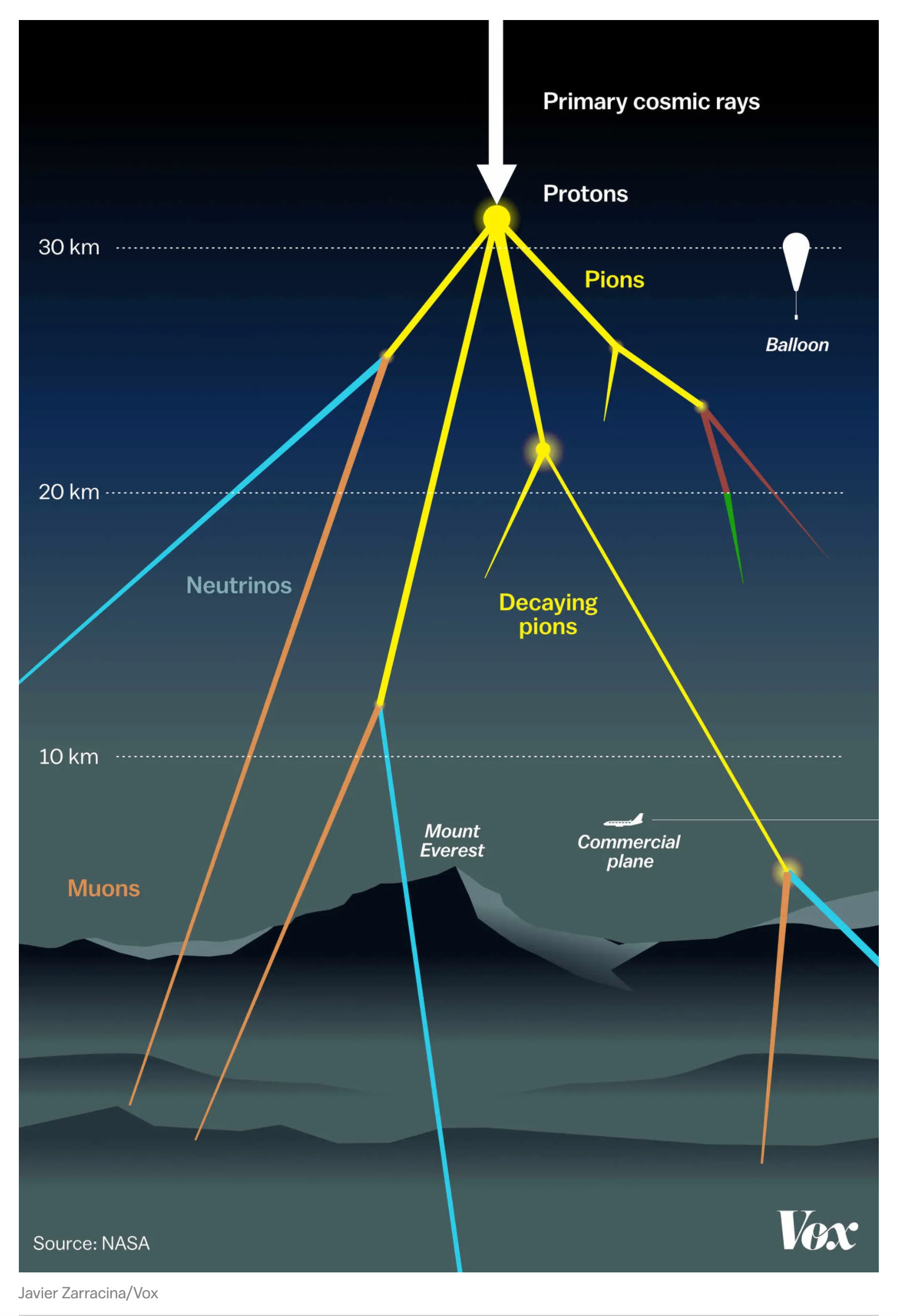
-
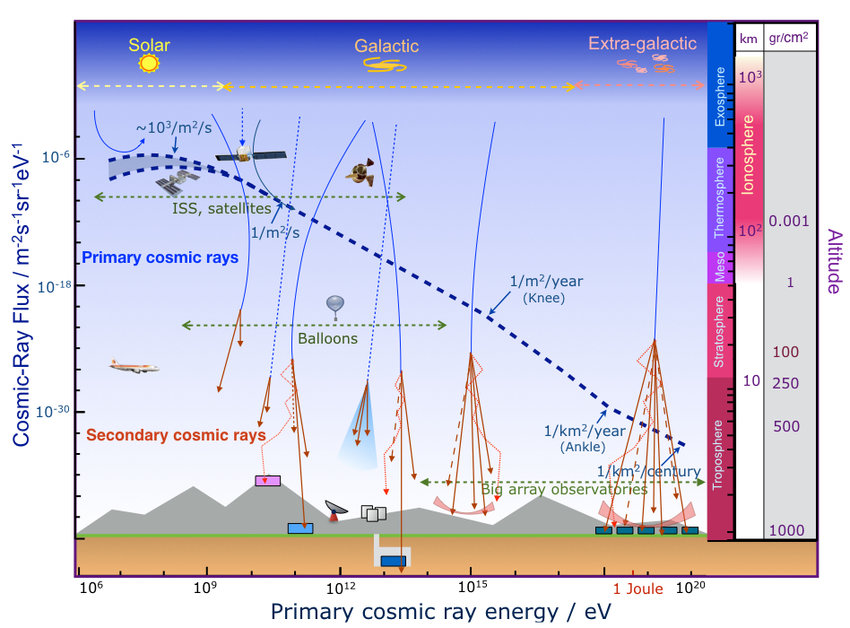
-
(https://en.wikipedia.org/wiki/Cosmic_ray)
Cosmic rays are high-energy protons and atomic nuclei that move through space at nearly the speed of light. They originate from the Sun, from outside of the Solar System in our own galaxy, and from distant galaxies. Upon impact with Earth's atmosphere, cosmic rays produce showers of secondary particles, some of which reach the surface; although the bulk is intercepted by the magnetosphere or the heliosphere.
Cosmic rays were discovered by Victor Hess in 1912 in balloon experiments, for which he won the 1936 Nobel Prize in Physics.
Direct measurement of cosmic rays, especially at lower energies, has been possible since the launch of the first satellites in the late 1950s. Particle detectors similar to those used in nuclear and high-energy physics are used on satellites and space probes for research into cosmic rays. Data from the Fermi Space Telescope (2013) have been interpreted as evidence that a significant fraction of primary cosmic rays originate from the supernova explosions of stars. Based on observations of neutrinos and gamma rays from blazar TXS 0506+056 in 2018, active galactic nuclei also appear to produce cosmic rays.
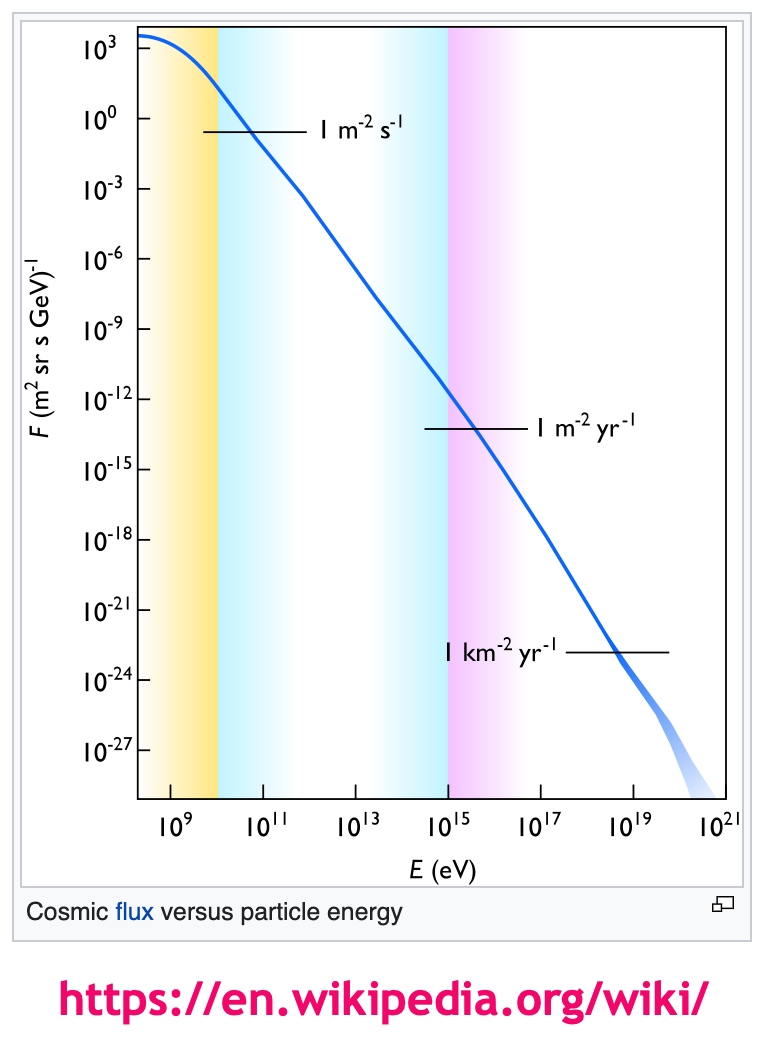
(Please read the articles posted at the URL's above)
- - -
Does The Axis Of Evil Scare You?, by The Action Lab
https://www.youtube.com/watch?v=yJ5wQF093Rc
I talk about the Axis of Evil and how it related to the cosmic microwave background.
Get Your Experiment Box Here: https://theactionlab.com/
Checkout my experiment book: https://amzn.to/2Wf07x1
- - - - - - - - - - - - - - - - - - - - - - - - - - - - - - - - - - - - - - - - - - - - -
Posted on October 7, 2021
We'll have to keep an eye on this one. Another publicity stunt by Eric Dubay, or for real?
Flat Earthers Now Plan To "Shut This Debate Down" By Getting To The "Outer Edges Of Earth" (triplem.com)
https://www.triplem.com.au/story/flat-earthers-now-plan-to-shut-this-debate-down-by-getting-to-the-outer-edges-of-earth-132004
Published on March 19, 2019 ...
After their last experiment went pear-shaped, Flat Earth supporters have announced an expedition to the "outer edges of flat earth" in order to "shut this debate down" once and for all.
An extremely in-depth report in Forbes saw journalist Jim Dobson speak to "dozens" of believers, one of whom - Jay Decasby - is in talks to develop his own reality TV series about his theory.
Decasby is also throwing his weight behind plan to sail to Antarctica to prove flat earth.
"All we have to do is shut this debate down once and for all is to get the distance of the coast of Antarctica," he told Forbes.
"It has been done by early sailors (before the UN was established and set up its Antarctic treaty essentially making it illegal for independent and private exploration of Antarctica) who managed to make 60k+ miles which irrefutably proves the flat earth model, but like all other mountains of evidence for flat earth this is not enough for ballers today.
"If we can get to the coast of Antarctica and sail all the way around it, we will get the distance that will prove it’s the outer edges of flat earth and refute entirely every single argument anyone can possibly try to pitch for the sun-worshipping cult of heliocentrism."
Make sense? Didn't think so.
Decasby continued: "They’ve made laws to not allow any kind of motorised equipment on the ice which would help us prove not only flat earth but what’s beyond the ice wall, but in reality, we don’t even need to get onto the ice to prove flat earth...
Here is the original Forbes article by Jim Dobson -
https://www.forbes.com/sites/jimdobson/2019/03/16/flat-earth-supporters-now-plan-an-antarctica-expedition-to-the-edge-of-the-world/?sh=66e350275916
"Robbie Davidson (who is not affiliated with the Flat Earth Society) is also organizing an enormous cruise in 2020 for flat-earthers to convene and discuss theories while continuing his popular yearly conventions around the country. His take on Antarctica is fueled by what he calls real exact science. "When we look at Antarctica if you take a globe and you squish it down, the Antarctic would go all the way around the Earth. It's kind of like an ice shore and it's very, very large. It's not like you just go there, and you can just peek over it. We don't believe anything can fall off the edge, because a big portion of the flat earth community believes that we're in a dome, like a snow globe. So the sun, moon, and stars are all inside. It's very high but all contained inside. So there's no way to actually fall off of the earth."
Update: October 2021:
We have found no information that Decasby or any flat Earther ever attempted the cross Antarctica trip they reported wanting to take.
- - -
What happened to this planned trip?
Why I’m spending three months sailing right around Antarctica for science (the converation.com). October 27, 2016
https://theconversation.com/why-im-spending-three-months-sailing-right-around-antarctica-for-science-67782
Spending three months inside a metal container on board an icebreaker in the Southern Ocean, filtering water while attempting to ignore freezing temperatures and huge ocean swells outside. It’s not everyone’s idea of fun … but it’s what I’ll be doing next year, in the name of climate science.
From late December 2016 to March 2017 I will be on board the Russian research vessel Akademik Treshnikov, taking part in an expedition that will take me and 54 other scientists from 30 countries on a complete lap of Antarctica – the first international research expedition to circumnavigate the frozen continent.
The Antarctic Circumnavigation Expedition (with the funky abbreviation ACE) is the first project run by the Swiss Polar Institute, and involves 22 projects covering different aspects of the biology, physics and chemistry of the Southern Ocean...
- - -
Antarctica's last 6 months were the coldest on record, by Allison Chinchar (ctvnews.ca)
https://www.ctvnews.ca/climate-and-environment/antarctica-s-last-6-months-were-the-coldest-on-record-1.5618090
Excerpt:
In a year of extreme heat, Antarctica's last six months were the coldest on record.
"For the polar darkness period, from April through September, the average temperature was -60.9 degrees Celsius, a record for those months," the National Snow and Ice Data Center (NSIDC) said.
The last six months is also the darkest period at the South Pole, which is where the name polar darkness (also called polar night) comes from. Here, the sun sets for the last time around the spring equinox, and does not rise again until near the autumn equinox six months later.
For the entire Antarctic continent, the winter of 2021 was the second-coldest on record, with the "temperature for June, July, and August 3.4 degrees Celsius lower than the 1981 to 2010 average at -62.9 degrees Celsius," according to a new report from the NSIDC.
This is the second-coldest winter (June-July-August months) on record, behind only 2004 in the 60-year weather record at Amundsen-Scott South Pole Station," the NSIDC said.
"The unusual cold was attributed to two extended periods of stronger-than-average encircling winds around the continent, which tend to isolate the ice sheet from warmer conditions," the NSIDC explained. "A strong upper-atmosphere polar vortex was observed as well, leading to a significant ozone hole. The ozone hole appears to have peaked as of this post, with initial measurements reporting that it is in the upper quartile (top 25 percent) of ozone reduction events since 1979."
Even in the austral summer months of November through February, it never really gets "warm" at the South Pole. The Amundsen-Scott South Pole Station, which sits at an elevation of 2,835 metres, has an average monthly temperature in the austral summer of -28°C.
The National Science Foundation, which runs the US Antarctic program, points out the winter temperatures have had minimal impact in science support from the South Pole, since most of the deep fieldwork occurs in the austral summer. However, the polar environments are still challenging.
"Everyone adapts to the cold differently, and today's gear makes it much safer than in the days when Shackleton and the other explorers had little specialized gear; they had only wool socks and leather shoes to protect their feet!" a NSF spokesperson said. "All of NSF's US Antarctic Program (USAP) participants are given extreme cold weather gear and are trained in how to recognize the dangers of extreme cold."
One extremely cold winter is intriguing from a record keeping standpoint, but one season alone does not change the long-term progression, which is rapid warming...
(Please read the articles posted at the URL's above).
- - - - - - - - - - - - - - - - - - - - - - - - - - - - - - - - - - - - - - - - - - - - -
Posted on October 6, 2021
The LRO (Lunar Reconnaissance Orbiter) still doing great science while orbiting the Moon.
https://lunar.gsfc.nasa.gov/about.html
As of 2019, LRO has enough fuel to continue operations for at least seven more years, and NASA expects to continue utilizing LRO's reconnaissance capabilities to identify sites for lunar landers well into the 2020s.
Some of the LRO technical innovations are:
- First deep space precision orbit determination by laser ranging from Earth
- First global thermal mapping of a planetary body covering a full range of local times and seasons
- First bi-static radar imaging measurements from Earth to a planetary orbiter
- First multi-beam laser altimeter system in space
- More than five years of laser altimetric measurements yielding more than 8 billion topographic points, better than any other object in the solar system
- First collimated epithermal neutron detectors in space
- First use of tissue-equivalent-plastic (TEP) in deep space radiation detectors.
Some of the LRO exploration and science results are:
- In polar shadowed regions found the coldest spots measured (below 30 K) in the solar system
- Discovered significant subsurface hydrogen deposits in regions cold enough for water ice to survive, as well as in additional hydrogen deposits in warmer areas where surface water ice is not thermally stable
- Measured surprising amounts of several volatiles (e.g.,CO, H2, and Hg) in the gaseous cloud released from Cabeus by the LCROSS impact
- New (<5 years old) impact craters and are found to be widespread across the lunar surface, with a surprising abundance of related surface changes
- Developed an improved catalogue of lunar craters larger than 20 km in diameter, thus providing constraints on the ancient impactor population that affected the inner solar system
- First radar measurements of the lunar farside
- Improved the age dating of small landforms by using crater counts from the new high-resolution images
- Discovered that the Moon is in a general state of relatively recent (<1 Ga) contraction
- Characterized relatively young volcanic complexes, such as Ina, and revealed first direct evidence of the presence of highly silicic volcanic rocks on the Moon
- Measured galactic cosmic ray interactions with the Moon during a period with the largest cosmic ray intensities observed during the space age
- Mapped in detail the temperatures, UV reflectance, and near-surface hydrogen abundance of the moon's polar cold traps
- Created the first cosmic ray albedo proton map of the Moon
- Made high-resolution images of robotic and human exploration sites that showed hardware, the tracks of the astronauts, and surface disturbances from landing and ascent.
NASA Spacecraft Takes a Picture of Jupiter … From the Moon, by Nancy Atkinson (universetoday.com)
https://www.universetoday.com/152828/nasa-spacecraft-takes-a-picture-of-jupiter-from-the-moon/
You know the feeling …. seeing Jupiter through your own telescope. If it gives you the chills — like it does for me — then you’ll know how the team for the Lunar Reconnaissance Orbiter felt when they turned their spacecraft around – yes, the orbiter that’s been faithfully circling and looking down at the Moon since 2008 – and saw the giant planet Jupiter with their camera. If you zoom in on the picture, you can even see Jupiter’s Galilean moons.
Lunar Reconnaissance Orbiter takes a picture of Jupiter, while in orbit around the Moon...
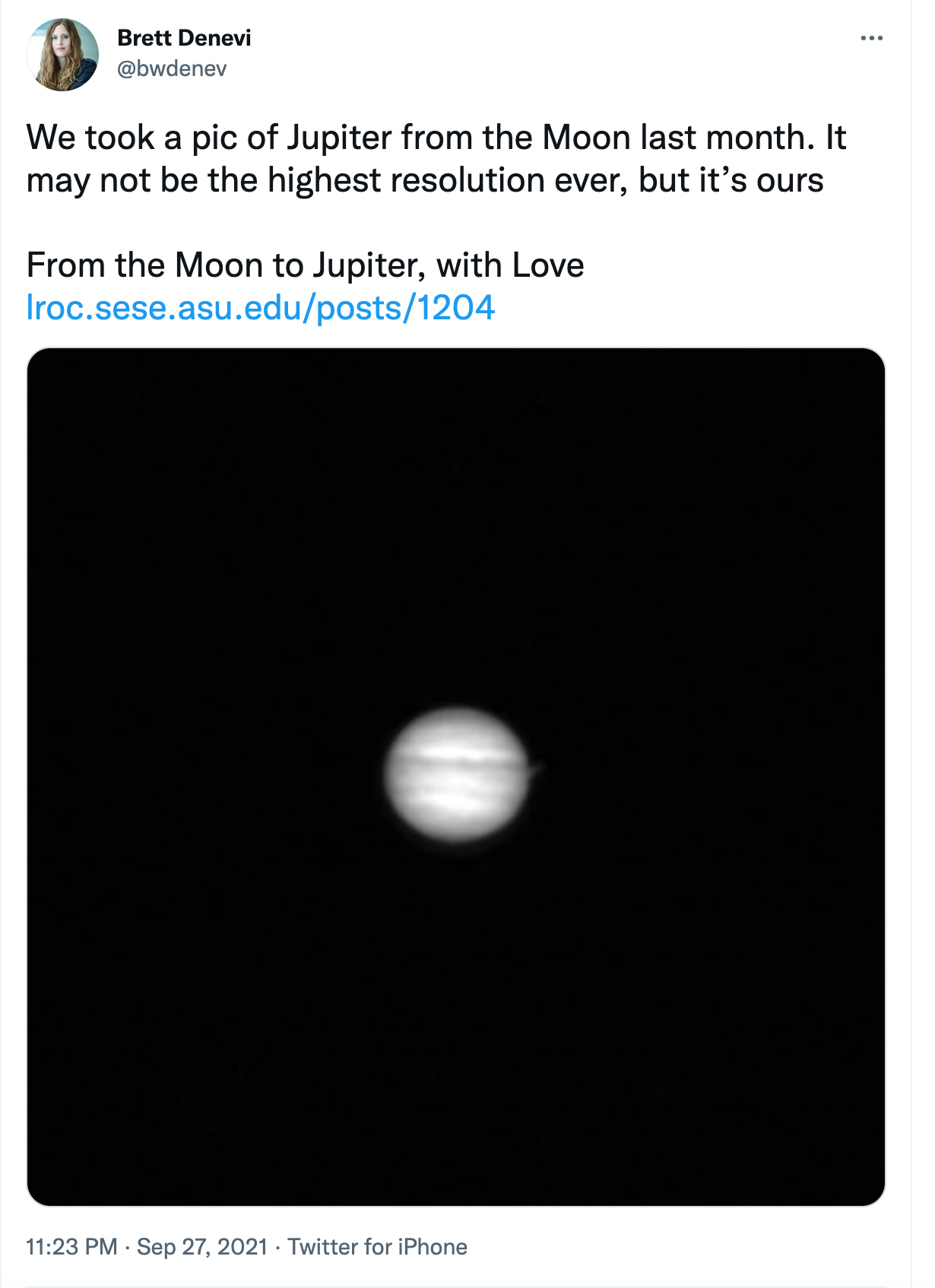
About LROC
http://lroc.sese.asu.edu/about
The Lunar Reconnaissance Orbiter Camera, or LROC, is a system of three cameras mounted on the Lunar Reconnaissance Orbiter (LRO) that capture high resolution black and white images and moderate resolution multi-spectral images of the lunar surface.
LROC consists of two Narrow Angle Cameras (NACs) that are designed to provide 0.5 meter-scale panchromatic images over a 5 km swath, and a Wide Angle Camera (WAC) that provides images at a scale of 100 meters/pixel in seven color bands over a 60 km swath. The Sequence and Compressor System (SCS) supports data acquisition for both cameras.
LROC is a modified version of the Mars Reconnaissance Orbiter's ConTeXt Camera (CTX) and Mars Color Imager (MARCI).
(Please read the articles posted at the URL's above)
- - - - - - - - - - - - - - - - - - - - - - - - - - - - - - - - - - - - - - - - - - - - -
Posted on October 5, 2021
Saildrone Completes First Autonomous Circumnavigation of Antarctica - article update.
1st ocean drone video from inside a hurricane, by Kelly Kizer Whitt (earthsky.org)
https://earthsky.org/earth/ocean-drone-hurricane-sam-video/
For the first time ever, an ocean drone has gone inside a hurricane and sent back video. This ocean drone, a 23-foot-long Saildrone Explorer SD 1045, entered the furious category-4 winds of Hurricane Sam on September 30, 2021, as it swirled in the Atlantic Ocean. The Saildrone sent back footage of 50-foot waves stirred up by 120-mile-per-hour (190 kph) winds. The resulting videos of the tempest-tossed ocean could make even those watching on solid ground feel a little seasick.
-
SD 1045 Inside Hurricane Sam 1400UTC Sept 30 2021
https://www.youtube.com/watch?v=uQM_03zuSAI
POV video captured by SD 1045's onboard camera from inside Hurricane Sam in the Atlantic Ocean at 1400UTC Sept 30, 2021.
- - -
re: Saildrone Completes First Autonomous Circumnavigation of Antarctica
https://flatearthlunacy.com/index.php/archive/2-uncategorised/1272-flat-earth-not-flatearthlunacy-articles-for-reference-u#U71
- - - - - - - - - - - - - - - - - - - - - - - - - - - - - - - - - - - - - - - - - - - - -
Posted on October 4, 2021
Flat Earthers have never acknowledged that Galaxies actually Exist. Talk about living life with your head in the sand!

-
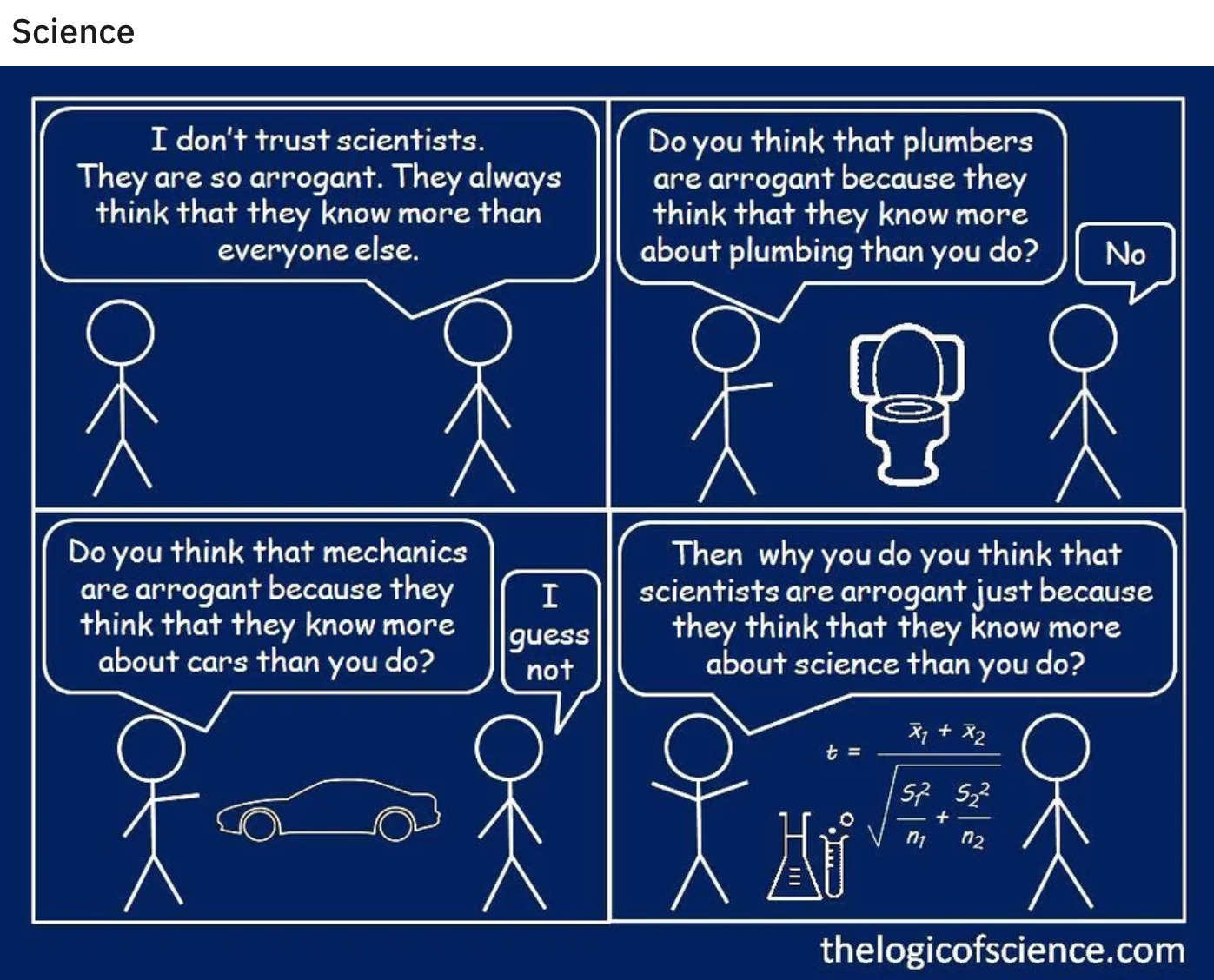
Astronomers Capture Beautiful Image of Two Interacting Galaxies, by Enrico de Lazaro (sci-news.com)
http://www.sci-news.com/astronomy/arp-91-interacting-galaxies-10128.html
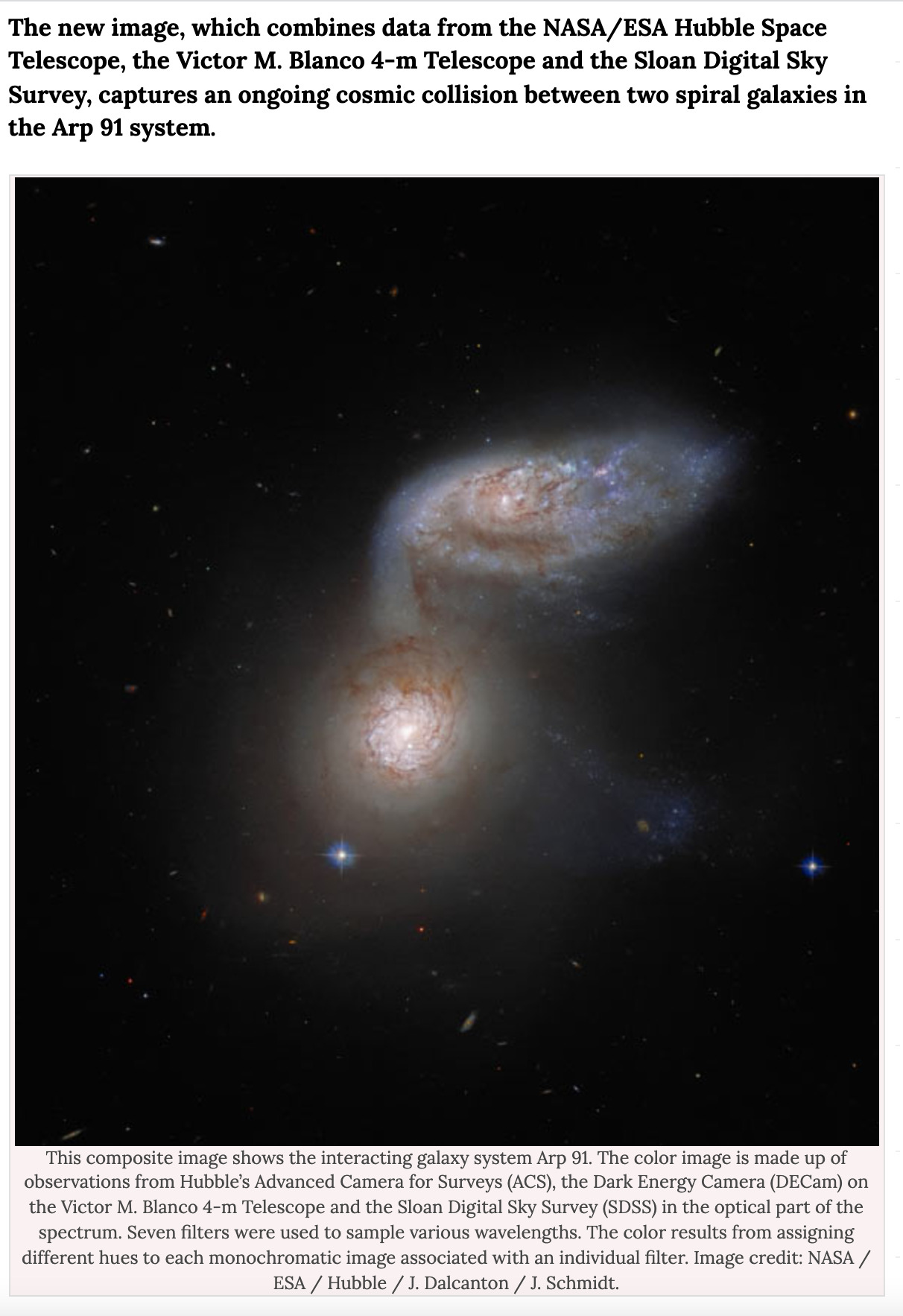
Arp 91 is located approximately 113 million light-years away in the constellation of Serpens.
Otherwise known as KPG 468, the system was discovered on April 17, 1784 by the German-born British astronomer William Herschel.
“The two galaxies comprising Arp 91 do have their own names,” Hubble astronomers said.
“The lower galaxy, which in this image looks like a bright spot, is known as NGC 5953; and the ovoid galaxy to the upper right is NGC 5954.”
“In reality, both of these galaxies are spiral galaxies, but their shapes appear very different because they are orientated differently with respect to Earth.”
The Arp 91 system is a particularly vivid example of galactic interaction.
“NGC 5954 is clearly being tugged towards NGC 5953 — it looks like it is extending one spiral arm downwards,” the researchers explained.
“It is the immense gravitational attraction of the two galaxies that is causing them to interact.”
“Such gravitational interactions between galaxies are common, and are an important part of galactic evolution.”
“Most astronomers nowadays believe that collisions between spiral galaxies lead to the formation of another type of galaxy, known as elliptical galaxies,” they said.
“These immensely energetic and massive collisions, however, happen on timescales that dwarf a human lifetime — they take place over hundreds of millions of years.”
(Please read the entire articles posted in the URL above. Visit sci-news.com)
- - - - - - - - - - - - - - - - - - - - - - - - - - - - - - - - - - - - - - - - - - - - -
Posted on October 2, 2021
Hello, Mercury! BepiColombo speeds by (earthskyorg)
https://earthsky.org/space/hello-mercury-bepicolombo-speeds-by-oct-1-2021/
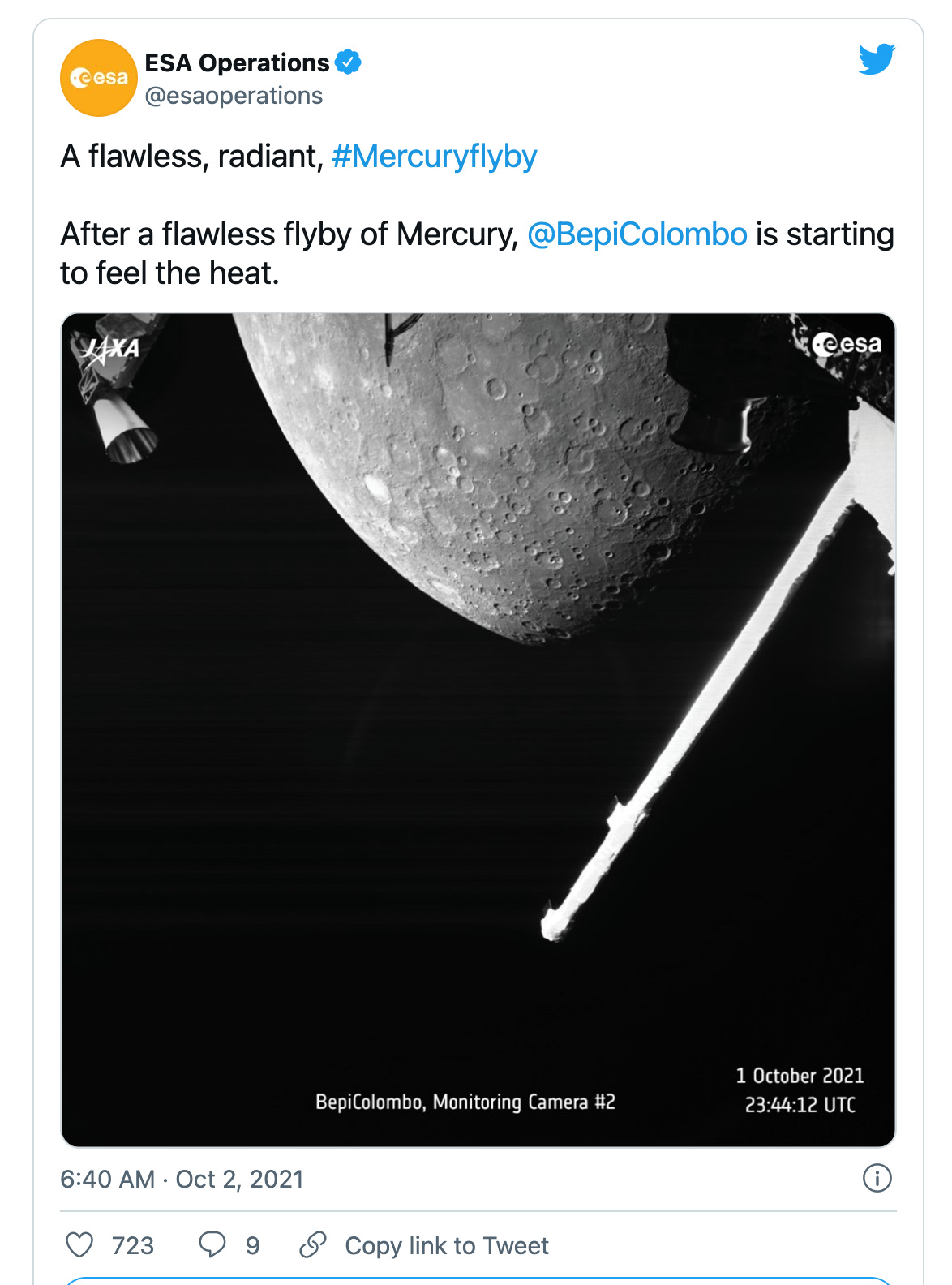
The joint European-Japanese BepiColombo mission captured this view of Mercury on October 1, 2021 as the spacecraft flew past the planet for a gravity assist maneuver. Click here for an annotated version of this image, which is via ESA.
Mercury! BepiColombo gets a gravity assist
The European-Japanese BepiColombo mission – launched in 2018 – successfully performed its first flyby of Mercury late in the day on October 1, 2021. BepiColombo is due to arrive in earnest, for an extended stay at Mercury, on December 5, 2025. But, as the innermost of our sun’s planets, Mercury is hard to get to. So BepiColombo’s journey to Mercury will require a flyby of Earth, two flybys of Venus, and a total of six flybys of Mercury. With each pass, the spacecraft will obtain a gravity assist. The gravity of these planets will alter the spacecraft’s course slightly, and give the craft the boost it’ll need to enter Mercury orbit. On its Mercury pass late yesterday, BepiColombo acquired the image above. The spacecraft passed only about 124 miles (199 km) from Mercury at its closest, at 23:34 UTC on October 1. ESA explained:
The region shown is part of Mercury’s northern hemisphere including Sihtu Planitia that has been flooded by lavas. A round area smoother and brighter than its surroundings characterizes the plains around the Calvino crater, which are called the Rudaki Plains.The 166 km-wide Lermontov crater is also seen, which looks bright because it contains features unique to Mercury called ‘hollows’ where volatile elements are escaping to space. It also contains a vent where volcanic explosions have occurred. BepiColombo will study these types of features once in orbit around the planet....
(Please read the article posted at the URL above)
- - -
BepiColombo completes first Mercury flyby, science provides insight into planet’s unique environment, by Haygen Warren (nasaspacflight.com)
https://www.nasaspaceflight.com/2021/10/bepicolombo-first-mercury-flyby/
Excerpt:
On October 1, 2021, the joint European Space Agency (ESA) and Japan Aerospace Exploration Agency (JAXA) BepiColombo spacecraft successfully performed its first flyby of the solar system’s innermost planet, Mercury. The flyby is the first in a set of six such events BepiColombo will complete before entering orbit around Mercury in late 2025.
Following the flyby, initial science returns from different instruments onboard BepiColombo revealed interesting details about the environment surrounding Mercury, as well as details on the planet itself.
The flyby
BepiColombo’s first Mercury flyby sequence took place on October 1 and October 2, with the closest approach occurring at 23:34 UTC on October 1 at a distance of 199 km from the surface of Mercury as the spacecraft’s monitoring cameras captured images of the planet.
These same cameras returned images of Venus from BepiColombo’s second flyby of that planet in August 2021.
The three monitoring cameras onboard BepiColombo’s Mercury Transfer Module (MTM) captured images of the planet for four hours beginning approximately five minutes after the closest approach.
While the images of Mercury are visually impressive — with the planet being seen behind some of BepiColombo’s instruments — and stunningly clear, they also allow scientists to identify certain surface craters on the planet and marked the start of the craft’s scientific objectives at Mercury as some regions around the planet will not be accessible once the craft enters orbit; therefore, they have to be studied during the flybys.
“The flyby was flawless from the spacecraft point of view, and it’s incredible to finally see our target planet,” said Elsa Montagnon, Spacecraft Operations Manager for BepiColombo...
(Please read the article posted at the URL above)
- - -
Sound of the sola rwind at Mercury
https://www.youtube.com/watch?v=ZQAVXrlK0bs
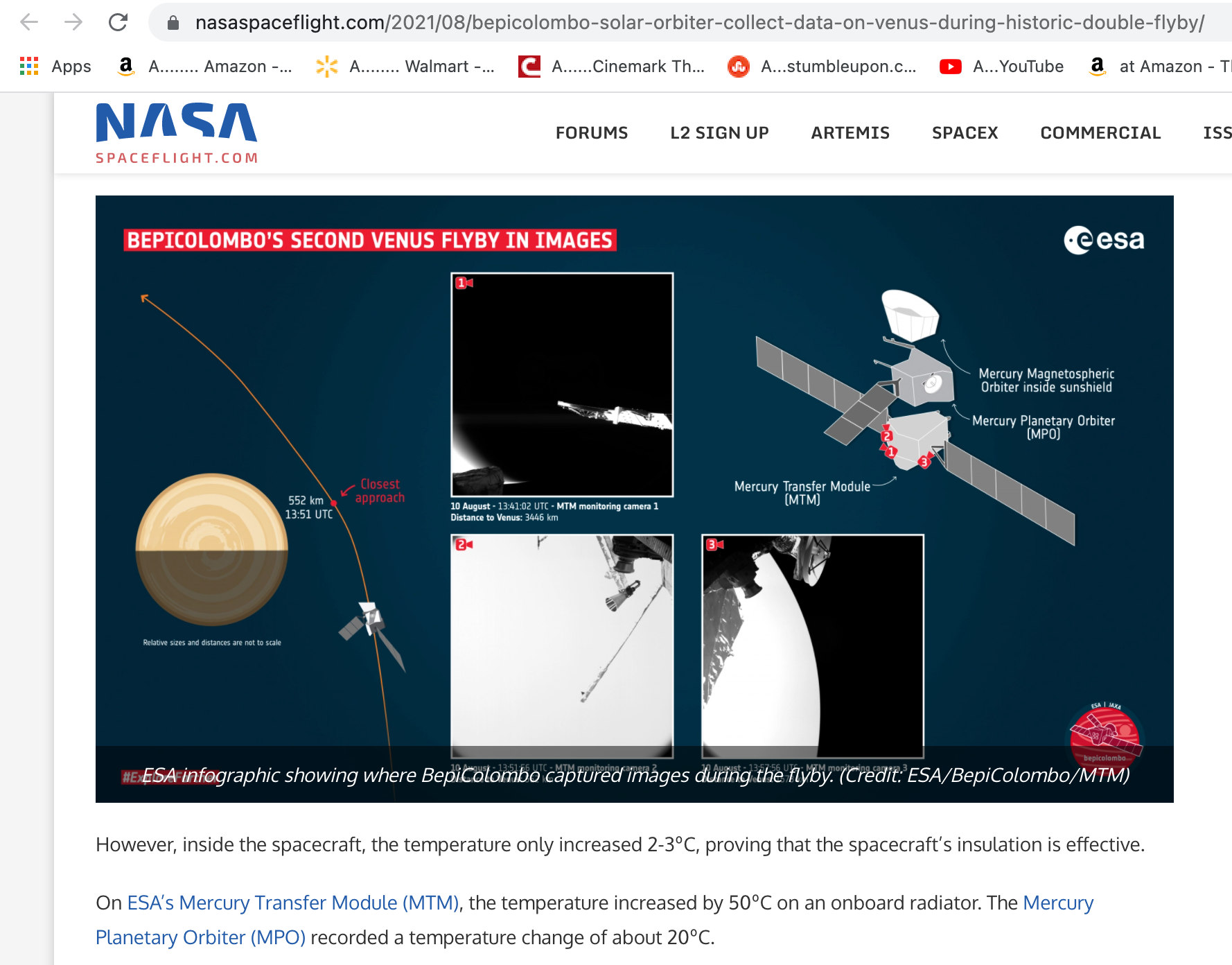
- - - - - - - - - - - - - - - - - - - - - - - - - - - - - - - - - - - - - - - - - - - - -
Posted on September 30, 2021
An impressive 13 feet diameter (90 tons) meteorite reduced to 17 pieces during earth reentry tracked to Croatia.
Daylight fireball tracked to Earth (earthsky.org)
https://earthsky.org/space/daylight-fireball-tracked-earth/
On February 28, 2020, around 10:35 in the morning, people around the Adriatic Sea looked up to see a bright burst of light streaking toward Earth. Dashcams, security cameras, and even a bike helmet recorded this daylight fireball as it plunged through our atmosphere. The meteor broke into pieces as it heated up, scattering across the land. Denis Vida of the University of Western Ontario gave a presentation at the Europlanet Science Congress virtual meeting in September 2021 showing how they were able to reconstruct the trajectory of the fireball using the videos...
(Please read the article posted at the URL above)
- - - - - - - - - - - - - - - - - - - - - - - - - - - - - - - - - - - - - - - - - - - - -
Posted on September 27, 2021
Another flat Earth conundrum with no explanation offered.
Those that watch the planet Saturn have seen the orientation of the rings change thru time. How does your flat Earth model reconcile with that? Clue = it doesn't. Fancy that!
Saturn from Earth, 2004 to 2015 (earthsky.org)
https://earthsky.org/todays-image/saturn-from-earth-2004-to-2015/

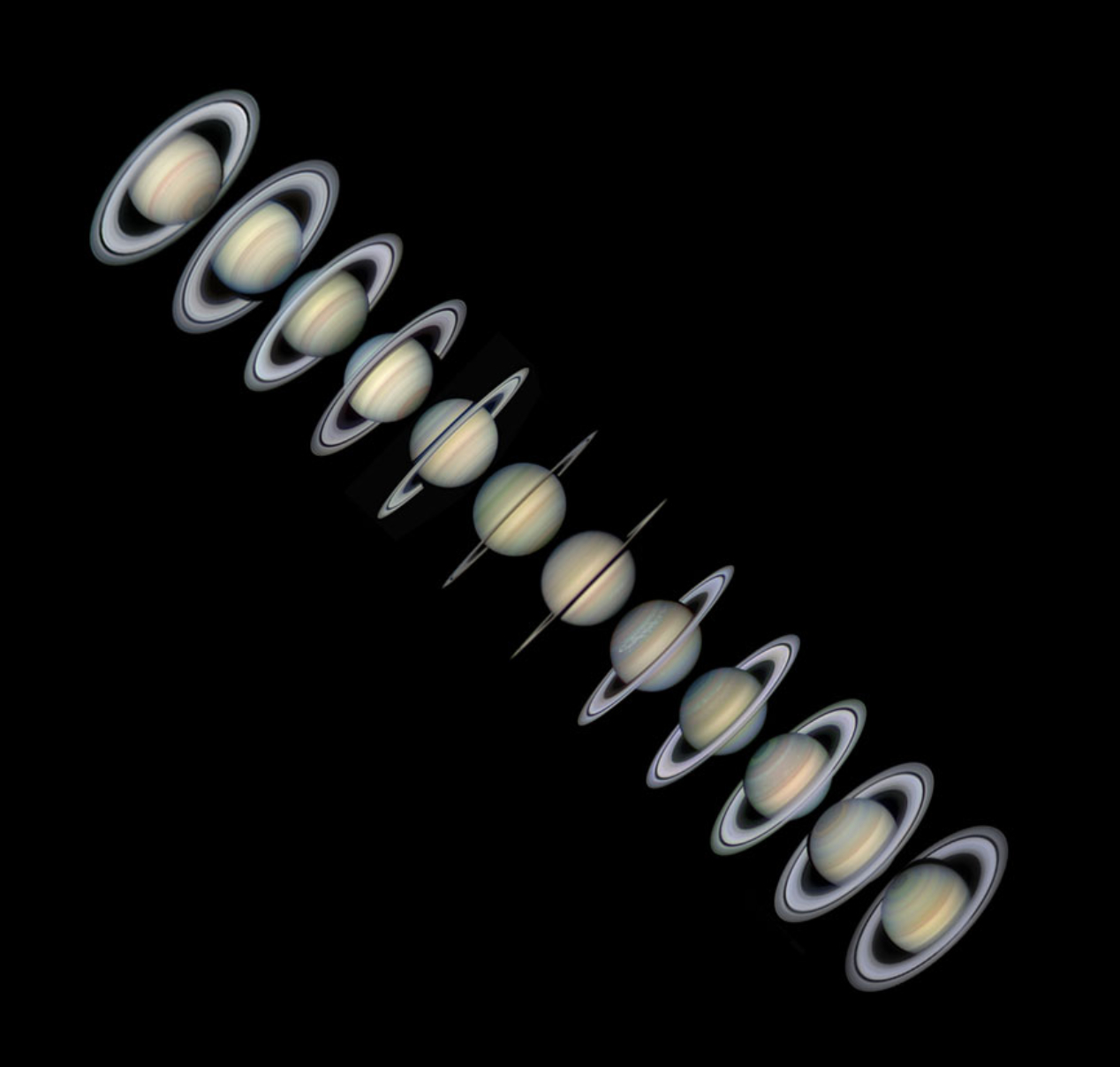

-
How Saturn Got It's Rings | The Planets | Earth Lab (BBC Earth Lab)
https://www.youtube.com/watch?v=6Bv8g5xBJSo
-
We asked Two Flat Earthers: What About the Other Planets? (Newsweek.com)
https://www.newsweek.com/we-asked-two-flat-earthers-what-about-other-planets-728959
Droves of people in America continue to decide to believe the planet is flat and stationary. We've already written about how incorrect that is, but we wondered what they thought about other planets in our celestial neighborhood. Are they recognized as spheres or are they, too, supposed to be flat? So we found two Flat Earthers to ask—here's what we learned.
"You'll find in the community, there are a lot of people that have a lot of differences," Robbie Davidson, organizer of the Flat Earth International Conference, told Newsweek. "We don't all believe in the same model."
"I honestly believe they exist," Davidson, who became a Flat Earth believer about two and a half years ago, said of the other planets in our solar system. "For me personally, I just see them as lights in the sky." That belief actually harkens back to the ancient definition of planets as wandering stars, which was first recognized as incorrect by Nicholas Copernicus in 1543.
Davidson says that means planets are kind of like stars, definitely not "terra firma planets," making them a set of similar-but-different stars. (He also says that our sun isn't the same as other stars, since it doesn't twinkle. In fact, our sun is very normal and no stars twinkle, the perceived phenomenon comes from Earth's atmosphere interfering with their light...
-
Other resources..
Saturn's Orbit and the Changing Aspect of the Rings, by Martin Powell
https://nakedeyeplanets.com/saturn-orbit.htm
Hubble Views Saturn Ring-Plan Crossing (Hubblesite.org)
https://hubblesite.org/contents/news-releases/1995/news-1995-25.html
Viewing Saturn: The Planet, Rings and Moons (skyandtelescope.org)
https://skyandtelescope.org/observing/viewing-saturn-the-planet-rings-and-moons/
(Please read the articles at the URL's posted above)
- - - - - - - - - - - - - - - - - - - - - - - - - - - - - - - - - - - - - - - - - - - - -
Posted on September 24, 2021
For all those flat Earthers who claim "Gravity is not a Force."
Debunk by Bob the Science Guy
The Citations of Quantum Eraser, by Bob the Science Guy
https://www.youtube.com/watch?v=Fcxz6BHEEy8
Questionable Education (QE) thinks that by uploading his attempt to misquote scientific articles to claim gravity doesn't act like a force again, we all forgot how badly I called him on it the first time. Apparently QE needs to be schooled again. Bob the Science Guy is up to the task, as always.
This is the first in a series of the misuse of citations by everyone's favorite pseudo intellectual.
QE Gravity Fail: https://youtu.be/CmljGgyy6vc
Math Edu Paper: http://math.ucr.edu/home/baez/physics...
Brian Cox on Einstein: https://www.youtube.com/watch?v=E43-C...
George Musser Interview FTFE: https://www.youtube.com/watch?v=SK9-g...
Gravity Wiki: https://en.wikipedia.org/wiki/Gravity
Universe Today: https://www.universetoday.com/108740/...
CalTech Paper: https://ned.ipac.caltech.edu/level5/E...
Physics.org: https://phys.org/news/2016-12-strong-...
Einstein Letter: http://germanhistorydocs.ghi-dc.org/p...
- - - - - - - - - - - - - - - - - - - - - - - - - - - - - - - - - - - - - - - - - - - - -
Posted on September 22, 2021
Since atoms are mostly empty space, how is it that we can sit on a chair and not fall through?
Spinning electrons are the answer.
How Electron Spin Makes Matter Possible (PBS Space Time)
https://www.youtube.com/watch?v=EK_6OzZAh5k
Today I’m going to explain why you’re not falling through your chair right now using one simple fact, and one object. The fact is that all electrons are the same as each other, and the object is a structurally critical item of my clothing. There’s a chance this episode could get very weird.
Electrons DO NOT Spin (PBS Space Time)
https://youtu.be/pWlk1gLkF2Y
Spin Renderings by the Incredible Jason Hise
http://entropygames.net/
Spin Renderings by the Incredible Jason Hise
https://www.youtube.com/channel/UCw5a...
The weird discoveries of quantum physics = Classically non-describable two-valuedness.
Electrons are not spinning in the usual physical sense, but they have angular momentum as if they really were.
(Please watch the videos posted at the URL's above)
- - - - - - - - - - - - - - - - - - - - - - - - - - - - - - - - - - - - - - - - - - - - -
Posted on September 18, 2021
Debunking the Moon Hoax standard conspiracy talking points
Moon Hoax Theory #1 - Space suit boot doesn't match moon print, by M2M
https://www.youtube.com/watch?v=kGsyDAy7iCA
The first in the series of debunking the most common moon landing hoax theories of the Apollo era 1969-1972.
(Please watch the video posted at the URL above)
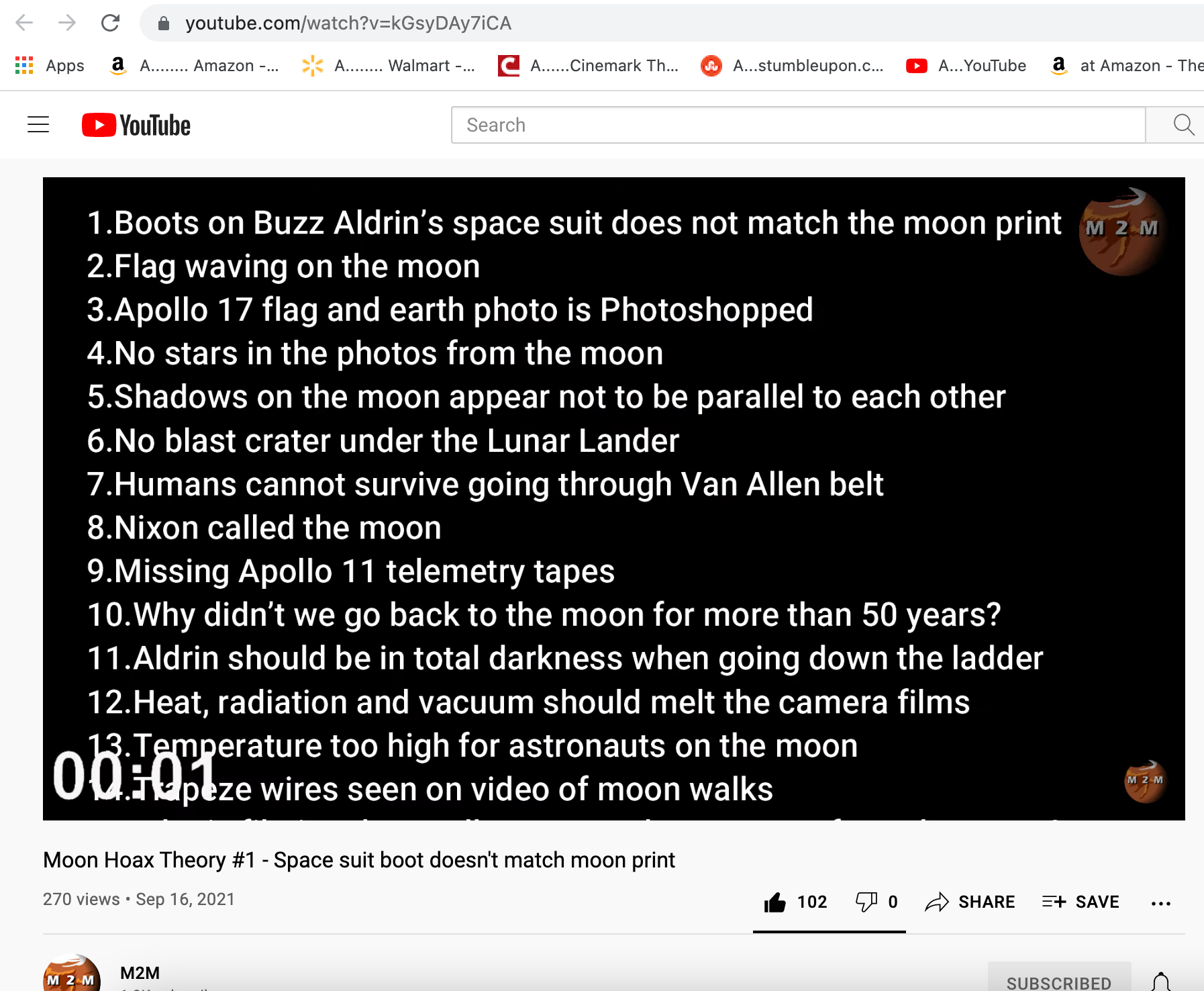
Moon Hoax Debunked #2 - Flag waving on the moon
https://www.youtube.com/watch?v=RvzRGsm62Oc&t=121s
-
Moon Hoax Debunked #3 - Apollo 17 flag and earth photo is Photoshopped?
https://www.youtube.com/watch?v=-3z2A1cs1oc
BertieSlack Video on JPEG Compression - https://www.youtube.com/watch?v=YHQ_N...
"jpeg uses a type of lossy compression that looses some data from the original file, particularly at high compression ratios. The results of this compression have led some unevolved humans to believe the Moon is an artificial satellite, built by aliens, covered with cities that are invisible thru each and everyone of the millions of telescopes on the earth..."
https://photo.stackexchange.com/quest...
https://en.wikipedia.org/wiki/JPEG
https://en.wikipedia.org/wiki/Compres...
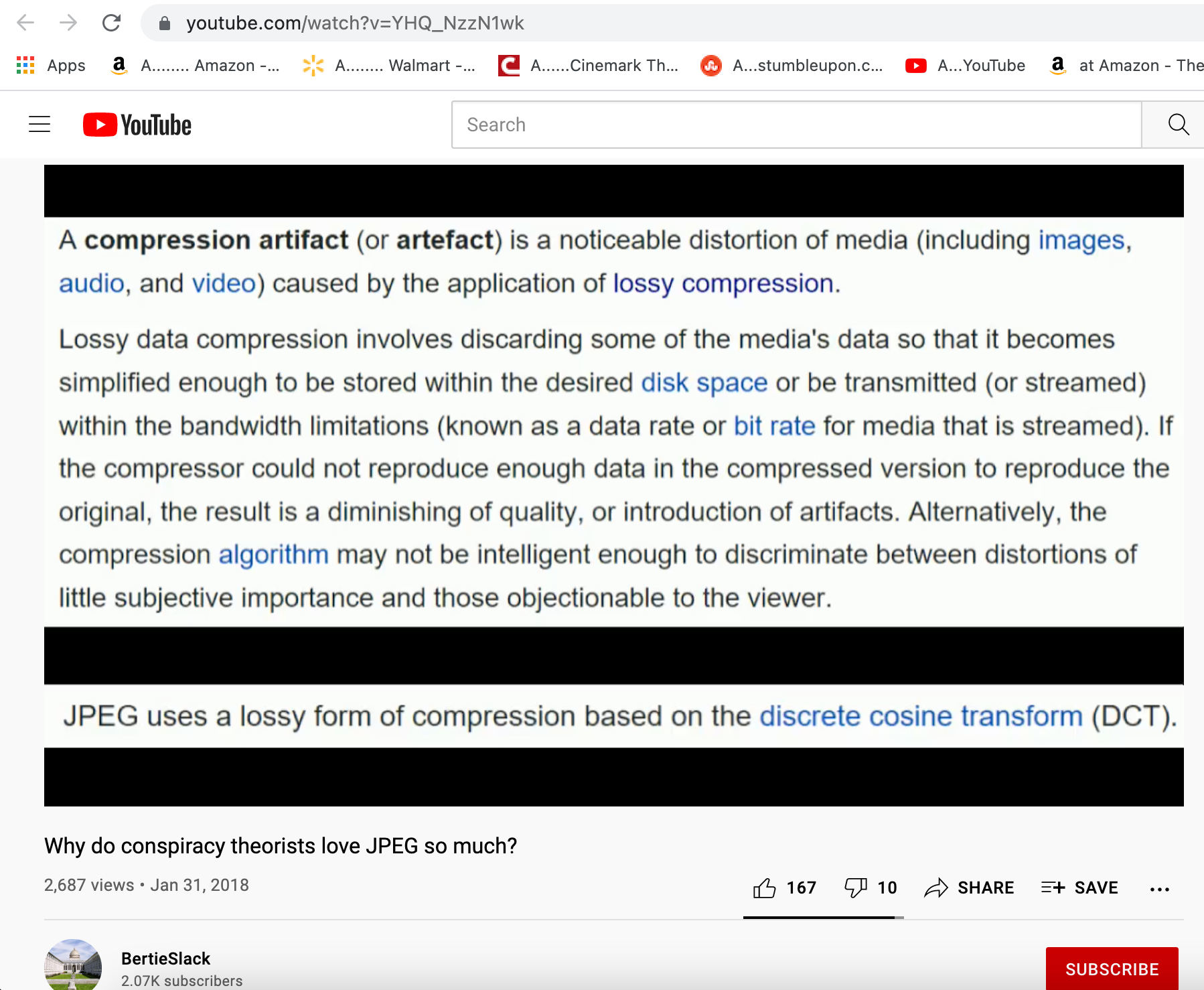
-
Moon Hoax Debunked #4 - No stars in the moon photos, by M2M
https://www.youtube.com/watch?v=TdVbiIcQl_c
Fourth in the series of debunking the most common moon landing hoax theories of the Apollo era 1969-1972. This time I explain why you won't see stars in the Apollo photos on the moon.
-
Moon Hoax Debunked #5 - Shadows in the moon photos are not parallel, by M2M
https://www.youtube.com/watch?v=Zb7kVTiE0fI
Fifth in the series of debunking the most common moon landing hoax theories of the Apollo era 1969-1972. This one is about why shadows don't appear parallel in the moon photos and blow the theory that the moon landings are faked in a studio with multiple light sources, out of the water.
-
Moon Hoax Debunked #6 - No blast crater under the Lunar Module, by M2M
https://www.youtube.com/watch?v=rvJQ52nxHOU
Episode 6 in the series of debunking the most common moon landing hoax theories of the Apollo era 1969-1972. Here I explain why there would not be a blast crater on the moon under the Lunar Modules in the Apollo photos.
-
Moon Conspiracy Debunked #7 - "Astronauts can't survive going through Van Allen Belts", by M2M
https://www.youtube.com/watch?v=Niaz3h2FyR0
Episode 7 in the series of debunking the most common moon landing hoax theories of the Apollo era 1969-1972. Here I explain how NASA dealt with the Van Allen radiation belts.
Alpha, Beta and Gamma radiation - https://science.howstuffworks.com/rad...
-
Moon Conspiracy Debunked #8 - "Nixon called the moon", by M2M
https://www.youtube.com/watch?v=HnLT_rhDrlE
Episode 8 in the series of debunking the most common moon landing hoax theories of the Apollo era 1969-1972. This time I show how Nixon spoke to the astronauts during Apollo 11 and show there is a delay between Nixon and Neil Armstrong speaking.
AT&T Video of Nixon calling Apollo 11 astronauts on the moon
https://www.youtube.com/watch?v=ieGKI...
-
Moon Hoax Debunked #9 - Missing Apollo 11 Telemetry tapes, by M2M
https://www.youtube.com/watch?v=IkgTGMzKN98
Episode 9 in the series of debunking the most common moon landing hoax theories of the Apollo era 1969-1972. In this video, I explain what happened to the now, infamous missing tapes from the Apollo 11 mission to the moon.
-
Moon Conspiracy Debunked #10 - Why we didn't go back to the moon, by M2M
https://www.youtube.com/watch?v=r6RR7Wi1Dyk
Episode 10 in the series of debunking the most common moon landing hoax theories of the Apollo era 1969-1972. In this video, I give a run down to the main reasons why NASA hadn't returned to the moon in almost 50 years.
- - -
The M2M channel - https://www.youtube.com/c/CasualSpaceman/videos
- - - - - - - - - - - - - - - - - - - - - - - - - - - - - - - - - - - - - - - - - - - - -
Posted on September 17, 2021
Flat Earthers - please explain and show us where these 461 reported solar system objects can be found under your DOME sky.
A six-years search of the outer solar system turn up 461 new objects, but no Planet 9. (phys.org)
https://phys.org/news/2021-09-six-year-outer-solar-planet.html
(Please read the article at the URL posted above)
- - - - - - - - - - - - - - - - - - - - - - - - - - - - - - - - - - - - - - - - - - - - -
Posted on September 17, 2021
Some tips and instruction to flat Earth advocates on how THEY can become skilled amateur astronomers. Start by photographing the Planets with a small affordable telescope.
Getting Started in Planetary Imaging (skyandtelescope.org)
https://skyandtelescope.org/astronomy-blogs/imaging-foundations-richard-wright/getting-started-planetary-imaging/
(Please read the article at the URL posted above)
- - - - - - - - - - - - - - - - - - - - - - - - - - - - - - - - - - - - - - - - - - - - -
Posted on September 16, 2021
First all civilian crew into space.
Live: SpaceX Launches Inspiration4 All-Civilian Crew Into Orbit (NBC News)
https://www.youtube.com/watch?v=2c5muMCsDGg
Watch live coverage as SpaceX launches the Inspiration4 crew, the first ever all-civilian group, into orbit.
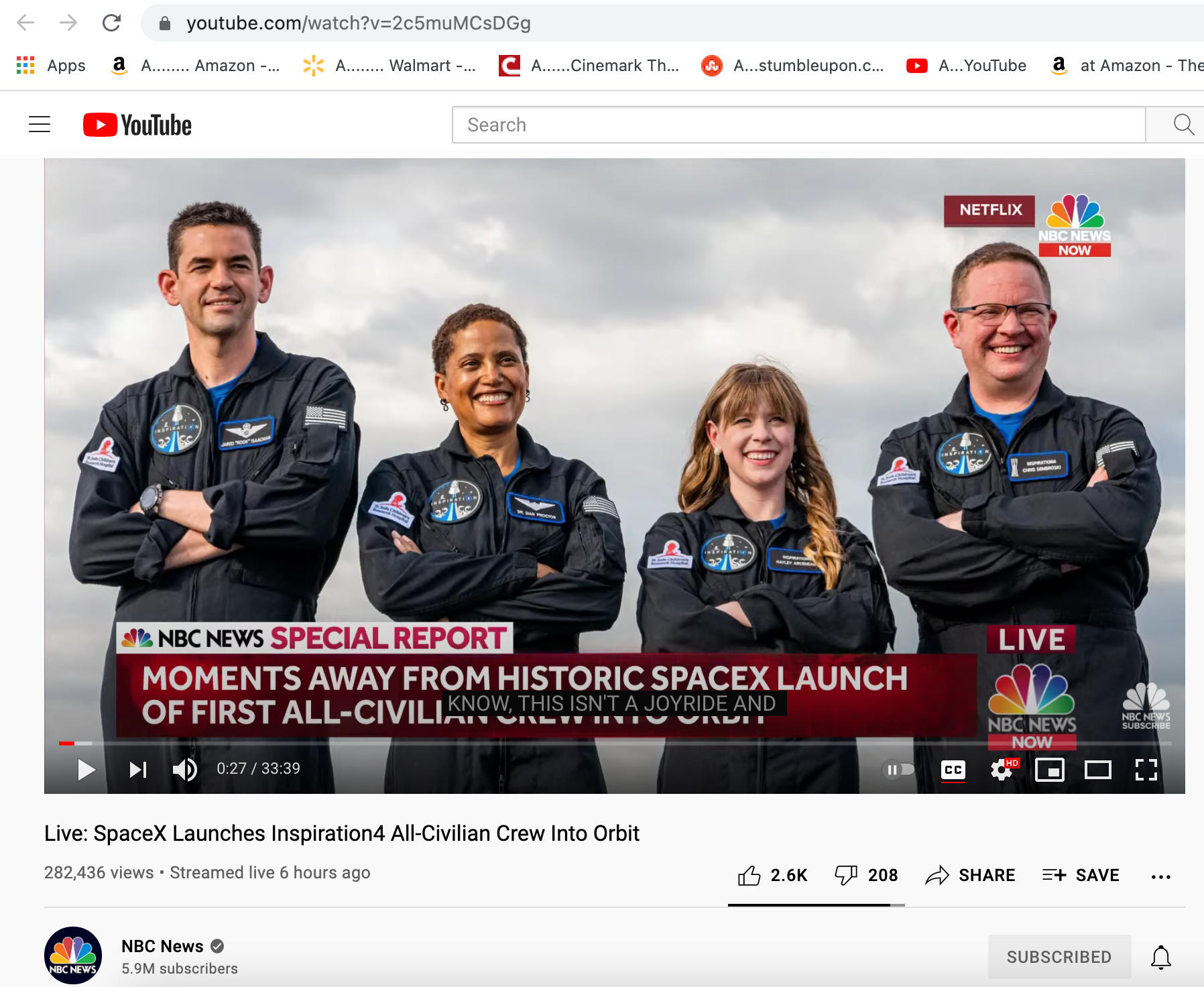
-
LIVE: Rocket Launch of Inspiration 4 SpaceX Mission with 4 Private Astronauts on Falcon 9 (Space Videos)
https://www.youtube.com/watch?v=XRunL7OjCwM
SpaceX is set to launch a Falcon 9 rocket today carrying the Crew Dragon Resilience into a 575km orbit above Earth. Dragon will carry for the first time four private citizens onboard.
Liftoff is set for 20:02 EDT, 00:02 UTC, 01:02 BST at the start of a 5 hour launch window from Kennedy Space Center's Launch Pad 39A.
The crew is made up of Spacecraft Commander Jared Isaacman, Pilot Sian Proctor, Chief Medical Officer Hayley Arceneaux and Mission Specialist Chris Sembroski.
The crew will spend three days in Orbit before re-entering Earth's atmosphere and splashing down near the coast of Florida.
As the mission name implies, the mission is about Inspiration, to inspire children and adults alike about Space and what is to come, They also aim to raise $200 million for the St Judes Childrens Research Hospital - to donate to the cause please visit their website:
https://inspiration4.com/donate
Launch will be carried Live on the SpaceX channel, as well as Netflix and all the various news networks, we will also live stream launch and try provide a clean feed if available without talking heads - just shots of the rocket as it launches.
-
SpaceX launches 1st all-civilian crew into Earth's orbit | FULL (Global News)
https://www.youtube.com/watch?v=WwVyKebZBZk
A quartet of amateur space travelers, led by the American founder and chief executive of e-commerce firm Shift4Payments Inc., Jared Isaacman, became the first all-civilian crew launched into Earth's orbit on Wednesday evening.
The flight, with no professional astronauts accompanying SpaceX's paying customers, is expected to last about three days from liftoff to splashdown in the Atlantic.
This marks the debut flight of SpaceX Owner Elon Musk's new orbital tourism business.
The mission, called Inspiration4, was conceived by Isaacman mainly to raise awareness and support for one of his favourite causes, St. Jude Children's Research Hospital, a leading pediatric cancer center in Mephis, Tennessee.
-
SpaceX Inspiration Launch Was An Inspiration, by WheresWally
https://www.youtube.com/watch?v=q6PqeGnZwwM
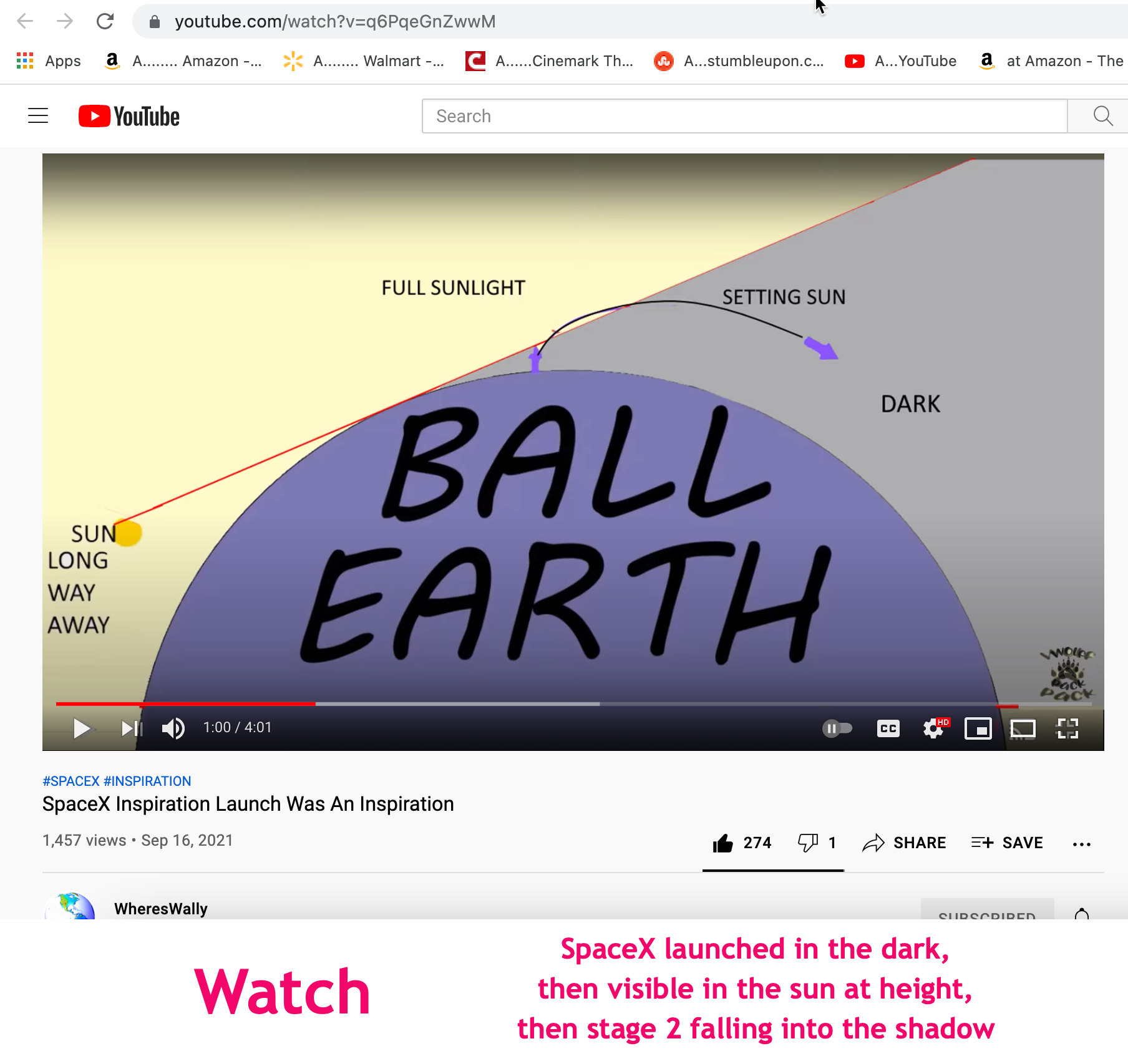
-
Dragon Splashdown of Inspiration 4 SpaceX Mission with 4 Private Astronauts (Space Videos)
https://www.youtube.com/watch?v=Ygi2Im4LWtw
The SpaceX Dragon Resilience is set to splashdown off the coast of Florida at 19:06 EDT, 23:06
UTC, 00:06 BST on Saturday 18th 2021.
The crew is made up of Spacecraft Commander Jared Isaacman, Pilot Sian Proctor, Chief Medical Officer Hayley Arceneaux and Mission Specialist Chris Sembroski.
The crew spent three days in Orbit conducting science experiments and performing public outreach in support of St Judes Children's Hospital.
As the mission name implies, the mission is about Inspiration, to inspire children and adults alike about Space and what is to come, They also aim to raise $200 million for the St Judes Children's Research Hospital - to donate to the cause please visit their website: https://inspiration4.com/donate
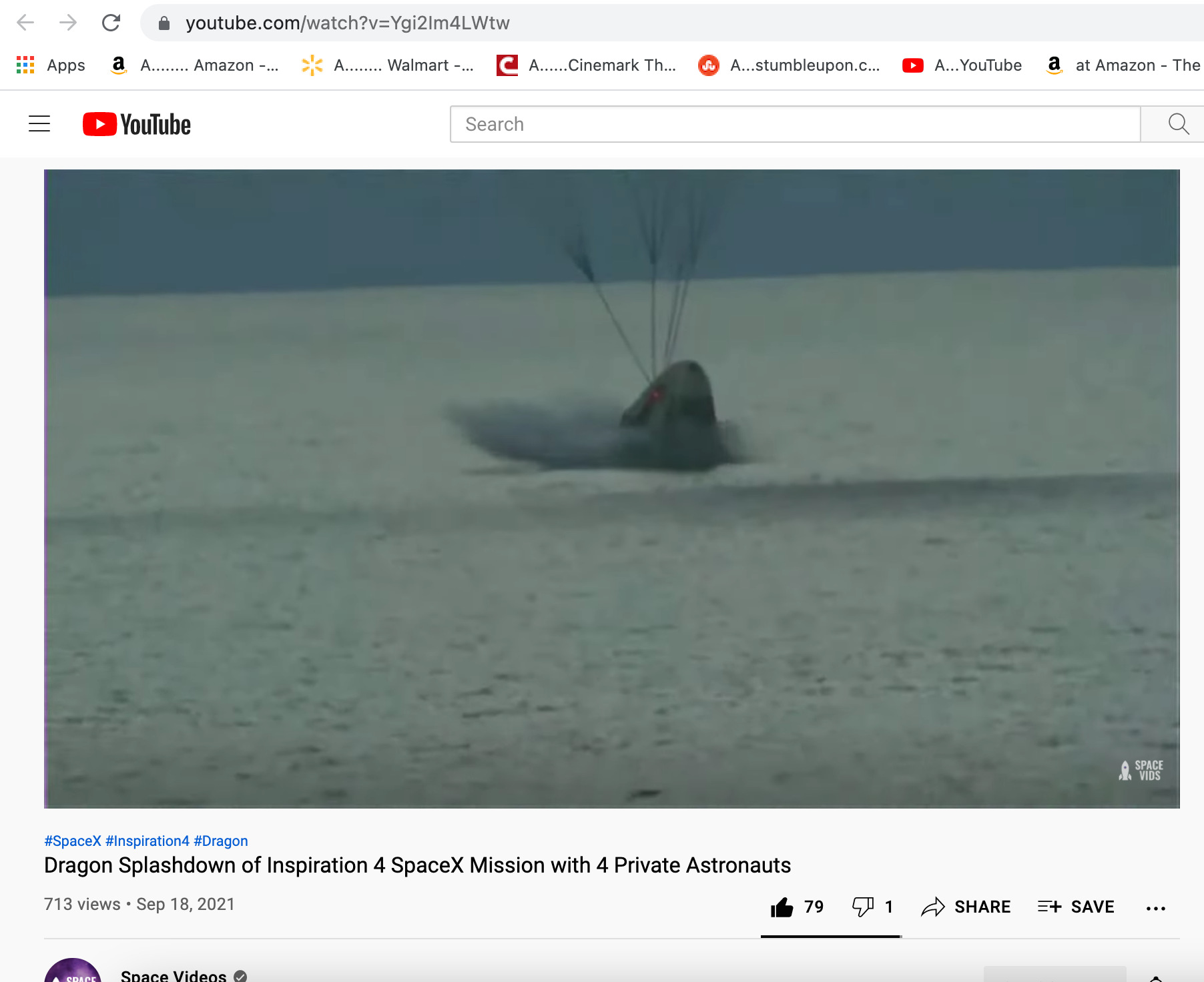
-
Inspiration4 Astronauts Beam After Return From 3-Day Journey to Orbit (nytimes.com)
https://www.nytimes.com/2021/09/18/science/spacex-inspiration4.html
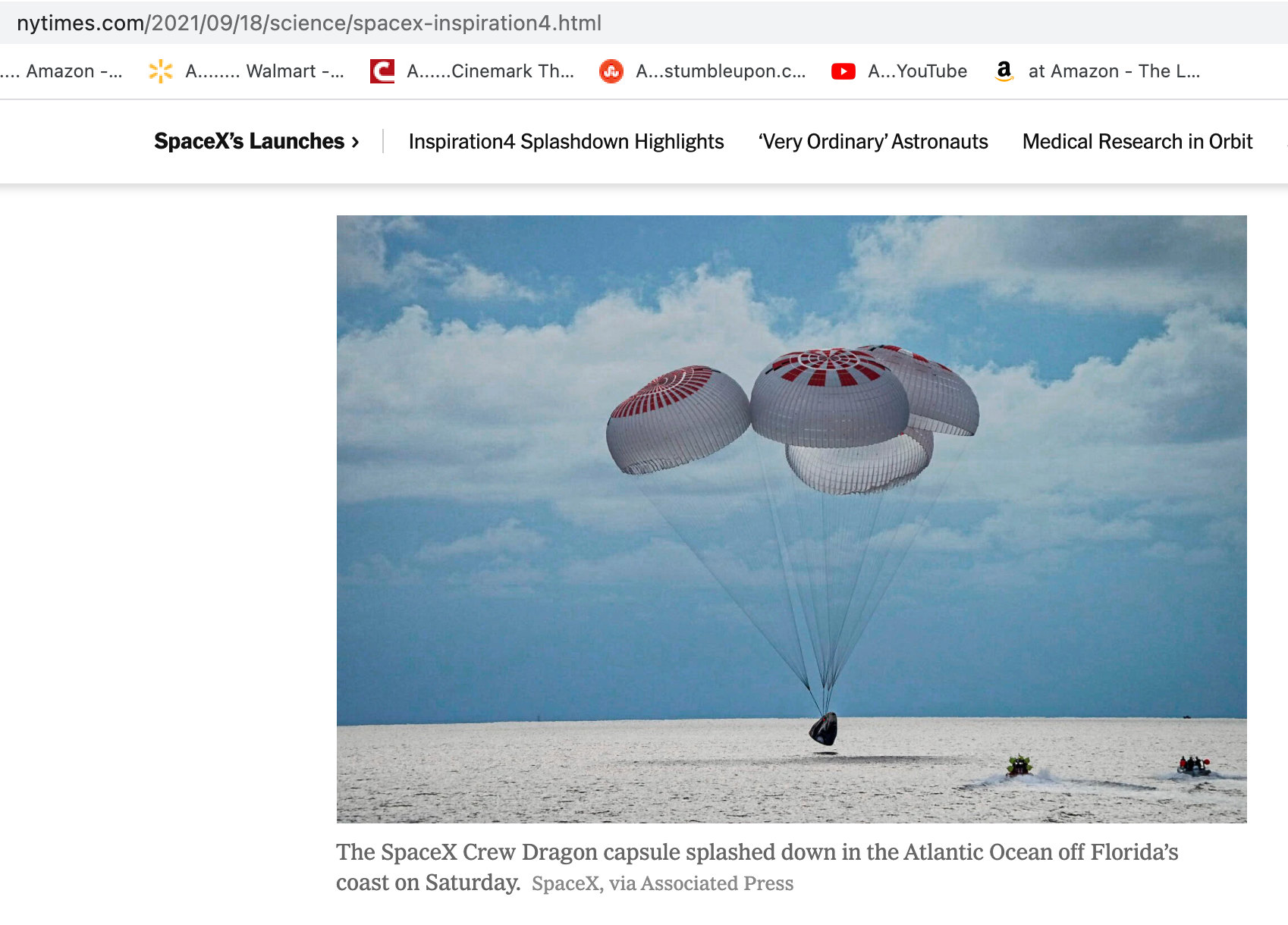
-
Extended Interview: All-Civilian Inspiration4 Crew On Historic Mission (NBC News)
https://www.youtube.com/watch?v=NtzY_jL6HSY
Halley...
"When you put your head in that bubble, all you can see was the entire planet, and space and stars and the Moon..."
Following a successful three-day mission in space, Jared Isaacman, Dr. Sian Proctor, Chris Sembroski, and Hayley Arceneaux speak with Lester Holt about their experience during launch, what it was like orbiting Earth, and the mixed emotions of returning home.
-
(Please watch all the videos posted at the URL's above)
- - - - - - - - - - - - - - - - - - - - - - - - - - - - - - - - - - - - - - - - - - - - -
Posted on September 14, 2021
Several recents articles posted by Bob the Science Guy explains the Sextant, how to use it, and how it proves the globe Earth. Real navigation on our globe planet!
Direct land based measurements of the Earth's size. And how to use a Sextant for navigation (FlatEarthLunacy)
https://flatearthlunacy.com/index.php/2-uncategorised/1424-flat-earth-not-flatearthlunacy-articles-for-reference-s#S143
- - - - - - - - - - - - - - - - - - - - - - - - - - - - - - - - - - - - - - - - - - - - -
Posted on September 12, 2021
Dog-bone asteroid Kleopatra is odd shaped and has two moons of its own (earthsky.org).
https://earthsky.org/space/dog-bone-asteroid-kleopatra-makes-a-fetching-portrait/
Dog-Bone Asteroid Kleopatra Makes A Fetching Portrait
216 Kleopatra – aka the dog-bone asteroid – might paws-ibly be the cutest object in the asteroid belt between Mars and Jupiter. It was one of the earliest asteroids to be discovered, in 1880. But astronomers labeled it as a dog-bone 20 years ago, when radar observations at Arecibo Observatory revealed its two lobes and thick “neck.” Astronomer Franck Marchis of the SETI Institute in Mountain View, California, led the team that captured the sharpest and most detailed images yet of Kleopatra (above).
The European Southern Observatory released the images this week (September 9, 2021) and said the new observations caused astronomers to realize this fetching asteroid is a little ruff around the edges. It may be nothing more than a big rubble pile that’s lost some of its pebbles, but gained two moons...
(Please read the article at the URL posted above)
- - - - - - - - - - - - - - - - - - - - - - - - - - - - - - - - - - - - - - - - - - - - -
Posted on September 9, 2021
Some important discoveries were announced today...
Success! Mars rover finally collects its first rock core (nature.com)
NASA’s Perseverance rover lives up to its name, drilling and storing Martian rock after a misstep in August.
A Flurry of Fall Binocular Comets (universetoday.com)
Fall 2021 offers up an all-night parade of challenging telescopic comets.
New superconducting magnet breaks magnetic field strength records, paving the way for fusion energy (phys.org)
Graphene valleytronics: Paving the way to small-sized room-temperature quantum computers(phys.org)
(Please read those important articles at the URL's posted above)
- - - - - - - - - - - - - - - - - - - - - - - - - - - - - - - - - - - - - - - - - - - - -
Posted on September 4, 2021
A powerful new Laser Will Enhance Adaptive Optics (universetoday.com)
https://www.universetoday.com/152396/a-powerful-new-laser-will-enhance-adaptive-optics/
This technique (AO) allows land based telescopes to help eliminate the "twinkling of stars" caused by the earth's atmosphere, so that stellar photos and observations can be clearer.

Excerpt:
In some applications, bigger lasers mean better lasers. That is the case in astronomy, where lasers are used for everything from telescope calibration to satellite communication. The European Southern Observatory (ESO) and some of its commercial partners have developed a laser 3 times more powerful than the existing industry standard. With that increased power level, the new system has the potential to dramatically improve the way telescopes deal with one of the most fundamental problems in ground-based astronomy – atmospheric turbulence...
YouTube video "why do stars twinkle" - https://www.youtube.com/watch?v=H4x39AJ9Wzk
(Please read the article posted at the URL above)
- - - - - - - - - - - - - - - - - - - - - - - - - - - - - - - - - - - - - - - - - - - - -
Posted on September 3, 2021
Planetary radar (earth based) observes 1,000th near-earth asteroid since 1968 (phys.org)
https://phys.org/news/2021-09-planetary-radar-1000th-near-earth-asteroid.html
Selected excerpt:
"Benner and his team led this effort using the 70-meter (230-foot) Deep Space Station 14 (DSS-14) antenna at the Deep Space Network's Goldstone Deep Space Complex near Barstow, California, to transmit radio waves to the asteroid and receive the radar reflections, or "echoes."
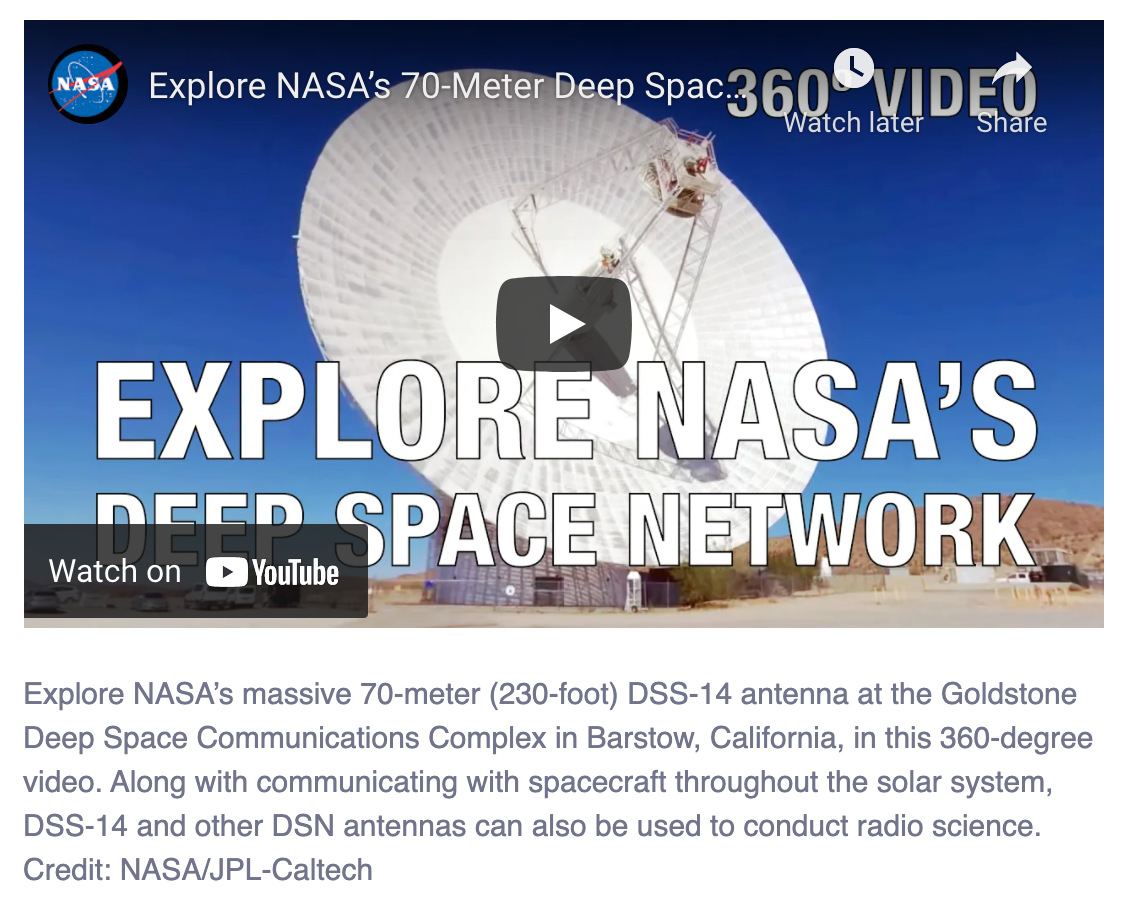
(Please read the article posted at the URL above)
- - - - - - - - - - - - - - - - - - - - - - - - - - - - - - - - - - - - - - - - - - - - -
Posted on September 2, 2021
Virgin Galactic Announces First Commercial Research Mission (spaceref.com)
http://spaceref.com/news/viewpr.html?pid=58116
Excerpt:
The “Unity 23” mission will be the 23rd flight for VSS Unity and will carry three paying crew members from the Italian Air Force and the National Research Council. The goal of the mission is to evaluate and measure the effects of the transitional phase from gravity to microgravity on the human body. Other payloads on board will study the effect of the microgravity environment on a range of chemical and physical properties. By testing and evaluating physiological and technological responses in sub-orbital flight, the mission aims to produce insights relevant to current and future spaceflight systems and technologies.
The crew will be:
- Col. Walter Villadei, Italian Air Force. Col. Villadei, a space engineer and cosmonaut, will serve as mission lead, tending to the rack-mounted payloads during the weightless portion of the flight. He will wear a cutting-edge smart suit, incorporating Italian fashion style and technology, to measure his biometric data and physiological responses.
- Lt. Col. Angelo Landolfi, Physician, Italian Air Force. Lt. Col. Landolfi will conduct tests measuring cognitive performance in microgravity. In addition, he will activate syringe payloads from his seat to investigate how certain liquids and solids mix in microgravity.
- Pantaleone Carlucci, Aerospace Engineer and National Research Council researcher. Mr. Carlucci will wear sensors that examine heart rate, brain function and other human performance metrics in microgravity.
- Beth Moses, Chief Astronaut Instructor, Virgin Galactic. Ms. Moses will serve as cabin lead in space, calling out key mission phases and cabin instructions and overseeing the safe and efficient execution of the flight timeline. She will not interact directly with the Italian experiments.
The pilots for this mission are Michael Masucci and CJ Sturckow flying VSS Unity and Nicola Pecile and Kelly Latimer flying VMS Eve.
The Company is targeting a flight window in late September or early October 2021, pending technical checks and weather. Audiences around the world will be invited to participate virtually in the Unity 23 flight and witness the commercial research mission with the Italian Air Force through a live stream available on VirginGalactic.com.
(Please read the article posted at the URL above)
- -
Update: December 20, 2021
Sir Richard Branson Goes to Space, by Bob the Science Guy
https://www.youtube.com/watch?v=ArkDjYAfJBE
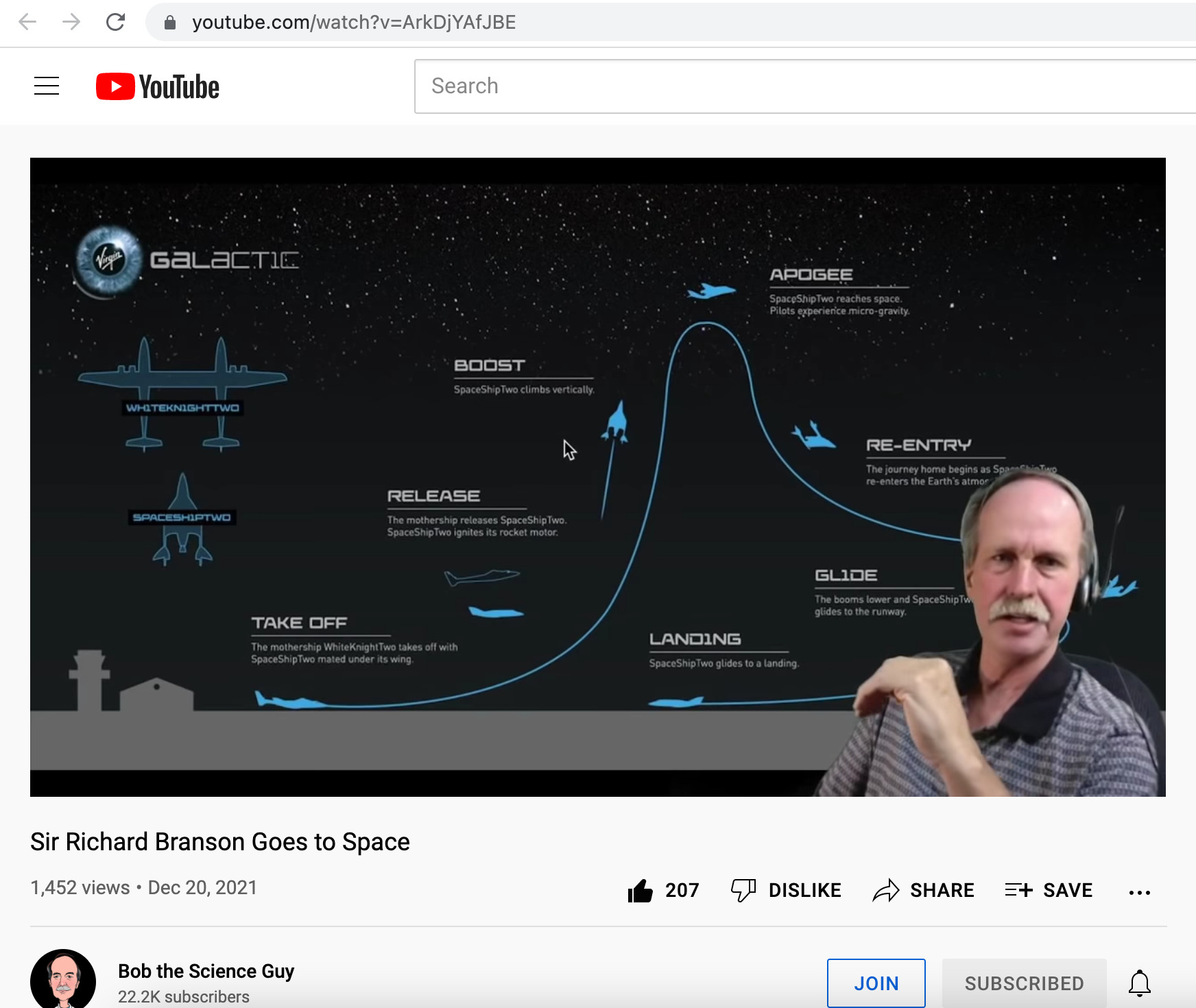
Once exclusively for governments, the 'Space Club' has now opened to private citizens, albeit wealthy ones. Led by Sir Richard Branson, members of the general public are now going on both suborbital and orbital flights.
(Please watch the video at the URL posted above)
- - - - - - - - - - - - - - - - - - - - - - - - - - - - - - - - - - - - - - - - - - - - -
Posted on August 23, 2021
If you are not a scientist...
As such, there are no "legitimate concerns, issues or talking points" from the flat Earth community. What's happening in the world now is a revolution between the stupidity of humanity, and the intelligentsia.


- - - - - - - - - - - - - - - - - - - - - - - - - - - - - - - - - - - - - - - - - - - - -
Posted on August 22, 2021
Creating matter from light for first time (livescience.com)
https://www.livescience.com/einstein-equation-matter-from-light?fbclid=IwAR2TsokM_GHebIId4dDCm57QsucxpvmRNs_b9D5TPdNZtgS8FGMeZlLrzQ8
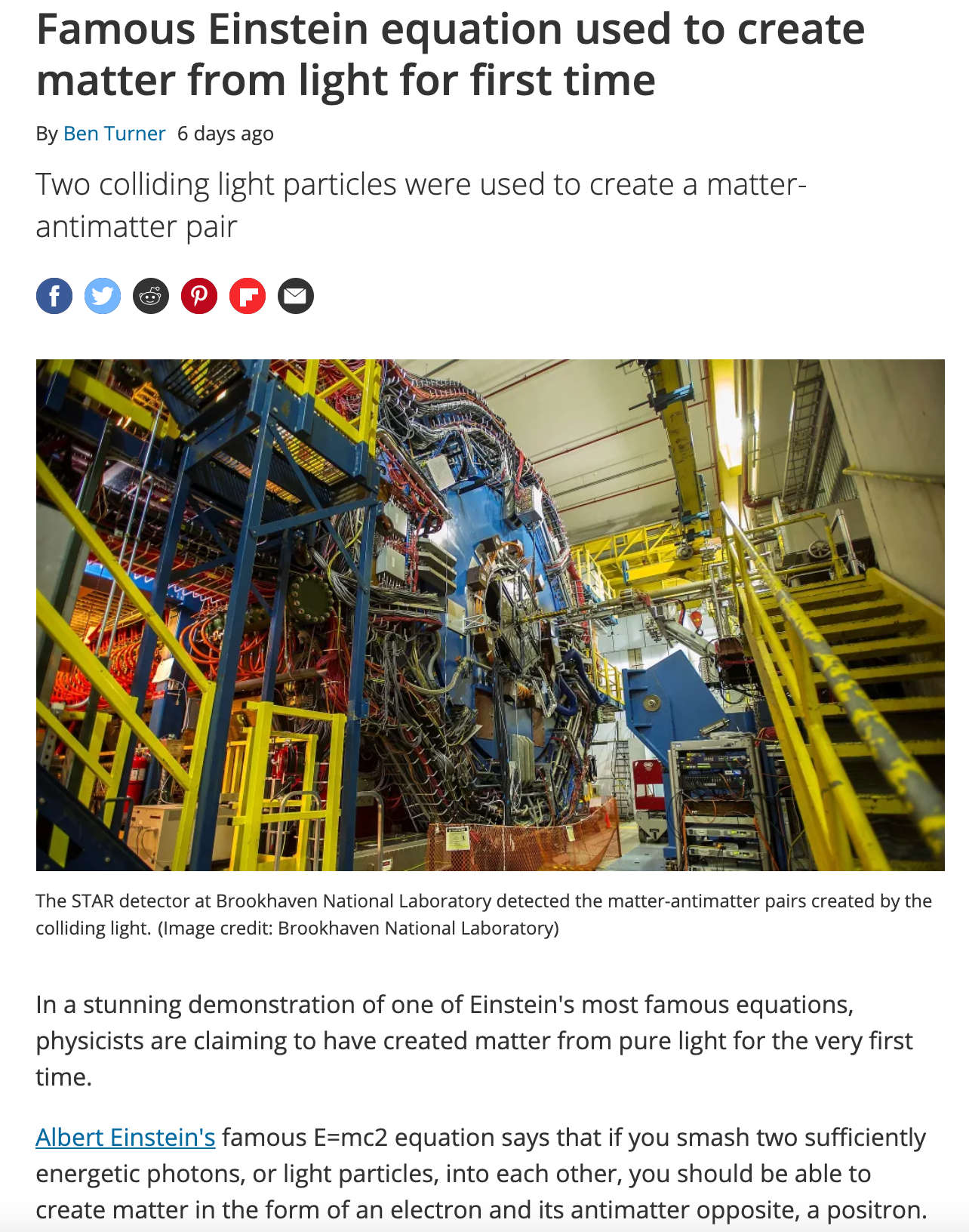
Excerpt:
But this process, first described by American physicists Gregory Breit and John Wheeler in 1934, has long been one of the most difficult to observe in physics — mainly because the colliding photons would need to be highly energetic gamma rays, and scientists are not yet able to make gamma ray lasers. Alternative experiments have shown matter being produced from multiple photons, but never in the one to one way needed to most conclusively prove the effect.
Related: 8 ways you can see Einstein's theory of relativity in real life
But researchers from the Brookhaven National Laboratory in New York now believe they’ve found a workaround. Using the laboratory's Relativistic Heavy Ion Collider (RHIC), they have been able to produce measurements that closely match predictions for the strange transforming act.
"In their paper, Breit and Wheeler already realized this is almost impossible to do," Zhangbu Xu, a physicist at Brookhaven Lab, said in a statement. "Lasers didn't even exist yet! But Breit and Wheeler proposed an alternative: accelerating heavy ions. And their alternative is exactly what we are doing at RHIC."
Instead of accelerating the photons directly, the researchers sped up two ions — atomic nuclei stripped of their electrons and therefore positively charged — in a big loop, before sending them past each other in a near collision. As the ions are charged particles moving very close to the speed of light, they also carry an electromagnetic field with them, inside of which are a bunch of not-quite-real 'virtual' photons "traveling with [the ion] like a cloud," Xu explained.
Virtual particles are particles that only pop into existence very briefly as disturbances in the fields that exist between real particles. They don't have the same masses as their real counterparts (unlike their real counterparts that have no mass, virtual photons do have a mass). In this experiment, when the ions zipped past each other in a near miss, their two clouds of virtual photons were moving so fast they acted as if they were real. The real-acting virtual particles collided — producing a very-much-real electron-positron pair that the scientists detected...
(Please read this article listed in the URL above)
-
https://journals.aps.org/prl/abstract/10.1103/PhysRevLett.127.052302
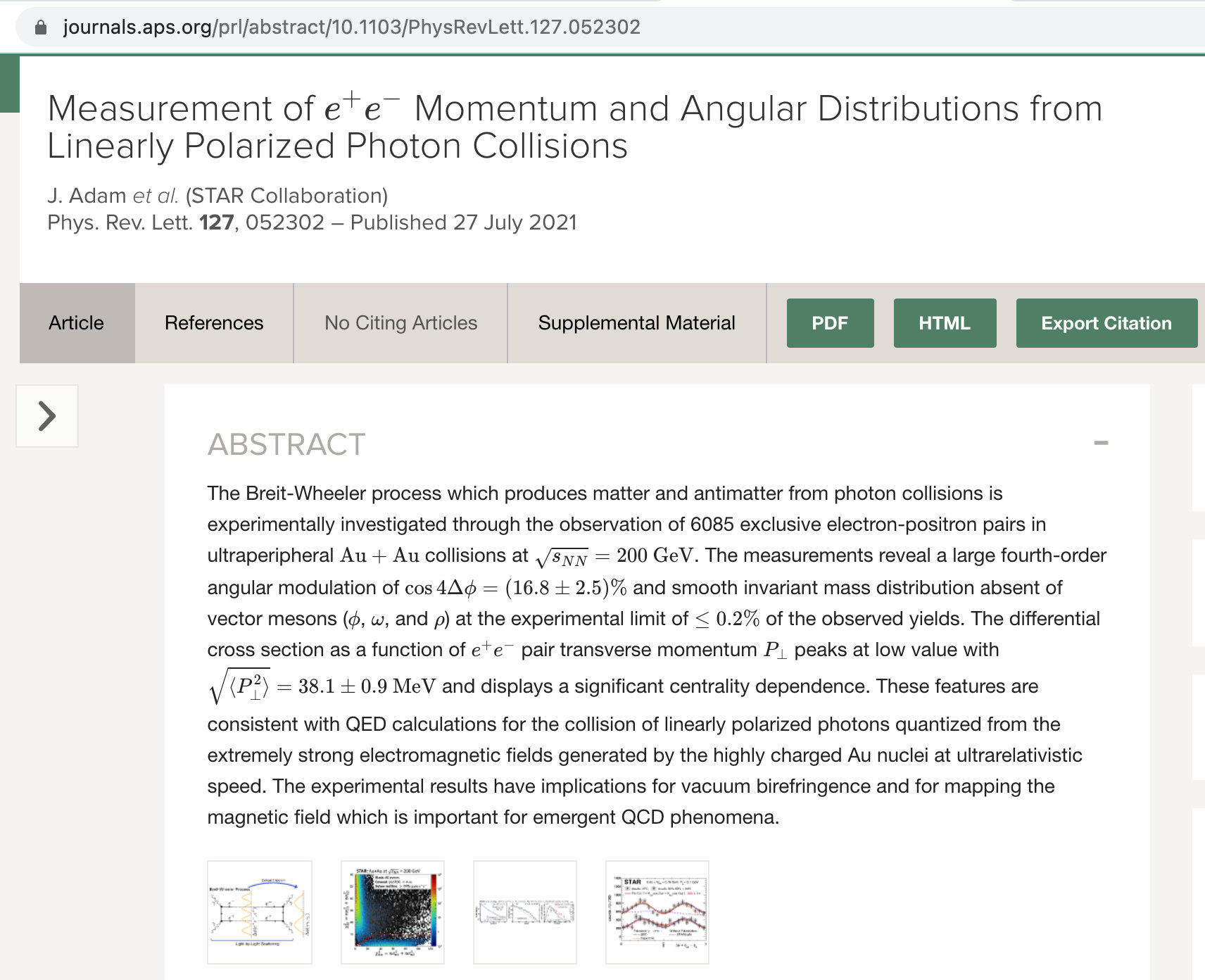
- - - - - - - - - - - - - - - - - - - - - - - - - - - - - - - - - - - - - - - - - - - - -
Posted on August 21, 2021
Solid Evidence of Earth Rotation - Weight Change vs Latitude, by Critical Think
https://www.youtube.com/watch?v=aY2rYv4fqDA
Oops, I did it again. Rotation Confirmed. Observable, repeatable, testable, falsifiable. Evidence of Earth Rotation.
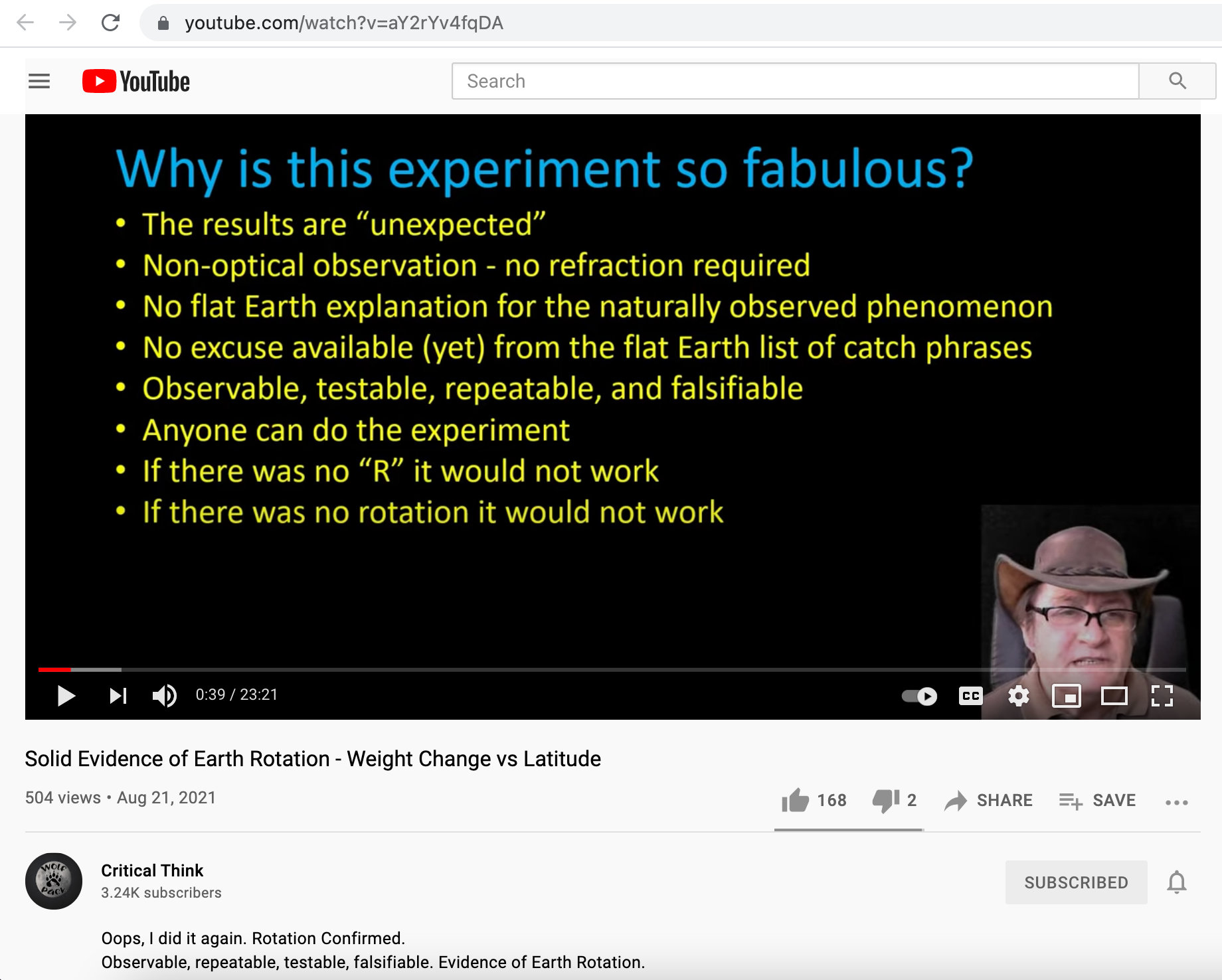
Magnetism is not a force: https://youtu.be/YBbFCwiWlrA
ResearchFlatMoon Weight Change https://youtu.be/8oq6XWPfL8g
Some citations:
https://www.wtamu.edu/~cbaird/sq/mobi...
https://en.m.wikipedia.org/wiki/Centr...
https://www.shimadzu.com/an/service-s...
https://www.forbes.com/sites/startswi...
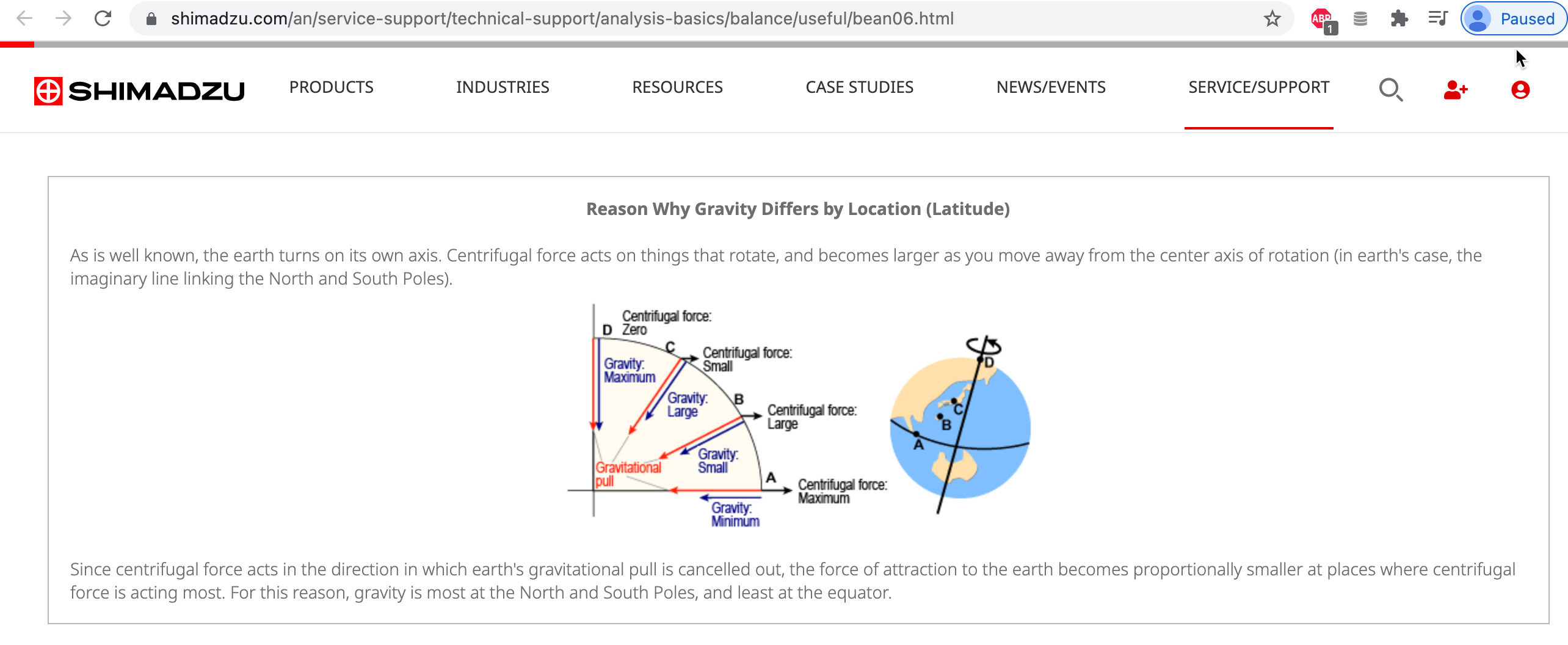
-
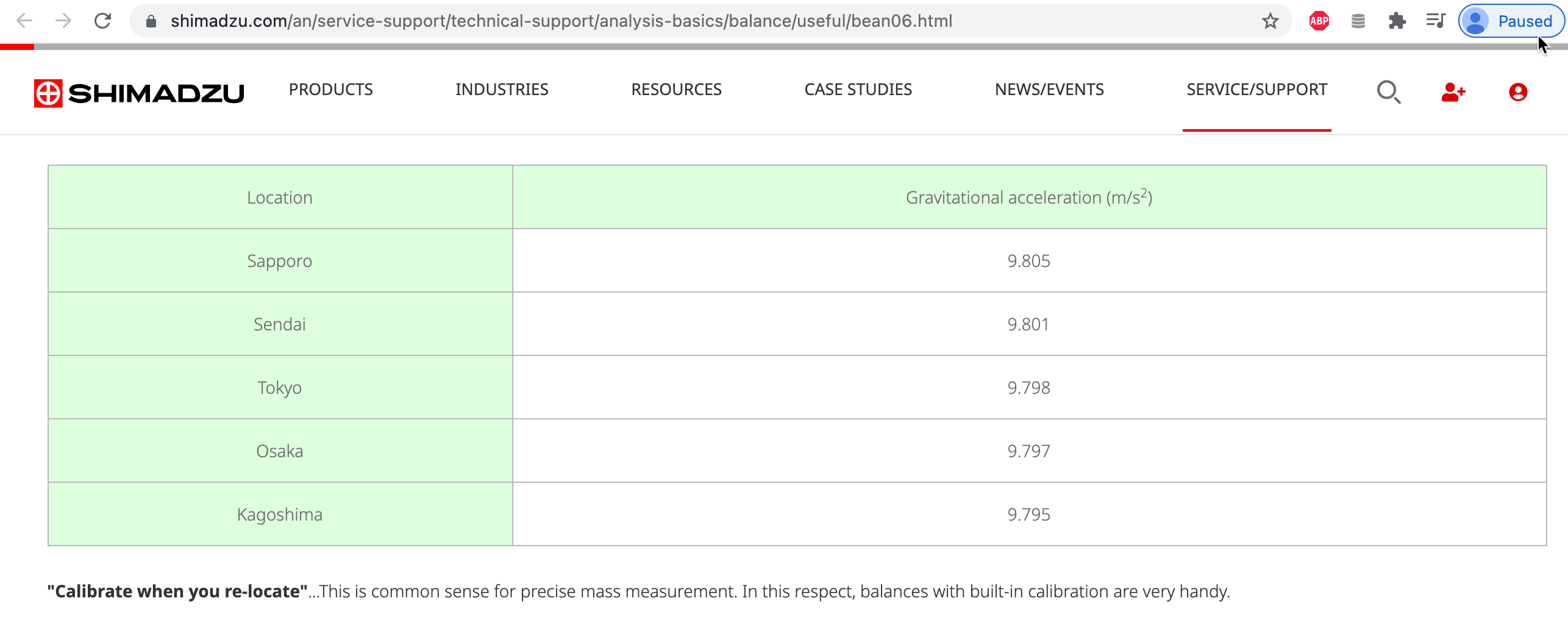
Ref:
Our article published on May 27, 2017 ...
How much you weigh, depends upon where you are on the Earth - because it's a rotating sphere (FlatEarthLunacy.com)
https://flatearthlunacy.com/index.php/2-uncategorised/295-how-much-you-weigh-depends-upon-where-you-are-on-the-earth-because-it-s-a-rotating-sphere
- - - - - - - - - - - - - - - - - - - - - - - - - - - - - - - - - - - - - - - - - - - - -
Posted on August 20, 2021
23rd SpaceX commercial resupply mission launches bone, plant, and materials studies to International Space Station (spaceref.com)
http://spaceref.com/news/viewpr.html?pid=58012.
Download high-resolution photos and videos of the research mentioned in this article.
https://images.nasa.gov/album/SpaceX_CRS-23_Science
REducing Arthritis Dependent Inflammation First Phase
https://www.nasa.gov/mission_pages/station/research/experiments/explorer/Investigation.html?#id=8426
Excerpt from spaceref.com article:
Read about all the great science and health research ongoing in the ISS (International Space Station).
Highlights of the payloads on this resupply mission include:
Building bone with byproducts
READI FP evaluates the effects of microgravity and space radiation on growth of bone tissue and tests whether bioactive metabolites, substances such as antioxidants formed when food is broken down, might protect bones during spaceflight. The metabolites tested come from vegetal extracts generated as waste products in wine production.
Protecting the health of crew members from the effects of microgravity is crucial for the success of future long-duration space missions. This study could improve understanding of the physical changes that cause bone loss and identify potential countermeasures. This insight also could contribute to prevention and treatment of bone loss on Earth, particularly in post-menopausal women. Sourcing metabolites from materials that otherwise would become waste is an additional benefit.
Keeping an eye on eyes
Retinal Diagnostics tests whether a small, light-based device can capture images of the retinas of astronauts to document progression of vision problems known as Space-Associated Neuro-Ocular Syndrome (SANS). The device uses a commercially available lens approved for routine clinical use and is lightweight, mobile, and noninvasive. Videos and images can be downlinked to test and train models for detecting common signs of SANS in astronauts. The investigation is sponsored by ESA (European Space Agency) with the German Aerospace Center (DLR) Institute of Space Medicine and European Astronaut Centre (EAC).
“SANS is present in over two-thirds of astronauts and thought to be associated with long duration (30 days or longer) exposure to microgravity,” said principal investigator Juergen Drescher of DLR. “Currently, visual problems that may manifest from SANS are mitigated by providing glasses or contact lenses to crew members. Multi-year missions to Mars may worsen these symptoms, and there is a need for a mobile device for retinal image diagnostics. While developed for space, this mobile technology has potential to provide diagnostics in remote and extreme environments on Earth at reduced cost. Mobile biomedical diagnostic devices such as these will likely emerge as both an enabler of human deep space exploration and a sustainable model for health care on Earth.”
Robotic helpers
Nanoracks-GITAI Robotic Arm demonstrates the versatility and dexterity in microgravity of a robot designed by GITAI Japan Inc. Results could support development of robotic labor to support crew activities and tasks, as well as servicing, assembly, and manufacturing tasks while in orbit. Robotic support could lower costs and improve crew safety by having robots take on tasks that could expose crew members to hazards. The technology also has applications in extreme and potentially dangerous environments on Earth, including disaster relief, deep-sea excavation, and servicing nuclear power plants. The experiment will be conducted under the pressurized environment inside the Bishop Airlock, the space station’s first commercial airlock.
“This technology demonstration is to show the world that the capabilities necessary for automation in space are finally available,” said company chief technology officer Toyotaka Kozuki. “It provides an inexpensive and safer source of labor in space, opening the door to the true commercialization of space.”
Putting materials to the test
MISSE-15 NASA is one of a series of MISSE investigations testing how the space environment affects the performance and durability of specific materials and components. These tests provide insights that support development of better materials for future spacecraft, spacesuits, planetary structures, and other components needed for space exploration. Testing materials in space has the potential to significantly speed up their development. Materials capable of standing up to space also have potential applications in harsh environments on Earth and for improved radiation protection, better solar cells, and more durable concrete. Alpha Space provides the MISSE-FF lab that hosts these investigations.
“MISSE-15 includes tests of concrete, spacecraft materials, fiberglass composites, thin-film solar cells, radiation protection materials, a micro-optical chip, 3D printed polymers, and more,” said MISSE project engineer Ian Karcher. “In addition, the availability of this platform for commercial technology development contributes to the ongoing commercialization of space and development of new space technologies.”
Helping plants deal with stress
Plants grown under microgravity conditions typically display evidence of stress. APEX-08 examines the role of compounds known as polyamines in the response of thale cress to microgravity stress. Because expression of the genes involved in polyamine metabolism remain the same in space as on the ground, plants do not appear to use polyamines to respond to stress in microgravity. APEX-08 attempts to engineer a way for them to do so. Results could help identify key targets for genetic engineering of plants more suited to microgravity.
“On Earth, polyamines have been shown to contribute significantly to the mitigation of multiple environmental stresses in plants,” said principal investigator Patrick Masson, a professor at University of Wisconsin-Madison. “Altering the metabolism of a polyamine to mitigate the stress of microgravity could have an impact on our ability to use plants as key components of bioregenerative life support systems on long-term space exploration missions. It also may improve our understanding of the molecular mechanisms that allow plants to respond to general environmental stress on Earth, with impacts on agriculture, horticulture, and forestry.”
Easier drug delivery, Girl Scouts send science to space
The Faraday Research Facility is a multipurpose research facility that uses the space station’s EXPRESS racks. On this first flight, the facility hosts a Houston Methodist Research Institute experiment and two STEM collaborations, including “Making Space for Girls” with the Girl Scouts of Citrus Council.
“The ProXopS Faraday Research Facility, developed in partnership with L2 Solutions Inc., is designed to operate remotely and provide a controlled environment for power, command and control, telemetry responses, and safety assurance for microgravity experiments,” said Chad Brinkley, president of ProXopS LLC and L2 Solution Inc. “An added benefit with the facility is that experiments return to the ground for evaluation.”
Faraday-NICE tests an implantable, remote-controlled drug delivery system using sealed containers of saline solution as surrogate test subjects. The device could provide an alternative to bulky, cumbersome infusion pumps, a possible game changer for long-term management of chronic conditions on Earth. Potential problems with such pumps include high infection risk, electromechanical failures, and double dosing. NICE is minimally invasive, implantable, has no moving mechanical components, and does not require catheters. Remote-controlled drug delivery could increase patient compliance, especially for children, elderly, and disabled individuals.
Faraday-Girl Scouts places control experiments with a Girl Scout troop and provides students with images of the same experiments in space. The studies include plant growth, ant colonization, and the brine shrimp lifecycle.
(Please subscribe to spaceref.com and read the above article at the posted URL).
- - - - - - - - - - - - - - - - - - - - - - - - - - - - - - - - - - - - - - - - - - - - -
Posted on August 19, 2021
A new era for precision small telescopes and computerized celestial tracking.
For a modest financial investment all flat Earthers can personally explore the night sky, and put all of their false fallacies to rest.
Our disclosure: We have no financial relationship to the products displayed in this article. It's for informational purposes only.
http://astronomy.tools/

-
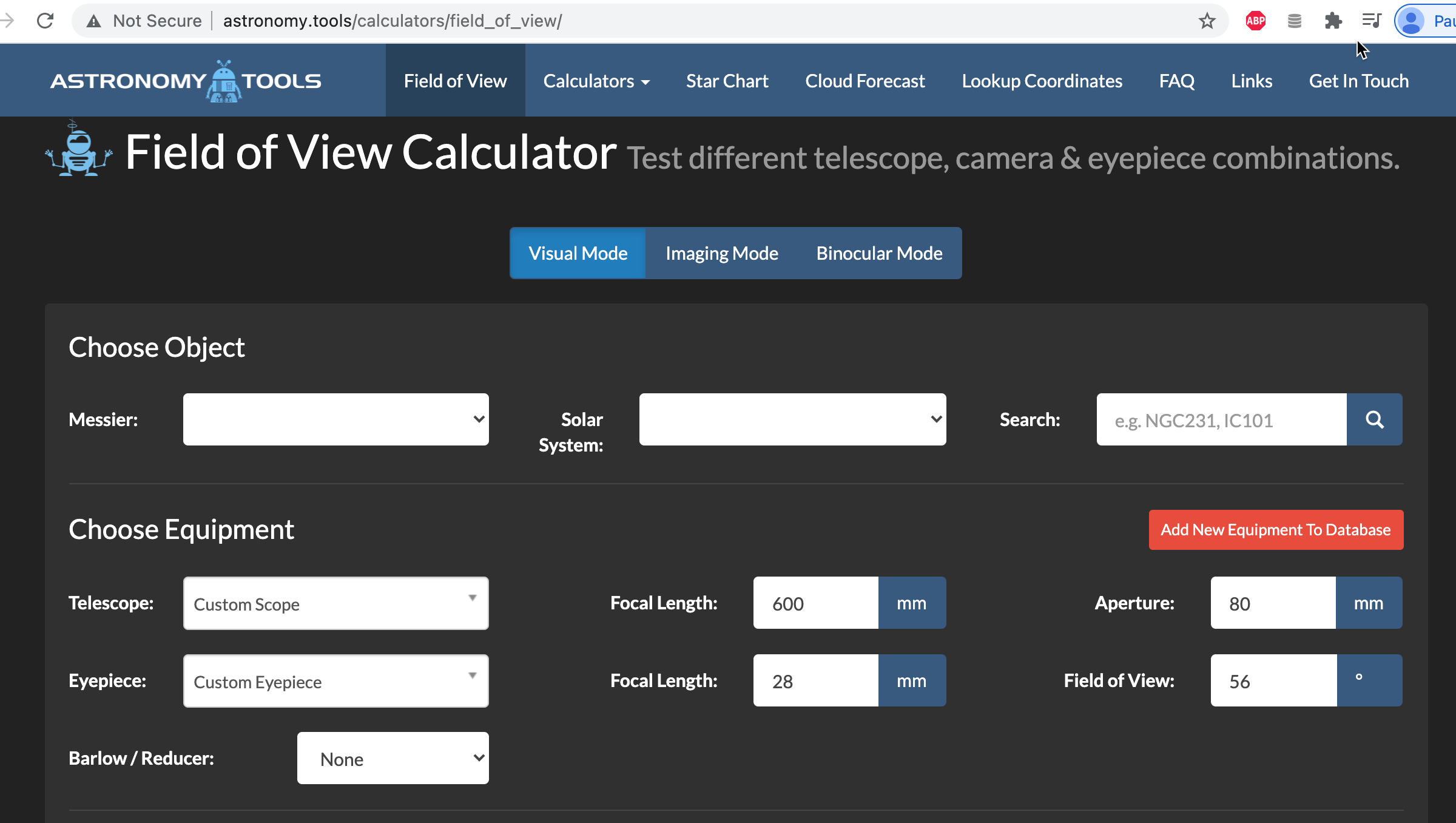
-
The following YouTube videos by Wolfie6020 show how easily anyone can use modern small telescopes + software to view; the Planets and their moons, our Moon, Earth orbiting satellites, meteorites, comets, asteroids, stars and galaxies.
Subscribe to Wolfie6020 (https://www.youtube.com/c/Wolfie6020/videos):
Jupiter hides its moons and choosing the right Flat Earth destroy.. er Equatorial Mount., by Wolfie6020
https://www.youtube.com/watch?v=Bt8vuyLHYyQ
https://optcorp.com/products/sky-watcher-heq5-goto-equatorial-mount
https://optcorp.com/collections/refractor-telescopes/products/sky-watcher-evostar-72-doublet
https://astronomy-imaging-camera.com/
https://www.ap-i.net/skychart/en/start
-
The Equinox is coming - but some Flat Earthers won't do real science if you paid them, by Wolfie6020
https://www.youtube.com/watch?v=DW6I3iOSNU0
-
9 amazing Astronomical Objects you must see with your Binoculars (stargazingmumbai.in)
https://stargazingmumbai.in/9-astronomical-objects-to-see-with-binoculars/
The Moon, planets, open star clusters, globular clusters, binary stars, nebula, galaxies, comets & asteriods, and Milky Way Galaxy.
Orion's Top 25 Binocular Targets (telescopes.com)
https://www.telescope.com/Orions-Top-25-Binocular-Targets/p/106519.uts
At Orion, we spend a lot of time under the stars. Sometimes we use a telescope, sometimes we use our plain old eyeballs, but much of the time, we keep both eyes open and use a pair of binoculars. Just about any type of binocular will show you something in the sky, but we generally use binoculars of 40mm diameter or larger; a lot of people prefer 50mm or larger. As with a telescope, the darker the sky, the more you will see, and you'll be amazed what you can see with binoculars under a dark sky!
Spring
- M44, The Beehive
- M81 & M82, a face-on and edge-on Galaxy Pair
- M65 & M66, a Galaxy Pair
- NGC 253 & NGC 288, a Galaxy and Globular Pair
- M101, The Pinwheel Galaxy
- M51
- M108
- Omega Centauri
Summer
- M8/M20 Complex
- M16
- M17
- M22
- The North America Nebula
- M27, The Dumbbell Nebula
- M13, the Great Cluster in Hercules
Fall
- M45, The Pleiades
- NGC 869 and NGC 884, The Double Cluster in Perseus
- M31, The Andromeada Galaxy
- M33, The Triangulum Galaxy
- The Helix Nebula
Winter
- Orion Nebula, M42
- Rosette Nebula
- M36/M37/M38, a trio of Open Clusters in Auriga
- M47/M46, a pair of Open Star Clusters
- M78
- - - - - - - - - - - - - - - - - - - - - - - - - - - - - - - - - - - - - - - - - - - - -
Posted on August 10, 2021
Prominent flat Earther "Whitsit" gets arrested. "Free speech" is not free from repercussions.
Debunk by Creaky Blinder
Idiot Flat Earth Auditor Gets Arrested, by Creaky Blinder
https://www.youtube.com/watch?v=VDuLgZ_xpMw
Idiot Flat Earth Auditor Gets Arrested, Flat Earther "Witsit Gets It" gets himself in trouble while spreading the Flat Earth message at Mount Rushmore.
Video on Witsit's channel
https://www.youtube.com/watch?v=13bO5kU8NRg
-
Our related material:
Austin Whitsitt (The Official Flat Earth and Globe Discussion Group, on Facebook) - flat Earth advocate FAIL
https://flatearthlunacy.com/index.php/2-uncategorised/1317-austin-whitsitt-the-official-flat-earth-and-globe-discussion-group-on-facebook-flat-earth-advocate-fail
- - - - - - - - - - - - - - - - - - - - - - - - - - - - - - - - - - - - - - - - - - - - -
Posted on August 8, 2021
Olympics on the ISS (International Space Station). "Look Ma, no hands (or harness)."
The International Space Station Harness Their Olympic Excitement, by WheresWally
https://www.youtube.com/watch?v=5ez8S6GWGX
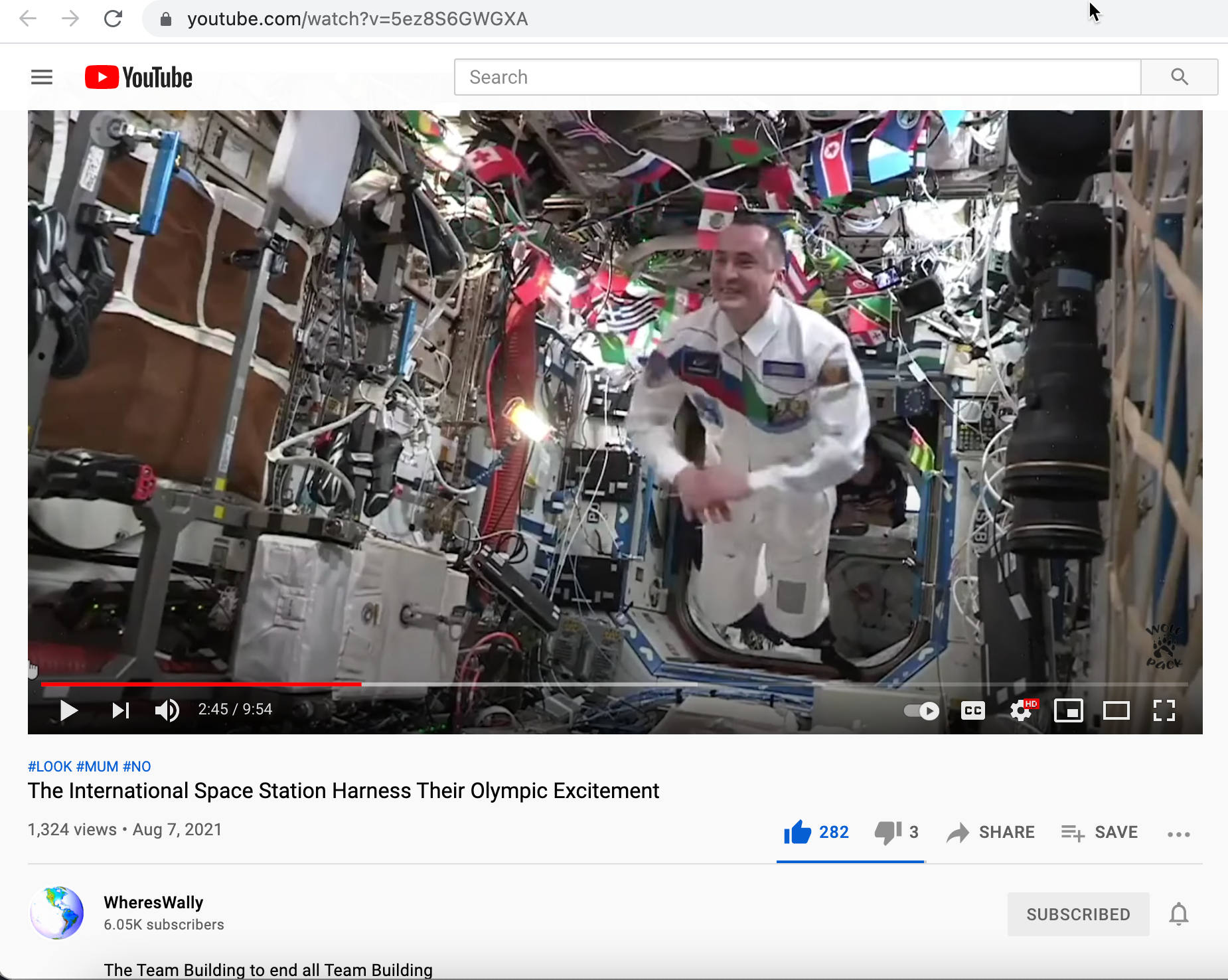
The Team Building to end all Team Building
Lack-of-floor routine – much clapping to Pyotr for completing his routine without touching anything, a difficult feat! https://twitter.com/Thom_astro/status...
No-handball – we had to adapt the rules a bit during the match, much investment on both sides for the win.
https://twitter.com/Thom_astro/status...
Synchronised space swimming – an opportunity to show teamwork and crew cohesion.
https://twitter.com/Thom_astro/status...
Weightless sharpshooting – concentration and skill (or luck) proved necessary to reach the target. https://twitter.com/Thom_astro/status...
- - - - - - - - - - - - - - - - - - - - - - - - - - - - - - - - - - - - - - - - - - - - -
Posted on August 7, 2021
FlatEarthLunacy posts and articles are not static.
We update them as soon as new data becomes available. So it pays to revisit your reads every now and then.
Flat Earth Pilot (Knowledge) - flat Earth advocate FAIL
https://flatearthlunacy.com/index.php/2-uncategorised/1508-flat-earth-pilot-knowledge-flat-earth-advocate-fail
Eric Dubay (Eric Michaels) - flat Earth advocate FAIL
https://flatearthlunacy.com/index.php/2-uncategorised/203-eric-dubay-eric-michaels-flat-earth-advocate-fail
Quantum Eraser (John) - flat Earth advocate FAIL
https://flatearthlunacy.com/index.php/2-uncategorised/1187-quantum-eraser-john-flat-earth-advocate-fail
For all you flat Earth COVID-19 deniers...
https://flatearthlunacy.com/index.php/2-uncategorised/1424-flat-earth-not-flatearthlunacy-articles-for-reference-s#S95
Phuket Word (Nick Davies) - Flat Earth advocate FAIL: More Anti Flat Earth Globe Cult Ignorance & Dishonesty DEBUNKED
https://flatearthlunacy.com/index.php/2-uncategorised/970-phuket-word-nick-davies-flat-earth-advocate-fail-more-anti-flat-earth-globe-cult-ignorance-dishonesty-debunked
Wireless Dangers Australia (Mark Steele) - 5G advocate making up false claims about that communications network.
https://flatearthlunacy.com/index.php/2-uncategorised/1419-wireless-dangers-australia-mark-steele-5g-advocate-making-up-false-claims-about-that-communications-network
Adam i Fe (Level Earth Observer) - flat Earth advocate FAIL - does not understand the difference between curvature and elevation
https://flatearthlunacy.com/index.php/2-uncategorised/935-adam-i-fe-level-earth-observer-flat-earth-advocate-fail-does-not-understand-the-difference-between-curvature-and-elevation
LEVEL (2021) - movie review
https://flatearthlunacy.com/index.php/2-uncategorised/1483-level-2021-movie-review
New analysis by Sly Sparkane confirms that FECORE's 2018 Lake Balaton Laser Test, was an "I can see the laser" from a distance of 12.6 km (easily explained by refraction), not from 40.2 km as they advertised and claimed.
https://flatearthlunacy.com/index.php/2-uncategorised/1522-flat-earth-not-flatearthlunacy-articles-for-reference-r#R13
China lands its Zhurong rover on Mars (bbc.com)
https://flatearthlunacy.com/index.php/2-uncategorised/1522-flat-earth-not-flatearthlunacy-articles-for-reference-r#R12
Ranty! & Ranty Flat Earth (Shane Cook) - from flat Earth advocate FAIL, to globe Earth champion
https://flatearthlunacy.com/index.php/2-uncategorised/780-ranty-ranty-flat-earth-shane-cook-from-flat-earth-advocate-fail-to-globe-earth-champion
Brian Mullin - flat Earth advocate FAIL
https://flatearthlunacy.com/index.php/2-uncategorised/43-brian-mullin-flat-earth-advocate-fail
Gravity = Buoyancy + Density, according to flat earthers. But then should not helium balloons just float in a vacuum chamber on Earth since Buoyancy is then ZERO? Well, that does not happen.
https://flatearthlunacy.com/index.php/2-uncategorised/1424-flat-earth-not-flatearthlunacy-articles-for-reference-s#S115
Contrary to flat Earth denial, the distance to the Sun is well known (93-million miles)
https://flatearthlunacy.com/index.php/archive/2-uncategorised/1040-flat-earth-not-flatearthlunacy-articles-for-reference-w#W29
Hope, Tianwen-1, and Perseverance (todate the 9th craft to land) - Mars 2021. UAE's Hope mission is now orbiting Mars, by Theresa Wiegert (earthsky.org). The United Arab Emirates mission to Mars – called “Hope” – successfully entered Mars orbit today.
https://flatearthlunacy.com/index.php/2-uncategorised/1424-flat-earth-not-flatearthlunacy-articles-for-reference-s#S118
Nathan Oakley - flat Earth advocate FAIL
https://flatearthlunacy.com/index.php/2-uncategorised/494-nathan-oakley
etc.
- - - - - - - - - - - - - - - - - - - - - - - - - - - - - - - - - - - - - - - - - - - - -
Posted on August 4, 2021
The ISS orbit visualized on the flat earth map (Azimuthal equidistant projection), by Janosch Gaia
https://www.youtube.com/watch?v=foQpkvW_N2U&t=0s
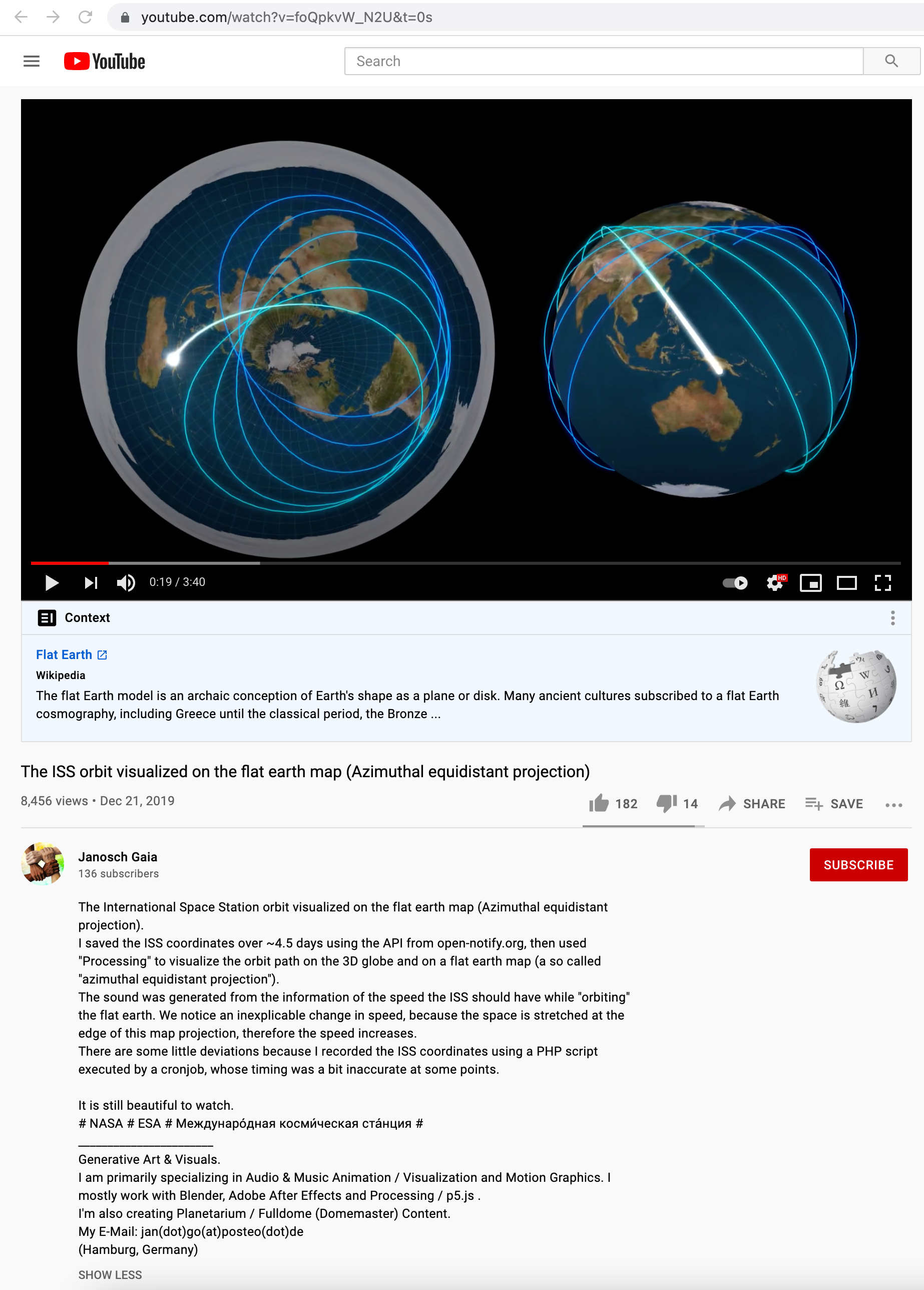 te
te
Janosch Gaia channel - https://www.youtube.com/channel/UCcxosBTtCqmR3Nisk0Y7s6w/videos
- - - - - - - - - - - - - - - - - - - - - - - - - - - - - - - - - - - - - - - - - - - - -
Posted on August 4, 2021
Walter Bislin's - Advanced Earth Curve Calculator
http://walter.bislins.ch/bloge/index.asp?page=advanced+earth+curvature+calculator
How to use it, understand the components, and what's behind the math
Decoding the Curve Calculator, by Bob the Science Guy
https://www.youtube.com/watch?v=tNBapcVgp98
In this episode we look at the curve calculator, fully explaining both the straight calculator and how it is adjusted for refraction. Right Triangles and the Pythagorean Theorem are covered, along with a discussion of refraction.
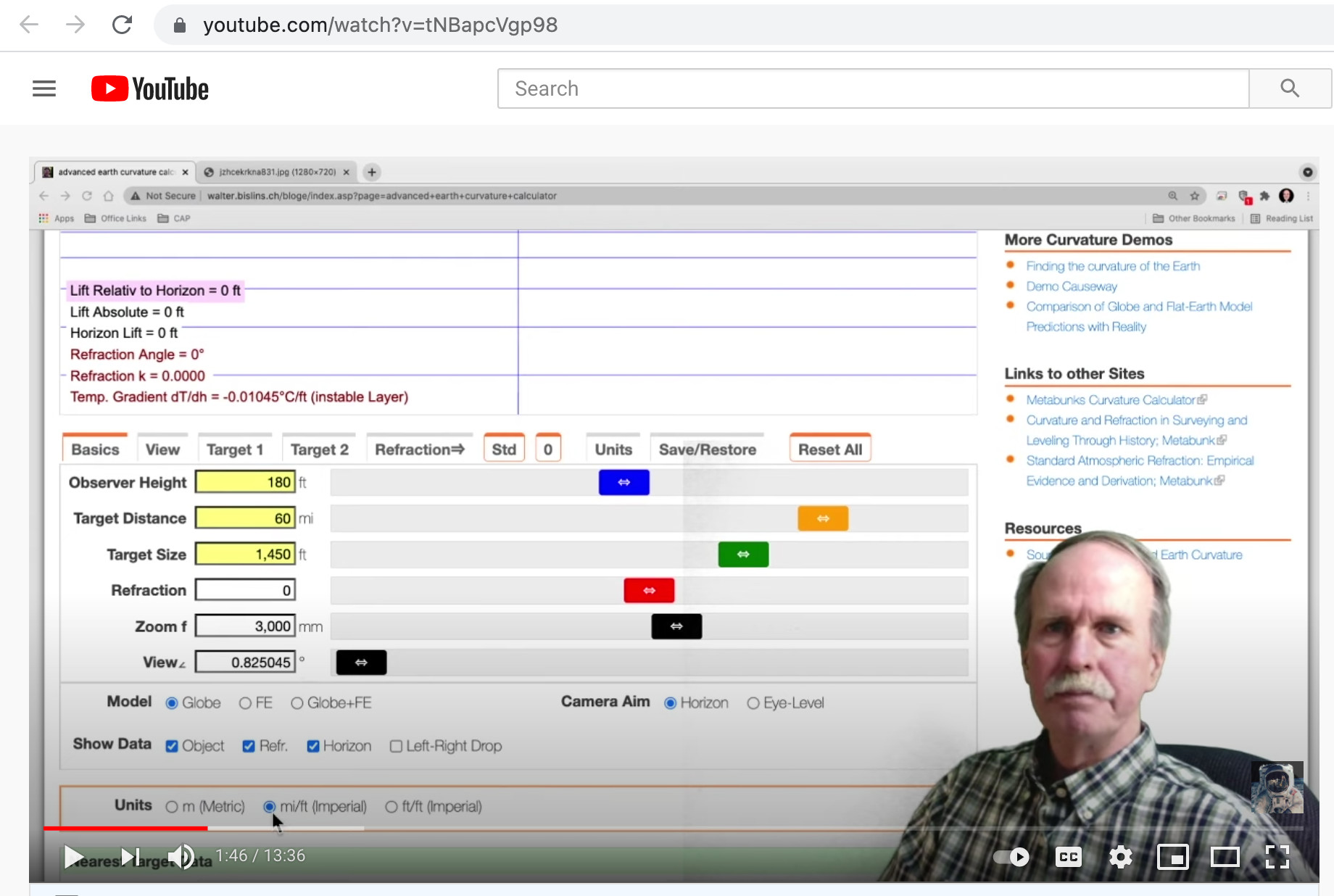
- - - - - - - - - - - - - - - - - - - - - - - - - - - - - - - - - - - - - - - - - - - - -
Posted on August 3, 2021
NASA funds hopper to explore lunar polar craters (Arizona State University News)
https://news.asu.edu/20210720-nasa-funds-hopper-explore-lunar-polar-craters
Flat Earth and Moon Landing Deniers (lying) are on the wrong side of history.
-
Excerpt from the Arizona State article:
Arizona State University is partnering with Intuitive Machines on a mini extreme mobility lunar vehicle, called Micro-Nova, that will hop around the moon’s surface and take the first-ever pictures inside craters close to the lunar south pole.
On July 16, 2021, NASA awarded the project a $41.6 million “Tipping Point” contract to develop, fly and operate a deployable lunar “hopper lander” on the moon. For this mission design, Micro-Nova can carry a 1-kilogram payload more than 2.5 kilometers to access lunar craters and enable high-resolution surveying of the lunar surface under the flight path.
Intuitive Machines' Micro-Nova is our first-ever chance to explore from within a lunar permanently shaded region (PSR),” said the mission science lead Mark Robinson, of ASU’s School of Earth and Space Exploration. “We will be able to take very high resolution color images near the hopper and black and white images of about half the PSR. What will we see, that is the question!”
Micro-Nova will be equipped to provide high resolution stereo images in areas that are in direct sunlight, which will also enable detailed engineering and science planning for future missions.
“This quick trip into a PSR will provide critical engineering information for designing larger-scale exploration over the next decade,” Robinson said. “And we will gain valuable insight to the distribution and migration of volatiles (water) in the lunar environment.”
The hopper will also measure the temperature of the PSR, which will be very cold. Estimates range from about 40 to 80 Kelvin (-388°F to -316°F). Hopper measurements will provide a test of the current temperature models of these areas, which is critical information for other upcoming missions planned to enter PSRs.
With landing gear, Micro-Nova is about 76.2 centimeters in length, width and height, which is roughly the size of five $1 bills. Intuitive Machines engineers will mount Micro-Nova on a nearly 4-meter Nova-C lander, which is about the size of a Volkswagen Beetle. Nova-C will deliver Micro-Nova to the lunar south pole in December 2022.
(Please read the full article at the URL posted above)
-
Intuitive Machines and NASA Finalize Contract for Extreme Lunar Mobility Spacecraft (intuitivemachines.com)
https://www.intuitivemachines.com/post/intuitive-machines-and-nasa-finalize-contract-for-extreme-lunar-mobility-spacecraft
- - - - - - - - - - - - - - - - - - - - - - - - - - - - - - - - - - - - - - - - - - - - -
Posted on August 2, 2021
CERN Discover New Tetraquark Particle (sci-news.com)
http://www.sci-news.com/physics/new-tetraquark-particle-09917.html
Excerpt:
The new exotic particle discovered by physicists from the LHCb Collaboration at CERN’s Large Hadron Collider (LHC) contains two quarks and two antiquarks. Labeled Tcc+, it is the longest-lived exotic particle ever discovered and the first to contain two heavy quarks and two light antiquarks.
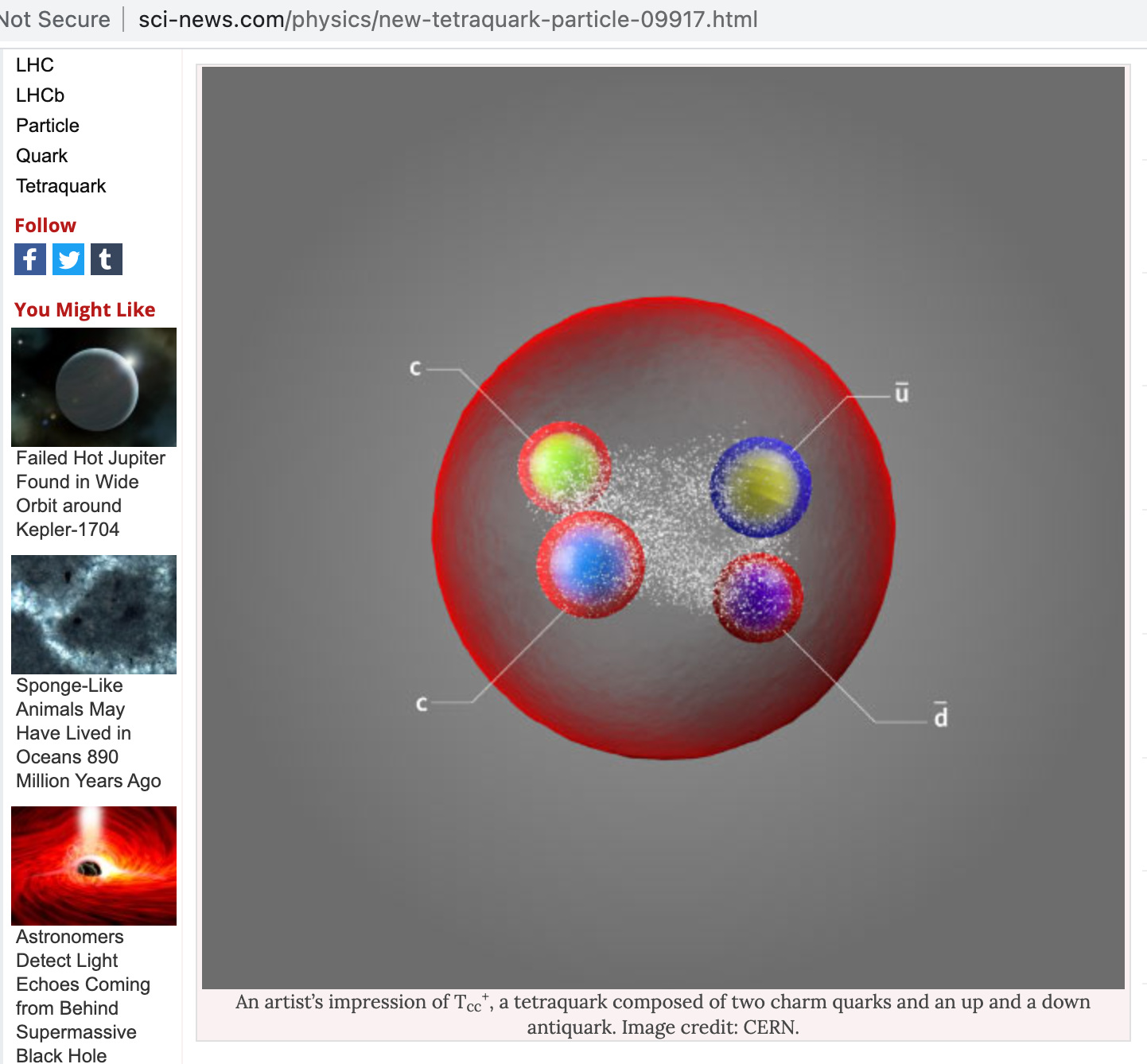
Quarks are the fundamental building blocks from which matter is constructed.
They combine to form hadrons, namely baryons, such as the proton and the neutron, which consist of three quarks, and mesons, which are formed as quark-antiquark pairs.
Several tetraquark particles have been discovered in recent years, but Tcc+ is the first one that contains two charm quarks, without charm antiquarks to balance them. Physicists call this ‘open charm’ (in this case, ‘double open charm’).
Particles containing a charm quark and a charm antiquark have ‘hidden charm’ — the charm quantum number for the whole particle adds up to zero, just like a positive and a negative electrical charge would do. Here the charm quantum number adds up to two, so it has twice the charm.
Tcc+ is also the first particle to be found that belongs to a class of tetraquarks with two heavy quarks and two light antiquarks.
Such particles decay by transforming into a pair of mesons, each formed by one of the heavy quarks and one of the light antiquarks...
(Please read this entire article posted at the URL above)
- - - - - - - - - - - - - - - - - - - - - - - - - - - - - - - - - - - - - - - - - - - - -
Posted on July 30, 2021
Jupiter X-Ray Aurora Mystery Solved, After 40 Years (earthsky.org)
https://earthsky.org/space/jupiter-xray-aurora-mystery-solved/
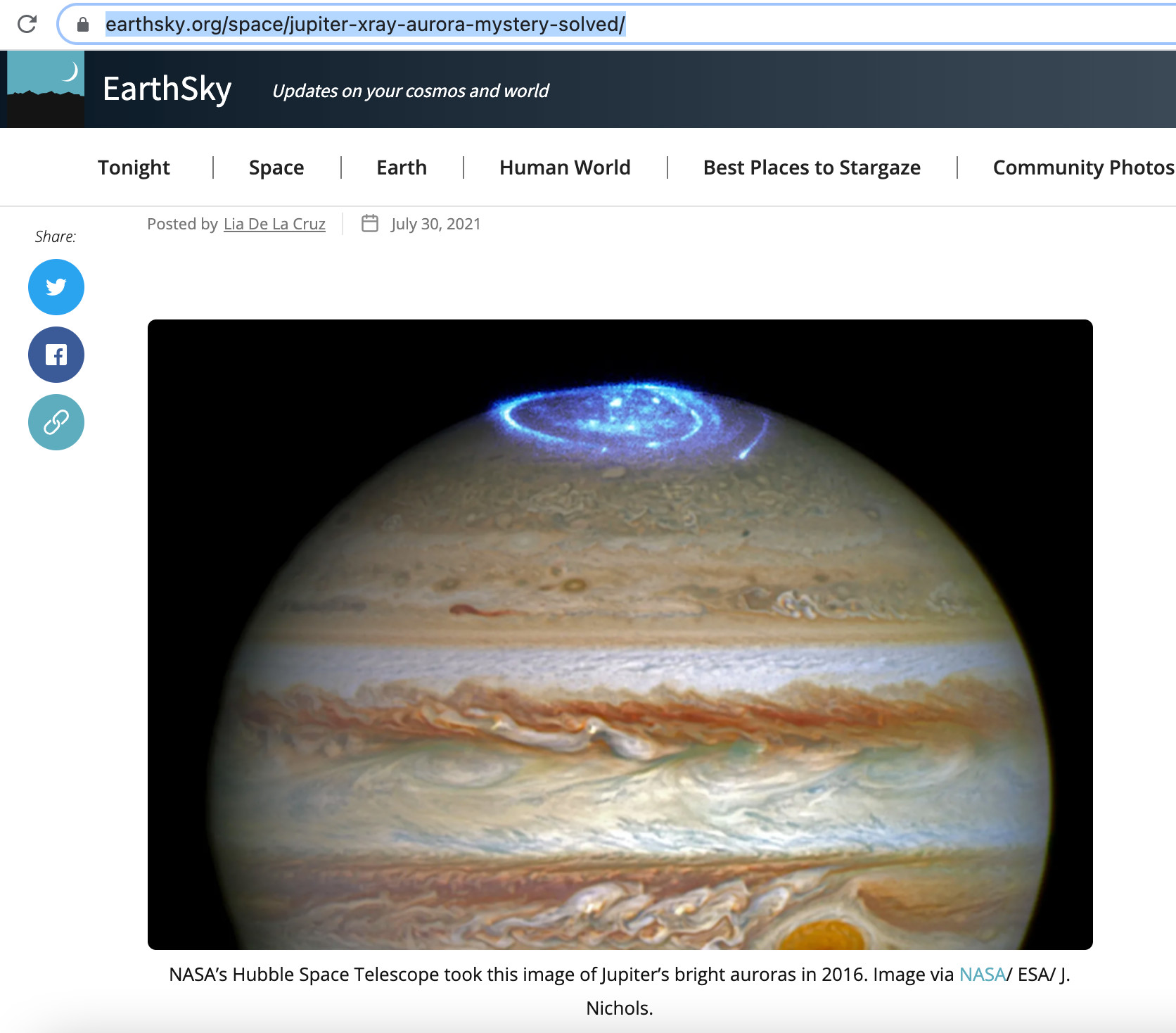
Excerpt:
In that statement, planetary astronomers were announcing that they’d just solved a 40-year-old mystery about the origins of Jupiter’s unusual X-ray auroras. They did it by combining measurements from NASA’s Juno spacecraft – now in orbit around Jupiter – with data from the European Space Agency’s Earth-orbiting XMM-Newton mission. For the first time, these scientists said, they’ve seen the entire aurora-making mechanism at work. They’ve seen that electrically charged atoms, or ions, responsible for the X-rays are surfing electromagnetic waves in Jupiter’s magnetic field down into the gas giant’s atmosphere.
The peer-reviewed journal Science Advances published this new work earlier this month.
(Please read the article posted at the URL above)
- - - - - - - - - - - - - - - - - - - - - - - - - - - - - - - - - - - - - - - - - - - - -
Posted on July 28, 2021
When to watch the ISS (International Space Station) cross your night sky.
For years flat Earthers said the ISS was not real, and definitely not in space. But after so many civilian and amateur astronomer sightings of the ISS, they moved the goal posts to now say that humans do not live on the ISS. But that charade will also fail soon since it's categorically false.
Get yourself an app for your smart phone.
ISS spotter at the Apple store:
https://apps.apple.com/us/app/iss-spotter/id523486350
Spot The Station will give you a list of upcoming space station sighting opportunities for your location:
https://spotthestation.nasa.gov/sightings/index.cfm
... and many others for all systems are available.
- - -
How to See the International Space Station (ISS), by Fraser Cain
https://www.youtube.com/watch?v=NNsCMBKFakk
Did you know that the International Space Station (ISS) is one of the brightest objects in the night sky? You just need to know where, and when to look. Universe Today publisher Fraser Cain fills you in on the tools you can use to locate the station for its next pass overhead.
Based on this article from Universe Today http://www.universetoday.com/93584/be...
- - - - - - - - - - - - - - - - - - - - - - - - - - - - - - - - - - - - - - - - - - - - -
Posted on July 27, 2021
Satellites in space benefit humanity every day, in more ways than we can count.
Landsat 9 At Work (NASA Goddard)
https://www.youtube.com/watch?v=Af8gJ0RVyaY
Landsat 9, which NASA is launching in September 2021, will collect the highest quality data ever recorded by a Landsat satellite, while still ensuring that these new measurements can be compared to those taken by previous generations of the Earth-observing satellite.
For nearly half a century, the Landsat mission has shaped our understanding of Earth. Since the launch of the first Landsat satellite in 1972, the mission has gathered and archived more than 8 million images of our home planet’s terrain, including crop fields and sprawling cities, forests and shrinking glaciers. Landsat 9 will continue and extend that long-running mission to map our home planet.
The Landsat Program is a series of Earth-observing satellite missions jointly managed by NASA and the U.S. Geological Survey (USGS). Landsat satellites have been consistently gathering data about our planet since 1972. They continue to improve and expand this unparalleled record of Earth's changing landscapes for the benefit of all.
(Please watch the video at the URL posted above)
- - - - - - - - - - - - - - - - - - - - - - - - - - - - - - - - - - - - - - - - - - - - -
Posted on July 21, 2021
Astronomers may have captured a moon's creation in conjunction with a proto-planet birth.
ALMA Detects Circumplanetary Disk around Young Exoplanet PDS 70c (sci-news.com)
http://www.sci-news.com/astronomy/alma-circumplanetary-disk-pds-70c-09889.html
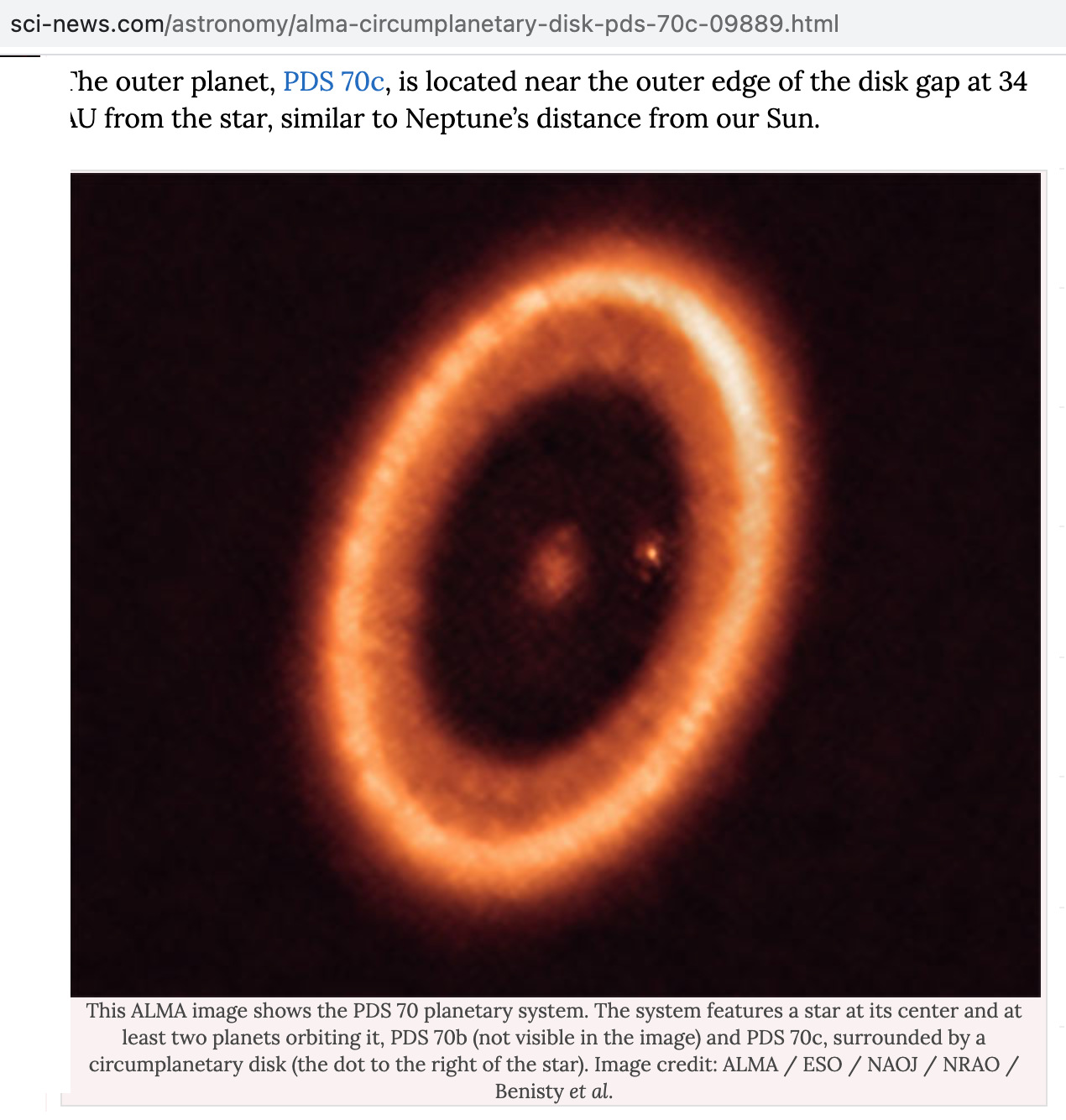
Excerpt:
Astronomers using the Atacama Large Millimetre/submillimeter Array (ALMA) have detected a circumplanetary disk — a ring-shaped area where moons and other satellites may form — around a protoplanet in the PDS 70 system.
PDS 70 is a K7-type star located 370 light-years away in the constellation of Centaurus.
Also known as V* V1032 Cen and IRAS 14050-4109, the star is only 5.4 million years old.
It hosts two protoplanets and a huge circumstellar disk of dust and gas in which a large region from 20 to 40 AU is cleared of dust.
The inner planet, PDS 70b, is located within the disk gap at a distance of about 22 AU from the star, similar to the orbit of Uranus in our Solar System.
The outer planet, PDS 70c, is located near the outer edge of the disk gap at 34 AU from the star, similar to Neptune’s distance from our Sun.
“Our work presents a clear detection of a disk in which satellites could be forming,” said Dr. Myriam Benisty, an astronomer at the University of Grenoble and the University of Chile.
“The new ALMA observations were obtained at such exquisite resolution that we could clearly identify that the disk is associated with PDS 70c and we are able to constrain its size for the first time.”
Dr. Benisty and colleagues also found that PDS 70c’s disk has about the same diameter as the distance from our Sun to the Earth and enough mass to form up to three satellites the size of the Moon.
“These new observations are also extremely important to prove theories of planet formation that could not be tested until now,” said Dr. Jaehan Bae, an astronomer in the Earth and Planets Laboratory at the Carnegie Institution for Science...
(Please read the article at the URL posted above)
- - - - - - - - - - - - - - - - - - - - - - - - - - - - - - - - - - - - - - - - - - - - -
Posted on July 21, 2021
Jeff Bezo's Blue Origin historic flight today. Now the youngest and oldest space pioneers tell their story.
Onboard are Jeff Bezos, his brother Mark Bezos; aviation trailblazer Wally Funk, who will be the oldest person ever to fly in space at 82 years old; and Oliver Daemen, 18, a Dutch student who will be the youngest person ever to launch.
Watch: Jeff Bezos, Blue Origin Crew Launch Into Space | NBC News
https://www.youtube.com/watch?v=4SSVr3EKTlM
Watch live coverage as billionaire Jeff Bezos attempts to fly to the edge of space aboard a rocket and capsule developed by his private space company, Blue Origin.
Jeff Bezos Speaks After Successful Launch Into Space | NBC News
https://www.youtube.com/watch?v=ks0LESnAbYU
Watch live coverage as Jeff Bezos holds a press conference following his successful flight to space with Blue Origin.
For those flat Earthers who will now claim that the Shepard's windows distort the actual view of space, hang your head in shame...
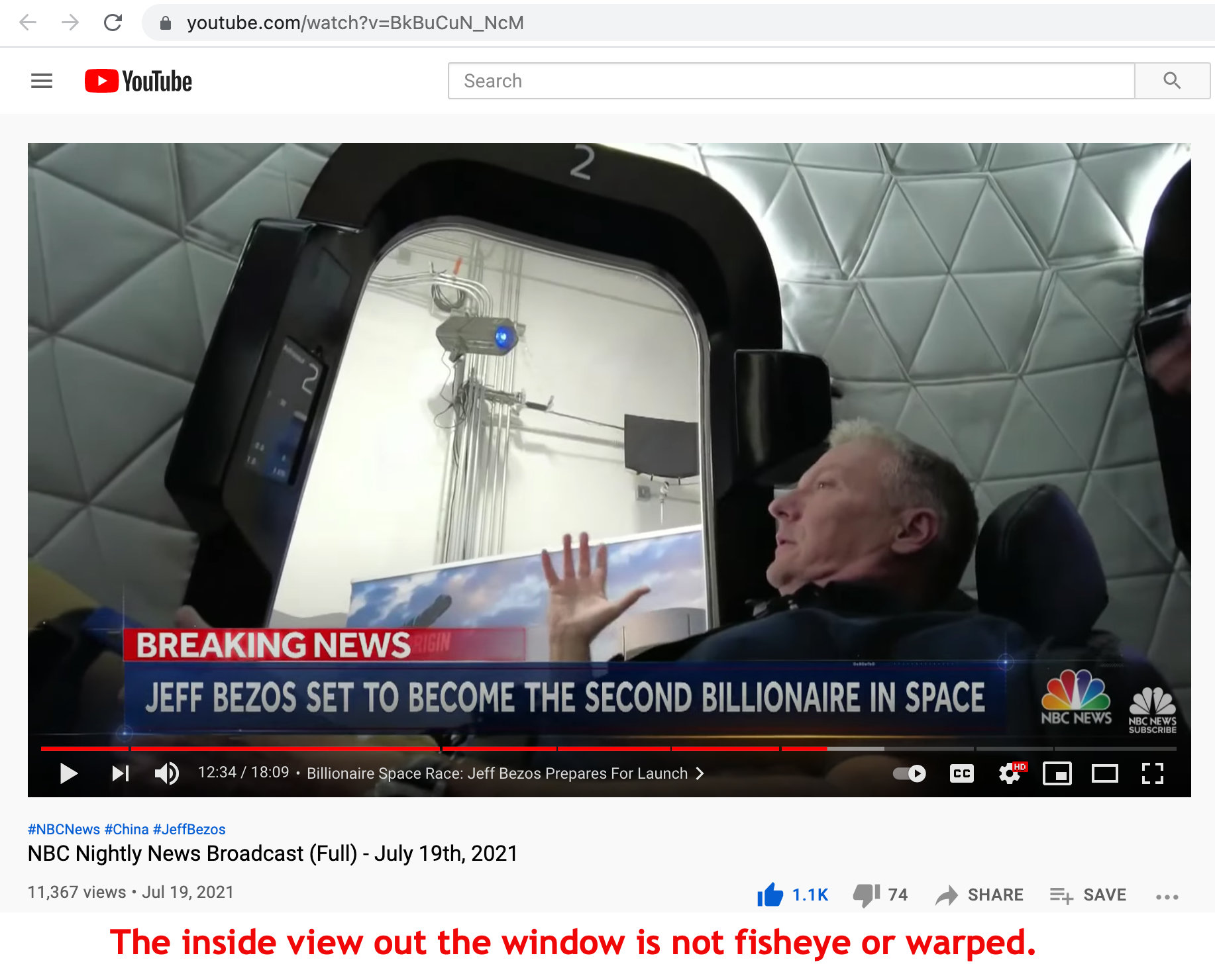
- - - - - - - - - - - - - - - - - - - - - - - - - - - - - - - - - - - - - - - - - - - - -
Posted on July 18, 2021
How Airplanes follow the Curvature of the Earth, Physics Simulation, by Walter Bislin
Will this help put an end to the INCORRECT flat Earth claim - that an airplane must constantly descend to follow the curvature of the Earth?
http://walter.bislins.ch/bloge/?page=How+Airplanes+follow+the+Curvature+of+the+Earth%2C+Physics+Simulation
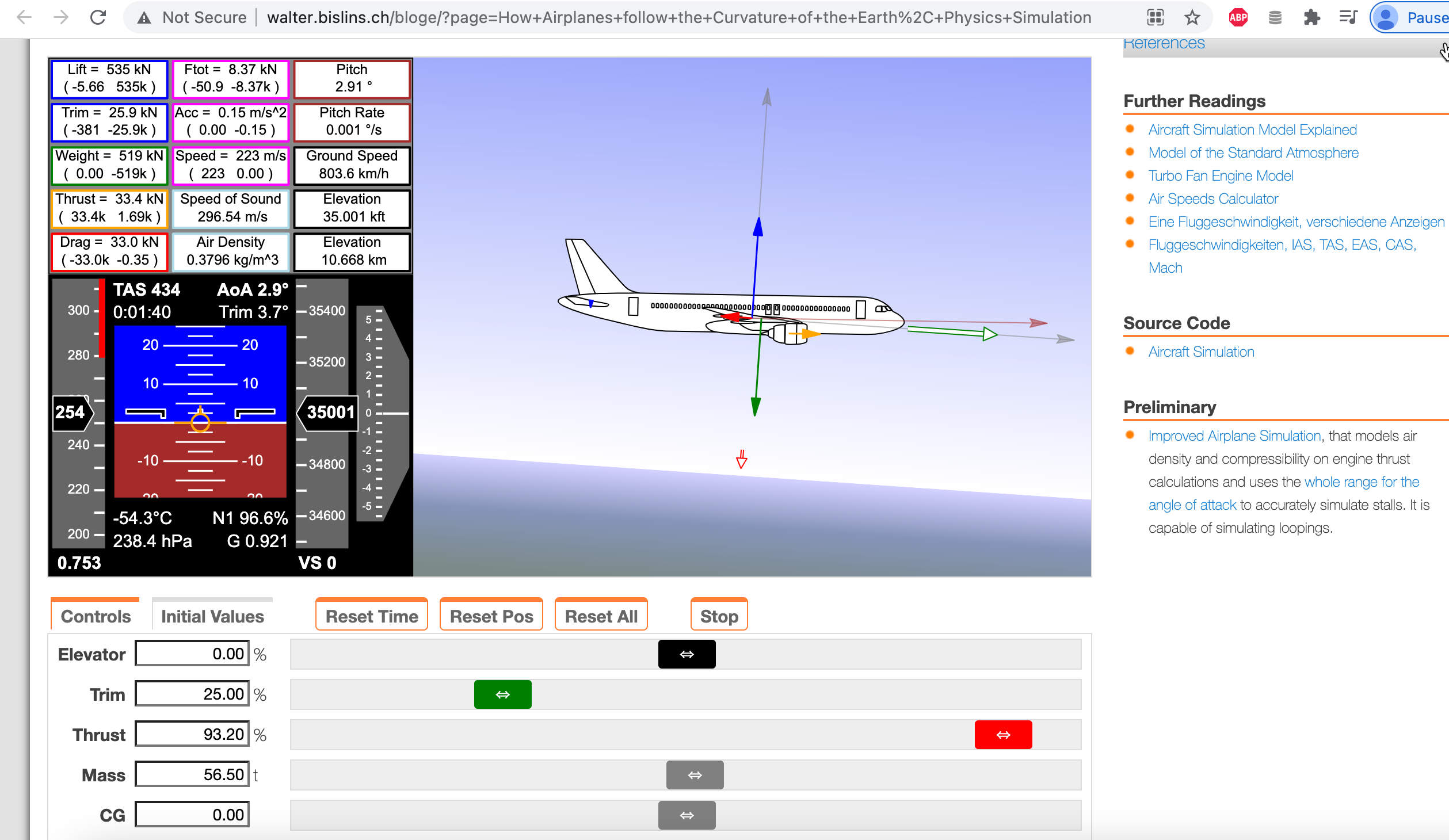
-
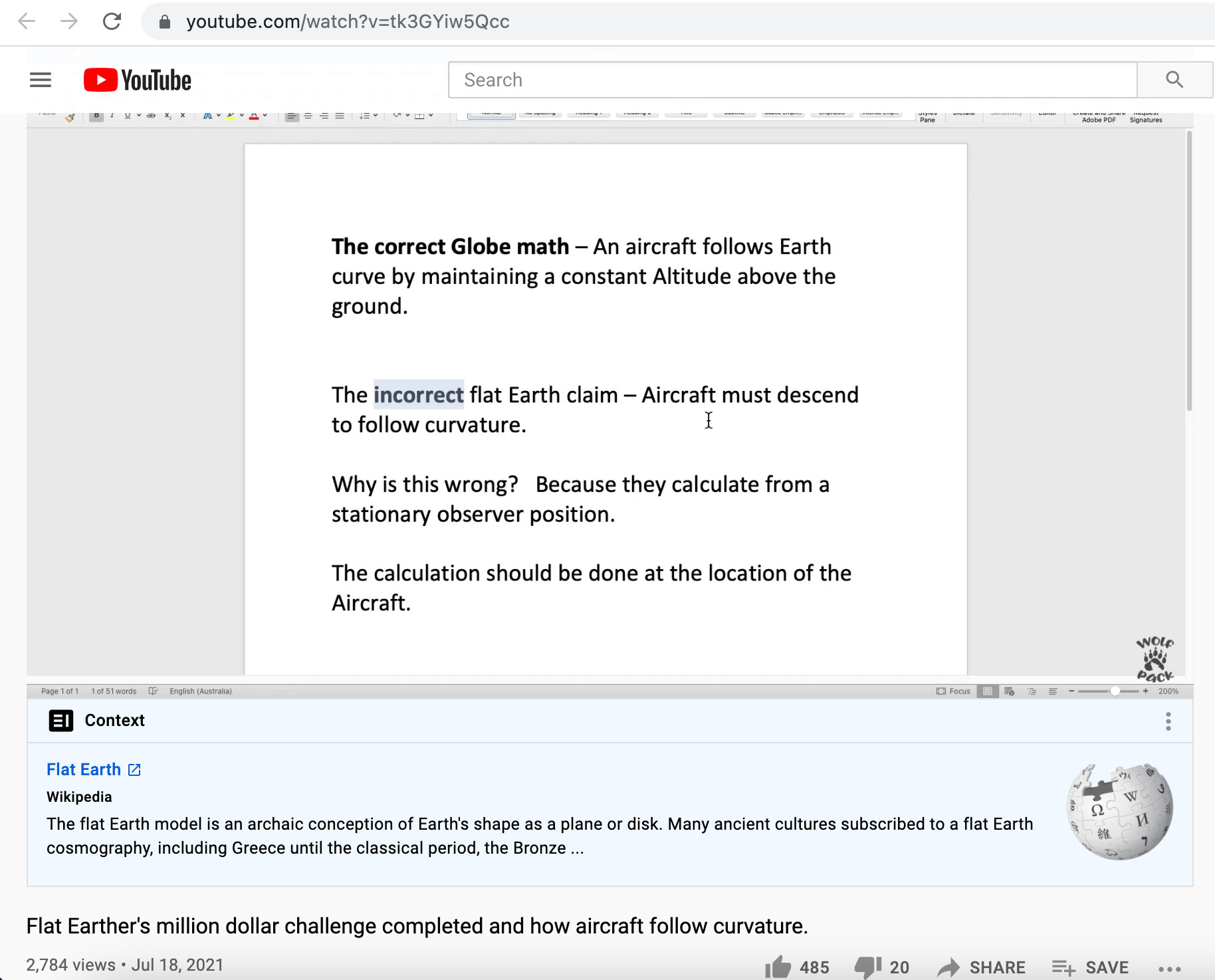
By Wolfie6020
Starting at time mark: 6:10, Wolfie6020 explains how to use the calculator.
Flat Earther's million dollar challenge completed and how aircraft follow curvature., by Wolfie6020
https://www.youtube.com/watch?v=tk3GYiw5Qcc
Visit Wolfie6020's YouTube channel at - https://www.youtube.com/user/Wolfie6020
- - - - - - - - - - - - - - - - - - - - - - - - - - - - - - - - - - - - - - - - - - - - -
Posted on July 16, 2021
Construction of an Antarctic Station...
Extreme Mission in Antarctica | Construction of an Antarctic Station | Free Documentary
How do you build a research station in Antartica? The wild Antarctic ocean is the definition of ‘extreme conditions,' after all. This is the dramatic story of the building of the Jang Bogo Antarctic Station. Five years of investigating sites, then two seasons of the toughest construction imaginable – it’s not a job for the faint-hearted.
- - - - - - - - - - - - - - - - - - - - - - - - - - - - - - - - - - - - - - - - - - - - -
Posted on July 16, 2021
Stellar parallax easily measured, as longer baseline observations bring more data to the table.
NASA's New Horizons Conducts the First Interstellar Parallax Experiment (pluto.jhuapl.edu)
Excerpt:
For the first time, a spacecraft has sent back pictures of the sky from so far away that some stars appear to be in different positions than we see from Earth.
More than four billion miles from home and speeding toward interstellar space, NASA's New Horizons has traveled so far that it now has a unique view of the nearest stars. "It's fair to say that New Horizons is looking at an alien sky, unlike what we see from Earth," said Alan Stern, New Horizons principal investigator from Southwest Research Institute (SwRI) in Boulder, Colorado. "And that has allowed us to do something that had never been accomplished before — to see the nearest stars visibly displaced on the sky from the positions we see them on Earth."
On April 22-23, the spacecraft turned its long-range telescopic camera to a pair of the closest stars, Proxima Centauri and Wolf 359, showing just how they appear in different places than we see from Earth. Scientists have long used this "parallax effect" – how a star appears to shift against its background when seen from different locations -- to measure distances to stars.
An easy way to see parallax is to place one finger at arm's length and watch it jump back and forth when you view it successively with each eye. Similarly, as Earth makes it way around the Sun, the stars shift their positions. But because even the nearest stars are hundreds of thousands of times farther away than the diameter of Earth's orbit, the parallax shifts are tiny, and can only be measured with precise instrumentation.
"No human eye can detect these shifts," Stern said.
But when New Horizons images are paired with pictures of the same stars taken on the same dates by telescopes on Earth, the parallax shift is instantly visible. The combination yields a 3D view of the stars "floating" in front of their background star fields.
"The New Horizons experiment provides the largest parallax baseline ever made -- over 4 billion miles -- and is the first demonstration of an easily observable stellar parallax," said Tod Lauer, New Horizons science team member from the National Science Foundation's National Optical-Infrared Astronomy Research Laboratory who coordinated the parallax demonstration...
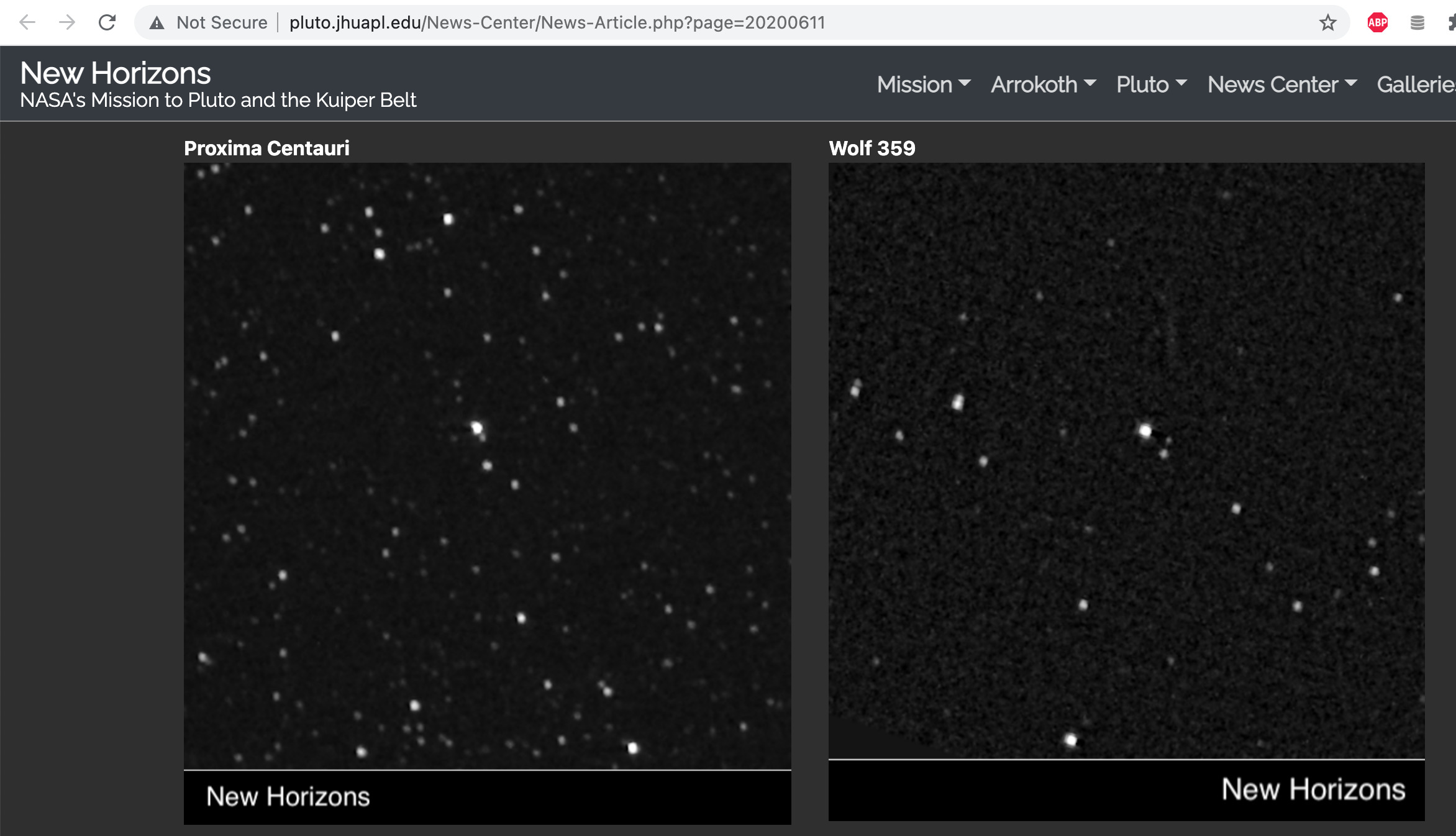
-
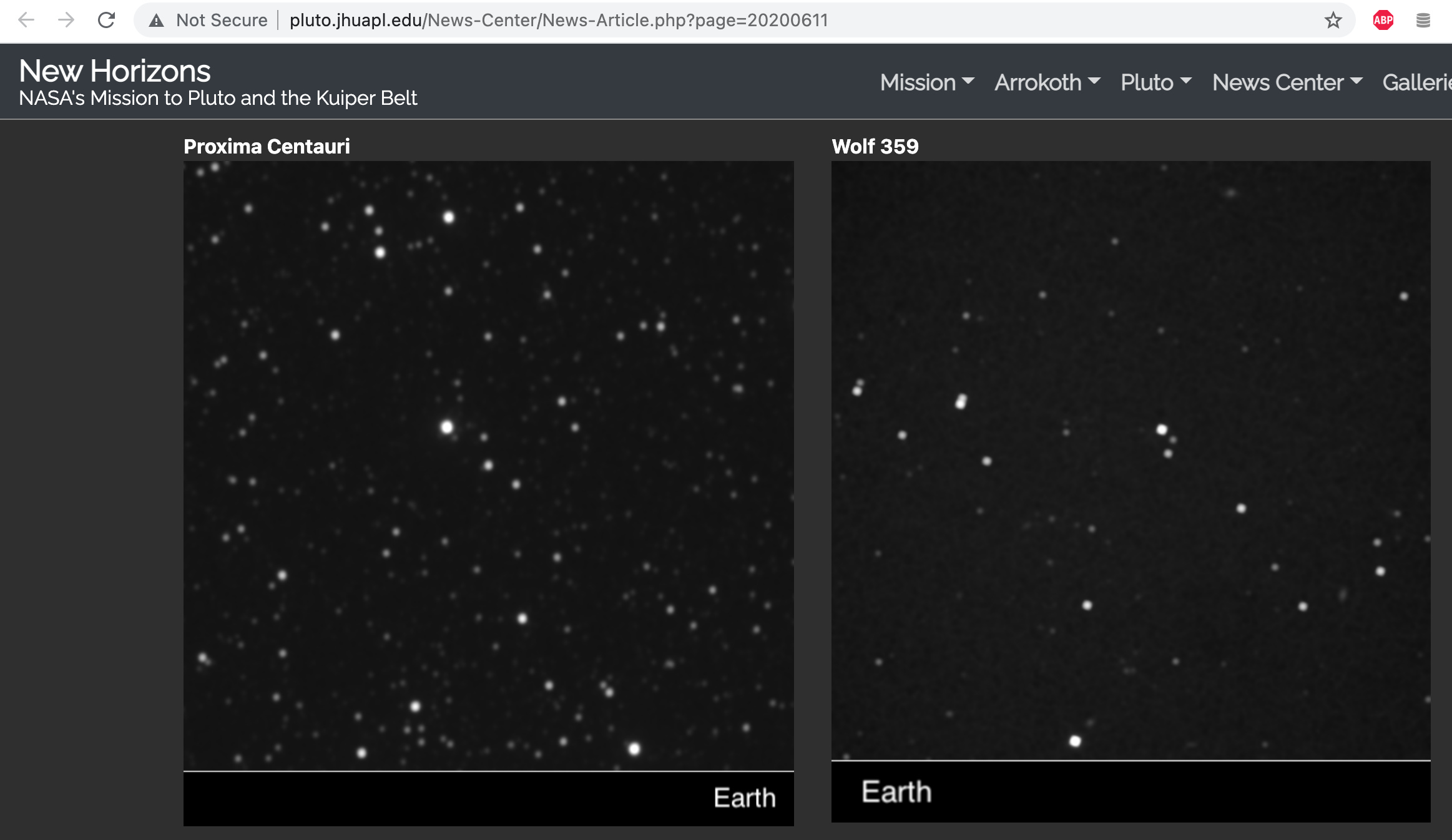
(Please read the article at the URL posted above)
Other articles that show parallax:
Recent parallax measurements of nearby stars, and what are binaries?
Flat Earthers who claim there is no stellar parallax, need to hide their head in shame. Please stop the lies.
Parallax measurements from the New Horizons spacecraft is the Death Knell for flat Earth Geocentric Model proponents
Project New Horizons to measure stellar parallax using the longest baseline ever; distance from the Earth to the New Horizons spacecraft.
Taking Parallax off the table as a flat Earth talking point
- - - - - - - - - - - - - - - - - - - - - - - - - - - - - - - - - - - - - - - - - - - - -
Posted on July 11, 2021
Today is truly historic. The beginning and realization of civilian space travel. A new era has begun.
Finally justice, after 379 years, for Galileo and the other thousands of men/women looking for truth.
Galileo di Vincenzo Bonaiuti de' Galilei (15 February 1564 – 8 January 1642) was an Italian astronomer, physicist and engineer, sometimes described as a polymath, from Pisa. Galileo has been called the "father of observational astronomy",the "father of modern physics", the "father of the scientific method",and the "father of modern science".
-
The curvature of the Earth, as seen by everyone onboard...
NBC Nightly News Broadcast (Full) - July 11th, 2021
https://www.youtube.com/watch?v=zd4ikHOw5wQ
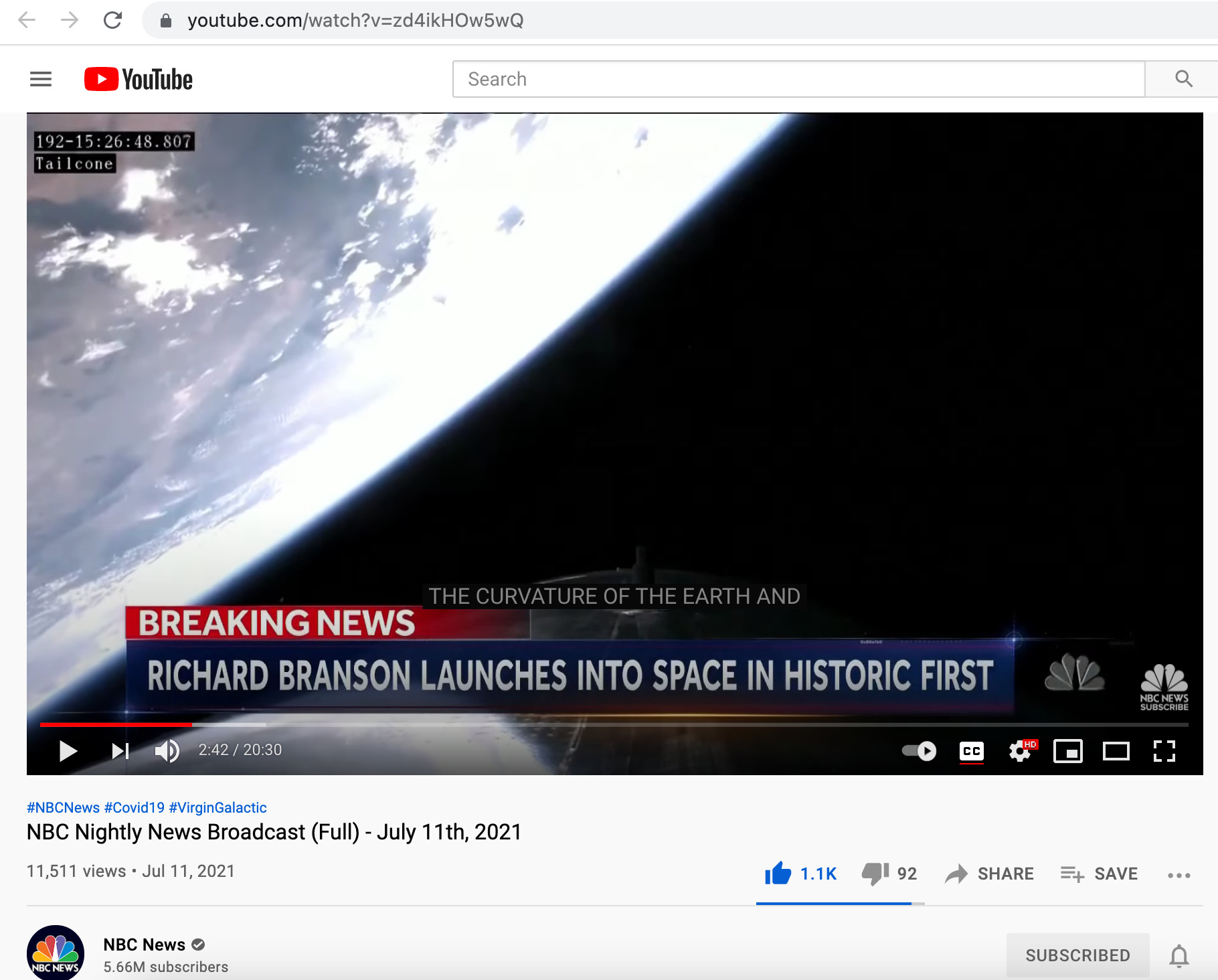
-
Virgin Galactic Successfully Flies VSS Unity on 22nd Flight with Six Crew including Richard Branson (Space Videos)
https://www.youtube.com/watch?v=5fBilynwGco
Virgin Galactic have successfully launched the VSS Unity spaceplane on it's 22nd flight and for the first time carried a full compliment of six crew onboard including Virgin Group owner Richard Branson.
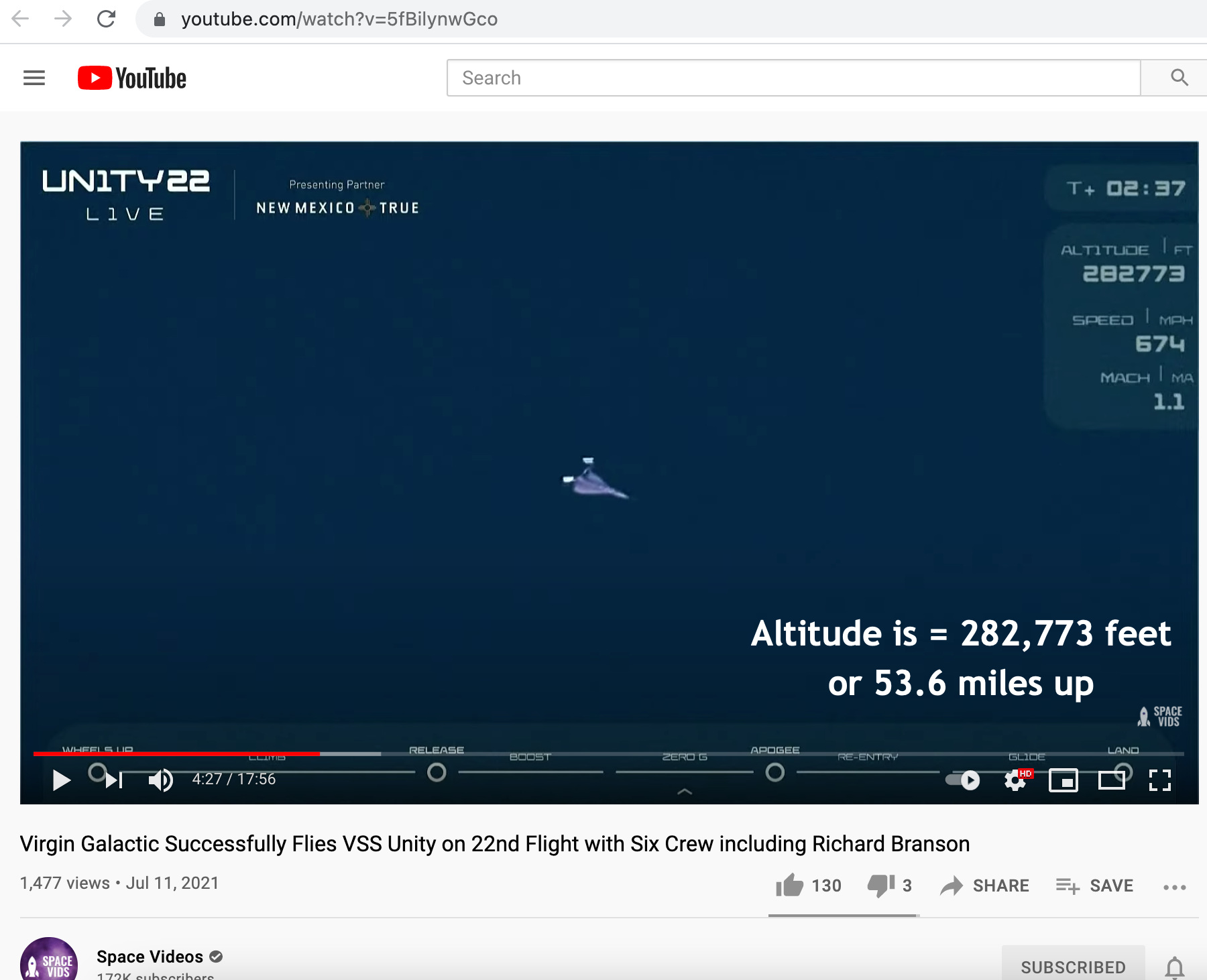
-
All you misguided flat Earthers. With all the destruction of human thought that you have perpetrated over these hundreds of years. Hang your heads in SHAME.
Live: Richard Branson Holds News Conference After Historic Virgin Galactic Space Flight | NBC News
https://www.youtube.com/watch?v=mq7Twk8Wtaw
Watch live coverage of Sir Richard Branson's news conference following his successful landing in New Mexico.
-
Richard Branson and Friends Reach the Edge of Space, and Lived to Tell About it! (universetoday.com)
https://www.universetoday.com/151806/richard-branson-and-friends-reach-the-edge-of-space-and-lived-to-tell-about-it/
-
Virgin Galactic reopens ticket sales — for $450,000 per seat (cnn.com)
https://www.cnn.com/2021/08/05/tech/virgin-galactic-ticket-prices-sales-scn/index.html?utm_source=feedburner&utm_medium=feed&utm_campaign=Feed%3A+rss%2Fcnn_world+%28RSS%3A+CNN+-+World%29
Excerpt:
Virgin Galactic also previously announced that it would raffle off two seats on SpaceShipTwo to people who donate to Space For Humanity, a non-profit with the stated goal of helping to "democratize space." The company revealed Thursday during an investor call that more than 125,000 people from 190 countries have donated.
People who do opt to put up the $450,000 for a seat may have to wait quite a while for their turn, however. More than 600 people — who purchased tickets for between $200,000 and $250,000 when Virgin Galactic sold its first batch of tickets nearly a decade ago — are already on the waiting list for their chance to take a trip to the edge of space....
(Please read the full article posted at the URL above)
- - - - - - - - - - - - - - - - - - - - - - - - - - - - - - - - - - - - - - - - - - - - -
Posted on July 9, 2021
"Cool Hard Logic" shows flat Earth model does not work. It's contrary to our observed reality.
The goal of human science is to know everything in our universe, animate and inanimate, as it truly is. Our Earth is a globe!
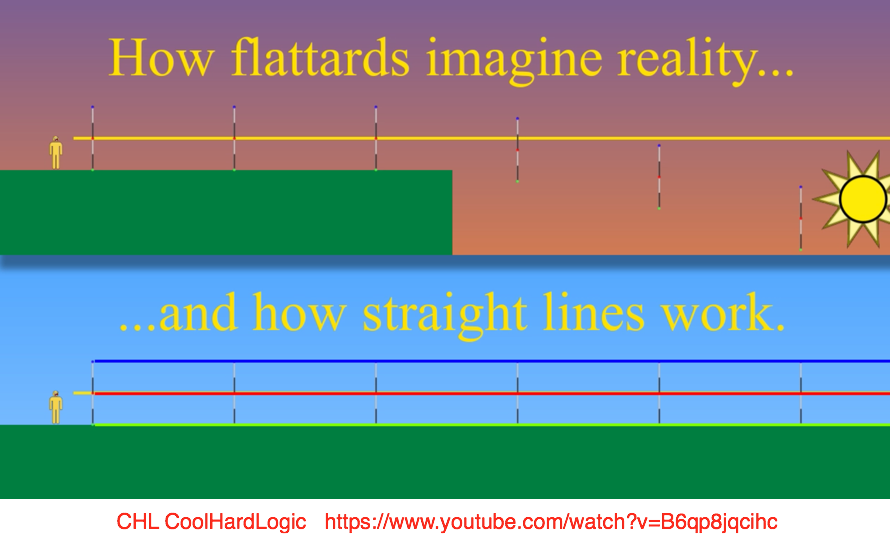
-
If the Sun was really 4,800 km above the surface of the Earth, as flat Earthers say...
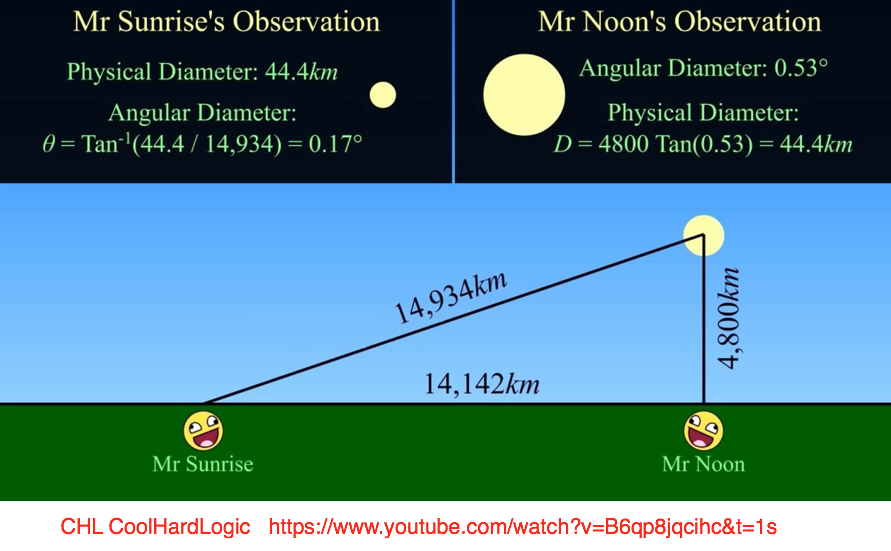
-
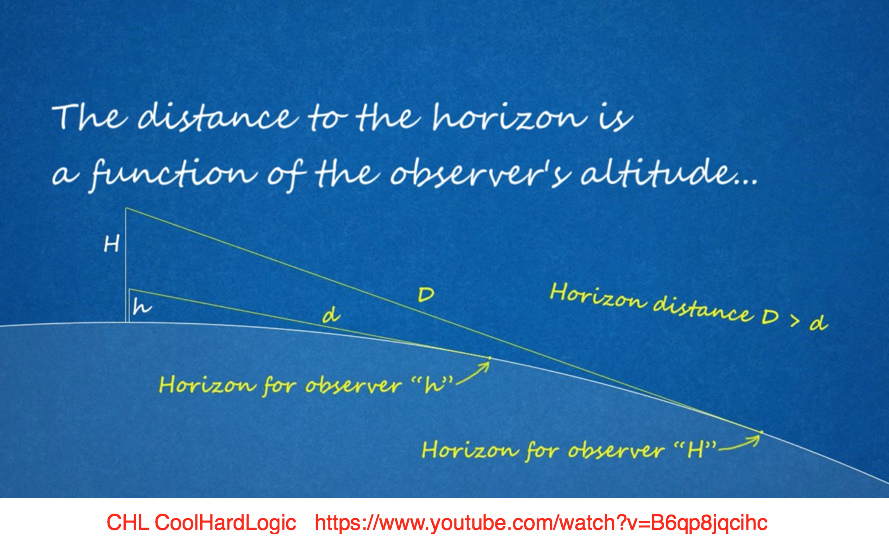
-
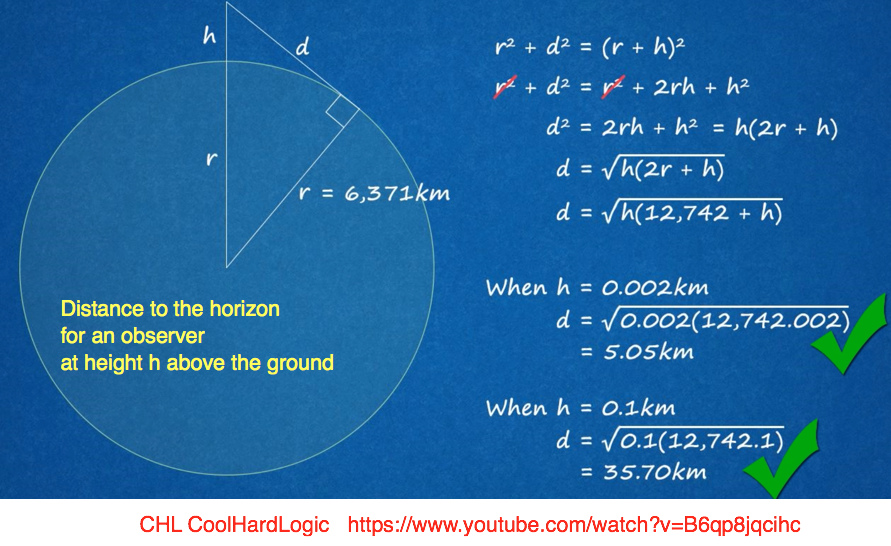
-
Nice flat Earth Sunset...
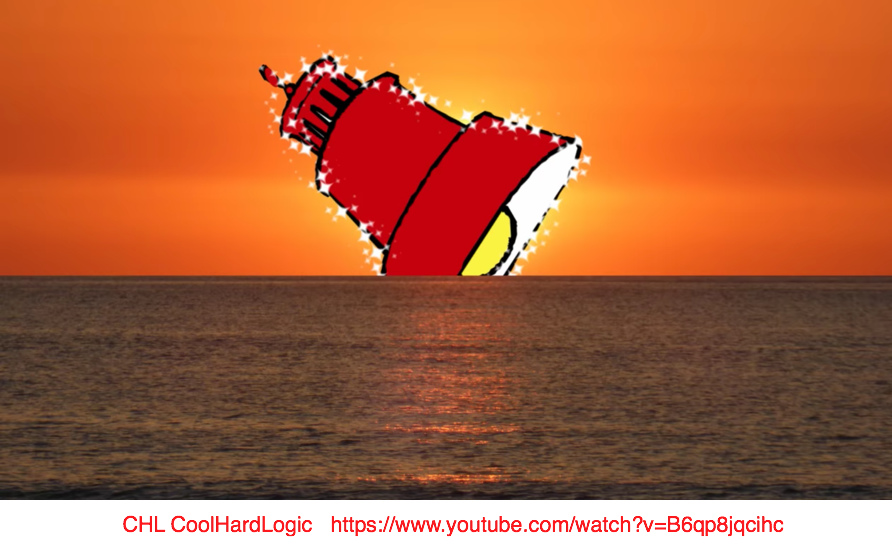
-
For the flat Earth model to work, the speed of the Sun in the sky must increase & decrease at different times of the year.
That is something humanity has never observed.
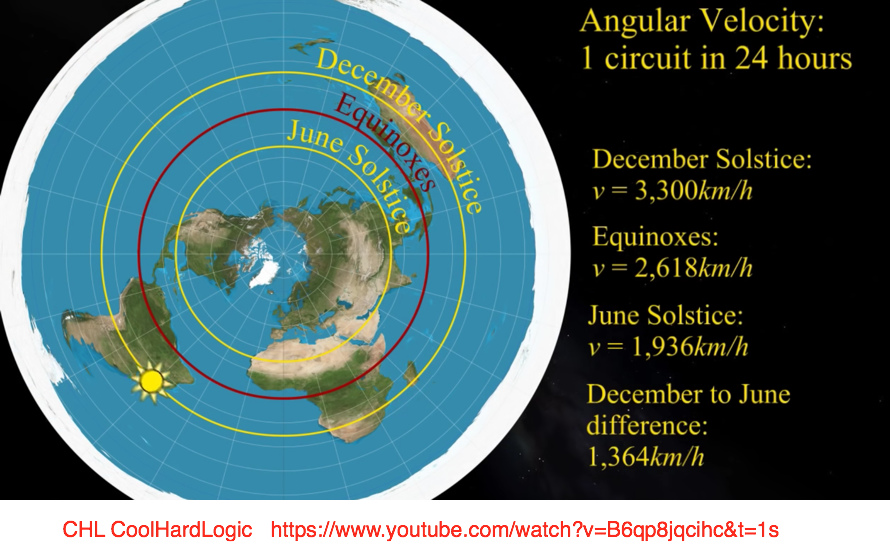
-
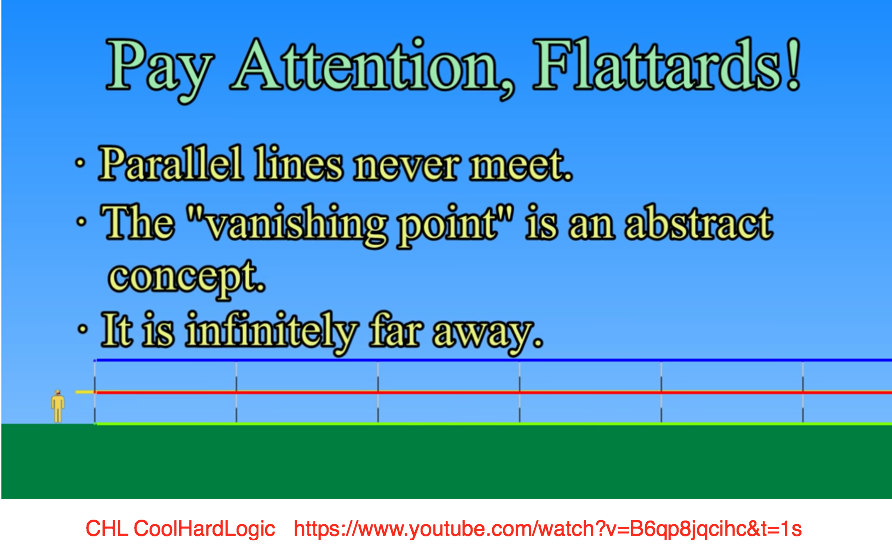
- - - - - - - - - - - - - - - - - - - - - - - - - - - - - - - - - - - - - - - - - - - - -
Posted on July 2, 2021
Was Hanford LIGO Built on a flat Earth or Globe?, by FE Dogma
https://www.youtube.com/watch?v=o1BvZZPwyQQ&t=6s
Will top of beam tube concrete slab elevations from Hanford LIGO blueprints conform to a flat earth or globe?
Intro - 0:00 GPS
Beam Tube Alignment - 1:26
Hanford LIGO Blueprints - 3:29
NW Arm Elevations - 5:41
Flat Earth NW Arm Model - 6:25
Globe NW Arm Model - 7:44
Globe SW Arm Model - 10:55
Blueprint links below...
Hanford – Livingston LA LIGO As Built Blueprints https://labcit.ligo.caltech.edu/LIGO_...
Precision alignment of the LIGO 4 km arms with GPS https://dcc-backup.ligo.org/public/00...
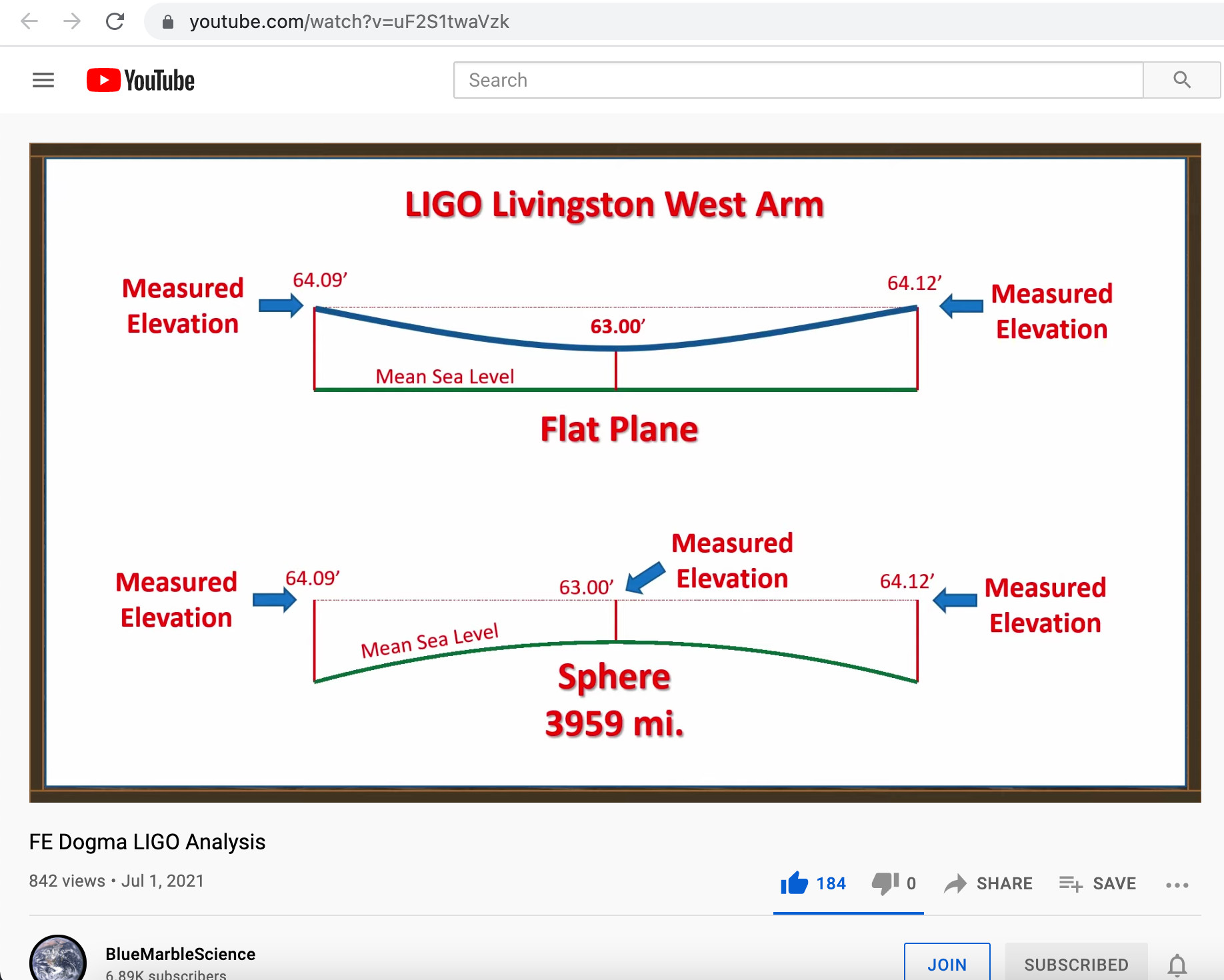
- 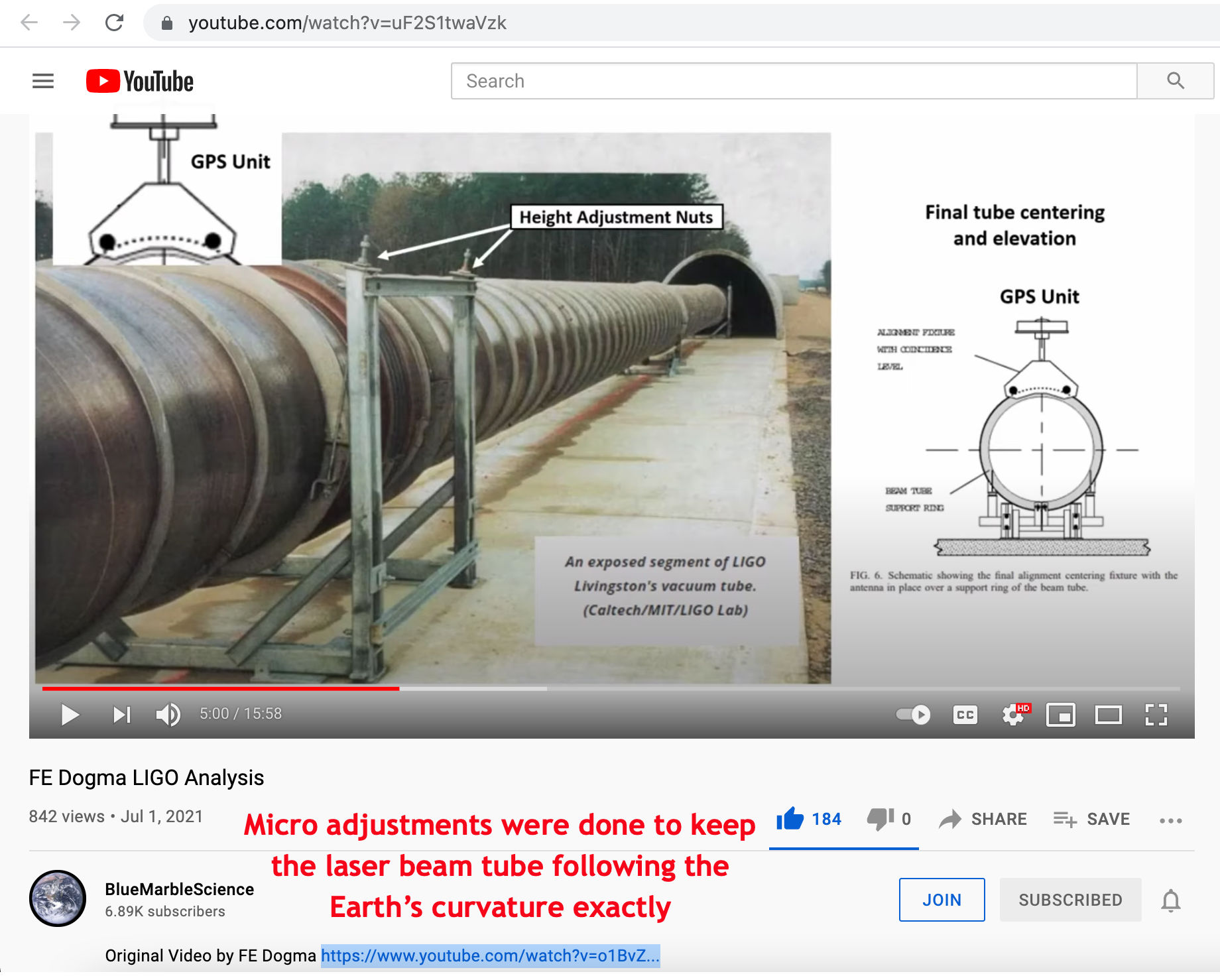
-
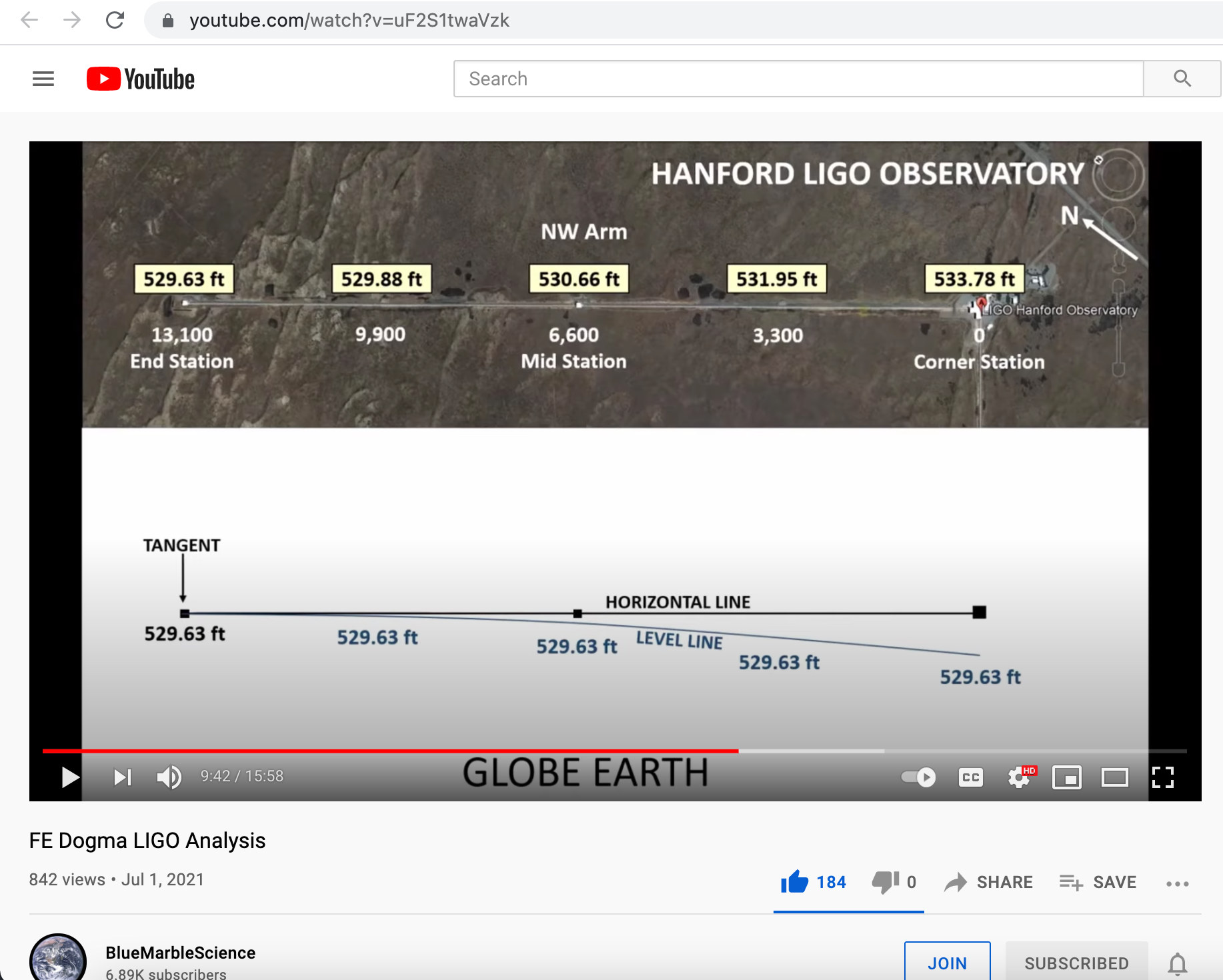
-
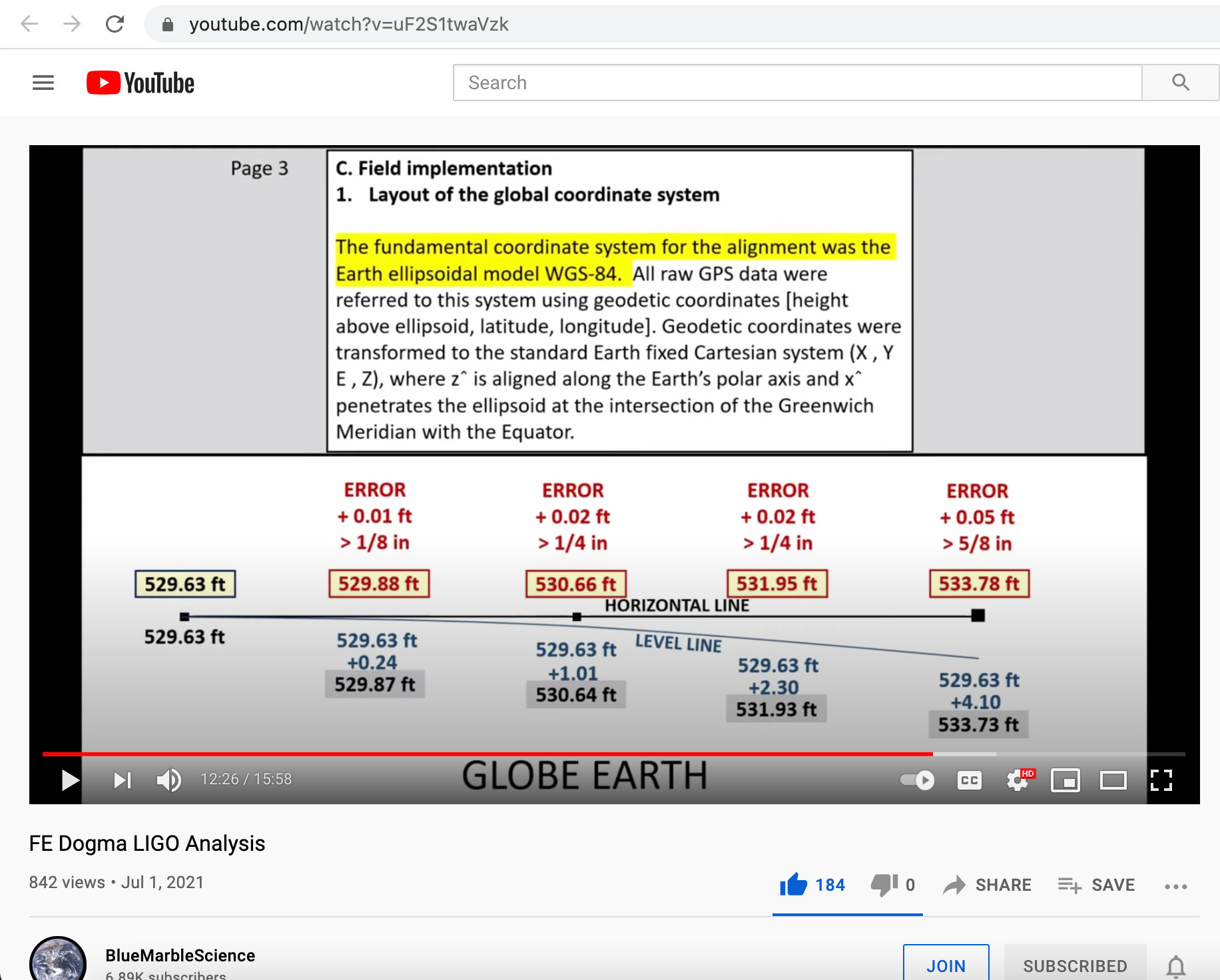
(Please watch the video at the URL posted above)
- - - - - - - - - - - - - - - - - - - - - - - - - - - - - - - - - - - - - - - - - - - - -
Posted on July 1, 2021
Physicists observationally confirm Hawking's black hole theorem for the first time, by Jennifer Chu (phys.org)
https://phys.org/news/2021-07-physicists-observationally-hawking-black-hole.html
Excerpt:
There are certain rules that even the most extreme objects in the universe must obey. A central law for black holes predicts that the area of their event horizons—the boundary beyond which nothing can ever escape—should never shrink. This law is Hawking's area theorem, named after physicist Stephen Hawking, who derived the theorem in 1971.
Fifty years later, physicists at MIT and elsewhere have now confirmed Hawking's area theorem for the first time, using observations of gravitational waves. Their results appear today in Physical Review Letters.
In the study, the researchers take a closer look at GW150914, the first gravitational wave signal detected by the Laser Interferometer Gravitational-wave Observatory (LIGO), in 2015. The signal was a product of two inspiraling black holes that generated a new black hole, along with a huge amount of energy that rippled across space-time as gravitational waves.
If Hawking's area theorem holds, then the horizon area of the new black hole should not be smaller than the total horizon area of its parent black holes. In the new study, the physicists reanalyzed the signal from GW150914 before and after the cosmic collision and found that indeed, the total event horizon area did not decrease after the merger—a result that they report with 95 percent confidence.
Their findings mark the first direct observational confirmation of Hawking's area theorem, which has been proven mathematically but never observed in nature until now. The team plans to test future gravitational-wave signals to see if they might further confirm Hawking's theorem or be a sign of new, law-bending physics.
"It is possible that there's a zoo of different compact objects, and while some of them are the black holes that follow Einstein and Hawking's laws, others may be slightly different beasts," says lead author Maximiliano Isi, a NASA Einstein Postdoctoral Fellow in MIT's Kavli Institute for Astrophysics and Space Research. "So, it's not like you do this test once and it's over. You do this once, and it's the beginning."
Isi's co-authors on the paper are Will Farr of Stony Brook University and the Flatiron Institute's Center for Computational Astrophysics, Matthew Giesler of Cornell University, Mark Scheel of Caltech, and Saul Teukolsky of Cornell University and Caltech.
An age of insights
In 1971, Stephen Hawking proposed the area theorem, which set off a series of fundamental insights about black hole mechanics. The theorem predicts that the total area of a black hole's event horizon—and all black holes in the universe, for that matter—should never decrease. The statement was a curious parallel of the second law of thermodynamics, which states that the entropy, or degree of disorder within an object, should also never decrease...
(Please read the entire article posted at the URL above)
- - - - - - - - - - - - - - - - - - - - - - - - - - - - - - - - - - - - - - - - - - - - -
Posted on June 26, 2021
Earth's meteorite impacts over past 500 million years tracked (geologypage.com)
http://www.geologypage.com/2021/06/earths-meteorite-impacts-over-past-500-million-years-tracked.html
Excerpt:
For the first time, a unique study conducted at Lund University in Sweden has tracked the meteorite flux to Earth over the past 500 million years. Contrary to current theories, researchers have determined that major collisions in the asteroid belt have not generally affected the number of impacts with Earth to any great extent.
Researchers have been studying geological series since the 19th century in order to reconstruct how flora, fauna and the climate have changed over millions of years. Until now, however, almost nothing has been known about ancient meteorite flux — which makes sense since impact is rare, and the battered celestial bodies quickly break down as they encounter Earth’s oxygen. A new study published in PNAS shows how researchers in Lund have reconstructed meteorite bombardment towards Earth over the past 500 million years.
“The research community previously believed that meteorite flux to Earth was connected to dramatic events in the asteroid belt. The new study, however, shows that the flux has instead been very stable,” says Birger Schmitz, professor of geology at Lund University.
To conduct the study, researchers at Lund University’s Astrogeobiology Laboratory dissolved almost ten tonnes of sedimentary rocks from ancient seabeds in strong acids because the sediment contains residue from the meteorites dating back to when they fell to Earth.
Meteorites contain a small fraction of a mineral, a chromium oxide, which is very resistant to degradation. The microscopic chromium oxide grains were sifted out in the laboratory and serve as time capsules with an abundance of information.
“The dissolved sediment represents 15 periods over the past 500 million years. In total, we have extracted chromium oxide from almost 10,000 different meteorites. Chemical analyses then enabled us to determine which types of meteorites the grains represent,” says Birger Schmitz.
A couple of thousand meteorites land on the Earth’s surface every year, and approximately 63,000 space rocks have been documented by science. The space rocks originate from the asteroid belt between Mars and Jupiter where battered celestial bodies from gigantic collisions revolve around the sun.
(Please read the entire article posted at the URL above)
-
https://www.ncbi.nlm.nih.gov/pmc/issues/384140/

That detailed article: https://www.ncbi.nlm.nih.gov/pmc/articles/PMC8214677/
- - - - - - - - - - - - - - - - - - - - - - - - - - - - - - - - - - - - - - - - - - - - -
Posted on June 26, 2021
For $139.25 and a few hours of your time, you can determine for YOURSELF if the Earth is flat or curved.
Why not do this simple experiment to put this issue to bed, rather than spending the rest of your life in denial?
Bob Measures the Curve, by Bob the Science Guy
https://www.youtube.com/watch?v=aPZ096frjAI
In 2500 feet, the earth curves approximately 1.5 to 2 inches. Can this be measures with inexpensive, but purpose designed tools? Join Bob as he measures the curve of the earth in his backyard.
Details on Bosch GOL 24 Professional https://picclick.com/Bosch-GOL24-Auto...

- - - - - - - - - - - - - - - - - - - - - - - - - - - - - - - - - - - - - - - - - - - - -
Posted on June 23, 2021
Space Perspective Puts Tickets for Stratospheric Balloon Tours on Sale, by Alan Boyle (universetoday.com)
https://www.universetoday.com/151617/space-perspective-puts-tickets-for-stratospheric-balloon-tours-on-sale/
The curvature of the Earth is 5.6 degress at 100,000 feet. That's easily visible to the naked eye.
Excerpt:
Florida-based Space Perspective is opening its ticket window for 20-mile-high balloon flights that provide an astronaut’s-eye view of Earth.
The list price for a six-hour trip up into the stratosphere and back is $125,000. Flights are scheduled to begin as soon as late 2024.
Space Perspective’s co-CEOs, Taber MacCallum and Jane Poynter, unveiled the outlines of their plan for trips in a balloon-borne capsule called Spaceship Neptune a year ago. Since then, the concept has matured. Just last week, the company announced that it conducted a successful uncrewed test of its Neptune One prototype over Florida.
The trial balloon lifted off from the Space Coast Spaceport, located next to NASA’s Kennedy Space Center, and rose to a height of 108,409 feet during a 6-hour, 39-minute flight. An onboard camera captured spectacular views of Earth below the black sky of space.
-
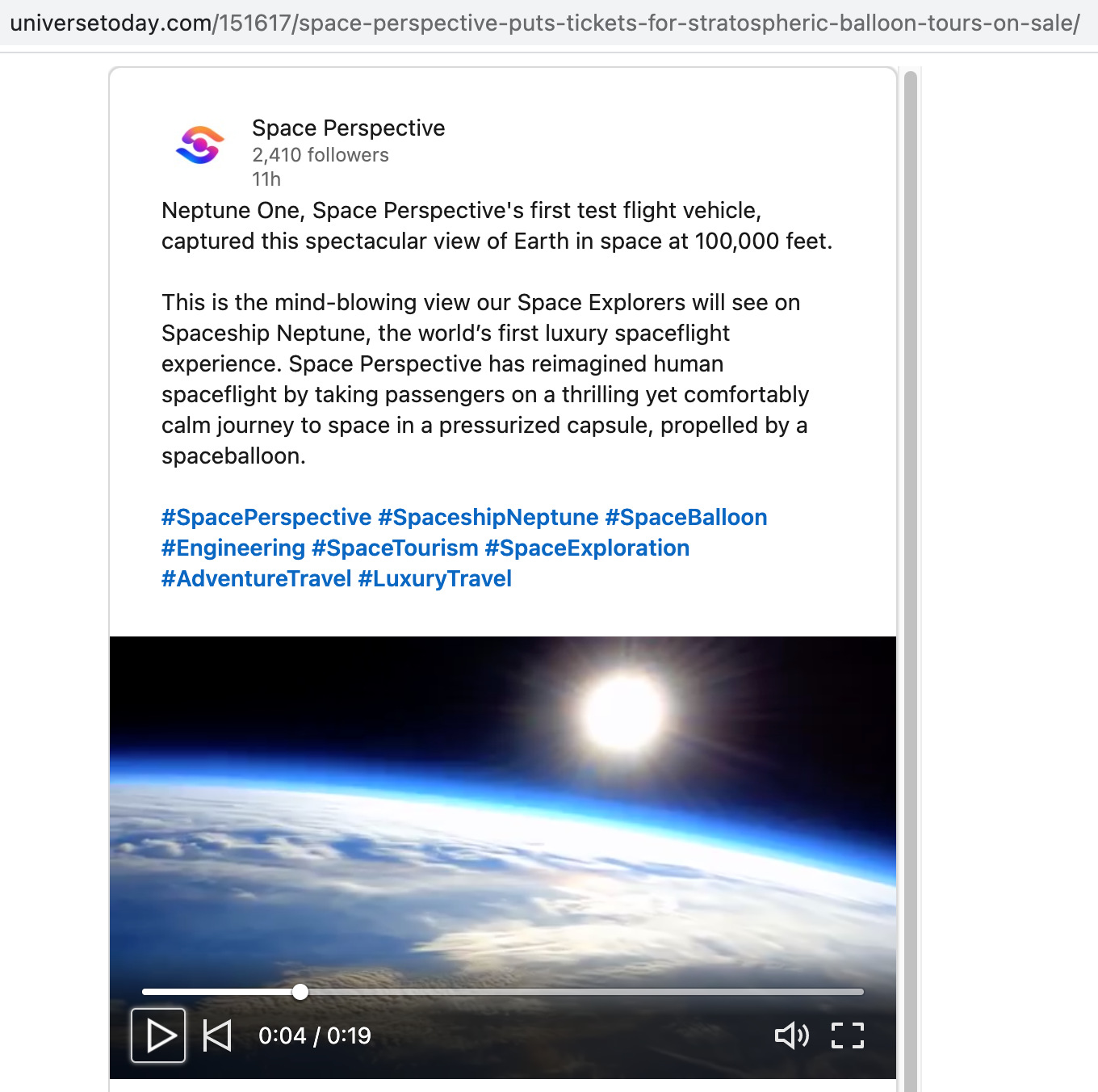
(Please read the entire article posted at the URL above)
- - - - - - - - - - - - - - - - - - - - - - - - - - - - - - - - - - - - - - - - - - - - -
Posted on June 22, 2021
New satellite platform takes 4500+ pictures of the earth and space.
Teeny Tiny Space Telescope has Taken Thousands of Pictures of Both Earth and Space, by Andy Tomaswick (univsersetoday.com)
https://www.universetoday.com/151599/teeny-tiny-space-telescope-has-taken-thousands-of-pictures-of-both-earth-and-space/
Excerpt:
A new nanosat has been quietly snapping over 4500 pictures of the Earth and the sky after its launch on May 15th. Rocketed into orbit on a Falcon 9, the nanosat, known as GEOStare2, actually contains two different telescopes – one focuses on a wide field of view while the other has a much narrower field of view but much higher resolution. Together they aim to provide data on Earth, the stars, and the network of satellites in between.
The telescopes are based on the MonoTele technology, developed by the Department of Energy’s Lawrence Livermore National Laboratory over the past 8 years. This unique telescope uses a single fabricated silica slab rather than the traditional lensing system usually adopted by telescopes. Advantages of this novel technology include significant size and weight improvements, as well as more versatility in the orbital alignment of the spacecraft it is attached to.
In GEOStare2’s case, that spacecraft is a nanosatellite weighing in at 11 kg that was developed by Tyvak, a company founded in 2013 that specializes in building satellite systems. The features of nanosat include reaction wheel, attitude control systems, and a highly advanced flight control computer.
With this associated supporting hardware, GEOStare2 has already started snapping useful photos of both the Earth and space. Its primary goals are to provide “space domain awareness” (which in the jargon means tracking where satellites are moving), astronomy data, and Earth observations. So far, both the scientists at LLNL and the program directors at Tyvak seem pleased with the satellite’s performance...
Learn More:
LLNL – LLNL/Tyvak space telescope goes into orbit
LLNL – Night or day, Lab-developed space-based telescope can image Earth and beyond
Spacenews – Tyvak satellite on SpaceX rideshare mission carries tiny space telescope
(Please read the entire article posted at the URL above)
- - - - - - - - - - - - - - - - - - - - - - - - - - - - - - - - - - - - - - - - - - - - -
Posted on June 17, 2021
Three Chinese astronauts now onboard the Shenzhou 12 space station.
So now will flat Earthers deny that Shenzhou 12 exists, as they have done with the ISS for years?
Eight more launches scheduled to follow for completion of the station by end of 2022.
China space station: Shenzhou-12 delivers first crew to Tianhe module, by Jonathan Amos (bbc.com)
Excerpt:
China has launched three astronauts into orbit to begin occupation of the country's new space station.
The three men - Nie Haisheng, Liu Boming and Tang Hongbo - are to spend three months aboard the Tianhe module some 380km (236 miles) above the Earth.
It will be China's longest crewed space mission to date and the first in nearly five years.
The crew successfully docked with the space station just over seven hours after the launch.
The moment of contact was met with applause from mission control in China.
Their Shenzhou-12 capsule took off atop its Long March 2F rocket on Thursday.
Lift-off from the Jiuquan satellite launch centre in the Gobi desert was at 09:22 Beijing time (01:22 GMT).
The launch and subsequent mission are another demonstration of China's growing confidence and capability in the space domain.
In the past six months, the country has returned rock and soil samples to Earth from the surface of the Moon, and landed a six-wheeled robot on Mars - both highly complex and challenging endeavours.
(Please read the BBC article posted at the URL above)
-
Update: July 9, 2021
Chinese Astronauts Take Their First Spacewalk Outside the new Station (universetoday.com)
Update: August 21, 2021
Chinese Space Station taikonauts conduct second spacewalk (nasaspaceflight.com)
- - - - - - - - - - - - - - - - - - - - - - - - - - - - - - - - - - - - - - - - - - - - -
Posted on June 16, 2021
News flash...

- - - - - - - - - - - - - - - - - - - - - - - - - - - - - - - - - - - - - - - - - - - - -
Posted on June 10, 2021
FAIL. There is something wrong with the popular flat Earth model. It fails to account for a partial (annular) eclipse of the Sun, VS a full solar eclipse (where the Sun is totally covered - eclipsed by the Moon).
Here is what was OBSERVED on June 10, 2021... https://www.bbc.com/news/av/world-57430146
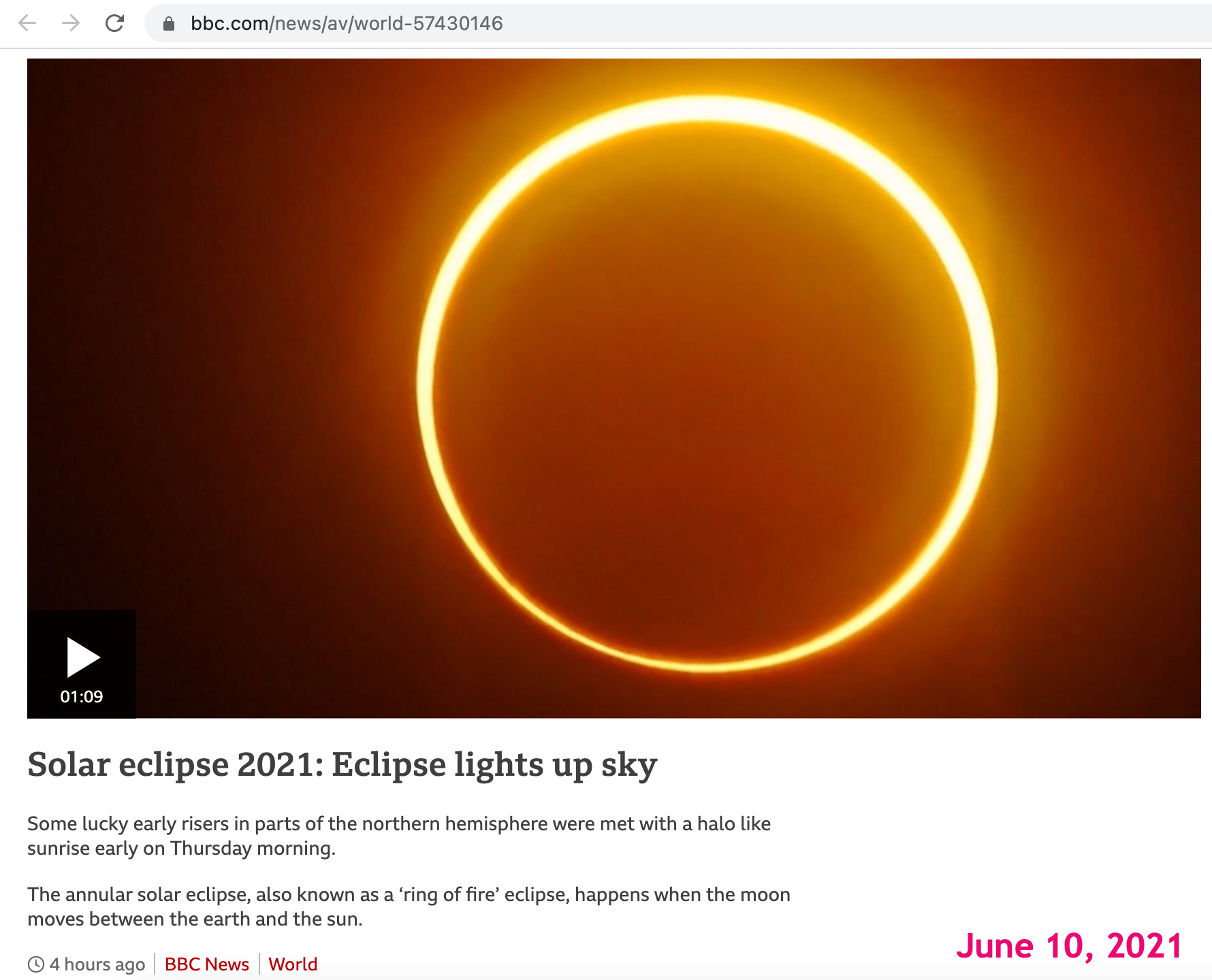
But the current accepted flat Earth model, does not account for the Moon changing its distance while in a circular orbit (which also cannot be explained - how the Sun and Moon stay up, or what mythical force causes them to circle)..
https://carm.org/about-science/what-is-the-flat-earth-theory-is-it-true-and-is-it-biblical/
-
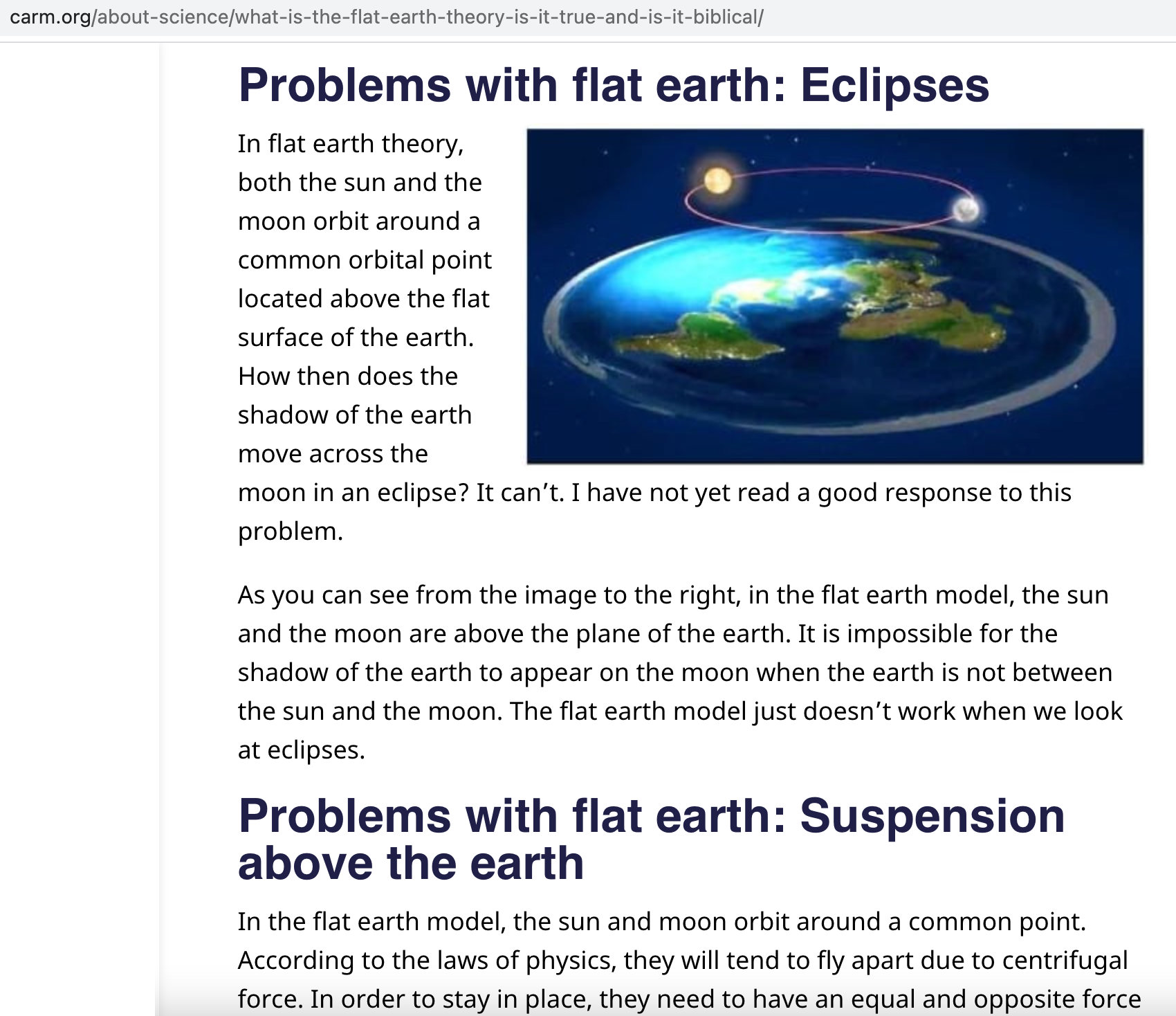
(Please view the BBC video and read the article posted at the URL above)
- - - - - - - - - - - - - - - - - - - - - - - - - - - - - - - - - - - - - - - - - - - - -
Posted on June 7, 2021
NASA’s Juno will fly by Ganymede, Jupiter’s largest satellite and the biggest moon in the solar system, on June 7, 2021.
https://skyandtelescope.org/astronomy-news/junos-ganymede-flyby-history/
Excerpt:
On June 7th, NASA’s Jupiter-orbiting Juno spacecraft will perform a close flyby of Ganymede, passing about 1,000 kilometers (600 miles) from the icy moon’s surface. This flyby places the mission alongside seven other planetary spacecraft that have photographed the moon over the last few decades, increasing our understanding of this unique world.
Part of the purpose of the flyby is to begin adjusting Juno’s orbit in anticipation of its extended mission, announced last January. But the flyby will also allow Juno to study some of Jupiter’s large moons from close range, and Ganymede is up first. This icy world is the largest moon in the solar system, bigger even than the planet Mercury, with a tenuous atmosphere and, unique among moons, its own magnetic field. It also probably has a subsurface ocean, though it’s not as accessible as the one on Jupiter’s Europa or Saturn’s Enceladus...
(Please read this article posted at the URL above)
- - -
NASA’s Juno Orbiter Completes Close Flyby of Ganymede (sci-news.com)
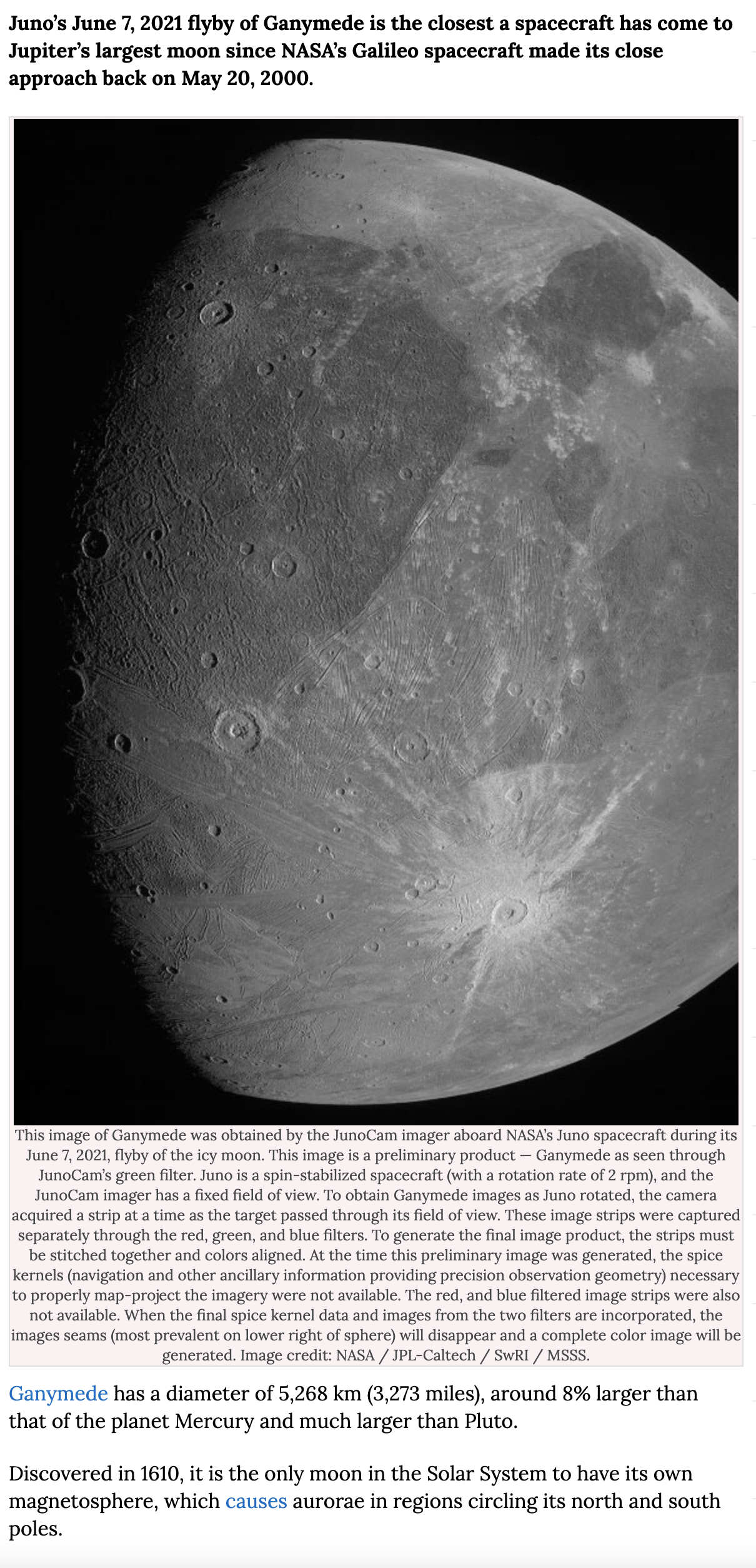
(Please read this article posted at the URL above)
- - - - - - - - - - - - - - - - - - - - - - - - - - - - - - - - - - - - - - - - - - - - -
Posted on June 7, 2021
Astronomy new discovery - open star clusters sprinkle our Milky Way galaxy, as they lose stars while traveling.
Stream of stars extends thousands of light-years across the Milky Way, Princeton University (phys.org)
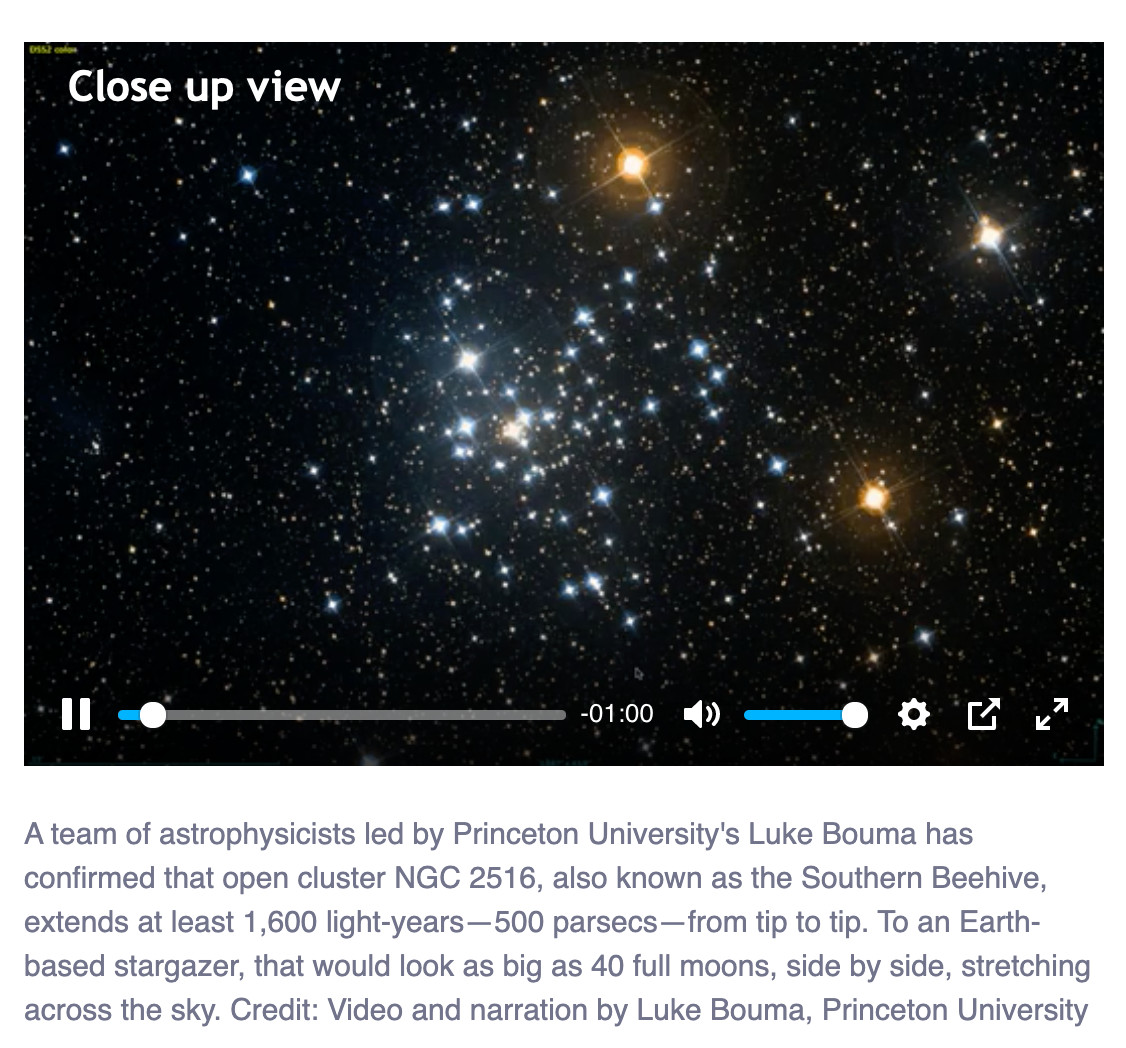
-
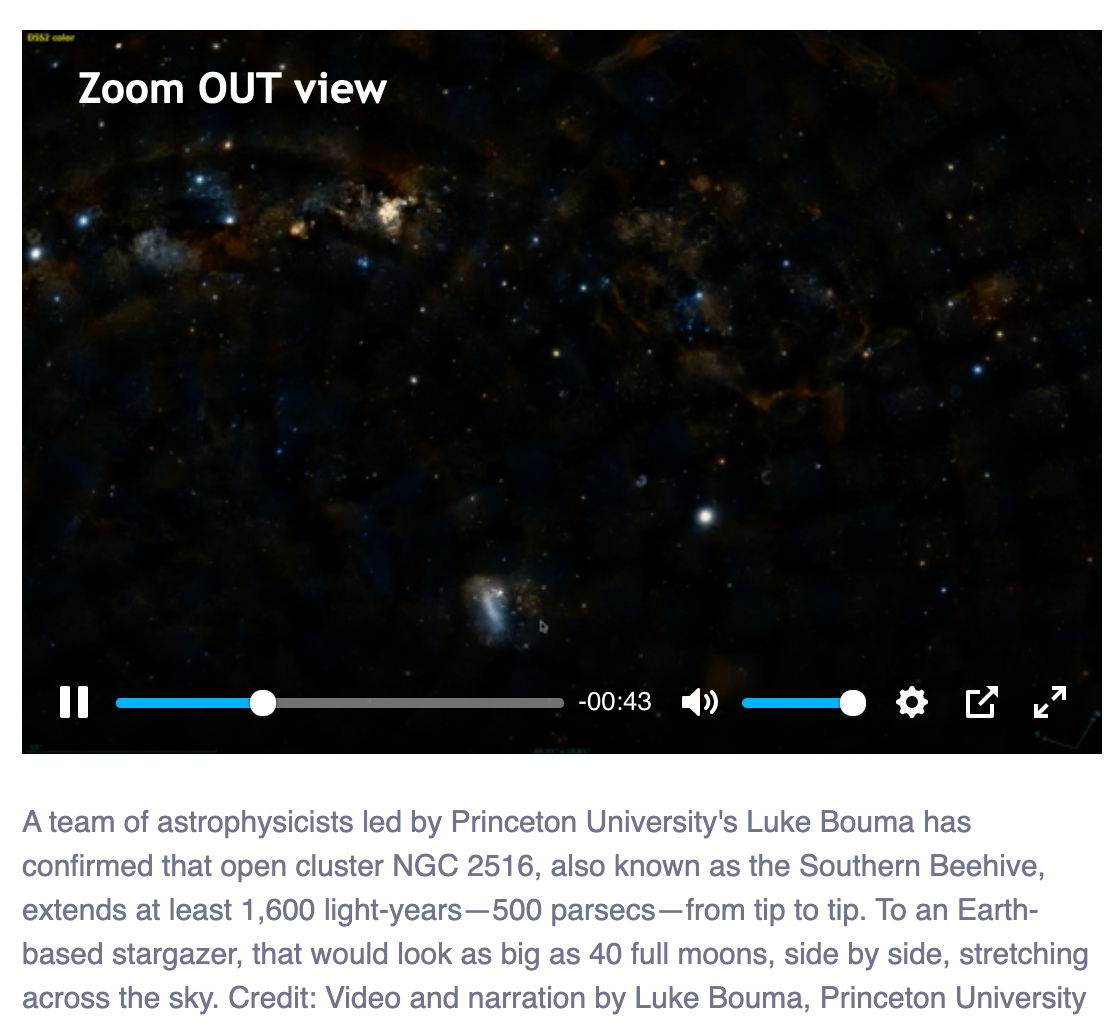
-
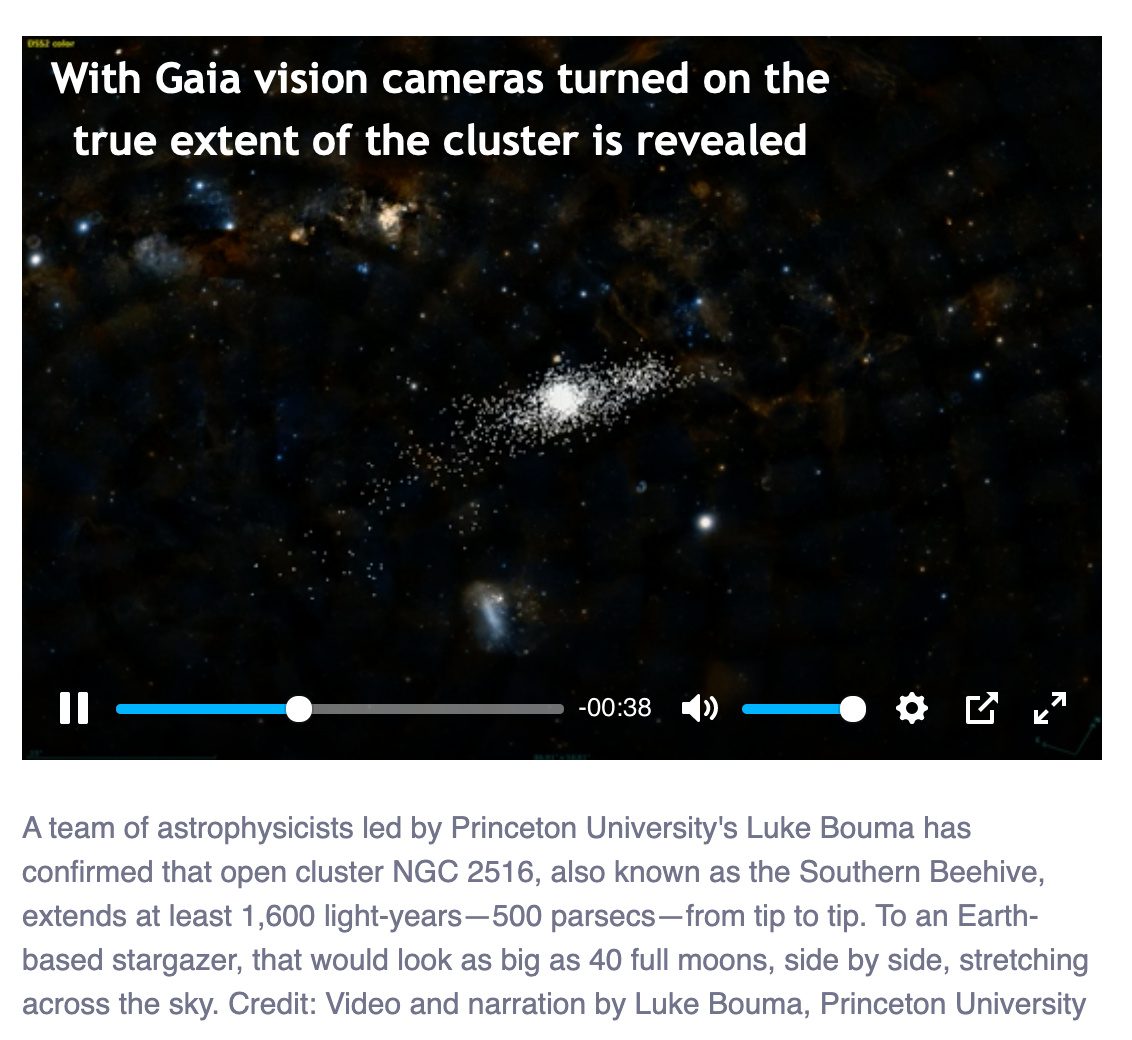
Excerpt:
It's hard to see more than a handful of stars from Princeton University, because the lights from New York City, Princeton and Philadelphia prevent our sky from ever getting pitch black, but stargazers who get into more rural areas can see hundreds of naked-eye stars—and a few smudgy objects, too.
The biggest smudge is the Milky Way itself, the billions of stars that make up our spiral galaxy, which we see edge-on. The smaller smudges don't mean that you need glasses, but that you're seeing tightly packed groups of stars. One of the best-known of these "clouds" or "clusters"—groups of stars that travel together—is the Pleiades, also known as the Seven Sisters. Clusters are stellar nurseries where thousands of stars are born from clouds of gas and dust and then disperse across the Milky Way.
For centuries, scientists have speculated about whether these clusters always form tight clumps like the Pleiades, spread over only a few dozen lightyears.
"We call them 'open clusters'—the 'open' part refers to the expectation that these things formed in a much denser group that then dispersed," said Luke Bouma, a graduate student in astrophysical sciences at Princeton and the lead author on an upcoming paper published by the American Astronomical Society. "But we never thought we'd be able to find the stars that were lost."
Then, two years ago, a machine-learning algorithm using data from the Gaia satellite identified that many far-flung stars are moving at the same speed and direction and could therefore be part of the same open cluster—but as more of a stream or a string than a clump.
Now, a team of astrophysicists led by Bouma can confirm that one of these streams of stars, NGC 2516, also known as the Southern Beehive, extends at least 1,600 light-years—500 parsecs—from tip to tip. To an Earth-based stargazer, that would look as big as 40 full moons, side by side, stretching across the sky...
(Please read this article posted at the URL above)
- - - - - - - - - - - - - - - - - - - - - - - - - - - - - - - - - - - - - - - - - - - - -
Posted on June 4, 2021
The Chemtrail conspiracy theory thoroughly explained and debunked.
Chemtrails Explained PROPERLY, by Creaky Blinder & Krafty Keelah
https://www.youtube.com/watch?v=Qd5-3LkzWmo
@Krafty Keelah at her channel https://www.youtube.com/c/KraftyKeela...
- - -

Hello. I’m Krafty Keelah, and before I start, I really want to thank Creaky Blinder for inviting me onto his channel.
Challenging conspiracies is an ongoing series that looks at conspiracies from a sociological perspective. It is important to understand how and why conspiracy theorists before their arguments to find out why their ideas sometimes stick.
In this brand new episode of challenging conspiracies, we will focus on the issue of chemtrails, a mistaken belief that passenger jets are purposely releasing chemicals into the atmosphere to interfere with or control human populations.
Since the late 90’s conspiracy theories have emerged around the ideas of chemtrails. It was believed that harmful chemicals and heavy metals were being released into the upper atmosphere by passenger jets. The reason behind this illegal spraying are varied. But all proponents of this theory believe it is run and paid for by government bodies and shady organizations, to control the population in some way.
Today I will take a serious look at some of these claims to show just how ineffective chemtrails would be, from population control, to weather modification, to chemical warfare.
This particular theory is unrealistic faith in all governments having the power to influence human behavior by poisoning the air that we breath.
The term chemtrail was adopted from the word contrail, or condensation trail. This is the process of jet engines which involves air heating up in the engine to 600 degrees, and released alongside water, carbon dioxide, and fuel to an external temperature of minus 60 degrees. This leaves a white trail behind the aircraft. There are images of contrails in the sky as far back as World War II, where bomber planes first became a regular occurrence to the landscape.
However, conspiracy theorist think that contrails that linger in the upper atmosphere indicate the presence of harmful chemicals.
There are many other creators who can explain the aerodynamics of aircraft much better than I can. So the questions that I want to tackle are the motivations people believe that governments have to initiate spraying programs.
Chemtrails as a belief was made popular by radio host Art Bell, a retired air force medic, who garnered attention for promoting conspiracies as a regular feature on his show..
Bell first came across the idea following a 1996 air force university paper into the possibilities of weather modification to be an asset to the US Air Force. This was a hypothetical research paper for students.
However, Bell took this report and pushed the idea that spraying programs were already fully effect and in practice throughout the US…"

-

Bell's show "Midnight In The Desert" which broadcasts on the Dark Matter Digital Network, has been acquired by a private holdings group, and is now managed and directed by Art Bell's former show producer David Rubini, who has been tapped to run the radio network as the new Operations Director and Executive Producer, ...Jun 17, 2020
-
"In the 80’s and 90’s air travel was becoming more affordable and widely used. This in turn led to more complicated flight paths due to the sheer increase in traffic. Bell and his supporters used the increase in aircraft visibility to create a hysteria around the presence of jets in populated.
There are four main reasons conspiracy theorists put forward for chemtrails.
- weather modification
- population control
- psychological manipulation
- chemical warfare
The most complicated reason to explain is that of weather modification. The reason is, that multiple countries around the world take part in what’s known as cloud seeding. This is the only part of any chemtrailer’s claims that have any merit, but not for the reasons that they think.
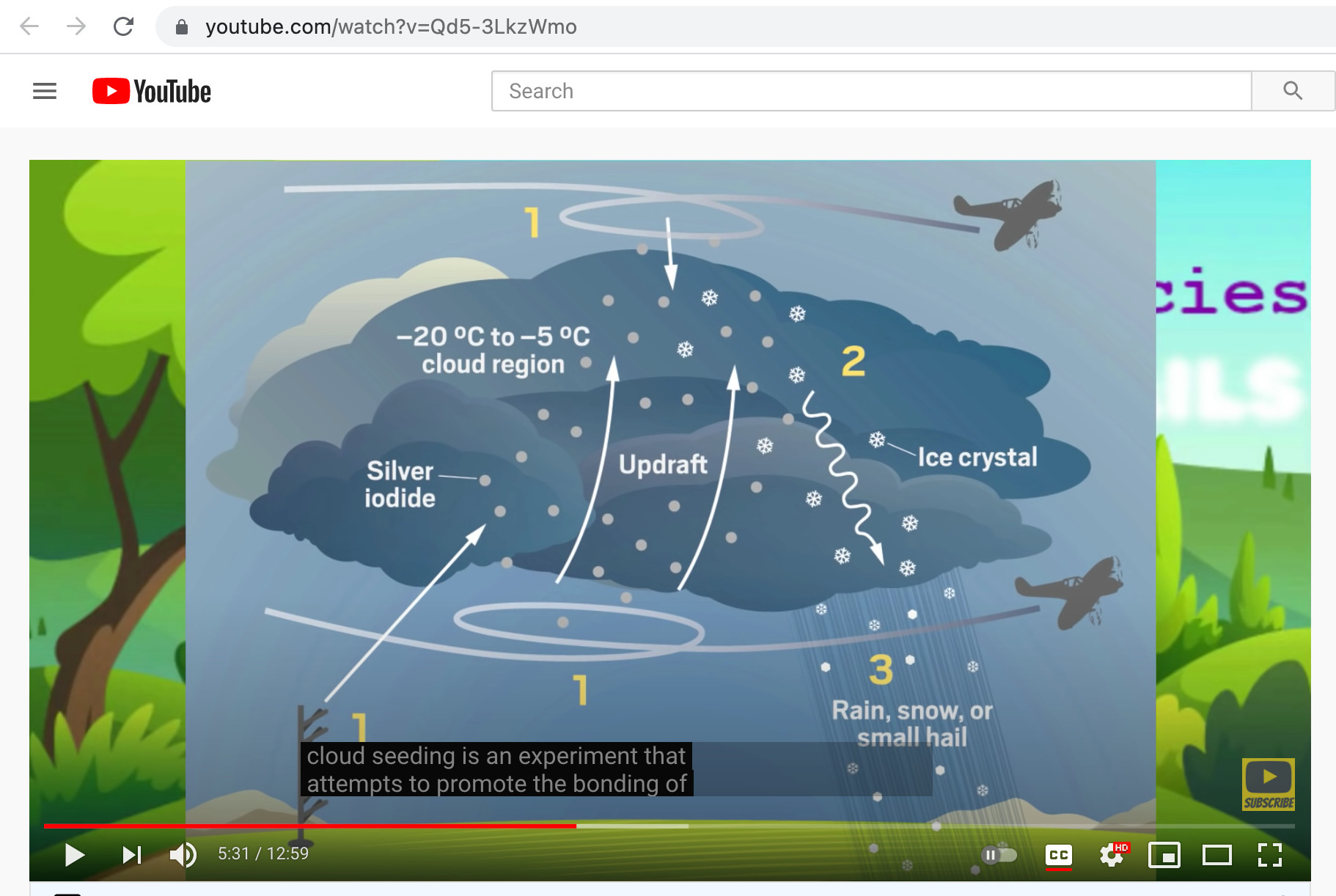
Cloud seeding is an experiment that attempts to promote the bonding of molecules in clouds that already exist. Cloud seeding began as early as the 1960’s. These experiments are done using bonding chemicals like silver iodide, which is an inert chemical that attracts moisture to promote rainfall. Cloud seeding is not a shady hidden agenda run by the illuminati, but a very public operation that can be tracked and monitored. The aim of cloud seeding is to maximize the potential for rainfall in a very localized area during times of drought. Cloud seeding, like crop dusting, can’t create its own clouds or microclimate. It can’t be used as a cover from the sun’s radiation, and it certainly can’t control people’s thoughts or actions.
The next reason given is the idea of population control. A few brief points on the reality of governments focusing on how to manage population.
Firstly, any chemicals released into the atmosphere would affect all mammals, not just humans. In fact, it would be a heavier concentration for non-human animals as they are exposed more to the outdoors than people. In recent years ongoing studies show that in farmed and wild herds of what is traditionally seasonal creatures, these seasons are starting to break down. In goats and sheep for example, it is fast becoming possible for two mating seasons per year instead of one. This leads to a bigger population, not a smaller one.
But back to people the idea of concentrated chemicals being purposely produced to stop fertilization in humans contradict the morals of most governments in societies today. Where women, up to the age of 45 are often refused sterilization should they request it, and where birth control methods are often very expensive or outright illegal, there are much better ways of controlling population numbers then spraying the upper atmosphere, most of which is unlikely to meet the target destination with crosswinds and other variables.
Following on from this is the idea that these alleged chemicals are designed to modify the behavior of humans. There is a belief that the chemicals being released creates docile humans. There is one glaringly obvious problem with this. The weather does not control crime figures. If these chemicals made humans docile, there would not be a sustained level of violent crime. There have also due to lingering economic crashes, been wave after wave of resistance in the streets in many different countries. From the Indignados and Basque independence movements in Spain, to the Arab Spring in 2011, to Occupy Wallstreet and the massive surge in voting numbers during the last U.S. presidential election for all candidates
8:25
THIS ARTICLE IS STILL IN PROCESS
More info here:
Where have all the CHEMTRAILS gone?, by FlatEarthLunacy
- -
Debunking the Chemtrailers!, by SciManDan and Mick West
https://www.youtube.com/watch?v=eU2Kbs_Bnx8
Mick West tells us all how he started out with debunking chemtrails, and how successful he really was!
- - - - - - - - - - - - - - - - - - - - - - - - - - - - - - - - - - - - - - - - - - - - -
Posted on May 31, 2021
What is the physical constituency of our universe?
Dark Energy Survey Makes Most Precise Measurements Yet of Universe’s Composition and Growth (sci-news.com)
Excerpt:
Over the course of six years, astronomers with the Dark Energy Survey (DES) surveyed 5,000 square degrees — almost one-eighth of the entire sky — in 758 nights of observation, cataloguing hundreds of millions of objects. Their results, published in 29 new papers, draw on data from the survey’s first three years — 226 million galaxies observed over 345 nights — to create the largest and most precise maps yet of the distribution of galaxies in the Universe at relatively recent epochs.
DES images the night sky using the 570-megapixel Dark Energy Camera on NSF’s Víctor M. Blanco 4-m Telescope at Cerro Tololo Inter-American Observatory in Chile, a program of NSF’s NOIRLab.
One of the most powerful digital cameras in the world, the Dark Energy Camera was designed specifically for this survey.
“NOIRLab is a proud host for and member of the DES Collaboration,” said Dr. Steve Heathcote, associate director of Cerro Tololo Inter-American Observatory.
“Both during and after the survey, the Dark Energy Camera has been a popular choice for community and Chilean astronomers.”
To test cosmologists’ current model of the Universe, the DES astronomers compared their results with measurements from ESA’s Planck observatory.
Planck used light signals known as the Cosmic Microwave Background to peer back to the early Universe, just 400,000 years after the Big Bang.
The Planck data give a precise view of the Universe 13 billion years ago, and the standard cosmological model predicts how the dark matter should evolve to the present.
If DES’s observations don’t match this prediction, there is possibly an undiscovered aspect to the Universe.
While there have been persistent hints from DES and several previous galaxy surveys that the current Universe is a few percent less clumpy than predicted — an intriguing find worthy of further investigation — the recently released results are consistent with the prediction.
“In the area of constraining what we know about the distribution and structure of matter on large scales as driven by dark matter and dark energy, DES has obtained limits that rival and complement those from the Cosmic Microwave Background,” said Dr. Brian Yanny, an astronomer at DOE’s Fermilab.
“It’s exciting to have precise measurements of what’s out there and a better understanding of how the Universe has changed from its infancy through to today.”
(Please read the article posted at the URL above)
- - -
The Dark Energy Camera (The Astronomical Journal)
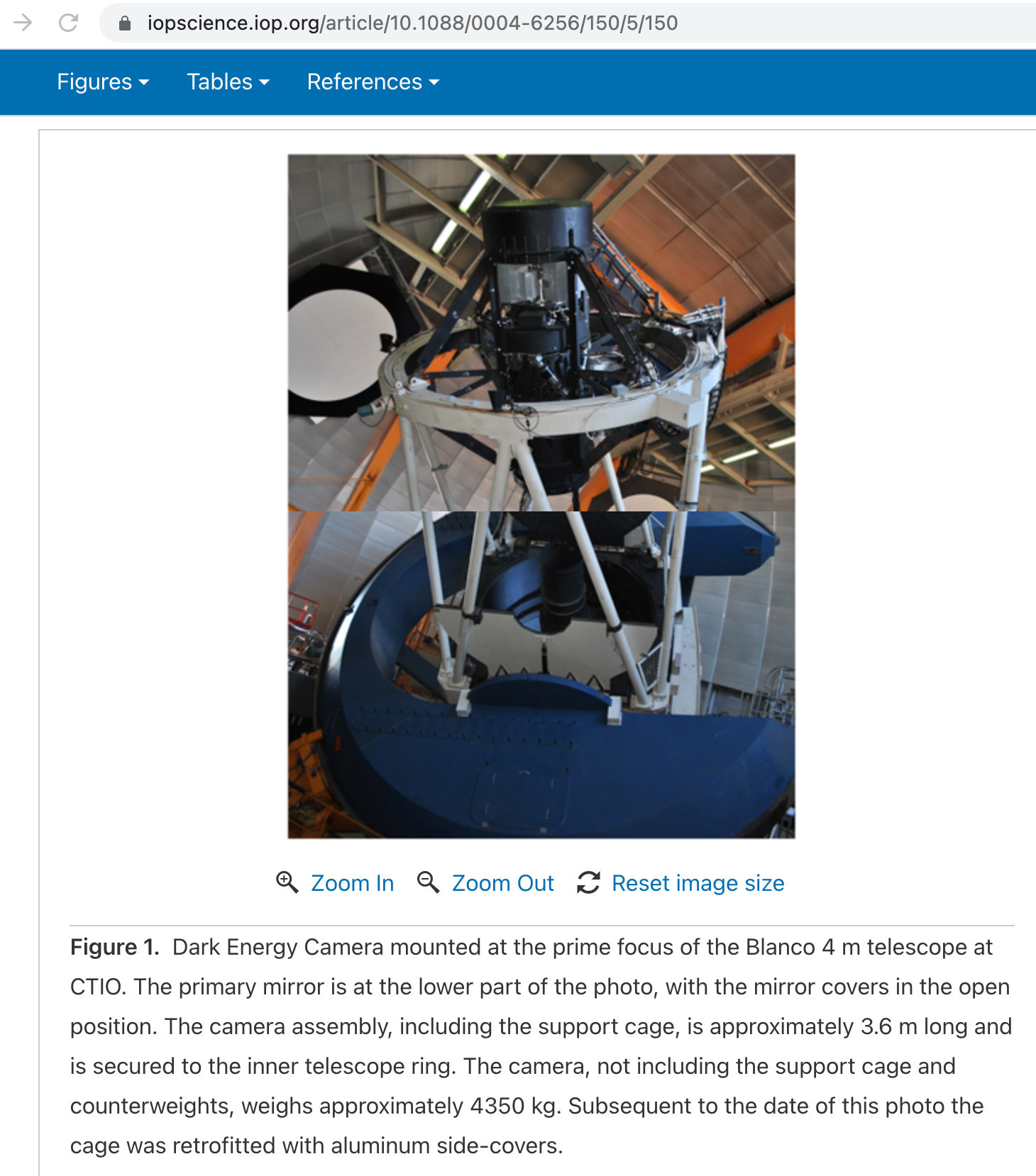
(Please read the article posted at the URL above)
- - -
Exploring 7 billion light years of space with the Dark Energy Survey (firmilab)
https://www.youtube.com/watch?v=4TkyxLENS5Q
The Dark Energy Survey tackles big questions about our universe: What is it made of? How is matter distributed? How has the universe evolved? And what roles do dark matter and dark energy play? To address these puzzles, the experiment uses a powerful 570-megapixel camera to photograph galaxies close to home and billions of light years away. The analysis of the first three years of data resulted in the largest maps ever made showing the distribution and shapes of galaxies in our universe – and provided a fantastic test for scientist’s best predictions.
Dark Energy Survey releases most precise look at the universe’s evolution:
https://news.fnal.gov/2021/05/dark-en...
Recent results from the Dark Energy Survey:
https://www.darkenergysurvey.org/des-...
Dark Energy Survey:
https://www.darkenergysurvey.org
Fermilab:
https://fnal.gov
(Please watch the video at the URL above)
- - - - - - - - - - - - - - - - - - - - - - - - - - - - - - - - - - - - - - - - - - - - -
Posted on May 28, 2021
Clouds in the skies of Mars
Curiosity Spots Carbon Dioxide-Ice Clouds in Martian Skies (sci-news.com), May 28, 2021
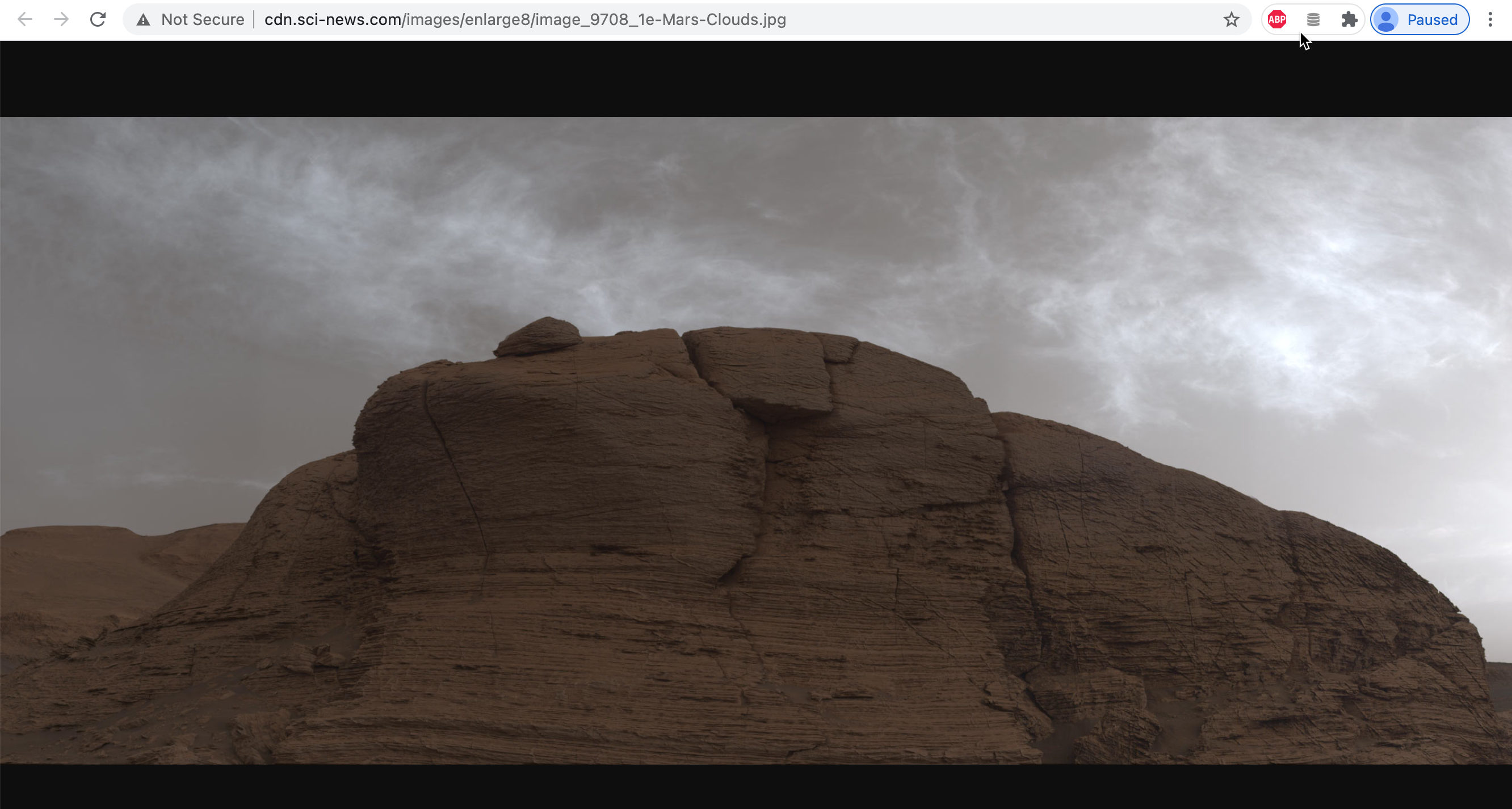
Excerpt:
In March 2021, NASA’s Curiosity rover observed clouds made of carbon dioxide (CO2) ice at high altitudes in the atmosphere of Mars.
Clouds are typically found at the equator of Mars in the coldest time of year, when the planet is the farthest from the Sun in its oval-shaped orbit.
But two Earth years ago, the Curiosity team members spotted clouds in the Martian atmosphere earlier than expected.
This year, they were ready to start documenting these early clouds from the moment they first appeared in January.
What resulted are images of wispy puffs filled with ice crystals that scattered light from the setting Sun, some of them shimmering with color.
The researchers also found that the early-arrival clouds are actually at higher altitudes than is typical.
Most Martian clouds hover no more than about 60 km (37 miles) in the sky and are composed of water ice.
But the clouds Curiosity has imaged are at a higher altitude, where it’s very cold, indicating that they are likely made of frozen carbon dioxide.
(Please read the article posted at the URL above)
- - - - - - - - - - - - - - - - - - - - - - - - - - - - - - - - - - - - - - - - - - - - -
Posted on May 27, 2021
Look thru a telescope yourself, to verify that the Moon, Sun & Planets are real objects in space.
Local city and county astronomy clubs with free observatory public nights are everywhere.
See for yourself. There is no reason to believe or support the Flat Earth Trilobites.
Astronomy Clubs in the USA listed by State and alphabetically
https://www.facebook.com/SummitCountyAstronomy/
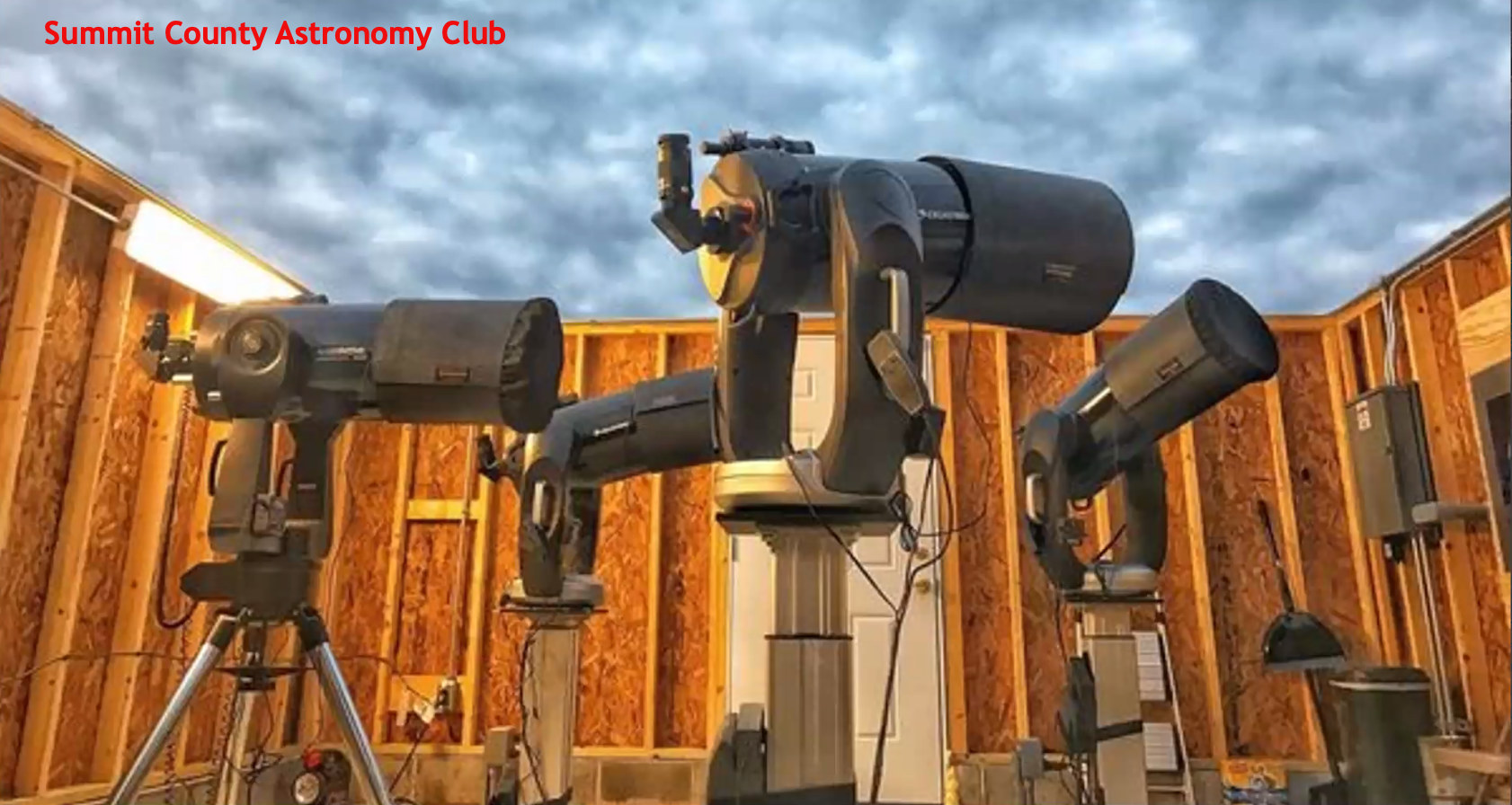
- - - - - - - - - - - - - - - - - - - - - - - - - - - - - - - - - - - - - - - - - - - - - - - - - - - - - - - - - - - - - - - - - - - - - - - - - - - - - -
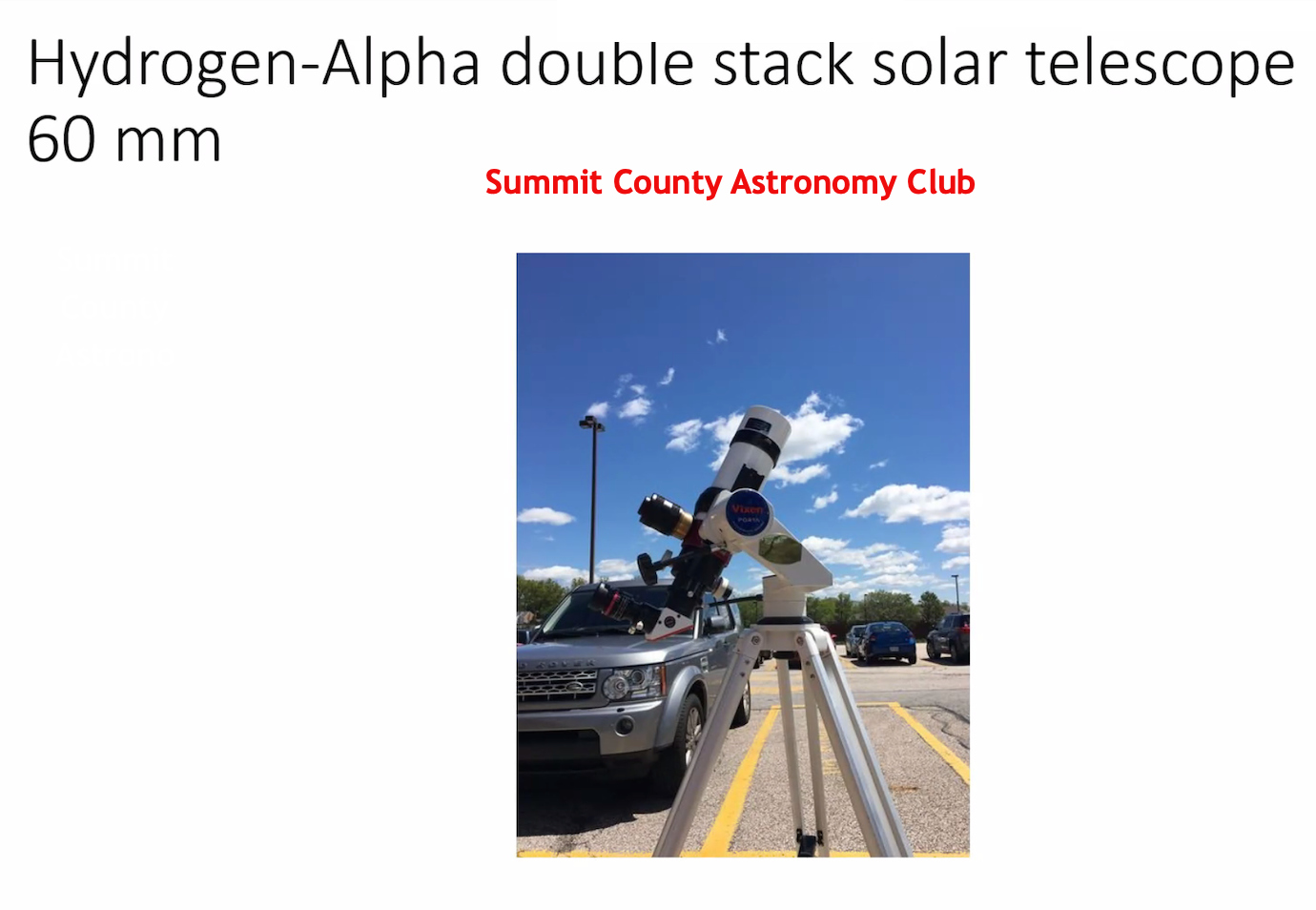
- - - - - - - - - - - - - - - - - - - - - - - - - - - - - - - - - - - - - - - - - - - - - - - - - - - - - - - - - - - - - - - - - - - - - - - - - - - - - -
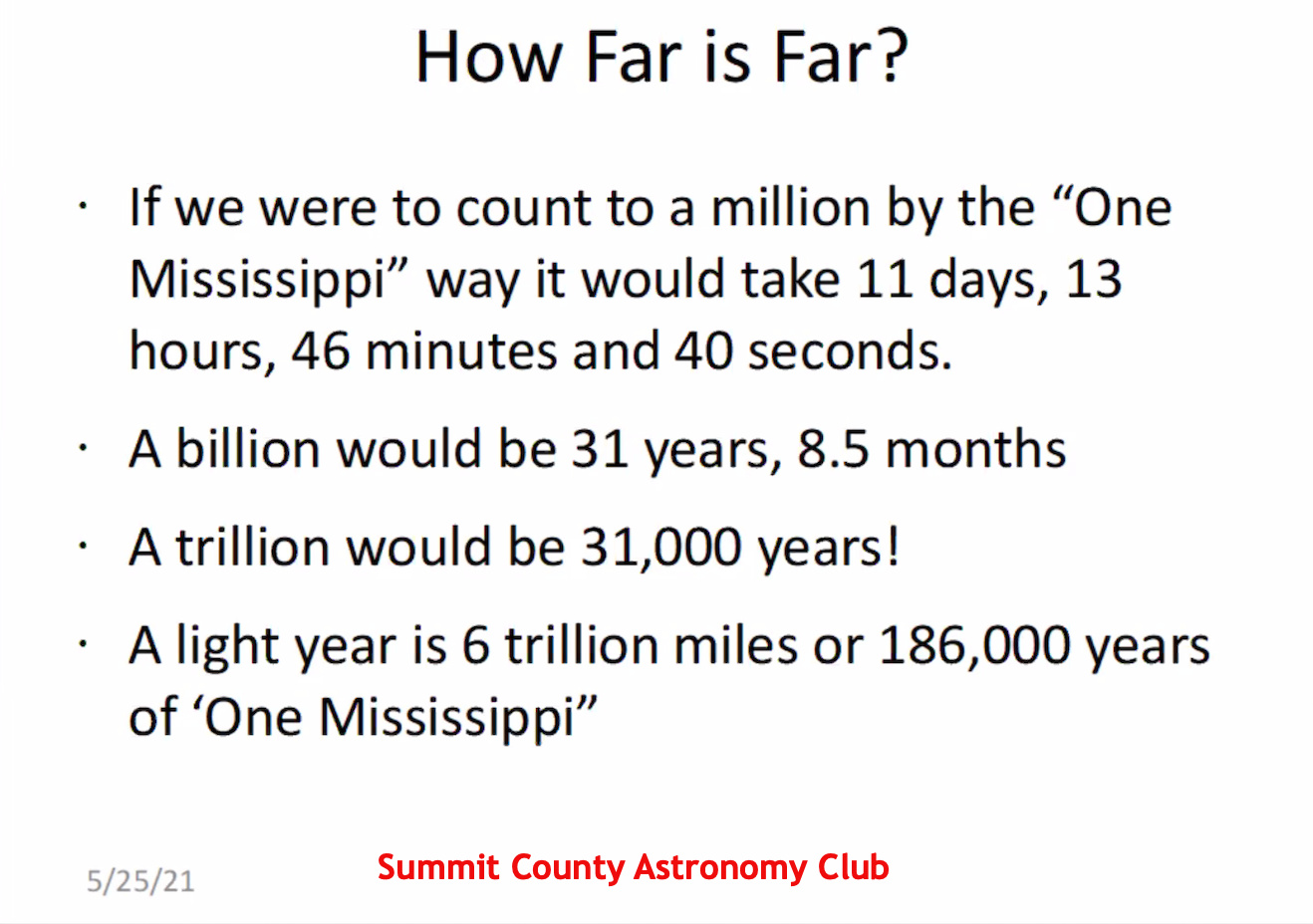
- - - - - - - - - - - - - - - - - - - - - - - - - - - - - - - - - - - - - - - - - - - - - - - - - - - - - - - - - - - - - - - - - - - - - - - - - - - - -
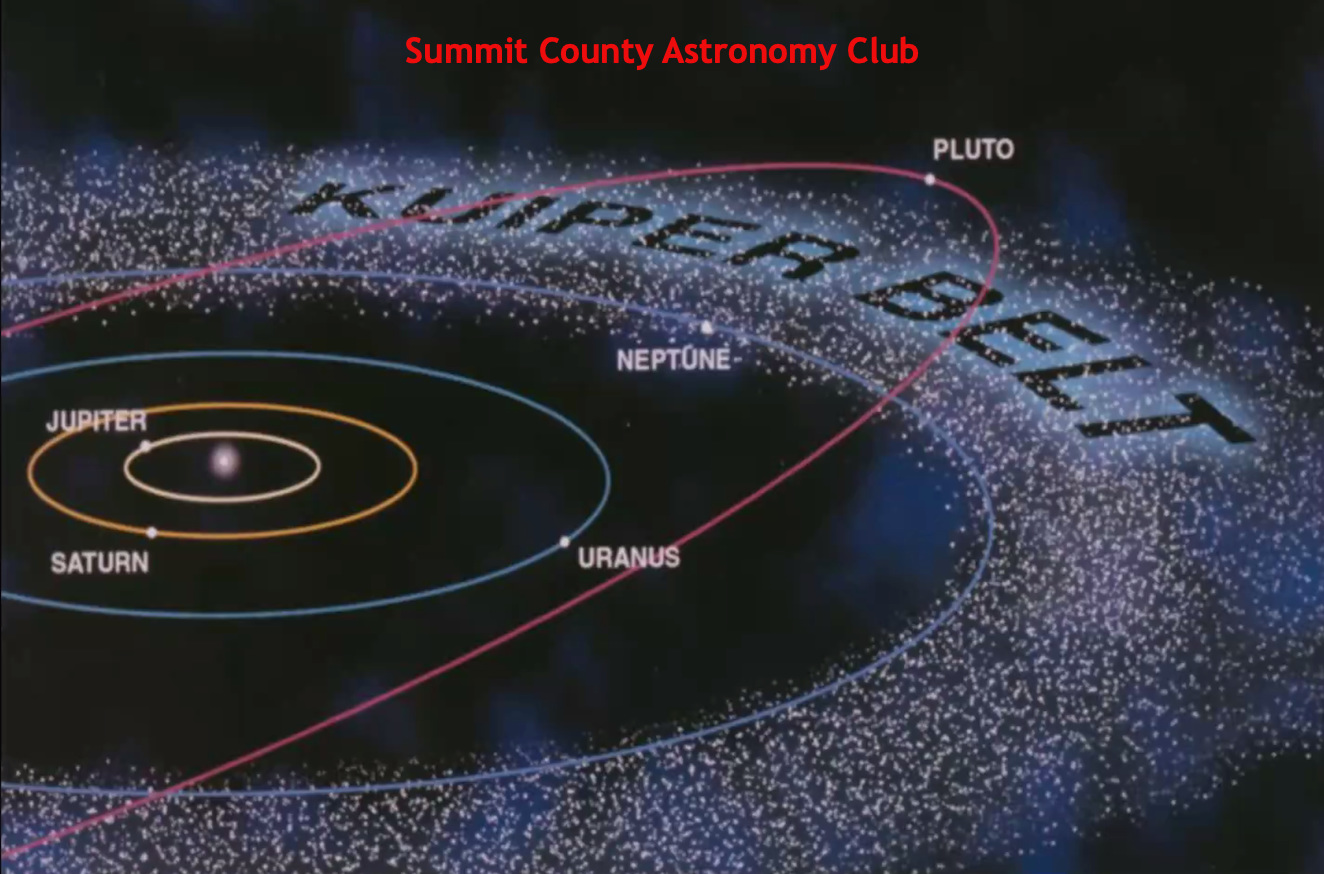
- - - - - - - - - - - - - - - - - - - - - - - - - - - - - - - - - - - - - - - - - - - - - - - - - - - - - - - - - - - - - - - - - - - - - - - - - - - - -
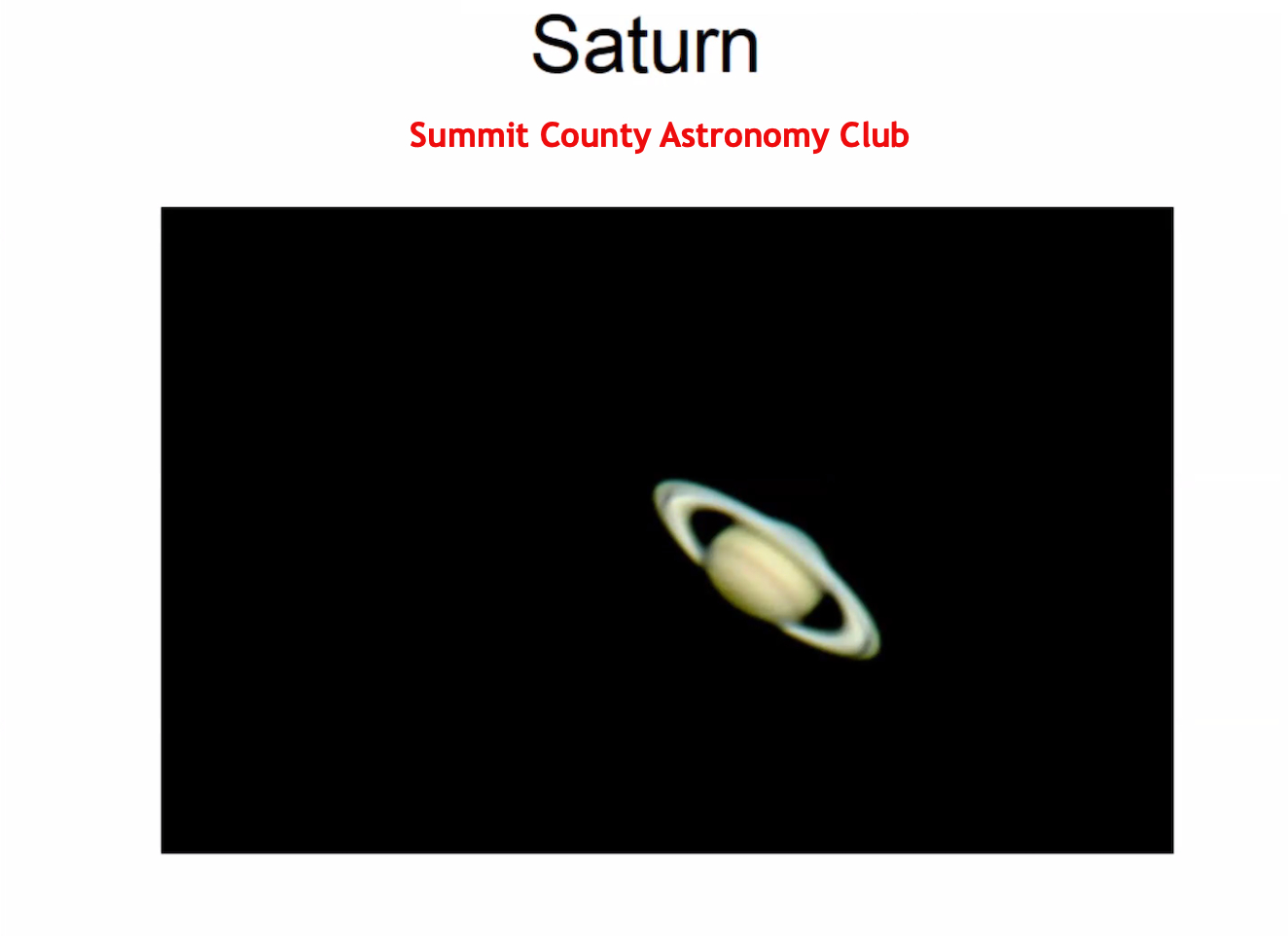
- - - - - - - - - - - - - - - - - - - - - - - - - - - - - - - - - - - - - - - - - - - - - - - - - - - - - - - - - - - - - - - - - - - - - - - - - - - - -
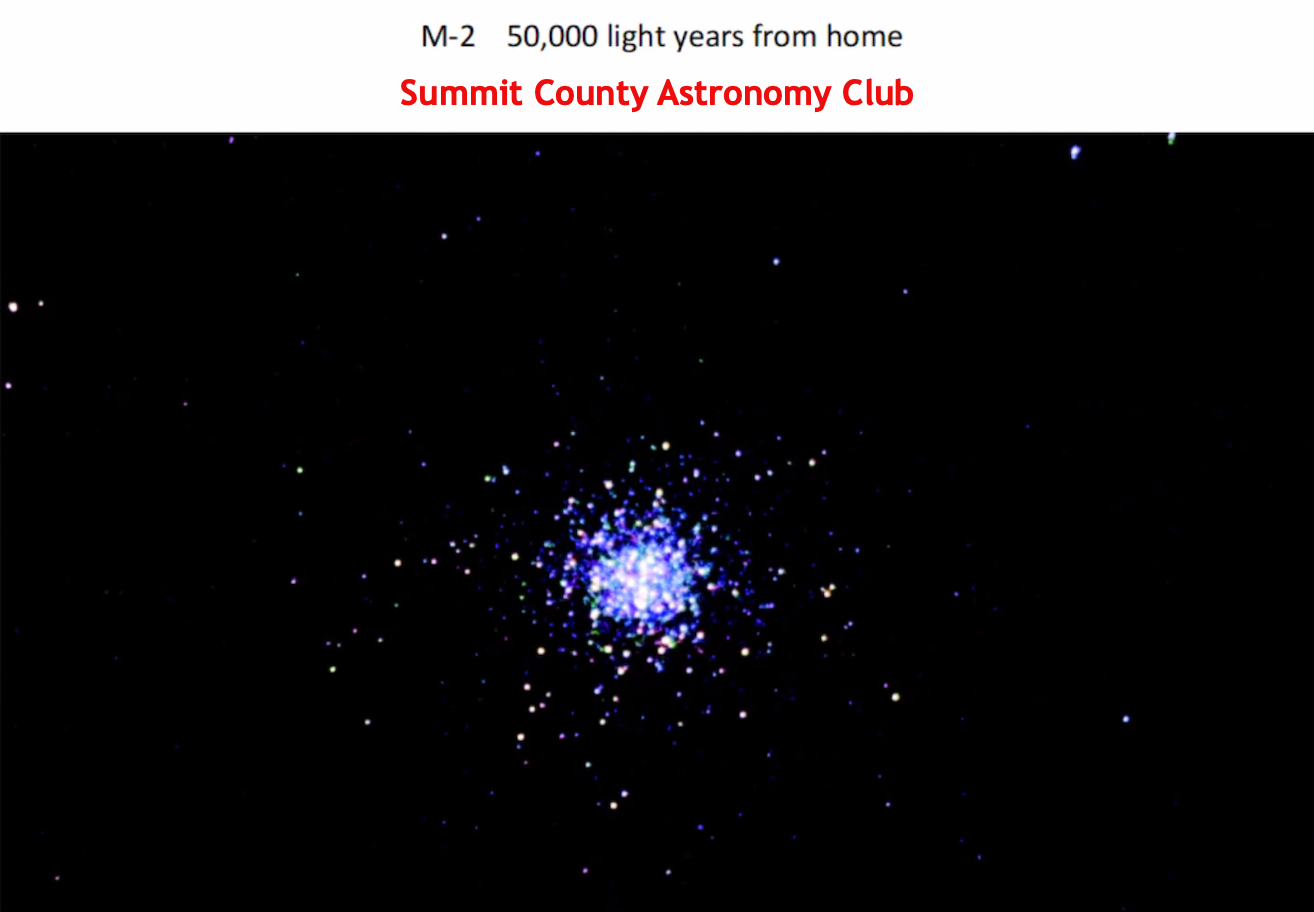
- - - - - - - - - - - - - - - - - - - - - - - - - - - - - - - - - - - - - - - - - - - - -
Posted on May 25, 2021
David Hash - tracks and photographs the Chinese Tiangong Space Station from the ground, using his 11-inch telescope.
https://twitter.com/turndownformars/status/1396718996678840320
Attention flat Earthers. You going to NOW claim that Tiangong does not exist, just like you have done for years with the ISS (International Space Station)?
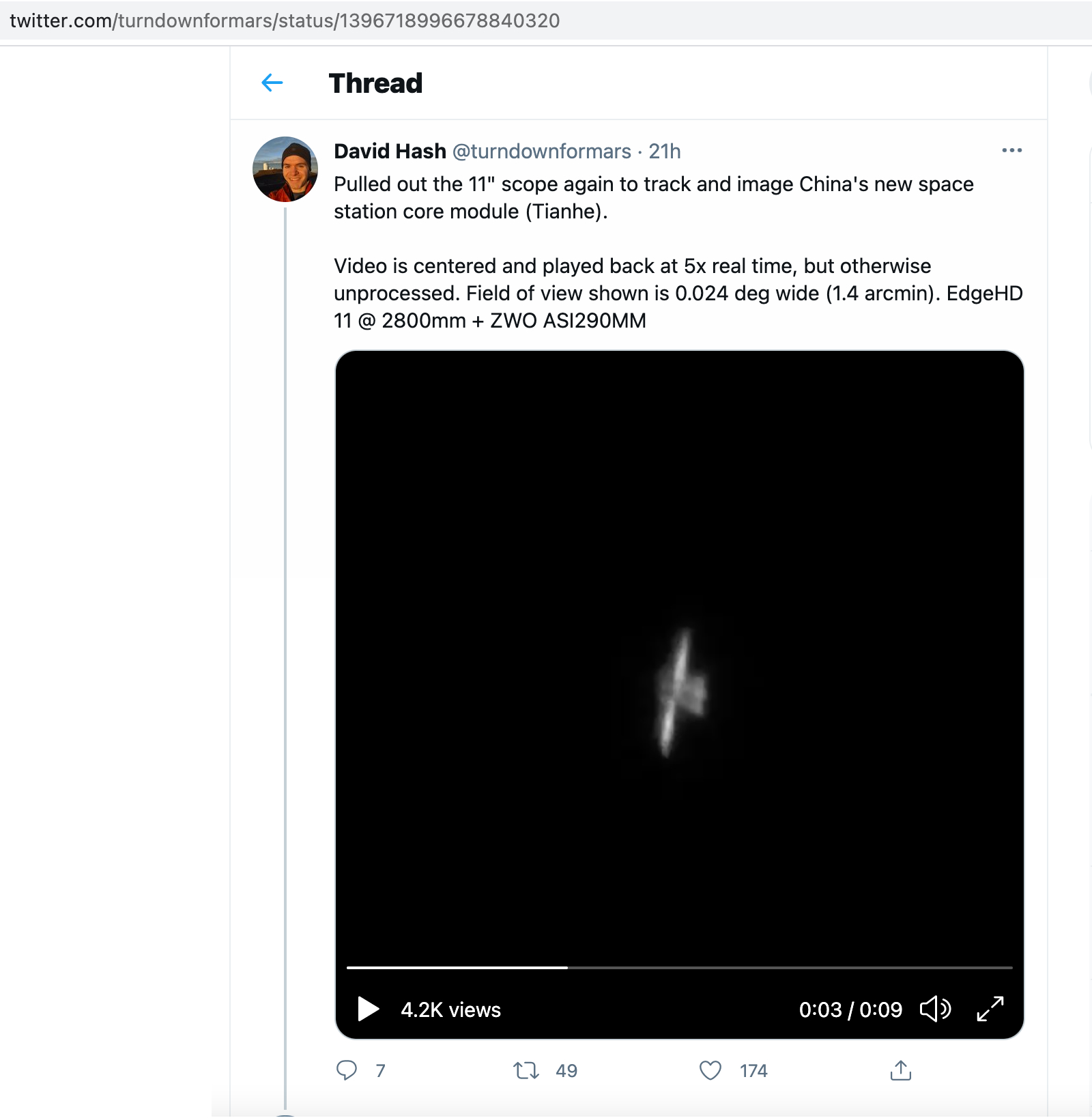
-
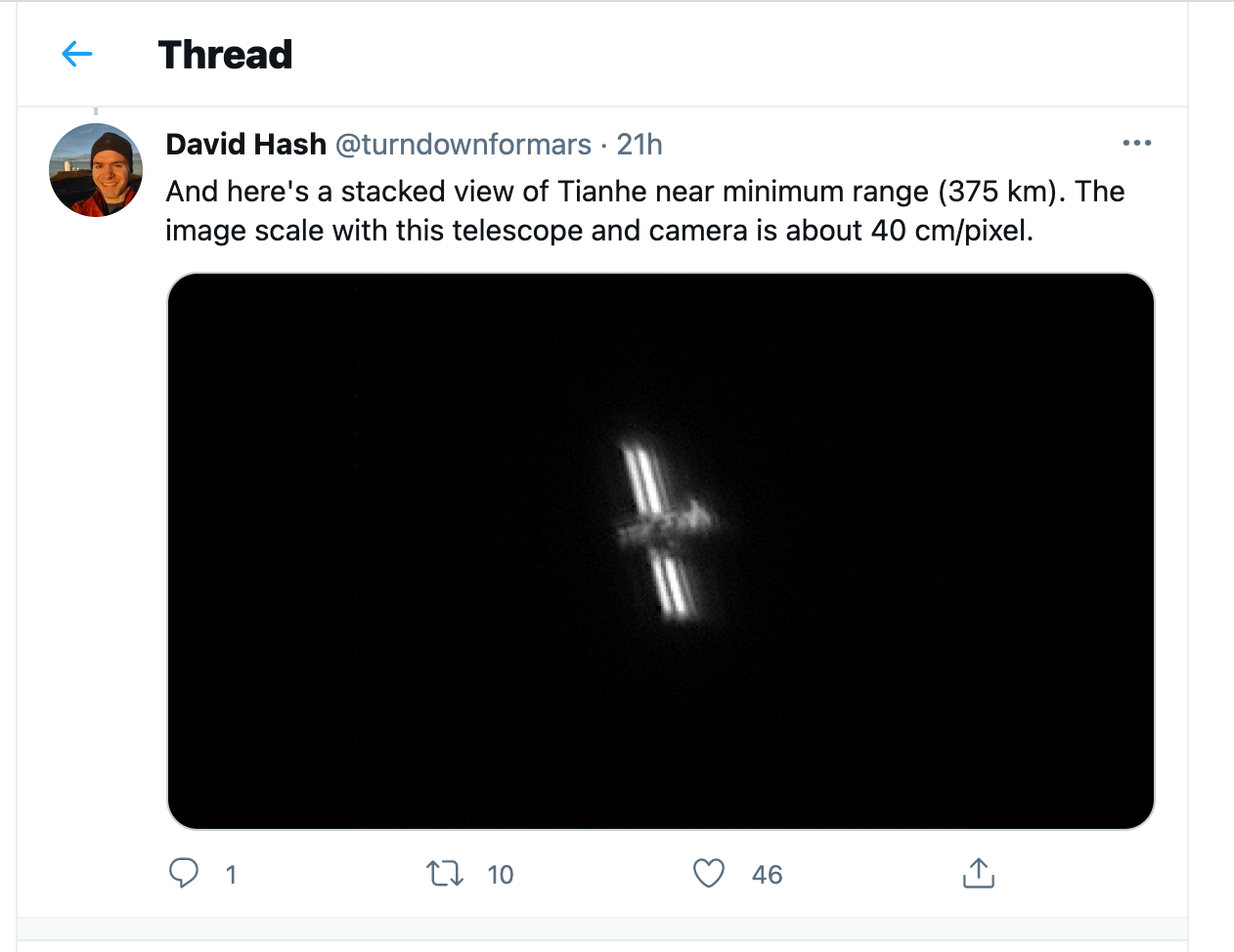
- -
China successfully launches cargo resupply spacecraft (aljazeera.com)
Excerpt:
Tianzhou-2 is the second of 11 missions needed to complete China’s first permanent space station.
China has successfully launched an automated cargo resupply spacecraft to rendezvous with an orbiting module, in the second of a series of missions needed to complete its first permanent space station.
The Tianzhou-2, or Heavenly Vessel in Chinese, blasted off via a Long March-7 Y3 rocket from the Wenchang Space Launch Centre on the southern island of Hainan in the South China Sea, the China Manned Space Engineering Office said on Saturday.
Tianzhou-2 is the second of 11 missions needed to complete China’s first self-developed space station around 2022, and follows the launch of the key module Tianhe in late April.
The Tianhe, or Heavenly Harmony, is the third and largest orbital station launched by China’s increasingly ambitious space programme.
The three-module space station will rival the only other station in service, the International Space Station (ISS), which is backed by countries including the United States, Russia and Japan.
China was barred from participating in the ISS by the US. Washington is wary of the secrecy surrounding the Chinese programme and its military connections.
Tianzhou-2 will autonomously dock with Tianhe, which will provide supplies for future astronauts as well as a propellant to maintain its orbital altitude.
(Please read the article posted at the URL above)
- - - - - - - - - - - - - - - - - - - - - - - - - - - - - - - - - - - - - - - - - - - - -
Posted on May 22, 2021
Virgin Galactic's effort to make Space Tourism a reality, as soon as possible.
Virgin Galactic successfully makes first human spaceflight from New Mexico, by Mihir Neal (nasaspaceflight.com)
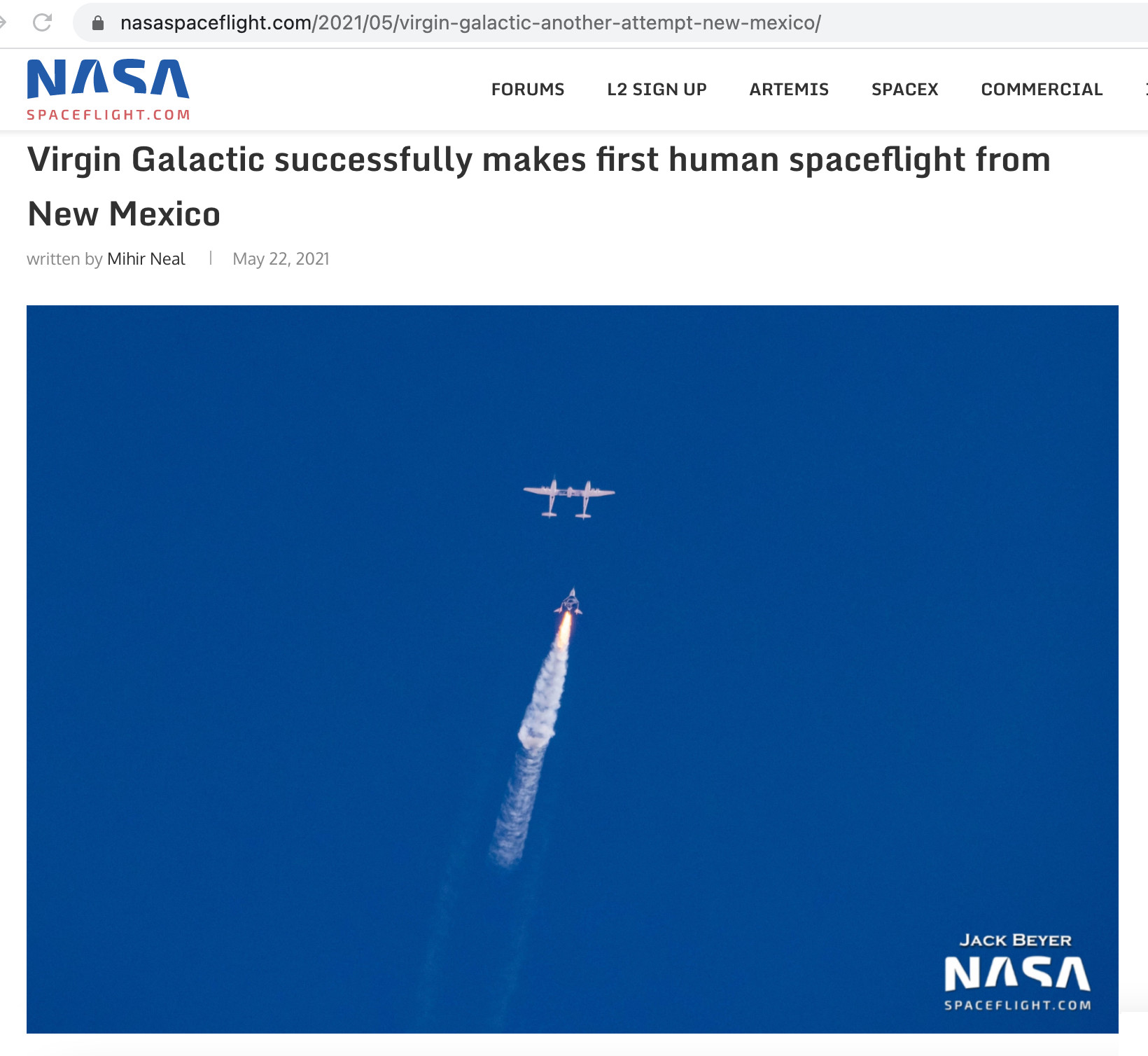
Excerpt:
Virgin Galactic has successfully performed the first human spaceflight from Spaceport America, just south of Truth or Consequences, New Mexico, today, using the VSS Unity SpaceShipTwo spacecraft. The WhiteKnightTwo carrier aircraft VMS Eve climbed to an altitude of 44,000 feet before releasing VSS Unity for a rocket-powered flight to space.
Flight restrictions in the airspace above Spaceport America indicated a launch window that opened at 8:00 AM MDT (14:00 UTC) on Saturday May 22, continuing until 4:00 PM MDT (22:00 UTC) on Sunday May 23. VMS Eve and VSS unity took off at 8:34 AM MDT (14:34 UTC), and release occurred at 9:26 AM MDT (15:26 UTC). The flight achieved an apogee of 89.2 kilometers.
This is a historic flight, not just for Virgin Galactic and their ambitions to take paying passengers on a suborbital flight, but for the state of New Mexico as well. Previously, only the Kyzylorda Region (Kzyl Ordinskaya oblast) in Kazakhstan, Florida, California, and the Inner Mongolia Autonomous Region of China had hosted human launches to space. Today’s flight culminated a long-standing goal for New Mexico and Spaceport America: to host human spaceflight.
VSS Unity’s first attempt to space from New Mexico was unsuccessful as its engine aborted just one second into the flight on December 12, 2020. The crew was safe and brought Unity to a successful, unpowered descent and landing after the abort...
(Please read the article posted at the URL above)
-
Virgin Galactic Receives Approval from FAA for Full Commercial Launch License Following Success of May Test Flight (spaceref.com)
http://spaceref.com/news/viewpr.html?pid=57653
Excerpt:
Press Release From: Virgin Galactic
Posted: Friday, June 25, 2021
Virgin Galactic Holdings, Inc. (NYSE: SPCE) (“the Company” or “Virgin Galactic”) today announced that the Federal Aviation Administration (“FAA”) updated the Company’s existing commercial space transportation operator license to allow the spaceline to fly customers to space.
The Company also announced that it has completed an extensive review of data gathered from its May 22 test flight and confirmed that the flight performed well against all flight objectives.
The adjustment to Virgin Galactic’s operator’s license, which the Company has held since 2016, marks the first time the FAA has licensed a spaceline to fly customers. It is further validation of the Company’s methodical testing program, which has met the verification and validation criteria required by the FAA.
Michael Colglazier, Chief Executive Officer of Virgin Galactic, said: “We’re incredibly pleased with the results of our most recent test flight, which achieved our stated flight test objectives. The flight performed flawlessly, and the results demonstrate the safety and elegance of our flight system. Today’s approval by the FAA of our full commercial launch license, in conjunction with the success of our May 22 test flight, give us confidence as we proceed toward our first fully crewed test flight this summer.”
The May 22 test flight of VMS Eve and VSS Unity was the Company’s third crewed spaceflight and the first-ever spaceflight from Spaceport America, New Mexico. The flight achieved a speed of Mach 3 and reached space at an altitude of 55.5 miles. After an extensive review of the data collected during the flight, the Company confirmed that:
- The rocket-powered test of the spaceship’s upgraded horizontal stabilizers and flight controls demonstrated strong performance, in line with predictions. These enhanced systems, which allow for finer pilot control, will also be deployed in future spaceships in the Company’s fleet.
- The cabin environment data was in line with predictions.
- The flight successfully carried three revenue-generating research experiments that tested and demonstrated technologies in microgravity as part of NASA’s Flight Opportunities Program. The pilots flew VSS Unity on a specific trajectory designed to meet the objectives of these research experiments.
With the data analysis from the May flight now complete, Virgin Galactic will continue preparing for the remaining three test flights.
(Please read the article posted at the URL above)
-
Virgin Galactic reopens ticket sales — for $450,000 per seat (cnn.com)
https://www.cnn.com/2021/08/05/tech/virgin-galactic-ticket-prices-sales-scn/index.html?utm_source=feedburner&utm_medium=feed&utm_campaign=Feed%3A+rss%2Fcnn_world+%28RSS%3A+CNN+-+World%29
Excerpt:
Virgin Galactic also previously announced that it would raffle off two seats on SpaceShipTwo to people who donate to Space For Humanity, a non-profit with the stated goal of helping to "democratize space." The company revealed Thursday during an investor call that more than 125,000 people from 190 countries have donated.
People who do opt to put up the $450,000 for a seat may have to wait quite a while for their turn, however. More than 600 people — who purchased tickets for between $200,000 and $250,000 when Virgin Galactic sold its first batch of tickets nearly a decade ago — are already on the waiting list for their chance to take a trip to the edge of space....
(Please read the full article posted at the URL above)
- - - - - - - - - - - - - - - - - - - - - - - - - - - - - - - - - - - - - - - - - - - - -
Posted on May 21, 2021
More commercial companies are providing launch services at cheaper prices.
Flat Earthers, time is not in your side. Give up your globe earth DENIALS and retreat while you still can with some dignity
ABL Space Systems joining small sat launch market with growing number of contracts, by Thomas Burghardt (nasaspaceflight.com)

Excerpt:
Another smallsat launch provider is looking to debut in 2021, entering a busy market of new commercial rockets. Among the many new companies proposing to provide dedicated launches for small satellites, ABL Space Systems has accumulated several launch contracts which position the company well for a first launch this year.
ABL Space Systems, like many new space startups, have positioned themselves physically near hotspots of aerospace engineering talent. Headquartered in El Segundo, California, near Los Angeles, ABL shares the city with the headquarters of both the Aerospace Corporation and Aerojet Rocketdyne, as well as offices for several other major aerospace companies. El Segundo is also directly adjacent to Hawthorne, the home of SpaceX HQ.
The team of just over 100 employees also consists of several aerospace veterans from prominent companies. CEO Harry O’Hanley led development of the grid fin system used to land Falcon 9 and Falcon Heavy stages at SpaceX prior to co-founding ABL. Other prominent figures at ABL include Chief Engineer Matt Becker, an original member of the Virgin Orbit propulsion team, and Guidance Navigation and Control (GNC) Director Josh Hathaway, formerly a GNC engineer at SpaceX.
The team is currently developing the RS1, a two stage rocket fueled by kerosene and liquid oxygen. The launch vehicle would primarily use Rocket Propellant 1 (RP-1), the same grade of kerosene used by the Falcon, Atlas V, Electron, and Soyuz rockets. However, at the cost of a small decrease in performance, the E2 engines which power the RS1 can also be fueled by Jet-A, a more commonly available grade of kerosene used by jet aircraft...
... The price point of an RS1 launch is advertised as $12 million per launch, a competitive price when compared to the other commercial launchers in its weight class.
(Please read the article posted at the URL above)
- - - - - - - - - - - - - - - - - - - - - - - - - - - - - - - - - - - - - - - - - - - - -
Posted on May 17, 2021
New analysis by Sly Sparkane confirms that FECORE's 2018 Lake Balaton Laser Test, was an "I can see the laser" from a distance of 12.6 km (easily explained by refraction), not from 40.2 km as they advertised and claimed.
FECORE - 2018 Lake Balaton; The Biggest Laser Experiment in History goes BUST
-
Debunk by Sly Sparkane
About that FECore Laser Video pt 2, by Sly Sparkane
https://www.youtube.com/watch?v=4o3ioJt0Sd0
2 weeks of work researching literally hundreds of photos and tons of footage.. all summed up in about 6 mins..
But it's worth it..
Part 1 of this video. https://youtu.be/jOfkG8MjKlg
They only did an "I see it" test, which can easily be explained by refraction.
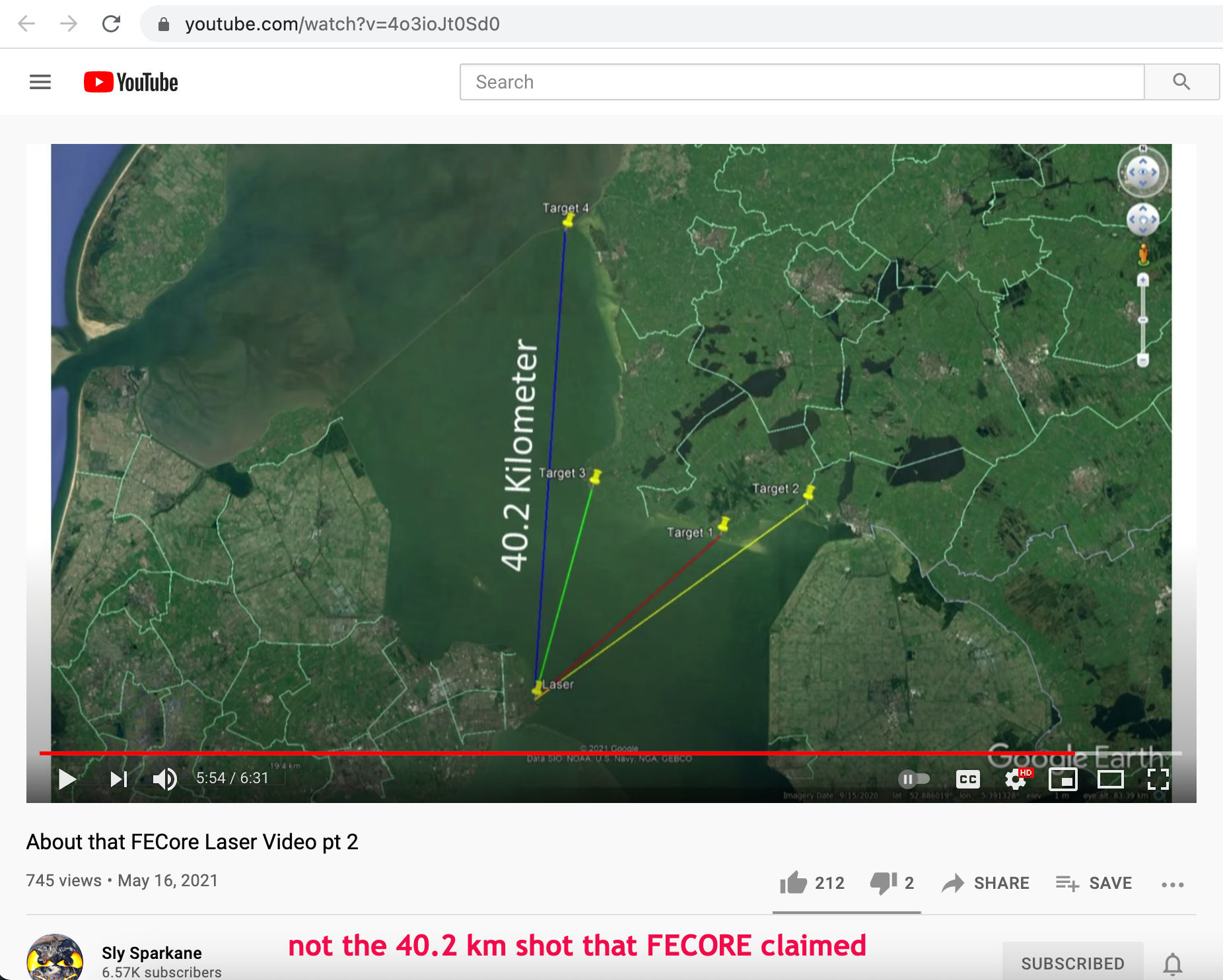
-
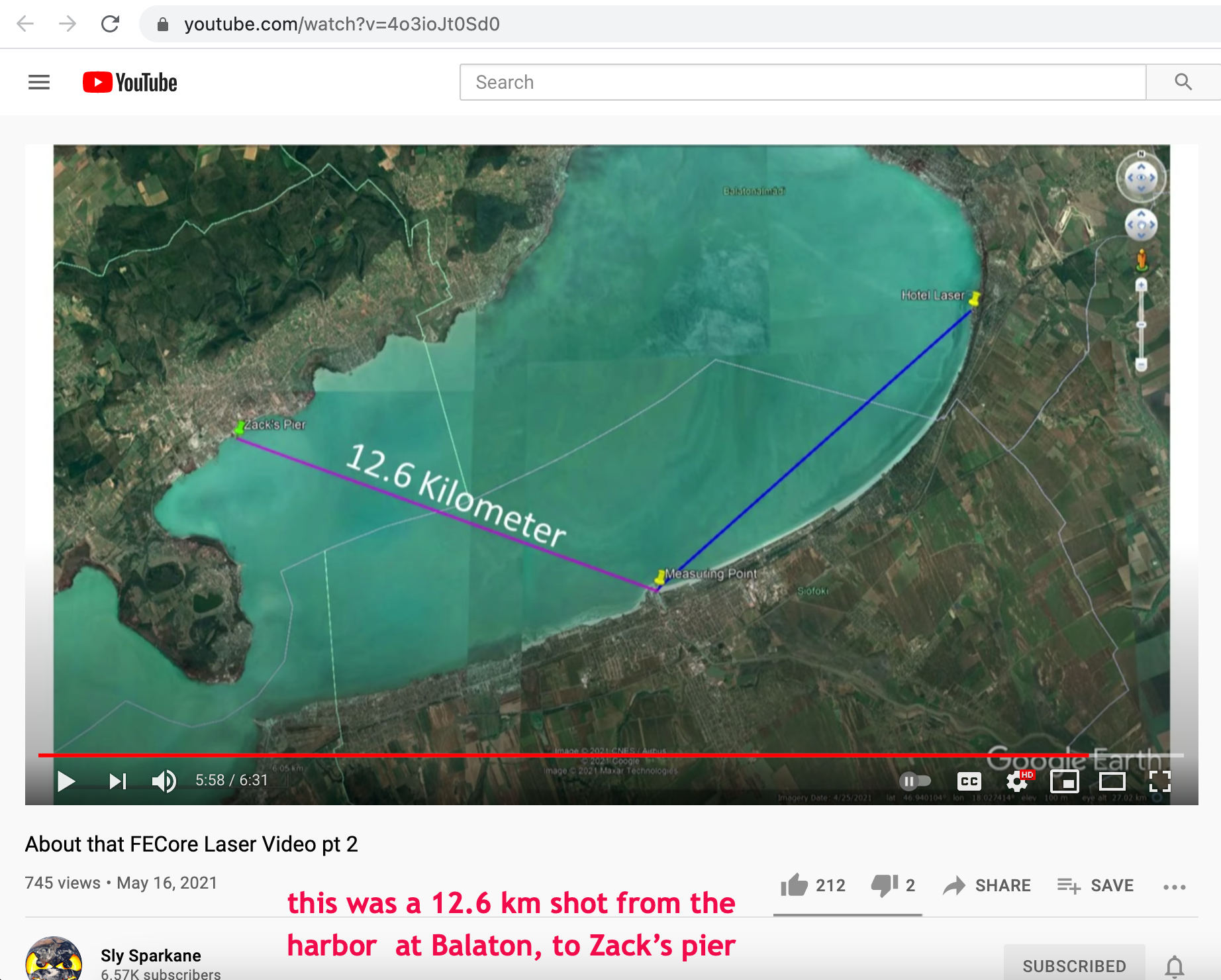
-
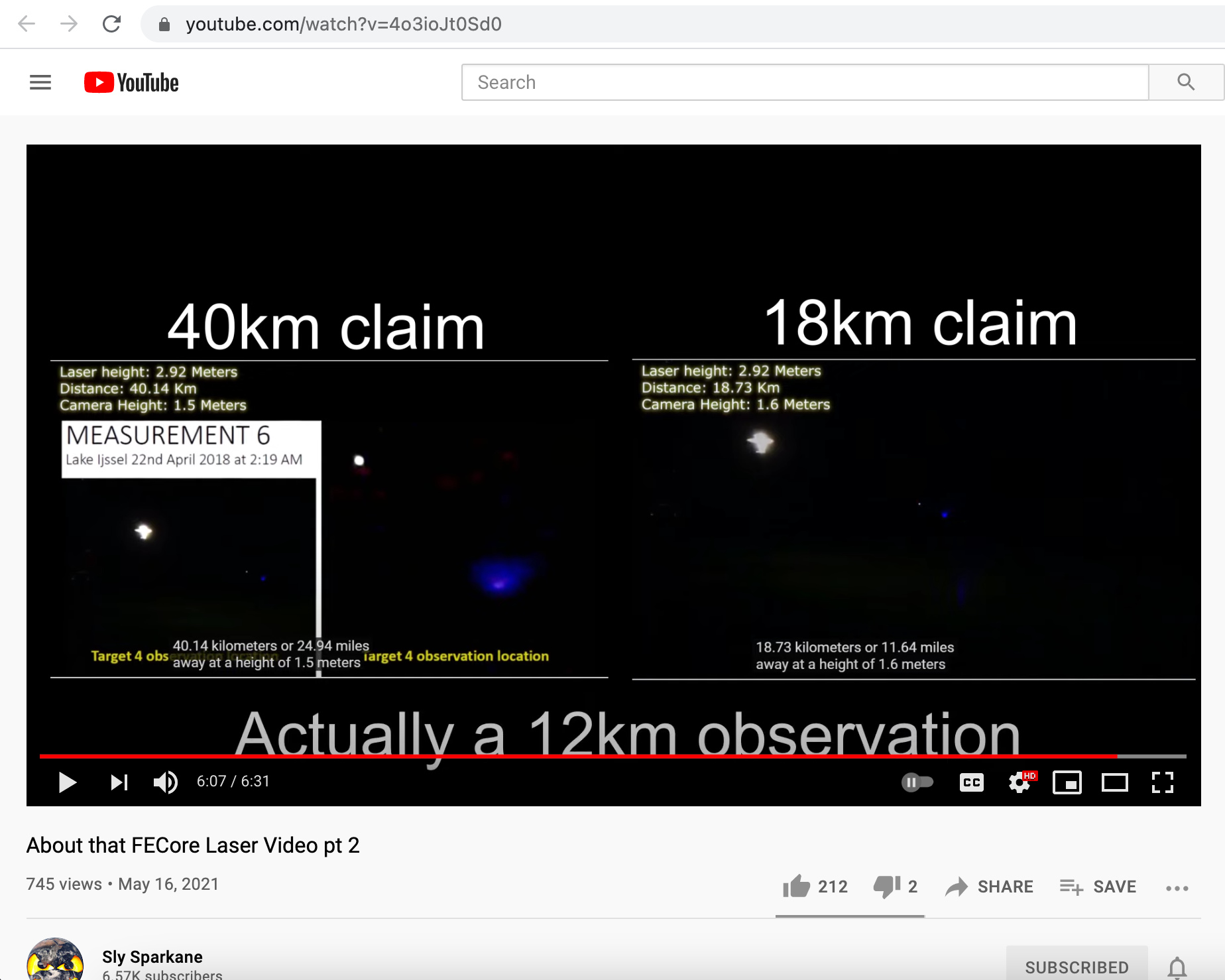
- - - - - - - - - - - - - - - - - - - - - - - - - - - - - - - - - - - - - - - - - - - - -
Posted on May 15, 2021
China lands its Zhurong rover on Mars (bbc.com)
https://www.bbc.com/news/science-environment-57122914
Calling all flat Earthers: Just to be fair, please contact the Chinese and tell them their space program is illuminati inspired, fake, planets cannot be landed on, there is no outer space, and all is CGI - as you have done with NASA. OK? Let us know what they tell you.
Excerpt:
China has successfully landed a spacecraft on Mars, state media announced early on Saturday.
The six-wheeled Zhurong robot was targeting Utopia Planitia, a vast terrain in the planet's northern hemisphere.
The vehicle used a combination of a protective capsule, a parachute and a rocket platform to make the descent.
The successful touchdown is a remarkable achievement, given the difficult nature of the task.
Only the Americans have really mastered landing on Mars until now. With this landing, China becomes the second country to put a rover on Mars.
Chinese President Xi Jinping congratulated the team's "outstanding achievement" in a special message.
"You were brave enough for the challenge, pursued excellence and placed our country in the advanced ranks of planetary exploration," he said.
The probe officially landed at 07:18 on Saturday, Beijing time (Friday 23:18 GMT), according to state media.
It took 17 minutes to unfold its solar panels and send a signal back to Earth.
Zhurong, which means God of Fire, was carried to Mars on the Tianwen-1 orbiter, which arrived above the planet in February.
The time since has been spent surveying Utopia, taking high-resolution images to pinpoint the safest place to put down.
The aim with all such ventures is to pick a spot, as far as possible, that is devoid of imposing craters and large boulders.
Chinese engineers have to follow events with a time lag.
The current distance to Mars is 320 million km, which means radio messages take almost 18 minutes to reach Earth.
Every stage of the Zhurong's approach to the surface therefore has to be managed autonomously.
The entry (into the atmosphere), descent and landing strategy follows a familiar architecture.
At the chosen moment, the rover, encased in an aeroshell, is released from the Tianwen orbiter and dives downwards.
A heatshield on the capsule slows the fall by pushing up against the Martian air. A parachute then opens to reduce the velocity still further. Finally, the robot breaks away on a rocket-powered bench for the manoeuvres that take it to the ground.
It is a daunting challenge, but China has shown great competence of late in its space endeavours, which have included putting two rovers on the Moon.
Now that Zhurong has got down successfully, scientists will try to get at least 90 Martian days of service out of it, studying the local geology. A day, or Sol, on Mars lasts 24 hours and 39 minutes.
The robot looks a lot like the American space agency's (Nasa) Spirit and Opportunity vehicles from the 2000s. It weighs some 240kg and is powered by fold-out solar panels.
A tall mast carries cameras to take pictures and aid navigation; five additional instruments will help assess the mineralogy of local rocks and look for any water-ice below ground.
(Please read the article at the URL's posted above)
-
China spacecraft makes successful landing on Mars | DW News
China has landed a spacecraft on Mars – the latest step in its ambitious space program.
The Chinese rover will stay in its lander for a few days of tests before exploring the Red Planet. The rover has yet to send back any images from Mars, but here's the story of how it got there -- and what the mission aims to find out.
After a treacherous journey through the Martian atmosphere, the Chinese spacecraft Tianhe lands safely on the red planet. A major triumph for Beijing's space ambitions, and the culmination of years of hard work. "This was not an easy task. It's our first time down this path, and we have encountered many difficulties. It was through a lot of hard work that, today, we were able to make our goals a reality. I'm delighted. This is a key event for the China Aerospace and Technology Corporation. This is the Chinese people's first rover landing on another planet."
The Zhurong rover on board will explore an icy area of Mars known as Utopia Planitia. It was formed by the violent impact of an asteroid about four billion years ago. Past space probes have discovered large amounts of frozen water under the surface here. An enormous layer of ice lies only a few meters below the surface. Using radar, Zhurong can precisely measure the underground ice.
The rover is named after the Chinese god of fire. Eight days after landing, when diagnostic tests are finished, it will go into action. NASA's two Mars robots use similar high-tech equipment to Zhurong. Even though NASA research takes years, Zhurong's mission will be short. For three months, the rover will explore the surface of Mars, measure its magnetic field and study the properties of weathered Martian rock. The probe will then forward the collected data back to earth, to a ground station in China.
(Please watch the video at the URL's posted above)
-
China on Mars: Zhurong rover returns first pictures, by Jonathan Amos (bbc.com)
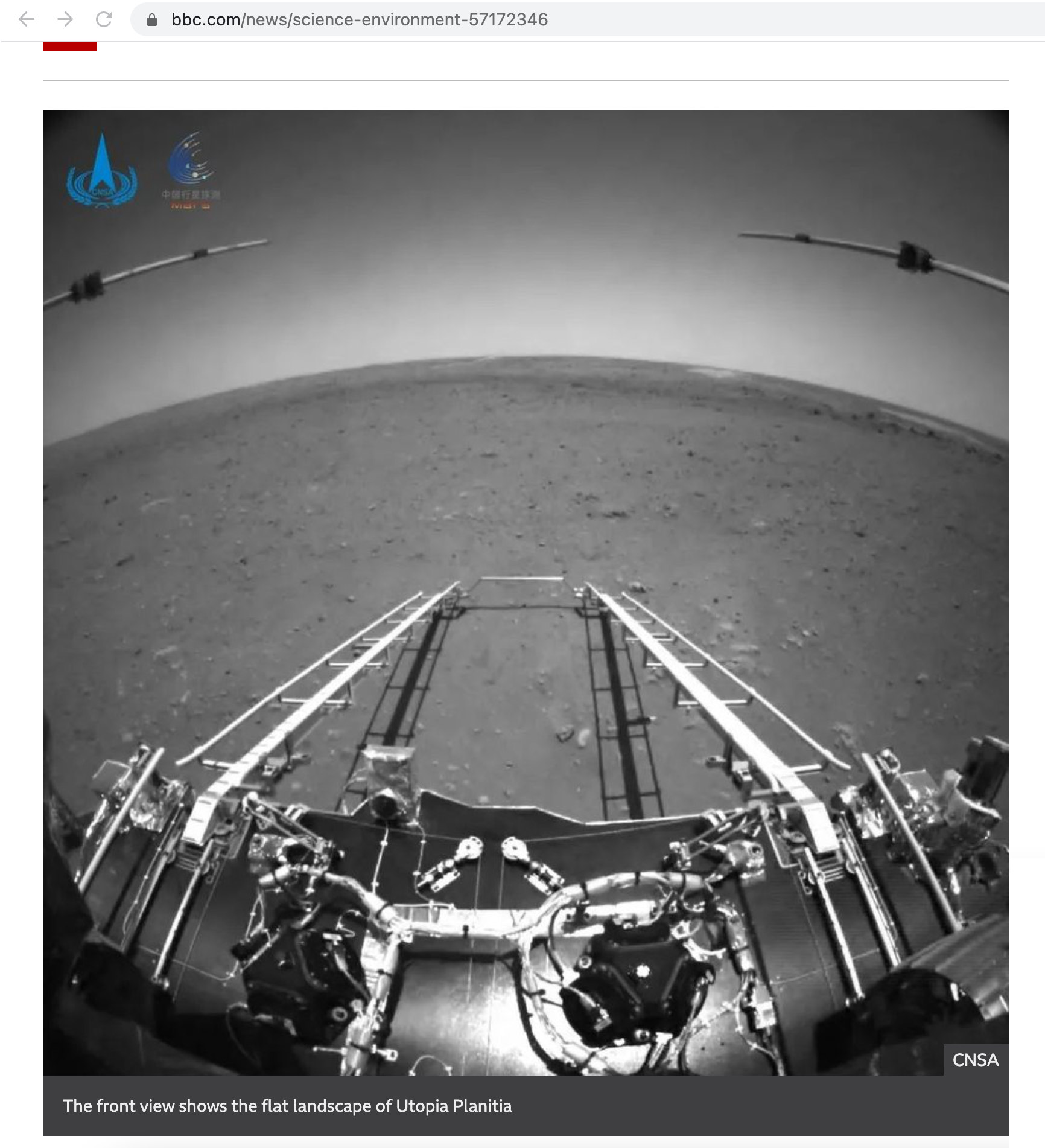
-
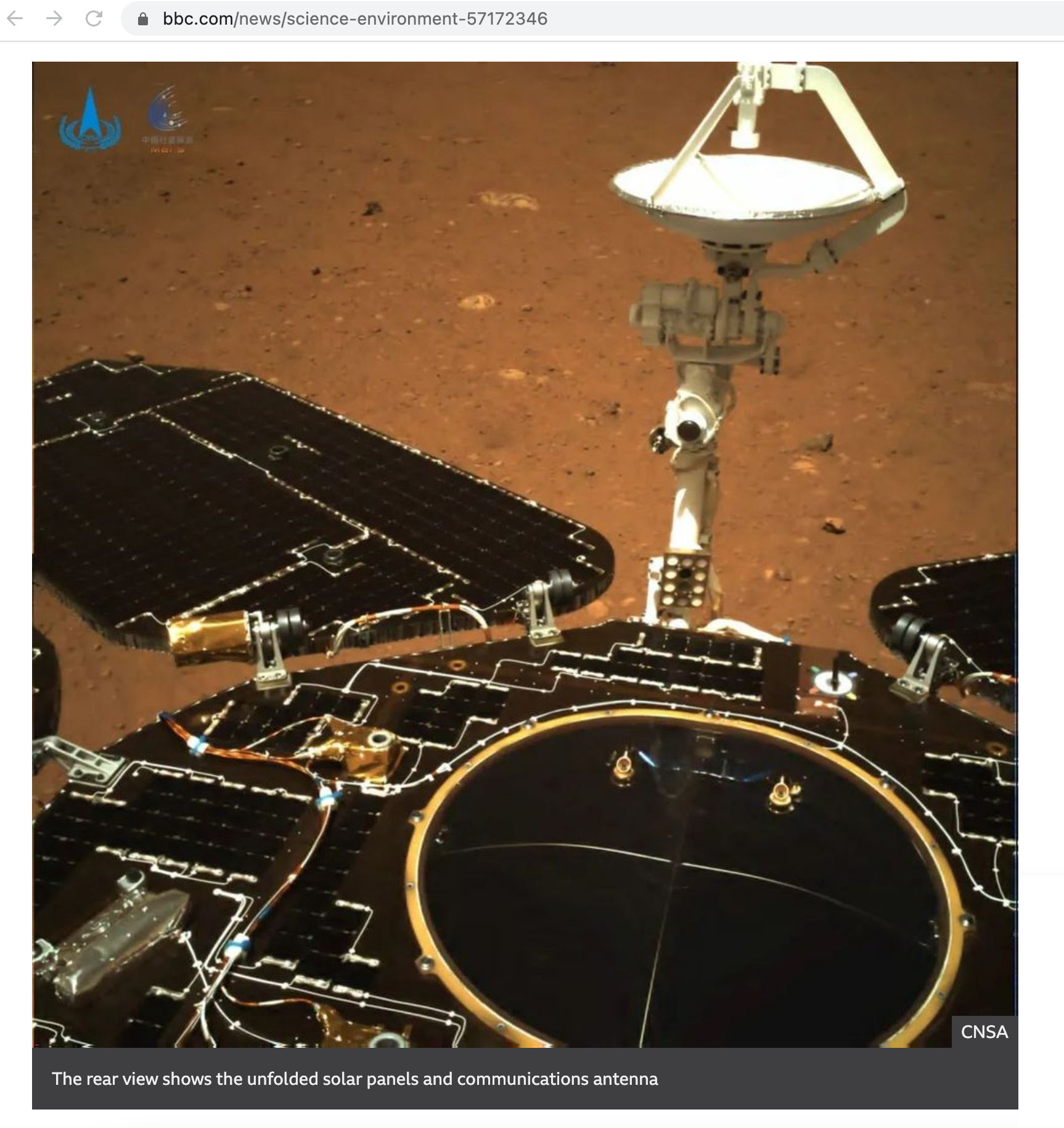
-
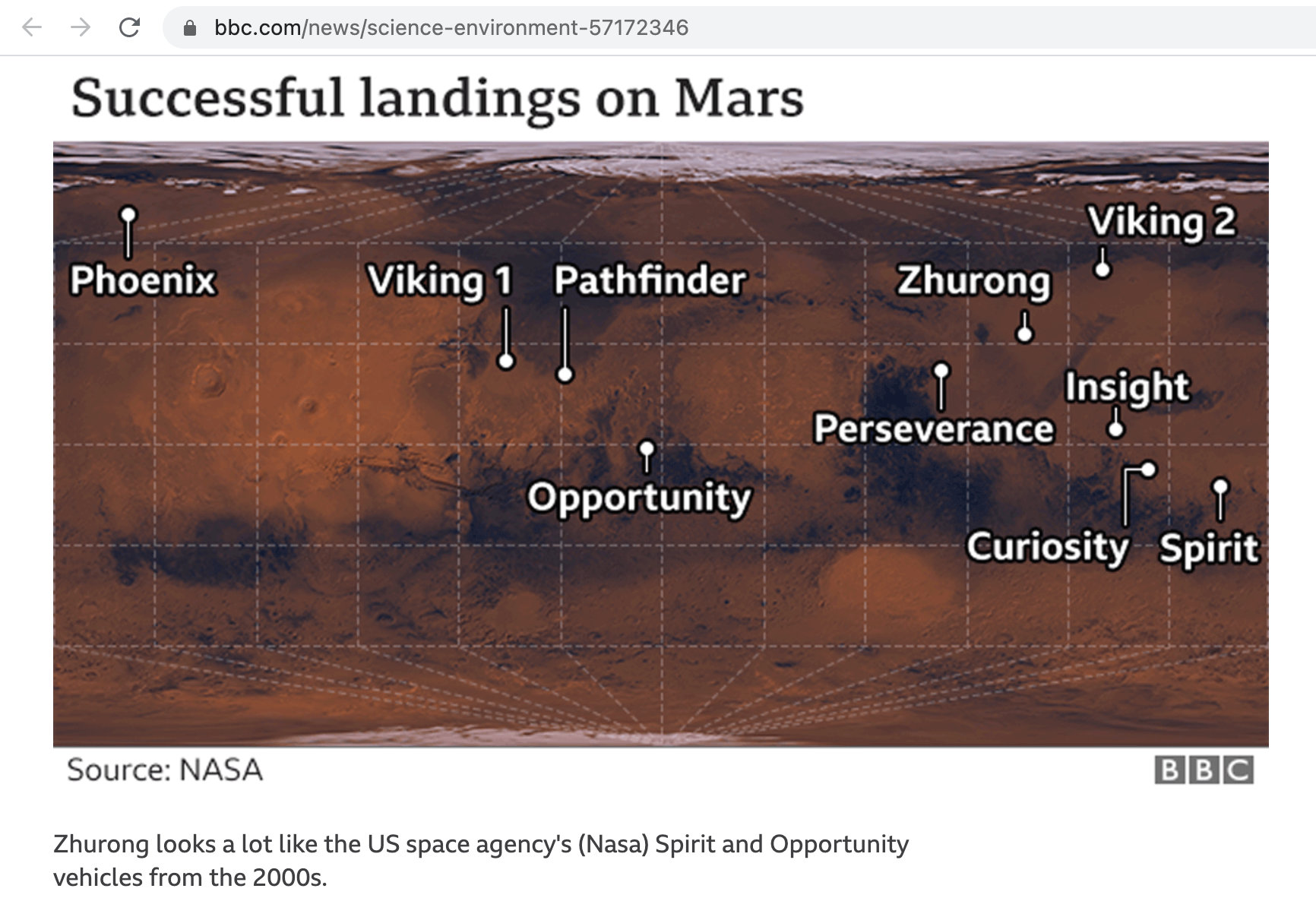
Excerpt:
China has released the first pictures taken by its Zhurong rover on Mars.
The forward view shows the landscape ahead of the robot as it sits on its landing platform; the rear-looking image reveals Zhurong's solar panels.
The rover touched down on the Red Planet early on Sunday, Beijing time.
In doing so, it made China only the second nation - after America - to successfully put a probe on the surface of Mars and operate it for a significant length of time.
Chinese scientists hope get at least 90 Martian days of service out of the six-wheeled robot at its location on Utopia Planitia, a vast terrain in the planet's northern hemisphere.
China's National Space Administration (CNSA) posted the pictures on its website. There are even a couple of short videos that record the moment the rover's aeroshell - the capsule it used to enter the Martian atmosphere - departs the Tianwen-1 orbiter, the satellite that carried the rover from Earth.
The surface imagery tells us that critical hardware deployments after landing were completed cleanly.
These deployments included the unfurling of the solar arrays to provide power to the robot; the release of the antenna to communicate with Tianwen-1, and onwards with controllers back in China; and the extension of the ramp down which Zhurong will soon roll to begin its mobile mission.
(Please watch the video at the URL's posted above)
-
Update: August 25, 2021
China’s Rover Completes its Primary 90-day Mission, but it Still has More Science to do (universetoday.com)
Excerpt:
Three months after touching down on the Martian surface, China’s Zhurong rover has completed its primary mission and is still going strong.
The ambitious robotic exploration vehicle launched on a Long March-5 rocket from Wenchang, China back in July 2020, along with an accompanying Mars orbiter. After a 6.5 month journey, the spacecraft arrived at Mars in February.
Unlike recent NASA missions to Mars, which perform their Entry, Descent, and Landing procedures immediately, Zhurong stayed in orbit for several months before landing. The wait allowed the team to gather data about the health of the vehicle, move it into the most advantageous orbit, and decide on a landing zone.
The decision to take their time with the landing makes sense: Mars is a notoriously difficult place to land safely. About half of all historical Mars landing attempts have ended in failure, and until Zhurong, only the United States had ever succeeded (it might be argued that the Soviet Union’s Mars 3 and the United Kingdom’s Beagle 2 landers both soft-landed successfully, but both vehicles also broke down seconds after landing)...
(Please read the article at the URL's posted above)
- - - - - - - - - - - - - - - - - - - - - - - - - - - - - - - - - - - - - - - - - - - - -
Posted on May 12, 2021
Ham Radio Forms a Planet-Sized Space Weather Sensor Network.
Only on a globe Earth
https://eos.org/features/ham-radio-forms-a-planet-sized-space-weather-sensor-network
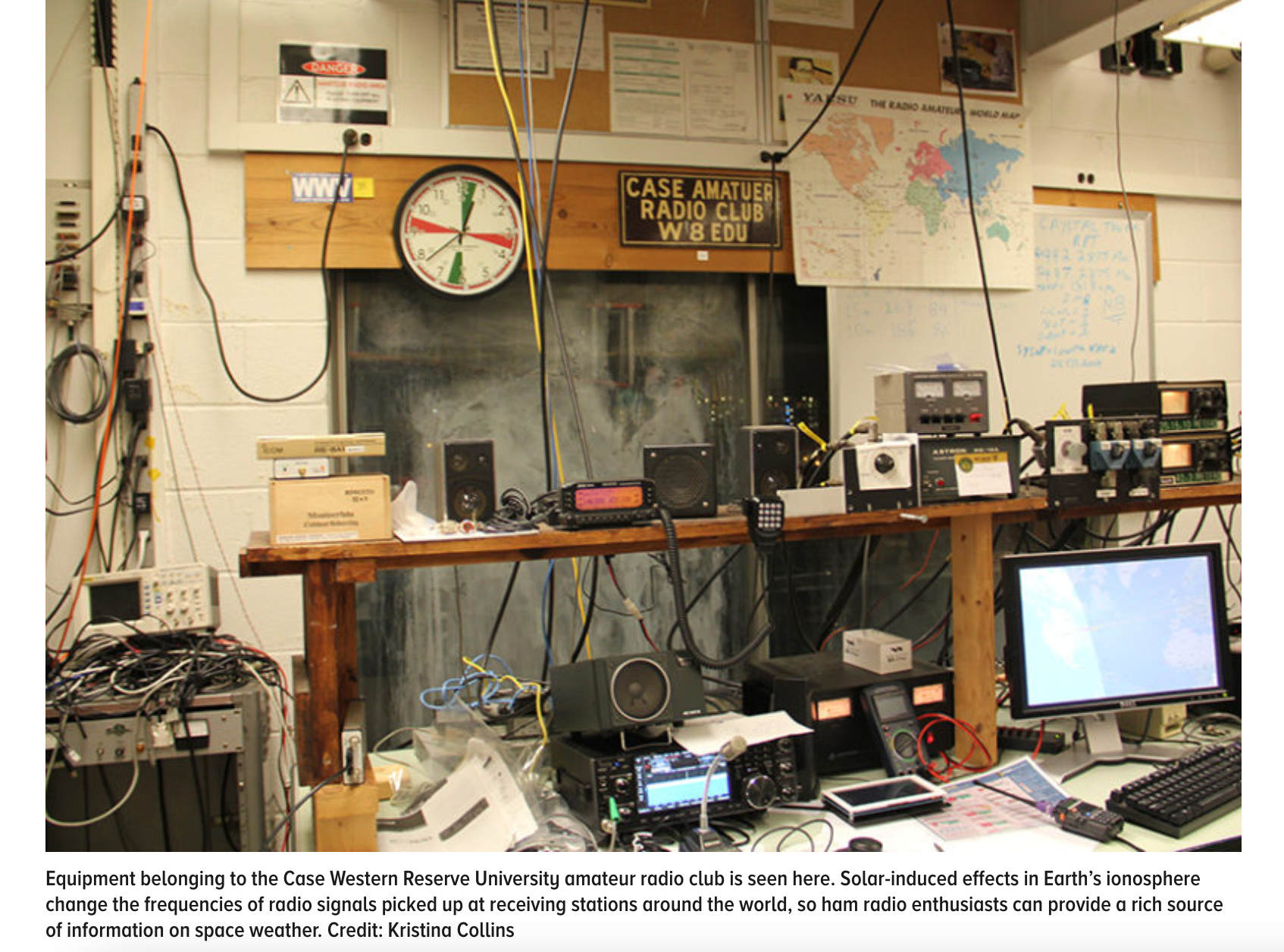
Excerpt:
By Kristina Collins, David Kazdan, and Nathaniel A. Frissell 9 February 2021
For researchers who monitor the effects of solar activity on Earth’s atmosphere, telecommunications, and electrical utilities, amateur radio signals a golden age of crowdsourced science.
Space weather events, triggered by solar emissions and their interactions with Earth’s atmosphere, can have significant effects on communications and navigation technology and on electric power systems. As with terrestrial weather events, the economic impacts of space weather–related disruptions can be substantial, affecting satellite systems as well as systems on the ground. A severe geomagnetic storm (on the order of the Carrington Event of 1859) could have a catastrophic effect on modern infrastructure. Even solar storms of more ordinary size can induce currents in the power grid that drive up energy prices, affecting manufacturing and commerce.
Considerable interest exists in developing space weather forecasting technologies that use Earth’s ionosphere as a sensor for events in its neighboring atmospheric layers. The ionosphere occupies a privileged niche in the geospace system, as it is coupled into both the terrestrial weather of the neutral atmosphere below and the space weather of the magnetosphere above.
(Please read the article at the URL's posted above)
- - - - - - - - - - - - - - - - - - - - - - - - - - - - - - - - - - - - - - - - - - - - -
Posted on May 10, 2021
OH no. One of those pesky “they are just lights in the sky” is now acting up. It was invisible to the naked eye a few days ago, but now is easily observable.
Flat Earth folks – “what causes this to happen (is God mad at us) and why now?”
Flat Earth folks – "if the Earth is flat, why can't that star and the constellation Cassiopeia be seen from the southern hemisphere?"
-
NOVA IN CASSIOPEIA BRIGHTENS SUDDENLY (skyandtelescope.org)
Nova Cassiopeia 2021 (V1405 Cas) shines at magnitude 5.5 on Saturday night, May 8th, from Duluth, Minnesota. It's located about 5.5° above the familiar W of Cassiopeia. The view faces north around 11:30 p.m. local time.
Excerpt:
A star in the constellation Cassiopeia that flared into view during mid-March has erupted to naked-eye visibility. Catch it while you can!
Novae are full of surprises. When discovered at the onset of the explosion, a nova can brighten from obscurity and become visible in binoculars in a matter of hours. Some plateau and then fade. Others fade and then temporarily re-brighten one or more times before returning to their former slumbers.
Enter Nova Cassiopeiae 2021, formally named V1405 Cassiopeiae. Discovered at magnitude 9.6 by Japanese amateur Yuji Nakamura on March 18th, it rapidly brightened to around magnitude 7.5-8.0 magnitude, then remained fairly constant in brightness for the next four weeks at magnitude 8.0. In mid-April the nova began to slowly brighten again, ending the month at magnitude 7.5.

(Please read the article at the URL's posted above)
- - - - - - - - - - - - - - - - - - - - - - - - - - - - - - - - - - - - - - - - - - - - -
Posted on May 8, 2021
The Giant Magellan Telescope - a technological wonder in development.
Also, images of Jupiter from the 8-m Frederick C. Gillett Gemini North telescope.
Flat Earthers never talk about what is seen thru telescopes. Why? Because it does not fit their "they are just lights in the sky" mantra.
The most flat Earthers have ever posted are out-of-focus pictures taken with the Nikon P1000, hand held camera.
They are the same as the clergy who refused to look through Galileo's telescope, warning of apostasy. That type of medieval thinking still persists today unfortunately.
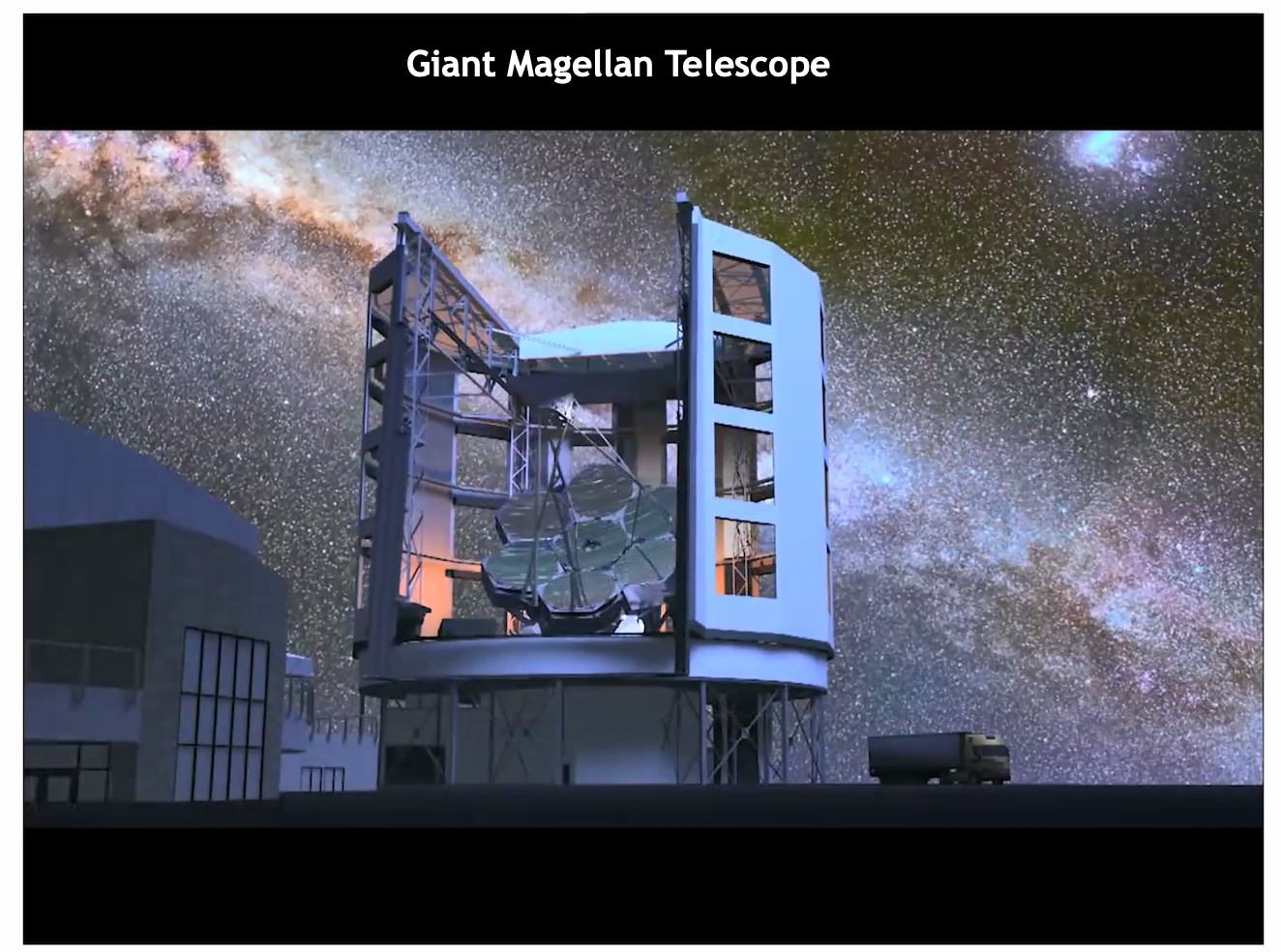
The Giant Magellan Telescope (GMT) is a ground-based extremely large telescope under construction. It will consist of seven 8.4 m (27.6 ft) diameter primary segments, that will observe optical and near infrared (320–25000 nm) light, with the resolving power of a 24.5 m (80.4 ft) primary mirror and collecting area equivalent to a 22.0 m (72.2 ft) one, which is about 368 square meters. The telescope is expected to have a resolving power 10 times greater than the Hubble Space Telescope. As of November 2017, five mirrors had been cast and the construction of the summit facility has begun.
A total of seven primary mirrors are planned, but it will begin operation with four. The project is US-led in partnership with Australia, Brazil, and South Korea, with Chile as the host country.
-
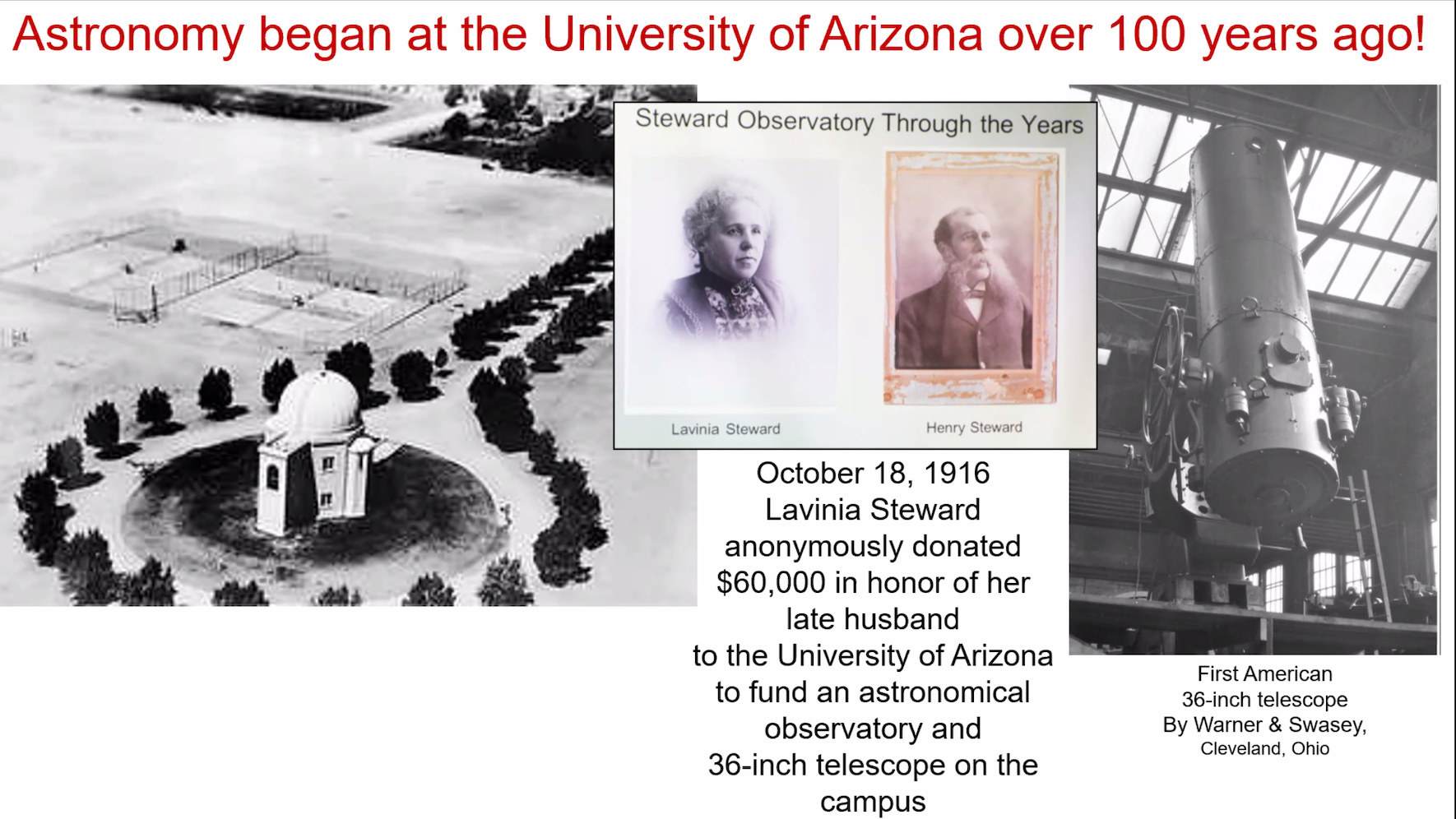
-
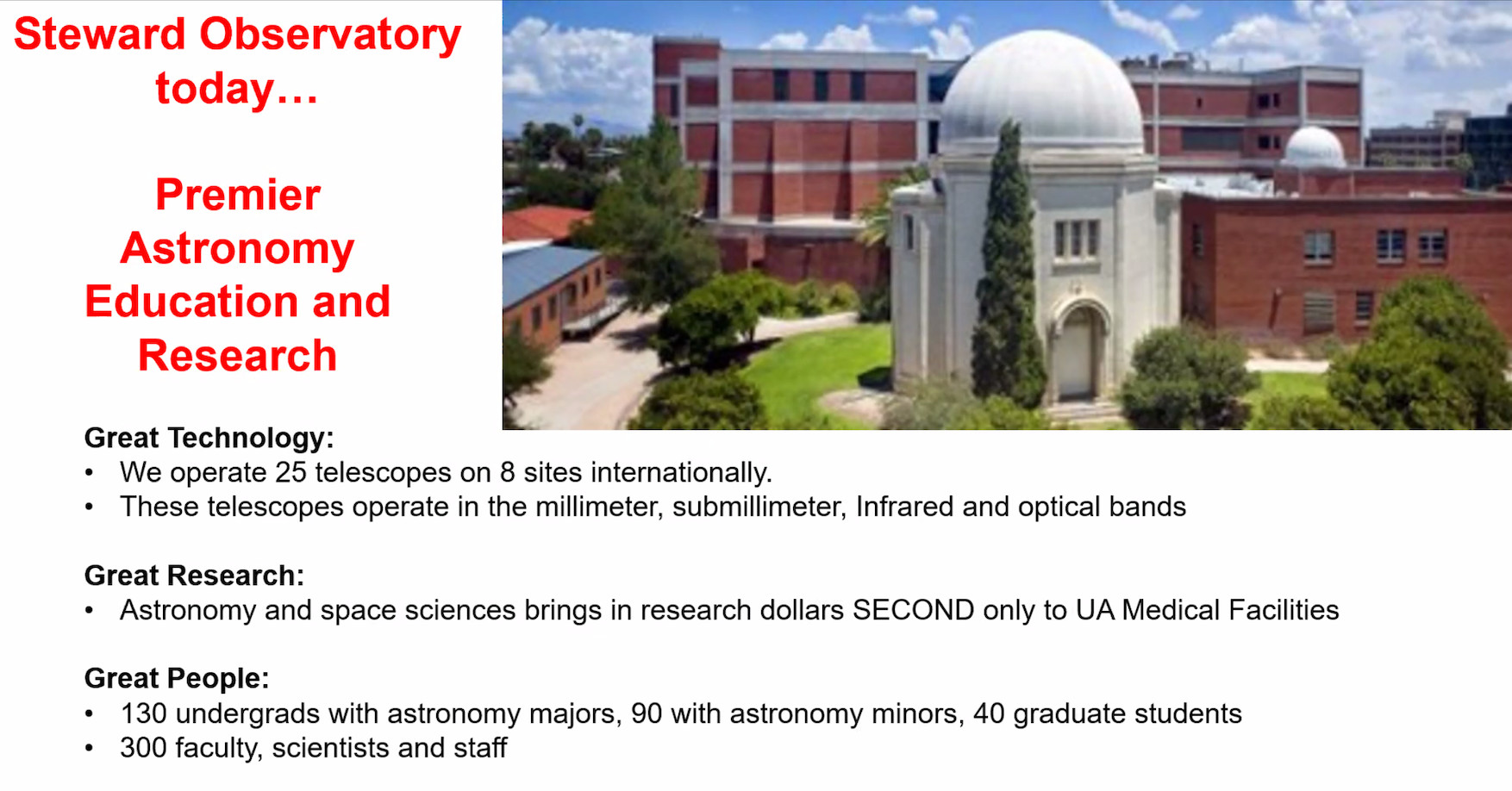
-

-
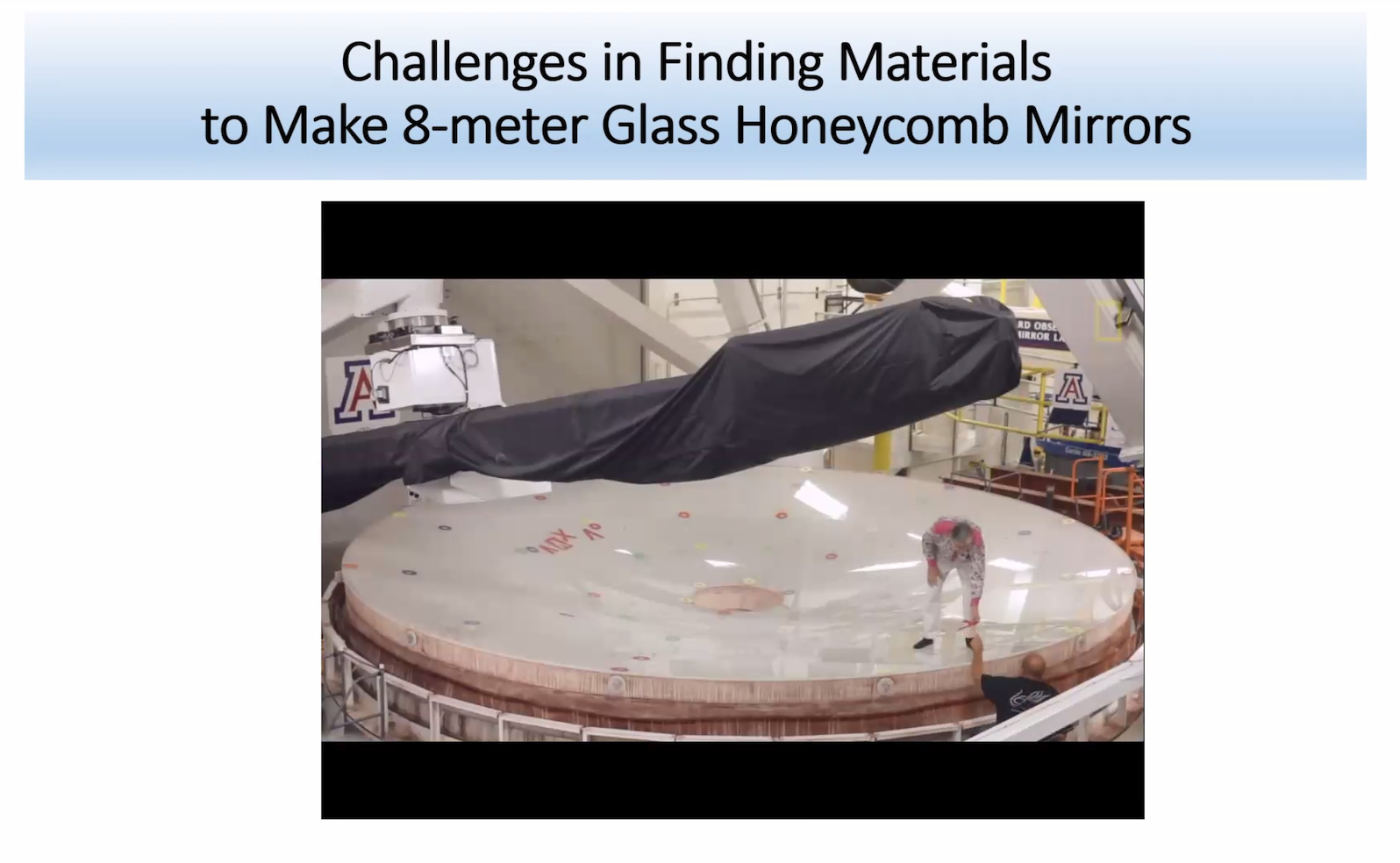
-
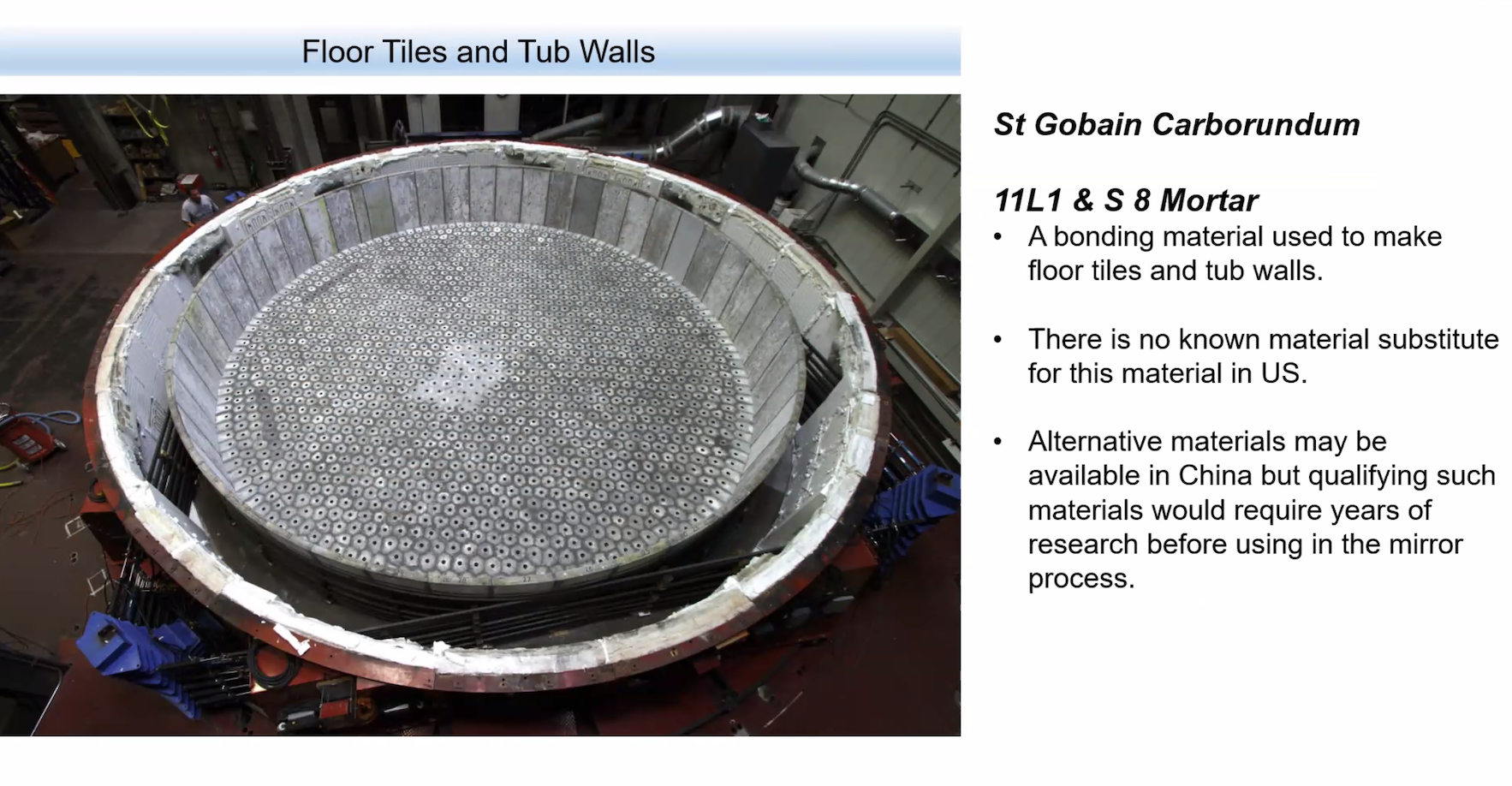
-
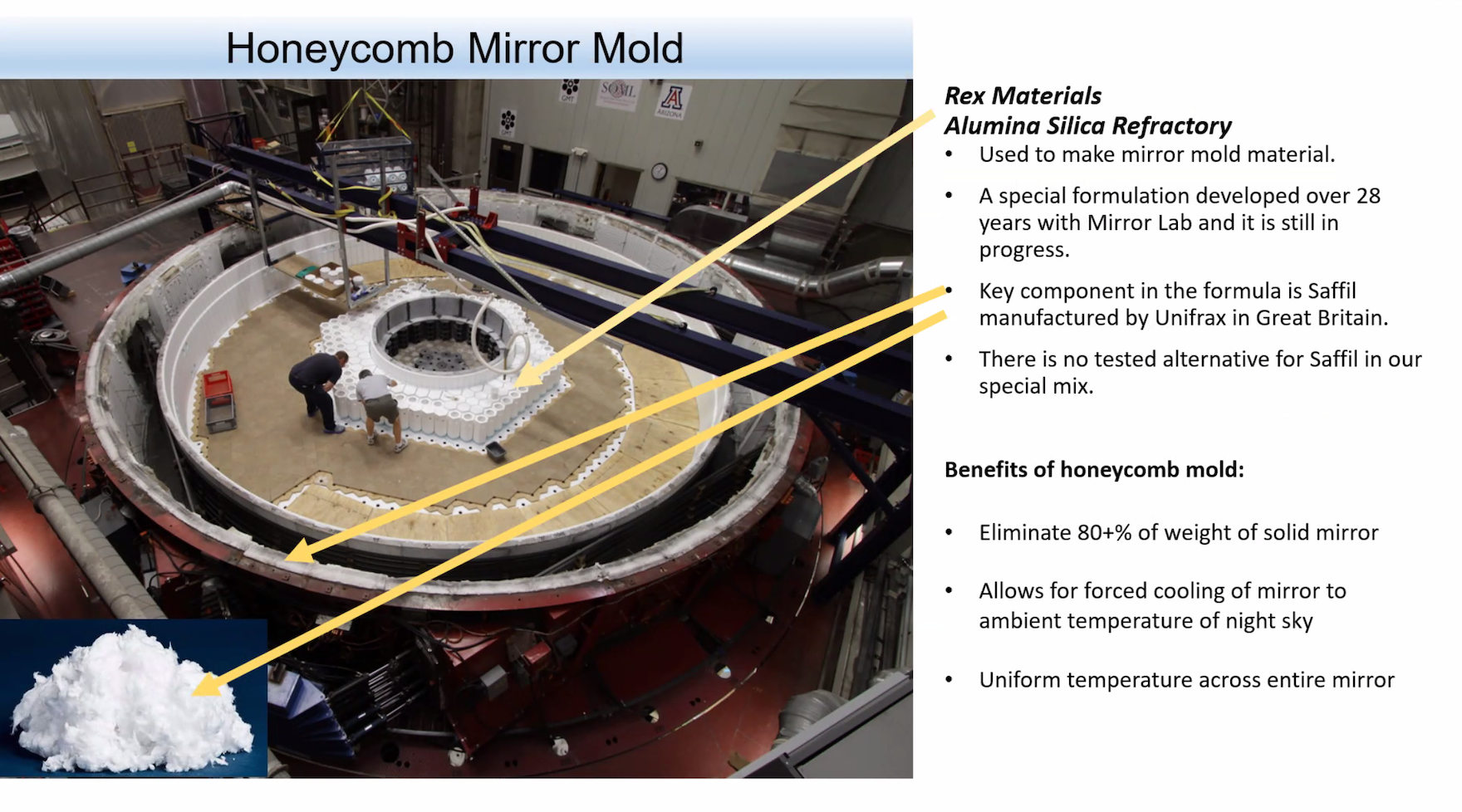
-

-
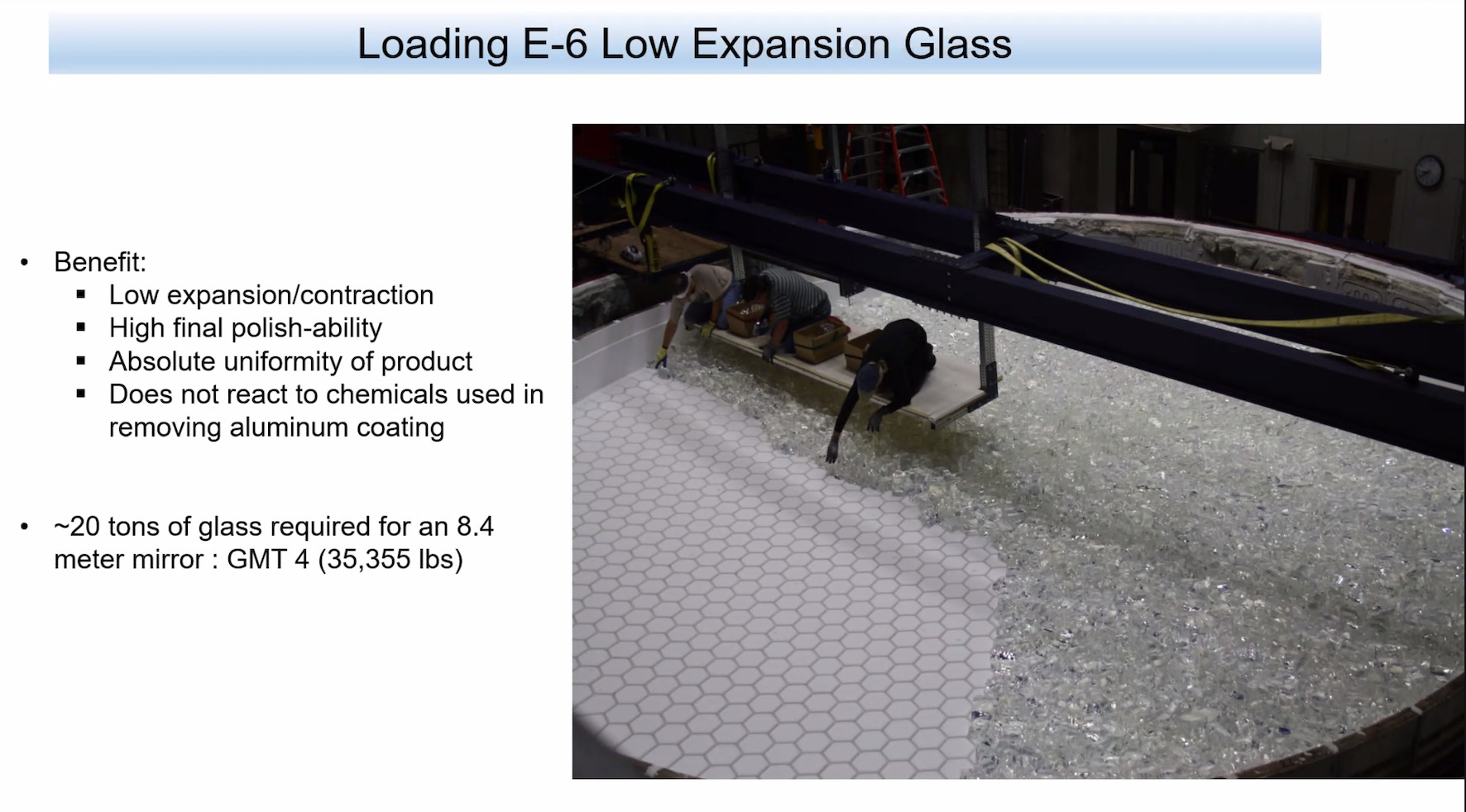
-
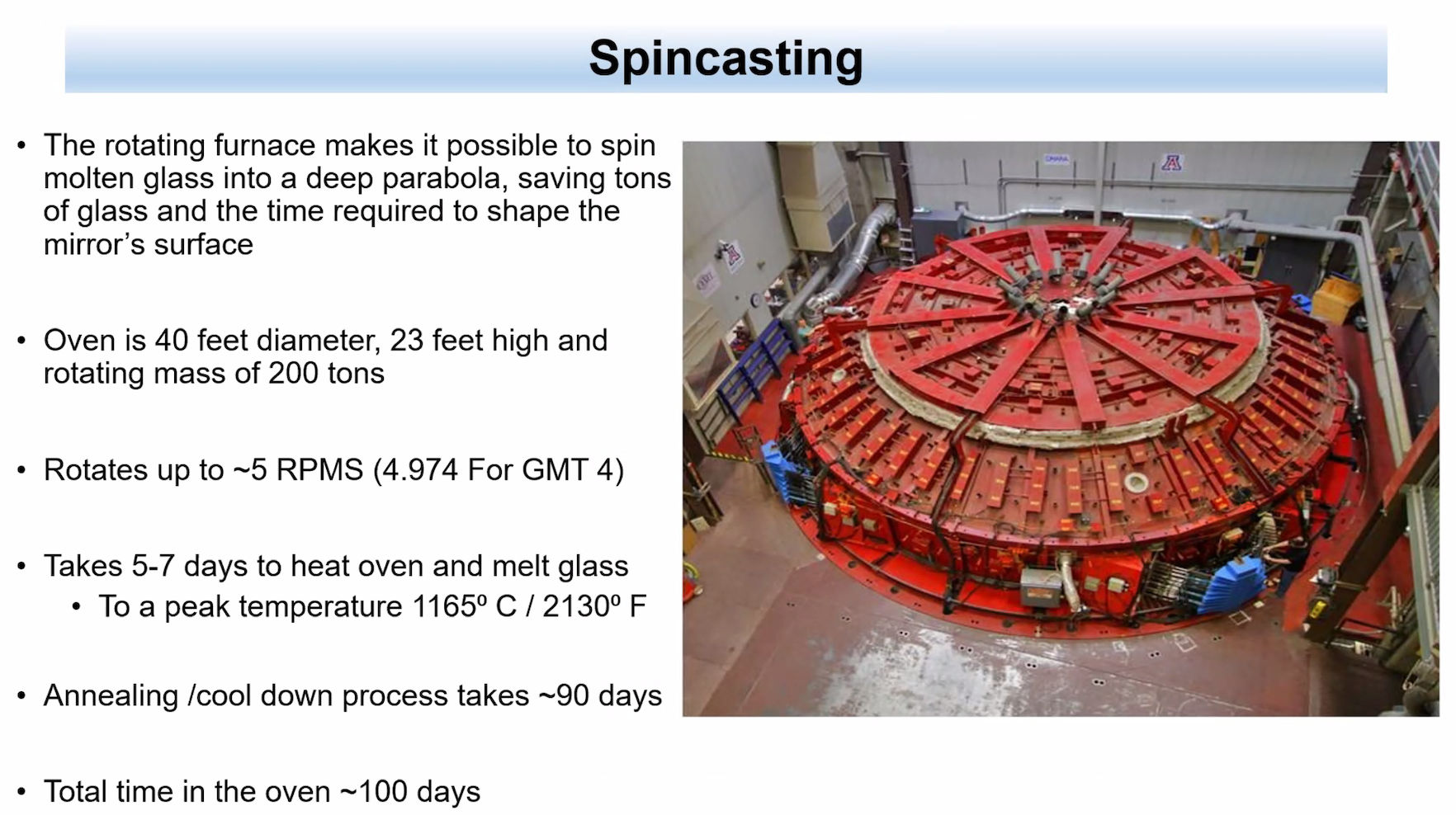
-
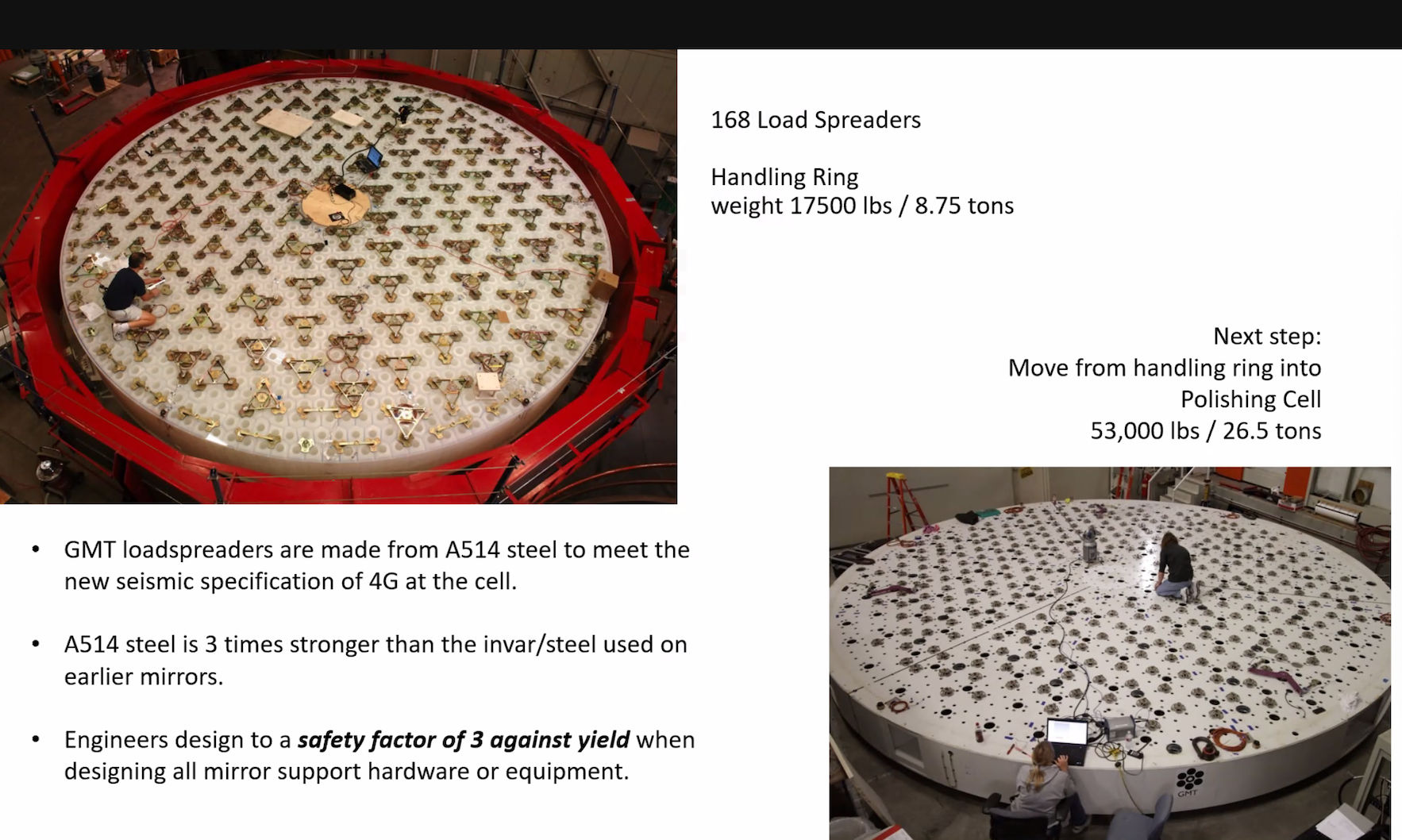
-
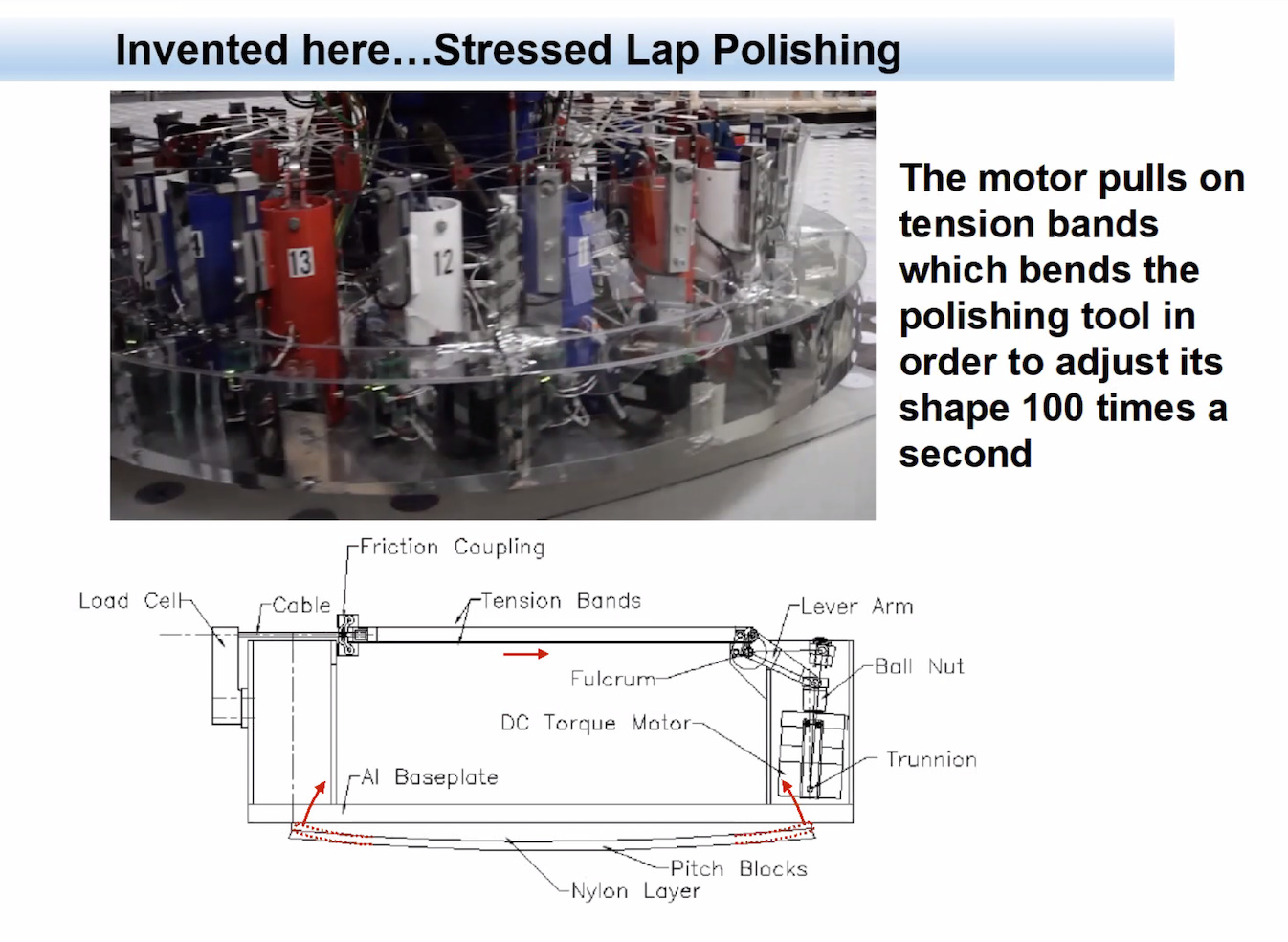
-
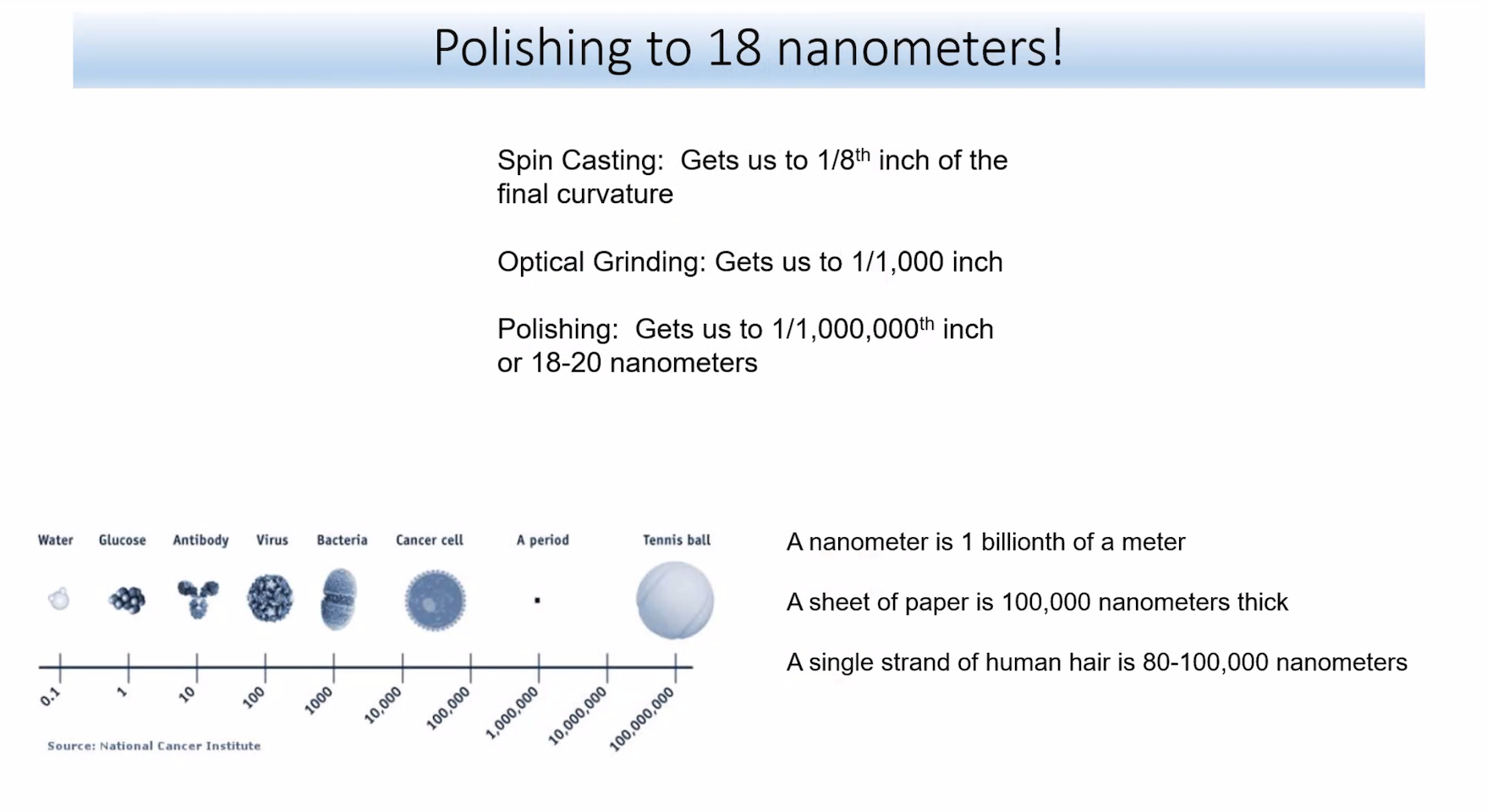
-
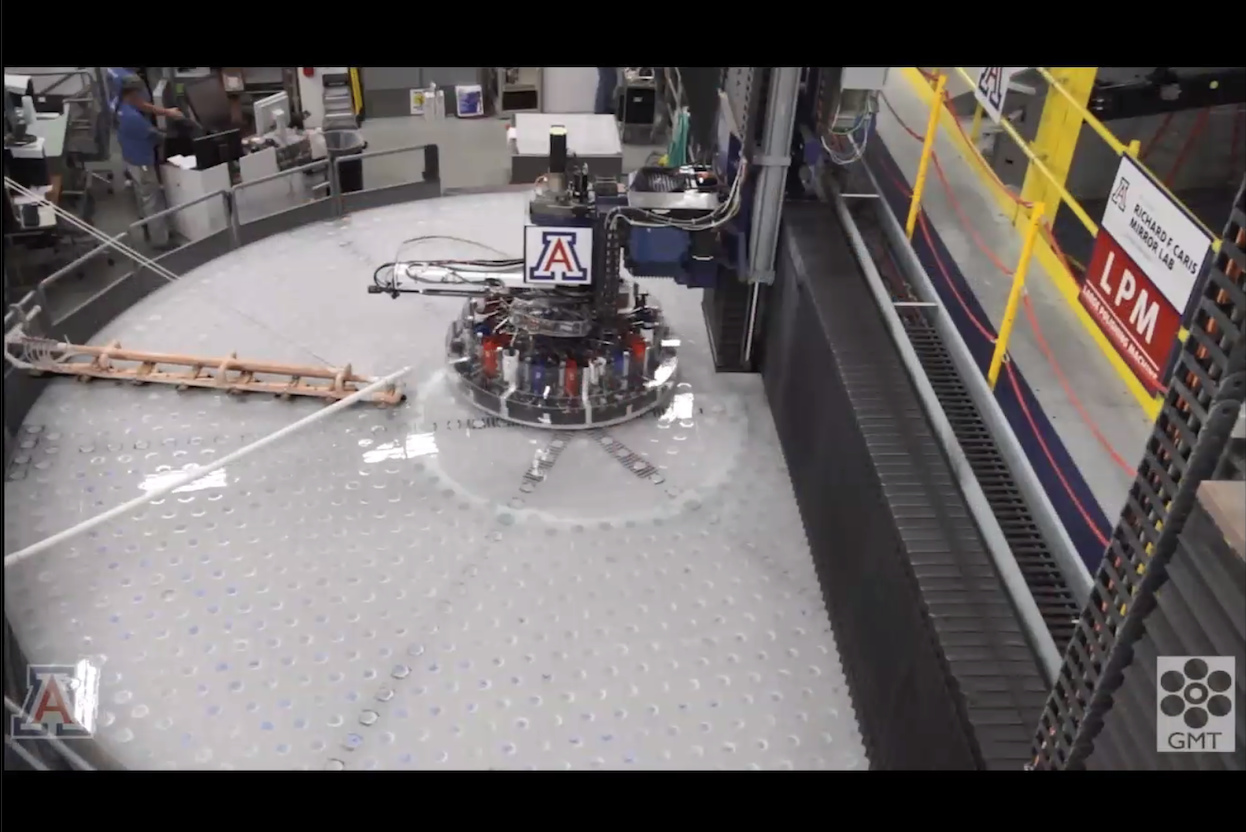
-
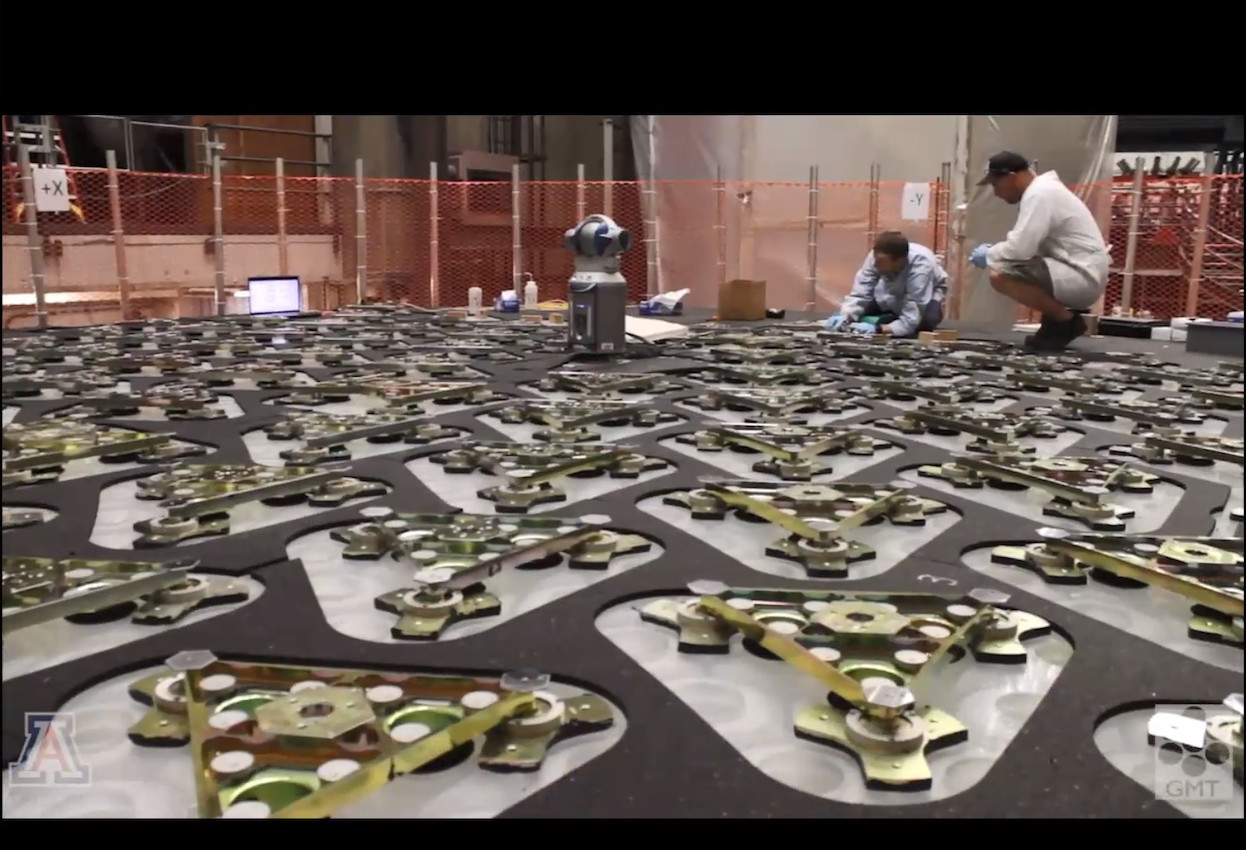
-
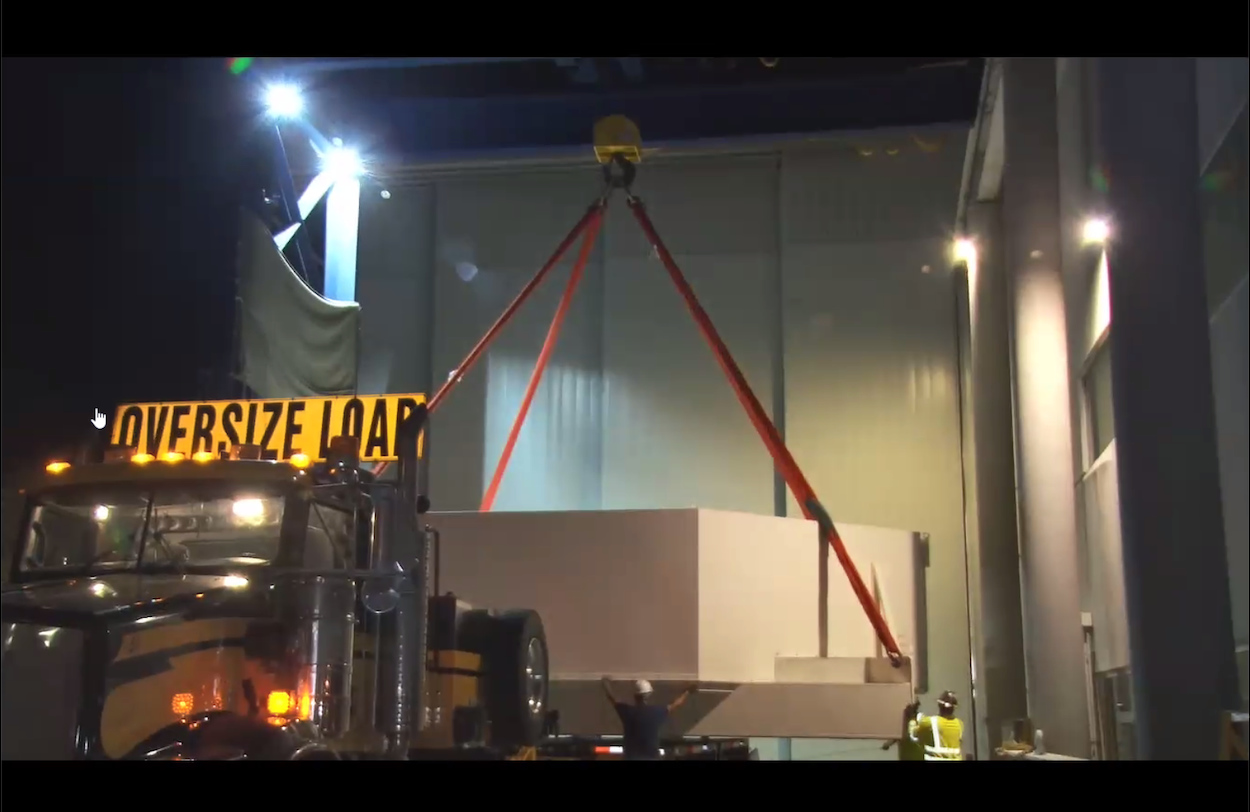
- - -
From the 8-m Frederick C. Gillett Gemini North telescope, near the summit of Hawaii’s Maunakea.
Astronomers Capture Stunning New Images of Jupiter (sci-news.com)
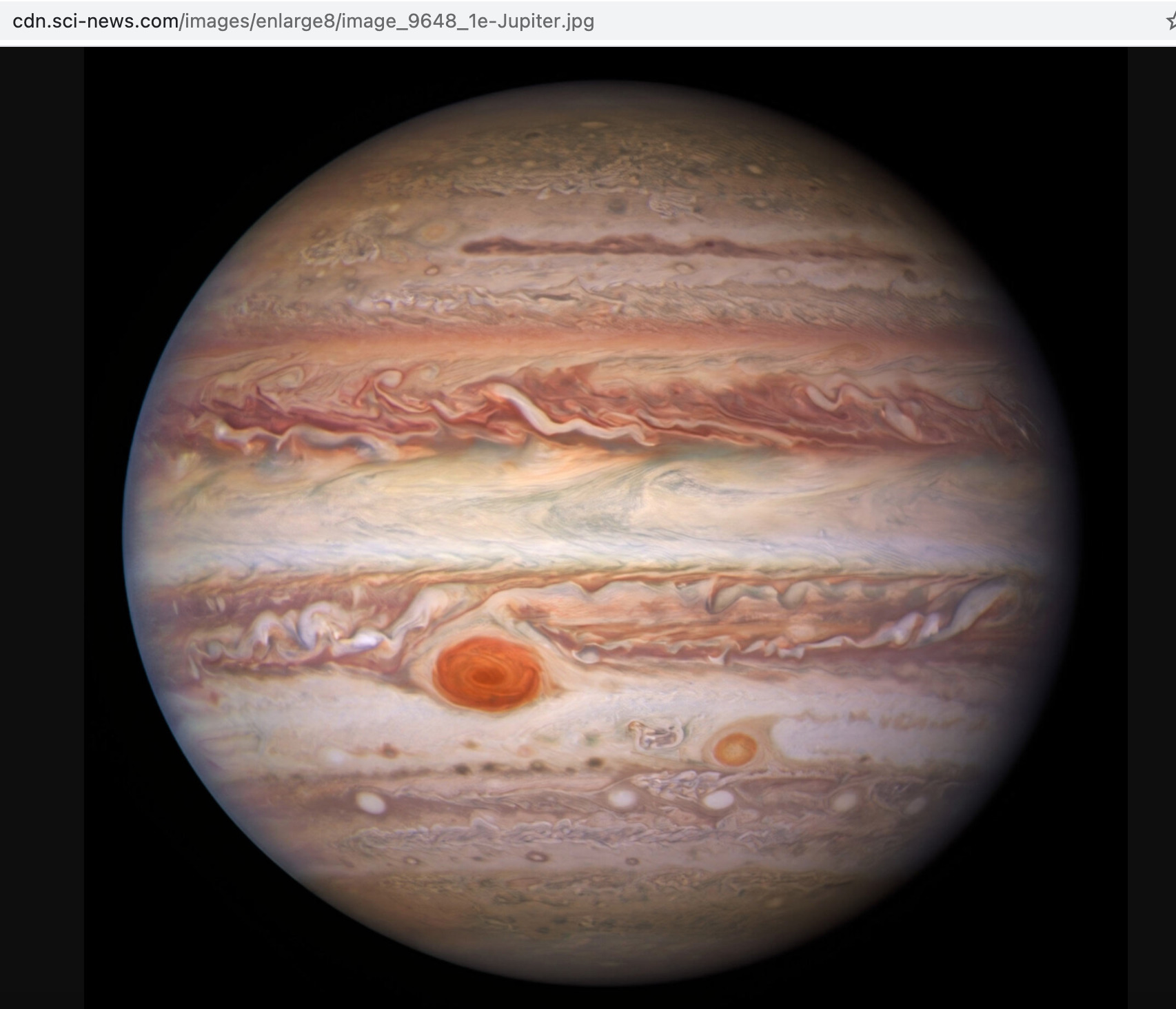

Excerpt:
Three images of Jupiter from the 8-m Frederick C. Gillett Gemini North telescope at the Gemini Observatory and the NASA/ESA Hubble Space Telescope show the gas giant at three different types of light (infrared, visible, and ultraviolet) and reveal a multitude of atmospheric features such as the Great Red Spot, superstorms, and cyclones stretching across the planet’s disk.
The new images of Jupiter highlight the key advantage of multiwavelength astronomy: viewing planets and other astronomical objects at different wavelengths of light allows scientists to glean otherwise unavailable insights.
Jupiter’s Great Red Spot is a prominent feature of the visible and ultraviolet (UV) images, but it is almost invisible at infrared (IR) wavelengths. The planet’s counter-rotating bands of clouds, on the contrary, are clearly visible in all three views.
Observing the Great Red Spot at multiple wavelengths yields other surprises — the dark region in the IR image is larger than the corresponding red oval in the visible image.
This discrepancy arises because different structures are revealed by different wavelengths; the IR observations show areas covered with thick clouds, while the visible and UV observations show the locations of chromophores — the particles that give the Great Red Spot its distinctive hue by absorbing blue and UV light.
(Please read the article at the URL's posted above)
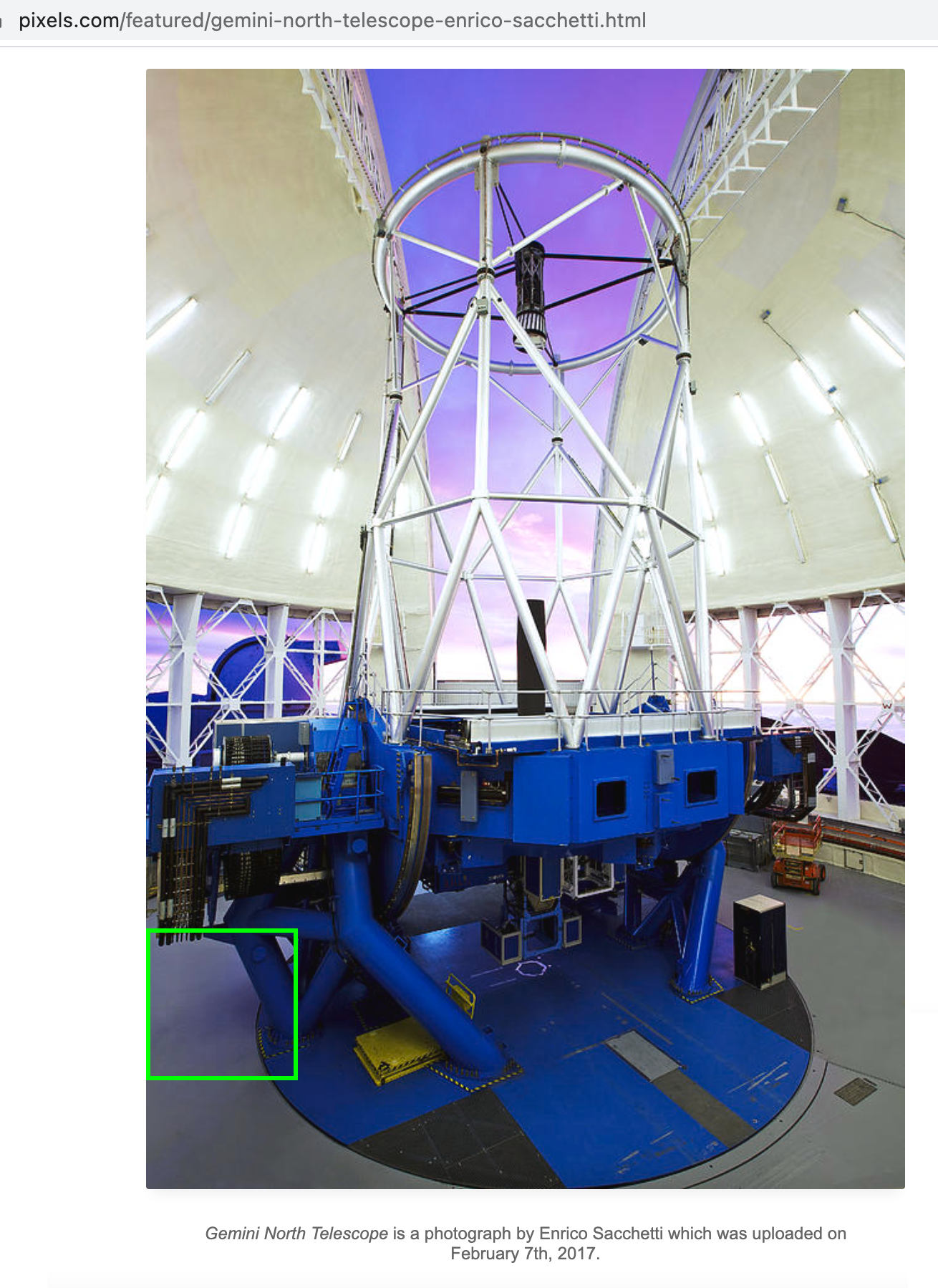
- - - - - - - - - - - - - - - - - - - - - - - - - - - - - - - - - - - - - - - - - - - - -
Posted on April 24, 2021
IBEX (Interstellar Boundry Explorer) - the SMALL satellite with a BIG mission
Our Sun extends its influence (area called the Heliosphere) out to about 120 AU's.
(1 AU = the distance between the Earth and the Sun).
The temperature of space in our solar system in 12K (degrees Kelvin) while that of our galaxy is about 4K.
NASA's IBEX Mission: Exploring the Edge of the Solar System, by Nola Taylor Reed (space.com)
Excerpt:
For over a decade, NASA's Interstellar Boundary Explorer (IBEX) has been probing the outer edge of the heliosphere, or the "bubble" that surrounds our solar system, to better understand the boundary between the sun's environment and interstellar space. Winds from the sun create the heliosphere, and its boundary serves as a protective shield from some of the harshest radiation generated by other stars.
"IBEX's sole, focused science objective is to discover the global interaction between plasma from the solar wind and the interstellar medium at the boundary region of the solar system," according to the Southwest Research Institute (SwRI) in San Antonio, which leads the mission.
Launched on Oct. 19, 2008, from the Marshall Islands, IBEX rode into space aboard a Pegasus rocket dropped from an L-1011 aircraft. Before IBEX, the Pegasus had carried spacecraft only into low Earth orbit. However, IBEX had an additional solid rocket motor and its own onboard propulsion system to boost itself into orbit above the planet's radiation belts.
IBEX
Interstellar Boundary Explorer (IBEX)
Satellite Directory (all satellites listed here)
Southwest Research Instutute - IBEX
From Dave McComas, IBEX Principle Investigator (Princeton University)
Data Release
- - -
Interstellar Boundary Explorer, Science Results
Initial data revealed a previously unpredicted "very narrow ribbon that is two to three times brighter than anything else in the sky". Initial interpretations suggest that "the interstellar environment has far more influence on structuring the heliosphere than anyone previously believed". It is unknown what is creating the ENA (energetic neutral atoms) ribbon. The Sun is currently traveling through the Local Interstellar Cloud, and the heliosphere's size and shape are key factors in determining its shielding power from cosmic rays. Should IBEX detect changes in the shape of the ribbon, that could show how the heliosphere is interacting with the Local Fluff. It has also observed ENAs from the Earth's magnetosphere.
In October 2010, significant changes were detected in the ribbon after six months, based on the second set of IBEX observations.
It went on to detect neutral atoms from outside the Solar System, which were found to differ in composition from the Sun. Surprisingly, IBEX discovered that the heliosphere has no bow shock, and it measured its speed relative to the local interstellar medium (LISM) as 23.2 km/s (52,000 mph), improving on the previous measurement of 26.3 km/s (59,000 mph) by Ulysses. Those speeds equate to 25% less pressure on the Sun's heliosphere than previously thought.
In July 2013, IBEX results revealed a 4-lobed tail on the Solar System's heliosphere.
- Interstellar Mapping and Acceleration Probe: IMAP, a follow-on mission to IBEX
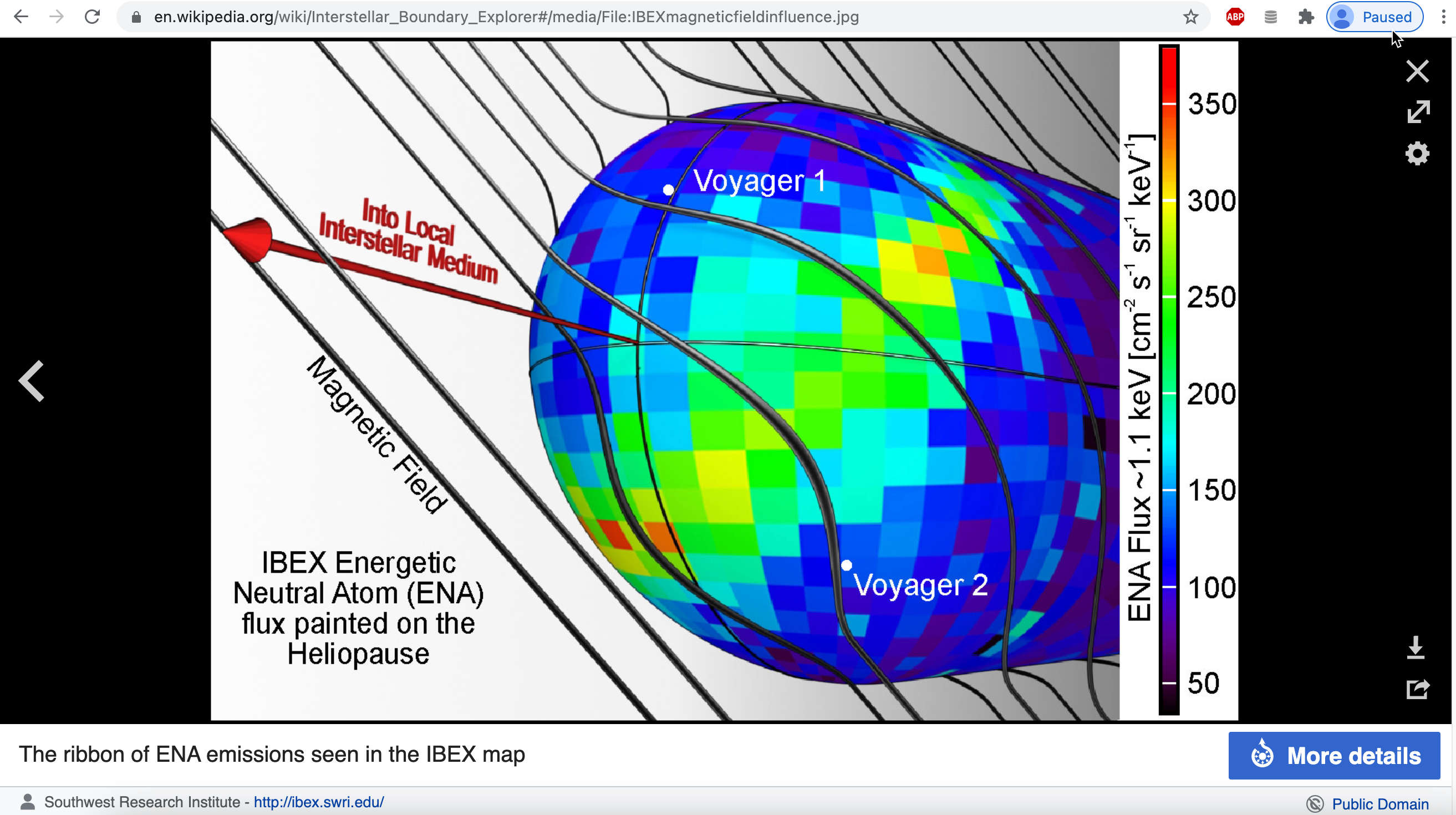
-
For a closer view...
https://en.wikipedia.org/wiki/Local_Interstellar_Cloud
Local_Interstellar_Clouds_with_motion_arrows.jpg
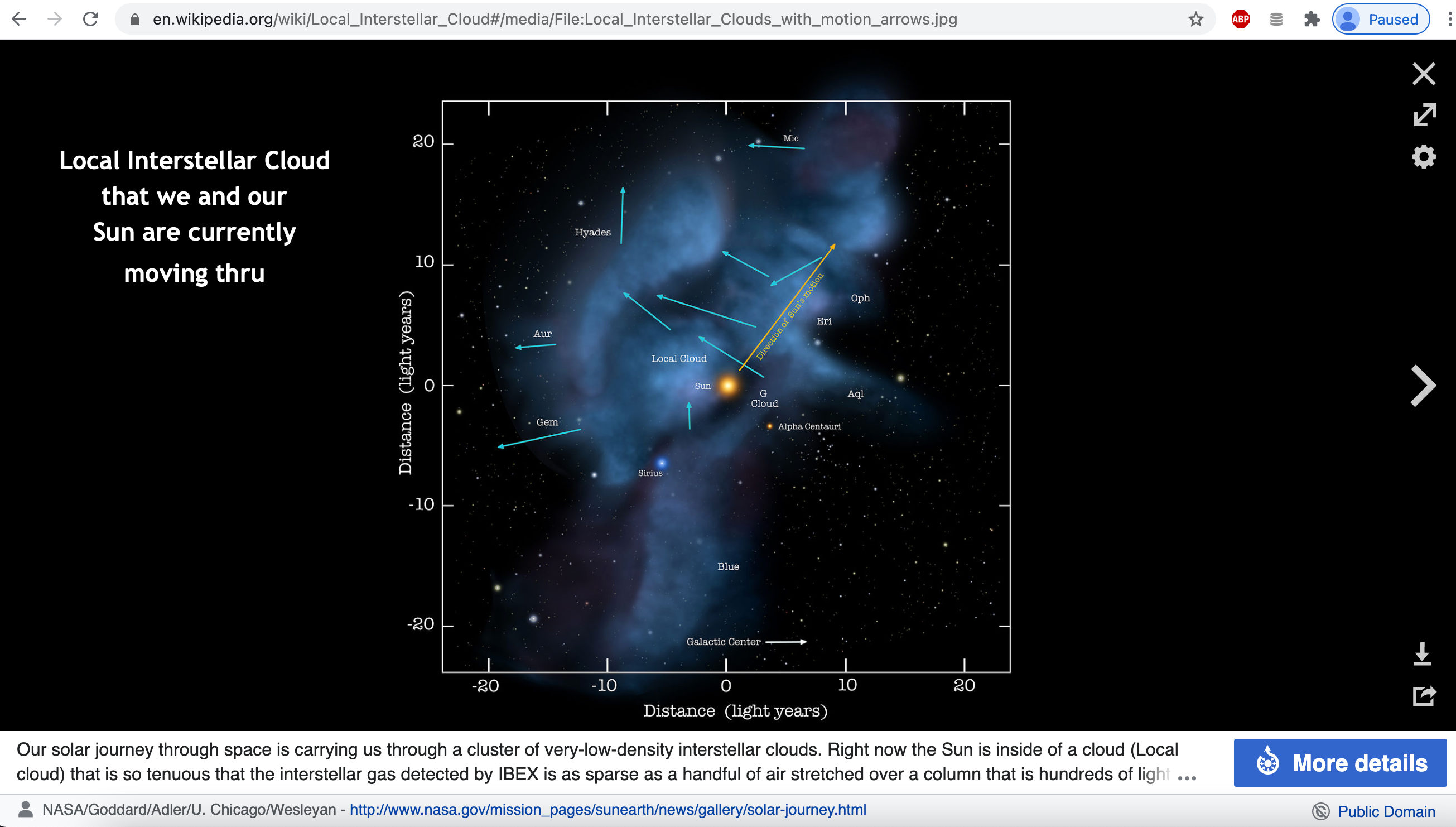
- - - - - - - - - - - - - - - - - - - - - - - - - - - - - - - - - - - - - - - - - - - - -
Posted on April 24, 2021
Asteroid’s 22m-year journey from source to Earth mapped in historic first (theguardian.com)
The meteor is a piece of the minor planet Vesta, from deep in space.
https://www.theguardian.com/science/2021/apr/23/astronomers-map-asteroids-22m-year-journey-to-earth
Meteor from the orbital location of minor planet Vesta.
Astronomers have reconstructed the 22m-year-long voyage of an asteroid that hurtled through the solar system and exploded over Botswana, showering meteorites across the Kalahari desert.
It is the first time scientists have traced showering space rock to its source – in this case Vesta, one of largest bodies in the asteroid belt that circles the sun between Jupiter and Mars.
- -
Comment by JonahTheScientist - "just as we use geometric triangulation to locate a position based on three measurements, for years astronomers have used Celestial Mechanics to chart the orbit of celestial bodies, based on three sky positions and the dates those positions were taken.
In 1973 I took the Celestial Mechanics class as taught by renowned Sidney McCuskey (Warner Professor Emeritus of Case Western Reserve University in Cleveland, Ohio), while earning my Astronomy degree. One of our final class assignments was to work out the orbit of a comet, based on three sky (of altitude, azimuth, locations on the Earth where the measurements were made, and the time/date taken) observations.
Using the math provided by Celestial Mechanics (which by the way is complicated), using then hand calculators only, it took about 30-hours to come up with the complete results - all orbital parameters of the comet. There are just many steps in the computational process. And if you make a mistake on one step, all the following steps will be wrong. It was a grueling manual process, but I earned an A+ in the course.
Buy the way, this book only cost me $35 back in 1973.
Introduction to Celestial Mechanics Hardcover – Import, January 1, 1963by S.W. McCuskey (Author), B&W Equations (Illustrator).
Orbital Mechanics for Engineering Students, by Howard Curtis, Embry-Riddle Aeronautical University, Daytona Beach, Florida
- -
Triangulation:
In trigonometry and geometry, triangulation is the process of determining the location of a point by forming triangles to the point from known points.
Specifically in surveying, triangulation involves only angle measurements at known points, rather than measuring distances to the point directly as in trilateration; the use of both angles and distance measurements is referred to as triangulateration.
Triangulation today is used for many purposes, including surveying, navigation, metrology, astrometry, binocular vision, model rocketry and, in the military, the gun direction, the trajectory and distribution of fire power of weapons.
The use of triangles to estimate distances dates to antiquity. In the 6th century BC, about 250 years prior to the establishment of the Ptolemaic dynasty, the Greek philosopher Thales is recorded as using similar triangles to estimate the height of the pyramids of ancient Egypt. He measured the length of the pyramids' shadows and that of his own at the same moment, and compared the ratios to his height (intercept theorem). Thales also estimated the distances to ships at sea as seen from a clifftop by measuring the horizontal distance traversed by the line-of-sight for a known fall, and scaling up to the height of the whole cliff. Such techniques would have been familiar to the ancient Egyptians. Problem 57 of the Rhind papyrus, a thousand years earlier, defines the seqt or seked as the ratio of the run to the rise of a slope, i.e. the reciprocal of gradients as measured today. The slopes and angles were measured using a sighting rod that the Greeks called a dioptra, the forerunner of the Arabic alidade. A detailed contemporary collection of constructions for the determination of lengths from a distance using this instrument is known, the Dioptra of Hero of Alexandria (c. 10–70 AD), which survived in Arabic translation; but the knowledge became lost in Europe until in 1615 Snellius, after the work of Eratosthenes, reworked the technique for an attempt to measure the circumference of the earth. In China, Pei Xiu (224–271) identified "measuring right angles and acute angles" as the fifth of his six principles for accurate map-making, necessary to accurately establish distances, while Liu Hui (c. 263) gives a version of the calculation above, for measuring perpendicular distances to inaccessible places.
Celestial Mechanics:
Celestial mechanics is the branch of astronomy that deals with the motions of objects in outer space. Historically, celestial mechanics applies principles of physics (classical mechanics) to astronomical objects, such as stars and planets, to produce ephemeris data.
- -
Excerpt for the "Asteroid’s 22m-year journey from source to Earth mapped in historic first (theguardian.com)" article cited above:
Flight path of Kalahari’s six-tonne asteroid is first tracing of meteorite shedding rock to solar system origin.
Astronomers have reconstructed the 22m-year-long voyage of an asteroid that hurtled through the solar system and exploded over Botswana, showering meteorites across the Kalahari desert.
It is the first time scientists have traced showering space rock to its source – in this case Vesta, one of largest bodies in the asteroid belt that circles the sun between Jupiter and Mars.
The six-tonne asteroid punched into Earth’s atmosphere at 37,000mph in June 2018 and broke apart above the central Kalahari game reserve, creating a fireball nearly as bright as the sun. Immediate searches of the presumed landing site found a small meteorite, which was named Motopi Pan.
Nasa researchers had tracked the hazardous object from as far out as the moon using telescopes in Arizona and Hawaii. After the impact they asked astronomers in Australia to check images from the SkyMapper telescope in New South Wales – used for studying black holes and the like – in case it too had captured the asteroid’s flight path. Much to the researchers’ amazement, it had.
“We wouldn’t have noticed it had it not been for the tip-off by the American discoverers, and it hits close to home,” said Christian Wolf, an astronomer at Australian National University. “Granted, it’s the Kalahari and I have never been there, but when your day job involves orienteering along a chain of black holes with an average step size of 1bn light years between the waypoints, the Kalahari feels awfully close to your keyboard.”
The snapshots of the asteroid, named 2018LA, from three telescopes set far apart on the Earth’s surface allowed the astronomers to reconstruct the rock’s trajectory and pinpoint its origin. The trail led to Vesta, a 300-mile-wide asteroid that is occasionally visible without a telescope.
Armed with a good idea of the asteroid’s trajectory, the scientists were able to refine the location of its landing in the game reserve. This led to expeditions that recovered more than 20 other meteorites spread over a 3-mile patch of ground.
(Please read the article at the URL's posted above)
- - - - - - - - - - - - - - - - - - - - - - - - - - - - - - - - - - - - - - - - - - - - -
Posted on April 22, 2021
Ranty Flat Earth (Shane Cook), a prominent FE conspirator, now admits that the Earth is a Globe!
Famous flat earther declares the earth is a globe. Live!, by Baldy Catz (aka Conspiracy Catz)
https://www.youtube.com/watch?v=0gdXPXvSTwY
This is the moment folks.
What will Ranty FE say? What conclusion has he come to? Will I be wearing odd socks? Find out the answer to one of these and more!!
Roohif can be found here https://www.youtube.com/user/roohif
- -
Interview With An EX-Flat Earther 6 - "Ranty Flat Earth", by FTFE
https://www.youtube.com/watch?v=xwUgth88zRg
- -
Our related article here:
Ranty! & Ranty Flat Earth (Shane Cook) - from flat Earth advocate FAIL, to globe Earth champion, by FlatEarthLunacy
- - - - - - - - - - - - - - - - - - - - - - - - - - - - - - - - - - - - - - - - - - - - -
Posted on April 21, 2021
Happy 4th Birthday - Flat Earth Lunacy !!

4 Year stats:
Total website pages visited - 389,126
Total articles written - 1,480
Total posts written - 672
Posts Archive
Select which archive you want to read. The oldest one is at the bottom (Z).
Flat Earth NOT - FlatEarthLunacy articles for reference - S
Flat Earth NOT - FlatEarthLunacy articles for reference - T
Flat Earth NOT - FlatEarthLunacy articles for reference - U
Flat Earth NOT - FlatEarthLunacy articles for reference - V
Flat Earth NOT – FlatEarthLunacy articles for reference - W
Flat Earth NOT – FlatEarthLunacy articles for reference - X
Flat Earth NOT – FlatEarthLunacy articles for reference - Y
Flat Earth NOT – FlatEarthLunacy articles for reference - Z
- - - - - - - - - - - - - - - - - - - - - - - - - - - - - - - - - - - - - - - - - - - - -
Posted on April 20, 2021
New Horizons (spacecraft) passes milestone distance 50 AU, by Kelly Kizer Whitt (earthsky.org)
re: New Horizons, Voyager 1, Voyager 2, Pioneer 10 and Pioneer 11
https://earthsky.org/space/new-horizons-50-au-milestone-photo-voyager-1
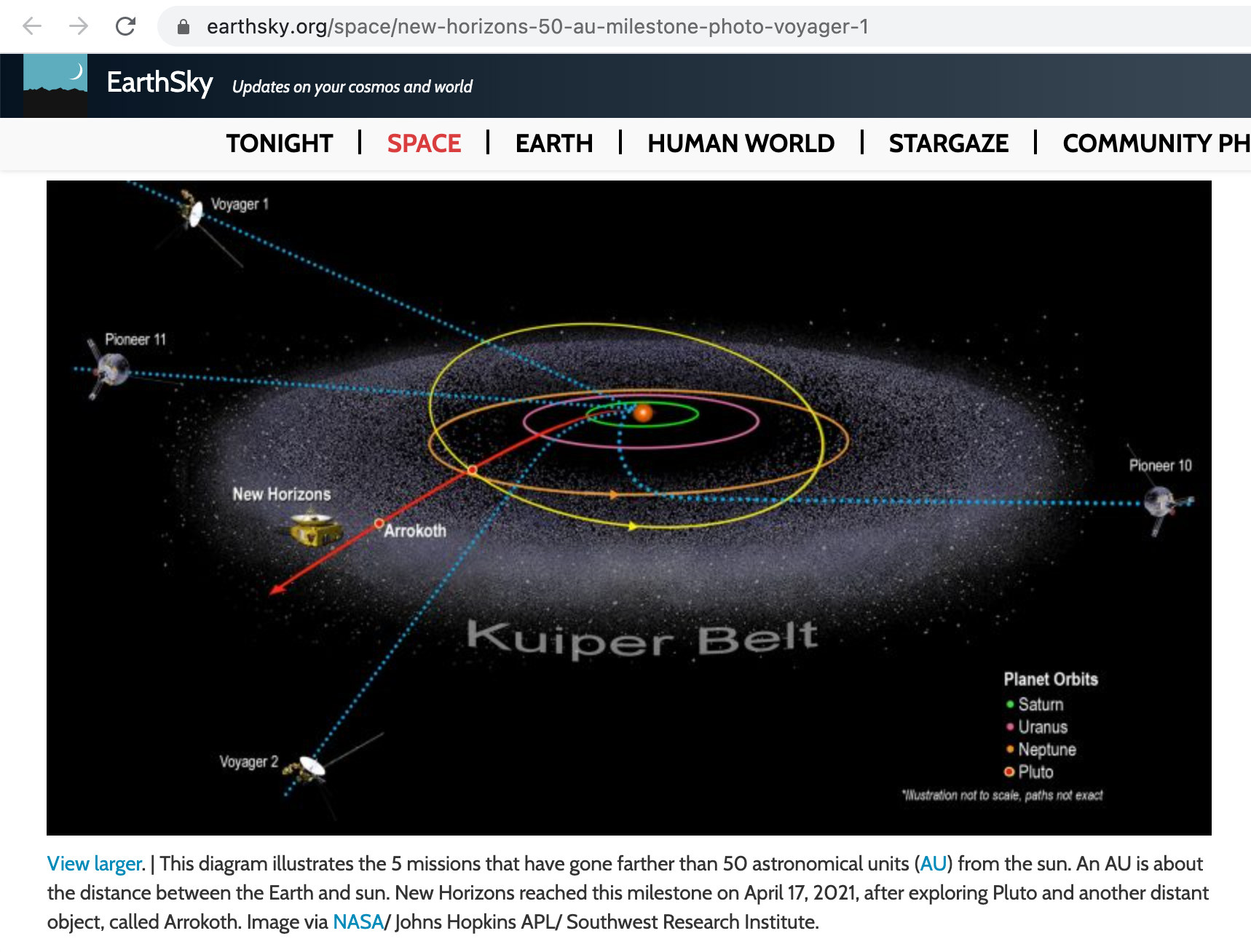
New Horizons , Current Position
Voyager 1 & Voyager 2 Mission Status, Current Position, Voyager
Pioneer 10 & Pioneer 11
Article excerpt:
On April 17, 2021, the New Horizons spacecraft passed 50 astronomical units – 50 times Earth’s distance from the sun – while speeding toward interstellar space. It also captured an image of another earthly spacecraft, even farther out.
Only four spacecraft have journeyed as far into space as 50 astronomical units (AU), or 50 times Earth’s distance from the sun. On April 17, 2021, New Horizons became the 5th human-made object to reach this rare space milestone. The spacecraft broke the 50 AU mark on its trek out of the solar system, nearly six years after its successful sweep past Pluto in July, 2015. NASA described the current distance of New Horizons from our sun in this way:
Here’s one way to imagine just how far 50 AU is: Think of the solar system laid out on a neighborhood street; the sun is one house to the left of ‘home’ (or Earth), Mars would be the next house to the right, and Jupiter would be just four houses to the right. New Horizons would be 50 houses down the street, 17 houses beyond Pluto!
In other words, it’s far away. Why? Because space is vast!
Pioneer 10, Pioneer 11, Voyager 1 and Voyager 2 are the only other spacecraft that have traveled farther than 50 AU from our sun. This distance equals about 5 billion miles (7.5 billion km) away. When scientists on Earth send a command to New Horizons, it requires seven hours to reach the distant spacecraft, traveling at the speed of light (186,000 miles per second, or about 300,000 km per second). Then the scientists must wait another seven hours to know if the message was received.
One message the scientists sent to New Horizons, in late 2020, was a request to photograph one of its predecessors. On Christmas Day 2020, New Horizons pointed its camera in the direction of Voyager 1, the first spacecraft to cross the 50 AU mark. The remarkable image, seen below, does not capture the figure of Voyager 1 itself, of course. Voyager 1 is 11.2 billion miles (18 billion kilometers) farther away than New Horizons, but it is the first image taken by a spacecraft in the Kuiper Belt of a more distant spacecraft. Voyager 1 is now an amazing 152 AU from the sun and has officially left the bounds of the solar system as it journeys through interstellar space. New Horizons will reach our solar system’s “border” and cross into interstellar space in the 2040s, as it flies outward into territory no longer dominated by our sun...
(Please read the article at the URL's posted above)
- - - - - - - - - - - - - - - - - - - - - - - - - - - - - - - - - - - - - - - - - - - - -
Posted on April 19, 2021
The American Space Agency has successfully flown a small helicopter on Mars.
USA first in flight on Earth, Moon and now Mars.
Nasa successfully flies small helicopter on Mars, by Jonathan Amos BBC Science Correspondent (bbc.com)
Watch Ingenuity climb to 3m, hover and then set down
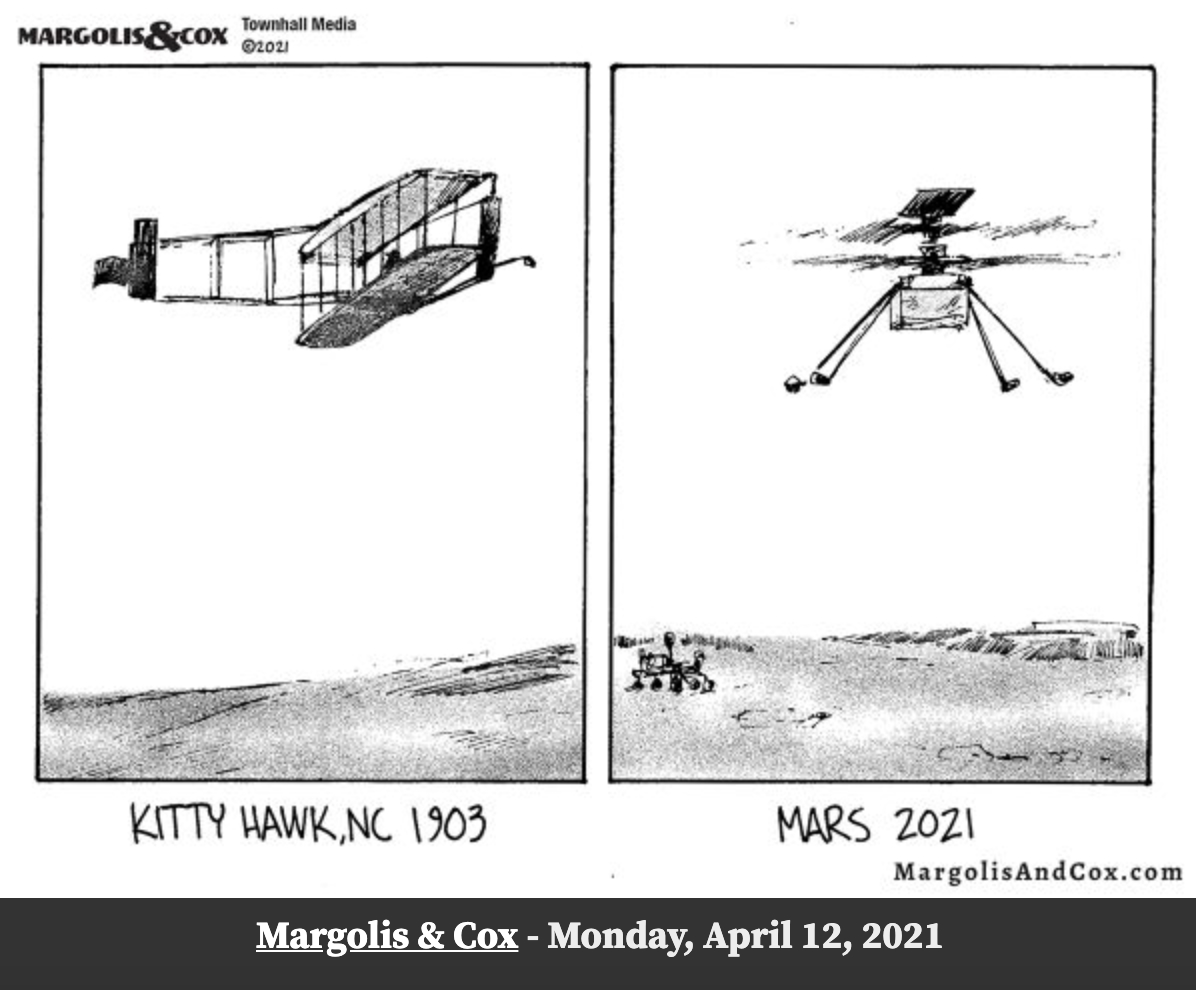
Excerpt:
The American space agency has successfully flown a small helicopter on Mars.
The drone, called Ingenuity, was airborne for less than a minute, but Nasa is celebrating what represents the first powered, controlled flight by an aircraft on another world.
Confirmation came via a satellite at Mars which relayed the chopper's data back to Earth.
The space agency is promising more adventurous flights in the days ahead.
Ingenuity will be commanded to fly higher and further as engineers seek to test the limits of the technology.
The rotorcraft was carried to Mars in the belly of Nasa's Perseverance Rover, which touched down in Jezero Crater on the Red Planet in February.
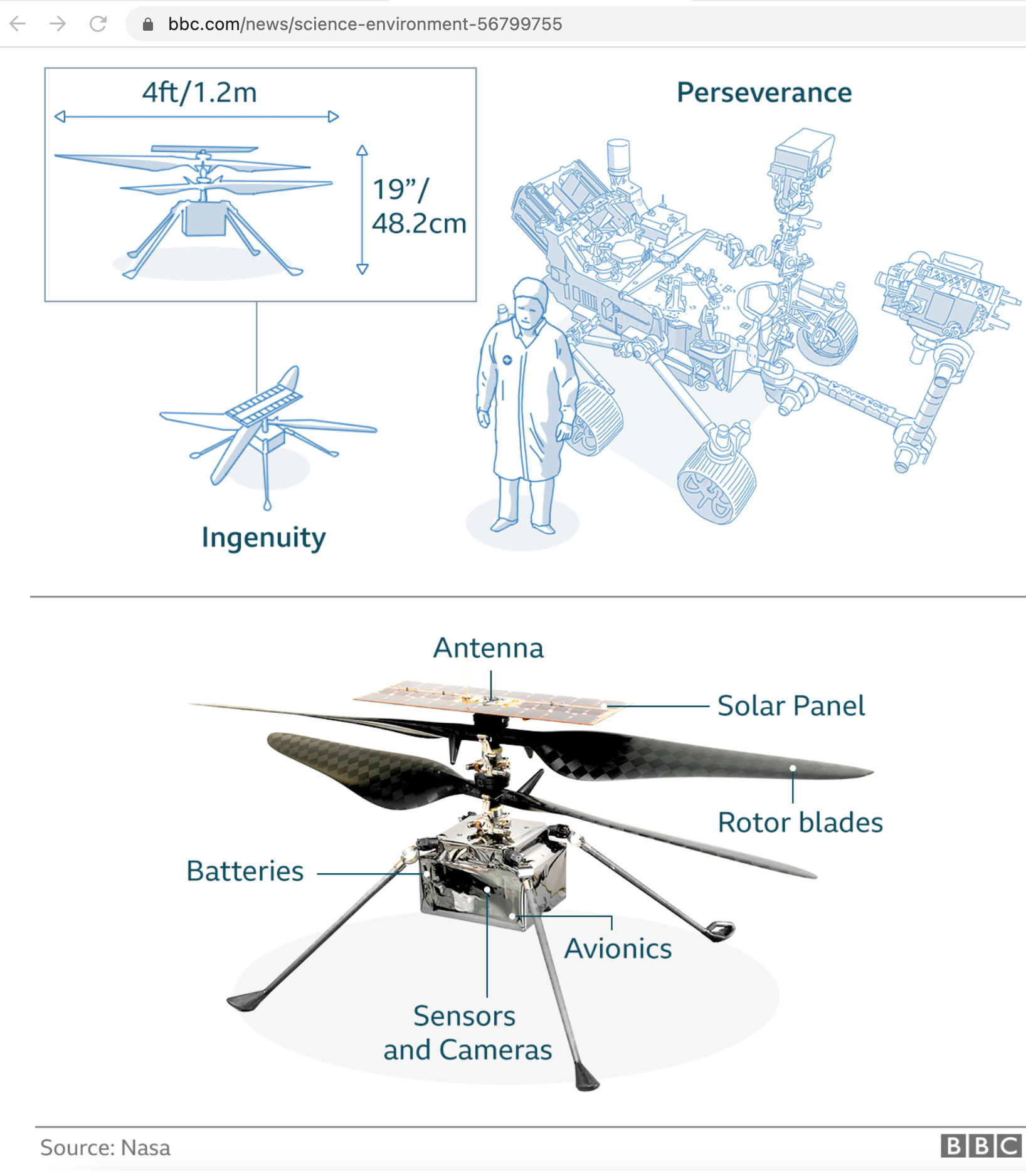
(Please watch the video and read the article at the URL's posted above)
Related articles here:
Globebusters Bob Knodel displays his failed aviation skills
GLOBEBUSTERS (Bob Knodel) - flat Earth advocate FAIL
FECORE - flat Earth advocate FAIL
-
2nd flight update...
NASA’s Ingenuity Helicopter Completes Its Second Flight on Mars (sci-news.com)
http://www.sci-news.com/space/ingenuity-second-flight-09584.html
Lasting 51.9 seconds, Ingenuity’s experimental flight on April 22, 2021, added several new challenges to its first flight, including a higher maximum altitude, longer duration, and sideways movement.
-
3rd flight update, April 25, 2021...
Ascending to five meters, then fly away 50 meters distance, and then return to starting position.
NASA's Ingenuity Mars Helicopter Flies Faster, Farther on Third Flight (mars.nasa.gov)
https://mars.nasa.gov/news/8930/nasas-ingenuity-mars-helicopter-flies-faster-farther-on-third-flight/
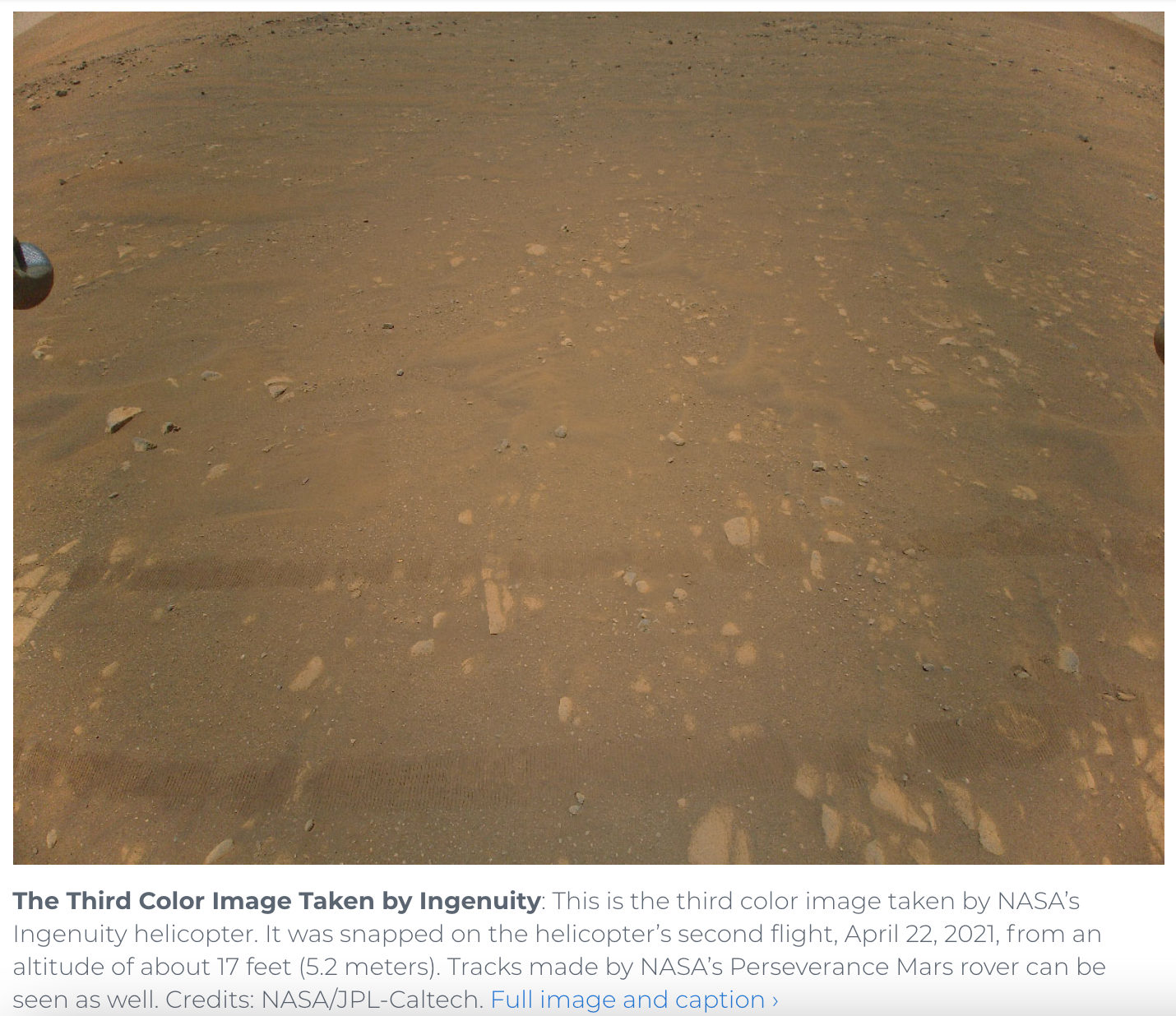
-
4th flight update, April 30, 2021...
Sounds of NASA’s Ingenuity Helicopter on Mars, by Breaking Science News
https://www.youtube.com/watch?v=QNgGu6UPt6Q
NASA’s Perseverance rover used its SuperCam microphone to listen to the Ingenuity helicopter on April 30, 2021 as it flew on Mars for the fourth time.
Hear the Doppler Effect on Mars.
Hear wind blowing on Mars.
Helicopter blades spin 2,537 rpm while in flight.
-
5th flight update, May 10, 2021...
Ingenuity Completes Its 5th Fifth Flight on Mars (sci-news.com)
http://www.sci-news.com/space/ingenuity-fifth-flight-09638.html
On May 7, 2021, NASA’s Ingenuity helicopter successfully completed its fifth flight with one-way journey from the ‘Wright Brothers Field’ to a new airfield 129 m (423 feet) to the south.
Ingenuity’s fifth flight began at 3:26 p.m. EDT (12:26 p.m. PDT, 12:33 p.m. local Mars time) and lasted 108 seconds.
-
17th flight update, December 17, 2021...
Ingenuity Helicopter Completes Its Seventeenth Flight On Mars (sci-news.com)
http://www.sci-news.com/space/ingenuity-seventeenth-flight-10376.html
Excerpt:
On December 5, 2021, NASA’s Ingenuity helicopter successfully flew to a new destination located very close to its original airfield, Wright Brothers Field, where it will await the arrival of the Perseverance rover. This 117-second flight pushed the total flight time past the 30-minute mark.
The solar-powered 49-cm- (19.3-inch-) tall Ingenuity helicopter was designed as a technology demonstration to perform up to five experimental test flights.
It first flew on April 19, 2021, with a short up-and-down hop to prove powered, controlled flight on Mars was possible.
The next four experimental flights expanded the rotorcraft’s flight envelope, making increasingly longer flights with more complicated maneuvering.
With the sixth flight, the helicopter embarked on a new operations demonstration phase, investigating how aerial scouting and other functions could benefit future exploration of Mars and other worlds.
In this new chapter, Ingenuity has operated from airfields well south of Wright Brothers Field, scouting rocky outcrops and other geologic features of interest to the Perseverance science team.
“Few thought we would make it to flight one, fewer still to five,” said Ingenuity team leader Dr. Teddy Tzanetos, a researcher at NASA’s Jet Propulsion Laboratory.
“And no one thought we would make it this far.”
“On the way to accumulating over a half-hour aloft Ingenuity has survived eight months of bitter cold, and operated out of nine unique Martian airfields.”
“The aircraft’s continued operations speaks to the robustness the design and the diligence and passion of our small operations team.”
Along with accumulating 30 minutes and 48 seconds of flight time, Ingenuity has traveled over the surface a distance of 3.592 km (2.2 miles), flying as high as 12 m (40 feet) and as fast as 5 m/sec (10 mph).
(Please read the article posted at the URL above)
-
Detailed color photos of the surface of Mars.
The University of Arizona, Lunar and Planatary Laboratory, HiRISE - High Resolution
https://www.uahirise.org/
HiRISE (High Resolution Imaging Science Experiment) is the most powerful camera ever sent to another planet, one of six instruments onboard the Mars Reconnaissance Orbiter.
at page: https://www.uahirise.org/results.php?keyword=terrain&order=release_date&submit=Search
Possible Pyroxene-Rich Terrain in Southern Terra Sabaea

Possible Hydrate-Rich Terrain in Noctis Labyrinthus
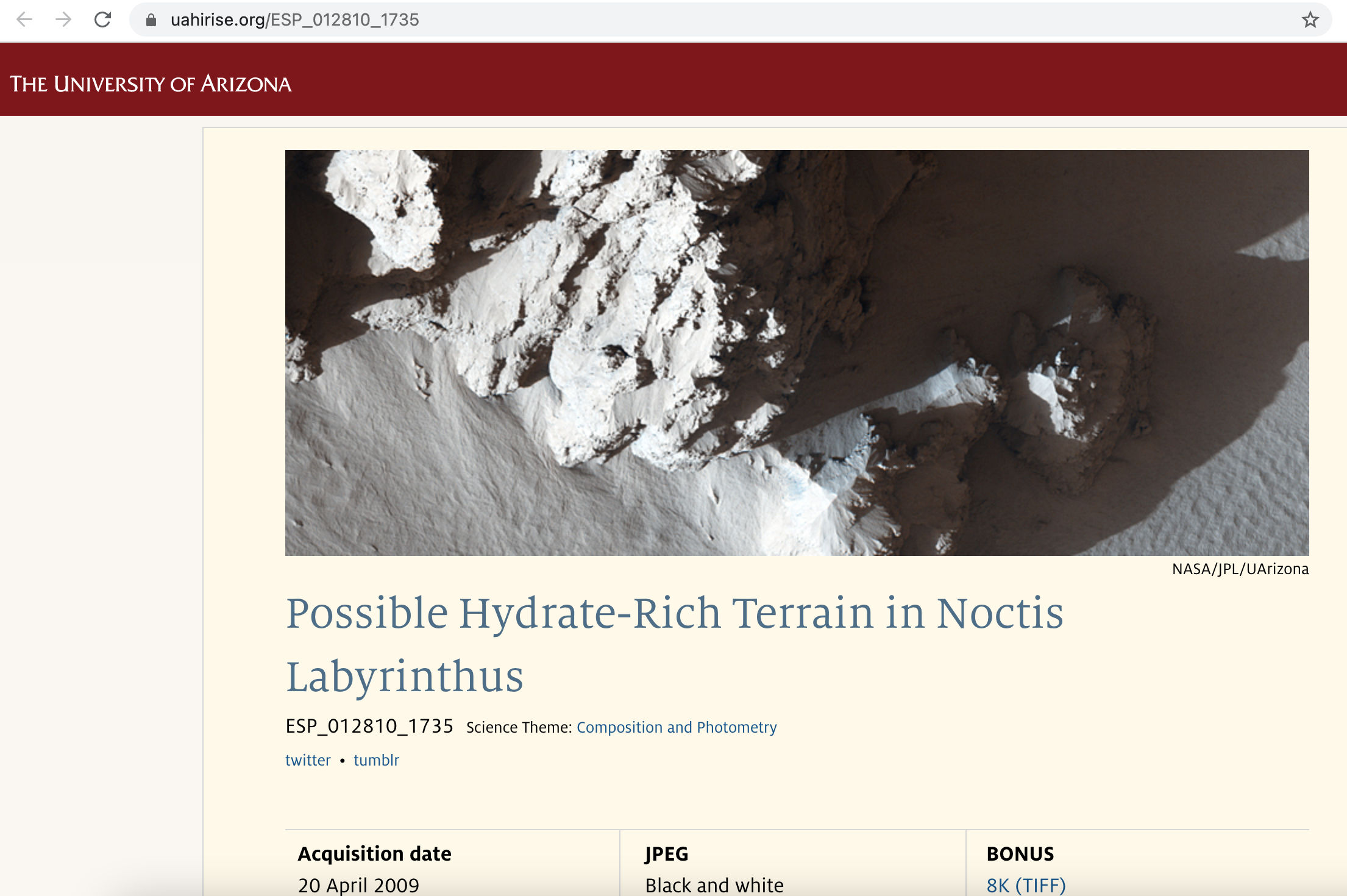
Gullies on Southwest Slope of Ring Trough in Noachis Terra
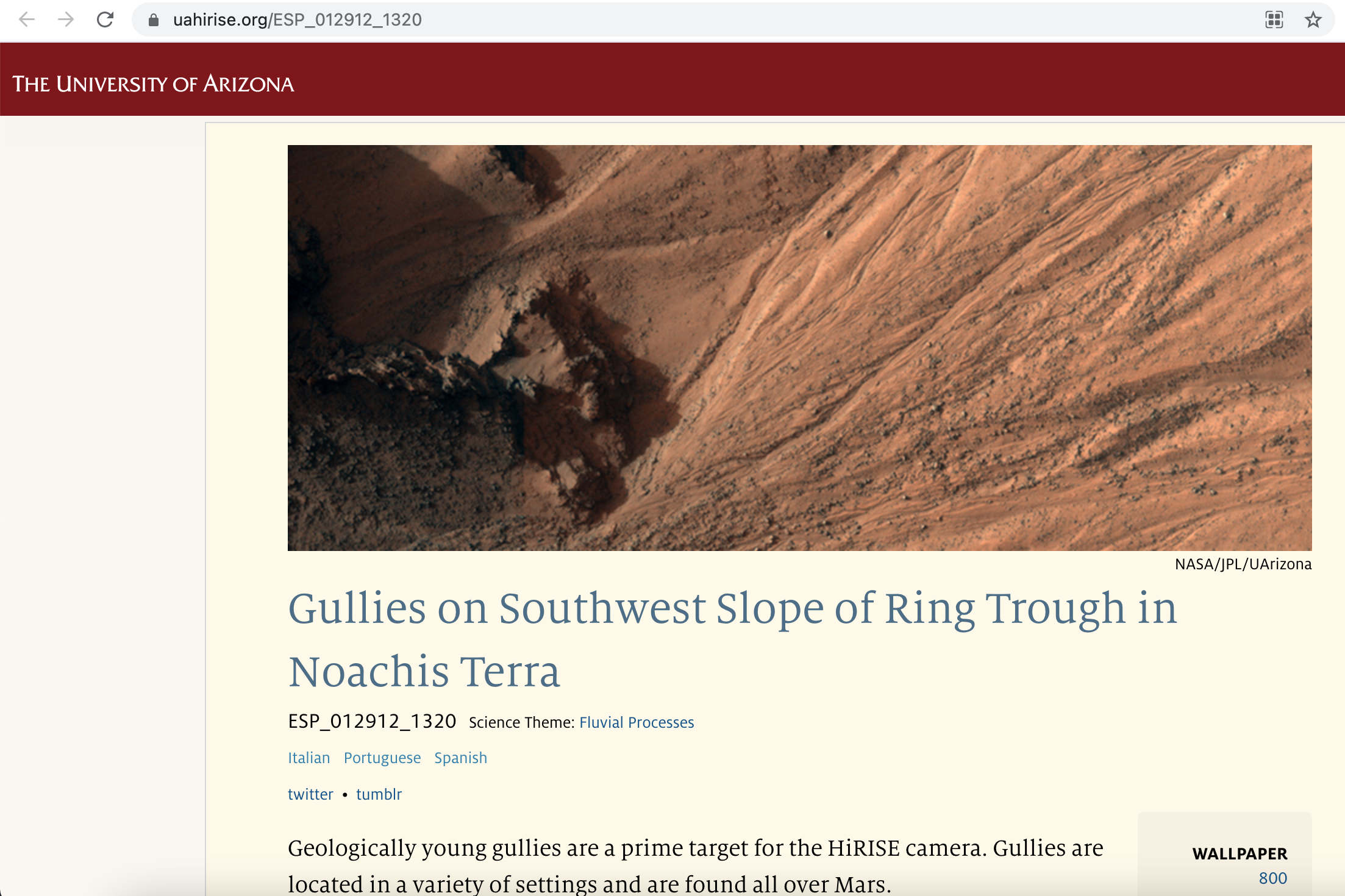
-
Trying To Fly At The Surface Pressure of Mars in a Vacuum Chamber, by The Action Lab
https://www.youtube.com/watch?v=5S-MLDiHt8A
In this video I try to see if I can achieve flight in my vacuum chamber at the pressure on the surface of Mars. I talk about Ingenuity and how it can fly on Mars.
"it's not a complete vacuum. The the pressure is around 0.095 psi. Now thats an extremely low pressure, but is enough to do something significant, like fly...
The gravity on Mars is about 1/3 of the Earths. It is 3.721 m/sec^2
We need large blades, spinning very fast, in a light weight helicopter.
My shorts channel: https://www.youtube.com/channel/UCA19...
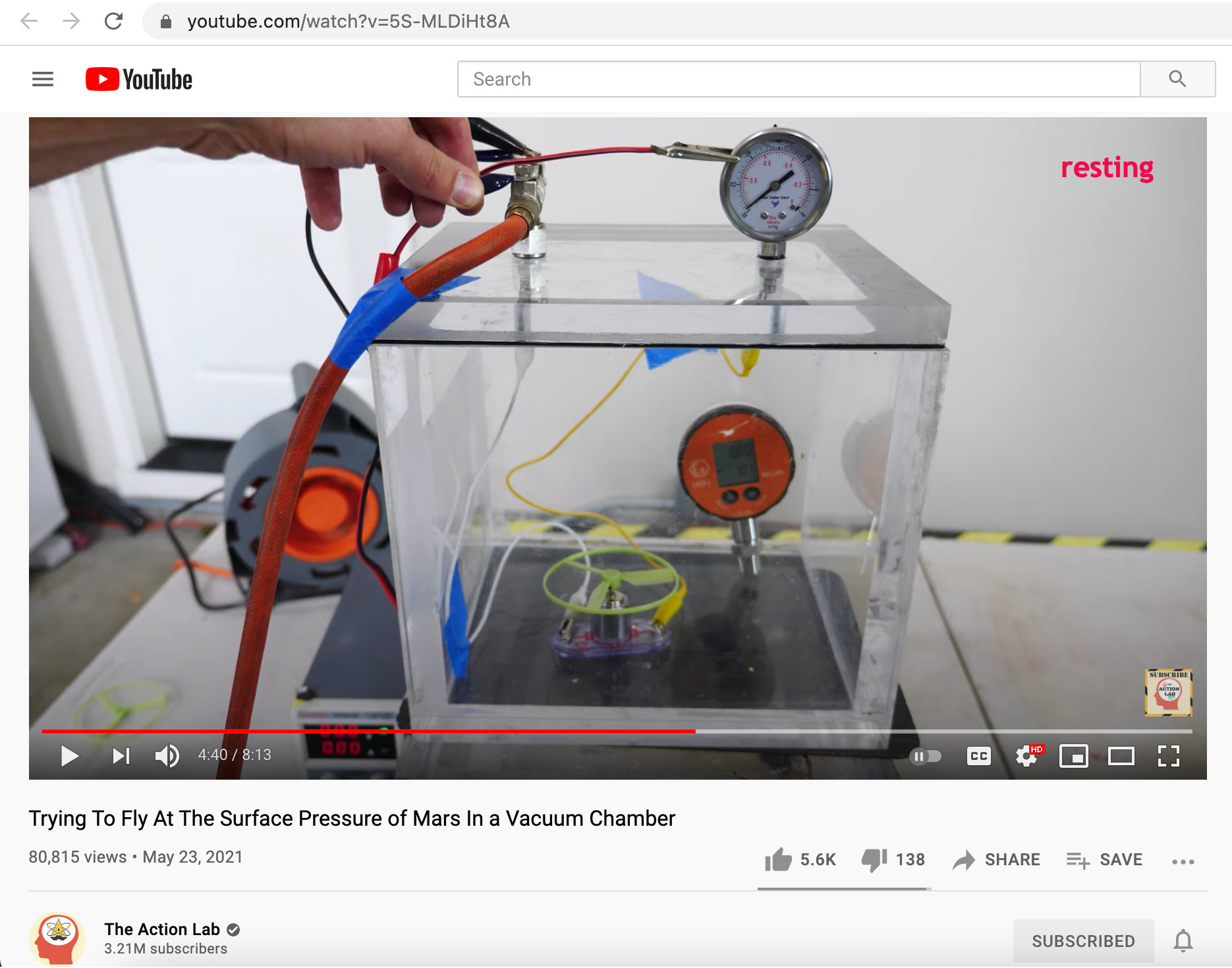
-
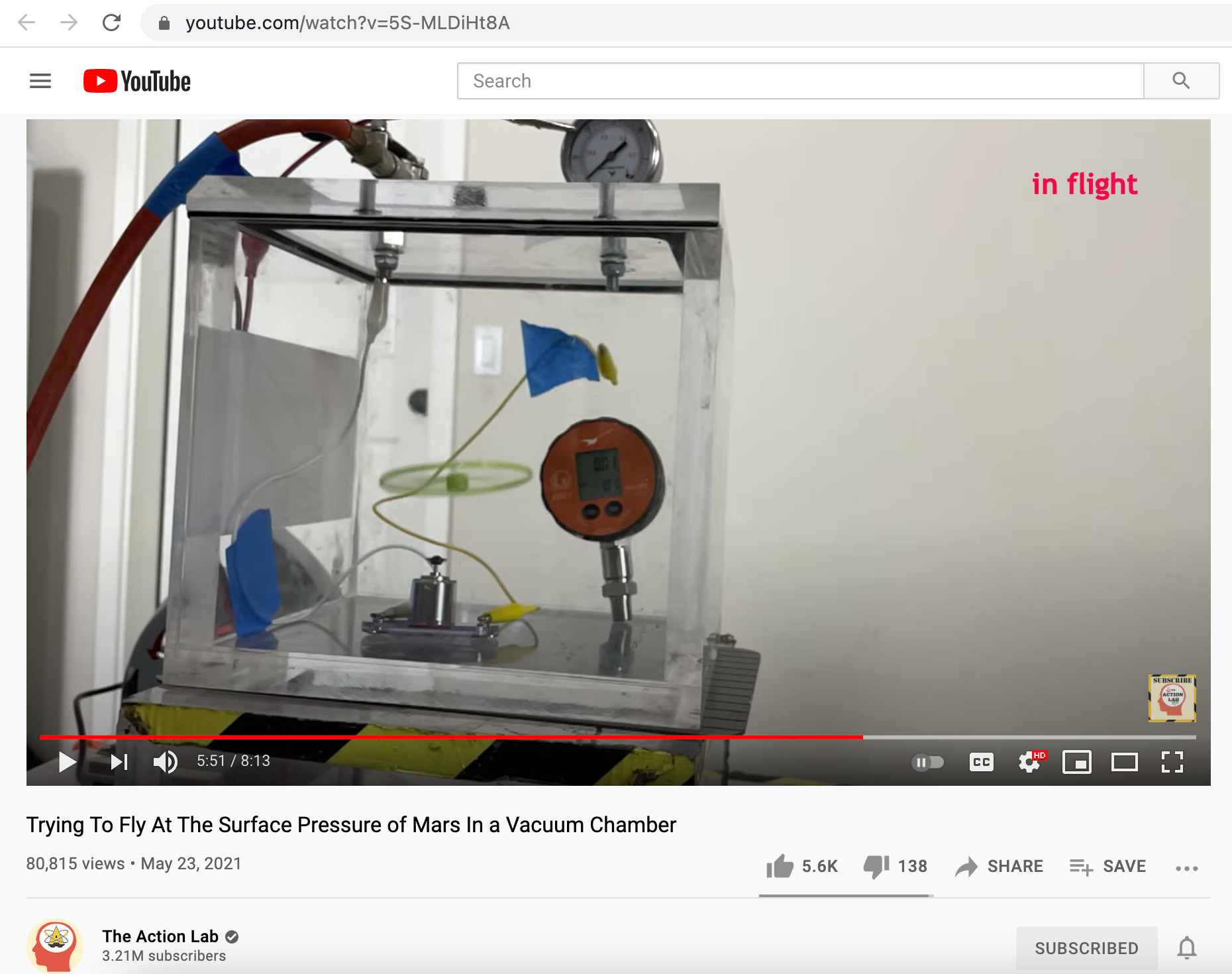
-
Do You Weigh More Or Less In a Vacuum Chamber?, by The Action Lab
https://www.youtube.com/watch?v=EHmBf6TSLew
I put objects in a vacuum chamber to show how their weight changes.
-
Update: September 7, 2021
Success! 1st Martian Rock Cored By Perseverance (earthsky.org)
https://earthsky.org/space/1st-martian-rock-cored-rochette-perseverance-mars/
1st Martian rock cored for sample return to Earth
NASA’s Perseverance rover has successfully cored a Martian rock, NASA announced late last week. This is Perseverance’s first core sample, and it’s the first Martian rock to be cored. The rover acquired images on September 1, 2021, that showed the sample tube filled with an intact core of the rock. It’s an exciting achievement. And it’s the first of many such samples of Mars rock that’ll be analyzed and stored for return to Earth by a future Mars mission. Wow.
For this accomplishment, the second time’s the charm. Perseverance first attempt at this maneuver was on August 5, 2021. More about that below. This time, the mission team is confident the sample really is in the tube, as seen in initial images. They had a bit of worry about that since subsequent images were a bit less clear. So they took additional images just to be absolutely sure. NASA later tweeted on September 4 that newer images taken did indeed still show the sample safely inside the tube...
(Please read the article posted at the URL above)
-
Update: April 29, 2022
Ingenuity Spots Perseverance Rover's Landing Equipment on Mars (sci-news.com)
http://www.sci-news.com/space/ingenuity-perseverance-landing-equipment-mars-10756.html
On April 19, 2022, NASA’s Ingenuity helicopter recently surveyed both the parachute that helped the Perseverance rover land on Mars and the cone-shaped backshell that protected the rover in deep space and during its fiery descent toward the Martian surface.
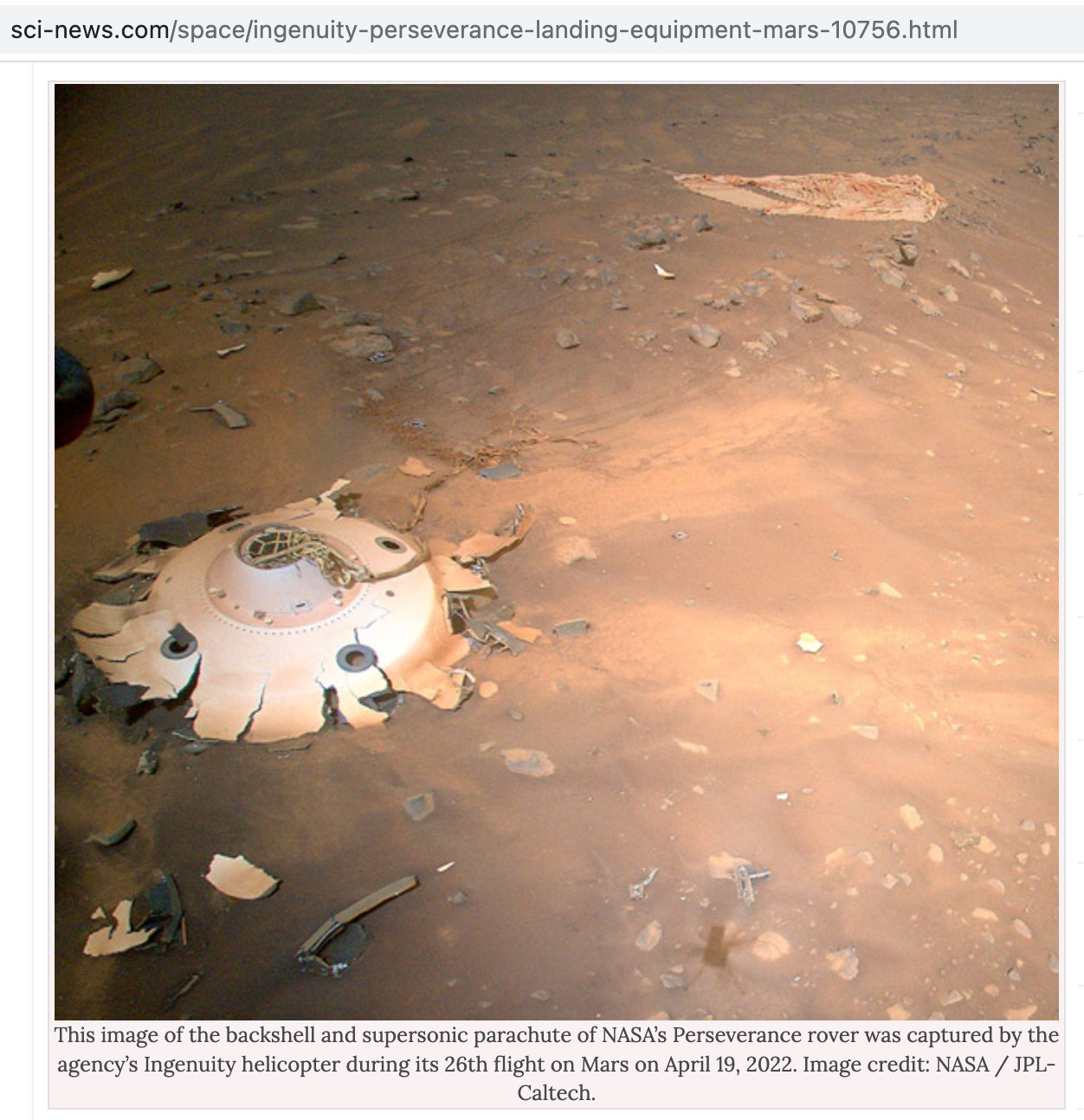
Entry, descent, and landing on Mars is fast-paced and stressful, not only for the engineers back on Earth, but also for the vehicle enduring the gravitational forces, high temperatures, and other extremes that come with entering the Martian atmosphere at 20,000 kph (12,500 mph).
Perseverance’s parachute and backshell were previously imaged from a distance by the rover itself. But those collected by the Ingenuity helicopter — from an aerial perspective and closer — provide more detail.
“NASA extended Ingenuity flight operations to perform pioneering flights such as this,” said Ingenuity’s team leader Teddy Tzanetos, of NASA’s Jet Propulsion Laboratory.
“Every time we’re airborne, Ingenuity covers new ground and offers a perspective no previous planetary mission could achieve.”
In the images of the upright backshell and the debris field that resulted from it impacting the surface at about 126 kph (78 mph), the backshell’s protective coating appears to have remained intact during Mars atmospheric entry.
Many of the 80 high-strength suspension lines connecting the backshell to the parachute are visible and also appear intact.
Spread out and covered in dust, only about a third of the orange-and-white parachute — at 21.5 m (70.5 feet) wide, it was the biggest ever deployed on Mars — can be seen, but the canopy shows no signs of damage from the supersonic airflow during inflation.
“Perseverance had the best-documented Mars landing in history, with cameras showing everything from parachute inflation to touchdown,” said former Perseverance systems engineer and now Mars Sample Return ascent phase leader Ian Clark, also from NASA’s Jet Propulsion Laboratory.
“But Ingenuity’s images offer a different vantage point.”
“If they either reinforce that our systems worked as we think they worked or provide even one dataset of engineering information we can use for Mars Sample Return planning, it will be amazing.”
“And if not, the pictures are still phenomenal and inspiring.”
_____
This article is based on text provided by the National Aeronautics and Space Administration.
(Please read the article at the URL posted above)
- - - - - - - - - - - - - - - - - - - - - - - - - - - - - - - - - - - - - - - - - - - - -
Posted on April 18, 2021
How I escaped a conspiracy rabbit hole, by BBC News
https://www.bbc.com/news/av/uk-56766513
Catherine grew up in a family that lived an alternative lifestyle and when social media became a big part of her life, she became a big believer in anti-vaccine conspiracy theories.
She told the BBC’s specialist disinformation reporter Marianna Spring what made her stop believing, and how she thinks you can help others out of the online rabbit hole.
Transcript:
Catherine:
I hate to refer to anti-vaxxers as cult-like, because I know myself what it’s like to be on that side. And I would have hated to be referred to as that. But in reality, yes, that’s what it is.
Interviewer Marianna Spring:
Meet Catherine. She used to be an ardent believer in conspiracy theories, including thinking that vaccines are part of a sinister global plot to make millions ill. Now she spends her time trying to convince others to climb out of the online rabbit hole that she was once down.
Catherine:
My mum was anti-vax, anti-medicine, very holistic. And also I grew up in a low demographic. So naturally you tend to find people are more susceptible to anti-establishment ideas. I had some things running around in my head. That, you know, the system was bad, the system was set up wrong, the system was set up for us to fail.
Interviewer Marianna Spring:
Then along came social media, and it opened up a whole new world of anti-vaccine content online.
Catherine:
There were hundreds of YouTube videos, Facebook videos, memes, articles, clips that would catch your attention in the news feed.
Interviewer Marianna Spring:
Catherine’s cynicism, which led her down this conspiracy theory rabbit hole in the first place, ultimately helped her out of it.
Catherine:
I started to realize I needed to be more critical of myself, critical of the things I was reading, and the things that I was watching. Where did they come from? Who was making them? Why were they making them? So, for example, if there was some grand conspiracy at play here, how many people would need to be involved in that theory, all the way from the top down? What are the odds of nobody saying anything? I started to notice things like certain health campaigns, for example, bombarding social media with advertisements promising, you know, huge health benefits. I realized that these people were actually harnessing the cultural changes in our lives to make money. The likes, the followers, the subscribers.
Interviewer Marianna Spring:
This process of rejecting online conspiracies was not a quick one.
Catherine:
I think part of me will always still be in the rabbit hole. We all like to feel we’ve got some understanding of the way the world works. When in reality it’s a lot more chaotic.
Interviewer Marianna Spring:
But she thinks people can emerge from the rabbit hole.
Catherine:
You need to be able to listen, and understand their fears, understand their concerns, and, if they’re willing, go into discussions about why things might not be as they believe. Or why things might not be true. And it needs to be much a gentler approach.
Interviewer Marianna Spring:
Catherine hopes her experience might help just one person affected by online conspiracy theories during the pandemic.
Catherine:
There’s no shame in being susceptible to conspiracy theories or anti-vax conspiracy theories. They’re very good, they’re very convincing. You’re allowed to change your view. Just because you’ve been stuck in one mode or one world view for most of your life, doesn’t mean you need to stay there. I would have not believed in this pandemic at all ten years ago.
Interviewer Marianna Spring:
And now, would you have the vaccine?
Catherine:
Absolutely.
(Please watch the video at the URL's posted above)
- - - - - - - - - - - - - - - - - - - - - - - - - - - - - - - - - - - - - - - - - - - - -
Posted on April 18, 2021
TESS (Transiting Exoplanet Survey Satellite) delivers on discoveries as extended mission continues,
by Justin Davenport (nasaspaceflight.com)
https://www.nasaspaceflight.com/2021/04/tess-delivers-anniversary/
Three star systems discovered revolving around each other; common center of gravity.
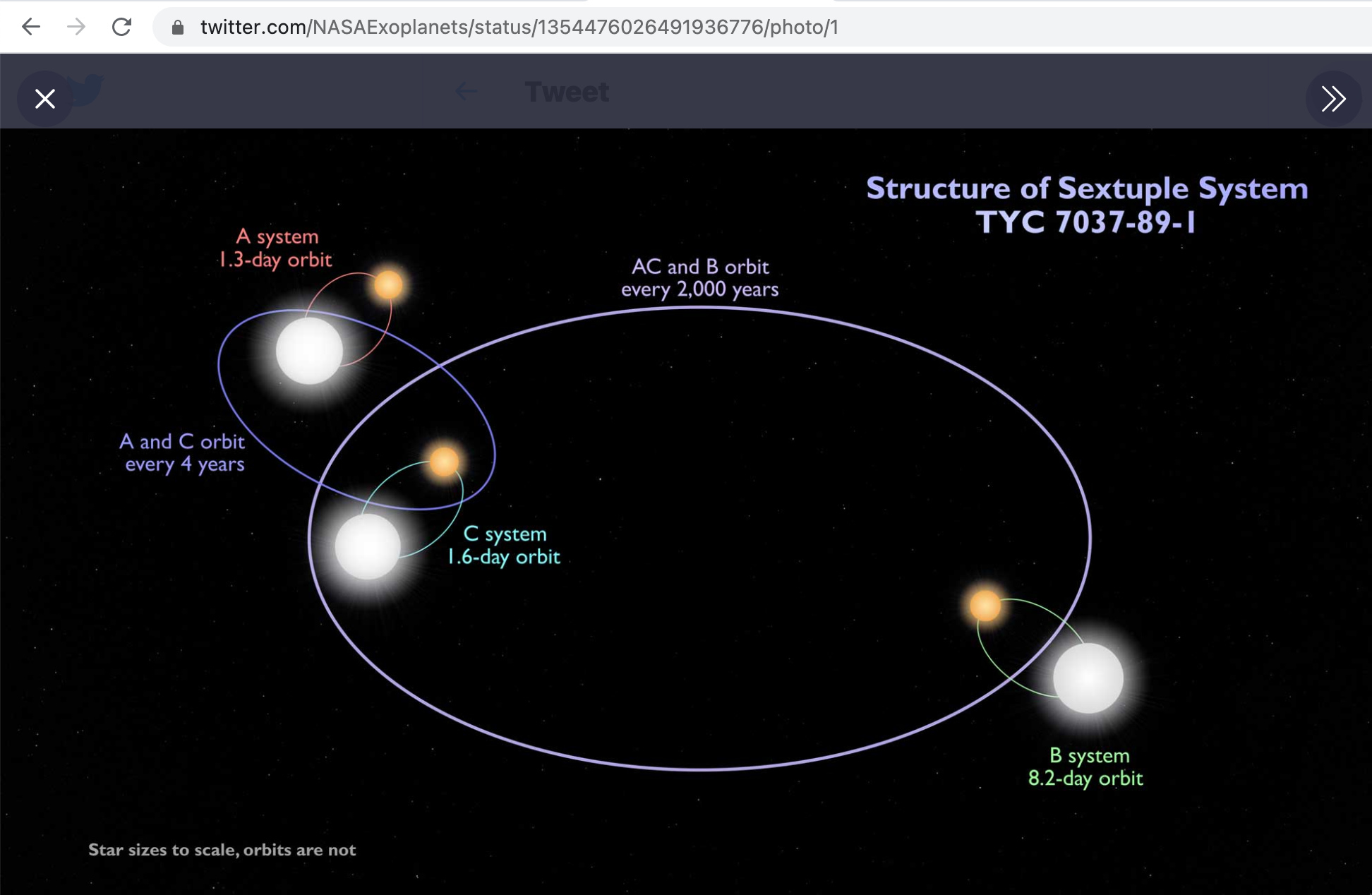
Excerpt:
Three years ago, on April 18, 2018, NASA’s and the Massachusetts Institute of Technology’s Transiting Exoplanet Survey Satellite, or TESS, launched successfully into a very high Earth orbit aboard the last new Block 4 Falcon 9 before the current human-rated Block 5 entered service.
Since then, it has dutifully observed the southern and northern skies, searching for tell-tale signs of nearby exoplanets crossing between their parent stars and the telescope’s cameras. Its primary mission now complete, TESS is in an extended mission phase that will last until 2022 — at which point it will be eligible for another mission extension provided its systems are still in good shape as intended.
In 2018, once the Falcon 9 placed the telescope on its correct, post-launch trajectory, TESS embarked on a journey to its science orbit over the following month, ending in a flyby of the Moon on May 17, which moved the spacecraft into a 13.7 day, 108,000 by 373,000 km elliptical orbit of Earth.
Specifically, TESS entered a P/2 resonant orbit (2:1 resonance) around the Moon, which minimizes gravitational interferences between the body and the telescope, allows for exposure to consistent temperatures for the spacecraft’s instruments, keeps it out of the Van Allen radiation belts, and gives the telescope an unobstructed view of the stars in both northern and southern hemispheres.
After a three-month checkout, TESS started its all-sky exoplanet survey, beginning with the southern hemisphere star field. In July 2019 TESS turned its eyes to the northern hemisphere, completing its primary mission one year later.
Whereas the first space telescope designed for exoplanet observations, Kepler, focused on a far from Earth and narrow slice of sky in the Vega and Cygnus constellations for a statistical survey of exoplanets during its primary mission, TESS’s primary mission observed 85% of the sky using a wide-field telescope — with an emphasis on exoplanets orbiting bright stars within 300 light years of Earth...
(Please read the article at the URL's posted above)
- - -
TESS completes its primary mission (NASA Goddard)
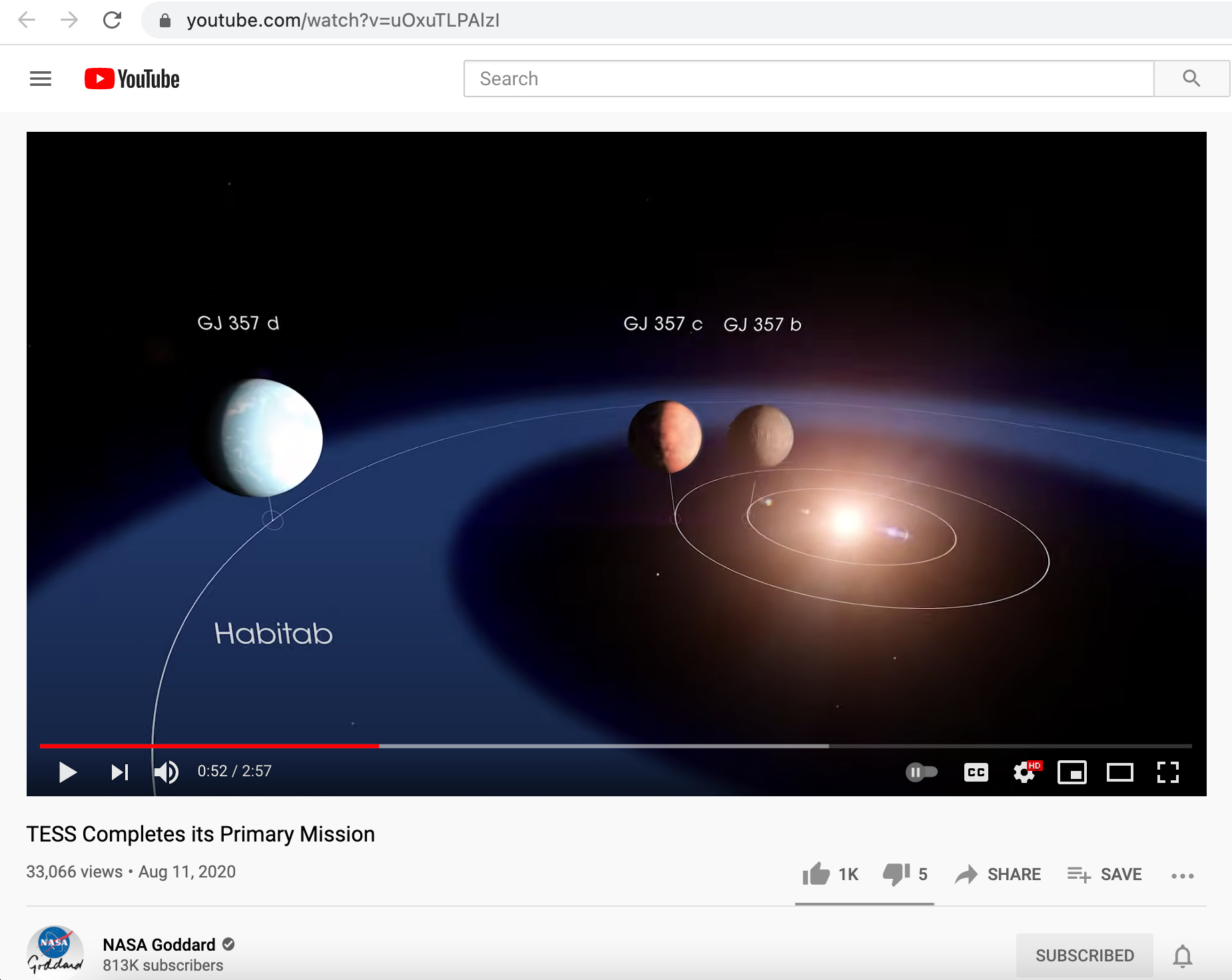
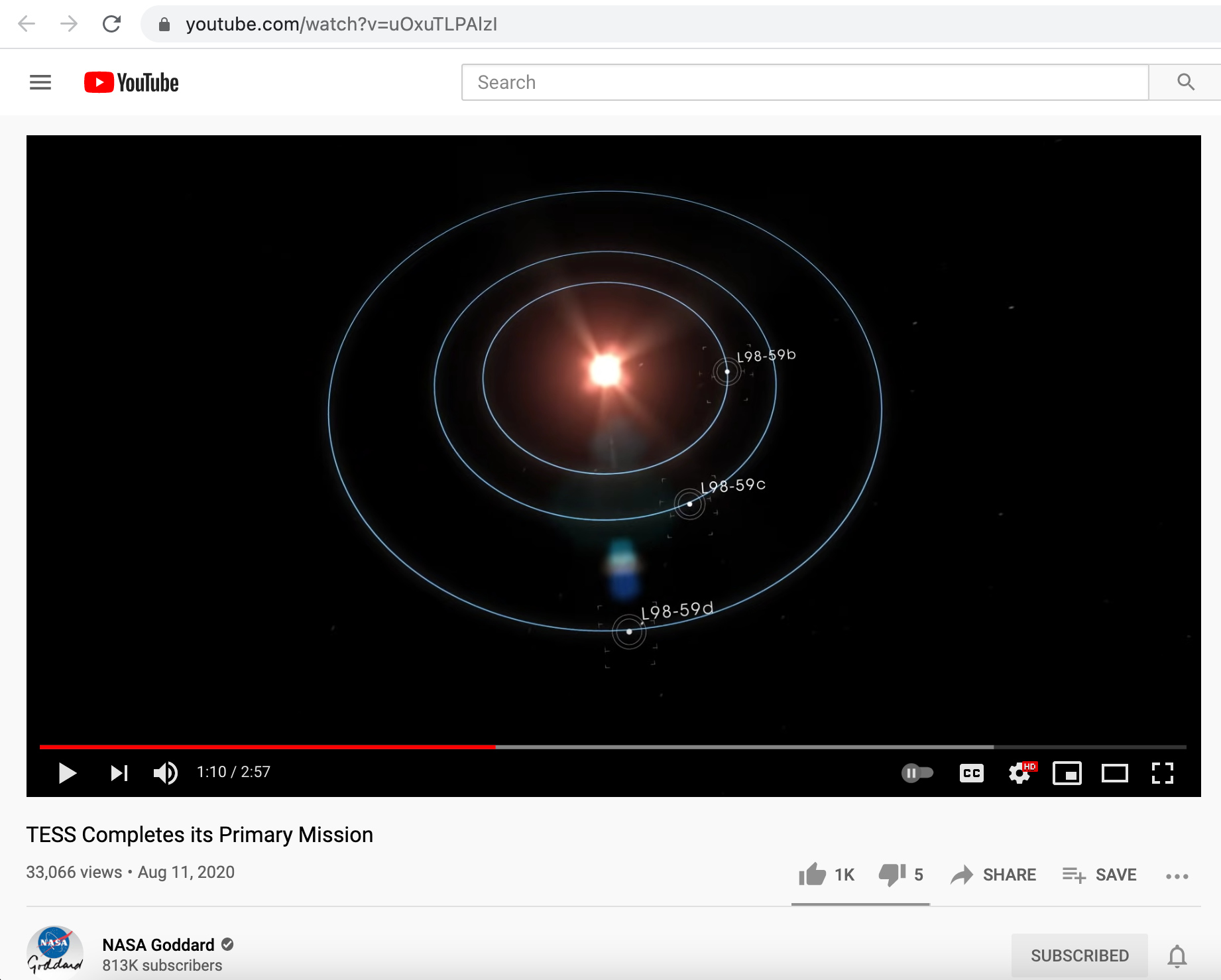
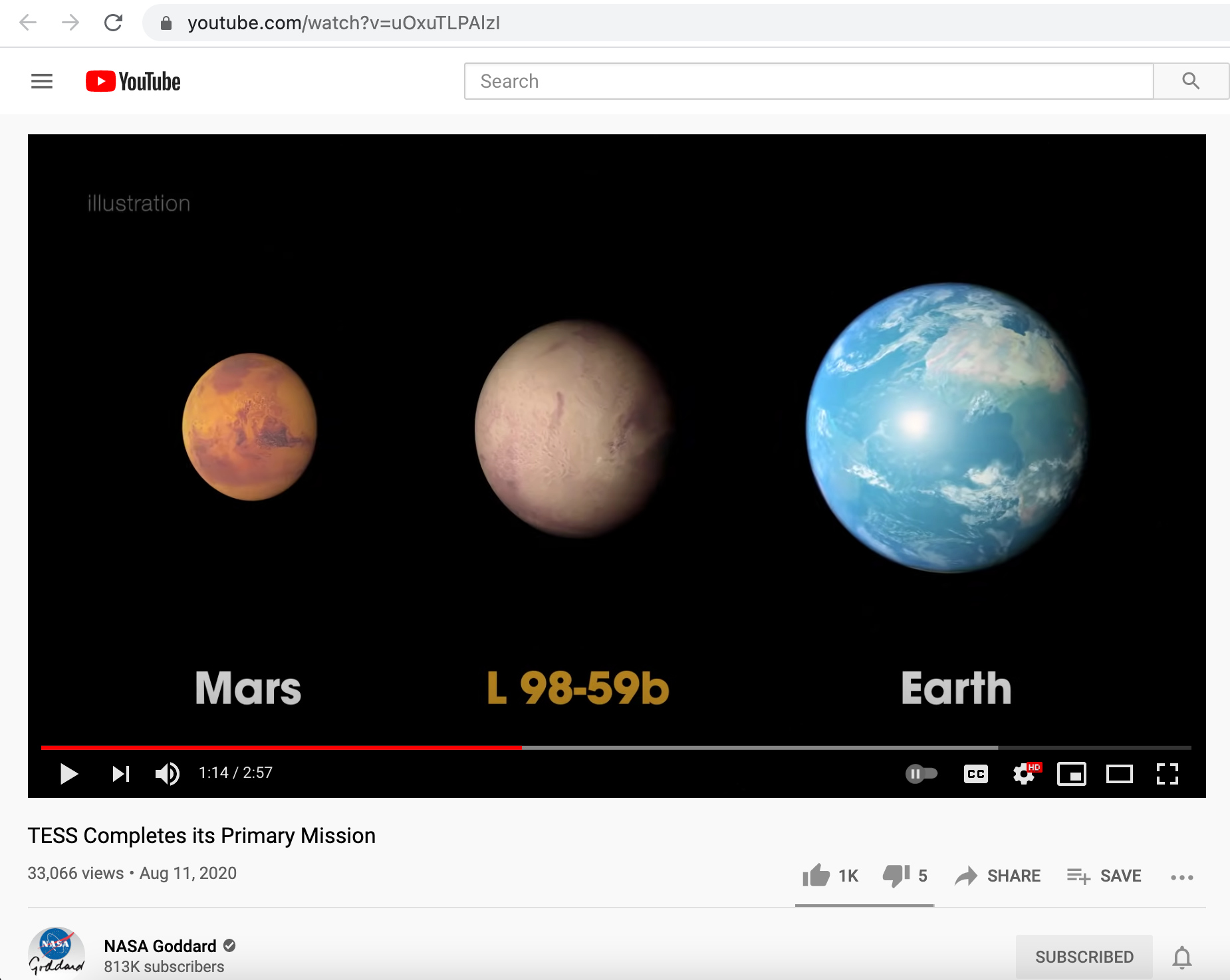
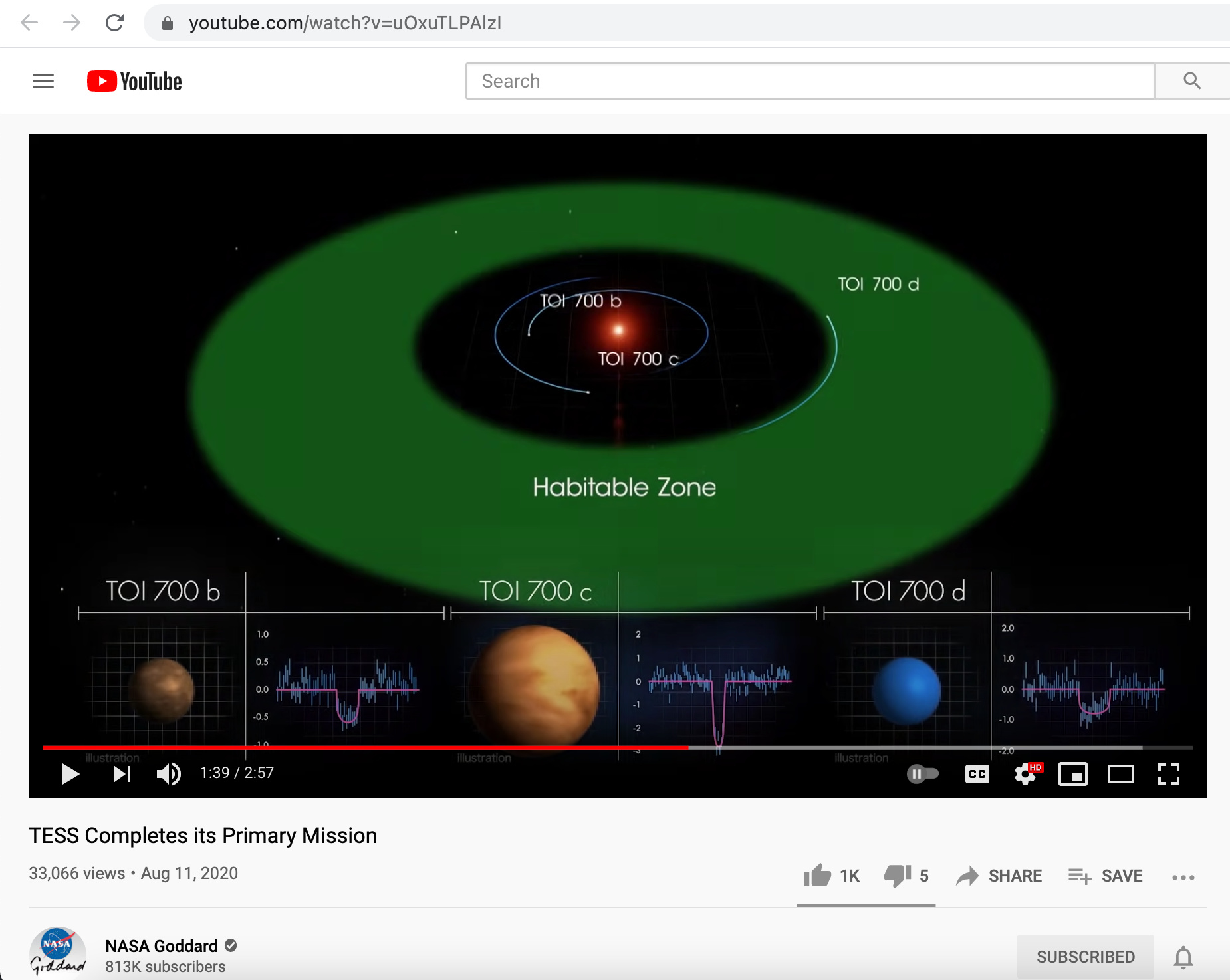
On July 4, NASA’s Transiting Exoplanet Survey Satellite (TESS) completed its primary mission, a two-year-long survey that imaged about 75% of the starry sky. In capturing this giant mosaic, TESS has found 66 new exoplanets, or worlds beyond our solar system, as well as nearly 2,100 candidates astronomers are working to confirm.
TESS monitors 24-by-96-degree strips of the sky, called sectors, for about a month using its four cameras. The mission spent its first year observing 13 sectors comprising the southern sky and then spent another year imaging the northern sky.
Now in its extended mission, TESS has turned around to resume surveying the south. In addition, the TESS team has introduced improvements to the way the satellite collects and processes data. Its cameras now capture a full image every 10 minutes, or three times faster than during the primary mission. The faster measurements will allow TESS to better resolve brightness changes caused by stellar oscillations and to capture explosive flares from active stars in greater detail.
These changes will remain in place for the duration of the extended mission, which will be completed in September 2022. After spending a year imaging the southern sky, TESS will take another 15 months to collect additional observations in the north and to survey areas along the ecliptic – the plane of Earth’s orbit around the Sun – that have not yet been imaged by TESS.
TESS looks for transits, the telltale dimming of a star caused when an orbiting planet passes in front of it from our point of view. During its primary mission, TESS also observed the outburst of a comet in our solar system, as well as numerous exploding stars, and even watched as a black hole in a distant galaxy shredded a Sun-like star.
Music: "Drive to Succeed" from Universal Production Music
Video credit: NASA's Goddard Space Flight Center
Scott Wiessinger (USRA): Lead Producer
Francis Reddy (University of Maryland College Park): Lead Science Writer
Chris Smith (USRA): Animator
Brian Monroe (USRA): Animator
Ethan Kruse (USRA): Data Visualizer
Scott Wiessinger (USRA): Narrator
Claire Andreoli (NASA/GSFC): Public Affairs Officer
This video is public domain and along with other supporting visualizations can be downloaded from NASA Goddard's Scientific Visualization Studio at: https://svs.gsfc.nasa.gov/13663
If you liked this video, subscribe to the NASA Goddard YouTube channel: https://www.youtube.com/NASAGoddard
Follow NASA’s Goddard Space Flight Center
· Instagram http://www.instagram.com/nasagoddard
· Twitter http://twitter.com/NASAGoddard
· Twitter http://twitter.com/NASAGoddardPix
· Facebook: http://www.facebook.com/NASAGoddard
· Flickr http://www.flickr.com/photos/gsfc
(Please watch the video at the URL's posted above)



